
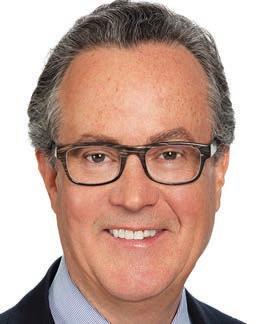

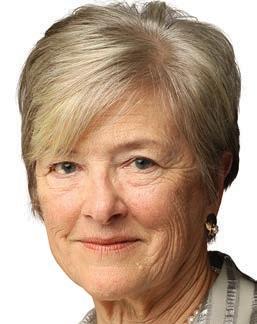

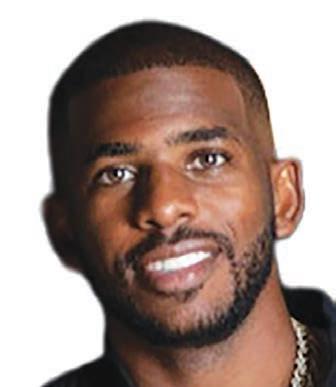


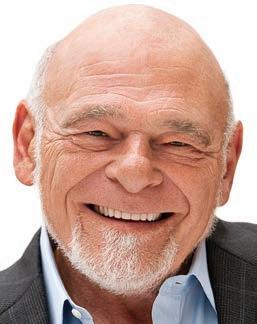




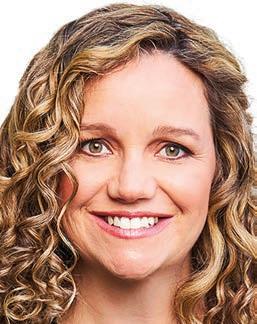
 SOLOVIEV PETERSON ROSENBAUM WYLDE RODRIGUEZ
SOLOVIEV PETERSON ROSENBAUM WYLDE RODRIGUEZ
October, November, December 2022 Volume 45 Number 4
PAUL KOUDOUNIS ARSHT ZELL JAFAR MARCUS DALIO
BRATTON HINES-PIERCE NADAL















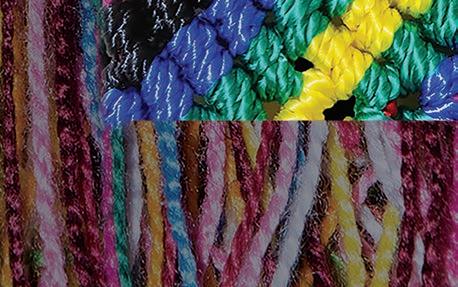
















Queen Elizabeth II
LEADERS Magazine is published quarterly and circulated to distinguished leaders of the world. Circulation is strictly limited. To receive LEADERS Magazine, one must be a leader of a nation, an international company, a world religion, an international institute of learning, or an international labor organization; or a chief financial officer, a major investor on behalf of labor or corporate pension funds, a chief information officer or a Nobel laureate. LEADERS Magazine was founded by Henry O. Dormann (1932-2018).
LEADERS Magazine

Publisher and Executive Editor: David W. Schner
Editor: Darrell J. Brown
Advertising Executive: Laurie McClure Ferber
On the Cover
Raymond T. Dalio
Bridgewater Associates, LP Adrienne Arsht
Sam Zell Equity Group Investments Badr Jafar Crescent Enterprises Bernie Marcus
Chris Paul Chris Paul Family Foundation William J. Bratton Teneo
Laura Hines-Pierce Hines
Miles S. Nadal Peerage Capital Group
John S. Koudounis Calamos Investments
Stefan Soloviev Soloviev Group
Douglas L. Peterson S&P Global
Richard A. Rosenbaum Greenberg Traurig
Kathryn S. Wylde Partnership for New York City
Michael A. Rodriguez Alliance Building Services
Printing: Calev Print Media – Freeport Press
Photo Credits: Cover, Zell, 14 - www.heypeterross.com 212.343.8798; Cover, Jafar, 16 - © Copyright: Rogue Visuals FZ LLE 2018Christopher Pike; 18 Jafar-King Charles III - © Pyramedia_2016; Cover, 154 - © Buck Ennis; 24 high five - © 2019 NBAE; 25 turkeys© 2018AntonioDavis; 30 author - © Raquel Goncalves Photography; Brady jersey - © Tacy Briggs-Troncoso; 40 author - © Greg Miller; 51 author - © Sandra Julian; 54-55 -courtesy Eat. Learn. Play.; 62 - © Ben Baker; 64 author - © Alex Snyder/TNC; cracked river bed© ZhuoWen Chen/TNC Photo Contest 2021; 65 planting - © Erika Nortemann/The Nature Conservancy; Brazil - © Gabriel Gabino Moreira/TNC Photo Contest 2019; 66 - © Kevin Arnold, 2015; 70 - Goldberg.Jerry@gmailcom; 73 stage - © The Obama Foundation; 88 Kaepernick - © Foot Candles Photography, LLC; 88-89 - Photos courtesy of Know Your Rights; 90 - © 2022 Sacia Friedman; 99 - © 2022 amara studios; 100 - © DBOX for Bentall Green Oak; 104 - © IFP; 109-110 BWI Forum - © Devon Warren; 115 plane interior© andresr; 118 - © Studio Peck; 120 author - © Marion Berrin; 126 - © Andrew Levine; 130 author - © Craig Vitter www.vitter.com; 134 candid - © Karianne Munstedt; 138 - © Rick Schwab; 144 author, 146 staff - © Lee S. Weissman/Northwell Health; 146 speakingwww.jennifermitchellphotography.com; 156 Hudson Commons new - © HG Esch Courtesy KPF; 157 Heron - © Kevin Scott Courtesy KPF; 157 Arthaus - © Elevated Angles Courtesy KPF; 158 One Vanderbilt - © Michael Moran OTTO Courtesy KPF; 160 author photos© 2016 by Max S. Gerber; 165 campus aerial - © James Nubile 2014; 165 Mount Sinai Beth Israel - © Matthew Septimus 2014; 166 building - © 2020 Max Touhey. All Rights Reserved; 167 - © Evan Joseph Studios; 168 - © 2021 Max Touhey. All Rights Reserved; 176 author - © Guillaume Gaudet; 176 building - © 2009 Steve Whittaker; 177 - © Frederick Charles, fcharles.com; 184 park - © Elizabeth Felicella; building (top) - © Noe & Associates with The Boundary; 185 - © Evan Joseph Studios; 196-197 buildings - © 2008 René Perez; 203 - Courtesy of Art Bodega Magazine; 206 - © New York Yankees; 208 - © 2021 Pamela Einarsen; 215 - © Mario Morgado; 217 - Jeffrey Totaro; 232 author - https://www.foodstorymedia.com, TAPHOTO2018; 252 Vault - Courtesy of Preferred Hotels & Resorts; 254 author© VVPICTOGRAPHY 2014; Living Room - © 2016 AVABLU/Ryan Forbes; 255 all - © 2012 Ryan Forbes/AVABLU; 259 dining salon - © 2016 Phillip Ennis PRODUCTIONS; 262 hotel pics - Chris Sanders
LEADERS (ISSN 0163-3635 ) is published quarterly by Leaders Magazine, LLC, a Sandow brand; www.leadersmag.com. Leaders Magazine, LLC, Sandow Media, LLC and their respective affiliates, directors, officers, employees, contributors, writers and editors (collectively, “Publisher”) accept no responsibility for inaccuracies, errors or omissions with information and/or advertisements contained herein. The Publisher has neither investigated nor endorsed the individuals, companies and/or products that advertise within the publication or that are mentioned editorially. Publisher assumes no responsibility for the claims made by the Advertisers or the merits of their respective products or services advertised or promoted in the publication. Publisher neither expressly nor implicitly endorses such Advertiser products, services or claims. Publisher expressly assumes no liability for any damages whatsoever that may be suffered by any purchaser or user for any products or services advertised or mentioned editorially herein and strongly recommends that any purchaser or user investigate such products, services, methods and/or claims made thereto. Opinions expressed in the magazine and/or its advertisements do not necessarily reflect the opinions of the Publisher. Neither the Publisher nor its staff, associates or affiliates are responsible for any errors, omissions or information whatsoever that have been misrepresented to Publisher. The information on products and services as advertised in the publication are shown by Publisher on an “as is” and “as available” basis. Publisher makes no representations or warranties of any kind, expressed or implied, as to the information, services, contents, trademarks, patents, materials or products included in this magazine. All pictures reproduced in the publication have been accepted by Publisher on the condition that such pictures are reproduced with the knowledge and prior consent of the photographer. As such, Publisher is not responsible for any infringement of any third party’s intellectual property or other rights arising out of any publication. LEADERS® is a registered trademark of Leaders Magazine, LLC. © Leaders Magazine, LLC 2022. All rights reserved. No part of this publication may be reproduced or transmitted in any form or by any means, electronic or mechanical, including photocopy, recording or any information storage and retrieval system, without the written permission of the Publisher.
ADDRESS SUBSCRIPTION REQUESTS AND CORRESPONDENCE TO: Leaders, 3651 NW 8th Avenue, Boca Raton, FL 33431.
“When life seems hard, the courageous do not lie down and accept defeat; instead, they are all the more determined to struggle for a better future.”
POSTED WITH PERMISSION. COPYRIGHT © 2022 LEADERS MAGAZINE, LLC LEADERS 2 VOLUME 45, NUMBER 4
BANK OF CHINA U.S.A. IS PROUD TO BE A COMMERCIAL LENDER OF CHOICE IN THE UNITED STATES and a passionate supporter of the local communities in which we live and work every day.










































With more than 40 years of service in the United States, and a geographic footprint spanning more than 60 countries around the world, Bank of China U.S.A. leverages our financial strength and global network to provide trusted advice, financial support and impeccable service to clients across all industries. To find out how we can support your business, from commercial and corporate loans and credit facilities to structured financing and cross-border services, visit : www.bocusa.com

* NEW YORK BRANCHES ARE MEMBERS FDIC CHICAGO AND
BRANCHES PROVIDE CORPORATE BANKING SERVICES ONLY NEW YORK |
| CHICAGO *
LOS ANGELES
LOS ANGELES
The Changing World Order
Raymond T. Dalio, Founder, Co-CIO and Member of the Board, Bridgewater Associates, LP 8
Supporting Game Changers Adrienne Arsht 10
Leading by Example Sam Zell, Founder and Chairman, Equity Group Investments 14
Profit and Purpose Badr Jafar, Chief Executive Officer, Crescent Enterprises 16
Kick Up Some Dust Bernie Marcus 22
Leveling the Playing Field Chris Paul, Founder, Chris Paul Family Foundation 24
Connecting Dreams with Innovation Bill McDermott, President and Chief Executive Officer, ServiceNow 27
The TB12 Method Lisa Borges, Executive Director, TB12 Foundation 30
The Profession William J. Bratton, Executive Chairman, Risk Advisory, Teneo 32
90 Years of Innovation Farooq Kathwari, Chairman, President and Chief Executive Officer, Ethan Allen Interiors Inc. 34
Contents PURPOSE
The Built Environment Laura Hines-Pierce, Co-Chief Executive Officer, Hines 38
Making the World a Better Place John Kasich, Founder, Kasich Company 40
Investing in Passion Miles S. Nadal, Founder and Executive Chairman, Peerage Capital Group 42
Finding Your True North William W. George, Senior Fellow, Harvard Business School 51
Building a Foundation for Children to Prosper in Life Chris Helfrich, Chief Executive Officer, Eat. Learn. Play. Foundation 54
Stakeholder Capitalism Peter Georgescu, Chairman Emeritus, Young & Rubicam, Inc. 56
Education, Health and Wellness, and Empowerment Ndamukong and Katya Suh, Co-Founders, Suh Family Foundation 60
Client Service, Excellence, Integrity, and Partnership Stephanie E. Cohen, Global Co-Head of Consumer and Wealth Management, Goldman Sachs 62
Building an Enduring Legacy Bola Olusanya, Chief Investment Officer, The Nature Conservancy 64
Investment Management and Client Service John S. Koudounis, Chief Executive Officer, Calamos Investments 68
Creating Better Financial Futures for Investors Samara Cohen, Chief Investment Officer of ETF and Index Investments, BlackRock 70
Changing the Conversation Around Mental Health Kevin Love, Professional Basketball Player, Mental Health Advocate, and Founder, Kevin Love Fund 72
Striving to Deliver Better Risk-Adjusted Returns Jeffrey Sherman, Deputy Chief Investment Officer, DoubleLine 76
Cultivating a Better Future Stefan Soloviev, Chairman, Soloviev Group 78
Rural Healthcare Walter Panzirer, Trustee, The Leona M. and Harry B. Helmsley Charitable Trust 86
Building Healthier and More Just Futures Colin Kaepernick, Founder, Know Your Rights Camp 88
An Economic Value Fix Clarence V. Lee III, Executive Vice President and Chief Financial Officer, ICON International, Inc. 90
Guided by a Common Purpose Sheri B. Bronstein, Chief Human Resources Officer, Bank of America 94
POSTED WITH PERMISSION. COPYRIGHT © 2022 LEADERS MAGAZINE, LLC LEADERS 4 VOLUME 45, NUMBER 4
A Platform of Purpose and Possibilities
Stephen Shaya, M.D., Managing Director, Akkad Holdings and Executive Servant Leader, J&B Medical 96
Where Trust and Performance Meet Sonny Kalsi, Co-Chief Executive Officer, BentallGreenOak 98
Advocating for Children Irwin Redlener, MD and Karen Redlener, Co-Founders, Ukraine Children’s Action Project 102
Advancing Resilience Maura Pally, Executive Director, Blackstone Charitable Foundation 104
Changing the World for the Better Antonio Ruiz-Gimenez, Chairman and CEO, Keep a Child Alive (KCA) 106
Increasing Generational Wealth in the Black Community Debra Langford, Executive Director and Head of Black Wealth Initiatives, J.P. Morgan Private Bank 109
Expanding Opportunities for Children
Jaime L. Garcia, President and Chief Executive Officer, Andy Roddick Foundation 112
A More Thoughtful Way to Fly Andrew Collins, President and Chief Executive Officer, Sentient Jet 114
NEW YORK 136
Finance for Good Elona Ruka-Wright, Chief Risk and Compliance Officer, Finastra 118
The Art Form of Blending Richard Geoffroy, Founder – Maker, IWA Sake of Japan 120 Research, Care, and Education John L. Lehr, President and Chief Executive Officer, Parkinson’s Foundation 123
Japanese Honor and American Innovation Debbie Freer, Chief Operating Officer, SMBC Group in the Americas 126
Bringing People Freedom Troy Pospisil, Founder and Chief Executive Officer, Ontra 128
Inclusive Hiring Brandon Ammons, Program Manager, Delivering Jobs 130
Delivering Memorable Experiences Brett D. Reizen, President and Chief Executive Officer, EBG 132
Changing the World Through Wine Kristen Shroyer, Co-Founder and Chief Impact Officer, ONEHOPE 134
CGCC
HOSPITALITY HOSPITALITY
Believe in Travel Michelle Woodley, President, Preferred Hotels & Resorts 252
In the Heart of Beverly Hills Offer Nissenbaum, Managing Director, The Peninsula Beverly Hills 254

Seabourn Moments Josh Leibowitz, President, Seabourn 256
The Peninsula Experience Rolf Buehlmann, General Manager, The Peninsula New York 258
Creating Memories Sylvia Wong, Proprietor, The Roundtree, Amagansett 260
Hard Rock Style Karin Kopano, Managing Director, Hard Rock Hotel New York 262
CHINA GENERAL CHAMBER OF COMMERCE - USA 236 264
POSTED WITH PERMISSION. COPYRIGHT © 2022 LEADERS MAGAZINE, LLC LEADERS5 VOLUME 45, NUMBER 4












The Changing World Order
Interview with
EDITORS’ NOTE A global macro investor for more than 50 years, Ray Dalio founded Bridgewater Associates out of his two-bedroom apartment in New York City and ran it for most of its 47 years, building it into the largest and most successful hedge fund in the world. Dalio remains an investor and mentor at Bridgewater and serves on its board. He is also the long-running New York Times bestselling author of Principles: Life and Work ; Principles for Dealing with the Changing World Order; and Principles for Navigating Big Debt Crises. He graduated with a BS in finance from C.W. Post College in 1971 and received an MBA degree from Harvard Business School in 1973. He has been married to his wife, Barbara, for more than 40 years and has three grown sons and five grandchildren. He is an active philanthropist with special interests in ocean exploration and helping to rectify the absence of equal opportunity in education, healthcare, and finance.
What are your views on the state of the U.S. economy?

There are three big forces which are interrelated that are driving what’s happening in a way that has never happened before in our lifetimes, but has happened many times in history. The first is the creation of enormous amounts of debt and money that is devaluing debt and money and shows up as higher inflation. Since our fiat monetary system does not have a limit on the amount of money that is produced and spent, politicians do not ask the question of how much do they have to spend – they just spend it. Those consequences mean that those who are holding bonds and debt assets receive returns that are inadequate to compensate them for inflation. No country can maintain a process in which they are constantly spending more than they are earning because that creates debt that has to be paid back. There must be buyers who want that debt or it won’t be bought. That debt will either be paid back in hard money that retains its value, or it will be paid back by printing money and devaluing money. While the Fed is now tightening, I doubt that they will tighten enough to change that because it would be too painful and history has shown that central banks almost always print and devalue.
T. Dalio, Founder, Co-CIO and Member of the Board, Bridgewater Associates, LP

The second is the intense level of internal conflict. We have a situation in which gaps in wealth and values are the greatest since the early part of the 20th century which is, as it always has been, leading to greater degrees of populism. A populist is a person who will fight for a group of people to win at all costs. When there are irreconcilable differences, as there are now, there is a lot of dysfunctional conflict that is not handled well by people compromising and following the rule of law. That’s when democracies are in jeopardy. That’s what’s now happening. We need strong leadership and people pulling together in smart ways to deal with our challenges, but the opposite is happening. We are losing the political and policymaking middle. We saw this on January 6 which is not a surprise to me having read the history of this kind of internal conflict. The last time the internal conflict was this bad was in Europe in the 1930s when the populists of the left and right fought and autocrats gained power.
The third force is the relative decline of the U.S. and rise of other countries, especially China, that will likely lead to greater international instability and conflict. As a result of these forces, as well as climate change and technological changes, the world order is changing in profound ways that I tried to convey in my book and my free animated YouTube video both titled The Changing World Order
As you look at the challenges facing the world, are you optimistic about the future and the ability to effectively address these issues?
I make my living by being realistic. Of course there will be lots of changes, many good and many bad, but overall I am deeply concerned about our conditions and how we are behaving with each other. History has shown us that such conditions typically lead to more conflict, in fact internal and external wars, along with financial and economic challenges. That doesn’t mean that good outcomes are impossible. Though improbable, it is still possible that smart people will cooperate rather than fight in order to deal well with our challenges. What worries me most is that people are not worrying about the bad outcomes that are likely if the typical sequence of events
continues as it’s going. I have a principle which is, “If you worry, you don’t have to worry. If you don’t worry, you need to worry.” The fact is that if you worry about these things, you can deal with them, either collectively or individually, but they are realities and we need to recognize them as such. For example, if we look at the political landscape, I believe we need a strong and capable political middle. We need to bring people together. I pray for a strong middle with those in the middle fighting against those at the extremes. There are still more people in the middle than there are those of the extremes, but they don’t have a party or a cohesiveness. We have those at the extremes being able to be in greater control which has happened many times in history and is ugly. If you look at the French Revolution, Russian Revolution, Chinese Revolution, Spanish Revolution – you will see that when the polarity grows, those in the middle are increasingly considered weak and face a choice to pick a side and fight. We don’t need to be pessimistic if people can behave well with each other. The world has more resources than it has ever had, and it has more inventiveness to produce solutions – just look at how quickly we came up with vaccines – and there are many reasons to be optimistic if we are able to work well together to deal with our challenges. It comes down to people working together to take care of the fundamentals that make countries strong such as education, health, fiscal responsibility, and infrastructure.
Where did your interest and involvement in China develop?
Thirty-eight years ago, in 1984, I went to China because they invited me to teach them about the world financial system and I was curious. Their world had changed and their economy was being opened to the world. I found it fascinating. I went there for almost 15 years without ever being paid, and I developed friendships with people that I liked who were trying to make their country better and I was able to help them develop their stock market. During this time, I formed relationships with common people as well as with people in the highest levels of authority and we would discuss their problems and challenges and how to address them.
I believe that right now China is very misunderstood, and America is very misunderstood, and those misunderstandings are very dangerous under the current set of circumstances in which
PURPOSE
Raymond T. Dalio
POSTED WITH PERMISSION. COPYRIGHT © 2022 LEADERS MAGAZINE, LLC LEADERS 8 VOLUME 45, NUMBER 4
An
Raymond
there are struggles for power between the two most important and powerful countries. I feel a sense of responsibility to try to help create a better understanding based on the experiences and knowledge I have gained over these many years.
You mention misunderstanding of America and China. What can be done to build a better understanding to improve the relationship?
It takes both a curiosity and a desire to learn and a visualization of what happens with and without mutual understanding and cooperation. It also takes an awareness that a lack of mutual understanding can be devastating.
What was your experience writing the book, Principles for Dealing with the Changing World Order, and did you enjoy the process?

I have been a global macro investor for about 50 years which taught me a lot, but when I saw the three big forces that I mentioned earlier, I knew that I needed to understand the lessons of history much better. I approached the learning exercise with an excited curiosity and I learned a tremendous amount. My job was to research and synthesize what I learned over my 50 years of global macro investing. I am fortunate to be able to speak with smart people who are in the midst of the conflicts and I have a fabulous research team so they, along with reading a lot, helped me gain a lot of understanding. What I learned is invaluable for me dealing with what is happening now.
Do you have plans to write another book?
My next book, which will be my last book, will focus on economic and investment principles. At the age of 73 years old, I know where I am in my life cycle. My aspiration is to pass along information and knowledge that may help others. After I write the economic and investment principles book, I will have passed along everything I have to share, and then I will go quiet.
What has been the secret to Bridgewater’s success over all these years?
The secret to anybody’s success is in how they make decisions which then gets manifest in a culture. I did take a different kind of approach which produced successful results. Every time I made an important decision, I wrote the criteria
down that I used to make that decision. That provided greater clarity. I did that in making investments and in running the business, along with a great team of people who did that with me. There were investment principles and company culture principles. The investment principles were put into algorithms that were back tested and used to make deducing. The company culture principles were incorporated into management tools. Probably most important are the company culture principles. In one sentence I wanted “an idea meritocracy in which the goals are meaningful work and meaningful relationships through radical truth and radical
This culture has been the most important key to Bridgewater’s success, but Bridgewater’s investment principles that are systemized and computerized were also critical.
Will you discuss how you approach your philanthropic work?
My approach has evolved over time. I started by focusing on getting the highest value and return on the money donated, which is an impossible calculation to make since how can you put a value on saving a life or changing a person’s life? For me, it has become more passion-driven. We have a family philanthropy program and each one of the family members has a passion which they focus on. I believe that to be effective in philanthropy, it comes down to focus and passion.
You have achieved so much during your career. Did you enjoy the process and take moments to celebrate the wins?
transparency.” An idea meritocracy relates to how the best idea wins regardless of hierarchy. Meaningful work means having a passion to do things excellently with others who also share your goal and passion, and meaningful relationships means you are on a mission together and you work together to support the mission. Radical truth refers to the need for openness and honesty when talking about the hard realities, and radical transparency is about people being able to see everything within the company.
While I enjoyed the wins, I found the failures more helpful for my learning. I remember when I made a big mistake and learned about risk in 1982. I had started Bridgewater in 1975 out of my two-bedroom apartment. I traded the markets and a few years later, in 1980, we had a small group of people at the company. I calculated at that time that American banks had lent much more money to foreign countries than those counties were going to be able to pay back. I said publicly that I thought we were going to have a debt default crisis and got a lot of attention for saying it. In August 1982, Mexico defaulted on its loan payment and other countries did as well and I thought we were going to have an economic crisis. I was bearish on the stock market, but as it happened that August 1982 was the exact bottom of the stock market. I could not have been more wrong. I lost money for myself and I lost money for my clients. I was so broke that I had to borrow $4,000 from my father to pay for family bills. This was a life-changing experience. It gave me the humility I needed to balance with my audacity, and it made me want to find the smartest people I could to question me and stress test me. It also made me think about how to have the great upside without as much risk which taught me how to diversify portfolios. This was the moment when everything changed for me and at this stage in my life, more than anything, I want to pass along this approach to others which I did in my first book, Principles:
Life and Work •
POSTED WITH PERMISSION. COPYRIGHT © 2022 LEADERS MAGAZINE, LLC LEADERS9 VOLUME 45, NUMBER 4
“I believe that right now China is very misunderstood, and America is very misunderstood, and those misunderstandings are very dangerous under the current set of circumstances in which there are struggles for power between the two most important and powerful countries.”
Supporting Game Changers
Interview with Adrienne Arsht
EDITORS’ NOTE Adrienne Arsht is a business leader and impact philanthropist. She has taken a leading role promoting artistic, business, and civic growth in the three cities she calls home: Washington, DC, Miami and New York. Her $30 million contribution to Miami’s Performing Arts Center in 2008 secured its financial footing. In her honor, the Center was renamed the Adrienne Arsht Center for the Performing Arts of Miami-Dade County. In 2012, her contribution of $10 million to Lincoln Center was recognized with the dedication of the Adrienne Arsht Stage in Alice Tully Hall.
Recently, in Washington DC, Arsht announced a $25 million gift to endow the Adrienne Arsht Latin America Center at the Atlantic Council which she founded in 2013 to focus on the role of South America in the trans-Atlantic community. In 2016, Arsht spearheaded the creation of the Adrienne Arsht Center for Resilience at The Atlantic Council, which was renamed in 2019, the Adrienne Arsht-Rockefeller Foundation Resilience Center with the $30 million Rockefeller Foundation gift that she matched.
This past April, Arsht announced an $11 million endowment gift at the Adrienne Arsht Center for the Performing Arts in Miami, Florida. This gift will support a fully paid internship program creating greater and more equal access to hands-on professional experience in arts management and administration.
Arsht is a Trustee of the John F. Kennedy Center for the Performing Arts where she established the Adrienne Arsht Theater Fund and is Trustee Emerita of Lincoln Center for the Performing Arts. Arsht is Executive Vice Chairman of the Atlantic Council and a member of the National Advisory Board of the Sandra Day O’Connor Institute for American Democracy. She is a member of the Council on Foreign Relations and is former President of the Vice President’s Residence Foundation and a Board Member of the Blair House Restoration Fund. At the request of the then Secretary of State, Hilary Clinton, Arsht created the campaign Patrons of Diplomacy to establish an endowment for the preservation of furniture and works of art for the State Department. Arsht is on the Advisory
Council of the DC Volunteer Lawyers Project (DCVLP) where she established the Roxana Cannon Arsht Law Fellowship in honor of her mother, which focuses on domestic violence and other urgent family matters. She was the inaugural recipient of the DCVLP Champion of Justice Award for her outstanding contributions to the organization’s work to expand access to justice.
In 2020, Arsht donated $5 million to The Metropolitan Museum of Art in New York City to fund the Museum’s first ever-paid internship program, which is now named the Adrienne Arsht Interns. With Arsht’s gift, The Met is now the single largest art museum in the country to offer 100 percent paid internships to nearly 120 undergraduate and graduate interns each year. The transformative donation also supports MetLiveArts providing programming focused on themes of resilience.
Arsht is Trustee Emerita of the University of Miami and an honorary board member of Amigos for Kids.
In April 2021, she was awarded the Lifetime Achievement Award from the South Florida Hispanic Chamber of Commerce, and was the recipient of an Honorary Doctor of Arts degree from Barry University, located in Miami, Florida.
In 2019, Arsht was inducted as an honorary member of the Beta Gamma Sigma society by the business school at Georgetown University. She received an honorary degree from her alma mater, Mount Holyoke College.
In 2019, Arsht was awarded The Order of Rio Branco from the Brazilian government for her outstanding dedication to U.S.-Brazil relations and her vision toward Latin America. In 2017, she was bestowed the Carnegie Hall Medal of Excellence recognizing her visionary and exceptional contributions to cultural and nonprofit institutions nationally. She is the only woman to have ever received this distinction. Additionally, Arsht was awarded the distinguished Order of San Carlos of Colombia, which was given to her by the direction of Colombia’s President Juan Manuel Santos. In 2013, Arsht was presented with the prestigious diplomatic honor, Orden de Isabel la Católica (Order of the Cross of Isabella the Catholic), from The King of Spain.

A 1966 graduate of Villanova Law School, Arsht began her Delaware law career with Morris, Nichols, Arsht & Tunnel. In 1969, she moved to New York City and joined the legal department of Trans World Airlines (TWA). She then became the first woman in the company’s property, cargo, and government relations departments. Arsht moved to Washington, DC in 1979 where she initially worked with a law firm, then started her own title company. In 1996 she moved to Miami to run the family-owned bank, TotalBank. From 1996 to 2007, Arsht served as Chairman of the Board. Under her leadership, TotalBank grew from four locations to 14 with over $1.4 billion in assets. In 2007, she sold the bank to Banco Popular Español. Arsht was named Chairman Emerita of TotalBank.
In 2008 she became the first, and still is, the only woman to join the Five Million Dollar Roundtable of United Way of Miami-Dade. Arsht’s other notable gifts include to Goucher College, creating the Roxana Cannon Arsht Center for Ethics and Leadership, in honor of her late mother, a Goucher graduate; The University of Miami Arsht Ethics Programs; and a lab at Bascom Palmer Eye Institute of the University of Miami. In Delaware, Arsht funded the creation of a Best Buddies chapter to specifically serve Hispanics and African-Americans with mental disabilities. The Chronicle of Philanthropy ranked Arsht number 39 on its 2008 America’s biggest donors list.
She is the daughter of the Honorable Roxana Cannon Arsht, the first female judge in the State of Delaware, and Samuel Arsht, a prominent Wilmington attorney. Upon graduation from Villanova Law School, Arsht was the 11th woman admitted to the Delaware bar – her mother having been the 5th. A graduate of Mount Holyoke College, Arsht is a member of the Delaware Bar. She was married to the late Myer Feldman (d.2007), former counsel to Presidents John F. Kennedy and Lyndon B. Johnson.

As a woman who has supported so many causes and been a leader in philanthropy, why is there not more notoriety for women in philanthropy?
Actually, reports in the media focus on the dollar amount of the gift, not the gender of the doner. Hopefully as more women give large gifts, there will be more women on the lists.
PURPOSE
Adrienne Arsht
POSTED WITH PERMISSION. COPYRIGHT © 2022 LEADERS MAGAZINE, LLC LEADERS 10 VOLUME 45, NUMBER 4
An
What makes philanthropic work so important to you?
For me, it is that the causes I support will be game changers. Giving has been a family tradition and is a core value. I learned the importance of philanthropy and making a difference from both my parents.
Where did your passion for supporting the arts develop and what has made supporting the arts so personal to you?
My passion for the arts comes from my parents. There was always music in the house. My mother played the piano, and I took piano and ballet lessons. Every Saturday we would listen on the radio to the Texaco live broadcast from the Metropolitan Opera. I was fortunate to go to theater in Wilmington, Delaware and to New York City for shows on Broadway. I cannot imagine a world without the arts. When giving to the arts, you are preserving the essence of civilization for now and for hundreds of years to come. It is thrilling to know that a gift to the arts will be shared by people in a future we can’t even imagine. Art is part of who we are and helps define us. It has been treasured for centuries and will continue indefinitely.
What was your vision for initially supporting what is now the Adrienne Arsht Center for the Performing Arts of Miami-Dade County and has the Center become what you had envisioned?

There are so many exciting concepts that can be brought to fruition within a performing arts center. A performing arts complex offers an extraordinary value to a city. It brings art to every one of every generation and every interest. The Arsht Center has played a key role in the resurgence and transformation of the immediate neighborhood, the city and beyond. The money was raised, and the Center was opened, but it was disastrously managed. It was about to go bankrupt and would have had to shut down. With my contribution and new management, it then was able to be what it was supposed to be: a great performing arts center. The Arsht Center ultimately changed the city and revitalized downtown Miami. In the 16 years since my involvement, the Center has generated roughly $3 billion in local economic impact.
In April 2022, you made an $11 million gift to the Adrienne Arsht Center Internship Program which transformed the Center’s internship program into a fully paid program, creating greater and more equal access to hands-on professional experience in arts management. Will you elaborate on your purpose for this gift and your mission to increase the diversity of the interns participating in the program?
It was a thrilling moment when I announced my gift at the Arsht Center’s 16th Anniversary Gala in Miami this past April and challenged guests in attendance to join me supporting the Arsht Center. Inspired by the challenge, Eric G. Johnson announced a million-dollar gift on behalf of Baldwin Richardson Foods underscoring the importance of corporate and individual giving, I matched this gift with another $1 million on the spot. With my gift, and the generosity of Eric Johnson and other supporters, we have ensured that future generations of arts administrators keep the arts in our lives and, at the same time, create pathways for greater diversity, access, and inclusivity.
POSTED WITH PERMISSION. COPYRIGHT © 2022 LEADERS MAGAZINE, LLC LEADERS11 VOLUME 45, NUMBER 4
Exterior of the Adrienne Arsht Center for the Performing Arts in Miami, Florida
Paid internships are an important step toward increasing opportunities and supporting equity in the art field. Unpaid internships are barriers for low-income students and people of color who may not be able to afford to work for free.
What was your vision for creating the Adrienne Arsht-Rockefeller Foundation Resilience Center and how do you define its mission?
When I founded the Adrienne Arsht Center for Resilience in 2016, it was to study resilience in many areas: financial systems, infrastructure, the human body, emotional and psychological resilience, disaster recovery, military training, immigrant, and refugee survival. A large part of resilience is preparing in advance for future challenges. In 2019, I matched a gift of $25 million from the Rockefeller Foundation to endow the Adrienne Arsht-Rockefeller Foundation Resilience Center. Arsht-Rock is a leader in identifying, implementing, and scaling solutions to the urgent crises of climate change, migration, and security. We pioneered the concept of naming heat waves as well as having cities and communities appoint Chief Heat Officers in such cities as Miami, Florida; Athens, Greece; Freetown, Sierra Leone; and Monterrey, Mexico. These officials are charged with unifying the response to the challenge of heat to reduce the risks and impacts of extreme heat for their residents and constituents.
Do you feel that resilience can be taught or is it a trait that a person is born with?
Individual resilience is mostly genetic, but it can also be encouraged. You can learn from watching others, and decide, “I’m not going to give up.” There are also situations triggered by stress that can cause cell changes. This is called Epigenetics. This aspect of genetics shows how your behaviors and environment can cause changes that affect the way your genes work for you as well as for future generations.
A large part of my interest in resilience was inspired by my sister, Alison. She was two years younger than I, and in 1969 at the age of 25 she was in the Soviet Union as a foreign-service officer and was taken by the KGB and accused of spying. The evidence was fake tape recordings. They released her the next day, but she came back shattered. Today, we might recognize it
as PTSD, but then there was less knowledge of how to help. She committed suicide when she was 29. What made her less resilient?
Will you provide an overview of the Atlantic Council’s Adrienne Arsht Latin America Center and how you define the Center’s purpose?
I moved to Miami in 1996 to run familyowned TotalBank. Totalbank was founded by Cuban Americans. I became an “Honorary Cuban.” After selling the bank in 2007, I moved back to Washington, DC, but it became immediately clear to me that there was a need to integrate the interests of Latin America with Europe and the United States to shape the global future and to create a broad community of common values. In 2013, this became a reality with the creation of the Adrienne Arsht Latin America Center at the Atlantic Council. This Center is dedicated to forging an effective Latin AmericaU.S.-Europe partnership of common heritage and shared interests. I am thrilled to spearhead an initiative that will embrace Latin America as an integral part of the transatlantic world and give this vibrant region the recognition it deserves.
You announced in April 2022 a $25 million gift to endow the Latin America Center. Will you discuss how this gift will ensure that the Center’s impact-driven work on this strategically important region continues for generations to come?
Over the past nine years, the Latin America team has worked to integrate the region more fully into the transatlantic community by fostering a new era of partnership and action among political, business, and opinion leaders of Latin America, Europe, and the United States. This endowment will ensure that the region will remain a priority and elevate the importance of Latin America and the Caribbean into an unknown future.
Why has it been important for your philanthropic work to include naming rights?
Putting your name on something lets the world know what matters to you. By making a naming gift you take a stand, and you show other people what you support. When I get a solicitation from any charity, I always look up the board members. I want to see who believes in this organization, and when I see it’s somebody I respect, someone whose core values I share, that tells me something about that organization. In this case, my gift told the community, “Take a second look.” The performing arts center was considered a white elephant at the time. It had been a financial sinkhole for years. But when I went ahead, the energy in the organization changed. Put your money where your mouth is and lead by example.
What do you feel are the keys to effective leadership and how do you describe your leadership style?
Effective leadership is the ability to get others to follow. It is being empathic and understanding and a good listener. That is how you get people to follow and to be engaged, although it’s harder than it sounds.
Riddle: What do you call a penguin in the desert? Lost…clearly the penguin did not have a leader.
You have achieved success in business and impact through philanthropy. Do you take moments to reflect and appreciate what
have accomplished or are
focused on what is next?
Success and accomplishment to me mean losing five pounds. Success is a judgment given by others. My energy and thoughts are focused on what is next.•
you
you
“When I founded the Adrienne Arsht Center for Resilience in 2016, it was to study resilience in many areas: financial systems, infrastructure, the human body, emotional and psychological resilience, disaster recovery, military training, immigrant, and refugee survival. A large part of resilience is preparing in advance for future challenges.”
POSTED WITH PERMISSION. COPYRIGHT © 2022 LEADERS MAGAZINE, LLC LEADERS 12 VOLUME 45, NUMBER 4
“Putting your name on something lets the world know what matters to you. By making a naming gift you take a stand, and you show other people what you support.”

Leading by Example
Interview with

EDITORS’ NOTE Sam Zell is a global, opportunistic, and often contrarian, investor. He specializes in identifying market anomalies and emerging trends and has a long track record in turning around troubled companies and assets, leading industry consolidations, and bringing companies to the public markets. He has a diverse investment portfolio, which includes logistics, healthcare, manufacturing, agribusiness, and energy, but he is often best known for his pioneering role and stewardship in creating the modern commercial real estate industry. Zell is the founder and chairman of Equity Group Investments (EGI), a private investment firm he started more than 50 years ago. He chairs three companies listed on the NYSE and also chairs Equity International, a private equity firm he founded to focus on real estate-related opportunities outside of the U.S. Zell is recognized for his advocacy of corporate governance, particularly in real estate and in the emerging markets. He is an active philanthropist with a focus on entrepreneurial education. Zell holds a JD and a BA from the University of Michigan. He began his career in real estate while still an undergraduate. Zell’s book on how he became a self-made billionaire is called, Am I Being Too Subtle?

COMPANY BRIEF Equity Group Investments (egizell.com) is a private investment company. Its founder, Sam Zell, pioneered the public equitization of the commercial real estate industry through the creation and leadership of Equity Residential, Equity LifeStyle Properties, and Equity Office Properties Trust. EGI’s investment portfolio encompasses a broad range of corporate and real estate interests that includes Ardent Health Services, Cross Border Xpress, Able Freight Services, and East Coast Warehouse & Distribution Corporation.
Did you always know you had a passion for real estate investing and how did you get started in the business?
I did not have any capital, but I knew that I wanted to raise capital and invest capital. Therefore, I was naturally attached to anything that was leverageable. I ended up getting involved in real estate because it was leverageable and a business where I could get extra bang for my buck.
Zell, Founder and Chairman, Equity Group Investments
You are an entrepreneur, investor, operator, and owner. What has made you effective in each of these areas?
My first real estate endeavor was literally operating a 15-unit apartment building, which meant all the maintenance and all the economics, so I got exposed to what you must do to make these types of places function. As time went on and my operating responsibilities reduced, having that skill set has remained a positive thing. My ability to step in and get involved in issues that need to be addressed in the business has been impacted by having this experience.
You have gone through many cycles in real estate. Where so you see the real estate landscape today?
I think that the real estate market today is relatively benign. We have just come through the pandemic, and I think there is a big question as to how much demand for office space there is, and there is also a recognition that we have come through a period of extraordinary liquidity and availability of capital. This means that many of the things that cause barriers were not there with money being very cheap and very available. The result is that a lot of real estate got built that may not have the long-term demand. The hottest real estate play of the year was warehouse and distribution, and yet Amazon announced that they are going to slow the pace and reduce
exposure. I think that this is an indication that while there is demand, there is a question as to whether there will be enough demand to meet the large amount of supply.
Similarly, retail has its question marks. It would not be hard to describe retail as a falling knife. If you drive up Madison Avenue in New York or Michigan Avenue in Chicago, you will see runways of empty space where there used to be stores, while online retail is growing at 12 to 14 percent.
The rental market and single-family home market has been very strong.
What are your views on the future of work and the importance of companies bringing people back to the office?
While there are some areas where working remote may be possible, for any risk-taking shop like mine you must be in the office. I was in the office every day from the beginning of the pandemic – for three months I was the only one in the office – but I can’t tell you how important it is to set the tone for the organization. I do not think you can benefit from collaborating with others and learning from your peers without being in the office. I firmly believe that if we do not get back together and realize the social nature of our community, we will be a much less productive community.
What are your views on inflation, and do you feel that the economy is headed for a recession?
As I mentioned earlier, we have been in a period of extraordinary liquidity. The reality is
PURPOSE
Sam Zell
An
Sam
POSTED WITH PERMISSION. COPYRIGHT © 2022 LEADERS MAGAZINE, LLC LEADERS 14 VOLUME 45, NUMBER 4
“I think it is critical that we break the inflation cycle, and the last time this was done was by Paul Volcker which led to 30 years of non-inflation. This is very different than in 2007-2008 when the backbone of the financial system – the banks – were in serious trouble. That is hardly the case today.”
that we have inflation because we spent $7 trillion in three years and flooded the market with capital, which raised the specter for significant inflation. We have been at eight or nine percent inflation for a few months which is devastating and cannot be allowed to continue. I am very much supportive of the 150 basis points raise recently, but while 150 basis points sounds like a lot, you need to realize that the rate was zero to begin with.
I think it is critical that we break the inflation cycle, and the last time this was done was by Paul Volcker which led to 30 years of noninflation. This is very different than in 2007-2008 when the backbone of the financial system – the banks – were in serious trouble. That is hardly the case today.
You have a very diversified portfolio with healthcare, logistics and transportation, agribusiness, energy, and real estate. How important is that diversification when it comes to managing risk and what do you look for when evaluating an investment opportunity?
About 40 years ago, my business partner, Bob Lurie, and I sat down when at the time we were 100 percent real estate and we did not like the conditions of the market. We decided at that time that we would not put more money in real estate and needed to decide where to focus our efforts. We concluded that the reason we had been successful is that we were basically good businessmen – we understood supply and demand, we understood cost of capital, etc. Given that scenario, the same principles that apply to real estate should apply to other businesses. This led to us finding opportunities in many places and we are completely industry agnostic. We look at the specific terms of a deal and look at the opportunities for future growth, the competitive landscape, the management team, etc.
We rarely would make an investment in a company on the assumption that we would find a different CEO. We look for opportunities where the person leading the company is capable of delivering and we bring the expertise, experience, and know-how to support their efforts.
Where did your passion for philanthropy develop?
I was always interested in philanthropy. In addition, my appetite for amassing wealth is far more than my ability to spend it. The only thing that being very wealthy gives you is the ability to decide where it gets spent. My wife and I have an attitude that where we give needs to make a difference. I remember some 25 years ago I was preparing my tax return and I had given $1,000 to 250 different institutions and I realized that I had accomplished absolutely nothing. I changed my thinking about philanthropy and decided to only focus on six to eight causes and to make a significant investment, including my personal involvement and time, as is the case with the areas my wife is involved in supporting.
What do you feel are the keys to effective leadership?
Leadership starts with leading by example. As I mentioned earlier, when the pandemic came, I was the only one in the office. The fact that I was here set a mark in the ground and an example of what I define as leadership. Being a leader also involves an emotional quotient. Effective leaders today possess a genuine caring and understanding of the people who work for them. You need to be sensitive to other people. In our company, the reason people have not succeeded was not because of their intellectual ability, it was because they lacked the EQ to understand and relate to the employees in our efforts to reach our objectives.
Do you feel that leadership can be taught?
I think the question is if you are born to be a good observer, since if you are then your ability to observe other people that are setting the example means that your ability to do that is equally capable. There are way too many examples of people who just don’t see what is really happening which leads to them ultimately getting surprised.
Is entrepreneurship a science or an art?
I believe that a lot of entrepreneurial characteristics are in fact learned. Whether the people at the very top who make the extremely difficult decisions have an entrepreneurial
native, I am not sure, but I do think that everyone has the ability to add risk to their quotient.
What do you attribute to your ability to manage risk?
It is about being scared to death all the time. I have always had great fear in almost everything I have done.
What advice do you give to young people beginning their careers during this uncertain time?
I do a lot of public speaking and usually the last question I get is from a newly minted MBA sitting in the back of the room who says, “when you started, there were great opportunities, and today I do not see any of those opportunities. What do you think, Sam?” I tell them that although the opportunities are always changing, the reality is that if you think correctly, the ability to take advantage of them will never change. When I was growing up, real estate may have made the most sense. If I was entering the business world today, I may be looking at high tech. There is an unending potential for solutions, and it is about recognizing the opportunities.
With all the success that you have experienced in your career, did you enjoy the process and take moments to celebrate the wins?
I would challenge the word “wins.” I have been a businessman all my life. I have been an investor all my life. I have had to measure investment potential against investment risk. That is what I do and that is what I continue to enjoy doing to this day. I rarely look backward. I have never looked at it as wins and losses since some of the deals I have done have been perfect and still resulted in a loss since my assessment of what the downside was happened.
It can be lonely at the top. How important has it been for you to build relationships throughout your career and to have that personal connection?
The importance of those relationships cannot be overstated, because ultimately the people I have a relationship with I am dependent upon. If I had to give you one word that has allowed these relationships to happen, it is accessibility. I have always been 100 percent accessible which is a reason why there has been such high retention for many years at the company. Our people do not think they work for EGI – they work for Sam Zell, and if they have an issue or a problem, they come to my office. It can still be a lonely corner office at times since there are certain problems that only you can fix, but in the end, it is accessibility which leads to trust. If the people who work for you trust you, it provides a huge leg up on being successful.
Do you ever think about slowing down?
I do not know what the term “slowing down” means. There are people who ask me when I am going to retire, and my answer is, “retire from what?” I have not had a job since I graduated from law school. Everything I have done since then has been on my own initiative.•
POSTED WITH PERMISSION. COPYRIGHT © 2022 LEADERS MAGAZINE, LLC LEADERS15 VOLUME 45, NUMBER 4
“Effective leaders today possess a genuine caring and understanding of the people who work for them. You need to be sensitive to other people.”
Profit and Purpose

EDITORS’ NOTE Badr Jafar is also President of Crescent Petroleum. He is the Managing Director of Crescent Group, which has been operating from the UAE as a family business group for 50 years, and is the parent company of Crescent Enterprises and Crescent Petroleum. Jafar serves as Chairman of Gas Cities, a joint venture between Crescent Petroleum and Dana Gas PJSC, and as Chairman of Pearl Petroleum, a partnership between Crescent Petroleum, Dana Gas, OMV of Austria, MOL of Hungary, and RWEST of Germany. In 2010, Jafar founded the Pearl Initiative, a nonprofit organization in cooperation with the United Nations Office for Partnerships, to promote a corporate culture of transparency and accountability across the Gulf Region of the Middle East. He has been appointed as a member of the United Nations Secretary General’s High-Level Panel on Humanitarian Financing to address and examine the growing humanitarian financing crisis. Jafar has a longstanding engagement with the World Economic Forum, and was recognized as a Young Global Leader in 2011. He is Co-Chair of the WEF Family Business Community, a member of the WEF Stewardship Board on New Economy and Society, and Stewardship Board on Digital Economy and New Value Creation. Jafar serves as a Champion of the WEF EDISON Alliance to advocate for inclusive access to digital services in the MENA region and beyond.
COMPANY BRIEF Crescent Enterprises (crescententerprises.com) is a multinational company headquartered in the United Arab Emirates. It operates under four platforms: CE-Operates, CE-Invests, CE-Ventures, and CE-Creates, which span diverse sectors including ports and logistics, power and engineering, food and beverage, business aviation, and across verticals such as private equity, venture capital, and business incubation.
Will you provide an overview of Crescent Enterprises’ business and highlight its results across the four platforms?
Crescent Enterprises delivered strong results over the past year, and we further solidified our commitment to sustainable business models and responsible operations as we grew to 52

subsidiaries, affiliates, and investments with operations in 15 countries. We continued to invest in various growth areas across new sectors and borders.
Crescent Enterprises’ CE-Operates platform, which oversees our operating businesses, mainly in the infrastructure sector, and acts as a main driver of economic development and growth, has continued developing critical infrastructure and enhancing efficiencies across its global operations. The platform’s focus on sustainable development has been steadfast, with various initiatives implemented to reduce its carbon footprint.

CE-Invests platform, our balanced portfolio of alternative asset class investments, including private equity, real estate, and other structured investments, delivered steady operational and financial performance. The platform, and its portfolio funds, successfully exited several investments and continued its expansion strategy.
CE-Ventures platform, our corporate venture capital portfolio, delivered top quartile performance, with a 2.90 multiple on invested capital and a net 43.6 percent internal rate of return (IRR). The platform expanded its investments in breakthrough biotechnology and deep tech, with applications and impact across a wide range of industries. CE-Ventures has itself invested $220 million to date in ventures, both in the UAE and internationally. This places us firmly on track to achieve our commitment to invest over $250 million in start-ups by 2023.
CE-Creates, Crescent Enterprises’ youngest platform, launched 5 years ago as our internal new business incubator to create, nurture, and scale brand new concepts that are built on strong foundations of social purpose, joined forces with Abu Dhabi-based venture builder hatch & boost in the first merger of its kind in the Middle East and North Africa (MENA) aimed at advancing impact driven start-ups across our region. Together, we now
PURPOSE
Badr Jafar
An Interview with Badr Jafar, Chief Executive Officer, Crescent Enterprises
POSTED WITH PERMISSION. COPYRIGHT © 2022 LEADERS MAGAZINE, LLC LEADERS 16 VOLUME 45, NUMBER 4
Gulftainer, Khorfakkan Container Terminal
have 12 new business concepts in the incubation pipeline, many of which we expect will successfully launch as sustainable businesses within the next 12 months.
Will you discuss Crescent Enterprises’ commitment to sustainability and how sustainability is embedded across its operations?
From my point of view, sustainability is not a goal in itself, it’s a way of thinking and having a compass point for businesses and individuals towards balancing three factors: social, environmental, and economic. You need all three to make it work, and when you strip away the jargon and platitudes, what you are left with is your purpose. I feel that there is a misconception where we, as a business community, are engaged in some sort of zero-sum game with our businesses, where there must be a trade-off between profit and purpose. The notion that you must give one factor up or compromise on it, in order to generate some of the other, is something I strongly disagree with. On the contrary, I believe that a business without a clear purpose is likely to be an unsustainable business. The best businesses align profit and purpose, and the most sustainable ventures in the long term will always be the ones that have an authentic cause built into them, rather than as an unintended consequence or as an afterthought.
This principle really runs through all our activities at Crescent Enterprises, and we’ve woven sustainability into our operating fabric, where we gauge our business performance not just on financial results, but also on our contributions to environmental, social, and governance objectives.
We also strive to report on it as transparently as possible. In fact, this year will be our 11th anniversary of publishing our annual and
sustainability report. We used to publish them as two separate reports, and as a private business we don’t have to publish either, but I felt from a transparency perspective, which is a phenomenal tool for building trust with your broader stakeholder group, it made perfect sense. Hence, our combined report is not just our financial performance, but also our social, environmental, and governance metrics. We benchmark our operations against the 17 sustainable development goals to see where we, as an organization, are generating the most impact against these goals and where we could
do better – all towards the world’s agenda and mission to achieve those goals by 2030.
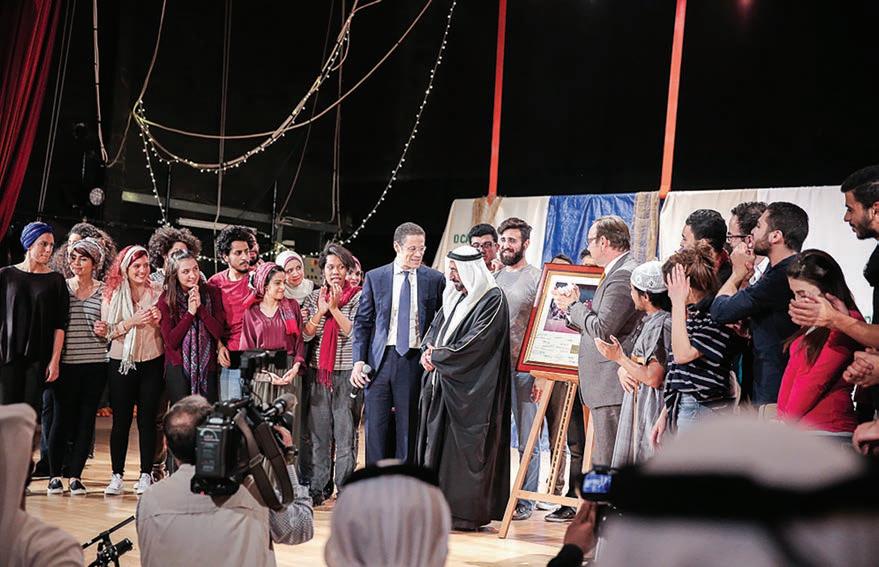
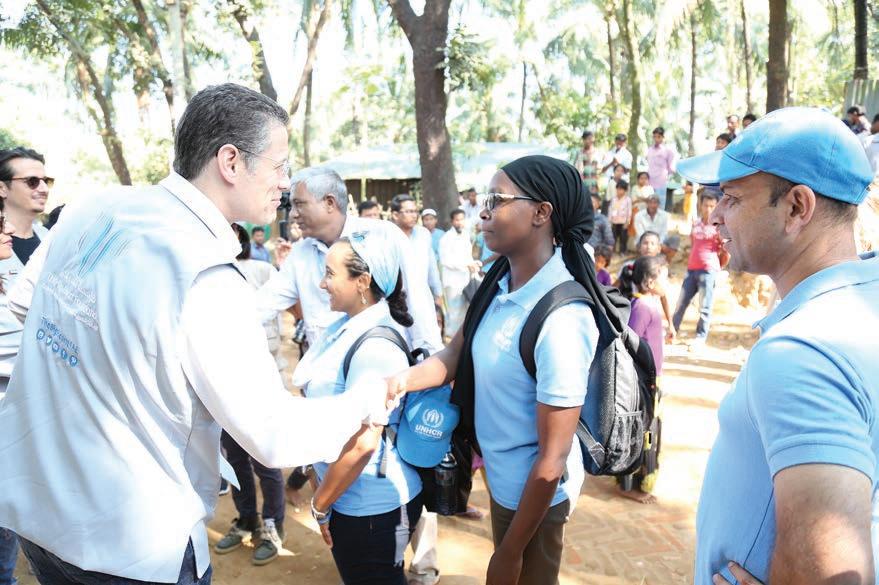
When evaluating a start-up, how do you measure or quantify its potential social impact, and do financial returns compromise that impact?
Primarily, understanding the purpose of a particular start-up or venture or the problem it is setting out to address and solve is integral, even before you evaluate if it can do this sustainably. It is understanding if the venture leader or the entrepreneur behind that idea really understood the problem that they’re setting out to address, and if that solution is clearly articulated. This depends on what stage the start-up is – if it’s just an idea phase, then there’s no evidence yet, hence you must help the entrepreneur come to terms with the issue that they’re trying to solve. If they have some track record and have already generated some impact, then you can dig into those metrics to understand whether that fundamental purpose is being addressed.
Is it possible for you to have a wonderfully combined holistic approach to societal impact, without there being a compromise or a tradeoff? The answer is that it depends on the timeline you’re talking about. In the steady state, I fundamentally believe that there is no trade-off, and there shouldn’t have to be. In the steady state, you will have enhanced economic value and financial returns if you are delivering on that social promise. In the short term though, you may have some compromise, which is why for venture entrepreneurs who are looking for venture capital for growth, they need to make sure that they find investors and venture capital that is aligned with their long-term goals. Many funds today have to generate certain returns over a certain period of time, otherwise it’s going to skew their numbers. If an entrepreneur chooses to accept venture capital from those type of firms, he/she is going to potentially be scrutinized on a quarterly basis
H.H. Sheikh Dr. Sultan bin Muhammad Al Qasimi (UAE Supreme Council Member and Ruler of Sharjah) and Badr Jafar with the artists of the Middle East Theatre Academy’s inaugural project, “Home Grown,” in 2015
POSTED WITH PERMISSION. COPYRIGHT © 2022 LEADERS MAGAZINE, LLC LEADERS17 VOLUME 45, NUMBER 4
Badr Jafar visits Kutupolang Camp in Bangladesh with the Big Heart Foundation in 2017
on financial returns, which might add some pressure and force them to cut corners on their social mission.
We pride ourselves at CE-Ventures – our corporate venture platform – to be invested in someone for the long term if we feel that what they’re doing delivers on the original promise, and if they are also financially sustainable. We do not have the same complexity as institutional venture capital does, but aligning the nature of money with the venture itself is extremely important to have a healthy relationship.
What is one thing that has had a lasting impact on you and that has guided you as you progressed into the leader you are today?
For me, education is a lifelong journey, and with the pace of change in our world getting faster, the sooner we embrace the concept of lifelong learning in our societies, the better it is. While university degrees are still important, because they are valued by our existing economic systems, everyone should really think of education as a skill that needs to keep being honed, otherwise it will wither.
If I had to pick one thing that had a lasting impact on me, it would be my exposure to community service. This was during my time at school, wherein as part of your formal education, you were encouraged to do a few hours of community service a week – from teaching third graders math, to spending time with terminal patients at local hospitals, to helping get groceries for the elderly. These phenomenally impactful experiences helped align priorities for me and helped me overall to define a compass point for the purpose in what I do.
This is also why I have for many years advocated for better community service programs in the MENA region with better

formal opportunities for volunteering. We have a major challenge with youth unemployment in the MENA region pushing it to 40 percent in some countries, which is by far the highest in the world and sadly is getting worse, so we urgently need to create opportunities for youth. This doesn’t need to mean just jobs. In fact, I think a single-minded focus on job creation prevents us from seeing the true challenge and
opportunity that lies ahead of us, and that is instilling a strong sense of purpose and a feeling of belonging within our youth.
The global risks perception survey by the World Economic Forum, published in 2022, highlights youth disillusionment and the erosion of social cohesion as critical short-term threats to the world. Therefore, in parallel with the overwhelming challenge to create tens of millions of meaningful and productive jobs, we urgently need to deploy all the tools at our disposal to strengthen the fabric of our local communities, including through initiatives such as community service. My first exposure to that was through my formal education, so I think as with all very strong societies and economies, an education system that helps to bring out the best of humanity in a person will serve us extremely well, particularly as we go into a world with increasing uncertainty and challenges.
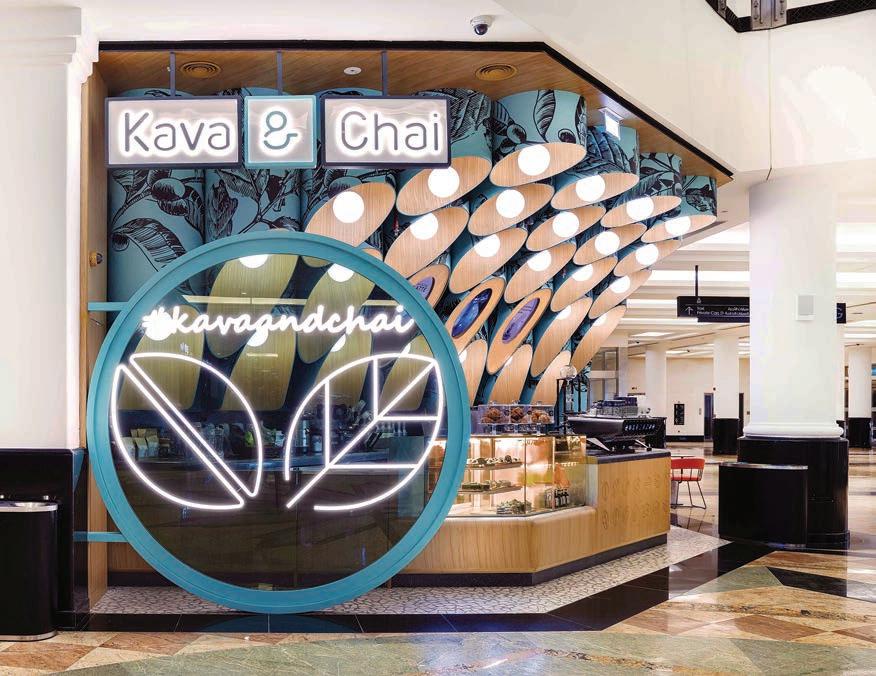
You founded the Pearl Initiative in 2010. What has the organization’s journey been since inception, and how is it working to improve corporate governance?
The Pearl Initiative was established 12 years ago, by business and for business, as a nonprofit organization to promote the business case for embracing corporate governance and sustainable business practices. The Pearl Initiative is steadfast in its belief that high standards of corporate governance and integrity are key drivers of competitiveness, investment, job creation, and sustainable economic growth. The organization pursues its mission by convening business leaders and student communities in programs that span governance in family firms, governance
Badr Jafar presents the current King Charles III with the ‘Pearl Initiative Champion of Sustainability Award’ in 2016
POSTED WITH PERMISSION. COPYRIGHT © 2022 LEADERS MAGAZINE, LLC LEADERS 18 VOLUME 45, NUMBER 4
Kava & Chai, a company owned by Crescent Enterprises, at Mall of the Emirates in Dubai
in tech companies, governance in MSME’s, diversity in business leadership, anti-corruption best practices, and governance in philanthropy.
Over the past decade, the Pearl Initiative has developed and published 155 research reports and data-driven publications, and convened 12,500+ business executives in 222 roundtables, workshops, and webinars held across the Gulf region. A recent Pearl Initiative poll found that 62.9 percent of college students in the Gulf are unaware of the importance of corporate governance, which is why the organization engages with 43 universities across the Gulf and reaching over 11,000 university students through case studies to encourage students to be drivers of change in strengthening the GCC’s sustainable growth trajectory.
You have been spearheading a number of philanthropic initiatives in the region and globally. What role can philanthropy play alongside business and government in solving regional challenges?


For far too long, philanthropy has been treated like the neglected child of our capital system. Here in the MENA Region, and in the broader Islamic World, we have a long history of charitable giving and today, anywhere between 400 billion to one trillion dollars is dispersed in Islamic philanthropy every year, between Zakat and Sadaqah. However, with two-thirds of the population in the Middle East classified as vulnerable to poverty, we are not optimizing the use of this capital.
The UAE is one of the most generous nations in the world, and we have a massive opportunity to create the structures and platforms needed to nurture a new generation of philanthropists and philanthropic ventures that can partner with government and business capital to address our most urgent challenges using the principles of strategic
philanthropy that is transparent in its application and results-driven. This is why I was fortunate enough to collaborate with the likes of the University of Cambridge on the establishment of a new Centre for Strategic Philanthropy, exclusively on strategic philanthropy both within and from the world’s emerging markets, and more recently with NYU-Abu Dhabi on a similar initiative dedicated to the Gulf Region.
As a Founding Patron of the Centre for Strategic Philanthropy and the NYU Abu Dhabi Strategic Philanthropy Initiative, what are you personally hoping they can achieve?
There is a seismic shift that is currently underway across the global economy where the
top 30 fastest growing economies in the world today are all in emerging markets. It’s estimated that over $5 trillion in wealth is going to be passed from one generation to the next within these economies over the next 10 years. This suggests that we can expect to see a significant rise in philanthropic activity in these societies in the coming decades. The overall hope for initiatives of this nature is to help to enhance the impact that philanthropic capital is going to have as it is dispersed within the markets themselves, and from those markets to the rest of the world.
Many philanthropists across the MENA region and many emerging markets such as Latin America, Sub-Saharan Africa, or developing Asia, are becoming increasingly active globally and are dispersing significant funds towards global causes. So, wherever there’s an opportunity to help enhance the impact of that capital, that is what these initiatives are going to be guided by.
The other dimension is one of partnerships and collaborations, and this applies across any sector – business, nonprofit or education. As the saying goes ‘if you want to go far, go together.” There is an opportunity within the philanthropic sector for people to work together and learn from each other through each other’s mistakes and successes.
Through the Centre for Strategic Philanthropy at the University of Cambridge and the Strategic Philanthropy Initiative at the NYU-Abu Dhabi, we are hoping that nonprofit and independent projects of this nature can help bring people together and encourage partnerships and collaborations. It doesn’t always need to be about money being co-invested. There are many different types of collaborations and partnerships that can be formed around philanthropic ventures, so hopefully we can help to connect these dots, because very powerful things can be achieved when you bring people together who have the same purpose and mission and help to pool their resources together and create a multiplier effect.•
Badr Jafar with Bill Gates during his visit to the UAE in November 2019
POSTED WITH PERMISSION. COPYRIGHT © 2022 LEADERS MAGAZINE, LLC LEADERS19 VOLUME 45, NUMBER 4
Badr Jafar with Quincy Joses and children during the filming of Tomorrow/Bokra (charity anthem) in Rabat, Morocco
A STRONG CHARACTER CAN BE IDENTIFIED BY THE WRIST.
The Wempe Iron Walker GMT. At home on Fifth Avenue and in all time zones.


Glashütte I/SA | self-winding GMT | stainless steel 700 FIFTHAVENUE& 55TH STREET • NEW YORK• 212.397.9000 •wempe.com Hamburg Berlin Duesseldorf Frankfurt Munich London Madrid Paris Vienna
Kick Up Some Dust
An Interview with Bernie Marcus

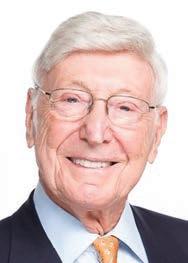
EDITORS’ NOTE Bernie Marcus cofounded Home Depot, the world’s largest home improvement retailer, and served as its inaugural CEO and as its chairman until his retirement in 2002. Over the last several decades, he has redirected his entrepreneurial spirit toward hundreds of charitable endeavors to solve big problems. He has given away more than $2 billion and is a signatory of the Giving Pledge. He is the author of KICK UP SOME DUST: Lessons on Thinking Big, Giving Back, and Doing It Yourself
What interested you in writing the book, Kick Up Some Dust, and what are the key messages you wanted to convey in the book?
I wrote the book because I want to remind readers that the American Dream is still alive and kicking. I was born to immigrant parents and lived in a walkup tenement. We never had much money, but my parents worked hard to make it possible for their children to succeed. The big part of my story doesn’t start until I was fired from Handy Dan when I was 49. Most of my friends were retiring, and I was just thinking about starting Home Depot. I had a lot of experience in business, made plenty of mistakes, but put it all together with great partners in Arthur Blank and Ken Langone. The book is also about what I did after I retired. I knew I needed to use the same lessons we learned building the business to help solve big problems. I always believed in the Jewish concept of tzedakah – giving back. You can’t be selfish. If you become successful, you have to find a way to help others. I was lucky that the “do it yourself” lessons learned from Home Depot helped transform my approach to philanthropy. The key lesson in the book is that you can’t expect others to do the work for you – either in business or giving. I learned this lesson when I began my work with organizations that supported families with autistic children. I knew nothing about the condition, but had an employee whose son was suffering. So, I got involved, asked questions, made calls, and helped build the Marcus Autism Center and fund Autism Speaks. This took years, and I refused to just write a check and walk away. I had an obligation to make it successful.
The other day, I had a conversation with a very successful financier who retired at age 55. I had to ask, “What do you do all day?” He listed his schedule – get up, eat a bagel, read the paper, take a walk, eat lunch, go shopping with his wife, maybe play some golf, then spend time thinking about how to fill tomorrow. I can’t imagine being that disengaged. So, I hope this book speaks to people who have been successful and are looking for meaningful ways to give back. But it should also appeal to entrepreneurs and young people who are creative and willing to take risks and are just beginning their careers. I hope to show hopeful entrepreneurs that if you have the incentive, courage, and intuitiveness you can develop what you want in this world. A lot of people don’t know where to start and reading about my story –warts and all – might give them some inspiration. The book will also resonate with people who may not have a lot of resources, but have time and energy to help in their community. I remember when I was starting out, I didn’t have much, but got involved with City of Hope in Los Angeles. My volunteer work there changed my whole perspective on philanthropy. I also think the book will be popular with Home Depot associates, past and present, and customers. There are a lot of behind-the-scenes stories that shed light on how we built the business that may surprise readers.
You faced many challenges during your career. How critical was resilience to your success and what were the keys to continuing to stay optimistic and push forward?
I learned early on from my mother that bad things happen, and you have to compartmentalize them and keep moving. Don’t “Monday morning quarterback” your life. I once had a retail analyst ask me if I ever made any mistakes. I had to laugh and say, “Are you kidding me? Too many to even mention, but I try to learn from them and focus on how to use that information to do better next time.” In baseball, a good hitter might average .300. I would say, I’m in the .280 range. The whole point is not to think about what you did wrong, but what you did right. I believe you have to go forward and
can’t look backward. People who look backward don’t succeed in life. I worry about people who constantly second-guess their decisions. The key is to take a risk, make the mistake, figure out what happened, fix the problem, and never do it again. That’s the only lesson to be gained from looking back. I’m 93, and I’m planning out my next five years. Writing this book was a bit of a challenge because I had to think about the past, and there are some painful memories that I had to relive. But they don’t define me. If I had looked back on those memories every day, I wouldn’t have been able to move forward.
What do you see as the keys to effective leadership and how do you describe your management style?
There are two key elements to effective leadership. The ability to listen is the main one. A lot of successful people – CEO’s and politicians – lose the ability to communicate effectively because they don’t slow down and listen. If your mouth is open, your ears are closed. The second key is to surround yourself with people who are smarter than you. You can’t surround yourself with people who only say “yes” – it doesn’t work in business. I know my strengths, and always tried to hire people whose traits complemented my own and brought new perspectives. That was the secret to success at Home Depot. We empowered our associates to speak up – if something wasn’t working, tell us. This gave us helpful feedback – sometimes from a longtime manager, or a disgruntled customer, or a 16-year-old kid who had been working for two weeks with an idea that saved us millions of dollars. Other employees would hear how those ideas came about and bring new ideas to the table – and then that just became part of the culture. Reward people for sharing their opinions and you just might learn something.
Do you feel that leadership can be taught or is it a skill that a person is born with?
Some people are born leaders. They just have that gene, but I do believe that plenty of people can excel when given the opportunity, and they just might surprise you. Great leaders often come from unexpected places. Frank Blake was a lawyer who worked for the EPA, Vice President George H. W. Bush, and General Electric, before coming to Home Depot. He worked in corporate business development, so would not have been
PURPOSE
Who is the book targeted to and who are you hoping to reach with your story?
Bernie Marcus
POSTED WITH PERMISSION. COPYRIGHT © 2022 LEADERS MAGAZINE, LLC LEADERS 22 VOLUME 45, NUMBER 4
the most logical choice for the CEO role, but he was terrific. Then he helped pick his successor Craig Menear, who worked in merchandising at Home Depot, and he was equally good. The thing that impresses me is how many women have taken on leadership roles in business. Ann-Marie Campbell, who came from Jamaica, started as a cashier and is now executive vice president for U.S. stores and international operations at Home Depot. I learned long ago that leaders are often great employees who just need to be given an opportunity. They don’t need a Harvard MBA or even a college degree. Give people a chance to show what hard work can do for them and their employer. That was one of our values at Home Depot.
What has made philanthropy so important to you and how do you decide where to focus your philanthropic efforts?
I worked in business for more than 70 years, and I don’t feel the need to make any more money. But I’m not done yet. In 2002, soon after I retired from Home Depot, I was able to commit myself to giving full time. The Marcus Foundation had been up and running since 1989 and, at first, we used a “buckshot approach.” We donated money here and there, and I felt like we helped fix some small problems, but we were not making a measurable difference. What could we do differently? We hired a consultant and narrowed our focus to five areas: Jewish causes, medicine, youth, free enterprise, and community, especially veterans. Our goal is to support causes that have significant impact – like our work with the Avalon Network to help veterans with TBI and PTSD, or developing a liquid biopsy to detect early-stage cancer at Johns Hopkins. I have friends who fly all over the world and sail on yachts. That doesn’t interest me. My new bottom line is helping people overcome issues in their lives. People come up to me and say I changed their life. What is that worth? Far more than any amount of money. Philanthropy that makes a difference is what gives me satisfaction.
Do the same skills that made you successful in business translate to being effective in philanthropy?
Yes, that was the whole impetus for writing the book. I asked myself, how can you take the lessons in business and translate that into helping others? I believe in entrepreneurial

hospital. He didn’t just write a check – he got involved – and said he is now the happiest person in the world. That’s what I call success.
You have achieved so much in your business career and through your philanthropic work. Do you enjoy the process and take moments to appreciate what you have accomplished?
Every day, I wake up and think: “What are we going to try today?” And when something is promising, then I pour energy into finding out how to scale it to serve a national and international audience. That’s what The Marcus Foundation has done with our giving to veterans. Start small, think big, and expect a lot of failure. Not everything we try works, and we won’t scale it until we’re sure it is successful. I’ve also learned not to fall in love with my own bullshit. You have to be careful and not get caught up in the hype. Make sure the program or treatment really works –test and test again. We’ve funded clinical trials that I would bet my life on that did not pan out. There’s a lot of disappointment, but if three out of ten things work, that’s a success. I do enjoy hearing the stories from the parents with a child who gets life-saving treatment, people who survived a stroke, or veterans who are healing from traumatic brain injuries – that is an incentive for me. That’s what keeps me going.
What advice do you offer to young people beginning their careers during this unprecedented time?
philanthropy, and try to persuade others who have been successful to join me – whether they are in their 20s or 80s. I gave a speech about giving in Montreal and got a letter from a guy in the audience a few months later. He said he went home to Florida and was so moved that he dedicated himself to building a children’s
My best advice is to be grateful that you were born in this country. There is no place on earth that prizes innovation like America. Our free-market system encourages you to be creative, work hard, and succeed. That’s what we did at Home Depot and do every day with our philanthropy at The Marcus Foundation. If I was starting out today, I would hope that somebody like my mother would tell me I could do anything, be anything. Work hard, own your mistakes, don’t let failure defeat you, and keep a positive attitude. And remember, you are never too young or old to do something big. I just wish I had another lifetime to see you do it.•
POSTED WITH PERMISSION. COPYRIGHT © 2022 LEADERS MAGAZINE, LLC LEADERS23 VOLUME 45, NUMBER 4
“The key lesson in the book is that you can’t expect others to do the work for you – either in business or giving.”
EDITORS’ NOTE The Chris Paul Family Foundation (chrispaulfamilyfoundation.org) strives to positively impact individuals and families by leveling the playing field in education, sports, and life. The Foundation provides resources that enrich and strengthen healthy development of strong communities. In 2005, Paul and his family established the CP3 Foundation, a philanthropic partnership with The Winston-Salem Foundation in honor of his late grandfather, Nathaniel Jones. The Foundation was created to highlight Paul’s dedication and love, both to his grandfather’s spirit and to the city of Winston-Salem, North Carolina, for nurturing him from his days as a standout high school student-athlete to a national star at Wake Forest University. Recognized as a leader in the area of philanthropy, the Chris Paul Family Foundation uses its platform to impact communities and develop young leaders nationally and globally.
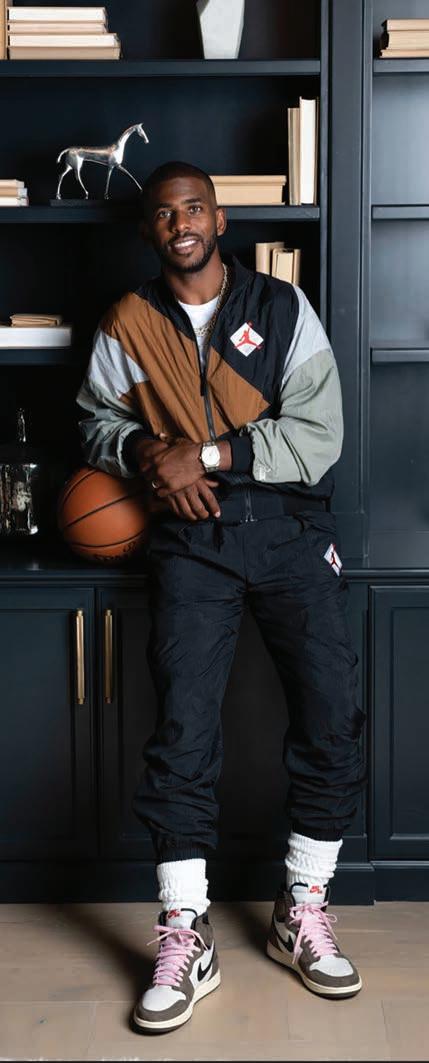

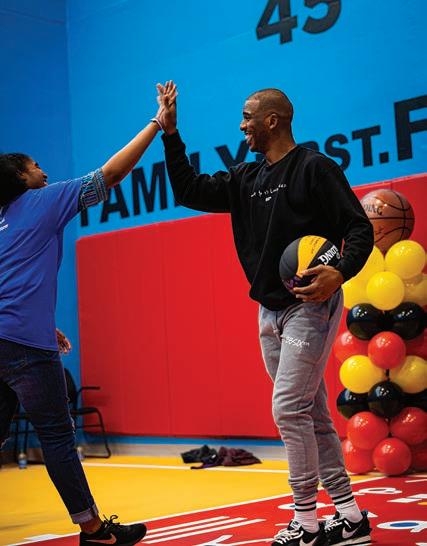
Leveling the Playing Field
The Foundation was created in honor of my grandfather, Nathaniel Jones. He was a pillar of our community and was the first person who showed me how to support our community of Winston-Salem, North Carolina.
Will you provide an overview of the initiatives of the Foundation in its efforts to level the playing field in education, sports, and life?

We have a number of initiatives that provide opportunities to level the playing field for individuals and communities often underserved. Education is extremely important to my family, so we award an academic and athletic scholarship for two high school students in Forsyth County to attend Wake Forest University annually. We also provide resources and internships for students attending historically black colleges and universities (HBCUs).
We showcase the athletic program of HBCUs through our HBCU Basketball Challenge. We also highlight the importance and legacy of HBCUs through my media
PURPOSE
What was your vision for creating the Chris Paul Family Foundation and how do you define its mission?
An Interview with Chris Paul, Founder, Chris Paul Family Foundation
Chris Paul
Chris Paul Leadership Alliance Summit in Los Angeles, 2022
POSTED WITH PERMISSION. COPYRIGHT © 2022 LEADERS MAGAZINE, LLC LEADERS 24 VOLUME 45, NUMBER 4
Family First court refurbishment in Oklahoma City, 2020
company, Ohh Dip!!!. We’ve collaborated with North Carolina Central, Florida A&M University, and Southern University.
Club 61 is our Youth Leadership initiative that targets students ages 15-19. Our goal is to help them enhance and develop leadership skills in the areas of education, health and wellness, tech, financial education and civic participation.
We’ve been able to support a really dynamic internship program through EICOP. The students have a great success rate of turning an internship into a career
opportunity. Additionally, our continued support with the nonprofit organizations in five of the cities I’ve lived in allows us to also continue to impact those communities with an annual donation through Club 61 so that they can have lasting impact on the students they serve.
How did the Chris Paul Family Foundation adapt the way it works to address the challenges caused by the pandemic?
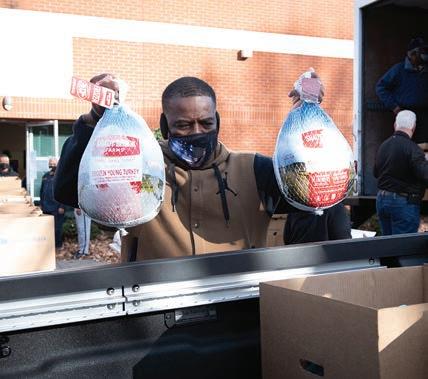
The pandemic allowed us to pivot our work to support some of the critical organizations that were in the field helping communities
stay safe with resources. I was also able to stay involved by participating in virtual events and initiatives.
The pandemic and the social unrest around the country provided an opportunity for me to co-found the Social Change Fund with Carmelo Anthony and Dwyane Wade. We were able to use our collective influence to support organizations on the front line combating the issues that impact black and brown communities with ongoing support.


Where did your passion for philanthropy come from and was the importance of giving back instilled in you early in your life?
My Foundation has always been about the importance of family and community. My grandfather was my best friend and mentor. He was also the first African American in our community to own a Chevron service station. He allowed me and my brother CJ to work with him on weekends.
My grandfather was a leader and I know that he had a large role in shaping me into the man I am today. His commitment to our family and community is what makes me continue to uphold his legacy.
The Chris Paul Family Foundation has made a major impact with its work. Do you take moments to reflect and appreciate what the Foundation has accomplished?
I’m extremely proud of the work our Foundation has accomplished over the years. It’s always nice to reflect on the impact we’ve been able to have, even before I played my first NBA game.
What advice do you offer to young basketball players who dream of becoming the next Chris Paul?
I’d tell young aspiring players to follow their dreams, work hard, and always trust the process.
How special is it to be able to work alongside your family members in fulfilling the mission of the Foundation?
The impact that me and my family have been able to make over my career has been amazing. We support each other and we are all equally vested in making a lasting difference in the world.•
Fireside Chat with the United Negro College Fund & Thurgood Marshall College Fund at Clark Atlanta University, 2022
Holiday Christmas Takeover in Los Angeles, 2015
POSTED WITH PERMISSION. COPYRIGHT © 2022 LEADERS MAGAZINE, LLC LEADERS25 VOLUME 45, NUMBER 4
Chris Paul Family Foundation Thanksgiving Drive in Winston-Salem, 2021
BEST OVERALL FUND GROUP
Small Fund Family Group Over Three Years
For more than 40 years, Calamos Investments has helped investors build wealth through uncertain times.
Founded by John P. Calamos, Sr., the firm has pioneered asset allocation solutions that address the challenges of market volatility and inflation. Our innovative and risk-conscious investment solutions are designed to meet a range of needs, including the search for income and capital appreciation. Learn more at www.calamos.com.
The Refinitiv Lipper Fund Awards, granted annually, highlight funds and fund companies that have excelled in delivering consistently strong riskadjusted performance relative to their peers. The Refinitiv Lipper Fund Awards are based on the Lipper Leader for Consistent Return rating, which is a risk-adjusted performance measure calculated over 36, 60 and 120 months. The fund with the highest Lipper Leader for Consistent Return (Effective Return) value in each eligible classification wins the Refinitiv Lipper Fund Award. For more information, see lipperfundawards.com. Although Refinitiv Lipper makes reasonable efforts to ensure the accuracy and reliability of the data contained herein, the accuracy is not guaranteed by Refinitiv Lipper. Before investing carefully consider the fund’s investment objectives, risks, charges and expenses. Please see the prospectus and summary prospectus containing this and other information which can be obtained by calling 1-800-582-6959. Read it carefully before investing.
©2022 Calamos Investments LLC. All Rights Reserved. Calamos® and Calamos Investments® are registered trademarks of Calamos Investments LLC. Refinitiv Lipper Fund Awards, ©2022 Refinitiv. All rights reserved. Used under license.
Connecting Dreams with Innovation
 An Interview with Bill
An Interview with Bill
EDITORS’ NOTE Bill McDermott has been in his current role and has served as a Member of the Board of ServiceNow since 2019. Previously, he was Chief Executive Officer and a member of the Executive Board of SAP. Before joining SAP, he served in senior executive roles with Siebel Systems and Gartner, Inc. He launched his business career at Xerox Corporation, where he rose to become the company’s youngest corporate officer and division president. McDermott got his start as a young entrepreneur running a small delicatessen business on Long Island, New York, at age 17. He received his bachelor’s degree from Dowling College and his MBA from the Kellogg School of Management at Northwestern University.
 McDermott
President and Chief Executive Officer, ServiceNow
McDermott
President and Chief Executive Officer, ServiceNow
millions – toward solutions to some of the most complex problems of our generation. It’s our calling. It’s who we are.
Our ambition is to be the defining enterprise software company of the 21st century. We can only get there by keeping the customer at the center of everything we do. We know what their employees and their customers are dealing with. It’s our job to deliver for them. We’re a brand-led company with unbelievable passion to dream the big dreams that help our customers win.
What are the keys to ServiceNow’s industry leadership?
ServiceNow is a brand built on trust. Instead of focusing on our own problems, we focus on delivering solutions to the world’s greatest problems. We just celebrated 10 years since our IPO in 2012. I think we have done an excellent job scaling this company, but we have more work to do.
How challenging is it to balance long-term investments in the business with the pressures for short-term, quarter-to-quarter results?
COMPANY BRIEF ServiceNow (servicenow.com) makes the world work better for everyone. The company’s cloud-based platform and solutions help digitize and unify organizations so that they can find smarter, faster, better ways to make work flow so employees and customers can be more connected, more innovative, and more agile, and we can all create the future we imagine. “The world works with ServiceNow™”
How do you define ServiceNow’s mission and values?
We owe everything we were, are, and ever will be to our founder, Fred Luddy. He invented ServiceNow to create beautiful experiences at work in service to people.
That’s still our purpose: We make the world work better for everyone. We put the strength of 20,000 employees – plus an ecosystem of
Business leaders want to invest in one strategic platform they can trust. We’re the only ones who do what we do, how we do it. When I talk to customers, they are tired of the same old story of doing one thing well in one department, with siloed islands of automation across the rest of the organization. With ServiceNow, you can innovate without disruption. You have a single threaded platform with a gorgeous user experience – serving IT, the employee experience, the customer experience – making it easy for anyone to create apps with low code.
How important is brand awareness for ServiceNow and is the scale and strength of ServiceNow well-understood?
A brand is so much more than a logo, font, or color palette. It’s a movement. At ServiceNow, our brand tells the world who we are. That is why we are honored to say, “The World Works with ServiceNow.” We’re in the business of connecting dreams with innovation. We’re activating all our employees, customers, and partners to do that. Each team member is a catalyst in making the world work better.
Exponential thinkers keep their focus on the vision when others have doubts. One leader put it well: “If we slow investment in the short term, we’ll lose ground in the mid term, and we won’t be in business for the long term.” It’s very clear that businesses can no longer do what they always did to solve new problems in an ever-changing world. We’re now in a “tech to compete” world.
In this era for digital business, leaders are shifting their investments to technologies that deliver outcomes faster. Software is the greatest deflationary force out there. If your company’s mission is focused on transforming challenges into opportunities, that’s an elixir for success in any economic climate.
What are your views on the future of work and how is technology changing the world of work?
We’re in the biggest talent war in the history of business. You must take great care of your team if you want to retain them. You have to listen to them. You need to inspire them. You must onboard them properly, train them, make sure they have the right services for the moments that matter. Digital technologies are fundamental to this. They’re shaping the future of work. We use ServiceNow at ServiceNow. No one has to remember which system to use for what task. They go to a single portal that connects their HR, finance, IT tools... everything – one single portal for all their needs.
PURPOSE
Bill
McDermott,
POSTED WITH PERMISSION. COPYRIGHT © 2022 LEADERS MAGAZINE, LLC LEADERS27 VOLUME 45, NUMBER 4
“In this era for digital business, leaders are shifting their investments to technologies that deliver outcomes faster. Software is the greatest deflationary force out there. If your company’s mission is focused on transforming challenges into opportunities, that’s an elixir for success in any economic climate.”
This is where the world is going. Mobile is making field jobs more accurate, faster. Physical offices are destinations for collaboration. I see a sensational opportunity for innovation.
What are the keys to building employee retention and winning the war for talent?
Talent is at the heart of every great company. Leaders must have the humility to recognize their success will be based on building a winning team. The key is to surround yourself with masters of their craft, then get out of their way to let them achieve. None of us is as smart as all of us.
Then, you must totally love your team. It’s important to show people that you are here to serve. People don’t care how much you know until they know how much you care. I keep score of the leaders who are givers. Giving their time, mentorship, and praise to help others get up when they’re down. Creating that kind of collective passion for generosity ensures no one is left behind. When we each give discretionary effort, we all win.
While layoffs are happening across this industry and others, ServiceNow is hiring. It’s essential to our future as the defining enterprise software company of the 21st century. We are doubling down on our talent brand. That’s a reflection of our deep belief in the amazing potential of this company, this platform. Simply put: There’s a massive opportunity for talented professionals who aspire to build the future on ServiceNow. We are better than we were yesterday, not as good as we will be tomorrow.
Will you highlight ServiceNow’s commitment to building a diverse and inclusive workforce?
To be the defining enterprise software company of the 21st century is not just based on the size, scale, and the business success, it’s actually leaving a legacy when you leave it a lot better than when you found it. The best team wins, and the best team wins because it has the best talent. And the best talent is always diverse.
We’re so fortunate to have a fantastic leader in Karen Pavlin. We worked together at Xerox many years ago. She has my full support working to expand our commitment to diversity, equity, and inclusion. We are partnering closely with HBCUs. We are investing in under-represented communities. We are funding belonging groups so employees have a safe space to be themselves.
A more equitable world is a better world. Our work is never done.
Will you discuss ServiceNow’s responsibility to the communities it serves and to being a force for good in society?
Everything we do is in service to our purpose: We make the world work better for everyone. Every CEO wants to deliver on their ESG goals. I recently spoke with one CEO who said, “If it matters, it counts.” Leaders need a solution to manage their ESG efforts. They want to measure the impact they’re making and hold their teams accountable. They want data in real-time to make decisions that will help make a difference. We’re the first to deliver a ‘solution in a box.’
So many organizations put their trust in us. With our total focus on improving people’s lives, we remain hungry and humble on our bright path forward.
What do you see as the keys to effective leadership and how do you describe your management style?
I’ve always believed if you build a great team that will follow you up any hill, you can defeat any challenge. Great leaders build a foundation of trust through leading with empathy. If you treat people with dignity and respect, they always give it back to you. Trust is the ultimate human currency.
Set high expectations. Great leaders never walk past a problem. They never settle for the status quo and they’re the first to change it. They empower each person to live up to their true potential. This will require sacrifice. That is why leadership is the art form of developing followership.
Everything worth communicating is almost always under-communicated. Great leaders have their team all in on the purpose. Then, they get their team totally dialed in on the vision and the strategy to fulfill that purpose. It must be so clear, so easy to understand, so compelling that everyone is inspired to be part of the movement. You simply cannot overestimate the impact of communication.
What advice do you offer to young people beginning their careers during this unprecedented time?
You’ve got to have The Dream. One of my favorite quotes comes from the great Robert Kennedy, “Some men see things as they are, and say why. I dream of things that never were, and say why not.” Once you identify your Winners Dream, visualize exactly how to get there. Engage in activities to put yourself in a position to win. If not you, who? If not now, when? Dream even bigger than ever before. Then, execute on the details each and every day. There is no replacement for passion. Winners define destiny.•
“We’re in the business of connecting dreams with innovation. We’re activating all our employees, customers, and partners to do that. Each team member is a catalyst in making the world work better.”
POSTED WITH PERMISSION. COPYRIGHT © 2022 LEADERS MAGAZINE, LLC LEADERS 28 VOLUME 45, NUMBER 4
“People don’t care how much you know until they know how much you care. I keep score of the leaders who are givers. Giving their time, mentorship, and praise to help others get up when they’re down. Creating that kind of collective passion for generosity ensures no one is left behind.”
Own it.
For 95 years, Alliant has been home to some of the most dynamic and entrepreneurial producers in the business hailing from across the nation and serving in a broad range of industries.
Alliant is the premier place to propel your career to new heights, and the reasons are simple. We give you the resources to succeed. We surround you with outstanding people. Then we get out of your way.
At Alliant, we take ownership seriously and even offer our producers an opportunity to own equity in the company.

Inc. 1301 Dove Street, Suite 200 Newport
92660 CA License No. 0C36861
Alliant Insurance Services,
Beach, CA
Why? Because we believe you should own your success.
The TB12 Method
EDITORS’ NOTE In addition to her role with the TB12 Foundation, Lisa Borges is also the Founder and Chief Executive Officer of Anchor Foundation Consulting, LLC. She is on the faculty of the Sports and Entertainment Impact Certificate Program, a virtual training program at the intersection of sports, entertainment and philanthropy. Borges has also served as the Interim Executive Director of the Cam Neely Foundation for Cancer Care and spent more than 18 years as the Executive Director of the Doug Flutie, Jr. Foundation for Autism. On a volunteer basis, she is the Founder of the Celebrity and Athlete Foundation Forum. Additionally, Borges serves on the Advisory Board and is a mentor and guest speaker at UMass Boston’s Sport Leadership and Administration Program and is a Board Member of the Fellowship of Christian Athletes for Central and Western Massachusetts. While with the Flutie Foundation, she also served as an Executive Committee Member for Advocates for Autism of Massachusetts and a Board Member of the Alexis Miranda Foundation. Borges earned a BA degree in political science from Westfield State University, a certificate in nonprofit/public/organizational management from Clark University, and a JD from New England Law.

FOUNDATION BRIEF Founded in 2015 by seven-time Super Bowl Champion Tom Brady, the TB12 Foundation (tb12foundation.org) is a nonprofit organization dedicated to maximizing the health, well-being, and athletic potential of underserved athletes and service members by providing free access to health and wellness resources that support preparation, performance, and recovery – empowering people who are at-risk due to economic or health-related obstacles to reach their performance and life goals. Through its services, the Foundation aims to educate and help athletes improve longevity, prevent injury, and stay on the field, court, track, or course doing what they love, better and for longer.
Will you highlight the history of the TB12 Foundation and how you define its mission?
Tom Brady and Alex Guerrero created the TB12 Foundation in 2015 to help bring the groundbreaking TB12 approach to people who were most in need and not able to access TB12’s services due to their financial situation.

A scholarship program was developed and has helped hundreds of underprivileged athletes recover from injury, improve longevity, and prevent further injury with approximately 9,500 treatment sessions donated. Since that time, the definition of athlete has expanded from high school and college athletes to tactical athletes including active and retired service members as well as individuals who have experienced a tragic event. The Foundation’s goal is to help all (amateur) athletes maximize their health and potential by educating them on the five pillars of the TB12 Method and providing free resources to improve longevity, prevent injury, and do what they love, better and for longer.
Will you provide an overview of the work of the TB12 Foundation and its initiatives?

In addition to the scholarship program which provides eligible recipients the full TB12 experience at no cost, the Foundation has established a number of community partnerships where TB12 Centers are currently
located including Massachusetts and Florida. As an example, we’ve partnered with two public school districts where groups of 12 student-athletes from each school visit our TB12 Sports Centers in Boston and Foxboro, Massachusetts every month. The students are provided pliability work with our Body Coaches, functional training and prehab exercises, and mentorship aimed at helping them be the best possible versions of themselves on and off the field. We’re proud to have this opportunity to deepen our commitment to these underserved athletes in our communities.
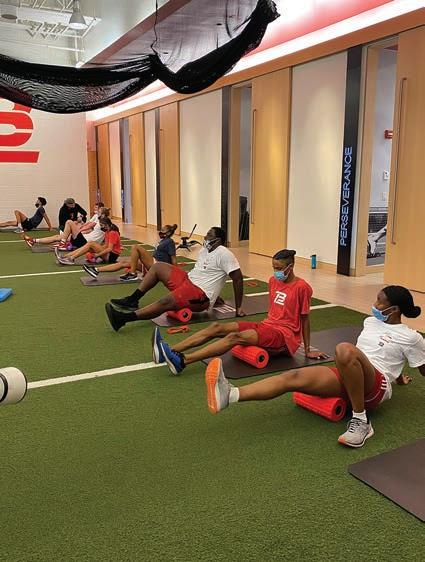
We have also established community partnerships in the Tampa area with the Pinellas County Schools, Tampa Bay Sports Commission, Tampa PAL, and Operation Healing Forces to support thousands of students, athletes, and special operation forces warriors.
Furthermore, the TB12 Body Coaches run sessions on functional strength and conditioning, cognitive health, pliability with active warm-ups, and provide group workouts and educational talks on nutrition and hydration to hundreds of teens and coaches throughout the year.
How did the TB12 Foundation adapt the way it works to address the challenges caused by the pandemic?
As a result of the pandemic, TB12’s facilities were forced to close their doors to ensure the safety of all team members and clients. However, we took the opportunity to make beneficial changes in the organization and focus on giving back to our local community. The Foundation started with the frontline healthcare workers who were battling the pandemic in hospitals nationwide. We provided over 200 healthcare workers access to free virtual health and wellness consultations with TB12 Body Coaches, working one-on-one to take a more holistic approach for caring for their minds and bodies during this difficult time. In addition, virtual sessions have been added as an option for Foundation clients due to the global pandemic.
The TB12 Foundation also took the opportunity to get even more involved in our community and to become change-makers in a space we have control over. Racial inequality and social justice came to the forefront of the national conversation in June 2020, and the TB12 Foundation chose to use this inflection
PURPOSE
Lisa Borges
An Interview with Lisa Borges, Executive Director, TB12 Foundation
POSTED WITH PERMISSION. COPYRIGHT © 2022 LEADERS MAGAZINE, LLC LEADERS 30 VOLUME 45, NUMBER 4
Tom Brady with the Pinellas Education Foundation (top); TB12 Brockton Program Foxboro (above)
point in the country as an opportunity to work towards real advancement in the community.
Beginning with Foxboro, the team was introduced to a community organizer and activist in Brockton, Massachusetts. Conversations ensued between the leaders in the community and the TB12 team, as the group charted a path towards new initiatives aimed at directly impacting the underserved and at-risk people of color in Brockton. While COVID-19 restrictions delayed the start of the program by a few months, the students were able to begin sessions in early November 2020 and continue to come in once a month throughout the school year. It was a great bonding experience for many of the students who felt isolated during the pandemic and lost without their sport or teammates around.
How critical are metrics to measure the impact of the TB12 Foundation’s work?
Metrics play a very important role as our work in the community continues to expand. Since the Foundation was revitalized in 2020, the goal has been to increase the number of
people we serve through additional awareness and outreach in new communities. We use a number of evaluation tools to measure our impact including pre- and post-surveys for program participants as well as applications, progress and impact reports for all scholarship recipients. In addition, we measure our level of success through the many testimonials we receive from individuals whose lives have been changed by their commitment to health and wellness through the TB12 method.
Will you discuss Tom’s passion and commitment for the work of the Foundation and how deeply engaged he is in its efforts?
Both Tom and Alex are very passionate about sharing their belief that everyone can benefit from a smarter, more holistic approach to health and wellness. Their goal is to teach as many people as they can that the healthy daily habits learned from the TB12 Method will help people who want to stay active do what they love, better and for longer. The earlier student athletes understand this, the more success they will have. The community partnerships formed

by the Foundation give Tom and Alex an opportunity to share this message with at-risk youth as well as service members who may have suffered a chronic injury and want to stay healthy and active for their family. Tom takes the opportunity whenever he can to speak to the students participating in our programs and encourages them to keep going and let them know their hard work will pay off.
Did you always know that you had a passion for this type of work and what makes the work so special for you?
Like many working in the nonprofit community, I fell into this line of work over 20 years ago by chance. I always loved watching sports growing up, especially football, and went to law school because I had aspirations of being a sports lawyer. While working for a sports marketing firm in Boston, I connected with Doug and Laurie Flutie who started a foundation in honor of their son who was diagnosed with autism. I ended up managing their Foundation for 18 years and developed a passion to help individuals and their families live life to the fullest despite the many setbacks we often face. This has transferred to my work with the TB12 Foundation and my interest in educating people of all ages on how to take care of their body from a holistic approach. Seeing the success stories of our scholarship recipients firsthand has truly been an amazing experience and gives me an opportunity to educate others on the importance of staying healthy.
What are your priorities for the TB12 Foundation as you look to the future?
As TB12 Sports grows and expands geographically, the Foundation will have an opportunity to engage partners that align with our mission in a growing number of communities. We want to reach as many people as possible and take the lead on educating students at a young age about the importance of health and wellness from an innovative and holistic approach. As Tom will tell you, it’s a lifelong journey of healthy daily habits. The principles of the TB12 Method are not necessarily all new concepts but when combined, can transform lives and maximize the potential of
off the field.•
athletes both on and
“With the TB12 Foundation, we’re committed to extending access to innovative health and wellness resources for those who would otherwise be unable to obtain access without financial assistance. Our goal is to educate all athletes and individuals who want to stay active so they can continue doing what they love for as long as they want.”
POSTED WITH PERMISSION. COPYRIGHT © 2022 LEADERS MAGAZINE, LLC LEADERS31 VOLUME 45, NUMBER 4
Tom Brady
The Profession

EDITORS’ NOTE William J. Bratton is one of the world’s most respected and trusted experts on risk and security issues. During a 46-year career in law enforcement, he instituted progressive change while leading six police departments, including seven years as Chief of the Los Angeles Police Department and two nonconsecutive terms as the Police Commissioner of the City of New York. He is the only person ever to lead the police agencies of America’s two largest cities. As the Executive Chairman of Risk Advisory for Teneo (teneo.com), Commissioner Bratton advises clients on risk identification, prevention, and response. Prior to assuming his current role, Commissioner Bratton was the 42nd police commissioner of the City of New York from January 2014 to September 2016. It was the second time he had held the post. During that time, he oversaw 32 months of declining crime, including historic lows for murders and robberies. Commissioner Bratton spearheaded a major technological overhaul, the Mobile Digital Initiative, which gave a smartphone with custom-designed apps to every officer and put a tablet in every patrol car. Commissioner Bratton also implemented major reforms to the New York Police Department’s counterterrorism program by developing two new units – the Critical Response Command (CRC) and the Strategic Response Group (SRG) – which now provide the city with more than 1,000 highly trained and properly equipped officers who are dedicated to counterterrorism, large-scale mobilizations, site security, and rapid deployment citywide. In the 1990s, Commissioner Bratton established an international reputation for re-engineering police departments and fighting crime. As Chief of the New York City Transit Police, Boston Police Commissioner, and in his first term as New York City Police Commissioner, he revitalized morale and cut crime in all three posts, achieving the largest crime declines in New York City’s history. As Los Angeles Police Chief from 2002 to 2009, in a city known for its entrenched gang culture and youth violence, he brought crime to historically low levels, greatly improved race relations, and reached out to young people with a range of innovative police programs. Commissioner Bratton currently serves as the Chair for the Secretary of Homeland Security’s Advisory Council.
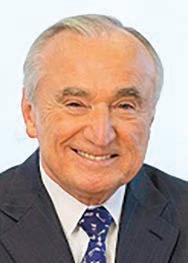
What are your views on the current state of policing in America?
I think that there is no denying that American policing is in a state of profound crises, probably more than in any other time over the past 50 years that I have been associated with it. I use the word crises because there are multiple issues happening all at the same time. There is the issue of an increasing crime rate, particularly shootings and murders in many of our inner cities in America; there is an increasing tolerance for disorder and aberrant behavior as we are tolerating behavior that we would not have accepted when I first came into law enforcement; and there is a significant lack of trust in government entities at this particular time, coming out of the Trump era and continuing now as we go into the 2022 midterms and 2024 Presidential election, and this mistrust of government extends to law enforcement as we see the FBI is viciously under attack from the former President. As a result, this lack of trust, lack of confidence, and lack of success in controlling crime and disorder has led to the challenging state of American policing today. Another major challenge is the need to recruit talented, young individuals of all races, ethnic backgrounds, and sexual orientations to join the industry. What was looked at for decades as a noble profession is no longer perceived to be the case.
Are you optimistic about the opportunity to meet the challenges you described?
I am probably the least optimistic I have been in my over 50 years of being involved in American policing when I look at the various problems and challenges I just outlined. I am still actively engaged with the profession and it is clear that there has not been much success in addressing these concerns at the moment. I am someone who for all my life has seen crisis as an opportunity, but there are only so many crises you can deal with at the same time, and I do not envy my colleagues that are still in the business who are facing these issues. There has been a major turnover of chiefs of police around the country over the past few years which is another challenge as we are losing some of our most seasoned and committed veterans who are retiring for a number of reasons.
While I am clearly concerned today, I remain optimistic that we can overcome these challenges, but we need to be realistic that there is no quick fix, and this is going to take time and commitment to make a real and sustainable impact.
What are your views on the integrity and transparency in police forces today with the incidents of police brutality that have been witnessed in recent years?
The cornerstone of American policing is integrity, honesty, and commitment, and this remains among the vast majority of police officers. At the same time, there is no denying that those in the profession that are flawed are being exposed by technology such as body cameras and artificial intelligence, and while I believe this only refers to a small number of officers, it is magnified immensely through social media and other platforms. I do not believe that it is a fact that there is so much of it, but more that what is there has been played over and over again. There is an old saying in the media that, “if it bleeds, it leads,” and today almost every major news network starts its program with not one, not two, not three, but four or five crime stories.
There is a very important and positive aspect of this in that it allows us to detect bad behavior and to corroborate that behavior more than was possible in the past, and it allows us to use those instances where they are corroborated to act as examples of what not to do.
It is important to acknowledge that much of what is seen in clips on the news or on social media is legal, authorized behavior in situations where officers are trained to use force, but those who are angry or frustrated with the police do not view it this way.
What can be done to build back trust between the police and the communities they serve?
This is by far the secret ingredient that is essential – absent trust, the public is not going to respond to police behavior, lawful or otherwise. The challenge for police is to first and foremost regain trust for the men and women of that police department, and for leadership to be transparent when mistakes are made. In 1829, Sir Robert Peel highlighted the “Nine Principles for Policing” and if you look at these nine principles today, they are as relevant as they were in 1829. The essence
PURPOSE
William J. Bratton
POSTED WITH PERMISSION. COPYRIGHT © 2022 LEADERS MAGAZINE, LLC LEADERS 32 VOLUME 45, NUMBER 4
An Interview with William J. Bratton, Executive Chairman, Risk Advisory, Teneo
of it is that the people are the police, and the police are the people. Police officers come from the communities they serve, and every police commissioner today started as a police officer, with the vast majorly of them, like me, coming from working class families who entered the profession for the right reason and worked their way up through the ranks to be in leadership positions.
The importance of trust between the police and the community cannot be overstated – you can’t do it for them, you can’t do it to them –you must do it with them.
What was your vison for writing your latest book, The Profession?
This is my third book. My first book, The Turnaround , detailed my time as New York City’s police commissioner, starting in 1994, and the progress we made over those 27 months in bringing serious crime in New York City down by 33 percent and cutting the murder rate in half. I wanted to tell my story about a kid growing up in a working-class family in Boston and reaching the pinnacle in policing. Along the way, I made mistakes, had successes, developed leadership skills, and hired top talent that worked together as a team. The second book, Collaborate or Perish , focused on the importance of collaborating across the boundaries of our networked world – those who collaborate will thrive in the networked world; those who can’t are doomed to perish. This applies to policing –if we don’t collaborate with the criminal justice system, if we don’t collaborate with the community, if we don’t collaborate with political leadership, then we will perish. The third book, which you referenced in your question, The Profession , is a memoir. It looks at the path of policing over the past 50 years, both the good and the bad, and provides my views on the keys to transformative leadership. I hope that this book helps provide a foundation and framework for future police leaders, and it inspires them through some of the examples of my time in law enforcement which included many successes, as well as many setbacks and times when I needed to get back up, dust myself off, and be resilient.
Did writing these books provide you an opportunity to look back and reflect on your career?
Writing these books did allow me the opportunity to reflect and provided me with a
lot of satisfaction, while at the same time there was a lot of soul searching about things I may have done differently. For example, my relationship with Mayor Giuliani. If I had
stressful career. This profession provides the opportunity to make a difference every single day and to have a life of significance. When the time comes for you look back at your career, if you did the job with integrity, if you did the job with commitment, and if you did the job focused on making a difference, you will have had a fulfilling and rewarding career. The actions of each and every police officer counts – all you have to do is look at the murder of George Floyd. The actions of that one police officer murdering George Floyd impacted countless lives and set American policing back 20 years.
The profession matters because in this country, you cannot have law and order without the police. Police are an essential element of the criminal justice system. They are the men and women who are in the arena, and the collective work of the profession keeps this country together. I just did an epilogue to The Profession since the editors wanted me to address the events of January 6. I truly believe that on January 6, American policing saved American democracy. The actions of the mob, directed by a sitting President of the United States, were intended to destroy our democracy. If not for the actions of the Metropolitan Police and the Capital Police that day, many of whom I believe did not know at the time the full extent of the role that they were actually having in saving our democracy, things would have turned out much differently.

known then what I now know about managing above, managing below, managing sideways, I would have done a better job of managing my relationship with him which may have provided the opportunity for me to stay with the NYPD not for 27 months, but possibly for four or five years. We had built tremendous momentum with a 40 percent reduction in crime, and when I left, a number of other very talented and key people also left. My leaving cost them their careers, and in many respects, this cost New York City years of additional victories in the fight against crime. I look back at that time with many great feelings about the impact we made and our successes, but also think about what might have been.
What advice do you offer to young people interested in a career in policing?
I encourage them to pursue this career, while being clear that it is a challenging and
Are you worried about the future of American democracy?
I certainly am. I am a student of history and read about history all the time. I just finished reading a biography of Hitler that is about 1,000 pages long, and I just finished reading a biography of Churchill that is also about 1,000 pages long. When you match up what Hitler and Churchill were battling each other about, in the 1930s in particular, I see similarities to what is going on in America today in the sense of how divided the country is – the move to the far right by some and the move to the far left from others. I do not worry about the police profession because I believe that the police will do the right thing as they did on January 6, and when someone in law enforcement does not do the right thing, they need to be held accountable. When I look to the future, I am concerned, but I am optimistic that
angels
our better
will prevail.•
POSTED WITH PERMISSION. COPYRIGHT © 2022 LEADERS MAGAZINE, LLC LEADERS33 VOLUME 45, NUMBER 4
“This is by far the secret ingredient that is essential – absent trust, the public is not going to respond to police behavior, lawful or otherwise. The challenge for police is to first and foremost regain trust for the men and women of that police department, and for leadership to be transparent when mistakes are made.”
90 Years of Innovation
EDITORS’ NOTE Farooq Kathwari has been Chairman and CEO since 1988. He serves in numerous capacities at several nonprofit organizations including the Board of Overseers of the International Rescue Committee; the advisory board of the Center for Strategic and International Studies; and the Council on Foreign Relations. He is Chairman Emeritus of Refugees International; an advisory member of the New York Stock Exchange; former Chairman of the National Retail Federation; Director Emeritus and former Chairman and President of the American Home Furnishings Alliance; a Director of the Institute for the Study of Diplomacy at Georgetown University; Co-Chairman of the MuslimJewish Advisory Council; and a member of the International Advisory Council of the United States Institute of Peace. He served as a member of the President’s Advisory Commission on Asian Americans and Pacific Islanders from 2010 to 2014 and was tapped to join the congressionally mandated United States Institute of Peace bipartisan Task Force on Extremism in Fragile States co-chaired by Governor Tom Kean and Congressman Lee Hamilton, who formerly led the 9/11 Commission. Among his recognitions, Kathwari is a recipient of the 2018 Ellis Island Medal of Honor and has been inducted into the American Furniture Hall of Fame. He has been recognized as an Outstanding American by Choice by the U.S. government. He has received the Yale School of Management’s Chief Executive Leadership Institute Lifetime of Leadership Award; the National Human Relations Award from the American Jewish Committee; the National Retail Federation Gold Medal; and Ernst & Young’s Entrepreneur Of The Year™ Award. He has also been recognized by Worth magazine as one of the 50 Best CEOs in the United States. Kathwari holds BAs in English literature and political science from Kashmir University, Srinagar, and an MBA in international marketing from New York University. He is also the recipient of three honorary doctorate degrees.

COMPANY BRIEF Ethan Allen Interiors Inc. (ethanallen.com) is a leading interior design company and manufacturer and retailer of quality home furnishings. The company offers free interior design service to its clients through the
efforts of approximately 1,500 in-house interior designers and sells a full range of furniture products and decorative accessories through its website and a network of approximately 300 Design Centers in the United States and abroad.
Ethan Allen owns and operates nine manufacturing facilities including six manufacturing plants in the United States, two manufacturing plants in Mexico, and one manufacturing plant in Honduras. Approximately 75 percent of its products are made in its North American plants.
Ethan Allen is celebrating its 90th anniversary this year. What have been the keys to Ethan Allen’s longevity and ability to stand the test of time?

To achieve 90 years of profitable business, you have to constantly innovate, have strong teams, and be entrepreneurial and disciplined, understanding that motivated people are essential to success. Our vertical integration from manufacturing to retail to logistics has been the key to our success, along with the importance of having relevant products throughout our history.
How critical is continuous improvement and constant reinvention to Ethan Allen’s success?
The only way to achieve longevity is by constant reinvention, yet I’ve always believed that an innovative culture is built on core values
that never change. We stay focused on our core brand advantages: the strong position of our global retail network; our vertically integrated structure that allows us to manage the Ethan Allen experience from concept to delivery; the personal service of our designers, now combined with technology; and the diversity of our styles and our customization offerings. We then look for innovative ways to make those differentiators even stronger. When you control your core values, the “how” can evolve with the times.
How do you define Ethan Allen’s purpose and mission?
Our mission is to provide great service to our clients and take care of our associates. The past two years have been extraordinary in terms of consumers’ focus on the home, and serving our clients through challenging times has strengthened our sense of purpose. We strive to improve every client’s quality of life by helping them create a place they’ll love to come home to every day. We achieve this by offering exceptional personal service from design to delivery, offering products of the highest quality, and crafting most of our furniture to order in our workshops.
Ethan Allen is guided by a core set of leadership principles. Will you highlight these principles and how deeply engrained they are in Ethan Allen’s culture and values?
Our Leadership Principles go back to what was said earlier: Innovation begins with knowing what you stand for. One of the most
PURPOSE
Farooq Kathwari
An Interview with Farooq Kathwari, Chairman, President and Chief Executive Officer, Ethan Allen Interiors Inc.
POSTED WITH PERMISSION. COPYRIGHT © 2022 LEADERS MAGAZINE, LLC LEADERS 34 VOLUME 45, NUMBER 4
“To achieve 90 years of profitable business, you have to constantly innovate, have strong teams, and be entrepreneurial and disciplined, understanding that motivated people are essential to success.”
important things to be in 21st-century business is agile, so I devote three of our principles to that concept. The principle of Excellence + Innovation – strive for the highest quality and embrace an entrepreneurial spirit – is supported by two additional principles: Change (embrace change and do not be afraid of it) and Speed (react quickly at pivotal moments).
The principles of Leadership, Hard Work, Priorities, and Justice call us to set an example for others, to be known for our work ethic, to discern between what’s important and what isn’t, and to make fair and thoughtful decisions. When we are grounded in what is right, we can turn our attention to how we treat others. This is where the principles of Accessibility, Confidence, and Client Focus come into play.
How is technology impacting Ethan Allen’s business and how important is it to make sure that the focus on technology does not take way from the personal relationship and human touch that Ethan Allen is known for?
Technology doesn’t take away from personal service; it opens up more opportunities for connection. For instance, most of our interior design projects begin with what was an innovation for us in 2019: our 3D Room Planner, which we’ve recently updated with even more photorealistic graphics. Now, by the time they’ve come to the Design Center, most clients have already connected with their designer via email or video chat. Our 3D Room Planner makes that connection possible.
This year, we also debuted a first-of-its-kind Virtual Design Center where clients can take a 3D or virtual walk through 25 different rooms in three different projections: Timeless & Refined, Carefree & Relaxed, and Livable Modern. They can shop for products, create and share shopping lists, and even co-browse with their Ethan Allen designer – there again, the opportunity to connect. In its final form, this Virtual Design Center will represent 30,000 square feet of gallery space, with 75 indoor and outdoor room settings and more than 2,000 shoppable products. Technology has also played a key role in maintaining and growing our manufacturing in North America.
How important has it been for Ethan Allen to have roughly 75 percent of its manufacturing in North America as the world has been facing such deep supply chain challenges?
The supply chain challenges facing every industry are well-known – shortages of drivers, containers, trailers, and ocean vessel space; port closures, port congestion, and premium freight rates. We are unique in that we decided to maintain our manufacturing in North America. When I became President about 37 years back, we operated 30 manufacturing plants, each purchased in different time periods – a very inefficient way of doing business. We consolidated our manufacturing in four important areas of North America – Vermont, North Carolina, Mexico, and Honduras – where about 75 percent of our products are made and most orders by our clients are custom.
Will you discuss Ethan Allen’s commitment to build a diverse and inclusive workforce?
We are proud to have a diverse and inclusive workforce. One of our company’s proudest achievements is our elevation of women into leadership positions: 69 percent of our retail leaders are women, as are 58 percent of our leaders at our headquarters. As a GSA contractor, Ethan Allen is an Equal Opportunity Employer, ensuring freedom from discrimination on the basis of protective classes.
I always say America is a microcosm of the world. Our country brings together so many people from all parts of the world and from diverse perspectives – there’s no other country quite like us. Being a proud American brand means aspiring to greater diversity within our walls.
What do you see as Ethan Allen’s responsibility to be a good corporate citizen and engaged in the communities it serves?
Social responsibility starts at home: We take care of our people internally, then branch out to our communities. We start by ensuring that the standards with which we treat our associates are consistently applied throughout our global organization. Then, we strive to develop partnerships that help our associates feel connected to their communities. We hold events to support
local not-for-profits, and some of our Service Center managers have good relationships with local chapters of Habitat for Humanity.
We also think globally in terms of our responsibilities, both in terms of quality of life and protection of our natural resources. We’re proud to champion economic opportunity for artisans all over the world, and we have a clear Supplier Code of Conduct that we expect our supplier partners to follow and to reinforce with their own subcontractors. We’ve also made a lot of progress in cutting our carbon footprint and sourcing wood for our manufacturing from responsibly managed forests. We’re currently setting new sustainability goals for 2030, and we plan to be operating with net zero carbon emissions by 2050.
You devote a great deal of your time and expertise to humanitarian efforts, including working for human rights and developing international conflict resolutions. Will you discuss this work and what has made these efforts so important to you?
I grew up in Kashmir, a region divided by politics, ethnicity, and religious difference for more than 70 years. When I was not yet five years old, politics intervened and our family was separated for over 10 years, and we were designated as “refugees.” I am sure this helps to explain why, in the decades since then, I’ve devoted much of my time and energy to seeking solutions to the conflicts of the region that still bring suffering to people.
Helping others was also the guiding principle in the life of my son, Irfan Kathwari, who left this world 30 years ago at the age of 20. Irfan went to help in many troubled regions of the world, even though I pleaded with him to come home and focus on his studies. His last reply was, “You do not have to worry about me, Dad. What is happening in the world is important. I am just trying to figure out what I can do to help. It is our job to help people who are less fortunate than us. Unless we do what we can to help others, our lives are meaningless.”
The call to help the people around us, and in other parts of the world, is a call to which every leader must respond. When we help others, we leave a legacy that inspires others to take action, just as my son’s passion continues to inspire me.
As Ethan Allen celebrates its 90th anniversary, have you had the opportunity to take moments to reflect and celebrate all that Ethan Allen has accomplished?
We are a proud American brand. While we are a publicly listed company, we have maintained our core values and have also been consistently profitable. Our associates take pride in our work and our clients appreciate what we do and are loyal to our brand. We are truly blessed.
Earlier this summer, we had the opportunity to come together as an Ethan Allen family and celebrate our 90th year during our virtual and physical convention, which included more than 4,000 associates from all over the world. We’ve come a long way from our Vermont roots, but we’ve never forgotten who we are, and I always say this: “The best
come.”•
is yet to
POSTED WITH PERMISSION. COPYRIGHT © 2022 LEADERS MAGAZINE, LLC LEADERS35 VOLUME 45, NUMBER 4
“The call to help the people around us, and in other parts of the world, is a call to which every leader must respond.”
The journey, elevated
Experience the joy of private flight. Because no matter where you’re going, it matters how you get there.
Learn more about membership options and pricing at wheelsup.com.
 All Wheels Up flights are operated by our DOT/FAA-authorized air carrier subsidiaries (Wheels Up Private Jets LLC, Alante Air Charter LLC, Gama Aviation LLC, Mountain Aviation LLC, Sterling Aviation LLC, and TWC Aviation LLC) or by an approved vendor air carrier that has undergone our safety assessment.
All Wheels Up flights are operated by our DOT/FAA-authorized air carrier subsidiaries (Wheels Up Private Jets LLC, Alante Air Charter LLC, Gama Aviation LLC, Mountain Aviation LLC, Sterling Aviation LLC, and TWC Aviation LLC) or by an approved vendor air carrier that has undergone our safety assessment.


The Built Environment
EDITORS’ NOTE Laura Hines-Pierce is Co-CEO working side-by-side with Chairman and Co-CEO Jeff Hines to help shape firm-wide strategy and manage key risks. She is a member of the firm’s Executive Committee and a member of the Investment Committee. Hines-Pierce joined Hines in 2012 and was responsible for project management of developments and support of new business opportunities in the Midwest and Southeast Regions. She served as Project Manager for River Point, a 1.1 million-square-foot, 52-story office tower and 1.5-acre park located in Chicago’s West Loop submarket. Her responsibilities included zoning and entitlement, relationship management with equity partner Ivanhoé Cambridge, budget and schedule oversight, design and construction coordination, financial analysis, leasing and marketing. In 2017, Hines-Pierce worked in the Office of the Chief Investment Officer, focused on several firm-wide initiatives that have helped to refine investment strategy and acquisition efforts. From 2018-2020, she was the firm’s Transformation Officer to support strategic and transformative efforts across the business. In addition, Hines-Pierce was part of the grassroots team that established the OneHines Women’s Network, leading to the creation of its Diversity, Equity & Inclusion initiative. Prior to joining the firm, she worked for Sotheby’s in New York and interned at Eastdil Secured. Hines-Pierce earned a BA in economics and art history from Duke University and an MBA from Harvard University.
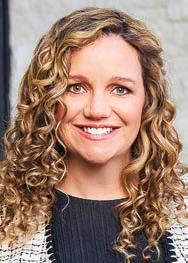
FIRM BRIEF Hines (hines.com) is a privately owned global real estate investment firm founded in 1957 with a presence in 285 cities in 28 countries. Hines oversees investment assets under management totaling approximately $90.3 billion. In addition, Hines provides thirdparty property-level services to 373 properties totaling 114.2 million square feet. Historically, Hines has developed, redeveloped or acquired approximately 1,530 properties, totaling over 511 million square feet. The firm currently has more than 198 developments underway around the world. With extensive experience in investments across the risk spectrum and all property types, and a foundational commitment to ESG, Hines is one of the largest and most respected real estate organizations in the world.
Will you discuss the history of Hines and how the firm has evolved?
Since our founding in 1957, my grandfather, Gerald D. Hines, had a vision to make Hines a leader in quality and innovation in the built environment. Throughout his career, he always championed the power of high-quality real estate because market-leading projects tend to be better long-term investments, and also because they contribute to better cities and a more sustainable world. He liked to “raise the bar” on himself and then watch the industry follow only to continue the cycle. This entrepreneurial spirit has been instilled for more than six decades and three generations of our family.


From a humble one-man-shop, we started developing office and warehouse buildings, and
then a coterie of small but architecturally significant office buildings that were progressive for the ’60s. The breakout moment was in the early ’70s with the simultaneous development of One Shell Plaza and The Galleria in Houston. Modeled after Milan’s Galleria Vittorio Emanuele, the mixed-use development presaged an innovative twist in the future of enclosed shopping centers and was an early predictor that mixed-use would become a golden catalyst for successful cities. One Shell, at 50 stories, was the tallest lightweight concrete building in the world and also provided an early proof point that sustainability would become an imperative in the built environment. That building is still, today, one of the most efficient in its market and competitive set.
In the next two decades, we collaborated with leading architects, such as Philip Johnson, to create design-forward buildings which could
PURPOSE
Laura Hines-Pierce
An Interview with Laura Hines-Pierce, Co-Chief Executive Officer, Hines
POSTED WITH PERMISSION. COPYRIGHT © 2022 LEADERS MAGAZINE, LLC LEADERS 38 VOLUME 45, NUMBER 4
Hines, along with Cresset Wealth Advisors and Levy Family Partners, are developing Brava, a luxury for-rent residential high-rise community in Houston
also “pencil out.” Proving that spec, multitenant buildings could also be elegant, highfunctioning architectural contributions to cities was one of my grandad’s greatest achievements.
Unique to Hines, we house a group called Conceptual Construction which is involved in almost every major development we do around the world. They bring the full knowledge, best practices, and risk management of Hines’ 65 years of experience to bear on each project, in partnership with the teams on the ground that have intimate knowledge of that project, site, and strategy. Our experience as a developer and a top-class property manager makes us a better buyer and investor. We know buildings from the inside out and I think this gives us a significant underwriting advantage.
Today, we’re in 285 cities in 28 countries, have $90.3 billion of investment assets under management and more than 114.2 million square feet of managed assets.
How do you define Hines’ culture and guiding principles?
When my grandfather started Hines, our culture and guiding principles were rooted in integrity, quality, and the entrepreneurial spirit. We still hold these values dear today, as we strive to be the best real estate investor and exceptional partner in the cities and countries where we operate. Our team members are at the center of our passion to be the best, while also having a profound impact in our communities.
How important is innovation to Hines’ success and where is innovation taking place in the firm?
My grandfather was a mechanical engineer with a passion for innovation and efficiency. Energy conservation has always been embedded in our DNA. We even helped the USGBC develop the LEED rating system. Today, we’re laser focused on remaining an ESG leader in the real estate industry, a sector that emits nearly 40 percent of global energy-related carbon emissions.
As we look to the future, the two most important trends are ESG and innovation. This includes utilizing disruptive technology and data to dramatically reduce our environmental impact, especially carbon emissions from our 1,500-plus properties. We’re committed to achieving this by incorporating renewable innovations and building methods that will root out carbon emissions entirely.
How do you define your role as Co-CEO and what are your key areas of focus?
I became Co-CEO at a pivotal moment for Hines, the real estate industry, and for my family. Hines recently celebrated our 65th anniversary and during that time, the company had grown into a global investor, developer, and property manager with $90 billion in assets. We’ve been known for city-defining buildings like Salesforce Tower in San Francisco, One Vanderbilt in New York City, and One Museum Place in Shanghai, but fewer people realize that we’re also an investment manager with logistics, residential, and retail assets. I’m proud to be part of the third generation leading the company that my grandfather founded in 1957 and my father led for the last 30 years. I’d like to think that we are reaching back to our roots with full product diversification and a core commitment to sustainability.
More broadly speaking, it is also a unique time for the real estate industry. The pace of innovation in real estate is finally catching up with other industries, and another one of my primary focuses continues to be positioning Hines at the forefront of those changes.
While I share CEO duties with my father, Jeff Hines, our roles and skillsets are complementary. Dad and I rely on one another for our different perspectives as the world changes. He has led the company over the last 30 years, and I’m focused on the next 30 years and will push the boundaries of how real estate can positively impact people’s lives while retaining our DNA and legacy of quality and integrity.
net zero and are becoming more concrete with our goals and training our teams to execute the strategies and tactics we’ve been developing around carbon reduction.
While our efforts will continue to evolve and become increasingly more ambitious to align with our net zero goal, they demonstrate that Hines is invested in doing the work and has already begun to make meaningful progress towards a lower carbon future.
What do you see as Hines’ responsibility to support the communities it serves and to be a force for good in society?
Hines has taken significant steps in paving the way to be a force for good in global real estate. We are actively collaborating with the wider real estate industry, and several established industry bodies and new organizations focused on achieving net zero, like ULI.
We are also encouraging collaboration within the industry to address climate change and modeling how other companies can meaningfully follow suit. For example, our Embodied Carbon Reduction Guide, written in partnership with Magnusson Klemencic Associates (MKA), an award-winning structural and civil engineering firm, provides the entire commercial real estate industry with methods to achieve significant reductions in carbon emissions, all in an effort to attempt to collectively lower the built environment’s responsibility for all energy-related carbon emissions generated across the globe.
Do you feel that there are strong opportunities for women to grow and lead in the real estate industry?
How critical is it for Hines to build a diverse and inclusive workforce to bring diverse perspectives and experiences to the table when making business decisions?
Our OneHines initiative supports an inclusive culture in which all Hines employees feel valued and have equal opportunity to achieve their maximum potential. With offices in 27 countries around the world and a workforce of more than 4,850 professionals – 40 percent of which are female – we believe that diverse skills and viewpoints make us stronger and better able to serve our investors, partners, clients, and communities. As we continue to grow in the future, our DE&I initiatives remain a huge focus for us and tie into our larger, long-term ESG strategy.
Will you discuss Hines’ commitment and initiatives around ESG?
As a firm, we are taking immediate, ambitious steps to reduce the built environment’s carbon footprint and we’ve set a target of netzero operational carbon in our building portfolio by 2040. By targeting operational carbon, we aim to reduce emissions through renewable technologies, without purchasing carbon offsets. We have a multi-pronged approach to
We can do better to support and provide opportunities for women across this industry. One of my goals is to close the gender gap in real estate. This is why I am proud to shepherd the OneHines Women’s Network, an internal effort to further focus on diversity, equity, and inclusion. The goal of this organization is to foster an inclusive culture where Hines employees feel valued and have equal opportunity to achieve their maximum potential. As a woman in the C-suite at Hines, my primary goal is to elevate and hire more female leaders.
What advice do you offer to young people interested in building a career in real estate?
My first piece of advice is to be a good listener. People look to their leaders for cues on how to act in certain situations and it made me realize that I might not have all the answers, but collectively, we can get through anything. I had to take control and be proactive in an uncertain situation, which taught me resilience. Finally, it taught me to express gratitude more frequently, especially for my team. Recognition goes a long way, and it should be reciprocated to anyone interested in making a career in real estate.
However, on a personal level, when I was named as the Co-CEO, I was pregnant with my second child, who was born in April. It’s important for people to know that you can prioritize your career and family in a role like this, and that it’s okay to do both. I hope by the time my children come of age it is not out of the ordinary
to see a pregnant CEO successfully lead a firm.•
POSTED WITH PERMISSION. COPYRIGHT © 2022 LEADERS MAGAZINE, LLC LEADERS39 VOLUME 45, NUMBER 4
“As a firm, we are taking immediate, ambitious steps to reduce the built environment’s carbon footprint and we’ve set a target of net-zero operational carbon in our building portfolio by 2040.”
Making the World a Better Place
EDITORS’ NOTE Before founding Kasich Company, John Kasich served two terms as the Governor of Ohio. He served as a member of Congress from central Ohio for 18 years and, as the Chairman of the House Budget Committee, he led the effort to balance the federal budget for the first time since 1969 and helped enact historic welfare reform. After leaving Congress in 2000, Kasich worked as a managing director in the Investment Banking Division of Lehman Brothers, where he helped companies secure the resources they needed to succeed and create jobs. He was also a commentator for FOX News, a Presidential Fellow at his alma mater, The Ohio State University, and a candidate for the Republican nomination in the 2000 and 2016 Presidential campaigns. Kasich is the author of four New York Times best-sellers: Courage is Contagious; S tand for Something; The Battle for America’s Soul; and Every Other Monday , which was published in

2010 and focuses on the importance of faith in making both everyday choices and life-changing decisions. His most recent books are Two Paths: America Divided or United and It’s Up to Us –Ten Little Ways We Can Bring About Big Change. Today, he also serves as a senior commentator for CNN.
COMPANY BRIEF The Kasich Company, (kasichcompanyllc.com), co-founded by John Kasich and Beth Hansen, connects and convenes their unique international network of leaders to effectively address its clients’ pain points and opportunities. Kasich Company offers its clients the expertise of publicsector leaders with private-sector capabilities who work to develop results-oriented, common-sense, and unifying approaches to solving problems at the federal, state and local level.

We wanted to create a company that provides advisory services to those who find themselves in a connection between business, government, and people. We have a strong knowledge of government from our many years of service, and I have been involved in business on and off throughout my career, so we understand people and how they impact both government and business. It has been very satisfying since we are engaged in so many projects that are meaningful, such as pediatric mental health, adult mental health, environmental issues, and economic development. We have also been involved in healthcare, particularly in the area of rural health, which has been very fulfilling.
The Kasich Company is focused on furthering the areas we believe in and trying to make the world a better place. Ultimately, we need to believe that our involvement is going to lead to advances in society and our work with companies will make the world better. We understand that companies need to make money and be profitable in order to succeed, but at the same time we are focused on things like ESG (Environmental, Social

PURPOSE
What was your vision for creating Kasich Company and how do you define its mission?
John Kasich
An Interview with John Kasich, Founder, Kasich Company
Governor John Kasich signs a bill he championed in 2017 to protect Lake Erie and improve the environment
POSTED WITH PERMISSION. COPYRIGHT © 2022 LEADERS MAGAZINE, LLC LEADERS 40 VOLUME 45, NUMBER 4
“The Kasich Company is focused on furthering the areas we believe in and trying to make the world a better place.”
and Governance) with these companies. It is the same philosophy that I had as Governor, which was to take on things that I believe can advance our society. We know that companies can do well and do good at the same time.
My business partner, Beth Hansen, was my Chief of Staff when I served as Governor and ran my campaigns. She and I have worked together for a long time which has made it very easy as we build the Kasich Company. We have many people that we have known a long time who we can reach out to as resources and engage in our work.

What can be done to address the divisiveness that is present throughout the world to bring people together?
It starts with us. Everyone wants to know what someone else can do to make this a better, more connected world, and it is not about what somebody else can do. It is about what we as individuals can do. It is about the way we treat our family, the way we treat our neighbors, the way we treat our friends, the way we treat people that we disagree with. If we keep in mind that everyone is made in the image of
God, then everyone deserves respect, regardless of whether we agree or disagree with them. This may not sound exciting, but it is pivotal if we are going to build a more connected world.
There is no one in this world that is perfect –we all fail miserably all the time, but that does not mean that we can’t do better and treat people better. The current Surgeon General is focused on something that I find very interesting, which is that people are very lonely. My wife has an amazing gift in dealing with the elderly. She does not get paid for it and does not work in the field – she just comes upon it. I am so proud of how she makes time in her life to visit with the elderly and to treat them with kindness and care. That is what I call being significant.
You mention loneliness. How much does the isolation and loneliness that is present today at all ages concern you?
It is very concerning. The ability to get beyond surface relationships at the human level is invaluable. It means you can open your heart, share your successes and loses, your happiness and pain – that is what life is all about.
Do you miss being in public service?
I don’t because in many ways I feel that I am still in it. There is nothing more fulfilling than working with companies to help them solve problems and become more successful. For example, I love the work we are doing in pediatric mental health. In many respects, I am still involved in public service, but it is through business as opposed to holding elected office.
With all the challenges facing the world, are you optimistic about the future?
I am optimistic. We have our challenges, but we also see the world being pulled together, for example with NATO regarding Ukraine. We have seen poverty alleviated; we have seen health improve – not everywhere, but there has been steady progress. My concern is the rise of authoritarianism since I do believe that people having a voice and the basic principles of freedom of speech and religion is critical.
In terms of the United States, I think we are going through a phase right now – it is a serious phase, but what people need to believe and know is that it is up to us to come together to build community and strength in our society.•
“Everyone wants to know what someone else can do to make this a better, more connected world, and it is not about what somebody else can do. It is about what we as individuals can do. It is about the way we treat our family, the way we treat our neighbors, the way we treat our friends, the way we treat people that we disagree with.”
Governor John Kasich joins members of Jesse Owens’ family in 2018 to establish the Jesse Owens State Park & Wildlife Area
POSTED WITH PERMISSION. COPYRIGHT © 2022 LEADERS MAGAZINE, LLC LEADERS41 VOLUME 45, NUMBER 4
“The ability to get beyond surface relationships at the human level is invaluable.”
Investing in Passion
An Interview with Miles S. Nadal, Founder and Executive Chairman, Peerage Capital Group


EDITORS’ NOTE Miles Spencer Nadal (milesnadal.com) is an international entrepreneur and philanthropist. His belief in the importance of investing in passion and empowering people to pursue their highest goals has framed his approach to both business and philanthropy. Under Nadal’s ownership, Peerage Capital’s residential real estate business has grown into a Top 10 North American real estate services company with a focus on the luxury market. Peerage Realty Partners invests in the passion of entrepreneurs and their teams to accelerate their growth. Peerage Capital is also a leader in the Canadian self-storage business and in the independent wealth management and investment banking business in Canada and in the U.S.
Nadal has been a consistent force with his ongoing support of many community-focused philanthropic initiatives. These include the Miles S. Nadal JCC, an inclusive urban community hub in Toronto, the Miles Nadal Heart Centre with the Sinai Health Network, the Miles S. Nadal Management Centre at the Schulich School of Business, and the Miles and Kelly Nadal Youth Centre. He is an active supporter of local food banks, summer camps, and programs for young, aspiring entrepreneurs.
In Israel, Nadal’s support extends to the Miles S. Nadal Institute for Technological Entrepreneurship at Tel Aviv University and many other community causes including Yad Vashem, Dudevan and United Hatzalah.
Nadal has been nominated for Canada’s Top 40 Under 40 and was the recipient of Ernst & Young’s Entrepreneur of the Year Award™. Among his awards are the Harold Lederman Award for Philanthropic Leadership, Jewish National Fund Negev Honoree, Toronto Chapter of the American Marketing Association Marketing Hall of Legends, Executive of the Year by MEDIA Magazine , and Damon Runyon Cancer Research Foundation honoree. Nadal was awarded an Honorary Doctorate of Philosophy degree from Tel Aviv University, and was recognized for contributions to Harlem RBI, an initiative for youth playing, growing, and learning. He is a member of the Board of Governors of Tel Aviv University where he endowed a home for technological innovation and entrepreneurship, as well as serving on the International Board of Governance of The Peres Institute.
FIRM BRIEF Peerage Capital (peeragecapital.com) is a leading North American business services and private investment firm. It focuses on partnerships with passionate entrepreneurs in the service sectors. In addition to talented teams, it seeks out opportunities to achieve scale through both organic growth as well as acquisitions, operating synergies, and brand differentiation. It supports the partner firms in which it invests by providing capital as well as a team of experienced professionals who add value in such areas as strategy, finance, technology, marketing, mergers and acquisitions, and communications. Peerage Capital’s long-term investments are across several sectors, primarily real estate services, real estate development and management, land assembly, self-storage, asset management and wealth advisory services. Across every sector, Peerage Capital operates with a strong culture of partnership, collaboration, and alignment of interests, both economic and cultural. Peerage Capital’s unique “Professional Partnership” model has been refined over 42 years to accelerate growth through value-added services that enhance the sustainable, profitable growth rate of the organization, maximizing value for all stakeholders. Peerage Capital’s largest operating business is Peerage Realty Partners, a leading residential real estate services firm, serving luxury markets across North America. Its partners include leading Sotheby’s International Realty franchisees, and renowned independent firms in both re-sale residential real estate brokerage and new construction marketing. Peerage Realty core service activities include real estate financing, transaction services, asset management, and home improvement for purpose-built rental properties. It is currently one of the top 10 largest residential real estate service firms in North America with over 7,000 best-in-class sales representatives and employees with 276 offices across Canada and the United States selling over $70 billion of residential real estate annually. Peerage Capital has over $10 billion of assets under management across its various platforms.
one consistent factor across every sector and every economic cycle: when principled, talented people are passionate about what they do, they are successful, and they create cultures and opportunity for themselves and others. Our corporate tagline says it all: We invest in passion.
It is worth noting that Peerage Realty Partners, our North American residential real estate services business, took shape just as we entered a profound global economic crisis in 2008. Remember, this was a crisis specifically rooted in North American real estate and lending. At that time, when the consensus view was overwhelmingly negative, we identified and selectively partnered with the most talented entrepreneurial people and businesses that we believed would best weather the storm and prosper in the face of adversity. Those people and those businesses are still our partners today and they are the bedrock upon which Peerage was built.
It helps enormously that Peerage is a private company run by an experienced leadership team that has been together for over 20 years in many cases. While we have the advantage of taking a longer-term perspective on performance and we are not pressed to make decisions for quarterly results, we do have exceptional rigor and discipline when it comes to operating our businesses in which we are partners. However, because we take the time to align values and continually collaborate, our approach and our expectations are clear to our partners.
How do Peerage Capital’s values and principles impact its business?
Peerage Capital began as a vision that reflected my previous decades as an entrepreneur starting in 1980. I started my first businesses in my teens, and over time I observed
You could say we reverse-engineered Peerage Capital starting with our values and principles of partnership and building a large enterprise around them. That gives you an idea of just how essential our principles are to our businesses and to the partnerships upon which we base them. Having that clearly articulated set of principles is a real differentiator in any competitive market – especially in the services sector where we are focused. Think about it: Our companies are in residential real estate, storage, real estate services, as well as wealth management. The common denominator in each of those businesses is trust. Securing and honoring trust is fundamental and everything else is rooted in our Principles of Partnership.
We have 12 Principles of Partnership, but they come down to this: respect and be loyal to
PURPOSE
Will you discuss the history of Peerage Capital and how it has shaped the growth of the company?
POSTED WITH PERMISSION. COPYRIGHT © 2022 LEADERS MAGAZINE, LLC LEADERS 42 VOLUME 45, NUMBER 4

LEADERS43 VOLUME 45, NUMBER 4
Miles Nadal, Founder and Executive Chairman, Peerage Capital Group POSTED WITH PERMISSION. COPYRIGHT © 2022 LEADERS MAGAZINE,
LLC
your clients and your partners, and work hard in good faith to serve their interests as well as your own; build trusting and supportive long-term relationships by being honest, a good listener, and a committed communicator; always make the effort to be kind and compassionate; and give back to your community.

It’s not quite a principle, but Peerage has also been shaped by my deep personal belief in the power of dreams. I have dreamt big my whole life and I gravitate to others who never think or act small. That’s the evolution of my philosophy, “Dare to dream.”
What is the philosophy around Peerage Capital’s investment strategy and how critical is the power of partnership as part of the strategy?
We invest in talented entrepreneurial people – and their passion – first and foremost. If Peerage can partner with the right people, with passion, a lot of the other variables take care of themselves. We also veer toward services sectors where we know we can add value and accelerate growth. Those are businesses that typically lend themselves to the partnership structure.
We have always used a partnership philosophy and model because it encourages entrepreneurs and their teams to retain an emotional and financial ownership stake in their enterprise. We want to tap into their passion and their vision – who knows their business better than they do? As partners, we provide financial and human capital and other resources that allow them to amplify their growth organically and through other partnerships. They provide the vision, experience, and regional market knowledge that boosts their business organically. But if they – or Peerage – identify a potential partnership that we can leverage on their behalf, we set about engineering a transaction. We have
done several of these “tuck-unders” on behalf of existing partners – the deals can require finesse and patience, but they are worth it.
Over time, we have taken the time to grow the way we want to grow and with whom we want to grow. Over 2021 and so far in 2022,
we’ve forged a lot of new partnerships in the U.S residential real estate market, for example, but those did not happen as suddenly as it may seem to others. We did a lot of advance analysis and planning so that when opportunities surfaced, we were ready to move.
Today, Peerage is a very different company –certainly in terms of size. But our values are absolutely the same, along with that focus on partnering with passionate, industry-leading professionals.
Will you discuss Peerage Capital’s partnership principles and how these principles provide Peerage with a sustainable point of differentiation and competitive advantage in the marketplace?

Our partnerships give us remarkable strength and resilience – especially in a period of somewhat greater economic uncertainty. We have forged a corporate culture that prizes strategic curiosity. We ask the same hard questions of ourselves – and others – in good times and in tough times. The fact that Peerage Realty Partners forges genuine partnerships rather than making outright acquisitions is also key. It means our budgeting and planning process benefits from a collaborative integrity that incorporates the wisdom and perspective of our experienced partners across North America – as well as our own analytics and modelling.
If our partners raise a red flag, we listen closely. If they flag an opportunity, we also listen up. Because we start with trust, aligned values and a collaborative mindset, we move
Miles Nadal and wife, Kelly Grier
POSTED WITH PERMISSION. COPYRIGHT © 2022 LEADERS MAGAZINE, LLC LEADERS 44 VOLUME 45, NUMBER 4
Dr. Frank Luntz, Pollster and Global Communication Strategist, and Miles Nadal
forward seamlessly – not that we do not have some intense debates from time to time! That candid spirit of partnership is a true differentiator for Peerage. We are always recalibrating it, but I am certain there are very few companies anywhere in the world that are as genuinely committed to balancing the autonomy of partners with the strength of the collective enterprise.
Will you provide some specific ways the Peerage partnership model has created value?
Overall, Peerage is a great catalyst for accelerated growth of each of our partnership enterprises. It has often been said that it is lonely at the top – especially in an intensely competitive and fast-changing sector like residential real estate, where we have become one of the top 10 North America brokerage firms by annual sales volume. This is even more true when markets shift from one phase to another.
As a specific example, Peerage Realty Partners has consciously created a community of like-minded entrepreneurial “peers,” all with proven track records of success and a sharp eye for opportunity. They have developed trust and respect in one another, allowing them to informally connect on whatever issues or challenges they encounter. Peerage facilitates their interactions through events, through regular calls and collaborative projects. Our leaders spontaneously share information and experience and use one another as sounding boards which started to happen during the deeply uncertain early days of COVID. It provided an impetus for them to connect and share market insights, but it has steadily gained momentum since then.

 Miles Nadal, Ambassador Gilad Erdan, Permanent Representative of Israel to the United Nations, and Sarah Nadal
The Honorable Tony Blair, former British Prime Minister, and Miles Nadal
Miles Nadal, Ambassador Gilad Erdan, Permanent Representative of Israel to the United Nations, and Sarah Nadal
The Honorable Tony Blair, former British Prime Minister, and Miles Nadal
POSTED WITH PERMISSION. COPYRIGHT © 2022 LEADERS MAGAZINE, LLC LEADERS45 VOLUME 45, NUMBER 4
“We are always recalibrating it, but I am certain there are very few companies anywhere in the world that are as genuinely committed to balancing the autonomy of partners with the strength of the collective enterprise.”
The results speak for itself: Peerage Realty now has partnerships with 22 leading residential real estate brokerage and related services firms with over 7,000 advisors and employees, and 280 offices across the U.S. and Canada, selling over $70 billion of residential real estate across North America. We have also had exceptionally robust growth at Vaultra Storage, our fastexpanding Canadian self storage business, and our independent wealth advisory and investment banking firms, ARS in New York City and Echelon Wealth Advisors in Toronto, have over $10 billion of assets under management.
What do you see as Peerage Capital’s responsibility to support the communities it serves and to be a force for good in society?

Community is everything – whether it is our CEOs coming together internally or our shared commitment to connect and support those among whom we live and work. The importance of community has been deeply reinforced through the pandemic and carries forward in the current climate of economic uncertainty. At a time of global fragmentation and disruption, we must focus more than ever before on the common denominators that bind us all together, not on the differences that drive us apart.
All of us within the Peerage circle are aware that as a team and as individuals, we are very blessed. One way we practice gratitude is to engage with the communities around us, especially those in need. It’s one of our Partnership Principles and we make sure that commitment is more than pretty words. For example, we make it a priority for Peerage and for all our partner companies to do more than donate to a worthy cause or sit on a board – although
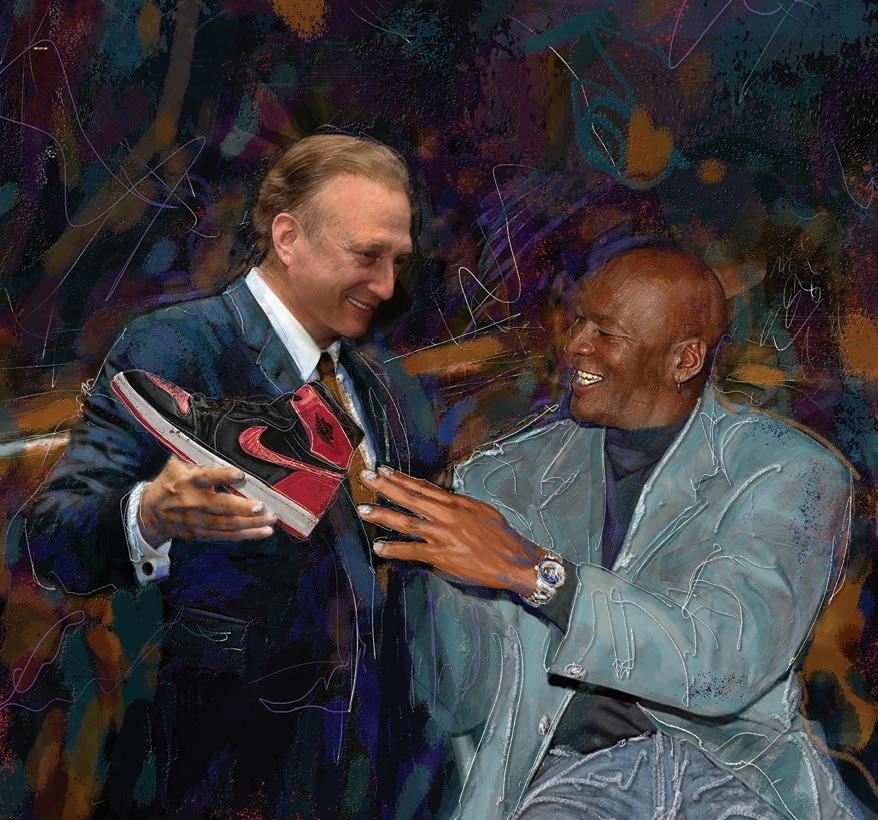 Sean “Diddy” Combs, Miles Nadal, and DJ Khaled
An artist’s rendition of Miles Nadal and Michael Jordan
Sean “Diddy” Combs, Miles Nadal, and DJ Khaled
An artist’s rendition of Miles Nadal and Michael Jordan
POSTED WITH PERMISSION. COPYRIGHT © 2022 LEADERS MAGAZINE, LLC LEADERS 46 VOLUME 45, NUMBER 4
“But dreaming big has always been my way – my way of propelling myself forward – and I want to validate others in a meaningful way. That is why entrepreneurship is a big part of my philanthropic portfolio – it is also compatible with the Peerage business model of partnering with entrepreneurs.”
that is important as well. We encourage them to really roll up their sleeves and get directly involved with delivering through local Meals on Wheels programs, volunteering at food banks and clothing drives – and as a company, we are more than happy to match the funds they raise or to support a specific event. If someone has a passion for a certain issue, we make sure they have the time to dedicate to it.
In the earliest stages of our conversations with potential partners, their involvement with their communities is one of the first things we want to talk about.
You commit a great deal of your personal time and resources to philanthropy. Where did your passion for philanthropy develop and how do you decide where to focus your efforts?
I come from a very modest economic background. I know exactly what a transformational difference it can make in a young person’s life to have access to an academic program, or a summer camp, or some piece of equipment that their family might not otherwise be able to afford. My guiding principle of contributing time, talent, and treasure to the benefit of others has been the quote from Forest Witcraft, “100 years from now, no one will ever remember the car you drove, the house you lived in, or for that matter, how much money you had in your bank account, but the world may be a different place if you have made a difference in the life of a young person.”
I have been that kid. I know all about it. On top of that, much of what I have accomplished in my life began with people telling me that something couldn’t be done and that I was crazy for trying. But dreaming big has always been my way – my way of propelling
myself forward – and I want to validate others in a meaningful way. That is why entrepreneurship is a big part of my philanthropic portfolio –it is also compatible with the Peerage business model of partnering with entrepreneurs. When you help create opportunity for individuals with vision, it creates a virtuous circle that expands prosperity and opportunity for others.
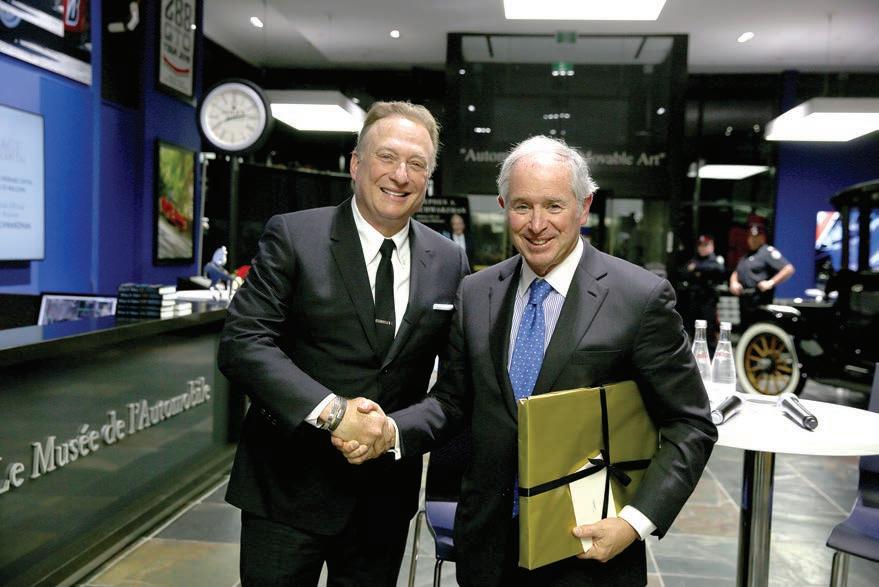
On a larger scale, I support entrepreneurship through the Miles S. Nadal Management
Centre at the Schulich School of Business in Toronto. In Israel, there is the Miles Nadal Home for Technical Innovation and Entrepreneurship, and an incubator that is leading investment in some of the most innovative technologies in the world coming out of Israel.
I am a big advocate of matching the funds that people and organizations raise on their own. To me, it demonstrates the commitment and passion I am always looking for. I also like to champion young people whether it is through larger organizations that run national programs, or hyper-local and targeted initiatives.

One cause that’s very dear to my heart is a local community-based micro-program that helps young people from very diverse and economically challenged backgrounds to articulate the vision for an enterprise, develop a business and marketing plan, and work with mentors – some of whom are from the Peerage team – to get it going. I am always so inspired by their energy and their optimism. Talk about daring to dream.
Creating spaces where young people have opportunities to develop skills is also a priority. As a kid, I was sponsored for a place in a summer camp, and it made a huge difference in my life. I understand that today, there are even more children who must overcome big obstacles just to get to the starting line in life. That’s why I also support nutrition, sports, creative, and educational programs through BCGC, which used to be known as Boys and Girls Club of Canada.
Most recently my family and I have become involved in Camp Oochigeas that is providing summer camp experiences for children with cancer.
A strong community can empower children and families and ensure that inclusion and diversity contribute to sustainable success. That is
Miles Nadal and Stephen A. Schwarzman, Founder and Chairman, Blackstone and renowned philanthropist
POSTED WITH PERMISSION. COPYRIGHT © 2022 LEADERS MAGAZINE, LLC LEADERS47 VOLUME 45, NUMBER 4
Bruce Meyer, founding Chairman of the Petersen Automotive Museum, and Miles Nadal
where the Miles Nadal Jewish Community Centre in the heart of downtown Toronto makes a big impact. There is something there for everyone and it is an incredibly welcoming place.
Technically, the Miles Nadal Heart Centre at the Sinai Health System is in the healthcare sector, but I view it as very much a community resource. Of their many exceptional resources, the one that always grabs me the most is the maternal heart care they provide to women who have high-risk pregnancies. Those stories are remarkable, and I always get very emotional when I hear them.
In keeping with the healthcare version of entrepreneurship, I most recently funded a medical fellowship program that allows talented young doctors from around the world to come to the Miles Nadal Heart Centre to learn and take that knowledge back to their communities.
There are many other initiatives that I support, or Peerage supports. It is very difficult to say we are narrowly focused on one area or another, because need is always evolving and we are always open to responding to it.
What are the keys to being effective in philanthropy and does it take the same skills that made you successful in business?
The common factor between business and philanthropy, at least for me, is passion. At Peerage, we invest in passion and the entrepreneurs who build and lead businesses with passion. When it comes to philanthropy, passion is also the overarching consideration.
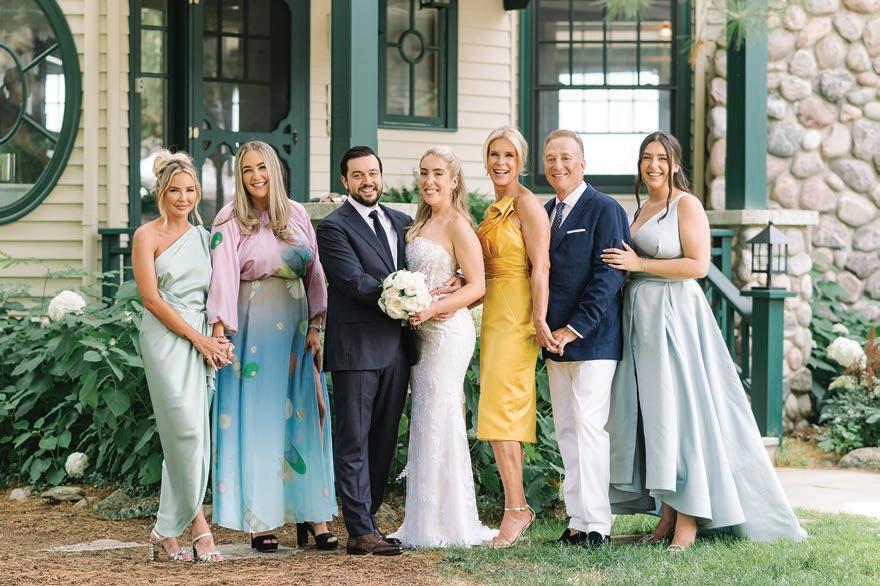
I am very hands on in both business and philanthropy. Peerage is run on a day-to-day basis by a terrific team of professionals, but I get very personally involved in all we do as a corporation. The same is true with philanthropy. I do not have a formal foundation or dedicated staff running the show – we are a family office and that informs our approach. I engage with
the organizations and people who demonstrate passion and inspire it in me.
We could probably impose the same disciplines and analytics we have for the business decisions we make, but philanthropy is my indulgence. It is my joy, not my labor – although I am passionate about both.

We have always espoused the belief that the greatest fulfilment in philanthropic initiatives comes from contributing time, talent, and treasure.
How do you define the attributes to effective leadership?
I read a great deal about leadership and there are so many accomplished people whose insights are valuable. While I do not believe that “one size fits all” when it comes to the attributes of effective leadership, there are a few things I try to remember.
Listen with an open mind. Even if you think you have all the answers, consider that might not always be the case. Really listen when others speak. Try to fully absorb what they are saying and what context or experience they are bringing to a discussion and do not interrupt them while they are speaking. One of our Principles of Partnership is the reminder that God gave us two ears and one mouth for a reason.
Give the members of your team the chance to manage through the issues they face on their own. Do not crowd them or second guess them. If they make a mistake or get into a jam, use it as a learning experience and have the discipline to refrain from saying “I told you so.” Humiliating people never puts anything right and just makes everyone fearful of taking initiative in the future.
To the extent possible, encourage diversity and inclusion. This tenet comes not from a place of political correctness or “wokeness,” but from practicality. If you surround yourself with people who have lived experiences, information, and perspectives that are different from yours, you just make better decisions. I try to be aware of the bias that comes when we gravitate – as humans always do – to others who are like them and have a similar background.
Another thing that too often gets overlooked is good old-fashioned courtesy. That starts at the top and it is a huge factor in setting the tone for a respectful corporate culture. If employees feel they will be demeaned or diminished, they will not speak up and they will not stay. Your mother taught you to mind your manners for a reason.
Miles Nadal and Michael Milken, Founder, Milken Institute and international philanthropist
POSTED WITH PERMISSION. COPYRIGHT © 2022 LEADERS MAGAZINE, LLC LEADERS 48 VOLUME 45, NUMBER 4
Nadal Family, (Left to Right) Samantha Nadal, Sarah Nadal, Adam Annibale, Olivia Grier, Kelly Grier, Miles Nadal, and Julia Grier
With the success that you have achieved in your career, do you take moments to reflect on your accomplishments and celebrate the wins?
I believe in practicing gratitude, in being mindful. One of my children said the greatest gift is the attitude of gratitude. I am very aware that I have been blessed with remarkable opportunity and, even more importantly, with the ability to identify and seize that opportunity. Maybe because I grew up in modest circumstances, I never stop pushing forward. I have a restless mind and I am always looking for new ways to apply what I have learned or what I am thinking about. To be clear, having a mindset that is anchored in gratitude – and a leadership team that shares that approach – is not about softness when it comes to business. If anything, it pushes us to the highest standards of rigour across all our operations because we are aware of all the benefits that accrue from being successful and extending more opportunity to more people.
The truth is that I am by nature a partner –there is a reason why Peerage Capital’s structure enshrines partnership. I get tremendous satisfaction from working with others, setting common goals, and moving steadily toward their achievement. Much of what I have been able to accomplish in my life has been because I am amply supported by those around me, and I certainly reflect on the wins we have as a team.
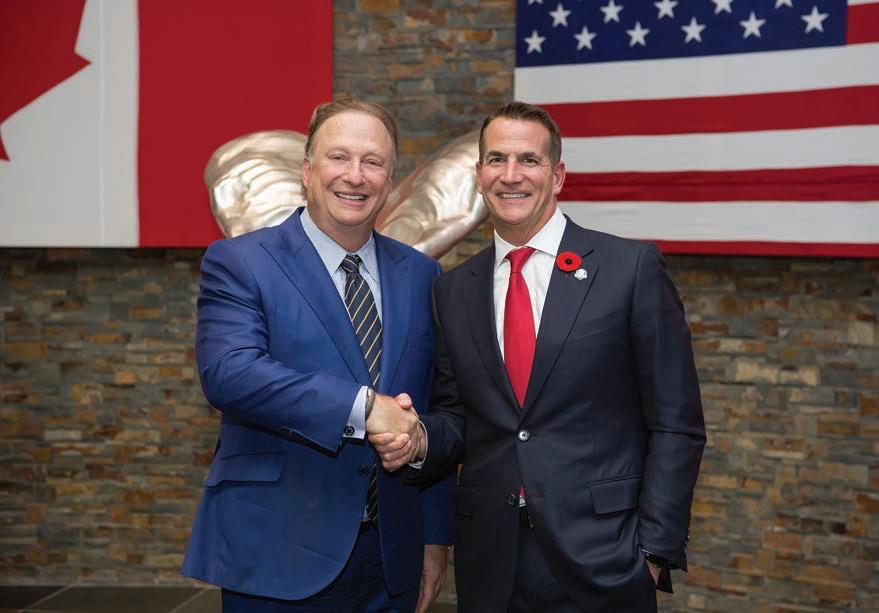

Are there lessons you derived from your experience over the course of the pandemic?
The isolation imposed by the COVID lockdowns really brought home the importance of interacting with other people and the joys of travel. I am not sure I will ever again take these things for granted. In the aftermath of the pandemic, I have really come to understand the degree to which we gain energy and inspiration
from others, especially those who are doing very different things. It is truly a gift.
What advice do you offer to young people beginning their careers during this unprecedented time?
On one level, it is hard to give advice to young people because they face very different circumstances and realities than I did when I was setting out. I am also the first one to admit that I am far from perfect when it comes to anything. That said, there are a few basic business principles that always apply.
It is essential to be curious and to ask questions. There is no question too simple. In fact, those are often the best questions given how common it is for people who are deeply immersed in a business to develop tunnel vision. It is equally essential to listen to the answers, and I mean really listen – not just cling to the information that confirms your existing bias. You must be prepared to have your assumptions challenged and disrupted.
Never ignore your gut. It is all too common and all too easy to rely on the numbers and the chart and ignore something as basic as the vibe you get from someone or the small details that do not quite add up. If you have a persistent unease about a person or a business or a deal, I think you should have the self-confidence to pause and reflect upon it. As the saying goes, when someone shows you who they are, believe them the first time.
While it is important to be focused and passionate about business and growth, balance and perspective are very important too. When you are in the engine room of an enterprise and making sure every part of the mechanism is optimized, you sometimes forget to come up for air and light. I have learned over time to pay closer attention to all the nourishment I can get from other people and from the world around me. Clear priorities are a good thing, but you cannot be entirely rigid about them.
One thing that is not sufficiently valued in the world of business is kindness. Being kind to others is not evidence of softness or weakness – quite the contrary. It is the best way to build long-term, trusted relationships.
Where are you most at peace?
I am at peace wherever I lay my head. If I have my family around me and they are happy and healthy, then I am very happy.•
The Right Honourable Stephen Harper, Former Prime Minister of Canada, and Miles Nadal
POSTED WITH PERMISSION. COPYRIGHT © 2022 LEADERS MAGAZINE, LLC LEADERS49 VOLUME 45, NUMBER 4
Miles Nadal and David Kohler, President and CEO, Kohler Company
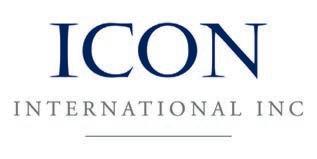

Weallowclientstoleveragetheir advertisingandprocurement expensestocreateefficiencies, fundinitiativesandsolveasset challenges. Weinvestandourclientsbenefit. 203.328.2300 ICONINTERNATIONAL.COM Experience. Innovative. Efficient. ICONInternational theCorporateBarterFirm forsmart,dependablesolutions.
Finding Your True North
An Interview with William W. George, Senior Fellow, Harvard Business School
EDITORS’ NOTE Bill George is an executive fellow at Harvard Business School, where he has taught leadership since 2004. He is the author of: Discover Your True North;the Discover Your True North Fieldbook; Authentic Leadership; and his most recent book, True North: Emerging Leaders Edition , published on August 30th. George is the former Chairman and Chief Executive Officer of Medtronic. He joined Medtronic in 1989 as President and Chief Operating Officer, was Chief Executive Officer from 19912001, and Board Chair from 1996-2002. Earlier in his career, he was a senior executive with Honeywell and Litton Industries and served in the U.S. Department of Defense. George has served on the boards of Goldman Sachs, ExxonMobil, Novartis, Target Corporation, and the World Economic Forum USA. He recently concluded his term as a trustee of the Mayo Clinic, and has been board chair for Allina Health System, Abbott-Northwestern Hospital, United Way of the Greater Twin Cities, and Advamed. He was elected to the National Academy of Engineering


in 2012 and was named one of the “Top 25 Business Leaders of the Past 25 Years” by PBS; “Executive of the Year2001” by the Academy of Management; and “Director of the Year-2001-02” by the National Association of Corporate Directors. In 2014, the Franklin Institute awarded him the Bower Award for Business Leadership. George is a CNBC Contributor and makes frequent appearances on television and radio. He received his BSIE with high honors from Georgia Tech, his MBA with high distinction from Harvard University, where he was a Baker Scholar, and honorary PhDs from Georgia Tech, Mayo Medical School, University of St. Thomas, Augsburg College and Bryant University. During 2002-03 he was a professor at IMD International and Ecole Polytechnique in Lausanne, Switzerland, and executive-inresidence at Yale School of Management.
What was your purpose for writing your most recent book and what were the key messages you wanted to convey in the book?
We are going through a massive change in leadership. The baby boomers have been dominant in leadership for 30 years and I think it is time for the emerging leaders to step up to the multiple crises we face. I define emerging leaders as Gen X, Millennials and Gen Z, and the time is right as we face multiple crises. We need new leaders to take over to lead through these crises and focus on the many issues the country is facing. We feature a number of these leaders in the book, for example Corie Barry of Best Buy who inherited a business that needed to pivot during COVID and has led through this unprecedented time and implemented critical changes to the company. In addition to emerging leaders, we focus on established leaders who are role models for leading in today’s world – people like Satya Nadella of Microsoft, Indra Nooyi of PepsiCo, Mary Barra of General Motors, and Ken Frazier of Merck. These leaders provide an example of how you lead authentically in challenging times.
The book is about how you become an authentic leader in today’s complex environment and serves as an inspiration for the next generation to step up and take the lead.
PURPOSE
William W. George
POSTED WITH PERMISSION. COPYRIGHT © 2022 LEADERS MAGAZINE, LLC LEADERS51 VOLUME 45, NUMBER 4
“We are going through a massive change in leadership. The baby boomers have been dominant in leadership for 30 years and I think it is time for the emerging leaders to step up to the multiple crises we face. I define emerging leaders as Gen X, Millennials and Gen Z, and the time is right as we face multiple crises. We need new leaders to take over to lead through these crises and focus on the many issues the country is facing.”
Who are you hoping to reach with the book?
I am hoping to reach emerging leaders just entering the workforce all the way to today’s CEOs. I think we need this transformation and the reason I decided to focus on leadership over 20 years ago was because when you impact a leader, you can transform an entire enterprise. I am committed to impacting leadership and to helping develop the next generation of leaders. How does a person find their True North?
First, you must figure out who you are before you can lead other people. This comes through a rigorous process of understanding where you came from and who influenced you. This is about more than just what your identity is – you need to explore your crucibles, the most difficult times that you have faced since this is when all the pretense gets stripped away. This is not about money, fame, or power –those are real traps.
You look at a person like Satya Nadella who completely transformed Microsoft. He talks about his life experience, including his son having cerebral palsy and how this transformed Satya in realizing the importance of empathy and personal growth. This enables you to discover your True North.
Is the ability to find your True North something that can be taught?

Your True North can be learned by everyone. Every class at Harvard I have taught for the past 20 years has focused on this. It is about first getting people to think about their life stories and then to write down the greatest crucible they ever faced: here is a time I lost my way; here are times I violated my own values.
The interesting thing is that your IQ does not really change from the age of 10 to 60, but what does change is your emotional
intelligence (EQ) since that is a learned skill. I look at qualities like self-awareness, passion, empathy, courage, and compassion as the qualities that are critical to leading effectively today.
How do business leaders balance the short-term, quarter-to-quarter pressure for results with the need to make investments for the future and to be a force for good in society?
That is one of the great challenges for a leader. While you need to win today, you never want to sacrifice the long term in doing so. If you only focus on the short term, it will lead to the destruction of the enterprise. I think there has been a lack of understanding in the financial community about how sustainable value is created. It starts not with financial goals, but with your customers. As a leader, if you are not creating more value for your customers than your competitors are, you will eventually be out of business. When it comes to employees, the frontline people in the company are not concerned about the share price – they want to know how what they are doing is making a difference and how the company is impacting society.
If you meet your customers’ needs with highly engaged employees, you will increase your profitability and you will increase your shareholder value. Transformative leaders are ones that can balance the needs for the short term, while investing in the long term.
You have served on many corporate boards. What do you see as the role and responsibility of boards?
The role of boards is evolving. There is no reason for boards to spend time on last quarter’s earnings – that is history. Boards need to focus on the things they can influence such as whether the company is fulfilling its purpose, how it is
serving its customers, and if it has engaged and motivated employees. Earnings are a lagging indicator, but things like customer satisfaction, market share, and employee engagement are leading indicators, and this is what boards need to focus on.
This is happening in large part due to the diversification of boards. Boards need to have people with different perspectives and experiences and world views to effectively meet today’s challenges.
You mention diversity. How critical is it for companies to build diverse and inclusive workforces?
We have diverse organizations, but this can devolve into a box-checking exercise. What is important is creating an environment of inclusion where your employees feel that they are a part of something greater than themselves and have a sense of belonging. People want to be accepted no matter where they come from, and that sense of inclusion and belonging is what is truly important.
What are your views on the future of work?
I think that there will be much more flexibility with work hours, but to be part of a team you need to be present. Innovation happens in the little interactions you have during the day. You need to spend time with mentors and need to live the company culture to grow and succeed. Personal relationships are what make the difference in business and they make the difference in leadership.
What has made teaching so special for you?
Every time I walk into the classroom I am eager to learn from the participants, whether they are senior executives or MBA students. It is not just about listening and learning from me as the teacher; rather we learn from each other.•
POSTED WITH PERMISSION. COPYRIGHT © 2022 LEADERS MAGAZINE, LLC LEADERS 52 VOLUME 45, NUMBER 4
“I am hoping to reach emerging leaders just entering the workforce all the way to today’s CEOs. I think we need this transformation and the reason I decided to focus on leadership over 20 years ago was because when you impact a leader, you can transform an entire enterprise. I am committed to impacting leadership and to helping develop the next generation of leaders.”



Building a Foundation for Children to Prosper in Life
 An Interview with Chris Helfrich, Chief Executive Officer, Eat. Learn. Play. Foundation
An Interview with Chris Helfrich, Chief Executive Officer, Eat. Learn. Play. Foundation

EDITORS’ NOTE Chris Helfrich is a social entrepreneur and nonprofit leader committed to finding innovative solutions to community-based issues and problems. Currently, he is President and CEO of Stephen and Ayesha Curry’s Eat. Learn. Play. Foundation (ELP), which he helped launch in July 2019. To date, Helfrich has expanded the foundation to include over 30+ community partnerships including Kaiser Permanente, Workday, Salesforce, World Central Kitchen, and the Alameda County Community Food Bank. Additionally, he has played an instrumental role in facilitating the delivery of over 25 million meals to Oakland students and families struggling with food insecurity during the COVID-19 pandemic. Prior to this, Helfrich served as CEO of the Starlight Children’s Foundation, the nation’s leading organization working to transform the hospital experience for millions of seriously and terminally ill children across the U.S. Before joining Starlight, he worked for the United Nation Foundation, where he spent over five years leading Nothing But Nets, the world’s largest global, grassroots campaign to defeat malaria. While leading Nothing But Nets, Helfrich recruited Stephen Curry to become an ambassador for the campaign, and the two traveled together to refugee camps in Tanzania in 2013 and the White House in 2014 in support of the fight to defeat malaria. He is a member of the Board of Directors for Starlight Children’s Foundation and the Leadership Council for Classy. Helfrich is a graduate of Trinity University where he was named Young Alumnus of the Year in 2018.
FOUNDATION BRIEF Eat. Learn. Play. Foundation (eatlearnplay.org) is an organization dedicated to unleashing the potential of every child, paving the way for amazing kids and opening doors to bright futures. Founded by Stephen and Ayesha Curry in 2019, Eat. Learn. Play. launched in San Francisco with a focus on improving the lives of kids and families in Oakland, the Bay Area, and across the country. Rooted in three of the most vital pillars for a healthy childhood – nutrition, education, and physical activity – Eat. Learn. Play. is working to ensure that every child in
Oakland has access to the nutritious food they need to be healthy and thrive; resources to learn and love to read; and safe places and equitable opportunities to play. The organization, which is anchored around the message that children are our future, is committed to developing partnerships and initiatives that make a positive impact for generations to come.
What was the vision for creating Eat. Learn. Play. and how do you define its mission?

Alongside Stephen and Ayesha Curry, we launched Eat. Learn. Play. in Oakland, California in 2019. Stephen and Ayesha saw the tremendous need that exists all around us and wanted to do what they can to help improve the lives of kids and families in Oakland, the Bay Area, and across the country, and do so in a way that leveraged not just their funds, but also their unique and powerful voices, platforms, and convening powers in order to have maximum impact. With a bold mission to unlock the amazing
potential of every child and improve the lives of kids and families of color in the area, our programming efforts are rooted in three of the most vital pillars for a healthy childhood: nutrition, education, and physical activity.
Will you provide an overview of the work of Eat. Learn. Play. and highlight its initiatives?
Eat. Learn. Play.’s work is driven by impact. In just three years, we have raised and invested more than $32 million and developed a powerful model that directly supports underserved children and families in the areas they need it most. In addition to the traditional grantmaking we do, our initiatives come to life in creative and innovative ways – from partnering with 130 local restaurants to feed the community at the height of the pandemic, to launching our Eat. Learn. Play. Bus to deliver books and nutritious food and meals throughout our community, to building and maintaining 150 Little Town Libraries in under-resourced parts of Oakland in an effort to ignite a culture of literacy in our hometown.
PURPOSE
Chris Helfrich
POSTED WITH PERMISSION. COPYRIGHT © 2022 LEADERS MAGAZINE, LLC LEADERS 54 VOLUME 45, NUMBER 4
Stephen Curry rounds the bases at Eat. Learn. Play. Day at the Oakland Coliseum
Will you discuss how Eat. Learn. Play. focuses on the three vital pillars of a healthy childhood?
Eat. Learn. Play.’s work is centered on three vital pillars that promote a healthy childhood: nutrition (eat), education (learn), and physical activity (play). As an organization, we are committed to developing and supporting programming that directly tackles these issue areas with initiatives that ensure children and families in need have access to nutritious food to be healthy and thrive in life; resources to help kids become better readers; and safe places and equitable opportunities to play in their community. One aspect that is so important to understand about our pillars is how interconnected they are in working together to build a foundation for children to prosper in life.
How did Eat. Learn. Play. adapt the way it works to address the challenges caused by the pandemic?
At the heart of Eat. Learn. Play.’s mission is the goal of ending childhood hunger and broadening our reach to impact the lives of children everywhere. This is something that Ayesha has been working on for a decade and has continued through the foundation. Eat. Learn. Play. was only six months old when the pandemic hit, but we were prepared on day one to mobilize all of our resources to help make sure no Oakland student would miss a meal when schools announced they were closing indefinitely – in 2020, roughly 18,000 students relied on school for two or more meals every day. Through strategic partnerships with other organizations on the ground, as food insecurity continued to grow, we brought our villages together and successfully helped facilitate the distribution of over 25 million meals and 2.7 million pounds of fresh produce to kids and families in our community. Still today, more
than 13 million kids are living with hunger in our country, as 37 percent of Oakland kids live in food insecure households, so we still have so much work to do at all levels to make sure every child has access to the food they need to thrive.
How critical are metrics to measure the impact of the Foundation’s work?
They are very important. We use metrics to help set goals and benchmarks at Eat. Learn. Play. and they’re a large part of how we evaluate the impact we’re having through our various programs and community partnerships. We know we’re still young as a foundation and have a lot to learn about the best ways to maximize our impact, and we believe in the power of taking small steps forward in achieving our collective mission.
While the numbers and data tell part of our story, what’s important to remember is that there is so much more to what we are doing beyond the metrics that quantify our work. It’s hard to quantify the impact that Stephen makes when he spends an afternoon reading and playing with a small group of kids, or when Ayesha hand delivers thousands of beautiful new books to kids and families alongside our first-of-itskind Eat. Learn. Play. Bus. But you see it in their eyes and in their smiles, and while it can sometimes be difficult to measure, there’s no doubt in those moments the difference we’re making in the lives of so many kids in our community.
Will you discuss Stephen and Ayesha’s passion and commitment for the work of Eat. Learn. Play. and how deeply engaged they are in its efforts?
Since the day we launched, Stephen and Ayesha have been the biggest champions of Eat. Learn. Play.’s mission and the work we do across our three pillars. Stephen and Ayesha were both raised under the idea that giving

back and taking care of the community is vitally important, and now with the resources and platform they have, they can do that in a big way. In addition to serving on our Board of Directors and being our biggest donors, they’re constantly providing feedback and new ideas for expanding our impact, mobilizing their networks to bring awareness and additional funding to the organization, and using their voices and platforms to amplify our message and reach as many people as possible. However big or small the ask, the Currys always rise to the occasion and help in every way they can. To say that we’re blessed to have them spearheading this effort is a massive understatement.
Did you always know that you had a passion for this type of work and what makes the work so special for you?
Since I was about 18 or 19, yes. Like the Currys, I was raised by parents who stressed the importance of serving others and giving back. I don’t think anything has inspired my passion for service more than watching my parents adopt three teenagers from difficult situations and (almost) seamlessly integrating them as equal members of our family. The sacrifice they made was incredible, and they did it with so much grace and patience that I couldn’t help but to be inspired by the extraordinary impact that ordinary people can make in the lives of others.
Throughout my career, I’ve always pursued opportunities with organizations that aim to make a positive impact in the lives of others and, ultimately, bring some more good into the world. As the CEO of Eat. Learn. Play., it’s been incredibly special – and humbling – to watch our team grow over the past three years, from one, to three, to now 14 team members – all incredibly talented individuals who believe in our mission and share a passion and common ground for helping those in need. It’s the role of a lifetime.
What are your priorities for Eat. Learn. Play. as you look to the future?
Growing our impact in Oakland across all three pillars is the most immediate priority for Eat. Learn. Play. We’re regularly asked to expand our work into other communities but we’re staying focused on Oakland until we get it right and can prove that our model works. This means doubling down on making sure kids have access to nutritious food, with an emphasis on helping our local Oakland school system launch a new Central Kitchen that promises to deliver more than 9 million quality meals every year. We are also prioritizing the literacy crisis and focusing on ways that we can help ignite a culture of literacy in Oakland, with a focus on dramatically increasing kindergarten readiness and third grade reading levels. And in 2023, we’re planning to roll out a comprehensive “Play” strategy that focuses on ensuring all kids have access to safe places and opportunities to be active and participate in youth sports. This strategy will include remodeling lots of playspaces across our community, and making major investments in school and recreational sports programs, as well as increasing access to quality summer camps for Oakland kids.•
POSTED WITH PERMISSION. COPYRIGHT © 2022 LEADERS MAGAZINE, LLC LEADERS55 VOLUME 45, NUMBER 4
Stephen and Ayesha Curry install the first Eat. Learn. Play. Little Town Library
Stakeholder Capitalism

EDITORS’ NOTE Peter Georgescu is Chairman Emeritus of Young & Rubicam Inc., and previously served as the company’s CEO from 1994 until 2000. He was the first chairman of Young & Rubicam Inc. born outside of the United States. His career spanned some 40 years including top management experience both in the United States and around the world. He was instrumental in developing and fostering the integrated communications strategy that shaped the course of Young & Rubicam’s progress and became the standard for industry thinking. After retiring from Y&R, Georgescu served on the boards of seven public companies including Levi Strauss, International Flavors & Fragrances, and others. Georgescu’s belief in the power of education has fueled his involvement with organizations such as A Better Chance; Polytechnic University; and the Paul & Daisy Soros Fellowship for New Americans, where he has served as a member of their boards of directors. Additionally, he continues to serve as Vice Chair Emeritus of NewYork-Presbyterian Hospital. For the past half dozen years, Georgescu has worked on the issue of inequality in America. His latest book, Capitalists, Arise! is a battle cry for business’ imperative need to change. Currently, he is working to install stakeholder capitalism as America’s business governance. In this work, he serves as a director of JUST Capital. Georgescu is the recipient of the Ellis Island Medal of Honor. He received his BA cum laude from Princeton University and an MBA from the Stanford Business School. He holds honorary doctorates from the University of Alabama and Cornell College.

Will you reflect on your life story?
As I reflect on my early life, I realize just how remarkably different it was from that of most people. I grew up during the Second World War, so I’ve experienced the trauma, the dislocations, the challenges, the fears, the anxieties of war. My family and I were deeply imbedded in the conflict on so many levels.
In early 1947, my father, who had worked for Standard Oil of New Jersey, which is today ExxonMobil, came to New York for a business trip. My mother went with him, leaving me and my brother in the safe care of my grandparents. Then, the Iron Curtain fell, and the Soviet Union forced the takeover of all of Eastern Europe. Overnight, the communist authoritarian regime took over my life. My father in New York found out from war colleagues who now were in the CIA that both he and my mother were on the list to be arrested and killed by the communists. Long story short, they stayed, and my brother and I remained with my grandparents in Romania.
Shortly after, my grandfather was arrested and eventually killed in prison. I was about 11 years old when I was arrested alongside my brother and my grandmother and put into hard labor. We spent about five years cleaning sewers, digging holes for telephone poles, and working on high tension wires. There was no schooling – it was six days a week working 12-hour days. From our psychic perspective, that was going to be it for the rest of our lives.
Our luck changed when my parents were approached to spy for Romanian and Russian authorities. Rather than succumb, they instead
decided to go to the FBI with the blackmail attempt. The result? I arrived in New York with my brother at 15, speaking a single word of English – Coke. The date was April 13th, 1954. I was a young man by then, certainly mature, certainly with an enduring and lasting life experience, and probably loaded with what today we call PTSD.
Once I arrived in the U.S, I was lucky to be asked to join Exeter because the headmaster read the stories of our lives and offered me a position which changed my life. After four months of trying to get up to speed on my English, he asked me what grade I wanted to join. I answered that I wanted to be in the same class with children of my own age, and that meant a sophomore. I went to Exeter as a sophomore, graduated and went to Princeton, Stanford Business School thereafter, and joined Young & Rubicam where I stayed for close to 40 years. I started as a trainee in the research department and ended up as Chairman and CEO of the company for some eight years.
How did this childhood experience impact your career and your business success?
Without a doubt, my early life had a dramatic impact on my business career, and for that matter on the rest of my life, in regard to who I am as a person and who I became as a businessperson as well. I worked hard, very hard. In Romania, I earned a ration card, which was the only way you could get food, and which was allocated based on the degree of difficulty of your job. I had the most rations of so many ounces of milk or bread or raw smoked bacon every day, so I knew the consequences and the benefits of working hard. I learned resilience. I learned rigor. I learned that I could compete and win.
PURPOSE
Peter Georgescu
An Interview with Peter Georgescu, Chairman Emeritus, Young & Rubicam, Inc.
POSTED WITH PERMISSION. COPYRIGHT © 2022 LEADERS MAGAZINE, LLC LEADERS 56 VOLUME 45, NUMBER 4
“Without a doubt, my early life had a dramatic impact on my business career, and for that matter on the rest of my life, in regard to who I am as a person and who I became as a businessperson as well.”
I learned that I didn’t want to ever be like the people who inflicted the pain on my family, and on so many people. The authoritarian regime was a tragedy, a travesty for humanity because it was all about power. It was all about staying in power at all costs and about suppressing those who were not part of the regime. I was determined, later in life, to be different, and to try to be a good person, to be compassionate and caring for others. For goodness sake, I was never perfect in doing all of these things, but the essence, the compass was there, and to the best of my ability, I tried to follow it.
What do you consider to be the hallmarks of an effective leader?
The fundamentals I learned rather early on by watching, by observing others – mentors, people I desired to emulate. Among the things that became clear to me, perhaps the most important one was that I needed to put myself second. The way I would look at the world around me was to become a good listener to others, to try to walk in their shoes, to understand their issues, to understand their problems. That sense of compassion, that sense of caring which I yearned for so much during my early years, had a profound effect on how I tried to behave in my business life. Listening and caring for others became absolutely the right way for me to move forward.
I also discovered that people are the secret sauce to success. I started right next to the mail room at Young & Rubicam. I had an MBA, but I was a no-name, no-frills research trainee, so I had to learn the business. I learned the business of business by gaining insight into the importance of the customer. That wiring stuck with me - that business success depends upon always fulfilling the needs of your customers.
The second thing was that all the people in our company were in service of others. Regardless of title, regardless of position, we were serving the interest of the customer, so I also learned the value of not just my own work, but of teamwork, of collaboration, of the power of motivated people of different backgrounds and different levels of expertise trying to solve our clients’ problems. Those were some of the critical components of the leadership that took me all the way to the top. It turns out that the greater the responsibility, the more stakeholders I had to take care of. I found the benefit of letting others have the starring roles. They came first and that served me well in my business career.
Your focus today is on the importance of stakeholder capitalism. What has made this such a critical issue for you?
It was years later after I left Young & Rubicam that I began to understand that the way we treated workers at Y&R was not the general operating model for America. After my business career, my wife and I began to travel the country by car to see the America that I didn’t see. I saw the world while at Y&R and I saw the capitalist leaders of the world, but not America - the country, the people, the rural areas, the places where the African American people lived, the lack of education, the lack of amenities, the lack of a decent life, which just wasn’t there to be had by too many of my countrymen.
I started to look at data and was stunned at the reality that I was so unaware of how many people in America were not able to live the dream life that I led. After my early years with the help of a fine education and a successful business career, I fulfilled my personal ambitions in life. I feel I am the best Peter Georgescu I could possibly be, to my entire satisfaction. Today, I can marshal my full knowledge, experience, energy, and whatever wisdom I possess to give back to my adopted country.
I compared the privileged life I have led with the vast majority of people in America. I studied the data which showed clearly that in the last four decades, America has become the most unequal by income, and the most immobile society among developed nations. That stunning realization made it clear that the path we’re on is not sustainable for a democratic nation.
The deeper I dug into the problem, I realized that business was in fact one of the most or one of the greatest contributors to this inequality, yet in the first 40 years of American modern history after the Second World War we had built the largest economic market in the universe. It was America’s middle class. They grew and they prospered, and they lived great, fulfilling lives. They were achieving the American dream, except for the African American and other marginalized groups. I decided that I needed to understand why capitalism let our country down in recent decades.
I realized that the capitalist’s single-minded focus on one stakeholder, which started in the
early 1980s, matured into a new mantra for business – maximize short-term shareholder value. It was a coup of business leadership with support from the Reagan government. I observed that for almost 40 years, through 2019, wages for employees were at or below inflation. Flat wages for 40 years – a devastating reality. I began to study and understand that there were many versions of capitalism - that capitalism was indeed the most successful, the best ever human-created platforms for prosperity and growth - but that capitalism came in many different flavors.
Focusing exclusively on the shareholders was a tragic decision with disastrous consequences. We needed to get back to what happened before 1982 when America built that remarkable middle class, when America became the most dominant economic and military force in the world. That era’s capitalism focused on multiple stakeholders, which today we call stakeholder capitalism where the customers, the workers, the shareholders, the corporation itself, communities, and the planet all have to be optimized because they all can and must contribute to creating great long-term value for all of them, and importantly for shareholders as well.
How did you get involved with JUST Capital and how do you define its mission?
JUST Capital was the genius invention of an outstanding, successful capitalist, Paul Tudor Jones. He understood the failure of the prevailing capitalism in America and wanted a better alternative. But who could provide the ideal “just” criteria for a just company? His brilliant inspiration was to seek the advice of the American people. Today, over 150,000 people have been consulted by JUST which regularly ranks the most just companies in our country.
The research and conversations with those 150,000 Americans came back with crystal clear results. At the top of the priority list, businesses’ responsibility was to pay people fairly, to treat them with respect and dignity, to be able to have a fair and living wage, that gender equality is a must. All employees must be treated as equal. Shareholders must help create long-term value and share in the value they created. The corporation itself must be a critical stakeholder to be invested in and finally, that our greater home – our planet –
to be cared for.
had
POSTED WITH PERMISSION. COPYRIGHT © 2022 LEADERS MAGAZINE, LLC LEADERS57 VOLUME 45, NUMBER 4
“I compared the privileged life I have led with the vast majority of people in America. I studied the data which showed clearly that in the last four decades, America has become the most unequal by income, and the most immobile society among developed nations. That stunning realization made it clear that the path we’re on is not sustainable for a democratic nation.”
The future business in the 21st century requires all critical stakeholders to be supported and consistently enhanced through creative innovations. The entrepreneurial spirit that has built America over the past 100 years must be rekindled and reimagined. That’s the essence of stakeholder capitalism. We must redouble the effort to allow stakeholder capitalism to emerge and be adopted with urgency. Capitalism, as we see in China, does not need democracy to work. But democracy cannot endure without stakeholder capitalism.
What do you feel is the responsibility for leading companies to support the communities they serve and to be a force for good in society?
The biggest myth today is that somehow business and society are two different entities. The reality is that communities are absolutely vital to business success – some 180 million adults are the workers in America. Business is society. That’s what Mr. Ford discovered when he decided to pay people a whole lot of money so they could afford to buy their own cars.
Communities are critical. That’s where our employees’ families go to school, so they need great education for their own benefit and for the future generation of skilled, productive workers. Thriving communities are the backbone of successful companies and a thriving, democratic way of life.
You have written several books. What interests you in writing and what are the key messages you hope to convey through your books?
In my book, Capitalists, Arise! , I discuss why inequality in America became what it is, and why stakeholder capitalism is such an important part of the journey of humanity towards the good.

I’ve also written about evil and how evil is still part of who we are. I’ve learned from evolutionary anthropology that the genetic code which enabled us to succeed in our millions of years in the jungle where we grew up, where narcissism, entitlement, and greed were some of the most critical ingredients to our survival then, are among the reasons that we’re still around today. I also learned that some of those genes are still within us, so under stress or when we
allow ourselves to become detached from the reality of communal life or the duty to be a citizen with responsibility and accountability for each other, when we forget or deny those obligations, we are on the way back to the jungle.
meaning, but just for money. Over the long term, companies without values and purpose are not going to be the successful companies where you can have a meaningful life. In my view, that’s the best advice to give a young person.
Secondly, enduring success comes from being a good person. So, practice being a good person, not only in your personal life, but in your business life as well. Don’t have two different personas, one when you go to the office and sharpen your elbows and one at home when you are with your loved ones. Be the same person. Care about your colleagues, care about your employees, and care about those who work directly for you.
You are known to be an optimistic person. With so many challenges facing the world today from public health to climate change to social justice to income inequality, are you still optimistic about the future of America?
The need to understand that those instincts are still within us, and that the battle needs to be a daily ritual since every day we’re going to make hundreds of decisions, is vital. Yes, constant decisions about who we chose to be that day, tomorrow or the rest of our lives are ongoing. It is and always will be a daily battle.
What advice do you offer to young people beginning their careers?
My advice to young people is to be careful about the companies they join to make sure that their personal values and aspirations happen to be the values and aspirations that have been proven in practice by that company. Don’t be tempted for the next $5,000 or $10,000 to work someplace without a purpose, without
Absolutely, categorically, I am an optimist. The truth is that I can’t think of a single problem confronting us that we can’t address, that we cannot solve. They are there to be had. Yes, there are some caveats. We need the will to do it. We need the will to solve our problems. That journey of solving our problems starts with defining the problems the right way, looking the problem in the eye, speaking the truth, looking at the facts. I believe that once we can agree on what the problem is, we can come together even as disparate people - red, blue, purple, pink, whatever – and deal with it. Throwing out solutions without getting agreement on the problem is unlikely to work. Next, we must come to embrace the need for a common good. We need to be citizens in the country, not just squatters. Citizenship carries with it responsibilities and accountability.
Finally, the advice to the young resonates for us all. Being good people frees us to create, to imagine, to rekindle the entrepreneurial spirit in all of us. At some point in the future are better days for us, our businesses, our country and future generations. There are many committed, dedicated women and men, determined to help make that happen. So yes, I remain optimistic.•
POSTED WITH PERMISSION. COPYRIGHT © 2022 LEADERS MAGAZINE, LLC LEADERS 58 VOLUME 45, NUMBER 4
“The future business in the 21st century requires all critical stakeholders to be supported and consistently enhanced through creative innovations. The entrepreneurial spirit that has built America over the past 100 years must be rekindled and reimagined. That’s the essence of stakeholder capitalism.”


©2022 Ethan Allen Global, Inc.
REIMAGINED
CLASSIC AMERICAN STYLE
FOR TODAY
Education, Health and Wellness, and Empowerment


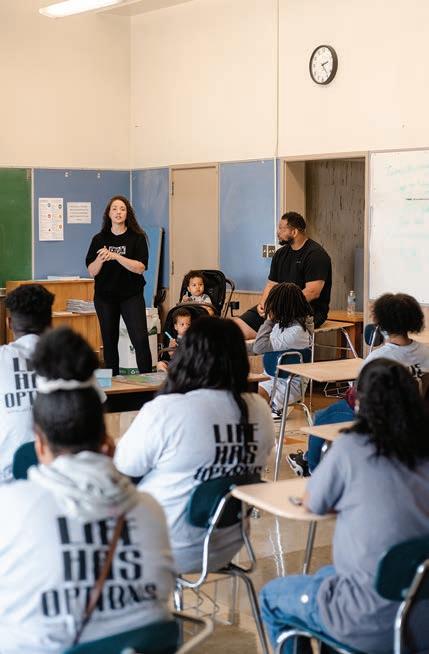
EDITORS’ NOTE Ndamukong Suh is an engineer, entrepreneur, investor and Super Bowl champion. Suh strives to inspire the next generation of young athletes and “unexpected” investors to create generational wealth through continued smart investment decisions. He is the Managing Partner of House of Spears Management, LLC, an investment portfolio including Ember Technologies, BTN, Seven Peaks Ventures, General Atlantic, and Andreessen Horowitz’s Cultural Leadership Fund. In the hospitality industry, Suh is the founder of Generals Restaurant Group, which owns restaurants in five U.S. cities. He is an investor in Pizzanna; has partnered with several high-profile groups and individuals in the ownership of four Blue Sushi locations, BAE’s Fried Chicken and Super Deluxe; and co-owns a Hyatt Hotel and Hilton DoubleTree Hotel. Also well known for his real estate investments, Suh is a Partner in both HMS Development, a company focused on mixed-use development projects, and Athletes in Real Estate (AiRE). Through the Suh Family Foundation, Suh has supported the Nebraska Athletics Strength and Conditioning Program, most notably establishing The Ndamukong Suh Scholarship benefitting the UNL College of Engineering. The Suh Family Foundation works hand-in-hand with communities to supply resources across three pillars that were pivotal to Suh’s own success: education, health and wellness, and empowerment. Suh attended the University of Nebraska-Lincoln where he became one of the most decorated Husker players in college football history and earned a degree in construction management from the UNL College of Engineering. He lives in Tampa, Florida with his wife, Katya, and twin boys.
Katya Suh is an entrepreneur and real estate agent with more than ten years of experience in hospitality, commercial property, and media. She has held prominent positions as a news anchor, restaurateur, and real estate agent, garnering the first-hand expertise and knowledge necessary to successfully invest in a range of industries. She is deeply invested in philanthropic endeavors, primarily as the co-founder and treasurer of the Suh Family Foundation. A native of Minneapolis, Minnesota, she holds a BA in mass communications from Kansas State University, where she was team captain of the women’s basketball team and a member of the Big 12 Academic Commissioner’s Honor Roll for the whole of her collegiate tenure.
Ndamukong: Katya and I co-founded the Suh Family Foundation as a way for our family to give back and supply resources to communities across three pillars that were pivotal to our own success: education, health and wellness, and empowerment. We started in our own backyard of Portland, Oregon and are building national programs that are especially meaningful to cities that have had an impact on us like Detroit, Tampa, Miami, and Los Angeles. We want to make sure we are equipping individuals with the resources they need to sustain long-term success.
How did you decide on the three pillars of education, health and wellness, and empowerment to be the focus for the Foundation?
Katya : When we were building the Suh Family Foundation, Ndamukong and I were focused on sharing our own personal journeys and the key elements that helped us get to where we are today – education, health and wellness, and empowerment.
Education: A focus on education was instilled in Ndamukong at a young age by his mother, Bernadette, who had a long career as a teacher. My family shares that same passion, and Ndamukong and I met in college at the University of NebraskaLincoln, which is a recipient of past Suh Family Foundation donations. We’ve done a lot of work in Portland around financial literacy. Over the summer of 2021, we brought a financial literacy camp to Portland Public Schools which helped 160 middle school students learn about money.
PURPOSE
Will you highlight the history of the Suh Family Foundation and how you define its mission?
Katya and Ndamukong Suh with backpacks for students
An Interview with Ndamukong and Katya Suh, Co-Founders, Suh Family Foundation
POSTED WITH PERMISSION. COPYRIGHT © 2022 LEADERS MAGAZINE, LLC LEADERS 60 VOLUME 45, NUMBER 4
Katya and Ndamukong Suh working with students
Health and Wellness: Ndamukong and I were both collegiate athletes, so we have a deep understanding of the importance of nourishing the mind and body. This commitment led to Ndamukong’s 10+ year career in the National Football League and our work here is centered around engaging and educating communities on health and wellness starting at a young age.
Empowerment: I’m especially dedicated to the empowerment of women, and the Suh Family Foundation has made a few donations in Tampa to support women looking for a fresh start. We also recently partnered with Voice, a digital art marketplace, on a fund committed to supporting independent artists from underrepresented and marginalized communities. This pillar is near and dear to my heart because I firmly believe that through knowledge and education we can create and foster communities where all can celebrate their diverse, yet shared experiences.
Will you provide an overview of the work of the Suh Family Foundation and its programs?
Katya: Right now, a key area for our foundation is financial literacy – we want to provide young people with the resources they need for a bright financial future. As former studentathletes, we both had to learn financial literacy via trial-and-error, which is why we are so passionate about helping kids learn about the topic before they graduate high school.
As I mentioned, in 2021, we brought a fourweek financial literacy program to 160 middle
school students in Portland Public Schools. We also want to make sure kids have what they need for the school year, and love doing backpack giveaways to help students prepare for a year of learning.
How did the Suh Family Foundation adapt the way it works to address the challenges caused by the pandemic?
Katya: We used the pandemic as a moment to reevaluate and really hone in on the areas and cities we wanted to dedicate the Suh Family Foundation to. Now that remote activities are more of a norm across the country, it gives us some additional avenues to have an impact on cities that are close to our hearts even if we can’t be there in person.
How critical are metrics to measure the impact of the Suh Family Foundation’s work?
Katya: Though metrics can be important, the true impact for us is measured through interaction and experiences. Whether it be a student’s face after receiving school supplies and a backpack, or a woman moving into a furnished apartment after being a victim of domestic violence, the Suh Family Foundation considers the quality of the impact and the lives being touched to be more important than numerical measures.
Did you always know you had a passion to give back to the community and what has made the work of the Foundation so special for you?
Ndamukong: We’ve both been passionate about giving back from a young age. One of the first things I did after joining the NFL was give
a $2.6 million donation to my alma mater, the University of Nebraska-Lincoln. I worked with UNL to create a scholarship endowment for the College of Engineering, which I graduated from with a degree in construction management, and a second part of that gift went to Nebraska Athletics for its Strength and Conditioning Program.
Ndamukong, you are known for your talents and impacts on the football field, but you also are a leader in the business world through many ventures. Will you highlight your business initiatives?
Ndamukong : I’ve always aspired to be more successful off the field than on the field, and am an engineer at heart. As an entrepreneur, I strive to inspire the next generation of young athletes and “unexpected” investors to create generational wealth through continued smart investment decisions and partnerships. I’m personally very passionate about real estate and try to incorporate different ways to give back into everything I do – you’ll see that many of my real estate projects in my hometown of Portland are dedicated to giving back to the community, specifically BIPOC small business owners and young professionals.
What are your priorities for the Suh Family Foundation as you look to the future?
Ndamukong: We’ll continue to find partners that are interested in making a national impact. As we continue to move and grow as a family, the Foundation will follow suit, empowering as many people as possible in the process.•
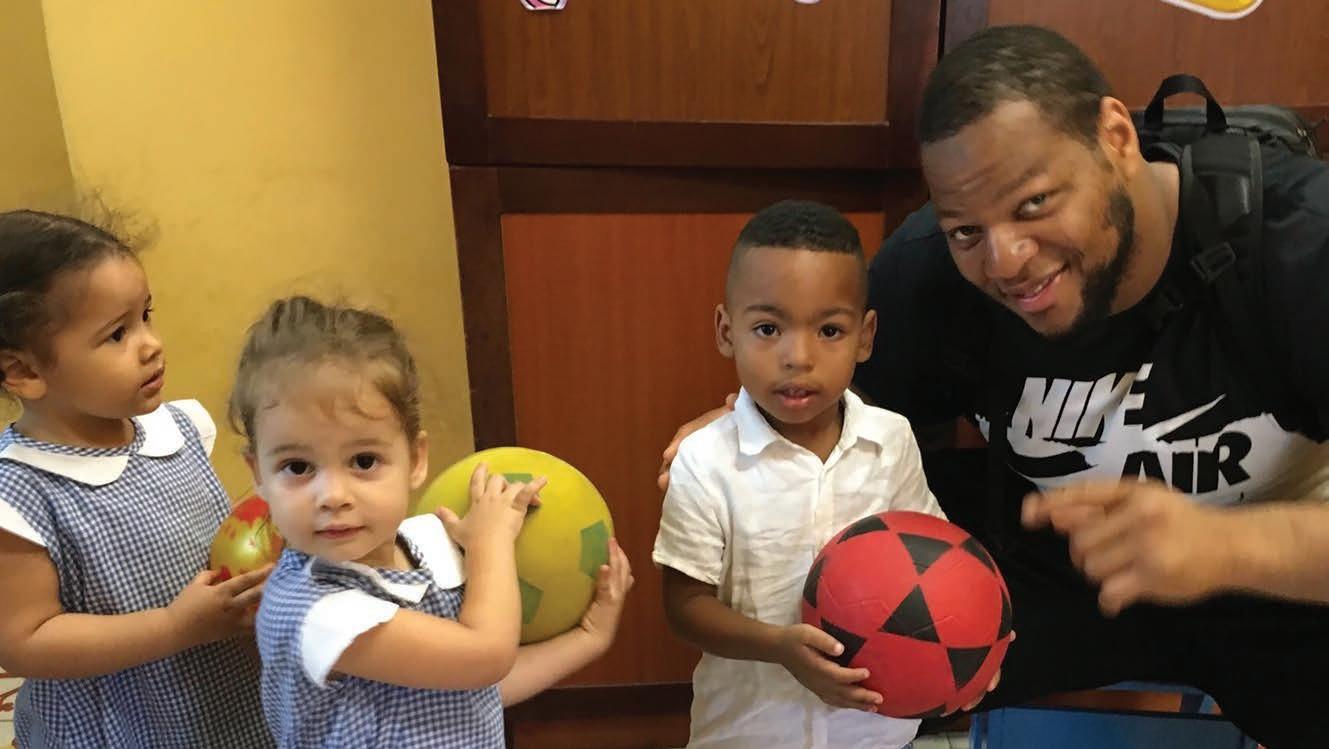
POSTED WITH PERMISSION. COPYRIGHT © 2022 LEADERS MAGAZINE, LLC LEADERS61 VOLUME 45, NUMBER 4
Ndamukong Sub inspiring kids
Client Service, Excellence, Integrity, and Partnership
 Interview with Stephanie E. Cohen, Global Co-Head of Consumer and Wealth Management, Goldman Sachs
Interview with Stephanie E. Cohen, Global Co-Head of Consumer and Wealth Management, Goldman Sachs

EDITORS’ NOTE Stephanie Cohen is Global Co-Head of Consumer and Wealth Management at Goldman Sachs, the only woman to currently lead one of the firm’s four revenue divisions. She is also a Global Executive Sponsor of the Women’s Network and a member of the Management Committee, the most senior governing leadership body at the firm. Prior to assuming her current role, Cohen was the firm’s Chief Strategy Officer, where she drove strategy, Mergers & Acquisitions (M&A), strategic investing and partnerships for the firm. She also led Launch With GS, Goldman Sachs’ $1 billion investment strategy which aims to increase access to capital and facilitate connections for women, Black, Latinx, and other diverse entrepreneurs and investors, as well as GS Accelerate, the firm’s in-house innovation engine. Before that, Cohen was Global Head of Financial Sponsor M&A in the Investment Banking Division (IBD). She was sector captain for General Industrials in the Global Industrials Group and a member of the M&A Group in IBD. In 2008, she managed Conflicts and Business Selection for IBD in the Americas. Prior to that, Cohen was a vice president in the Industrials and Merger Leadership Groups in San Francisco. Earlier in her career, she worked in New York in the M&A department. She has served as a member of the Global Inclusion and Diversity Committee as well as Global Program Sponsor for the Women Career Strategies Initiative. Cohen joined Goldman Sachs as an analyst in 1999, was named Managing Director in 2008 and Partner in 2014. She serves on the National Board of Directors of CollegeSpring and as a member of the Board of Quill.org. She also serves as trustee for the Board of The Economic Club of New York. Cohen earned a degree in finance from the University of Illinois.
FIRM BRIEF Goldman Sachs (goldmansachs.com) is a leading global financial institution that delivers a broad range of financial services across investment banking, securities, investment management, and consumer banking to a large and diversified client base that includes corporations, financial institutions, governments, and individuals. Founded in 1869, the firm is headquartered in New York and maintains offices in all major financial centers around the world.
At Goldman Sachs, we’re committed to advancing sustainable economic growth and financial opportunity, a mission that guides all of our work across the firm. Our purpose comes to life through our four core values: Client Service, Excellence, Integrity, and Partnership.
Our clients and customers come first, and our people are what truly set us apart. Our colleagues work together to serve clients, customers, and communities around the world, building upon a rich history of innovative ideas from extraordinary people.
Will you provide an overview of your role and areas of focus?
I have co-led Consumer and Wealth Management at Goldman Sachs alongside my co-head, Tucker York, since the division was formed in January 2021. Across the division, we help empower millions of clients and customers around the world to achieve their financial goals through three businesses that Tucker and I oversee – Private Wealth Management, our workplace and personal wealth business and the Consumer business, which includes Marcus by Goldman Sachs as well as large partnerships.
Consumer and Wealth Management brings together our established wealth management businesses with the digital consumer-facing businesses, allowing us to serve a broad group
of people in a digitally led or digitally enabled way. From growing savings through a Marcus high-yield Online Savings Account to developing a financial plan for the future through our workplace and personal wealth offering to building generational wealth and achieving long-term philanthropic goals with Private Wealth Management, we’re focused on delivering the financial expertise and resources of Goldman Sachs to millions of clients and customers.
What have been the keys to the strength and leadership of Goldman Sachs’ Consumer and Wealth Management business?
I cannot underscore enough that being a part of Goldman Sachs and having the ability to bring the expertise and resources of the broader organization to the millions of clients and customers we serve has been a key factor as we drive growth across Consumer and Wealth Management. Beyond that, the strength of our division, and Goldman Sachs more broadly, is grounded in our people. Having a diverse senior leadership team is essential to the success of the business, as it enables us to combine our unique perspectives and ensure our team reflects the diverse group of individuals we serve. As we’ve grown the division, diversity has been and will continue to be a strategic imperative for us. It’s the strength of our leadership and the diversity of the ideas that they bring to the table that allows us to provide best-in-class products and services to everyone we serve across Consumer and Wealth Management.
PURPOSE
How do you define Goldman Sachs’ mission and purpose?
Stephanie E. Cohen
An
POSTED WITH PERMISSION. COPYRIGHT © 2022 LEADERS MAGAZINE, LLC LEADERS 62 VOLUME 45, NUMBER 4
“I cannot underscore enough that being a part of Goldman Sachs and having the ability to bring the expertise and resources of the broader organization to the millions of clients and customers we serve has been a key factor as we drive growth across Consumer and Wealth Management.”
You led Launch With GS, Goldman Sachs’ $1 billion investment strategy which aims to increase access to capital and facilitate connections for women, Black, Latinx, and other diverse entrepreneurs and investors. What was the vision for creating Launch With GS and what has been the impact of this effort?
We started Launch With GS in 2018 based on our data-driven thesis that diverse teams drive strong returns. We began by providing female founders access to capital and networks, and in 2019 expanded the program to serve Black and Latinx entrepreneurs. To date we’ve deployed over $800 million of capital to companies and venture capital and private equity firms with diverse management teams. Launch With GS has worked with 36 Black- and Latinx-founded companies across three Entrepreneur Cohorts since 2020, and more broadly, the initiative has touched over 10,000 entrepreneurs and investors globally since 2018.
As one of the first firms to spearhead such an impactful program, we are proud to have inspired others to focus on similar inclusion and diversity initiatives across industries and are excited to see the continued commitment to narrowing investing gaps and advancing racial and gender equity.
Will you highlight GS Accelerate, Goldman Sachs’ in-house innovation engine, and the role it plays within the firm?
We have over 45,000 people in more than 40 countries and they produce amazing ideas. GS Accelerate was born in 2018 as one of the first things I did as Chief Strategy Officer to harness the power of these ideas and make it easier for employees at all levels to transform their ideas into viable new businesses and services for the firm and our clients. The Accelerate platform aims to foster innovation and experimentation, allowing people to be entrepreneurs inside the firm and supporting our relentless commitment to serving our clients in a constantly changing, more digital world.
In the spirit of encouraging constant innovation, we have continued to evolve the program and last year shifted away from an annual submission deadline. After all, you cannot schedule innovation. We want to encourage our people to regularly try new ideas, even if they don’t always work out the first time. As Accelerate continues to grow, it has been rewarding to see the client-facing results that come from the program. Since we introduced GS Accelerate, ten new products have launched for client and employee use, including the first product – the Goldman Sachs Directed Share Program – which was commercialized in our Private Wealth Management business.
How important is it to Goldman Sachs to build a diverse and inclusive workforce to bring diverse perspectives and experiences to the table when addressing client needs?
At Goldman Sachs, we know that to be successful our people must reflect the diversity of the clients and customers we serve,
as well as the communities in which we operate. I’m a firm believer that diversity needs to be discussed in the same rooms that we discuss market share, margins, and growth rates – not just in meetings about diversity – because we know that diversity drives outperformance.
In 2019 as a firm, we set ambitious goals and developed a comprehensive plan to increase diverse representation at the entry level. In 2020, we announced additional goals to accelerate the recruitment of diverse candidates at all levels of the firm, focused on our vice presidents and recruits from Historically Black Colleges and Universities. By 2025, we are aiming to achieve representation in our vice president population of 40 percent women globally, 7 percent Black professionals in the Americas and the UK, and 9 percent Hispanic and Latinx professionals in the Americas. I’m proud to say that our Managing Director Class of 2021 was the most diverse in our history. We also exceeded the goals we set forth for our campus analyst class last year, with a new class that was 52 percent women, 12 percent Black and 19 percent Hispanic.
Across the firm, we take a deliberate approach to fostering diversity and inclusion among our people. We have created over 80 inclusion networks at both the firm and divisional levels, as well as specific programs focused on retaining and growing the careers of our diverse talent.
Our focus on diversity and inclusion is connected to meeting the needs of an increasingly diverse client base. In order to serve that growing client base, we have introduced specific inclusive wealth initiatives within Private Wealth Management tailored for women, the Black community and the LGBTQ+ community. We advise clients on some of the most personal matters related to their financial futures and those of their families, which is why it is so important to have a team that reflects the diverse people we serve who each have specific personal needs and goals.
What do you see as Goldman Sachs’ responsibility to the communities it serves?
In addition to our unwavering commitment to our clients and customers, we are dedicated to supporting and serving the communities in which we live and work, as well as in places where opportunity can be multiplied. We are focused on investing significant capital in initiatives that narrow investing gaps and advance racial and gender equity.
Over the last decade the firm has deployed over $2.5 billion through programs that help level the playing field and spark economic growth for people and communities around the world. These programs include 10,000 Small Businesses, which provides best-in-class business education, access to capital, and support services to small businesses; One Million Black Women, an initiative that funds Black women-led and Black women-serving nonprofits through which we’ve already deployed over $1 billion of our more than $10 billion commitment; and the Goldman Sachs Gives program, a donor-advised
fund that allows Goldman Sachs’ current and retired senior employees to work together to recommend grants to a range of nonprofit organizations to help them achieve their goals in underserved communities globally.
Another initiative that I’m particularly proud of is Goldman Sachs’ landmark policy announced at the 2020 World Economic Forum to increase diversity on corporate boards. In January 2020, the firm announced that we will only take companies in the U.S. or Europe public if they have at least one diverse board member. The next year, we built upon that commitment and increased the requirement to two diverse board members, one of whom must be a woman. We made this decision based on research demonstrating that companies with diverse boards generate better returns and our experience advising companies on board governance. As a part of these efforts, we put in place a dedicated team focused on helping our clients identify exceptional diverse talent for their boards. Since July 2020, we have worked with hundreds of clients and helped facilitate 50 diverse placements on corporate boards of both private and public companies.
Do you feel that there are strong opportunities for women to grow and lead in the industry?
Absolutely. We see diversity as a business imperative, and while representation across gender, race and sexual orientation has improved, there is still much to be done. Diverse perspectives are essential to the success of the business, especially as we are increasingly focused on serving a more diverse group of clients. I’d be remiss not to mention two stats that I believe sum up the importance of this focus: In the U.S., over $80 trillion in wealth is expected to change hands in the next quarter century from baby boomers to their heirs, and by 2030, women in the U.S. are expected to control much of the $30 trillion in financial assets that baby boomers will possess. We are laser-focused on creating offerings for the next, more diverse generation of wealth creators.
You joined Goldman Sachs over twenty years ago. What has made the experience so special for you?
Simply put, the people. The teamwork and partnership mentality is deeply embedded in the culture of Goldman Sachs. Since joining the firm, I’ve had the opportunity to work with and learn from remarkable leaders. On top of that, thousands of new people join the firm each year, bringing with them new ideas and infectious energy. Being surrounded by smart, hard-working, and innovative people is what has tethered me to the firm and continues to drive me every day. They are the reason our people are our greatest asset.
What advice do you offer to young people beginning their careers during this challenging and unprecedented time?
Stay curious. Remember to focus on the journey and not just the destination. If you follow your curiosity, you will be surprised by the amazing places it can take you.•
POSTED WITH PERMISSION. COPYRIGHT © 2022 LEADERS MAGAZINE, LLC LEADERS63 VOLUME 45, NUMBER 4
Building an Enduring Legacy
An Interview with Bola Olusanya, Chief Investment Officer, The Nature Conservancy
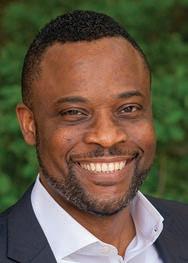
EDITORS’ NOTE Bola Olusanya joined The Nature Conservancy in March 2020 as Vice President and Chief Investment Officer. He provides leadership, vision and oversight to the management and strategic growth of the Conservancy’s multi-billion-dollar endowment and other long-term investment assets. Olusanya has over 25 years of experience in investment management as an executive and a thought leader. Prior to joining TNC, he was a Managing Director at Key Private Bank where he led asset allocation, portfolio strategy and manager research for the bank’s investment management business. Previously, Olusanya was a Managing Director at Strategic Investment Group, an Outsourced-CIO firm, where he co-managed the public equity portfolio as well as the firm’s emerging manager program. Before that, he was a Managing Director at Vanderbilt University’s investment office where he oversaw asset allocation, risk management and manager selection for the university’s endowment. Earlier in his career, he was a Managing Director at IHS Markit (previously Quantitative Services Group LLC), worked at Emory University’s investment office, and held senior positions within the Nigerian banking sector. Olusanya is a board member for TIFF Investment Management and serves on the Investment Committee of the Cleveland Foundation. He obtained his BS in computer science from the University of Ibadan, Nigeria, where he graduated with First Class Honors. He received his MBA in finance from the Goizueta Business School at Emory University and holds an MS in computer science from the University of Lagos, Nigeria.
Bola Olusanya

excited you
TNC’s mission – to conserve the lands and waters on which all life depends – is more than enough to excite anyone to come work here. We are laser-focused on using science and decades of local on-the-ground experience to tackle the dual threats of climate change and unprecedented biodiversity loss. We have the global scale with a staff of over 4,500 (more than 13 percent of whom are scientists) working in 76 countries; generous donors, supporters, volunteers, and members (numbering over 1 million); and an uncompromising leadership team that fully understands the gravity of the challenges we face. So, for someone like me – with two young boys – who is deeply concerned about the future of our planet, it was a no-brainer to be excited about joining TNC. Beyond the mission, I saw an incredible opportunity to build an enduring legacy for the management of TNC’s endowment and
long-term investment assets. Despite a balance sheet of almost $9 billion and long-term investment assets of approximately $4 billion, we didn’t have an internal investment team before I joined. Instead, TNC relied on consultants and outsourced investment advisory firms to make investment decisions on our behalf. Such outsourced investment models make sense for small institutions, typically with investment assets of less than $1 billion, who often lack the brand recognition to attract investment talent or partner with premier investment managers. TNC doesn’t have that problem – in fact, due to our all-important mission and our track record of effectiveness, we are often courted by these premier investment managers. Yet, for some inexplicable reason, we didn’t have an in-house investment team. The opportunity to build a first-class investment team really excited me.

Finally, the challenge of reshaping and managing a high-performing investment portfolio that is fully aligned with TNC’s mission and values was a big attraction. Even today, there are those who still maintain that integrating ESG principles – decarbonization, climate
ORGANIZATION BRIEF The Nature Conservancy (nature.org) is a global environmental nonprofit working to create a world where people and nature can thrive. Founded in the United States in 1951, The Nature Conservancy has grown to become one of the most effective and wide-reaching environmental organizations in the world. Thanks to more than a million members and the dedicated efforts of its diverse staff and more than 600 scientists, it is able to impact conservation in 76 countries and territories across six continents.
PURPOSE
What
about the opportunity to join The Nature Conservancy (TNC) and made you feel it was the right fit?
POSTED WITH PERMISSION. COPYRIGHT © 2022 LEADERS MAGAZINE, LLC LEADERS 64 VOLUME 45, NUMBER 4
Cracked riverbed with an animal footprint
mitigation and adaption investing, impact investing, sustainability, diversity, equity, and inclusion – in an investment portfolio would result in diminished prospective investment returns. I am not in that camp. Instead, I believe that integrating practical ESG principles is not only common sense, but also a tailwind for improved prospective risk-adjusted returns. In addition, for many institutions with endowments, investment offices are islands, often fully detached from the rest of the organization. With the brilliant minds on staff at TNC, especially our top-notch scientists, it was incomprehensible to me that we weren’t leveraging their insights to align the portfolio with our mission and improve our investment returns.
Given my background, I felt I was uniquely qualified to actualize this vision. It’s been less than three years, but I’m very proud of the progress we’ve made thus far.
Will you provide an overview of your role and areas of focus?
As Chief Investment Officer, I provide leadership, vision and oversight to the management and strategic growth of TNC’s endowment and other long-term investment assets totaling about $4 billion. These assets are very important to TNC. They support our global operations and our most pressing conservation projects. For example, the annual endowment payout of 5.75 percent (of the average endowment value over a rolling three-year period) supports 10 to 15 percent of our annual operating budget.

Since I joined in early 2020, we have built a diverse team of 12 investment and operations professionals who work in our Office of Investments. With support from our Global Board’s Investment Committee of esteemed investment and risk management experts, we are charged with preserving and growing our investments through prudent management.
To do this, we partner with world-class investment managers and embrace alternative investments like private equity, venture capital and hedge funds for their diversification and returnenhancing characteristics. We take the long-view of investing – allowing us to think independently during periods of market turbulence (like the one we’re going through right now) while maintaining a disciplined focus on long-term growth. We bring a similar mindset to our investment partnerships and believe that exceptional investment judgment is rare, so we embrace the power of compounding through multi-year relationships.
How do you define TNC’s culture?
TNC is a global, decentralized, and matrixed organization with various semi-autonomous state, country and regional chapters harmonized by one central leadership. While this complex structure comes with its own growing pains, our on-the-ground presence, intimacy, and data-driven knowledge make us one of the most effective conservation organizations in the world. As a result, we are able to attract people who are passionate about our mission in the communities they live in and are looking to make measurable impact.
A common refrain here at TNC is that our colleagues “join for the mission, but stay for the people.” I’ve worked at some very impressive institutions, including Vanderbilt University and Emory University, but without a doubt, the people here at TNC are the most impressive and accomplished that I’ve ever worked with. It’s these people who are at the heart of our rich and inclusive culture – one that fosters a transparent workplace dedicated to respect for all.
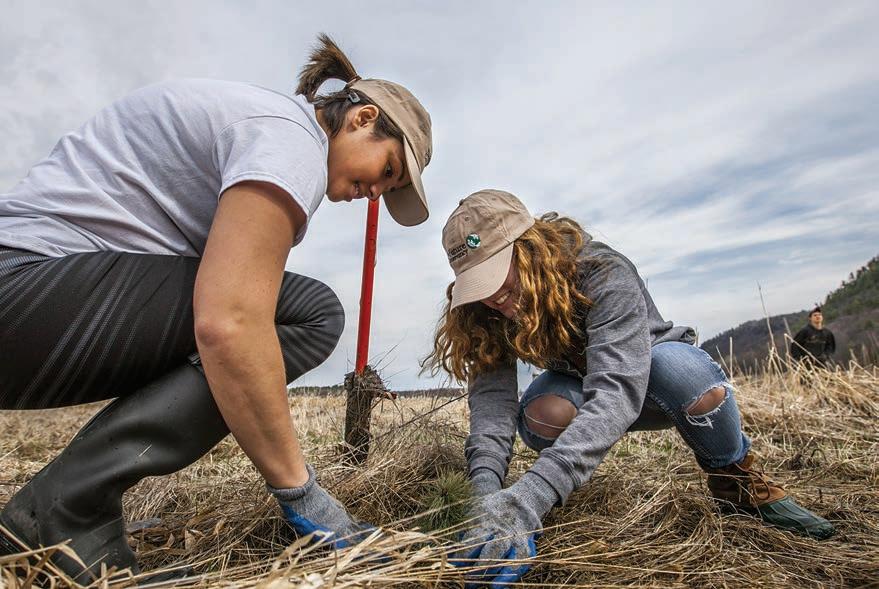
TNC has made mistakes in its 71-year history when partnering with Indigenous and local communities. What I find most impressive is that – for a large, complex organization – we’re continuously working to live by our values and learning from these mistakes to become a more resilient organization.
Will you discuss TNC’s investment strategy and how critical are ESG and impact investing to TNC’s investment philosophy?
We believe strongly that sustainable business practices can yield attractive financial returns as well as positive externalities for stakeholders and the environment. So, we carefully integrate such considerations into our investment strategy and strive to employ investment managers who use ESG criteria to inform their investment decisions.
An aerial view of part of the 42 million acre Pantanal wetlands in Brazil
POSTED WITH PERMISSION. COPYRIGHT © 2022 LEADERS MAGAZINE, LLC LEADERS65 VOLUME 45, NUMBER 4
Planting a young American elm seedling at Hubbardton River Clayplain Natural Area, Vermont
We also exclude certain opportunities from our endowment and other long-term investment portfolios when we deem them inconsistent with our mission. These tend to be opportunities that involve extractive industries, high carbon-intensive businesses, or those that have high environmental damage costs due to excessive natural resource use.
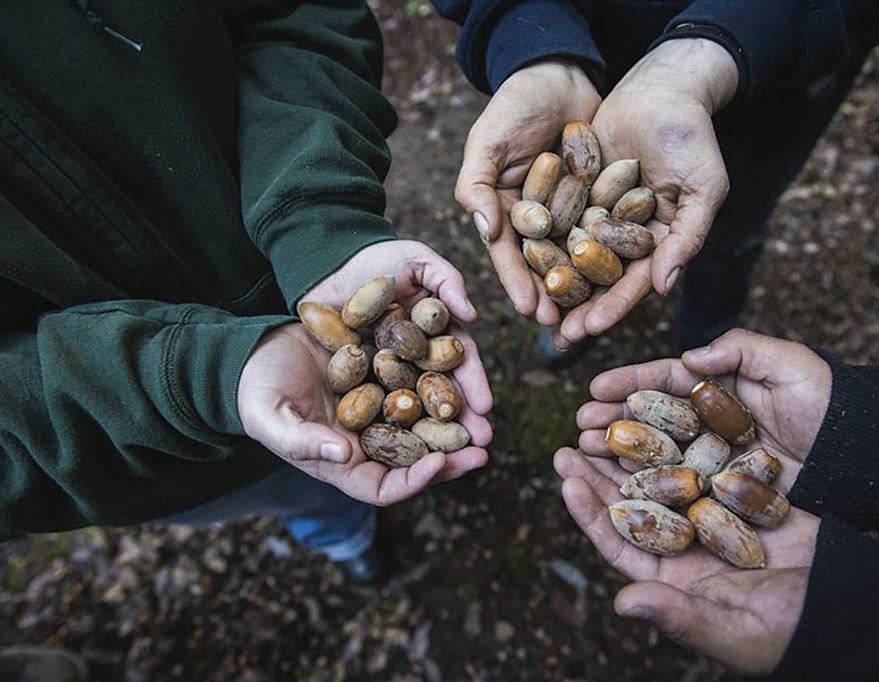
We have a growing private equity portfolio where we proactively invest in companies that are leading the decarbonization of the global economy. Here we place a strong emphasis on climate technology and other strategies that focus on climate solutions, given our mission. Our goal is to be a leading investor in this space, and I should quickly add that these are not concessionary investments. We don’t make concessionary investments within our endowment or long-term investment pools. All these investments are made with the explicit goal of generating market-beating returns.
Lastly, we apply a Diversity, Equity, Inclusion, and Justice (“DEIJ”) lens to all our investments, reinforcing TNC’s mission of “living our values.” We want the investment managers we partner with to be representative of the cultural diversity of the places we perform our conservation work. As such, we hope to promote underrepresented communities in the financial industry without sacrificing financial returns. Not surprisingly, the investment team we built is very diverse when viewed through the lens of inherent (race and gender) and acquired (education and socioeconomic background) diversity metrics.
How did TNC adapt its work to address the challenges caused by the global pandemic?
The human toll and the disruption of our daily livelihood caused by the global pandemic
has been staggering. Since TNC is a global organization, we were well equipped for the worldwide embrace of virtual meetings via Zoom and Microsoft Teams. But our conservation work often involves physical interactions with people and partner organizations in local communities, so we were ill-prepared for a world with limited or no travel, lockdowns, and lack of physical interactions.
I joined TNC at the onset of the pandemic –March 16th to be precise. And I remember speaking to the head of our India business unit as part of my orientation as she lamented about COVID grounding her team’s fieldwork. I heard similar stories from other teams in the field. It was undoubtedly a very tough period, but we managed through it and we’re all glad that most economies have opened up to pre-COVID levels.
As far as our investment portfolio was concerned, the pandemic provided some silver linings. We were able to hire a talented team and leveraged our brand and the market uncertainty to upgrade our portfolio. We also quickly adapted to the new reality that we had to rely on virtual meetings to conduct due diligence on new investment managers. While efficient, we also knew that this couldn’t be the norm –nothing beats interacting with people live in a 3D world!
You have written several books featuring your poems. Where did this interest develop and what do you hope to convey through your poems?
I like to refer to myself as an accidental poet. Although I’ve always been a student of literature and was a prominent campus journalist during
my college years in Nigeria, I never considered myself a poet - not until I was “forced” to start writing poetry at the age of 18 after being afflicted with a life-threatening ailment. Why poetry, you’d ask, right? The nature of my sickness was such that I was in constant pain and bedridden during the day, but nighttime came with short bursts of energy that only lasted long enough to allow me to convey my thoughts in a condensed form, compared to the prose I was used to as a journalist. And because I thought I was going to die, I felt compelled to use that time wisely, articulating my thoughts on paper, always time stamped. So, poetry became an outlet to express my thoughts as my vulnerability, and that of all of us, dawned on me. Luckily, I cheated death, and it’s no coincidence that my first collection was titled “Nocturnal Notes.”
I write about various topics – from my Nigerian upbringing and culture, politics, racism, microaggression, vanity, immigration, and death, to love, family and religion.
What do you see as the keys to effective leadership and how do you describe your management style?
I think effective leadership starts with selfawareness. As a leader, it’s important to understand your strengths and your weaknesses – yes, we all have blind spots. You want to surround yourself with people who allow you to project and maximize your strengths, but whose strengths are in areas where you exhibit your highest weaknesses. You also want to empower them to challenge you and take shared ownership of decisions even when those decisions go against their initial inclinations. I strongly believe that no person is an island of unlimited knowledge, and that everyone on the team has a role and a voice that should be heard.
My management style is collaborative even though it may appear to be less democratic. I want to hear from many people with different points of view. I think this allows for the best decisions to be made. But I don’t think the majority should always carry the vote. I like when people think outside the box and are not afraid to be wrong or sound crazy. Arthur B. MacDonald, the Canadian Nobel Laurate in Physics, once said that “behind every success, there is effort, behind the effort there is passion and behind the passion, there are people with the courage to try.”
Ultimately, I recognize that as a leader, it is my job to make tough decisions and I don’t ever shy away from them.
What advice do you offer to young people beginning their career during this unprecedented time?
My advice to them would be to focus on what they are passionate about that will have an enduring impact on the world. We have barely scratched the surface in exciting areas such as artificial intelligence, machine learning, climate technology, genomics, space exploration, and blockchain/web3. All these fields have the potential to change the world in positive ways and those entering the workforce today will be the legends of tomorrow. My hope is that they will choose wisely.•
POSTED WITH PERMISSION. COPYRIGHT © 2022 LEADERS MAGAZINE, LLC LEADERS 66 VOLUME 45, NUMBER 4
Yurok tribal members collect tanoak acorns on traditional Yurok land in Klamath, California
Your real estate is much more than a physical location.

It’s your investment. It’s your place of business. It’s your hub for connection, collaboration and culture. Our experts offer advice and solutions covering all aspects of commercial real estate to best ensure your property provides optimal value.














Learn more about our experts and how they can help you get there. colliers.com
Colliers makes no guarantees, representations or warranties of any kind, expressed or implied, regarding the information including, but not limited to, warranties of content, accuracy and reliability. Any interested party should undertake their own inquiries as to the accuracy of the information. © 2022. All rights reserved. Colliers International.
Skilled advice to unlock enhanced value. Experts choose experts.
Investment Management and Client Service
EDITORS’ NOTE John Koudounis joined Calamos Investments in April 2016. Previously, he was President and Chief Executive Officer for Mizuho Securities USA Inc.; Managing Director, ABN AMRO Inc; and Vice President, Merrill Lynch. He received his AB in international diplomacy and foreign affairs and economics from Brown University.
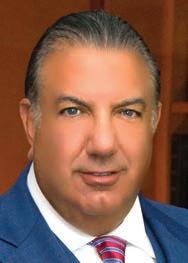
FIRM BRIEF Calamos Investments (calamos.com) is a diversified global investment firm offering innovative investment strategies including alternatives, multi-asset, convertible, fixed income, and equity. The firm offers strategies through separately managed portfolios, mutual funds, closed-end funds, private funds and UCITS funds. Clients include major corporations, pension funds, endowments, foundations, and individuals, as well as the financial advisors and consultants who serve them. Headquartered in the Chicago metropolitan area, the firm also has offices in London, New York, San Francisco, and Miami.
Will you discuss the history of Calamos Investments and how the firm has evolved?
Calamos is an active manager that has been in the market for nearly 50 years. Since our founding in 1977, we have assisted investors to navigate numerous market cycles and today we have about $40 billion in assets under management. Our founder, John
Calamos Sr., pioneered investing in convertible bonds as an asset class and he literally wrote the book on the subject, which is still taught as part of the curriculum in business school today.

Over the years, we have evolved and expanded our product offerings to meet investor demand, both by organic growth and by strategic acquisitions. Calamos provides a variety of funds with actively managed investment strategies that include stocks, bonds, convertible securities, and alternatives. Our risk-managed strategies have resonated with investors and are especially relevant now in the current market as investors seek solutions to weather the inflationary and rising rate environment. I am proud of the fact that, since I became CEO in 2016, our AUM has more than doubled, a testament to our success in the marketplace.
How do you define Calamos Investments’ mission and values?
Calamos is committed to excellence in investment management and client service. We are dedicated relentlessly to customer service and assisting our clients to meet their financial goals, and I have aligned the firm around that mission. For example, I have placed a greater focus on communications among our investment professionals and between the operational side of the firm so that everyone is pulling in the same direction, working together as a cohesive team to fulfill the Calamos mission.
What is the philosophy around Calamos’ investment strategy and how critical is investment discipline as part of the strategy?
As active managers, we believe there are opportunities in every market, even the most volatile ones. Our strategies are designed to help investors mitigate market risk, minimize market downside, and optimize upside. At Calamos, we maintain a disciplined investment process that marries quantitative and fundamental analysis, and our goal is to provide the best risk-adjusted long-term sustainable returns. Today’s market is essentially a stock picker’s market. We believe that careful selection of investments and a disciplined, active approach is more important now than ever. Investors embraced our funds in their portfolio allocation when the market was going up, and our strategies are especially resonating now as we all face this ongoing volatility and uncertainty.
Calamos has achieved strong results and is consistently an industry leader. How important is it to build more brand awareness for Calamos and to create a broader understanding of the Calamos advantage?
We believe it is very important. In fact, we recently hired our first Chief Marketing Officer, Jessica Fernandez, who has more than 20 years of experience as a specialist in marketing strategies for the asset management industry. Jessica will work with us to articulate the Calamos brand message more clearly and help us communicate our brand mission and values for our clients and partners through a comprehensive marketing effort.
Will you highlight Calamos Investments’ commitment to building a diverse and inclusive workforce to bring diverse perspectives and experiences to the table when making investment decisions?
Calamos is committed to fostering, cultivating, and preserving a culture of diversity, equity, and inclusion. We believe that human capital is one of the most valuable assets of the firm. The inclusion of different voices, different viewpoints, and different life experiences not only makes us stronger as a company, it also allows us to serve our investors and clients more effectively.
We incorporate our diversity, equity and inclusion initiatives into the firm’s recruitment, professional development and training, and social programs. Our goal is to foster a general work
PURPOSE
John S. Koudounis
An Interview with John S. Koudounis, Chief Executive Officer, Calamos Investments
POSTED WITH PERMISSION. COPYRIGHT © 2022 LEADERS MAGAZINE, LLC LEADERS 68 VOLUME 45, NUMBER 4
“Calamos is committed to excellence in investment management and client service. We are dedicated relentlessly to customer service and assisting our clients to meet their financial goals, and I have aligned the firm around that mission.”
environment built on the premise of both intellectual and experiential diversity. For example, we require all associates to complete annual diversity awareness training to enhance their awareness and knowledge. We also promote communication, understanding and career opportunities in a variety of ways, including diversity, equity and inclusion focus groups, lunch and learns, and leadership development programs. In one initiative, we aim to support the career growth of individuals from underrepresented groups though our Diversity and Inclusion Mentorship Program, where select individuals meet monthly with senior Calamos executives.
What do you see as Calamos’ responsibility to support the communities it serves and to be a force for good in society?
At Calamos, we care about our communities, particularly our headquarters city of Chicago. Chicago is my native city. I grew up here in a family of immigrants who came to this country from Greece and worked very hard to realize the American dream, and to give me a future. Giving back to the city that is my home is very important to me.
Calamos associates share these ideals, and we care deeply about the world we live in. Our employees have participated in many activities and given wholeheartedly of their time over the years. We’ve walked in the March of Dimes March for Babies and American Cancer Society Relay for Life. We’ve worked to fight hunger at the Northern Illinois Food Bank and Loaves & Fishes Community Services. We’ve collected for Toys for Tots, among other activities.
With the onset of COVID in 2020, I was very concerned by the suffering in our city and could not sit on the sidelines. I brought together local CEOs and business leaders to form the Chicago CEO COVID-19 Coalition, uniting local business leaders in a humanitarian campaign for COVID-19 relief and recovery. Chicago-area celebrities and sports stars joined in our efforts, and we created the “Sweet Home Chicago” telethon that was streamed in May 2020. We raised $1.3 million that benefited ten charities representing the themes of personal protective equipment; food insecurity; homelessness; community and mental health; and families of law enforcement and LGBTQ community COVID assistance.
100 percent of our associates contributed to the campaign and we matched 100 percent of our employee contributions. The program united everyone in an absolutely amazing response to help during a very challenging time.
How are the impact of Environmental, Social and Governance (ESG) factors incorporated in Calamos’ fundamental investment process?
We have signed the internationally recognized UN Principles for Responsible Investment (PRI), expressing our commitment to responsible investment and participating in a global community seeking to build a more sustainable financial system. Our approach to sustainable investing, and in particular the impact of ESG factors, is incorporated in our fundamental investment process as part of our commitment to our clients’ long-term best interests. ESG analysis is part of the greater mosaic of what we assess for our investment decision-making. It complements our ultimate objective of delivering superior long-term investment riskadjusted returns to our advisory clients.
In 2021, we also expanded our sustainable investment capabilities with a seasoned ESG management team to provide our investors with even more choices in the ESG arena. ESG pioneers Tony Tursich and Jim Madden joined us last year to lead the development of focused sustainable investment products. Tony and Jim helped set industry standards for ESG focused investing by developing one of the first sustainable research platforms in 1999, combining environmental criteria with fundamental research to
identify companies positioned to thrive in an evolving environment. They are co-managing our new ESG funds.
What do you see as the keys to effective leadership and how do you describe your management style?
I believe there are qualities that most leaders need to demonstrate, regardless of nature or nurture, whether they are instinctive or are developed over time. Hopefully, I share them. One is resilience – the ability to deal with uncertainty and disruption, and to seize the opportunities that come with constant change. Particularly now, in this time of uncertainty and confronting the prospect of a possible future recession, it is absolutely critical to be able to pivot for the benefit of your enterprise.
Another is a mindset of innovation – to be open and look for new and better practices and procedures. Throughout the history of business, there have been numerous examples of legacy companies and iconic brands that failed to see change coming and to adapt.
Listening is also a key factor to my success. I believe that paying attention to what your clients and what your employees are saying is imperative to be able to achieve success.
Finally, leaders need to be passionate in their pursuit of excellence and to demonstrate it in a way that serves as an inspiration to their organization.
What advice do you offer to young people interested in building a career in finance?
The financial markets are endlessly fascinating, which is as true for me today as it was when I started on Wall Street 30 years ago. Many young people have never seen market conditions as they are now, and inflation is a phenomenon from several generations ago. I would encourage young people interested in finance to begin to learn about the markets and economic policy and how they work. Start to read the business and financial media on a regular basis. Maybe select a company or two and look at their earnings announcements. Pay attention to news about the Federal Reserve and the impact of interest rates and monetary policy.
My general advice to young people, whether their choice is a career in finance or another industry, is to make sure to do what you love. Work toward realizing your dreams and passions, and the rest will follow.•
“Our risk-managed strategies have resonated with investors and are especially relevant now in the current market as investors seek solutions to weather the inflationary and rising rate environment.”
POSTED WITH PERMISSION. COPYRIGHT © 2022 LEADERS MAGAZINE, LLC LEADERS69 VOLUME 45, NUMBER 4
“Our approach to sustainable investing, and in particular the impact of ESG factors, is incorporated in our fundamental investment process as part of our commitment to our clients’ long-term best interests.”
Creating Better Financial Futures for Investors
An Interview with Samara Cohen, Chief Investment Officer of ETF and Index Investments, BlackRock
EDITORS’ NOTE Samara Cohen is the Chief Investment Officer of ETF and Index Investments for BlackRock. She leads the teams responsible for delivering the market quality and investment integrity of BlackRock’s index funds and iShares ETFs. Cohen is a member of the ETF and Index Investments Management Committee, the firm’s Vote Issues Advisory Committee, Global Operating Committee, and Global Executive CommitteeInvestment Subcommittee. She is a senior sponsor for the firm’s Black Professionals Network. Cohen earned a BS in economics and finance from the Wharton School and a BA in theatre arts from the College of Arts and Sciences of the University of Pennsylvania. She earned an MBA from Harvard Business School.

COMPANY BRIEF BlackRock (blackrock.com) is one of the world’s leading providers of investment, advisory and risk management solutions. BlackRock is a fiduciary to its clients. The company is investing for the future on behalf of its clients, inspiring its employees, and supporting its local communities.
Will you highlight your role and vision as the first CIO for BlackRock’s ETF and Index Investments business?
I’m privileged to oversee one of the industry’s largest investment platforms – nearly $6 trillion in assets across iShares ETFs and BlackRock index funds – and lead a global team of 350 unbelievably talented investment professionals. These portfolio engineers, risk managers, platform architects, market structure developers, and product operating model designers are collectively responsible for delivering market quality and investment performance for over 2,700 portfolios.
Those are big numbers, but what ultimately drives me is what those numbers represent: a globally accessible investment platform that delivers performance and precise index outcomes for millions of people. The ETF ecosystem is highly complex, so our work encompasses everything from developing and implementing best-in-class trading strategies to creating more resilient markets through education and engagements with all the participants.
As I like to say, at BlackRock there’s nothing passive about how we manage our ETF and index portfolios.
How has your work improved the experience of investors who are saving for big life goals like retirement?
It’s hard to overstate the impact of ETFs and index funds on how people save and invest. They help investors conveniently and cost-effectively diversify how they build long-term wealth. With the growth of digital platforms, literally hundreds of millions of investors access the markets through ETFs in amounts they can afford.

Since the launch of the first index fund over 50 years ago, we have been lowering barriers to make investing easier for everyone. Today, more than 120 million people globally use our products to access markets and build portfolios tailored to their needs, whether it’s diversification, income, and more. That’s why we’re committed to offering the broadest choice and are always innovating.
As we continue to strengthen our capabilities, we’re excited to welcome the next 100 million investors.
You mentioned market quality and performance. Is this a differentiator for BlackRock?
We’ve led the index industry in developing a clear framework for investment performance. At iShares, we measure performance through precision or how well index products deliver index returns consistently over time, and
through market quality, specifically our ETFs’ ability to offer liquidity, price discovery, and efficient market access.
Keep in mind that indexes are financial calculations and are not directly investible. Accessing the outcome of a specific index in an investment portfolio has become more challenging as the industry moves towards more customized and complex indexes. Investors who want exposure to those indexes invest in index-tracking mutual funds and ETFs; our aim is to track the performance of the specified index as precisely as possible, in all market conditions.
How is BlackRock leading in the modernization of the industry through ETFs?
The evolution of the bond markets is a great example of BlackRock’s leadership in driving market modernization. Twenty years ago, the over-the-counter fixed income market was extremely inefficient and fragmented; bond trades were negotiated privately, and often investors had no way to get real-time price quotes. That changed in 2002, when iShares launched the industry’s first bond ETFs, an innovation that helped to break down barriers to fixed income investing by bringing transparent and liquid on-exchange trading to a fragmented and opaque market. For the first time, all investors could efficiently purchase a portfolio of bonds through one ETF – on a stock exchange – at a known price. Today, there are over 1,400 bond ETFs, worth about $1.6 trillion in AUM globally. That growth has been expedited by electronic trading, the creation of alternative trading venues, and other developments.
PURPOSE
Samara Cohen
POSTED WITH PERMISSION. COPYRIGHT © 2022 LEADERS MAGAZINE, LLC LEADERS 70 VOLUME 45, NUMBER 4
“The ETF ecosystem is highly complex, so our work encompasses everything from developing and implementing best-in-class trading strategies to creating more resilient markets through education and engagements with all the participants.”
This is truly the democratization of investing: individuals, wealth advisors, active asset managers, and large insurers all use bond ETFs for convenient, low-cost exposure to global bonds and to easily recalibrate their portfolios. We believe the industry will grow even further, and project global bond ETF AUM will reach $5 trillion by 2030.
How do you describe BlackRock’s culture and how critical is culture to the firm’s success?
I’m what BlackRock refers to as a “boomerang” – I joined the firm right out of college, a few years after its founding, left for business school, and eventually rejoined 18 years later. That gap showed me that while the firm constantly evolves, our purpose-driven culture and deep sense of responsibility to clients have remained the same.
BlackRock was founded by a group of market experts who were determined to put clients’ needs first and who wanted to use their passion for understanding and managing risk to help create better financial futures for investors. This is very much the heart of BlackRock’s culture today – this mindset has driven the firm’s growth over the past three decades and will determine the path ahead.
How important is it for BlackRock to build a diverse and inclusive workforce?
At BlackRock, we recognize that we have the best chance of serving our clients if our teams reflect our wide pool of investors. We also believe that a culture and mindset of diversity, equity, and inclusion can only happen if it’s embedded into everything we do. So, our DEI
strategy focuses on our talent and culture as well as on our role as a fiduciary for our clients, our policy advocacy, and our contributions to our local communities. And of course, the firm has advocacy networks for differently abled, LGBTQ+, veteran, and Latinx employee groups and allies. I’m a senior sponsor of our Black Professionals Network.
Welcoming diverse perspectives was an essential part of my own journey at BlackRock.
I knew next to nothing about ETFs when I was approached to help build the firm’s ETF infrastructure. The firm took a leap of faith by seeing my potential and how my experiences could bring a different lens to growing our business.
I’m committed to paying that forward. In my own hiring, I identify team members based on their unique experiences and potential.
Do you feel that there are strong opportunities for women to grow and lead in the industry?
I started my career in an industry dominated by men. While the journey to diversity is a constant work in progress, I strongly believe there are great opportunities and a significant need for women to sit around decision-making tables. When I was applying for my first job out of college, I applied and interviewed at BlackRock where three of the firm’s fifteen partners were women. In 1993, that was a rare statistic. I remember being inspired to follow in their footsteps and learn from them to figure out what I wanted to do.
Female representation is what initially drew me to BlackRock, and it’s key to showing women they can do the same and be successful. Today, there are even more
resources, including professional networks and mentorships. Personally, over the past three decades, I’ve been championing women and others who feel like they don’t “fit in” with our industry. I’m proud to say I lead a majority female leadership team and I hope to grow it even further.
What do you see as BlackRock’s responsibility to the communities it serves and to being a force for good in society?
BlackRock is committed to helping our clients and our communities experience financial well-being and navigate long-term risks and opportunities. Millions of people invest through us to build savings that serve them throughout their entire life, including teachers, nurses, and factory workers, many of whom were financially impacted by COVID-19.
Our work to enable financial well-being naturally extends to our philanthropic mission. The BlackRock Foundation, created in 2020 to help bolster social impact efforts, focuses on unlocking economic opportunities for underserved populations. Since its creation, the Foundation has committed $50 million in COVID-19 relief to impacted communities to cultivate financial security for a larger and more diverse group of people. It has also launched major projects like the Emergency Savings Initiative, a cross-sector program that helps people living on low- to moderate-incomes gain access to and increase usage of proven savings strategies and tools.
What advice do you offer to young people beginning their careers during this unprecedented time?
First, to those interested in joining an industry, but worry that they don’t see enough leaders who look like them, I would say: Find your purpose and lean into your passion – we will all be better for it. Your experiences are unique, and they will bring value to your organization.
Second, people who recently started their careers have had an unconventional experience, joining the workforce remotely. While the digital environment allows us to connect seamlessly beyond our physical location, it may have also barred newcomers from building meaningful relationships. To remedy this, I urge them to reach out to not only peer mentors, but also to leaders across their networks to find a sponsor
be critical
since these connections will
in helping them navigate the new environment they’ve entered.•
“Since the launch of the first index fund over 50 years ago, we have been lowering barriers to make investing easier for everyone. Today, more than 120 million people globally use our products to access markets and build portfolios tailored to their needs, whether it’s diversification, income, and more.”
POSTED WITH PERMISSION. COPYRIGHT © 2022 LEADERS MAGAZINE, LLC LEADERS71 VOLUME 45, NUMBER 4
“This is truly the democratization of investing: individuals, wealth advisors, active asset managers, and large insurers all use bond ETFs for convenient, low-cost exposure to global bonds and to easily recalibrate their portfolios.”
Changing the Conversation Around Mental Health

EDITORS’ NOTE Over the past decade, Kevin Love has taken the National Basketball Association by storm. A unique superstar, Love’s career has been highlighted by five NBA All-Star elections, an NBA Championship in 2016, an Olympic gold medal in 2012, and a FIBA World Championship in 2010. He has also become an undeniable force beyond sports as he helps normalize the conversation surrounding mental health and create an opportunity for others to do the same. After documenting his experience with depression and anxiety in a powerful personal essay in The Players’ Tribune, Love quickly evolved into the public spokesperson for mental health awareness among athletes. Continuing his advocacy in this space, he founded the Kevin Love Fund (KLF) in 2018, a fund dedicated to inspiring people to live their healthiest lives while providing the tools to achieve physical and emotional well-being. Since then, Love has been awarded the ESPY Arthur Ashe Courage Award, Change Maker Award by the Child Mind Institute, the NBA Cares Assist
Award, and was an ESPY Muhammad Ali Sports Humanitarian Award finalist, all due to his work in mental health awareness.
FUND BRIEF After publicly sharing his personal story about his challenges with mental health, Kevin Love established the Kevin Love Fund (kevinlovefund.org) to inspire people to live their healthiest lives while providing tools for both mental and physical health. Through a unique combination of education, research, grantmaking, and advocacy, KLF is breaking the stigma around mental health and ensuring people who are suffering have the support needed to thrive. One by one, fans and other high-profile celebrities began to share their own stories of fear and struggle, and a national conversation had begun. Kevin Love Fund is a fund of the Entertainment Industry Foundation (EIF), a 501(c)(3) tax-exempt organization. EIF is a Charity Navigator 4 Star Charity that meets all 20 BBB Charity Standards and carries the Candid Platinum Seal of Transparency.
What was your vision for creating the Kevin Love Fund and how do you define its mission?
Mental illness is one of the single greatest thieves of human potential today, but it doesn’t have to be. Back in 2018, I published my personal story about challenges with mental health in The Players’ Tribune. This came several months after I experienced a massively public panic attack during a basketball game. When sharing my story, I had no idea the movement it would create. There had never been another moment in my life where I was approached by more people – fans, friends, teammates, and other high-profile celebrities – sharing their own struggles, and that they too were too afraid to talk about it and address it. It was life-changing for me in the sense that I finally felt like I could truly be me and that I had shared my truth.
My vision for the Kevin Love Fund is to change the conversation and stigma around mental health to ensure that people struggling have the tools and confidence needed to be healthy and thrive. For far too often and for far too long, people have avoided getting the help they need out of fear of how they will be perceived. Our mission is to end that fear, but also to find real solutions and create resources that make an impact.


How have your own personal challenges with mental health impacted the way you approach the work of the Fund?
I think it is key to bring your own authenticity to the work. Our theory of change incorporates bringing vulnerability and storytelling to everything we do. My personal journey is imperfect and ever-changing. You do not need to suffer alone. Everyone is going through something, and I hope that by sharing my own story, it helps others reach out for help.
Will you highlight the four pillars of the Kevin Love Fund and how the Fund addresses these core areas?
The four pillars we focus on are education, research, advocacy, and grantmaking.
In the education space, our recently launched curriculum aims to normalize mental health issues and model emotions as an important dimension of our common humanity. Designed with an emphasis on 9th and 10th graders, students learn how to cultivate empathy for others and themselves, understand the link between gratitude and well-being, harness creativity to support the healthy expression of emotions, and more.
PURPOSE
Kevin Love
An Interview with Kevin Love, Professional Basketball Player, Mental Health Advocate, and Founder, Kevin Love Fund
POSTED WITH PERMISSION. COPYRIGHT © 2022 LEADERS MAGAZINE, LLC LEADERS 72 VOLUME 45, NUMBER 4
Kevin Love with students
Teachers are trained to be vulnerable in order to model the behavior they seek from their students, and work as mentors and collaborators with each child in the program to best address their specific challenges.
Our research efforts are in direct response to the impact of COVID-19, as it wreaked havoc on the mental health of people of all ages. We know that additional research is needed to improve how these issues are diagnosed and treated. To respond, we endowed the Kevin Love Fund Centennial Chair in UCLA’s psychology department – a first of its kind – to enable scholars

to advance more personalized treatments for people living with anxiety and depression.
As for grantmaking, we provide organizations around the country with the resources and tools needed to provide direct mental health programming in their communities. Over the past year, we have supported leading nonprofits including Just Keep Livin Foundation, Morgan’s Message, the Born This Way Foundation, the Chris Paul Family Foundation, and more. We also provided emergency COVID-19 grants in 2020 to more than 1,000 arena workers in Cleveland to help them weather the financial impact of the pandemic.


When it comes to advocacy, in partnership with Headspace, we launched a television and radio PSA campaign to amplify our ability to reach people at-risk or currently facing mental health challenges. Through the TV PSA, we reached nearly 341 million people, and our radio PSA aired over 30,000 times.
Will you elaborate on KLF’s education program and its approach to social emotional learning?
In collaboration with K-12 educators and social emotional learning experts, we recently launched a high school curriculum that supports students in expressing emotion and destigmatizing challenges with mental health. Our approach is unique in a few ways. Educators model vulnerability by sharing their own life experiences. Students are encouraged to express emotions through creativity and project-based learning. Video clips from celebrities, artists, and other young people allow students to see that they are not alone
in their feelings of anxiety, depression, anger, grief, or other challenging emotions. Teachers and school counselors tailor the curriculum in a way that will feel authentic to their classroom community. Our comprehensive teacher training supports educators in developing a social justice perspective on storytelling and vulnerability.
Over the course of 14 lessons, students learn to destigmatize emotions often labeled as “negative” by our culture and understand that the search for authenticity and identity is a central aspect of adolescent development. They explore various artistic mediums such as photography, drawing, writing, and collage as a way to express emotion. They cultivate empathy for others and recognize that thoughts and feelings are connected and distinguish between kind thoughts and critical ones. Lastly, students better understand the connection between gratitude and well-being, and recognize that kindness and service are linked to happiness.
Kevin Love speaking with the Cleveland Cavaliers organization (above) and at a meet and greet (right)
POSTED WITH PERMISSION. COPYRIGHT © 2022 LEADERS MAGAZINE, LLC LEADERS73 VOLUME 45, NUMBER 4
Kevin Love speaking on panel at All-Star weekend in Chicago
How did the pandemic impact KLF’s work?
The past few years have not been for the faint of heart. People around the country are hurting, making our work more important and urgent than ever before. We have the programs and platform in place to make an outsized difference, and we are on a mission to reach one billion people in need over the next five years.
How critical are metrics to measure the impact of KLF’s work?
I have always believed that if you can’t measure it, you can’t change it. That is why my Fund invested in naming the first ever endowed chair at UCLA to research anxiety and depression.
How valuable has it been to the work of the Fund to have assembled such strong organizational talent to lead its efforts?
The team that we have assembled is exceptional. I’d like to specifically call out Sara Hahn and Ellie Foster, our two Directors of Education. It’s an accomplishment on its own that they developed such a phenomenal SEL curriculum; but in the past year, they’ve already onboarded 250 schools, in which nearly 10,000 students have experienced and completed our program. We expect that our free curriculum will reach thousands more over the next year as we onboard schools nationwide.
The Kevin Love Fund has made a major impact since its founding. Do you take moments to reflect and appreciate what KLF has accomplished?

Absolutely. I try to practice the lessons taught through the Fund’s curriculum, and at the heart of it is gratitude. I’m incredibly grateful for the work and accomplishments of our Fund, but I’m also grateful for the thousands of teachers and students that were vulnerable enough to tell their own stories in the classroom and do the work for themselves. I look back at my own childhood and know that if I had had the opportunity to openly talk about my experiences and feelings, the impact
it would have had would have been life-changing. Our hope is that kids know they aren’t alone and that they don’t need to “go down the hall” to talk about their struggles, but can turn to a friend, neighbor, or teacher, and feel comfortable doing so in that very moment.
What are your priorities for the Kevin Love Fund as you look to the future?
Our priorities are to expand and scale our SEL curriculum nationwide to reach as many teachers and students as possible. We are also in the beginning stages of developing an elementary school program that will include a children’s book series. Additionally, we are excited to expand our work with college age students with an emphasis on student athletes. We are grateful to all the donors and partners that continue to support our efforts and we look forward to expanding that network in the years to come.•

 Self-esteem and trust-building activities at Camp Harbor View in Boston (above and below)
Self-esteem and trust-building activities at Camp Harbor View in Boston (above and below)
POSTED WITH PERMISSION. COPYRIGHT © 2022 LEADERS MAGAZINE, LLC LEADERS 74 VOLUME 45, NUMBER 4
The KLF curriculum in-action at Camp Harbor View in Boston
























































































































































































































































































































































































































































































































Delivering world renowned design and the finest quality crystal custom inquiries welcome www.crystalsignatures.com Corporate Concierge: 1-610-758-9666 Sales@crystalsignatures.com
Crystal Signatures Inc.
The Three Kings
A once in a lifetime collaboration of Steuben’s Finest
Edition
Peter W. Yenawine & Max R. Erlacher
Limited
Striving to Deliver Better Risk-Adjusted Returns
An Interview with Jeffrey Sherman, Deputy Chief Investment Officer, DoubleLine

EDITORS’ NOTE As DoubleLine’s Deputy Chief Investment Officer, Jeffrey Sherman oversees and administers DoubleLine’s Investment Management sub-committee coordinating and implementing policies and processes across the investment teams. He also serves as lead portfolio manager for multi-sector and derivative-based strategies. He is a member of DoubleLine’s Executive Management and Fixed Income Asset Allocation Committees. He can be heard regularly on his podcast “The Sherman Show” (@ShermanShowPod) where he interviews distinguished guests, giving listeners insight into DoubleLine’s current views. In 2018, Money Management Executive named Sherman as one of “10 Fund Managers to Watch” in their yearly special report. Prior to joining DoubleLine in 2009, he was a Senior Vice President at TCW where he worked as a portfolio manager and quantitative analyst focused on fixed income and real-asset portfolios. Sherman was a statistics and mathematics instructor at both the University of the Pacific and Florida State University. He taught Quantitative Methods for Level I candidates in the CFA LA/USC Review Program for many years. He holds a BS in Applied Mathematics from the University of the Pacific and an MS in Financial Engineering from the Claremont Graduate University. He is a CFA® charterholder.
FIRM BRIEF DoubleLine (doubleline.com) is an independent, employee-owned money management firm with more than $134 billion in combined assets under management invested across a wide array of investment strategies. The firm’s experienced team of portfolio managers have worked together on average 15 years. DoubleLine’s investment strategies include U.S. Fixed Income, Global Fixed Income, Emerging Markets Fixed Income, U.S. Equity, Commodities, and Global Multi-Asset products.
Will you discuss the history of DoubleLine and how the firm has evolved?
DoubleLine is an independent, majority employee-owned money management firm founded by Jeffrey Gundlach in December 2009 under a cardinal mandate: striving to deliver better risk-adjusted returns. This mandate includes the avoidance of risk-taking that
even under seemingly improbable scenarios could lead to catastrophic portfolio losses. In pursuit of this mandate, DoubleLine works to integrate an array of factors, all of which are critical to success. These include bottom-up security selection, trade execution, portfolio construction, topdown sector allocation, resourcing of the firm’s personnel and systems and, ultimately, the ownership structure of DoubleLine. Employee ownership reinforces the stability of the investment team and its accountability: No outside decision-makers stand between the team and our valued clients.
We started with 45 individuals focusing on delivering financial strategies that can help our investors navigate various macroeconomic environments and achieve their investment goals. DoubleLine today employs more than 280 people, of whom 110 are investment professionals, and manages more than 20 distinct strategies. Our investment strategies span the gamut of the global opportunity set: U.S. fixed income, global fixed income, U.S. equities, commodities and global multi-asset products. In addition, we deliver our strategies via a variety of distribution channels, including mutual funds, exchange-traded funds, separate accounts, and other vehicles. This diversity of product and distribution allows investors access to DoubleLine’s thought leadership and expertise in forms tailored to their risk profiles and preferred paths of execution.
How do you define DoubleLine’s mission and values?
We want our clients to have the best experience possible, and we put our clients’ interests first. Achieving that investment goal and maintaining that investor focus starts with our employees. Nothing builds a stronger foundation for a company than its most valued asset – its people. This foundation is hardwired through ownership structure and nourished by in-house environment. Our interests are aligned with those of our clients. We strive to continue to cultivate the collaborative environment formed in our foundation: a group of people who love working together toward our common goals. Our culture is collaborative in that all employees are valued and respected. Through this team approach, creative ideas are fostered and elaborated into effective solutions.
What is the philosophy around DoubleLine’s investment strategy?
To some extent, investment processes vary in adaptation to the particulars of asset class and strategy. That said, the following general principles are embedded across investment groups:

First, let’s take bottom-up investment ideas as the individual building blocks of a portfolio. Investment ideas must offer an asymmetric, positively skewed risk-reward profile. In other words, selected securities must appear through careful fundamental analysis to offer greater potential payoff than potential loss.
Then, the next question becomes, how might these building blocks perform as an ensemble? DoubleLine believes that all investments need to start with risk analysis intrinsic to the portfolio, not relativized in benchmark comparisons, which is probably the conventional approach outside DoubleLine. In our view, it is not how investments within a portfolio compare to benchmarks, but how their risks relate to each other across a broad range of scenarios, including scenarios others might disregard as improbable. Risk-integration techniques enable DoubleLine to build what we believe are more successful portfolio foundations.
Portfolios must be constructed with an aim to outperform under a range of future scenarios. In other words, DoubleLine shuns risk-taking based on unidirectional forecasts regarding interest rates, default rates or other variables that drive return. If we develop strong basecase scenarios, we can bias a portfolio somewhat toward that outcome, but only so far, as we strive to construct portfolios to perform in the event our base-case outlook proves wrong. Even in the hypothetical case where a favored forecast proves to be early or wrong – choose your adjective – in the interim, but right over the fullness of time, there are serious limits to the tracking error that investors, especially investors in fixed income, can stomach.
What have been the keys to DoubleLine’s success, and how do you describe the DoubleLine difference?
One of the key differences that distinguishes DoubleLine is the stability of the portfolio management team. Although founded in 2009, the portfolio management team averages 23 years of investment experience and 15 years of working together, as many of us worked together for years at a prior firm. We believe the longer the team has worked together, the more
PURPOSE
Jeffrey Sherman
POSTED WITH PERMISSION. COPYRIGHT © 2022 LEADERS MAGAZINE, LLC LEADERS 76 VOLUME 45, NUMBER 4
consistent its philosophy and process. Together, the team has navigated multiple market and macroeconomic cycles. Thanks to the longevity of that shared learning under trending conditions, under range-bound conditions and under battlefield conditions, the team brings together a rare collective expertise when markets change in ways that can either rhyme with past precedent or confront the world with something new.
I am probably repeating myself, but if anything bears repeating, this does: We believe that active risk-management should form the cornerstone of portfolio construction. We closely integrate our top-down, committee-based approach to allocation and portfolio construction with the bottom-up fundamental analysis from investment teams specialized in different investment sectors and asset classes. In this riskmanagement framework, investments are not only analyzed for their return-to-risk prospects, but also for their fit into the overall portfolio.
Will you highlight DoubleLine’s commitment to building a diverse and inclusive workforce to bring diverse perspectives and experiences to the table when making investment decisions?
The key to fostering a collaborative work environment is to treat your fellow employees with respect and value the opinions around the table. Not everyone has the same experiences as you have, and from those differences we learn from one another. Having diverse backgrounds – such as gender, race, ethnicity, socioeconomic background, education, and professional experience – allows us to approach problems from different angles and glean new perspectives. I’d also add that while successful organizations require strong leadership, we never want hierarchy to become the enemy of dialogue and innovation. Senior staff encourage ideas from all colleagues, regardless of seniority. The atmosphere in the workplace is a friendly and open one. I think our size, under 300 employees, also helps new hires become familiar with the staff and organization.
What do you see as DoubleLine’s responsibility to support the communities it serves?
As an investment adviser and as a fiduciary to its clients, DoubleLine is committed to maintaining the trust and confidence of those with whom we conduct business and to upholding high standards of integrity and business ethics.
In support of the community, DoubleLine is a platinum sponsor of Women in Institutional Investments Network in Los Angeles. We’ve hosted an event for 100 Women in Finance. In addition, one of our portfolio managers serves on the educational committee for 100 Women in Finance and is a founder of the Bloomberg Women’s Buy-Side Network. DoubleLine encourages employees to participate in community events, such as the annual Los Angeles YMCA Stair Climb.
DoubleLine is an equal-opportunity employer. The firm recognizes diversity and inclusion and works with recruitment programs for women and first-generation college students. Over half of DoubleLine’s employees identify as a member of an ethnic minority group. As part of our ongoing efforts to promote cultural connectivity across
the firm and be inclusive of new employees, we recently launched a formal mentorship program.
What are you views on the state of the U.S. economy?
The U.S. economy is slowing from an elevated level of economic activity in 2021. Given that the inflation rate has persisted significantly above the Federal Reserve’s comfort level, we can expect the Fed to continue to tighten monetary policy. The central bank will do this by both raising official short-term interest rates and reducing the extraordinary liquidity it provided out the longer end of the fixed income market through its purchases of treasuries and agency mortgage-backed securities. In a typical business cycle, the Fed does not significantly tighten monetary policy once the economy is already slowing, but this high level of inflation is problematic and will force the Fed to keep applying the monetary brakes.
However, there are still bright spots within the economy, namely the labor market. After the July jobs report, the U.S. now has more people working than prior to the onset of the pandemic lockdowns. This has led to an unemployment rate of 3.5 percent, with the number of job openings available still above the number of people deemed to be unemployed. This imbalance in the labor market has led to the largest broad-based wage growth seen in over 40 years. That said, the labor market operates with a lag to GDP growth. We’re monitoring the labor market for any signs of weakness.
What is the upshot? I’m not yet ready to rule out the possibility that the Fed engineers a “soft landing” or lucks into one. However, persistent inflation is making the avoiding of recession increasingly difficult. The odds are rising for the Federal Reserve to continue to tighten policy beyond neutral.
What do you see as the keys to effective leadership, and how do you describe your management style?
I believe that an effective leader is one who can create a team that is greater than the sum of its parts. That starts by having an inclusive culture that encourages idea sharing, provides educational support to newer employees, and broadly shares the lived market experiences from senior staff. Having a collaborative environment where all ideas are welcome allows team members to pursue intellectual, personal, and professional growth.
My management style focuses on team collaboration across various investment segments and communicating ideas in their simplest form. On my Macro Asset Allocation team, for example, I encourage my portfolio managers, analysts, and traders to distill complex concepts into their core building blocks. This provides a greater understanding of risks and opportunities. Lastly, I believe that there are no “bad ideas.” I remember a story where the great chemist and two-time Nobel laureate, Linus Pauling, was asked how he had so many great ideas. He replied that it was because he had so many bad ones. Of the many hypotheses one tests over a career, only a relative few get out of the laboratory to become effective
solutions in the real world, but you need the many to find the few. And when a concept is rejected by other team members, there needs to be rationale for its exclusion, and those reasons should be effectively communicated so that we can learn from one another.
Did you always know that you wanted to pursue a career in finance, and how did you end up in the business?
My educational foundation is in applied mathematics, and I have always had an affinity for problem-solving. I started off thinking that I would end up in the teaching profession. When I was in graduate school, I learned that the applications of higher-level mathematics not only applied to physics, but to finance as well. This led to me to stop focusing on a PhD in mathematics, and I pursued a master’s degree in financial engineering. As part of the program, I was required to do an internship, which landed me at an asset management firm, and that started me on my career. I joined that firm, first as an analyst in its portfolio analytics team, and subsequently as a member of the fixed income team led at the time by Jeffrey Gundlach. In December 2009, when Jeffrey started DoubleLine and invited me aboard along with 40 of our teammates, naturally I jumped at the chance. I have spent my entire career with this team, and I continue to enjoy the challenge that the investment industry provides.
What do you enjoy most about the investment industry?
What I enjoy most about the investment industry is the continuous innovation from market participants and how those ideas allow us to construct portfolios that have the potential for a higher likelihood of success. These innovations can come from many different directions such as a new asset type, new analytical tools, new data sets, new ways of tackling old problems. New challenges are always stemming from the macroeconomic environment, the business cycle, exogenous factors. Every day presents something new. I find working with our team to solve such problems intellectually rewarding.
What advice do you offer to young people interested in building a career in finance?
I think that anyone interested in finance should start with getting academic training in finance, learning both fundamental analysis as well as quantitative techniques of portfolio management. Next, get an education in financial history so that you can learn about different economic environments, other people’s mistakes, and try to draw parallels to, or distinctions from, the current environment. Once you have those foundations, surround yourself with people who have significant experience and can provide mentorship. It’s also important to learn about human psychology and how sentiment drives investor behavior. Read everything that you can get your hands on, ask questions from veterans around you and, most importantly, scrutinize opinions contrary to your own so that you avoid falling prey to confirmation bias. Hunting for people or opinions in agreement with your own has doomed careers as well as portfolios.•
POSTED WITH PERMISSION. COPYRIGHT © 2022 LEADERS MAGAZINE, LLC LEADERS77 VOLUME 45, NUMBER 4
Cultivating a Better Future
 An Interview with Stefan Soloviev, Chairman, Soloviev Group
An Interview with Stefan Soloviev, Chairman, Soloviev Group

EDITORS’ NOTE Stefan Soloviev is chairman of the Soloviev Group (solovievgroup.com), a privately held, multi-billion-dollar company involved in real estate, agribusiness, logistics, and renewable energy. Soloviev Group not only develops and manages major New York real estate holdings, but also owns Crossroads, a leading agricultural company that is the 26th largest landholder in the United States with 500,000 acres, growing corn, wheat, milo, alfalfa, canola, and cattle while using its farm holdings for major sustainable wind and solar energy projects. The firm has approximately 500 employees.

How did the Soloviev Group evolve?
The Soloviev Group was created when my father passed away and I merged my father’s company, which I inherited, with my own companies. My father, Sheldon Solow, was a very successful real estate developer in New York, including the iconic 9 West 57th Street. We currently have some 2.1 million square feet of leasable commercial space. I began working for my father’s real estate company when I was in high school, working from 2:30 PM to 7:30 PM. I initially parked cars in his buildings, then after two years at college, came back to New York City and fully managed
and promoted the garages, finally stepping into the role of running the entire residential side of the business which I’ve now done for over 20 years.
Early on, however, the relationship with my father deteriorated to a point that we had a falling out, and I walked out of the company when I was 21. My 18-year-old wife and I moved to Phoenix just to get away and to fully concentrate on trading commodities, as I had been investing in stocks and some futures since I was 12. At first, I traded in oil, metals, and currencies, but eventually moved on to grain markets which I felt were easily predictable. This is how my interest in farming started.
I realized early on that to be even more successful on the arbitrage side of commodities, I needed to have control over the physical grains themselves. I bought my first field, 309 acres in Sumner County, Kansas, using a farm credit federally subsidized loan. Coming from New York City, I knew nothing about farming. I spent a lot of time in central and western Kansas, where I met some wonderful farmers who took me under their wing. I would stay in their homes, and they would take me out for days and we would talk about different wheat varieties and general farming practices. About a year after moving West, I planted my first crop on the 309 acres which happened to be milo, a commonly grown sorghum that tracks the price of corn.
When did you return to New York, and what did your father think about your involvement in farming?
After four years, the relationship with my father had settled a bit, and I rejoined him with each of us running separate pieces of his company. I ran the residential buildings, which meant I was running our residential business of more than 2,000 units. I managed pretty much everything to do with the buildings, from setting rents to advertising to tenant relations and the operation of the buildings themselves. My father ran 9 West 57th Street and the rest of the commercial business. That building had a massive vacancy rate, which seems odd for such an iconic building of a successful real estate executive. My father was difficult with tenants, which I attribute to an early lawsuit with Avon that he never really got over. He could never fully trust a tenant after that – he viewed them as the enemy. I’ve spent a lot of time trying to change that vibe and demonstrate that I
PURPOSE
Stefan Soloviev
POSTED WITH PERMISSION. COPYRIGHT © 2022 LEADERS MAGAZINE, LLC LEADERS 78 VOLUME 45, NUMBER 4
9 West 57th Street, an iconic Manhattan tower owned by Soloviev Group
treat tenants with all the respect in the world. Today, any tenant can call me any time, day or night, over any issue they have during their lease at 9 West 57th Street. Now, the building is 95 percent occupied and I’m building on that number every day.
My father and I had a difficult working relationship and we argued a lot. He brought me up to be like him in many ways and that obviously led to us clashing often. I was probably the only person in the world, other than my brother, who never backed down from him. We had some bad fights, but we respected each other at work and made the best of it. We just couldn’t agree on how to run the company. I was looking at the bottom line, and he was looking at suing everyone and keeping 9 West 57th Street halfempty. He knew the value I brought to keeping the company financially successful, and about eight years after I started my farming company, we came to an agreement that I would spend half of my time in New York, run the residential side of the business, and eventually take over the whole company one day. He in turn agreed to go 50/50 with me on some of my farming purchases.
When he passed away in 2020, I was appointed the executor of his will and reorganized the company by creating a holding company called the Soloviev Group into which all our varied business interests were consolidated, including the Solow Building real estate business.
What was your vision for creating Soloviev Group and its mission?
It is to continue to improve our Manhattan real estate but also keep sustainability at the core of everything we do. All my farming purchases were on the far western edge of the high plains, so rainfall is very limited. Crossroads was an early pioneer in no-till and minimum-till agriculture – you plow as little as possible and leave the stubble, which retains the moisture in the ground. It is the most critical part to my farming company since retaining the moisture has let us grow non-irrigated cotton literally next to cactuses. We also had the best dryland canola field ever in the state of New Mexico. We use our milo stubble after it’s harvested in Colorado and Kansas and some growing wheat in New Mexico to graze our cattle after they come off of grass to put the necessary gain on before they go to market. I’ve stated in the past that my company can put gain on cattle cheaper than anyone in the country. We were the first to grow dryland canola in New Mexico.
We have also gotten very involved in the logistics side of the grain business. The major grain buyers use something called a basis system. That is the difference in price between the value of your commodity in the place that it is grown versus the board in Kansas City and Chicago. We transport our wheat, corn, and milo on my railroad to the best market, and most often the majority of it will end up on the West Coast, some for U.S. mills, some for export. So we have been building a major logistics chain of silos and grain elevators and even refurbished a defunct railroad which was about to be scrapped for iron and then sold to China. I successfully
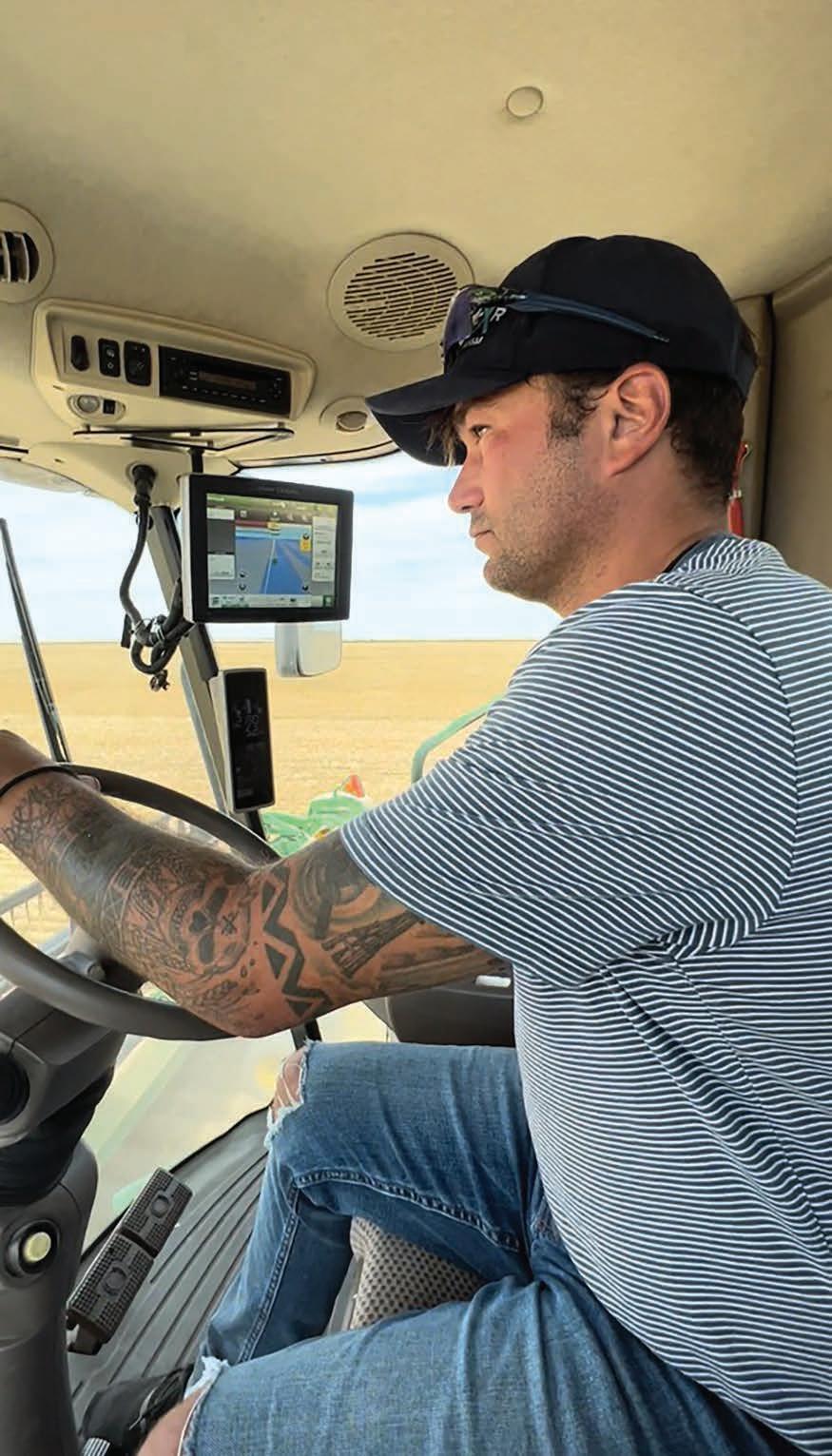
POSTED WITH PERMISSION. COPYRIGHT © 2022 LEADERS MAGAZINE, LLC LEADERS79 VOLUME 45, NUMBER 4
Stefan Soloviev driving a combine on one of the company’s 500,000 acres
fought the scrapping of the line in Washington D.C. before the Surface Transportation Board, and I won the right to purchase the line after a five-year battle.
Our Colorado Pacific Railroad and the silos and grain elevators we are building will allow us to efficiently move the grain 120 miles west from the Kansas/Colorado line close to Pueblo, Colorado, where it will be handed off to Union Pacific and Burlington Northern for transport. Grain leaving on our Colorado Pacific Railroad will only be through unit trains, which are 110-car trains. This is the cheapest way to ship grain and, with our direct shot West, it will hopefully benefit the farmers in the area in terms of storage and logistics so in the end they get more money for their crops.

You also are very involved in renewable energy. Will you discuss this focus?
Outside of Austin, Texas, my company put together wind leases on a huge ridge and ended up selling the project to a large French company. All of our farmland is in the windiest part of the U.S., and there have already been several wind turbines built on our farmland in New Mexico. We look to continuing to be involved in the construction of thousands of turbines on our farmland in Colorado and New Mexico over the next 10 years, and we are working with
and partnering with some of the biggest wind companies in the world.
You recently sold Soloviev’s residential property portfolio in New York City for $1.75 billion. Are more sales of New York real estate to come?

No, we have no other sales on the horizon, Unfortunately, there was zero financial planning that went into my father’s estate. It left me with a tax burden off the bat and, though there were other ways to pay it off, the sale of the New York property seemed to be the correct move. We look at each transaction on its individual merits. Having worked on the residential side of the business for many years, this transaction made very good economic sense in a very good residential market.
In addition to our New York City real estate holdings, I acquired about 1,000 acres on the North Fork of Long Island at a very opportune time, just prior to COVID. We have established substantial farmland there as well as a very popular winery, growing grapes on more than 200 acres. On the South Fork of Long Island, we have additional farmland currently planted with peaches and landscape material as well as a hotel, a marina, and restaurants on Shelter Island. We restored the historic Chequit Inn on Shelter Island as well as owning Jack’s Marina there. We also own Santa’s Christmas Tree Farm located on some of our North Fork farmland. My ex-wife Stacey runs the hospitality division on the North Fork.
What do you plan to do with the money from the sale of the residential properties?
I am 47 years old and feel like I have a lot more to accomplish, particularly in the areas in which I have worked and succeeded all of my life. My agribusiness will continue to grow and thrive through this environment. Sustainability and the environment supported by technology are other areas in which we are interested. We have some big plans I can talk more about in the future.
We are looking at expanding the agriculture side of the business in areas from fertilizer businesses, to starting a fourth massive farming region, to initiatives to promote food security such as hydroponic farming and addressing water shortage issues. We are in the planning stages for one of the largest hydroponic farms in the world in Quebec as well as other
A locomotive of the Soloviev Group-owned Colorado Pacific Railroad, used to transport grain from Kansas and Colorado farms to the major markets
POSTED WITH PERMISSION. COPYRIGHT © 2022 LEADERS MAGAZINE, LLC LEADERS 80 VOLUME 45, NUMBER 4
A Soloviev grain silo, part of the company’s sophisticated logistics network
Canadian agriculture investments. This works well because 11 of my children are dual citizens in the U.S. and Canada because their mom, Stacey, is Canadian.
With the drought conditions in the West, we are also looking into desalinization and other ways to deal with the water issues there to make it a greener planet. Agriculture and commodities trading, which end up going handin-hand, are my two passions.
How would you describe your management style?
Very much hands-on, whether in the fields, checking on our wheat crops, or personally dealing with tenant issues in New York, where obviously we are still very active. I travel a lot, trying to stay close to the agribusiness. There isn’t an acre we own where I don’t know what is being done on that acre, be it growing crops, grazing cattle, or harvesting energy from wind turbines and solar fields. I live for making every acre I have as profitable as it can be and getting the land paid off as soon as possible. This summer, on some of my fields, I currently have over $700 worth of crops sitting on acres for which I paid $250. I’ve built a one-of-a-kind company. We have a lot more gaps to fill to be the first-ever, vertically integrated agribusiness in the world –from seed, to harvest, to storage, to rail, to port,
to vessel, to end user, no matter where that end user is in the world. I am on the road almost a third of the time and as I am raising my two-year-old twin boys myself, I am looking to cutting that back to once a month.
With all that is on your plate, how do you manage your time, particularly with a large family?
Obviously, it is not easy. Balancing work and family is always a challenge. I learned through my own childhood experiences what to do and what not to do. Maintaining a strong and loving relationship with my children is the most important thing in the world to me. They come first and always will. Having said that, and as you can imagine, I don’t get much sleep, especially when I go through streaks on the commodity market which can last as long as six months in a row. I cannot take my eyes off the market unless the market is closed, which is not a complaint as I love what I do and my family gives me energy to do what is necessary.
You are involved in a variety of philanthropic work. Will you highlight this passion?
We have a very well-endowed foundation and give to numerous charities, primarily involving under-privileged kids and disabled and other veterans, and have also established
a Center for Ethics and Social Responsibility at Marymount University in Virginia. Given my Swedish and also Eastern European heritage and my great-grandmother actually being Ukrainian, we are very involved with Americares, which is providing badly needed support to the more than 6.6 million Ukrainians who have fled, all searching for safety from violence and destruction. By the way, our family name was originally Soloviev but was changed first in France and then Anglicized to Solow when my greatgrandfather arrived through Ellis Island. I have returned to the original family name and am particularly proud to do so.
One other important thing we are going to do in the near future is to make my father’s incredible art collection available to the public. The public will be able to see the entire collection for the first time, including works of van Gogh, Matisse, Modigliani Miró, and Basquiat, among others.
What are some of your initiatives with children?
I am especially proud of my work at Sutter Hospital in Sacramento. Sacramento changed my life in many ways during my time out West. I have 13 kids who live in or were born in Sacramento, and 2 of them were born very prematurely. I would go out to the hospital for the five months they spent there. The Sutter staff, nurses, and doctors were amazing and even saved my son’s life on one occasion. I am most proud of helping their NICU, and it’s now named the Soloviev NICU. I am also especially excited about a program we have with the Vatican to work with under-privileged children to teach them values through sports. In addition to this, we support St Luke’s Hospital for Children and a number of New York-based children’s charities.
What has been the experience having 22 children?
Well, I married quite young and my former wife, who I am still close to and work with on various projects, had quadruplets and two sets of twins, so I got off to a rapid start. I live with five of my children, ranging in age from 2 to 19, fulltime in Florida now. I stay close to the others, whom I am pleased to say are doing quite well in a variety of careers which I support. My daughter is an EMT for the FDNY. My son is a full-time student at NYU. One of my older sons lives with me and shadows me on a daily workday basis, be it going to one of our offices or traveling with me to the various places where we have business.
What led you to getting tattoos?
They reflect various times of my life, my children, and places that have influenced me during my time out West.

What advice do you offer to those who have inherited significant wealth?
For those with significant inherited wealth –if you are happy with your family business, great, but if not, find your own way, even if it means not having security and a lot of money. You only live once; don’t be a puppet. There are too many heirs that are just puppets and that is no way to live. That’s a waste of life.•
POSTED WITH PERMISSION. COPYRIGHT © 2022 LEADERS MAGAZINE, LLC LEADERS81 VOLUME 45, NUMBER 4
The historic Chequit Inn on Shelter Island, New York, which was restored by Soloviev Group
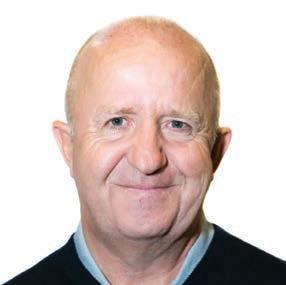
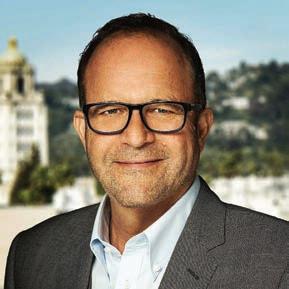






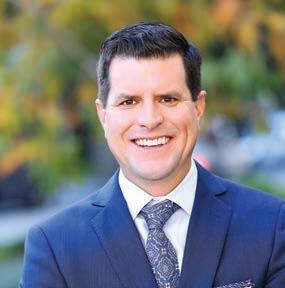

ALISTAIR BROWN ORLANDO, FL alistair@abire.co.uk
SAN FRANCISCO BAY AREA amy@realm-global.com
WILSON WASHINGTON, DC jeff.wilson@sir.com
RICHARDSON SAN LUIS OBISPO, CA chris@richardsonproperties.com MATT & JULIE FAUPEL JACKSON HOLE, WY matt.faupel@compass.com julie.faupel@compass.com
VAIL, CO tye.stockton@compass.com MONICA MONSON SCOTTSDALE, AZ monica.monson@thenobleagency.com GARY GOLD LOS ANGELES, CA gary@soldbygold.net NANCY HOWZE SAN MIGUEL DE ALLENDE, MEXICO nancyhowze@cdrsanmiguel.com
DANVILLE, CA jim@jimwalberg.com
AMY MITTLEMANN
JEFF
CHRIS
TYE STOCKTON
JIM WALBERG


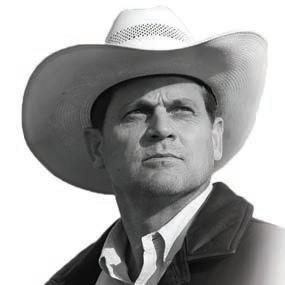




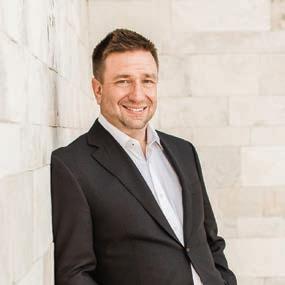



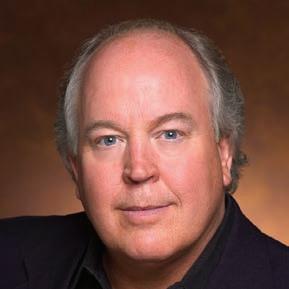

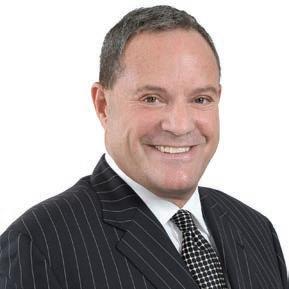

REALM-GLOBAL.COM
SAN MIGUEL DE ALLENDE, MEXICO jimdolan@cdrsanmiguel.com
DIGIOVANNA SANTA FE, NM joan@kempfintl.com
KENNEDY SUDDUTH BOSTON, MA realm@landvest.com
BENSON PARK CITY, UT paul.benson@engelvoelkers.com MACK MENDENHALL JACKSON HOLE, WY mack.mendenhall@compass.com
SPRAGUE LAKE OSWEGO, OR terry@luxeoregon.com RICK JANSON DENVER, CO richard.janson@exprealty.com TONI HABER NEW YORK, NY toni@compass.com PETER KEMPF SANTA FE, NM peter@kempfintl.com
SILVER TORONTO, ON rsilver@sothebysrealty.ca KAREN TERRA JACKSON HOLE, WY karen.terra@compass.com BRENNAN BUCKLEY NORWALK, IA casabuckley@gmail.com
ABERNATHY ASPEN, CO aabernethy@sliferrfv.com BERNIE UECHTRITZ DALLAS, TX bu@icon.global ANN DOLAN SAN MIGUEL DE ALLENDE, MEXICO anndolan@cdrsanmiguel.com
JIM DOLAN
JOAN
RUTH
PAUL
TERRY
RICHARD
ANN






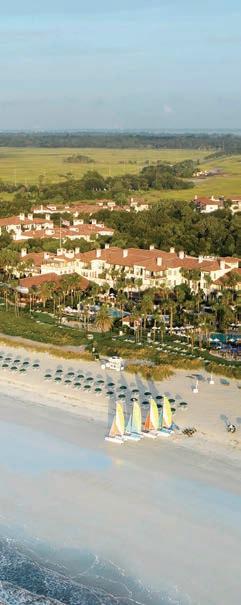

 BENTLEY RESIDENCES
SUNNY ISLES BEACH FIN GRAND CAYMAN OIL NUT BAY BRITISH VIRGIN ISLANDS
SILVERSANDS GRENADA
THE RESERVE SEA ISLAND SEA ISLAND, GA
THE RESIDENCES AT MANDARIN ORIENTAL GRAND CAYMAN
VICTORY RANCH UTAH THE TOWERS OF THE WALDORF ASTORIA NEW YORK
RITZ-CARLTON PORTLAND, OR
BENTLEY RESIDENCES
SUNNY ISLES BEACH FIN GRAND CAYMAN OIL NUT BAY BRITISH VIRGIN ISLANDS
SILVERSANDS GRENADA
THE RESERVE SEA ISLAND SEA ISLAND, GA
THE RESIDENCES AT MANDARIN ORIENTAL GRAND CAYMAN
VICTORY RANCH UTAH THE TOWERS OF THE WALDORF ASTORIA NEW YORK
RITZ-CARLTON PORTLAND, OR
Rural Healthcare
EDITORS’ NOTE Walter Panzirer is a grandson of Leona Helmsley. Raised in California, he adopted South Dakota as his home. Having worked as a first responder in both states, he witnessed personally the significant disparities in quality healthcare available close to home – disparities that demanded attention. Serving as a paramedic, firefighter, and police officer also made him acutely aware of the range of situations encountered by these professionals – from cardiac and stroke events to individuals facing a mental health crisis. Upon the death of his grandmother, he was, to his great surprise, named a Trustee of the Helmsley Charitable Trust. He realized the opportunity for investing in better healthcare for Americans in rural communities as well as for supporting communities across rural Africa to build resilience. A passionate advocate for telehealth, Panzirer is committed to shortening the distance between a medical emergency and life-saving treatment, including outfitting first responders with modern equipment for managing emergencies. An inductee to American Telehealth Association’s College of Fellows as well as the South Dakota Hall of Fame, he has served on a number of nonprofit and educational boards. He, his wife, and their family own and operate a hunting lodge in rural South Dakota and multiple commercial properties. Panzirer studied business and history at Black Hills State University, and pursued pastoral studies at MidAmerica Nazarene University.
TRUST BRIEF The Leona M. and Harry B. Helmsley Charitable Trust (helmsleytrust.org) aspires to improve lives by supporting exceptional efforts in the U.S. and around the world in health and select place-based initiatives. Since beginning active grantmaking in 2008, the Trust has committed more than $3.5 billion for a wide range of charitable purposes. Helmsley’s Rural Healthcare Program funds innovative projects that use information technologies to connect rural patients to emergency medical care, bring the latest medical therapies to patients in remote areas, and provide state-of-the-art training for rural hospitals and EMS personnel. To date, this program has awarded more than $600 million to organizations and initiatives in the states of North Dakota, South Dakota, Nebraska, Wyoming, Minnesota, Iowa, Nevada, and Montana.
The Helmsley Charitable Trust started active grantmaking in 2008, soon after the passing of my grandmother, Leona Helmsley, in mid-2007. At the time, I was living in South Dakota, serving my community as a sheriff and living a simple, quiet life with my young family. While processing the loss of my grandmother, I learned that she’d left just about everything to the Trust for charitable purposes and had named me as one of five Trustees to figure out what that would mean in practice.
Like John D. Rockefeller and Edsel Ford before her, my grandmother left no specific instructions for how we should direct the Trust’s funds, only a general direction to benefit humanity. It was the opportunity of a lifetime, and also a bit daunting – the four other Trustees and I needed to figure out a strategy, and it’s worth noting that collectively we had exactly zero experience in philanthropy.
I thought we should look at how my grandparents had directed their charitable giving during their lifetimes. One theme that emerged was healthcare, and that really resonated with me. From there, each Trustee made a case for why we should invest in certain areas. I knew that I wanted to start a program to help improve healthcare in rural communities because I’d been a first responder in California’s Bay Area and in South Dakota, and the difference in access to care just floored me and wasn’t right.
I will always hold the conviction that where you live should not dictate the kind of care you can receive. I also knew that to have an impact we’d need to focus on a specific geographic area. I had a hunch that would be the deep South, but I wanted Helmsley to be a philanthropy that made data-informed decisions, so I asked Rockefeller Philanthropy Advisors to do some analysis about where needs were the greatest.
I was surprised when they reported that the rural, Upper Midwest received the smallest percentage of philanthropic funding for healthcare compared to every other region – and the majority of what did flow in went to the Mayo Clinic in Minnesota. So, it was a very easy


decision to build a rural healthcare program that initially focused on South Dakota, North Dakota, Iowa, Nebraska, Minnesota, Montana, and Wyoming. In 2021, we expanded to Nevada.
It was easy for my brother, David, to offer an area for focus. As he’ll tell you, his oldest daughter was diagnosed with Type 1 diabetes just a few months before our grandmother passed. When he was named a Trustee, he took it as a very clear sign and proposed that the Trust start a Type 1 Diabetes Program, which we did.
Our other programs include Crohn’s Disease, Israel, Vulnerable Children in Sub-Saharan Africa, and New York City. Today, more than 90 percent of our grantmaking is directed to support health in some way.
How do you focus your efforts as a Trustee of the Helmsley Charitable Trust?
It’s all about impact, and for me, that means how we can help save lives. To do this, I’m focused on closing the gap in access to healthcare and emergency treatments available in rural compared to urban communities. I want everyone to have top care close to home, so I spend a lot of time going out to communities, talking with people on the front lines, and asking a lot of questions to understand what can make a difference for them.
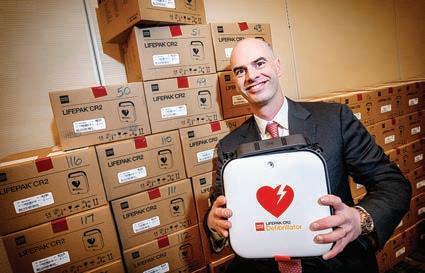
Will you highlight the Helmsley Charitable Trust’s initiatives in its work on rural healthcare?
Helmsley’s Rural Healthcare Program has evolved since our earliest days. A great example is telemedicine and virtual care; it seems everyone is adopting this technology today due to the pandemic, but that wasn’t the case early on. In the first years of the Helmsley Charitable Trust, we made significant investments in telehealth through Avera, which is now Avel eCare, and developed what became the gold standard of telemedicine delivery that I believe virtually all others in the space now emulate.
We’ve worked with hundreds of hospitals on equipment upgrades to help modernize care in the region because, in this century, nobody should get an x-ray on a machine from the 60s. We also believe that nobody should have to travel hours for treatment or care, which is why we’ve reached out to small hospitals in fairly remote communities to see about outfitting them with radiology
PURPOSE
Will you highlight the history of the Helmsley Charitable Trust and its mission?
Walter Panzirer preparing to distribute AEDs to first responders in Montana
An Interview with Walter Panzirer, Trustee, The Leona M. and Harry B. Helmsley Charitable Trust
POSTED WITH PERMISSION. COPYRIGHT © 2022 LEADERS MAGAZINE, LLC LEADERS 86 VOLUME 45, NUMBER 4
Walter Panzirer
technology to support CT scans. We did the same thing with mammography so that women could get screenings closer to home. We knew that making it easy would make it happen and that would save lives. We supported oncology services in counties that didn’t have them, and the same with cardiac care. Cody Regional Hospital in Wyoming became home to the first catheterization lab in the state with Helmsley support.
Starting around 2018, we began looking at ways to respond to the mental health crisis that is particularly acute in rural communities, where 60 percent of people live without access to behavioral care and there’s one psychiatrist for every 30,000 people.
We’ve made a number of investments, and I’m particularly excited about Virtual Crisis Care (VCC), which we piloted in South Dakota and more recently launched in Nevada. It equips law enforcement officers with tablets that connect to psychiatric telehealthcare. I can tell you that responding to calls when someone is in crisis is incredibly challenging and in far too many cases people end up in jail where they don’t belong. A mental health emergency is the only medical condition I know of that can land someone in jail. Think about that. It’s an awful outcome in so many ways. Now, with the touch of a screen, an officer can link someone in crisis to a trained professional who can talk with them, assess how best to help, and provide follow up recommendations. We supported the Crime and Justice Institute to evaluate the program in South Dakota, and learned that eight of every ten people who used VCC were successfully diverted from involuntary hospitalization or jail. It also eases pressure on emergency rooms which are often ill-equipped to support mental health crises. That’s a significant improvement in getting people the care they need and deserve closer to home. We expect similar success with the program in Nevada and now other states are looking to replicate these initiatives.
What do you see as the keys to driving lasting change in addressing the significant disparities in quality healthcare?
The key is meeting people where they are. It ultimately doesn’t matter what my team or I think could be beneficial – if a potential grantee doesn’t really want it for themselves there will be no change, let alone lasting change. That said, I’ve also learned that some places have been neglected for so long and people there never think about having something better, so helping them understand what’s possible is revelatory and really inspiring. When they understand we are for real, that we care, and that we’ll be a partner, they start to get excited – that’s a sign that we can have a lasting impact.
How has your time working as a first responder influenced your views on healthcare disparities and the need to become involved in this issue?
My time working as a first responder completely influenced my outlook as a grantmaker, especially having had the experience
of serving in that role in both urban and rural communities. There’s not just the difference in what hospitals can offer, which is significant, there’s what’s available to communities outside of the hospital. Here’s one example: When someone is in cardiac arrest and a 10-minute drive to a hospital, that person has a significantly better chance of a good outcome than when there’s a 60-minute drive. So that’s one reason why it’s vital for law enforcement in rural areas to have modern AEDs in their cars, because they are often the first ones on the scene, usually before an ambulance. We’ve made the latest technology with connected device AEDs available to every law enforcement officer in our eight-state region. All in, that’s nearly 25,000 AEDs and a $60 million investment from Helmsley. These AEDs will help first responders save countless lives. We’ve also equipped ambulances in that same footprint with LUCAS devices which are machines that can perform chest compressions and help people stay alive on long drives to a hospital. Helmsley’s AED and LUCAS initiatives are just two of our many programs that strive to improve the survivability of cardiac patients by providing the best technology through the entire continuum of care.
are high. There’s no end to the possibilities that telehealth offers. Now the challenge is to make sure that it’s done right and that there are quality assurances in place, just like in every other aspect of healthcare. We’re supporting Avera, which really pioneered telehealth, and Harvard Medical School to develop standards around that.
How critical are metrics to measure the impact of the Helmsley Charitable Trust’s programs?
Very, although our metrics aren’t always traditional. For instance, at least once a month I learn about a life saved through our AED initiative. Each time it affirms that the initiative is having an amazing impact. It’s an easy-to-measure, easy-tounderstand, clear-cut metric. The peace of mind that these AEDs give to first responders is harder to measure, yet the mental shift for every one of them, knowing that they are better equipped for a positive outcome in a life-or-death situation, is invaluable and has a massive impact on its own. Similarly, for communities to know that the equipment is there signals that others care about them. That has to have an impact, too.
We have to take both a short- and longterm view when looking at metrics and impact. I am driven by urgency – that gets wired in you as a first responder – and at the same time, I know that most change takes time.
I’m also acutely aware of the countless responsibilities that law enforcement has. We ask so much of our officers, yet don’t often think about what they need to succeed. AEDs help, and so do initiatives like Virtual Crisis Care. As in all things, we need to make sure we’re taking care of the people who take care of us.
You are a passionate advocate for telehealth. What do you see as the role of telehealth in the future of healthcare?
Telehealth is the future of healthcare. We knew this more than a decade ago when we started investing in it, and then everyone else caught on early in the pandemic. For individuals, it greatly accelerates access for those who live far from specialty care. For hospitals, it connects them with services that they can’t always staff 24/7, like e-pharmacy and emergency care. Even in places like New York, Helmsley is supporting telepsychiatric care in shelters where we know mental health needs
I also pay close attention to our internal metrics. Helmsley’s ability to drive impact externally depends on how we are doing internally. I’m really proud that in our second decade, with an endowment of more than $8 billion, Helmsley has managed to stay small in terms of staff size because as our endowment grew, we’ve focused on deepening support to our existing programs rather than starting new ones. We are now around 100 people, and half have been with us for more than five years. These metrics – size, retention, focus –mean that we know our employees, they know each other, and we all share a strong commitment to collaborating in service of our mission. Tools like employee engagement surveys also offer useful metrics for better understanding our strengths and what we might need to change. Especially these days, with burnout across industries because of the pandemic and so much competition for top talent, it’s more important than ever to be attentive internally.
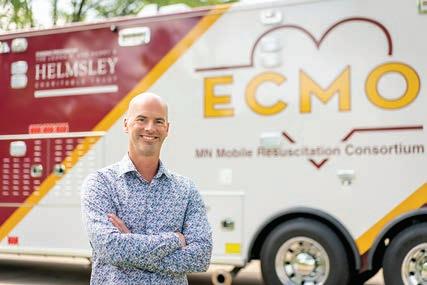
What are your priorities for Helmsley Charitable Trust’s work in addressing rural healthcare as you look to the future?
We are just getting started in our mental health investments. We are facing a national crisis. The next wave of the pandemic is the mental health fallout, particularly among children and teens – even more so for the 200,000 who lost a parent or caregiver to COVID. We are listening and learning to determine how we can have the greatest impact. We’ve also been exploring the role that remote, robotic surgery might play in extending specialty surgical care in rural communities. You see the theme here – the constant for me is always finding new ways to support quality healthcare close to home, no matter where that is.•
POSTED WITH PERMISSION. COPYRIGHT © 2022 LEADERS MAGAZINE, LLC LEADERS87 VOLUME 45, NUMBER 4
Panzirer in front of the ECMO-equipped truck, a first in the world mobile unit, based in the Twin Cities metropolitan area and opening a new frontier in cardiac arrest care. An $18.6 million grant from Helmsley made this a reality. The first cannulation took place in July, and represents a coordination across multiple health systems through the Minnesota Mobile Resuscitation Consortium.
Building Healthier and More Just Futures
The idea for KYRC was conceived in late2015 shortly after what I describe as the public lynching of Mario Woods. Woods, who was 26-years-old at the time, was murdered by five San Francisco police officers just a few blocks from Candlestick Park, the former home of the 49ers. Woods’ killing hit me hard. I was born only a few years before him. I felt angry and a deep sense of loss.
Prison abolitionist organizer, Mariame Kaba, once said that we should allow moments like these – heavy moments, tragic moments – to radicalize us rather than lead us to despair. I think a lot about this idea, as it helps to explain the impetus behind KYRC.
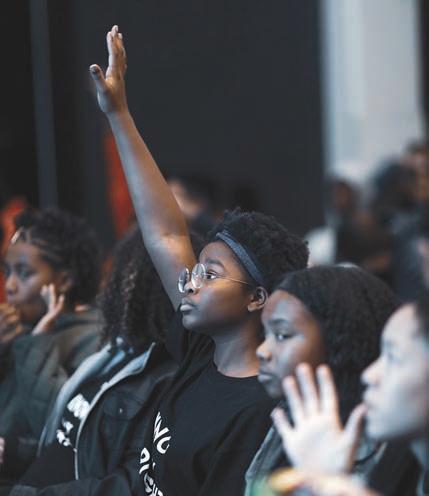

Will you provide an overview of Know Your Rights Camp’s work and programs?
EDITORS’ NOTE Super Bowl QB Colin Kaepernick, and holder of the all-time NFL record for most rushing yards in a game by a quarterback, took a knee during the playing of “The Star Spangled Banner” in 2016 to bring attention to systemic oppressions against Black and Brown people. Since 2016, he has founded and helped to fund three organizations – Know Your Rights Camp (KYRC), Ra Vision Media, and Kaepernick Publishing –that together advance the liberation of Black and Brown people through storytelling, systems change, and political education. Know Your Rights Camp is a fund of the Entertainment Industry Foundation (EIF), a 501(c)(3) tax-exempt organization. EIF is a Charity Navigator 4 Star Charity that meets all 20 BBB Charity Standards and carries the Candid Platinum Seal of Transparency. Kaepernick sits on Medium’s Board and is the winner of numerous prestigious honors including Amnesty International’s Ambassador of Conscience Award, the Robert F. Kennedy Human Rights Ripple of Hope honor, GQ magazine’s “Citizen of the Year,” the NFL’s Len Eshmont Award, the Sports

Illustrated Muhammad Ali Legacy Award, the ACLU’s Eason Monroe Courageous Advocate Award, and the Puffin/Nation Institute’s Prize for Creative Citizenship. In 2019, Kaepernick helped Nike win an Emmy for its “Dream Crazy’’ commercial. In 2021, he released “Colin in Black & White,” a six-episode limited series on Netflix exploring his high school years. The show won two NAACP Image Awards. In 2022, he became a New York Times bestselling author for his acclaimed children’s picture book, I Color Myself Different
KYRC provides young people with community-based legal, cultural, and political resources to fight back against what I view as systemic oppression, police terrorism, and racial inequality, and to build healthier and more just futures. I intentionally use the term “police terrorism” over the more mainstream phrasing of “police brutality” because the latter implies that brutality is peripheral – not central – to its central function whereas the former situates terroristic violence as core to policing as a practice of racial control and discipline.
Know Your Rights Camp (KYRC) is about connecting the past to the present and the future through programming that empowers young people to be their best and highest selves. Our mission is to advance the liberation and well-being of Black and Brown communities through education, self-empowerment, mass-mobilization and the creation of new systems that elevate the next generation of change leaders.
PURPOSE
What was the vision for creating Know Your Rights Camp and how do you define its mission?
Colin Kaepernick speaking at a Know Your Rights Camp
An Interview with Colin Kaepernick, Founder, Know Your Rights Camp
POSTED WITH PERMISSION. COPYRIGHT © 2022 LEADERS MAGAZINE, LLC LEADERS 88 VOLUME 45, NUMBER 4
Youth participants at a Know Your Rights Camp
Our signature program-area is our traveling, day-long and site-based camp. We hosted our first camp in Oakland, California on October 29, 2016. Since then, we’ve organized eight additional camps with our most recent being in Las Vegas on March 23, 2022. Camp participation has ranged from 100 to 450 youth attendees. Each day is full of workshops partitioned into different subject areas like “Know Your History,” “Know Your Legal Rights,” “Tech,” “Art,” “Self-Empowerment,” and beyond. The day is high-energy, participatory, and inspiring. Our curriculum is presented by local community leaders in partnership with our core staff.
Our work, however, doesn’t end with our camps. Over the last several years we’ve launched and maintained a number of survival programs focused on providing immediate relief to our most vulnerable communities. Since January 2020, we have issued over $2.5 million through partnerships and collaborative grants to Black- and Brown-led organizations and communities. From our COVID-19 Relief Fund to our Legal Defense Initiative to our Autopsy Initiative to our Revolving Bail Funds partnership with Robert F. Kennedy Human Rights, we have stepped up as frontline defenders of Black and Brown communities disproportionately impacted by COVID-19, police terrorism and economic devastation.
How critical are metrics to track the impact of Know Your Rights Camp’s work? Metrics will always be critical to our work. At the same time, we know metrics and other

assessment mechanisms are only as valuable as the principles to which they’re anchored. We, of course, use traditional metrics to measure the impact of our work (i.e.: total grant dollars, in-kind donations, and youth served, just to name a few). We’re equally as interested in applying holistic, humanizing, qualitative assessments to our curriculum and strategic programming areas that can give us a more well-rounded window into how our campers are transforming their lives and communities for the better. We also use qualitative metrics to understand the extent to which our political education curriculum provides the foundation for self-discovery, intellectual risktaking, and community-building.
What are your priorities for Know Your Rights Camp as you look to the future?
To increase the reach of our current programs and to launch additional initiatives in the coming year, we look forward to substantially amplifying our fundraising efforts in 2023. These efforts will be key as we plan to increase the frequency of our camps – we’ll be hosting three next year – and to launch a free KYRC app whose signature feature allows users to easily search for their legal rights on a state-bystate basis matrixed against various scenarios with cops (i.e.: traffic stops, protesting, etc.).
We’re excited about the year ahead and look forward to continuing to advance the liberation and well-being of Black and Brown communities by any means necessary.•
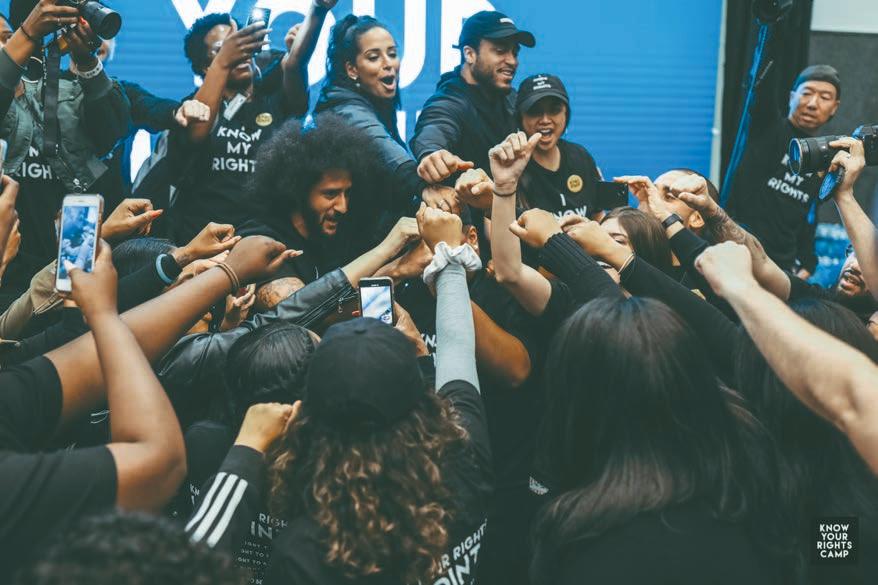
“Our mission is to advance the liberation and well-being of Black and Brown communities through education, self-empowerment, mass-mobilization and the creation of new systems that elevate the next generation of change leaders.”
A youth participant on stage at a Know Your Rights Camp
POSTED WITH PERMISSION. COPYRIGHT © 2022 LEADERS MAGAZINE, LLC LEADERS89 VOLUME 45, NUMBER 4
Volunteer staff celebrate after another successful camp
An Economic Value Fix
EDITORS’ NOTE As Executive Vice President and Chief Financial Officer, Clarence Lee is involved in all aspects of ICON’s business. Lee began his career as an analyst, keen on numbers and having an uncanny ability to identify problems or irregularities. During a stint at the metals trading division of Continental Grain, for example, he discovered several irregularities –enough so that he wound up closing the very division that had hired him. From there, Lee moved on to the position of Chief Financial Officer of Conti Milling, an international animal-feed and flour-milling operation, where he became one of the company’s leading experts in commodities trading which led to an assignment with the foreignexchange, government securities and merchant bank group – Conti Financial. Later, Lee joined ICD Group, a petrochemicals group operating out of the former Soviet Union, which grew from $500 million in sales to about $50 billion in 18 months. Eventually, Lee ran into ICON founder, and college friend from Yale, Lance Lundberg, at a social function. He suggested Lee meet with ICON chief executive officer John Kramer, which led to his joining ICON. Lee earned a BA degree in economics from Yale University.
COMPANY BRIEF Founded in 1986, ICON International (icon-intl.com) is a specialized finance company engaged in corporate barter to help companies restore value to underperforming assets and fund corporate expenses. For
30 years, ICON has created customized barter transactions that deliver value at every stage. ICON was first to market, offering cash as payment in a barter transaction, also known as a Vendor Subscription Agreement, in 2001. Recently, the company was issued a U.S. Patent for the invention of the cash-trade transaction. ICON is the only corporate trade company to hold any intellectual rights patents.
Will you discuss the history of ICON?
ICON was founded in 1986 by Lance Lundberg. Lance left the company in 1999 and the company has been managed by me and John Kramer since. In 2001, we sold 51 percent of ICON to Omnicom Media Group, and sold the remaining 49 percent in 2004. John and I ran ICON through June 10, 2021, and we purchased ICON back from Omnicom on that date. John and I own ICON 50-50.

How do you define ICON’s culture?
ICON has been named best company to work for in Connecticut in our size category for 12-13 years in a row. The company has paid bonuses and raises virtually every year since 1998 and more than 60 percent of our employees have been with ICON for 10 years or more with 40 percent being here 15 years or more. The work culture is flat and we empower employees with the responsibility to do their jobs and the authority to make their own decisions. While John and I manage all aspects of the business, we set plans and empower employees to operate their work areas.
We constantly hear from clients that “it is obvious you all love each other like we have never seen in any business.” While we are friends, we are all able to be blunt and honest with each other, and we have mostly type-A employees who are focused on profitability and client service and very little else.

Will you provide an overview of ICON’s services and solutions?
ICON is a barter company. We don’t run away from the word “barter” – we are proud to provide barter services despite the name having a dubious reputation from others. We have always held our heads high, performed with the upmost integrity, and run our business as if we were a public company throughout our private and public existence. ICON’s services and solutions consist of the following:
Trade credits: the right, but not the obligation, to purchase goods and services from ICON. Trade credits are used as a form of payment for the purchase of assets from companies that they deem excess, obsolete, have lost some amount of their economic value, or are not strategic to their operations. We have purchased everything you can think of during our 36 years, including Porta Potties.
Cash used as another barter form of payment: We invented and have a patent on cash-barter. Cash requires our customer to purchase goods and services from ICON (trade credit is a right, but not an obligation). We have significant capital to engage in barter transactions for all cash. ICON is the largest, financially strong, and best barter company worldwide. Our cash product is the cornerstone of this statement.
PURPOSE
Clarence V. Lee III
An Interview with Clarence V. Lee III, Executive Vice President and Chief Financial Officer, ICON International, Inc.
POSTED WITH PERMISSION. COPYRIGHT © 2022 LEADERS MAGAZINE, LLC LEADERS 90 VOLUME 45, NUMBER 4
“We have significant capital to engage in barter transactions for all cash. ICON is the largest, financially strong, and best barter company worldwide. Our cash product is the cornerstone of this statement.”
Fulfillment services: We provide all forms of media advertising and other forms of fulfillment including freight, logistics, printing, displays, packaging, sustainability, retail store construction, travel and meeting services.
Form of payment: We assist our clients in transferring trade credit to their vendors who can demonstrate their ability to redeem the trade credit as partial payment for goods and services purchased.
Will you tell some of the client success stories which show the power and impact of ICON’s offerings?
ICON has over 350 customers and delivers annually approximately $2 billion of media advertising on behalf of these customers. Customers are in just about every industry. For example:
A large pharmaceutical company owns excess real estate with a book value of $30 million. ICON purchased the production facility and office building in the Northeast for book value of $30 million in cash. Over a three-year period, ICON executed the pharma company’s media advertising as planned and priced by their media advertising agency. Total media delivery was approximately $200 million in all forms of media advertising.
A large fast-food restaurant created a new food product that didn’t not sell at their expectations and they had a large inventory of food ingredients with a book value of $10 million. ICON purchased the food (with short code) for $10 million cash. The food was sold by ICON to large food distributors. ICON executed $70 million of media advertising over the next two years. The
fast-food restaurant’s advertising agency worked with ICON’s media experts, allowing ICON to deliver flawlessly on their media plan.
An international cruise line sold ICON $20 million excess cruise cabins over one year. ICON paid the cruise line $20 million in ICON trade credit. The cabins were sold on the ICON closed-in website to employees of ICON’s customers and media vendors. The sale process protected the price list of the cruises but filled “heads in the beds.” The cruisers spent money on excursions, drink packages, etc. As the cruise line purchased media advertising and printing for direct-mail adverting campaigns, the price paid by the cruise line was reduced by the trade credit. ICON delivered approximately $125 million of services that cost the cruise line $105 million of cash and $20 million of trade credit. All services provided were at the cruise line’s best negotiated costs.
How do you describe the value of barter?
Barter is not an accounting fix; it is an economic value fix. It is one of the only classic win/win transactions that provides companies the opportunity to recover economic value for overvalued assets on their balance sheets to fund unbudgeted expenses, and to fund attempts at new marketing ideas. It is a huge benefit to procurement of all goods and services.
How do you focus your efforts leading ICON?
I am involved in all aspects of the business with an emphasis on the financial, finance, accounting, control, contracts and legal, IT and human resources of ICON. It may seem strange,
but I am the leading expert in accounting for barter transactions. I am also significantly involved in sales as barter is a financial transaction. I assist the sales department in structuring deals as they are formed and negotiated. I sign every contract as I am familiar with the entire structuring, financing, credit, and operations of our business.
Will you highlight ICON’s focus on building a diverse workforce?
We are focused on hiring experts in their field – media, accounting, procurement services, sales – and then take the time to teach them the business of barter. Over 55 percent of our employees are women. We have a culturally diverse group and have focused on diversity in our hiring practices since 1998.
How does ICON address corporate social responsibility?
We work with our clients on sustainability and the proper disposal of products being destroyed. We also support many causes, including Stamford Boys and Girls Club and Derek Jeter’s Turn 2 Foundation.
What are your priorities for ICON as you look to the future?
We are focused on putting capital to work through more deals with vendors and clients, as well as acquisitions of related businesses. We also want to expand non-media fulfillment services with new products and services, and expand “form of payment” assistance in procurement. It is also a priority to continue to make barter a more mainstream product that companies think of to solve problems, since ICON is comprised of creative problem-solvers.•
“Barter is not an accounting fix; it is an economic value fix. It is one of the only classic win/win transactions that provides companies the opportunity to recover economic value for overvalued assets on their balance sheets to fund unbudgeted expenses, and to fund attempts at new marketing ideas. It is a huge benefit to procurement of all goods and services.”
POSTED WITH PERMISSION. COPYRIGHT © 2022 LEADERS MAGAZINE, LLC LEADERS91 VOLUME 45, NUMBER 4
“It is also a priority to continue to make barter a more mainstream product that companies think of to solve problems, since ICON is comprised of creative problem-solvers.”








NEW YORK | OCTOBER
Wanderer, 1949 | oil on canvas | 50 x 59 3/4 in.
EXHIBITION ON VIEW
FINDLAY GALLERIES
Robert Richenburg
(1917 - 2006)
Robert Richenburg was an integral member of the Abstract Expressionist movement and was often well ahead of his time. He was celebrated for his relentless dedication to a creative process committed to pushing boundaries through constant experimentation.
Milestones



In 1951, he exhibited in the seminal 9th Street Exhibition, the formal debut for Abstract Expressionism. Important museum and gallery exhibitions followed around the country. In 1964, he was asked to resign his teaching position at the Pratt Institute for encouraging too much experimentation in his students’ work, freeing him creatively and leading to his tenure at Cornell University.

Critical Accolades
“One of the most forceful painters on the New York art scene.” – Art Critic Irving Sandler, 1961; “Ten years ahead of the vogue.” – Writer and collector James Michener, 1962.
Museum Collections
Chrysler Museum of Art (VA), Guild Hall Museum (NY), Heckscher Museum of Art (NY), Smithsonian Institute (DC), Museum of Modern Art (NY), Parrish Museum of Art (NY), Norton Simon Museum (CA), Philadelphia Museum of Art (PA), Pollock-Krasner House (NY), Whitney Museum of Art (NY).
In His Own Words
“Honest people, like honest pictures, have a look of strangeness when first encountered.”
Findlay Galleries has been the exclusive representative of Robert Richenburg and his estate since 2001.
Copyright © 2022, Findlay Galleries, All rights reserved. 165WORTHAVENUE , PALMBEACH
32EAST57 TH STREET , 2 ND
, FLORIDA33480 • (561) 655 2090
FLOOR , NEWYORK , NY10022 • (212) 421 5390
THREE CENTURIES IN ART
Guided by a Common Purpose
EDITORS’ NOTE Sheri Bronstein is the Chief Human Resources Officer for Bank of America and a member of the company’s executive management team. Bronstein joined Bank of America in 2000 and has held various roles supporting Global Markets, Global Investment Banking, and the international regions. Prior to joining Bank of America, she worked at JP Morgan in a variety of human resources capacities. Bronstein spearheads the company’s domestic violence awareness initiatives and is the executive sponsor for the company’s Domestic Violence Taskforce. As a champion of learning and development, Bronstein serves on the board of trustees of the Liberty Science Center and serves as the co-chair for the Board of Visitors for her alma mater, Colby College. Bronstein is also a representative on the newly launched New York Jobs CEO Council, responsible for facilitating training opportunities for New Yorkers, and is on the DE&I Advisory Council for OneTen, a coalition of leading companies who are coming together to train, hire, and advance one million Black Americans over the next 10 years into family-sustaining jobs with opportunities for advancement.
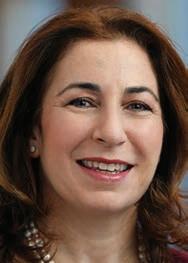
COMPANY BRIEF Bank of America (bankofamerica.com) is one of the world’s leading financial institutions, serving individual consumers, small and middle-market businesses, and large corporations with a full range of banking, investing, asset management, and other financial and risk management products and services. The company provides unmatched convenience in the United States, serving approximately 67 million consumer and small business clients with approximately 4,000 retail financial centers, approximately 16,000 ATMs, and award-winning digital banking with approximately 55 million verified digital users. Bank of America is a global leader in wealth management, corporate and investment banking, and trading across a broad range of asset classes, serving corporations, governments, institutions, and individuals around the world. Bank of America offers industry-leading support to approximately 3 million small business households through a suite of innovative, easy-touse online products and services. The company serves clients through operations across the United States, its territories and approximately 35 countries.
How do you describe Bank of America’s culture and how important is culture to the success of the company?
When Brian Moynihan became our CEO more than a decade ago, he set the company on a path of Responsible Growth, which remains true today. This starts by ensuring every employee understands that we are guided by a common purpose, to help make financial lives better through the power of every connection, and we drive Responsible Growth. That means that we must grow, no excuses, and do so in a way that is customerfocused, within our risk framework and sustainable.
One way we ensure our growth is sustainable is ensuring we are a great place to work for our teammates. We fulfill this commitment through our focus on being a diverse and inclusive workplace, attracting and developing talent, recognizing and rewarding performance, and supporting teammates’ physical, emotional, and financial wellness.
It is this relentless focus on growing responsibly while taking care of our employees around the globe that helps us consistently deliver for our customers and our communities. This framework defines how we run the company and make decisions. When we talk to our employees, our investors, and our stakeholders about our business, we talk consistently and specifically about how our outcomes and performance are rooted in Responsible Growth.
How do you define the role of Chief Human Resources Officer and how important is it for the role to be engaged in business strategy?
As a financial services company, our people are our greatest asset and directly tied to our ability to be able to deliver for our clients. The function that I lead is Global Human Resources and Enterprise Services, which includes everything you would expect in a human resources function, in addition to those areas that help support our employees such as food services and corporate travel. I think of my role in three parts – taking care of our people, taking care of our clients, and taking care of our company. Being a great
place to work and human capital management are not stand-alone activities; they are core to our ability to execute on the strategy of the company and deliver for our clients and shareholders.
First and foremost, we take care of our employees. When our employees have the tools and resources to manage their life and their career, they are able to better deliver for our clients. As we defined what it meant to be a great place to work, we made a shift in how we invested in our employees beyond just the traditional benefits and compensation. We increased our focus on overall wellness – we support physical, emotional, and financial well-being by enhancing and expanding our benefits to include broader coverage for things like mental healthcare for employees and their family members, tuition reimbursement, back-up care for both children and adults, and even discounts for pet insurance.
When we started our focus on physical wellness nearly a decade ago, we saw that when employees had more knowledge about their numbers through their annual health screening, they were able to catch health challenges earlier. And, as a self-insured company, this early detection helps not only our employees, but it also helps us as we manage healthcare expenses.
Second, we focus on taking care of our clients by ensuring that our businesses have the talent and skills they need to best serve them. Our focus on career growth and mobility is grounded in foundational, horizontal skills that can be applied to many roles to support our business strategy. We focus on career development for employees at key levels including managers, entry hires, new hires and emerging leaders. In 2021, we merged our Consumer Bank Academy with our Global Learning Organization to create The Academy at Bank of America, an onboarding, education, and professional development organization dedicated to the growth and success of 200,000+ teammates from consistent onboarding through senior skill building.
This horizontal focus on understanding the needs of each business and ensuring we can match resources allows us to quickly flex as business needs change. A great example of this was executing the Paycheck Protection Program (PPP) in the spring of 2020. We

PURPOSE
Sheri B. Bronstein
POSTED WITH PERMISSION. COPYRIGHT © 2022 LEADERS MAGAZINE, LLC LEADERS 94 VOLUME 45, NUMBER 4
An Interview with Sheri B. Bronstein, Chief Human Resources Officer, Bank of America
were able to quickly identify and shift 25,000 employees to process PPP loan applications through a combination of understanding our business needs and strategy, understanding our employee data, and quickly mobilizing training and skill building. You can’t execute that kind of change that quickly without being thoroughly embedded in the business strategy at every level of the company.
And finally, taking care of the company. A large part of my time is spent with our Management Team, Board of Directors, investors, and regulators to ensure strong governance and transparency. Over the last five years, we’ve seen a rise in investor interest on all aspects of ESG, including human capital management. My job is to ensure we have tight processes, strong governance, and clear disclosure and that we can tell the story of how being a great place to work drives our company performance; helps us deliver for our investors, clients, and communities; and provides fulfilling careers for our employees.
You mentioned the importance of mental health priorities and are responsible for driving Bank of America’s industryleading focus on emotional wellness. Will you discuss this effort?
Several years ago, as mental health concerns were on the rise around the world, we took an early lead as a company – focusing on how we could support employees and their families with these challenges. We launched an awareness campaign and began to enhance the dialogue on the importance of emotional and mental health with a goal to reduce the stigma in the workplace. We highlight programs in three broad categories, which have continued to expand, including external confidential counseling (in-person and virtual), resiliency training, and internal on-site counseling support in more than a dozen locations.
While this work started long before the pandemic, it has certainly become a much larger focus over the past two years as we are seeing the need for increased emotional wellness support. In that time, we have doubled the number of free face-to-face counseling sessions available to 12, for employees and their loved ones, through our Employee Assistance Program, with unlimited sessions by phone for the majority of our teammates. We have also added virtual access to licensed social workers and psychologists for youth aged 13-17 through Teladoc.
Employee feedback showed us that some were having trouble coping, so in addition to resource access, we have added daily mindfulness sessions to teach employees tips for coping, meditating, handling stress, and more. And, we recently announced a companywide sabbatical program for long-tenured employees to launch in 2023 – which both recognizes tenure and supports our focus on emotional wellness.
One of the things I think really sets us apart is how we care for employees in the
moments that really matter. Several years ago, we set up a Life Event Services team which is focused on providing one-to-one personal assistance to employees in those major life moments – going on maternity leave or returning from leave; managing a deployment for our military colleagues; experiencing a natural disaster; navigating the loss of a spouse or a child; or getting ready for retirement. We have an experienced team of case managers that help connect employees to the right resources and benefits to make these transitions easier to manage.
How critical is it for Bank of America to build a diverse and inclusive workforce to mirror the diversity of its customers and the communities it serves?
A key to our company’s success is having a diverse workforce that mirrors the clients we serve, and the communities we work in. We have had a long-standing commitment to diversity and inclusion that starts at the top with our CEO, Brian Moynihan, who chairs our Global Diversity and Inclusion Council. This is a group of senior leaders across all areas of the company who focus on how we are living up to this commitment and what more we can do.
We have also put processes in place around our D&I efforts to help promote transparency, accountability, and continued progress. In 2019, we published Bank of America’s inaugural Human Capital Management Report, setting an industry standard by providing a transparent, comprehensive view of the company’s workforce metrics. Providing this data holds us accountable to ensure progress continues. This is now published annually as part of the company’s Annual Report to provide regular transparency to our investors and stakeholders. We were able to create this report because we were already doing the work – we built robust analytics and put processes in place at all levels of the company to drive progress and accountability. In addition, we embed diverse representation into manager scorecards. We use third parties to validate equal pay for equal work. And, importantly, we ask our teammates every year to tell us how we are doing.
To further these efforts, our approach to sourcing talent is intentionally broad, casting a wide net to attract and hire talent – through campus recruiting and experienced candidates. Over the past five years, we have consciously expanded this pipeline through our Pathways program, where we have made a commitment to hire 25,000 individuals from low-to-moderate income communities by 2025. We have also made investments in local and national partnerships, such as OneTen, an initiative to hire, promote and advance 1 million Black individuals who do not have four-year college degrees into familysustaining careers. In addition, we have also expanded our recruiting from community colleges. These programs and partnerships help us build a strong, diverse talent pipeline through hiring and recruiting and continue
our ability to mirror the clients and communities we serve.
Do you feel that there are strong opportunities for women to grow and lead in the industry?
I have been in financial services for more than 25 years, and the opportunities for women in our industry have never been greater. This is a direct result of focus across the industry. For us, our “investing in women” strategy is a holistic and comprehensive approach to attract, develop, and advance women across our organization. We offer learning and development programs for our women leaders who show potential as future business and C-level executives, as we recognize that women often face unique barriers to career advancement. To align all of our women’s efforts, early in 2016, we formed our Investing in Women Leadership Council which is comprised of senior executives who champion efforts and provide strategic direction. The council helps to elevate, engage, empower, and enable women across all levels of our company. As a result, we have increased our representation of women in the top three management levels by 27 percent since 2015.
And extending this reach into the community, we recently expanded the Bank of America Institute for Women’s Entrepreneurship at Cornell, to provide 100,000 women an opportunity to participate in the only online Ivy League program offering a certificate in women’s entrepreneurship at no cost.
What advice do you offer to young people beginning their careers during this unprecedented time?
I always encourage our new hires to be curious and not to be afraid to ask questions. That was harder for those who started during the pandemic in a virtual setting, but now that we are back in the office, I encourage them to take advantage of the opportunity to connect in person and ask questions to really understand how and why the business operates the way it does. And, of course, I also encourage them to invest in their 401k early – never too early to understand the time value of money.
You joined Bank of America in 2000. What has made the experience so special for you?
Without a doubt, it has been the smart, talented people that I have had the good fortune to work with. If you think about financial services, and Bank of America in particular, over that period of time, it has been quite a ride. We had a number of acquisitions prior to 2010, went through the financial crisis, rebuilt our business and our brand following that crisis, and then navigated the global pandemic. Managing that kind of change in the industry, in our business, and at an employee level has required a tremendous amount of collaboration and teamwork, and I have been lucky to do it alongside fantastic leaders and under the steadfast leadership of our CEO, Brian Moynihan. •
POSTED WITH PERMISSION. COPYRIGHT © 2022 LEADERS MAGAZINE, LLC LEADERS95 VOLUME 45, NUMBER 4
A Platform of Purpose and Possibilities

EDITORS’ NOTE In 2017, Stephen Shaya, M.D. established his family office, Akkad Holdings, which focuses on healthcare investment opportunities. Since 2004, he has been the Executive Servant Leader at J&B Medical, a global healthcare solutions company. His role oversees all strategy, innovation, and growth for the company. He has received many recognitions including the 2015 Global Distinguished Healthcare Award from the Center of Economic and Leadership Development, and a United States Congressional Commendation. In 2017, Dr. Shaya was named the American Diabetes “Father of the Year.” Dr. Shaya spoke at the Vatican in 2018 on how leveraging technology could help extend care globally. He currently sits on a number of boards including as the Chairman of the American Diabetes Association in Michigan, Henry Ford Hospital (West Bloomfield) Board, and Velatura. Dr. Shaya graduated from Birmingham Brother Rice High School summa cum laude and was awarded a Merit Scholarship to attend Wayne State University. He attended Wayne State University Medical School and graduated in 1996. Dr. Shaya subsequently finished training in Family Practice at North Oakland Medical Center.

COMPANY BRIEFS Akkad Holdings is the family office of Stephen Shaya, M.D. The mantra of all of the activities of Akkad Holdings is “People. Purpose. Pay It Forward.”
J&B Medical (jandbmedical.com) is a privately-held global healthcare consortium based in Wixom, Michigan. Founded in 1996, J&B has 18 different business enterprises and has customers globally. The company has brought many new ideas and solutions forward to the delivery of care and continues to strive to improve patient access and quality.
How you define leadership and what are the qualities and characteristics that make an effective leader?
Leadership is about helping others grow themselves while providing a clear vision of what a collective effort can achieve. In these challenging times, leadership is more important than ever. One powerful quote from Ralph Waldo Emerson epitomizes my view of leadership – “Do not follow where the path may lead. Go instead where there is no path and leave a trail.”
Will you highlight the history of J&B Medical and how the company has evolved?
J&B started in 1996 as a traditional medical distribution company with a business-to-business model. We transformed into a data and global
healthcare solutions company leveraging technology and innovation. Today, we have numerous different business enterprises which run the gamut from medical distribution to specialty distribution to being one of the largest providers of consumable medical products to homes. In addition, we have a telehealth company providing virtual visits globally and a mail order pharmacy now licensed in 48 states. From our core, we were problem-solvers constantly trying to reinvent ourselves to help our customers manage their most pressing challenges. We have always been focused on building unique partnerships versus doing transactions.
What have been the keys to J&B Medical’s strength and leadership and how do you describe the J&B Medical difference?
J&B Medical has always been a platform of purpose and possibilities. Our mission-driven approach puts people first. In addition, we have always had a long-term approach. The “hunters” are in it for the deal or transaction. My father instilled in us the “farmers” approach which is looking at opportunities with the desire for longterm relationships and business opportunities.
How important is it for to J&B Medical to build a diverse and inclusive workforce to bring diverse perspectives and experiences to the table when making business decisions?
Diversity and inclusion are incredibly important. It’s critical to have a wide variety of perspectives and skill sets to help meet the
PURPOSE
Stephen Shaya
“The mantra for Akkad Holdings is ‘People. Purpose. Pay it Forward.’ Our goal is to help people around the world improve their health status with the idea that this can improve their human potential. My family office invests in opportunities that can leverage J&B Medical’s global channels to take advantage of opportunities to improve global health.” POSTED WITH PERMISSION. COPYRIGHT © 2022 LEADERS MAGAZINE, LLC LEADERS 96 VOLUME 45, NUMBER 4
An Interview with Stephen Shaya, M.D., Managing Director, Akkad Holdings and Executive Servant Leader, J&B Medical
growing challenges of the day. For example, we are very proud to have over 100 employees through a unique partnership with Boddy Dodd Institute in Atlanta which helps us provide jobs and opportunities to service-disabled veterans and people with disabilities. We passionately believe in the mantra of “total health” which includes the health of the employees, community, and patients.
What was your vision for creating your family office, Akkad Holdings, and how do you define its mission?
The mantra for Akkad Holdings is “People. Purpose. Pay it Forward.” Our goal is to help people around the world improve their health status with the idea that this can improve their human potential. My family office invests in opportunities that can leverage J&B Medical’s global channels to take advantage of opportunities to improve global health.
Where has Akkad Holdings focused its investments?
We have focused our investments around several key areas including digital health, supply chain solutions, medical devices, and fintech. The most important aspect of our investing is the people involved. With great people, anything is possible.
Where did your passion for philanthropy develop and how do you decide where to focus your efforts?
My late father and maternal grandmother were servant leaders who spent their entire lives giving to those in need. Helping those who could not reciprocate brought them so much joy and fulfillment and instilled in me a passion for finding ways to help to elevate humanity.
You recently received the Presidential Leadership Award and the Presidential Gold Medal at the FBI National Citizens Academy Alumni Association. How special was it to be honored by this organization?
It always feels good to be recognized for something, but the real credit goes to the volunteers all over the country helping to support the FBI and the communities throughout our great nation. In this politically divisive time, we desperately need groups like this who are helping to bring people together, especially during the most challenging situations.
What are your views on the future of work and hybrid work solutions?
The concept of work is definitely changing. For many young people, they are finding ways to work from home such as being influencers on social media or day traders of cryptocurrency. Hence, we are trying to offer hybrid work solutions to make working with us as flexible as possible. Most importantly, many of our new employees join us to be part of something bigger than themselves. I truly feel we have built a culture of servant leadership with the
idea that providing access to care globally is a calling and more than just a business doing transactions. Our team has played integral roles in challenging situations like the pandemic and providing humanitarian aid to refugees from Ukraine.
With all that you have achieved in your career, do you enjoy the process and take moments to reflect on your accomplishments?
I definitely appreciate the joy of the journey and am grateful for the times which resulted in positive outcomes. Every step along the way has taught me so much. I have failed more than I have succeeded, but every setback set me up for greater success. When looking forward, so much doesn’t make sense, but after the fact, one can look back and understand how it all fits. My faith in a higher power and greater good has always helped me to see the good in people and opportunities. Reflecting on all of this can be overwhelming as we come from very humble beginnings, but we are rich in family and spirit. I have to share a great quote from Caroline Myss – “Life is a journey of either fate or destiny. Fate is the result of giving into one’s wounds and heartaches. Your destiny unfolds when you rise above the challenges of your life and use them as divine opportunities to move forward to unlock your higher potential.”•
“J&B Medical has always been a platform of purpose and possibilities. Our mission-driven approach puts people first. In addition, we have always had a long-term approach.”
POSTED WITH PERMISSION. COPYRIGHT © 2022 LEADERS MAGAZINE, LLC LEADERS97 VOLUME 45, NUMBER 4
“We have focused our investments around several key areas including digital health, supply chain solutions, medical devices, and fintech. The most important aspect of our investing is the people involved. With great people, anything is possible.”
Where Trust and Performance Meet
An Interview with Sonny Kalsi, Co-Chief Executive Officer, BentallGreenOak
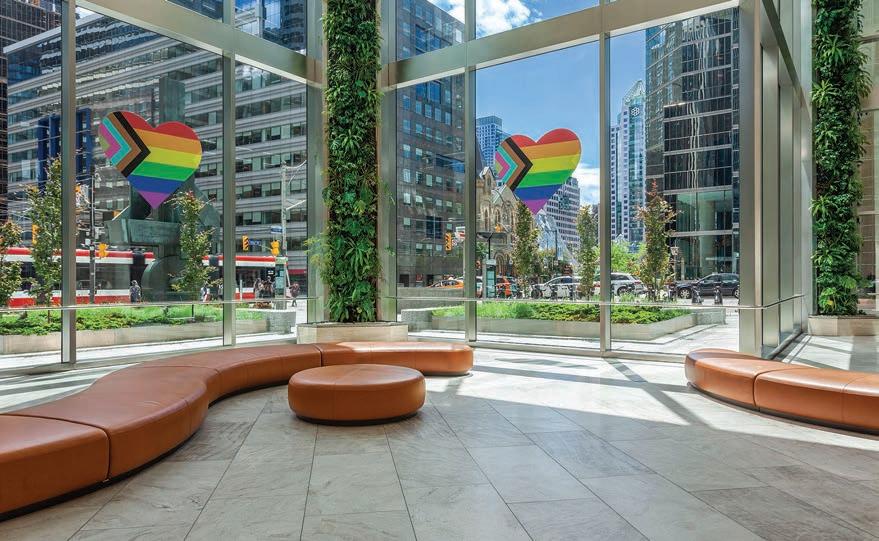
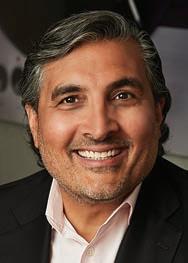
EDITORS’ NOTE Sonny Kalsi is the Co-CEO of BentallGreenOak (BGO) and is based in Miami, Florida. He was a founder of GreenOak Real Estate in 2010 and, together with the team, built the business organically to $12 billion of assets under management in 10 countries with over 100 employees. Before co-founding GreenOak, he was the Global Co-Head of Morgan Stanley’s Real Estate Investing (MSREI) business and President of the Morgan Stanley Real Estate Funds until 2009. Kalsi has been cited by Private Equity Real Estate magazine as one of the “30 Most Influential” people in private equity real estate globally. He is on the board of several organizations including Teaching Matters, Room to Read, SparkYouth NYC, Asia Society, and the Hirshhorn Museum. He is a Trustee of the Spence School and a board member of Oberoi Realty and Georgetown University. Kalsi is a graduate of Georgetown University and continues to be very involved with the school in advancing academic initiatives. He is also an Adjunct Professor at Columbia University in the Master of Real Estate Program.
COMPANY BRIEF BentallGreenOak (bentallgreenoak.com ) is a leading global real estate investment management advisor and a globally-recognized provider of real estate services. BentallGreenOak serves the interests of more than 750 institutional clients with approximately $80 billion of assets under management (as of June 30, 2022) and expertise in the asset management of office, industrial, multi-residential, retail and hospitality property across the globe. BentallGreenOak has offices in 28 cities across 13 countries with deep, local knowledge, experience, and extensive networks in the regions it invests in and manages real estate assets on behalf of its clients in primary, secondary and co-investment markets. BentallGreenOak is a part of SLC Management, which is the alternatives asset management business of Sun Life.
Will you highlight the history of BentallGreenOak (BGO) and how the business has evolved?
Responsible investing has been front and center throughout our history as a company. Our BentallGreenOak (BGO) history is the result of a
Kalsi
merger between two highly complementary real estate firms, GreenOak Real Estate and Bentall Kennedy. We came together three years ago to create a worldclass real estate investment manager. At face value, the two firms seemed very different: Bentall Kennedy, more than 100 years old, was a household name in Canada with some presence in the U.S. while GreenOak Real Estate – where I was one of the founders – was a young, entrepreneurial firm with a more U.S.centric and global presence. However, we realized quickly that we shared very similar investment practices, underwriting discipline, and client-centric cultures. Both firms had a view on the bigger picture. One thing we loved about Bentall Kennedy was the firm’s position as an industry leader focused on sustainability; they were focused on sustainability for years, long before ‘going green’ went mainstream. At GreenOak, we had always been focused on diversity and inclusion in leadership and at all levels with over 50 percent of the team being women and minorities. I joke that Bentall Kennedy liked us because we looked like the United Nations. Together, we brought leadership in all aspects of ESG to our now fully merged company.

When we came together in July 2019, we had $45 billion AUM; today, we are over $80 billion in AUM. Part of this evolution was that we continued to excel at what each firm did individually, and then did those things together. We launched new investment strategies that took advantage of the skill sets of both organizations, and it’s worked well for us, and more importantly, for our clients.
It is important to my Co-CEO, John Carrafiell, and our President, Amy Price, that the growth and evolution of our organization is measured by more than just AUM growth. One of the things I’m most proud of is how well our organizations integrated and began operating as a single team. In my view, you know a merger is a success when everyone at the firm talks about being part of BGO and does not focus on which firm they started with originally.
How do you define BGO’s mission and purpose?
First and foremost, we are good fiduciaries and stewards of capital for the institutional investors who invest with us. They trust us with their pension funds and the retirement income of the people they, in turn, serve, and we take that very seriously. Additionally, like our clients, we also serve a broader purpose. ESG is not
PURPOSE
Sonny
Pride month is celebrated across the BGO portfolio, including in this lobby at 150
Street in
POSTED WITH PERMISSION. COPYRIGHT © 2022 LEADERS MAGAZINE, LLC LEADERS 98 VOLUME 45, NUMBER 4
King
Toronto, Canada
only important to our employees, shareholders, and the communities where we operate and invest, but it’s also a top priority of our investors. Our prioritization of ESG is central to our corporate mission; we were walking the walk of ESG before we ever started talking the talk. It’s who we are.
Our focus on ESG is not altruistic; it is a part of our ethos. Our ESG strategy is twofold –value creation and risk mitigation. We believe the performance of our real estate assets is tied to how well they navigate the challenges of climate change, soaring energy costs, a shifting regulatory environment, and evolving tenant demands.
ESG has gone from a nice to have that comes with a cost, to an absolute business imperative. If you have an asset that is not up to par from a sustainability perspective, you’re going to have a hard time selling it in the future.
What have been the keys to BGO’s strength and leadership in the industry?
I think it all comes down to this: we focus on what matters, and we do the right thing for our investors, our tenants, and our communities. These are core components of our firm’s culture code, and my personal favorite value; it’s where trust and performance meet.
A theme that runs through all our success is trust. We have built longstanding trust with our clients and partners and earned investor confidence. With this strong foundation, even if we have a misstep, we’ll be open and honest about it as we address the path forward with clear communication and transparency.
I am also proud of the leadership we’ve shown in the areas of ESG and DE&I. We’ve taken tangible steps and then challenged others to follow our lead; that is something I’m very proud of. We don’t want to preach, but we both walk the walk and then look for ways to uplift our industry at large. Getting this right for our industry benefits us all.

Where do you see the greatest opportunities for growth for BGO?
The greatest opportunity for growth for BGO is at the intersection of ESG and our investment strategies. We are spending time getting involved in timber and farmland investing because they are great investment opportunities but, most importantly, they are critical from the standpoint of sustainability for the future. I believe that to grow for the sake of growth is where organizations tend to get into trouble. You must ask yourself, “Can I do this well?” If there is a real market opportunity for the growth, the only way to take advantage of it is to have the conviction that you will do it well.
For example, we have not, to date, been an investor in single family rentals. The reason for this is, we want to “do good” and “do it well.” We have been cautious about entering this market segment because there is a danger that if not done right, mass investment in this sector could potentially price people out of buying their own homes. Do we build new homes versus buy existing homes to not take away from the individual home buyer? Before we enter this market, we are exploring ways to “do good” in keeping with our culture and mission. We are looking at providing options for renters to buy the home, offering financial literacy programs and other similar steps as parts of a potential investment strategy in that subsector.
Lastly, data is a big part of the future and while real estate is an old industry that survives and thrives through volatile markets and environmental conditions, it is foolish to think that even real estate could remain unscathed if it does not evolve. Data is becoming increasingly predictive, and the real estate industry must seize the opportunity to gather and act on this data.
What are the keys to effective leadership and how do you describe your management style?
I believe that leadership is intentional and that many different styles can work if the leader
is leaning into who they are as a person and is authentic. I have witnessed people responding well to many different leadership styles – the common denominator is that people feel the leader is genuine. For me, an effective leader is also a clear communicator. It may sound simple, but it is not easy to do because you must also be able to tell people what they do not want to hear. Another critical factor in leadership is electability – leaders should be “elected” by their peers and who they serve, rather than be “appointed.”
I believe that you can distill leadership down to two mantras: define reality and say, “thank you.” Defining reality means that you lay out the good, the bad and the ugly – hopefully, there is not much ugly. But it is critically important to share concerns. A leader who is open and transparent engenders trust and is approachable. Next is appreciation. I am extremely appreciative of the opportunities I have had in my career and so, as one of the leaders of the company, I truly feel the need to say “thank you” to my teams very frequently. It goes a step further than appreciation and gratitude. It shows that you are emotionally available and empathetic. I favor an informal approach which has created a flat organization at BGO. I have always included my heart in my decisionmaking, which has become more of the norm in our post-pandemic world – leaders using their heads and their hearts to make decisions.
I also think being genuine and true to yourself means that you have personal views, separate from being the CEO of an organization, and that you are not scared to share those views. During my tenure as CEO, we have experienced a multitude of social and governmental issues rise to the surface in the U.S. and abroad. While I can shape the experience that our employees have while they work at BGO, I cannot control governmental decisions or politics. I made a few personal statements over the past couple of years on these issues and I am proud that I can use my platform to share my thoughts with my organization and my network.
How critical is it for BGO to build a diverse and inclusive workforce?
It has been proven many times that a team diverse in background, experiences, education, and economic class collaborates to come up with better ideas and solutions. It is simple: you make better decisions with more perspectives at the table. As a result, asset management companies that are more diverse perform better by the numbers. Once you understand that’s it’s about investment performance as well as workforce, it’s easy to see how critical diversity and inclusion are to the success of our organization overall.
We took decisive action for ourselves and to lead the industry in diversity and inclusion in 2020 that have resulted in tangible impact. We have always focused on a diverse team, but the events of the summer of 2020 inspired us to become even more intentional with our DE&I initiatives. We spent a lot of time thinking about what we could do to improve equity and inclusion and we decided that the only way to show
POSTED WITH PERMISSION. COPYRIGHT © 2022 LEADERS MAGAZINE, LLC LEADERS99 VOLUME 45, NUMBER 4
Under Sonny Kalsi’s leadership, BentallGreenOak was honored at the 2022 BILD Awards in recognition of the firm’s industry leading strategies on diversity, equity, and inclusion
how serious we are was to rapidly commit to tangible, measurable goals. As a firm, BGO committed to two out of every three new hires being either female or from another underrepresented group. We made a concrete commitment to gender parity in all titles and ranks by 2030 with a specific goal of at least 30 percent representation of women at the most senior ranks. In a still primarily male-dominated industry, these goals represent meaningful change. To be honest, we simply followed the math. Half of the workforce is female.
I’m happy to report that to date, we are achieving and exceeding these goals. We have hired 400 people since this pledge, and it has changed the diversity of the team significantly. The real success factor is that the leadership of the firm has directly hired only about 10 percent of the 400 new hires. So, it means that at all levels of management, the entire organization is committed to our pledge. I meet with new hires and junior staff constantly and I hear many of them say that part of the reason they came to BGO is because they like what the firm stands for and they feel welcome and comfortable. But we are just one firm; my hope and objective is for more people throughout the real estate industry to do the same.
What do you see as BGO’s responsibility to the communities it serves and to being a force for good in society?
Our mission to “do the right thing” is synonymous with our fiduciary commitments to investors: we work productively and with integrity. In the flight to quality for tenants and investors, the correlation between environmental and social performance and long-term value creation is clear. We have built a team at BGO that has a mandate to deliver on these commitments. This commitment presents itself in many ways, from our journey toward net zero by 2050 across our managed real estate
portfolio, to our social endeavors to rally underrepresented communities and provide progressive support for women.
A good example of an opportunity to demonstrate corporate responsibility to communities and society came up in 2017. When the U.S. withdrew from the Paris Climate Accord that year, local municipalities, and private companies – including us – decided to continue to follow the ideals of the accord, regardless of political affiliation. We stepped up to do the right thing regardless of political changing winds. I believe that all organizations should be focused on business and performance goals I believe are not mutually exclusive with doing the right thing.
What has made the focus on sustainability so important to BGO and will you discuss BGO’s sustainability initiatives?
BGO sustainability practices are rooted in the foundational work done at Bentall Kennedy under Gary Whitelaw’s direction before our merger in 2019. It was important to Gary that Bentall Kennedy was focused on sustainability specifically, and responsible investing more broadly, before it was mandated or mainstream.
At BGO, ESG and investing perspectives are fully intertwined like strands of DNA. BGO’s focus on ESG is an innovation driver at the firm with new investment opportunities and new growth opportunities coming to the forefront consistently. In fact, our sustainability goals have spurred lively internal competition within the firm for who can become greener first, and it has become a huge driver of results.
Building on that tradition, this year we have embarked on one of the most monumental undertakings in our firm’s history: our commitment to a net zero managed portfolio by 2050. I would love to see us make this goal in less than that time so I can be around for it. A cleaner electrical supply grid is one thing that will allow us to achieve net zero more
quickly, so we are working with infrastructure partners to make that happen. Currently, our developers are building London’s largest office development with commitments to being all-electric, net zero carbon emissions-ready from day one of construction. In our existing building portfolio, we are adapting our buildings to achieve more stringent standards for health and wellness, and we have certified Fitwel Viral Response-approved real estate portfolios in both Canada and the U.S. that are amongst the largest in both countries. Our U.S. Core Strategy is one of the first U.S.-based, open-end, diversified, core real estate funds to commit to the Operating Principles for Impact Management global framework. And we are committing time and resources to exploring new Proptech and AI platforms that offer a promising glimpse into further carbon reductions and efficiency gains.

Our ESG mission is ambitious and the actions we are taking now will drive reform. We are committed to being the game changer that we know our industry is ready for.
What advice do you offer to young people interested in a career in the industry?
Join us! It is human impulse to want to build something and in real estate we are building cities and economies, one building at a time. It is a proud moment when you walk down the street in any city with colleagues in the industry and people point to projects they helped shape and create. It is a very tangible legacy that we are leaving for the future.
Success in the real estate industry is more attainable than it has ever been. Historically, it was dominated by a small group of investors and generations of real estate families. We are doing a great job of exposing people to the real estate industry who have not been exposed to it otherwise. Project Destined is a BGO-sponsored real estate educational program for inner city students to build a range of technical, financial, and leadership skills through an internship. The BGO Built to Lead initiatives work with diverse and underrepresented communities across Canada and the U.S. to forge a path for diverse talent to a career in commercial real estate.
For young people entering the industry, I advise you to pick people over brand. There are a lot of firms out there with great brands but, in the quest for a long and fruitful career, choosing the firm where the people look out for you is the key differentiator. These are the leaders who will mentor you when they are with you and sponsor you and advocate for you when you are not in the room. The firm you choose should have a mission beyond making an extra dollar. A career is a long-term endeavor during which you can benefit from the people you are around all the time. You can figure out which firms embody this by the way their management speaks. Focus on places that use “we” instead of “I.” They are more likely to care about you. The pronoun “we” shares success and shows humility. Leaders should only use the pronoun “I” when they are taking responsibility for something that has not gone well.•
POSTED WITH PERMISSION. COPYRIGHT © 2022 LEADERS MAGAZINE, LLC LEADERS 100 VOLUME 45, NUMBER 4
105 Victoria Street, London, BentallGreenOak’s ground-breaking development scheme that will deliver London’s largest net-zero, 100 percent electric-powered office building
PENINSULA MOMENTS
World Class Design. Local Inspiration. The Peninsula Chicago offers a wide range of sophisticated suite accommodations to meet the needs of any traveler. From the expansive, three-bedroom Peninsula Suite featuring a private terrace overlooking Lake Michigan, to the intimate one-bedroom Executive Suite with just the right amount of personal space, travelers will always find themselves in a warm, welcoming space that perfectly blends Eastern graciousness with Midwestern hospitality.



108 EAST SUPERIOR STREET, CHICAGO, IL 60611,
Hong Kong • Shanghai • Beijing • Tokyo • New York • Chicago •
•
• Bangkok • Manila Under Development London • Istanbul •
USA TEL: +1 (312) 337-2888 E-MAIL: PCH@PENINSULA.COM
Beverly Hills
Paris
peninsula.com
Advocating for Children


EDITORS’ NOTE Irwin Redlener has dedicated his life to helping vulnerable at-risk children survive and thrive. Whether as a highly accomplished pediatrician caring for children with life-threatening illnesses, founder of the Children’s Health Fund (CHF), creator of a stateof-the-art New York City Children’s Hospital, discussing current public health issues and policies, or advocating on behalf of the growing numbers of children in crisis, his creative strategies have made him a sought after thought leader and speaker for media, educational organizations, and political forums. He is one of America’s leading child advocates. He also devotes his energies to educating the nation about the need to be prepared for the increasing number of natural and man-made disasters that threaten cities and citizens and promoting the best methods to affect a full and speedy recovery post-disaster, particularly for children.
Karen Redlener is Co-Founder and former Executive Director of the Children’s Health Fund. She has expertise in child health and development, as well as significant experience in program management and financial administration. She has a history of program design and development, including work expanding Lee County Cooperative Clinic, designing South Bronx Children’s Health Center, designing CHF’s signature mobile medical clinic model, and developing CHF’s Healthy and Ready to Learn Program.
PROJECT BRIEF Co-Founded by Dr. Irwin Redlener and Karen Redlener, the Ukraine Children’s Action Project (UCAP) is working directly with the cities of Lviv, Ukraine and Warsaw, Poland – along with a range of local and international organizations, as well as senior government officials in both countries –to address the critical and growing needs of hundreds of thousands of traumatized kids who fled the brutal battlegrounds of eastern and southern Ukraine. Many have sought safety, usually with a parent, in the western regions of Ukraine; others are living as refugees in Poland and other countries. These children need psychological support, access to healthcare and, for virtually every school-age child, access to language compatible education. This defines the mission and work of the Ukraine Children’s Action Project. UCAP is working with schools and special programs in Ukraine and Poland to support access to schools and remote learning hubs for all displaced children. Many corollary needs are addressed as well, including training teachers to deal with classrooms filled with psychologically traumatized students. UCAP has also been there to provide textbooks to elementary school students when educational funds were diverted to support the vital military needs of Ukraine’s army. In Lviv and Warsaw, UCAP proposed a new Future Ready initiative that will help identify health barriers to learning and offer wideranging support for children who are suffering from psychological trauma. UCAP is working with the American Federation of Teachers, The Polish Teacher’s Union, the Ukraine Teachers Union, National Psychological Association of Ukraine, UNICEF, and other organizations. UCAP is also in regular communication with senior medical leaders in Lviv to understand and support medical and rehabilitation needs for children who have been transported from eastern and southern Ukraine to Lviv for care and treatment. Finally, UCAP’s leaders are committed to helping make sure that media and the American public don’t lose sight of Ukraine’s children who continue to suffer under a war over which they have no say and no ability to bring the violence to an end. UCAP is a fund of the Entertainment Industry Foundation (EIF), a 501(c)(3) tax-exempt organization. EIF is a Charity Navigator 4 Star Charity that meets all 20 BBB Charity Standards and carries the Candid Platinum Seal of Transparency.
What was your vision for creating the Ukraine Children’s Action Project (UCAP) and how do you define its mission?
Irwin : We’ve spent our working lives advocating for children and creating programs to help children living with adversity get the healthcare and support they need. When the Russians invaded Ukraine on February 24, we knew that civilians in general, and children in particular, were going to feel a disproportionately high impact of this war. When our friend of 50 years, the singer/activist, Joan Baez, asked how to best spend money she had raised through the sale of her art, we decided to see what we could do to help.
Beginning in April, this idea involved several trips to Poland where so many Ukrainian refugees have found a generous population who welcomed them with open arms and a government committed to caring for the millions of families who came to escape the violent brutality that Russian troops inflicted on the cities and towns of eastern and southern Ukraine. Then, in May, I got into Ukraine and had a chance to see the resilience and bravery of everyday Ukrainians who also fled Russia’s missiles and decided to try and make it in western Ukraine.
Karen: After our initial trip, we realized that our experience addressing the health, education and crisis response needs of children was very relevant to the urgent needs of displaced Ukrainian children impacted by war. By establishing the Ukraine Children’s Action Project, we were able to focus attention on, and raise funds for, children’s critical mental health, trauma and educational continuity needs.
By the end of our second trip, we had established working relationships with the

PURPOSE
An Interview with Irwin Redlener, MD and Karen Redlener, Co-Founders, Ukraine Children’s Action Project
Karen and Irwin Redlener
PURPOSE POSTED WITH PERMISSION. COPYRIGHT © 2022 LEADERS MAGAZINE, LLC LEADERS 102 VOLUME 45, NUMBER 4
Irwin Redlener with Andrzej Duda, President of Poland
mayors of Warsaw and Lviv, the governor of the Lviv region, leadership in the Polish teacher’s union, and many agencies in both cities. Besides that, of course, we spoke with countless numbers of displaced kids and their families to get a clear understanding of what was needed.
Will you provide an overview of the work of UCAP?
Irwin : Needless to say, the first concern for traumatized people seeking safe refuge is to make sure humanitarian needs are met. This means food, shelter, security, and medical care. That’s where many of the major brand name organizations excel, such as UNICEF, Save the Children, International Medical Corps, and many others.
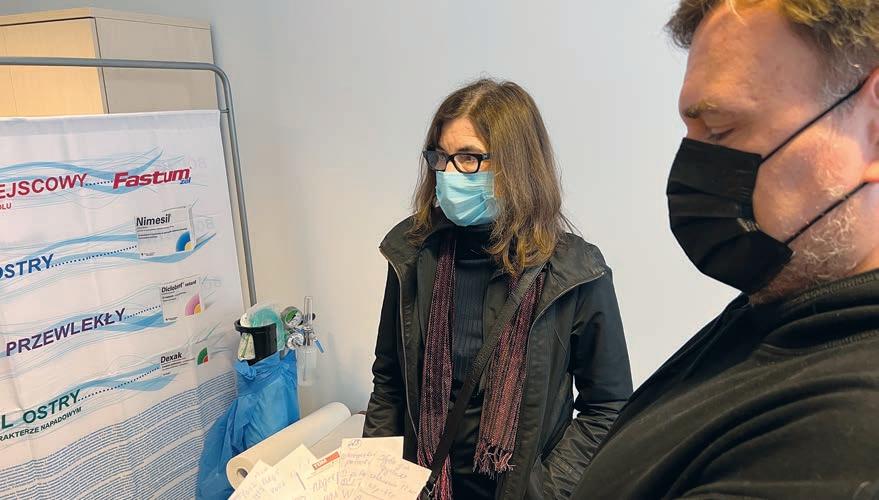
Our concern is that there needs to be greater focus on the two big issues that almost all of the refugee and displaced kids face: first, prolonged disruption of their education; and second, untreated consequences of severe psychological trauma.
Karen: So that is where UCAP is concentrating its activities. We’re working with political leaders, teachers, and other relevant organizations to emphasize the need to make sure there are systems to ensure that every refugee or displaced kid is in a classroom or attending “learning hubs” to access their lessons “on-line” in supervised, language appropriate environments.
In addition, we funded a summer camp experience for dozens of Ukraine refugee children in Warsaw. We bought books for school children in Ukraine, where book budgets for the schools have been diverted to support the military. And we have been developing online training programs to help both Polish and Ukrainian teachers cope with classrooms of traumatized children. We are working with school systems in both countries to support their ability to screen kids for vision problems, hunger, and psychological and behavioral issues.
Irwin: And, as a pediatrician, I am concerned about the needs of the hospitals having what they need to provide care to the many children
transferred from the east with horrendous wounds of war.
We have a very full agenda, and we’ll continue to do what we can – as long as we continue to raise the necessary funds.
One of the things we’re most proud of is how quickly people came together to help us support Ukraine’s kids. Our old friend, legendary singer and social activist, Joan Baez, was first to come on board. Then, the iconic actor Michael Keaton and popular MSNBC anchor, Nicolle Wallace. Supporting us with great subject matter expertise and experience are Randi Weingarten, president of the American Federation of Teachers, and Dr. Harold Koplewicz, founder of the Child Mind Institute. These are among the people that are actively involved, and it makes a difference.
What do you want people to know about the current needs of Ukrainian children?
Karen : The child population of Ukraine was about 7.5 million before the war. Some 5 million kids have been emergently evacuated either out of the country or to hopefully safe havens in the west of Ukraine. We’re talking about 2/3 children under age 18 who have left their homes and communities. That would be like 55 million children in the U.S. displaced under a brutal attack by a neighboring country.
All of Ukraine’s children need the war to stop immediately. But even when it does, recovery will take at least a decade. All refugees, including children, need stability, safety, school, and support. This is a very rough time.
What more can be done to support Ukrainian children and address the refugee crisis?
Irwin : Americans and the West must not forget about the plight of Ukrainians – especially the millions of kids who need support and professional attention. That said, the attacks on Ukrainian civilians must cease immediatly. And that’s why, oddly enough, this pediatrician says that support of the Ukrainian military efforts is essential. This is an existential struggle to stop Russia from destroying a country, its people,
its economy, and its culture. All the democratic nations of the world must be aligned to help Ukraine prevail in this war.
And, of course, we hope folks will contribute to UCAP and help us make sure that this “war generation” gets through a nightmare of persistent terror. They need a glide path to successful, productive, and fulfilled lives. And Ukraine needs these kids to be educated, resilient and ready to contribute to the future recovery of their country.
How do you define success for UCAP’s work?
Karen: We certainly wouldn’t be able to do what we do without the support of our concerned donors. We all need to be in the struggle, but Irwin and I want to see concrete accomplishments like children linked to accessible education as a priority, universal trauma management training for teachers, making sure every kid who needs glasses or psychological support gets their needs fulfilled. Also, we want to help keep the needs of Ukrainian kids and families on the radar screen in the U.S. Irwin speaks and writes about this urgent situation as often as he can.
Will you discuss your passion for humanitarian work and what has made this work so special for you?
Irwin: Karen and I met 50 years ago working in a health clinic in the sixth poorest county in America, where “colored only” signs in certain doctors’ waiting rooms had not yet been fully removed. When I made evening house calls, way out in the county, I was followed by guys in pick-up trucks with filled gun racks. I was the medical director of this VISTA (Volunteers in Service to America) supported clinic in Lee County, Arkansas. Karen was a VISTA volunteer who established social service programs and screened some 1,000 children in Lee County for vision, hearing deficits and developmental delays.
Passion, whatever that means – and mission commitment – were attitudes and life perspectives that both of us grew up with. That’s why our work was always exciting – and our relationship deeply romantic.
Plus, for us, injustice, racism, and especially unnecessary suffering of children are intolerable realities that we won’t stop trying to deal with for as long as we can.
With all of the challenges facing Ukrainian children, how do you stay optimistic about the future?
Karen: We are inspired by each other, by our children, and by our seven grandchildren. They make us laugh, they give us hope, and they are our antidotes to whatever ails us. We hang out with them as much as we can, and we care about what the future has in store for them and all children.
We are also inspired by the incredible Ukrainian and Polish people we’ve met who are working so hard to help families and children get the resources they need to survive this unbelievable 21st century catastrophe.
Irwin: Strange as it may seem, we are thrilled to be able to have the energy and drive to do what we do. Actually, if we didn’t think that the future will be better than the present, it would be impossible to keep moving forward with our work.•
POSTED WITH PERMISSION. COPYRIGHT © 2022 LEADERS MAGAZINE, LLC LEADERS103 VOLUME 45, NUMBER 4
Karen Redlener with a Warsaw shelter director
Advancing Resilience

EDITORS’ NOTE Maura Pally is the Executive Director of the Blackstone Charitable Foundation, where she oversees all Blackstone Charitable Foundation activity, leading strategy and execution of programs in support of Blackstone’s goal of creating economic opportunity for under-resourced communities. Pally joined the firm from the Clinton Foundation, where she was most recently Executive Vice President. Prior to that, she worked at Bloomberg Philanthropies and as the Deputy Assistant Secretary at the Bureau of Educational and Cultural Affairs in the U.S. Department of State. She also served as Deputy General Counsel for Hillary Clinton’s 2008 presidential campaign, as manager of Politics and Public Policy at Oxygen Media, and as Special Assistant in the office of the White House Counsel. Pally received her JD from the USC Gould School of Law and a BA in political science and women’s studies from Brown University.
FOUNDATION BRIEF Founded in 2007, the Blackstone Charitable Foundation (blackstone.com/ our-impact) creates programs that enhance entrepreneurial ecosystems. By leveraging the resources and intellectual capital of Blackstone, it empowers entrepreneurs, creates an environment where careers can flourish, and supports the communities in which it lives and works.
What excited you about the opportunity to join Blackstone and made you feel it was the right fit?
I’d say there were three main factors that attracted me to the firm. First, from my earliest
conversations, I saw a very clear commitment from Blackstone’s people to effect change in their communities. In 2021, approximately 85 percent of our employees engaged with the Foundation’s charitable initiatives. Second, I was excited by the opportunity that the firm’s scale – nearly 250 portfolio companies – presents. Third, I’m excited by the alignment of the Foundation with the firm’s broader entrepreneurial identity through both investments on the business side as well as their clear focus on the topic through our signature student entrepreneurship program, Blackstone LaunchPad. I see many opportunities for collaboration and synergy with my colleagues from across the firm.

Will you provide an overview of your role and areas of focus?
I oversee all Blackstone Charitable Foundation activity, supporting Blackstone’s goal of creating economic opportunity for under-resourced communities. Practically, that means ensuring our signature programs –Blackstone LaunchPad, which helps students build entrepreneurial skills, and BX Connects, which connects Blackstone employees with service opportunities related to generating Healthy Communities and Skills for Success –deliver on their mandates. By supporting college and career readiness through philanthropic commitments and employee engagement opportunities, we are enabling more young people to access education and realworld work experiences that lead to highwage, in-demand jobs. It also means thinking about how the Foundation can build on the achievements of the past 15 years as it looks towards its next phase of growth.
What is the history of the Blackstone Charitable Foundation and how do you define its mission?
Blackstone created the Foundation in 2007 to lead its philanthropic initiatives under the leadership of Amy Stursberg, whose career includes serving as director of the September 11th Fund and at the Office of Management and Budget in New York City. In the wake of the financial crisis, we wanted to give back and, importantly, support entrepreneurs. The innovation, skillset, and career mobility of young entrepreneurs is crucial to building successful companies. Blackstone itself wouldn’t exist without the entrepreneurial initiative taken by its founders, and continues to invest in entrepreneurs today.
We also wanted to give our employees an opportunity to give back to their communities and created the BX Connects program. Over the years, we’ve partnered with over 100 nonprofit organizations all over the world.
Will you highlight the programs of the Blackstone Charitable Foundation in its efforts to create economic opportunity for under-resourced communities?
Blackstone LaunchPad is the Blackstone Charitable Foundation’s student entrepreneurship program. LaunchPad empowers students with entrepreneurial skills to help them succeed in any career. We partner with community colleges, four-year colleges and universities to deliver entrepreneurial resources, a global network of mentors, and unique convening opportunities to students.
Over the last decade, we have been present on over 50 campuses. We’ve supported students at every level of the venture creation process – whether they’re already raising money and building out a workforce, or just have the beginnings of an idea. Underpinning our work
PURPOSE
Maura Pally
An Interview with Maura Pally, Executive Director, Blackstone Charitable Foundation
engaged
POSTED WITH PERMISSION. COPYRIGHT © 2022 LEADERS MAGAZINE, LLC LEADERS 104 VOLUME 45, NUMBER 4
“In 2021, approximately 85 percent of our employees
with the Foundation’s charitable initiatives.”
is a commitment to diversity. LaunchPad has expanded to reach more students, particularly those who wouldn’t otherwise have had access to these opportunities. We focus on colleges and universities that have a majority diverse population or are serving under-resourced communities, prioritizing narrowing gaps for historically under-resourced and diverse communities.
BX Connects uses the firm’s scale, talent and resources to make grants, develop nonprofit partnerships and create employee engagement opportunities. Partners have ranged from the youth literacy organization Reading Partners, education and mentorship organization SEO, and job training organization YearUp – a small sampling of the organizations BX has partnered with to advance its core pillars: skills for success and healthy communities.
How important are metrics to measure the impact of the Foundation’s work?
They’re essential. Metrics tell a story about how well we’re engaging our communities and how committed our teams are to the firm’s culture of service. We’re being thoughtful as we shift the LaunchPad program to focus on building entrepreneurial skills for success to measuring the impact of our work, not only via companies formed and jobs created, but also through entrepreneurial skills attained.
We knew, for example, that we wanted to adjust LaunchPad so it served students who needed access to entrepreneurial programming the most – and the metrics reflect that shift. In 2021, we rolled out expansions to the University of Texas system, three HBCUs (Historically Black Colleges & Universities) in Atlanta, nine schools across the CUNY system in New York, and two Hispanic Serving Institutions in Nevada. Over the next five years, the program will more than double, widening its reach from 30 to 75 campuses across the nation.
In 2021, approximately 85 percent of our employees engaged with the Foundation’s charitable initiatives. Employees also jump at the opportunity to nominate nonprofits they admire through the annual Blackstone Gives Back Challenge, our employee-driven grant competition which awards grants each year to whichever of these nonprofits receives the most votes. Through the Gives Back Challenge, we gave out $700,000 in 2021 to employee-selected nonprofits.
Will you discuss the commitment and engagement of Blackstone’s leadership team for the work of the Foundation?
They’re wholeheartedly engaged – a huge gift, especially considering that Blackstone leaders are some of the busiest people I’ve ever encountered. Many of them sit on the Foundation’s Board, and many more of them sit on its Leadership Council. Their sharp questions, fresh ideas, and insight into the firm’s priorities have helped make the Foundation what it is today. Most importantly, they are genuinely committed to giving back and leveraging the resources and talents of the firm for good. The firm’s leaders set the tone for our junior employees across the firm in spearheading our culture of giving back.
Did you always know that you had a passion for this type of work and what makes it so special for you?
I have always been driven by opportunities to serve and give back. I have been incredibly fortunate throughout my career to be able to do that in various ways, including from the government side, at the State Department’s Bureau of Educational and Cultural Affairs, to the nonprofit program side at the Clinton Foundation, to the philanthropic side at Bloomberg Philanthropies. I jumped at this opportunity to work with the
incredible team at Blackstone to think creatively and ambitiously about the firm’s impact on the broader community. There is both enormous talent and a deep commitment to giving back across Blackstone, and the opportunity to help lead that effort is thrilling.
What are your priorities for the Blackstone Charitable Foundation as you look to the future?
My priority is to use Blackstone’s signature programs to advance resilience among the communities that we serve. Part of the reason we adapted LaunchPad to promote entrepreneurial skills-building for all students – not just future founders – is because we recognized that the skills it took to innovate and run a startup made students more resilient and better-equipped to meet the demands of an ever-changing job market. Over the coming years, we look forward to narrowing gaps for historically under-resourced and diverse communities.
Blackstone Career Pathways was designed as another initiative in Blackstone’s broader commitment to creating value through career mobility and ongoing diversity efforts at our portfolio companies. Through Career Pathways, Blackstone helps portfolio companies adopt inclusive workplace practices and expand applicant pools through partnerships with organizations such as Year Up and COOP Careers. Our goal is to create value by working from the ground up to remove legacy barriers to hiring and increase employment opportunities and career mobility for people from diverse and historically under-represented and under-networked communities. We aim to provide the tools, training and resources within companies that support diverse hiring, retention, and advancement.•
“By supporting college and career readiness through philanthropic commitments and employee engagement opportunities, we are enabling more young people to access education and real-world work experiences that lead to high-wage, in-demand jobs.”
POSTED WITH PERMISSION. COPYRIGHT © 2022 LEADERS MAGAZINE, LLC LEADERS105 VOLUME 45, NUMBER 4
“My priority is to use Blackstone’s signature programs to advance resilience among the communities that we serve.”
Changing the World for the Better
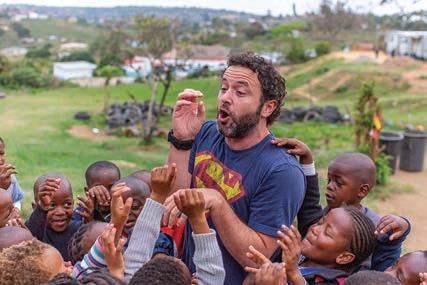
 An Interview with Antonio Ruiz-Gimenez, Chairman and CEO, Keep a Child Alive (KCA)
An Interview with Antonio Ruiz-Gimenez, Chairman and CEO, Keep a Child Alive (KCA)

our focus to look at the wider needs of children living in extreme poverty; we provide a range of programs that include sexual health education, protection against sexual exploitation and abuse, livelihood skills, climate mitigation, maternal health, and vocational training, among other things. Due to the current events over the past few years, we had to add an emergency response approach.
supporting local organizations with funding, capacity building, and practical support.
Antonio
EDITORS’ NOTE Antonio RuizGimenez serves as the Executive Chairman and CEO of Keep a Child Alive (KCA) and has been a board member since 2015. In addition to his work with KCA, he is a successful entrepreneur involved with several diverse businesses. He is the co-founder and Managing Partner of ATW Partners, a venture capital/private equity investment firm. Prior to ATW Partners, he co-founded several innovative businesses ranging from city enhancement, to retail, to technology development companies. Ruiz-Gimenez holds a law degree from Universidad Complutense of Madrid.
Ruiz-Gimenez
FOUNDATION BRIEF Co-founded in 2003 by Alicia Keys, KCA (keepachildalive.org) is committed to empowering children and young people with the necessary resources, confidence, and opportunities to reach their full potential and live healthier, happier lives. The organization currently provides support to 15 community organizations in 19 countries across Africa, Asia, the Middle East and Europe, reaching 400,000 children and their families. KCA’s core focus is to shift from charity to solidary, unleashing the power of children and young people around the globe.
Will you highlight the history of KCA and how you define its mission?
In 2003, Alicia was deeply motivated by the needless suffering that HIV/AIDS was creating for children and families across subSahara Africa. These children were dying due to lack of access to treatment; such treatment was available, but it was too expensive. KCA was created to stop this injustice and get more treatment for children with HIV/AIDS. Our mission has evolved since then, but what has remained at the heart of what we do is giving children the opportunity to live long and fulfilling lives. We take a holistic approach to care by looking at all angles around the life of a child, their families, their nutrition, education and healthcare.

KCA is celebrating its 20th anniversary. How has KCA evolved since its founding?
The world has dramatically changed over the past 20 years and KCA has evolved with it. Over this time, many governments have stepped up and are now offering the vital treatments needed by those with HIV/AIDS. As a result, we have broadened
To provide a few examples, when the COVID-19 pandemic started, our work took us to new countries, providing hundreds of thousands of people with vital food packages. The situation in Afghanistan enabled us to mobilize support for women and their families fleeing the new regime. KCA could not look the other way during the crisis in Ukraine, supporting children and families fleeing to safety and gaining access to the care and the resources they needed.
Will you provide an overview of the work of KCA and its initiatives?
Some of our current initiatives include:
1. Supporting local activists in transforming the lives of the people and communities around them. We know local people are far better placed to make local change. We do this through
2. Delivering large scale solidarity campaigns where we focus on specific themes that are the biggest issues facing the next generation, such as the climate emergency and vocational training. By supporting people on the ground to work on these issues, we are also influencing local and national stakeholders to create sustainable change, aiming to bridge the gap between people and policy.
3. We go where we are needed to help children in crisis. As mentioned earlier, some examples include food emergency response during the COVID-19 pandemic, and in Afghanistan and Ukraine. We mobilize efforts quickly and effectively, especially where other organizations cannot. The past few years have made this work more important than ever.
What are the keys to driving lasting, sustainable change with KCA’s work?

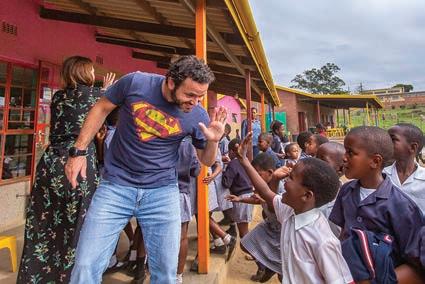
• Charity – best when done in the spirit of solidarity. We do not provide charity to people and their communities, instead we stand shoulder to shoulder and assist them in implementing their own solutions.
• Grassroots knowledge – our local partners enable us to deliver the appropriate

PURPOSE
POSTED WITH PERMISSION. COPYRIGHT © 2022 LEADERS MAGAZINE, LLC LEADERS 106 VOLUME 45, NUMBER 4
solutions; they are our implementers who are our eyes and ears on the ground. We have had the luxury of working with incredible human beings for many years that know we are there for the long run. Investing in them drives high-impact, long-term results.
• Leveraging networks – we are in a privileged position to have access to a broad and influential platform. By utilizing this we bring in experience, innovation, and resources to amplify local voices, and supercharge lasting change.
How has KCA adapted the way it works to address the challenges caused by the global pandemic?
Being in such an unprecedented situation, we had to learn and grow fast and make the most of all of our networks of supporters, partners, and colleagues. We would not have been able to react as quickly without the generosity of our donors.
We initiated a campaign that resulted in the delivery of over 25,400 food and healthcare baskets to 10 countries and impacted more than 109,000 children and their families through working with 16 local partners in El Salvador, India, Iraq, Swaziland, Costa Rica, Rwanda, Uganda, Guatemala, Venezuela, and South Africa. All of this started with one phone call requesting our support to 25 children in El Salvador undergoing a dire situation.

How critical are metrics to measure the impact of KCA’s programs?
KCA believes strongly in accountability and measuring our impact is an important component to this. Our key principles are:
1. People come first – we believe that how people feel about their experiences with our work is as important as hard data. We constantly gain feedback from those who have access to our services on what is working well and how we can improve and adapt.
2. Transparency is key – we know where every penny goes and how it is spent. We also want to know when we do well and when we fail. This is when we learn the most.
3. Expertise is essential – we work with expert partners who collate relevant datapoints to continuously learn and improve. We believe in continuous improvement and striving for excellence in everything we do.
4. All of the above come with respect and spirit of partnership. We are always open to evolve and learn from our partners. KCA is a platform for change, as such we must listen to how each local community is implementing each program.
Will you discuss Alicia’s passion and commitment for the work of KCA and how deeply engaged she is in its efforts?
I always say that I cannot speak on behalf of Alicia, I can only share my experience working with her over the past years.
She started KCA under a very simple premise of responding to a critical situation: a mother could not provide the necessary medication to treat her daughter. Alicia stepped in and provided the means to access that treatment. We at KCA keep that action as front and center of what we do daily.
That energy drives our initiatives with children being the core of our mission. She is a committed ally to those we work with. Alicia has been instrumental in our initiatives, providing guidance, support, and vision to our ultimate goal.
To name a few examples, during COVID, her generosity enabled us to dream big and reach many more children than we would have ever expected. During this horrific war in the Ukraine, she stood by our side to implement our programs across the country. During her world tour, she hosted Ukrainian women refugees at her concerts across Europe, spending time with them and listening to their experiences. She provided them with an experience that temporarily removed them from the horrific situation they were faced with.
Alicia is a leader and an inspiration and I look forward to working together with her for many years to come.
What are your priorities for KCA as you look to the future?

Over the past 19 years, KCA has evolved into a platform for change. Children are, and will always be, at the center of all our efforts. We want to continue to grow our network of supporters and local partners. We are building out our community through a digital platform that directly connects supporters with local partners, creating an equal exchange of ideas and resources utilizing technology.
We are always looking for advisors, ambassadors and changemakers who want to help grow our impact, expanding our ability to reach more children and change their world for the better.
We also created a team of athletes (Team KCA), spearheaded by Alicia, and now we run multiple races around the world raising funds and awareness for all our initiatives.
A successful initiative at KCA is defined as one where we come in, we act, we solve a specific problem, we support in the implementation of sustainable solutions, and then we let our local partners take over so that children and their communities can be self-sufficient.
It is our hope that we can replicate past successes in many more areas of need across the globe. One example would be our COVID-19 Relief campaign where we realized that providing a food basket was a short-term solution to a very specific need, so we identified an incredible partner (One Acre Fund) and implemented a new campaign where we are aiming to plant one tree for every child in the world, making this a long-term sustainable solution. We still have a long way to go, but as I said before, we have big ambitions.
Last but not least, KCA would not exist without the true heroes, our local partners. They are spread across the different countries where we work and we would not be in existence today if it were not for their hard work and unconditional partnership. They deserve all the recognition.•
“Millions of Africans die unnecessarily, for what?
Because they can’t afford medicines, because they can’t access them, that’s crazy. Let’s change that.”
POSTED WITH PERMISSION. COPYRIGHT © 2022 LEADERS MAGAZINE, LLC LEADERS107 VOLUME 45, NUMBER 4
Alicia Keys
AN AGENCY THAT FITS

Integrated
With more than 20 years of cross-industry experience, we have the skill set to meet any communications need. Partner with media experts who can boost your in-house team.

CONTACT US 212-886-1690 info@rooneypartners.com rooneypartners.com marketing and communications agency
Increasing Generational Wealth in the Black Community
 Executive Director and Head of Black Wealth
Executive Director and Head of Black Wealth
EDITORS’ NOTE Debra Langford is an Executive Director and Head of Black Wealth Initiatives for J.P. Morgan Private Bank. In her leadership function, she champions the development of opportunities that guide affluent members of the Black community in the growth and preservation of their wealth, and in leaving generational legacies. Following a career of producing results in media and entertainment content, Langford pivoted to deliver enterprise-level outcomes in diversity initiatives. This was manifest at Time Warner, where she designed innovative strategies to align hiring managers with skilled and diverse talent for senior positions. Similarly, at NBCUniversal, Langford was instrumental in showcasing best practices for reaching the multicultural audience. The entirety of her background brought her to J.P. Morgan in 2020 to lead Business Development for Advancing Black Pathways. Langford is Governor Edmund Brown’s appointee to the California Film Commission and was President Barack Obama’s appointee to the USO Board of Governors for both terms. Philanthropic by nature, she is the Secretary for the Leading Women Defined Foundation. A longtime entertainment industry leader and pioneer in Black executive leadership, Langford was the 2022 NAACP Changemaker Award honoree. She was also named to Diversity Woman Magazine’s 2022 Class of Elite 100, selected in recognition of their impact and influence on their respective industries. A Los Angeles native, Langford earned a BS from the USC Marshall School of Business, where she later became the first Assistant Dean of Diversity at the Business School. She also created the Women’s MBA Conference series before moving to the USC Race and Equity Center as Chief Strategy Officer.
COMPANY BRIEF J.P. Morgan Private Bank (privatebank.jpmorgan.com) provides customized financial advice to help wealthy clients and their families achieve their goals through an elevated experience. Clients of the Private Bank work with dedicated teams of specialists that bring their investments and financial assets together into one comprehensive strategy, leveraging the global resources of J.P. Morgan across planning, investing, lending, banking, philanthropy, family office management, fiduciary services, special advisory services, and more. The Private Bank oversees more than $1.9 trillion in client assets globally.
How do you describe the J.P. Morgan culture and how critical is culture to the success of the company?
The J.P. Morgan culture is inspiring, vibrant, and inclusive. This culture, which motivates everyone to deliver for clients while operating with integrity and keeping inclusion as a priority, contributes to why we are the Private Bank of choice.


What was the vision for creating the Black Wealth Initiatives program for J.P. Morgan Private Bank and how do you define the mission of this initiative?
Black Wealth Initiatives is the Private Bank’s intentional effort to be the bank of choice for high-net-worth Black individuals and families, and the employer of choice for Black advisors and investors.
The program recently celebrated its first anniversary and held its first Black Wealth Initiatives Forum. Will you discuss the evolution of the program over its first year and the impact of the Black Wealth Initiatives Forum?
The launch of Black Wealth Initiatives in 2021 engaged and mobilized bankers, investors and wealth strategists dedicated to reaching Black individuals and families across the country with tailored content, experiences, and advice. Black Wealth Initiatives has held more than 20 events across the country in cities including Los Angeles, Washington DC, New York, Charlotte, Atlanta, Miami, Dallas and Martha’s Vineyard. Through our events-driven work to expand reach and impact on building Black generational wealth, we have connected with more than 450 Black individuals and families over the past year.
PURPOSE
Debra Langford
An Interview with Debra Langford,
Initiatives, J.P. Morgan Private Bank
POSTED WITH PERMISSION. COPYRIGHT © 2022 LEADERS MAGAZINE, LLC LEADERS109 VOLUME 45, NUMBER 4
Debra Langford and David Frame, Chief Executive Officer of J.P. Morgan U.S. Private Bank, kicked-off the Black Wealth Initiative Forum on June 27, 2022
The inaugural Black Wealth Initiatives Forum was held in Brooklyn, New York, marking the oneyear anniversary of the program’s launch. More than 100 Black advisors, analysts, and presenters from across the country attended the Forum at JPMorgan Chase’s MetroTech Center in Brooklyn

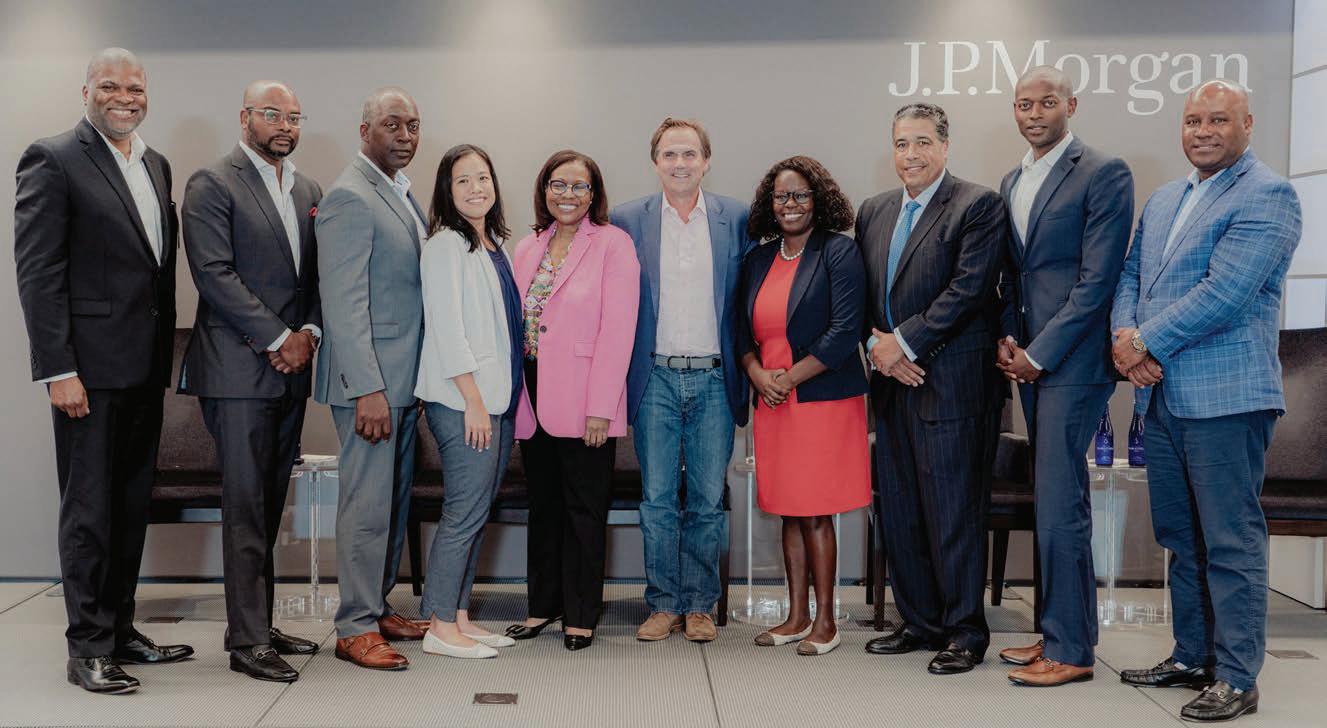
for three days of 21 dynamic panels, fireside chats, and networking to support commercial success with the theme – Culture. Capital. Community. The three-day Forum featured session themes including Authenticity in the Workplace, Becoming the Pilot of Your Own Career, and finance-focused
learning sessions around lending, alternatives and private equity, client prospecting, and more.
You have said that “culture often shapes wealth decisions.” Will you elaborate on this belief and how important is it to engage families of color in their wealth decisions?
I believe that one’s culture and unique experiences can determine their decisions and choices in many areas of life, including their wealth decisions. People can be inspired when they see a team who reflects their shared experiences and an organization which is actionable in committing to generational wealth for all.
How is the Private Bank helping racially and ethnically diverse professionals to grow and lead in the industry?
Black Wealth Initiatives partners with our talented recruitment team on furthering the Private Bank’s hiring efforts for Black private bankers, concentrating on employee engagement, internal support, and development resources. It is incredibly important to create a sense of community so our employees feel like they can succeed and have the safe space to connect with like people.
You joined J.P. Morgan in 2020. What excited you about the opportunity and has the experience been what you expected?
I joined J.P. Morgan after many years of being impressed with its leadership, presence, and commitment to communities of color. My experience so far has exceeded my expectations and I am looking forward to continuing to thrive while supporting opportunities to increase generational wealth in the Black community.•
J.P. Morgan Private Bank Managing Directors (left to right) Fred Walls, Jason Tinsley, Adrian Harris, Desiree Yee Borland, Leah Taylor, US CEO of J.P. Morgan Private Bank David Frame, Varcity Kariuki, Alex Picou, Clinton Warren and Rick Barragan
POSTED WITH PERMISSION. COPYRIGHT © 2022 LEADERS MAGAZINE, LLC LEADERS 110 VOLUME 45, NUMBER 4
Mary Erdoes, Chief Executive Officer of JPMorgan Chase Asset & Wealth Management, addresses the morning meeting crowd of Forum attendees
bound by devotion
We are dedicated to exceeding expectations, encouraging smiles and instilling happiness. Escape to our Mediterranean-style beachfront oasis, where we create transformative guest experiences season after season, year after year.
®
Resort & Residences on the Beach
17875 Collins Ave. Sunny Isles Beach FL 33160 Tel: 844 251 8490 acqualinaresort.com

Expanding Opportunities for Children

EDITORS’ NOTE Jaime Garcia is the President and Chief Executive Officer at the Andy Roddick Foundation and previous Executive Director for Extend-A-Care (EAC) YMCA of the YMCA of Austin. She has worked in after school with EAC for more than 25 years. She was responsible for overseeing 105 after-school locations, 40 summer programs, 12 infant preschool programs, and 550 employees. She is certified by the state of Texas as a director of licensed childcare centers. She currently serves on the board of the Texas Partnership for Out of School Time (TXPOST) and served on the advisory council for YUSA’s Character Development Learning Institute, as well as the Committee For Children’s SEL Out of School Project Advisory Leadership Council. She served for six years on the National After-school Association (NAA) board of directors and is a graduate of Leadership Austin Class of 2017. Garcia holds a bachelor’s degree in biology from the University of Texas at Austin and a master’s degree in business administration from Texas State University.
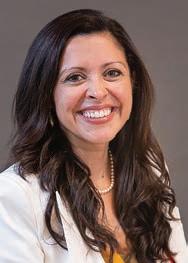
FOUNDATION BRIEF Andy Roddick started the Andy Roddick Foundation (arfoundation.org) to help more children discover their passions and help families and communities thrive. Whether it’s creating nationally acclaimed after-school and summer camps, or equipping other after-school and summer camps, or impacting change for all, the Foundation leads the charge to take the time children spend outside the classroom – the times of day and months when they are most at risk and falling behind – and turn it into real opportunities so that every single kid realizes, “I can!”
What was the vision for creating the Andy Roddick Foundation and how do you define its mission?
Every child deserves to have opportunities for enrichment to support their academic learning and exploration when school is out during the afternoons and summer months. The beauty of elementary-age years is to have children find their passion through dabbling in a variety of activities such as sports, arts, dancing, yoga, sewing, exploring the city, and different interests to determine what activity
generates a spark and excitement to build on throughout life.
Andy Roddick Foundation’s (ARF) mission is to work with our community to expand opportunities for young people to learn, thrive, and succeed. We envision a world where all young people have endless opportunities to realize and achieve their potential.

Will you provide an overview of the work of the Foundation and its programs?
ARF is an operating foundation which means we create programs in addition to assisting other nonprofits. We rely on the public to help fund the Foundation’s work in creating free, high-quality, high-impact summer learning programs and after-school programs. The program engages students in over 220 hours of hands-on academic and physical activities. The goals of the program are to reduce summer learning loss, reduce summer weight gain, and build resilient students who have the skills and traits needed to reach their potential – all while providing students with a fun and memorable summer experience. We
were honored to have received the 2019 New York Life Foundation Excellence in Summer Learning Award providing national recognition for the program outcomes.
Along with creating programs, ARF equips 45 after-school and summer camp providers with professional development, assessments/evaluations for quality innovations, and grant support. Together we all serve over 53,000 children in Central Texas.
We also lift the voices of children and families to impact regional change for all children through our advocacy efforts. Today, for every child that is in an after-school/summer program, there are three more waiting to get in. Every child deserves an opportunity to attend a high-quality after-school and summer program.
How did the Foundation adapt the way it works to address the challenges caused by the pandemic?
ARF provides a free six-week summer learning program for elementary-age children in several low-socioeconomic communities in Austin, Texas. Given the ongoing COVID-19 pandemic, the 2021 summer program was
PURPOSE
Jaime L. Garcia
An Interview with Jaime L. Garcia, President and Chief Executive Officer, Andy Roddick Foundation
POSTED WITH PERMISSION. COPYRIGHT © 2022 LEADERS MAGAZINE, LLC LEADERS 112 VOLUME 45, NUMBER 4
Andy Roddick spends time with students attending one of his foundation’s summer camps, which gives kids new chances to grow in literacy, STEM, art, sports, and social and emotional learning – all during months and times of day when statistics show they’re typically most at risk and falling behind
virtual, providing over 105 hours of synchronous learning each week accompanied by self-paced, hands-on activities. We didn’t want technology to be a barrier for families to participate; therefore, we provided the necessary technology and support such as tablets, headphones, hot spots, and/or Wi-Fi boosters. Children were also provided with printed lesson plans, summer camp supply kits, and weekly activity materials. We wanted it to be as simple as possible for parents and children – we knew connecting with them was vital to keeping them engaged with other children and still learning during the summer.
The program remained focused on its goals of reducing summer learning loss through strong academic engagement, increasing physical activity, and building resilient children who have the skills and traits needed to reach their potential – all while providing children with a fun and memorable summer experience.
At the end of the program, 98 percent of guardians believed the program helped prepare their child for the next grade. Children also reported positive academic impacts with 95 percent of children saying they learned new things in the program and 95 percent said they felt challenged in a good way during the virtual summer camp. Additionally, 100 percent of children surveyed felt confident that they would go to college.
How critical are metrics to measure the impact of the Foundation’s work?
Absolutely critical. Our vision is ambitious, yet realistic and critical for the future of our youth. ARF is proud to lead the way in bridging the growing 6,000-hour learning gap for children of low-income families. The largest learning gap between low-income and highincome families occurs outside of school. By the time a child is 12 years old, a child from a lowincome family could have a 6,000-hour learning gap compared to his/her more affluent peers. This occurs because high-income families are spending 10 times more on enriching activities
such as summer camps, after-school programs, preschool, weekend trips, and reading time.
ARF data indicates that kids participating in ARF programming outpace peers in social and emotional development, school day participation, family engagement, and academics. With the ARF model, the learning gap outside the classroom is eliminated.
It is critical to collect meaningful metrics to measure our goals, successes, and impact. Staff review them weekly, monthly, quarterly, and annually. ARF’s work is creating transformational change for children and generational opportunities for families.
Will you discuss Andy’s passion and commitment for the work of the Foundation and how deeply engaged he is in its efforts?
Andy understands the significance in discovering your passion at a young age. His love for tennis started at nine years old. He had opportunities, options, and choices when he was growing up. That is what he wants to provide for children who are in under-served communities with limited opportunities for them to play, gain a skill, thrive, and succeed.
Andy had been heavily engaged in the Foundation since its inception. His leadership on our board and as the founder helps to lead the way for the staff. It isn’t just his business talent that helps ARF thrive, but his true commitment to the children and families. Andy finds pure joy out of spending time with the children during camp, taking in all the enriching opportunities at their fingertips, and having gratitude for the generous supporters who help ARF provide camps at no cost to parents.
The Andy Roddick Foundation has been in existence for over twenty years. Do you take moments to reflect and celebrate what the Foundation has accomplished over this time?
The work ARF does is important, meaningful, and takes dedication; therefore, the reflection each month/quarter to remind ourselves what successes we have had and
where we have learned from are valuable and shape our future. The celebration of accomplishments happens from the staff level to the board members. Each board meeting, we are intentional about reviewing our wins for the quarter. Every staff member and volunteer must be able to sit back and appreciate the work dedicated to our community and positive outcomes. This helps us stay centered, see the efforts from all angles, and stay focused on the goals ahead.
Each year can look different because the needs in the community change. The Foundation started with providing grants to the community, then we added the creation of our own programs to develop a model with impressive outcomes for children, then we added a network of after-school and summer camp providers to share our model, provide professional development and offer evaluations for quality innovation.
Reflecting and celebrating keeps us going, proud of the work, and ready to be nimble to the communities’ needs for decades to come.
What are your priorities for the Andy Roddick Foundation as you look to the future?
With academic and social challenges rising during the pandemic, children need support now more than ever; therefore, we didn’t skip a beat in creating our next three-year strategic plan to have the highest impact for children in Central Texas. Over the next three years, ARF intends to establish deeper relationships with our 45 after-school and summer camp partners to help more children increase their connection to the school, build and foster selfconfidence, develop critical-thinking skills, and create healthy relationships with caring adults. Ultimately, ARF is singularly focused on increasing access to high-quality programs so every single kid has a chance to experience an after-school
and summer program to best support their social, physical and cognitive development when school is out.•
POSTED WITH PERMISSION. COPYRIGHT © 2022 LEADERS MAGAZINE, LLC LEADERS113 VOLUME 45, NUMBER 4
“My name’s on the door, but I credit our unbelievable staff and board. A great piece of advice my dad gave me was, ‘Surround yourself with smart people, and ask a lot of questions.’ I’ve certainly asked a lot of questions to our board members and staff, and they’ve been so generous with their time and insights. It’s because of this team that we have grown from a single summer camp for 75 kids in 2014 to serving 300 kids and families at multiple summer and spring break camps, family nights, and after-school activities, as well as providing 59 trainings for professionals at 111 after-school and summer camps serving approximately 59,000 kids and families.” Andy Roddick
A More Thoughtful Way to Fly
EDITORS’ NOTE As the President and CEO of Sentient Jet, Andrew Collins is responsible for a $450 million aviation business. In 2018, Collins, on behalf of parent company Directional Aviation, led the acquisition of international digital charter provider PrivateFly (London, U.K.) to help establish a $100 million, on-demand global platform. In addition to helming Sentient Jet, Collins is also the Global Brand Leader for PrivateFly, acting as the team’s executive sponsor as this platform is further enhanced. In recent years, Collins has motivated a significant digital and technology transformation at Sentient Jet and its parent company, Directional Aviation. This has included the creation of retail product, online consumer “touch points,” novel mobile applications, and a brand-new, supply-side platform for driving further efficiencies in flight-time procurement. Collins received his BA from Union College in Schenectady, New York, and a master’s degree from the Sloan School of Management at MIT.

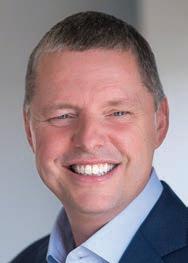
COMPANY BRIEF Sentient Jet (sentient.com) has continued to perfect the jet card model for more than 20 years as an alternative to jet ownership, fractional arrangements, and other jet card programs. Sentient Jet certifies every single aircraft, pilot, crew, and flight that flies in its program to ensure the safety of its clients. Operators are tested annually and the company’s safety standards exceed FAA Part 135 regulations in various categories. Supported by an extensive 24/7 customer service operation, Sentient Jet strives to make each private jet travel experience an extraordinary one.
Sentient Jet is one of the leading private aviation companies in the U.S. and the inventor of the Jet Card, offering clients the flexibility and convenience of flying private for their personal and business needs along with a host of unique digital booking tools, including an industry-first with instant, automated text-based booking, a unique sustainability program, and outstanding service heritage.
A Sentient Jet Card offers all the convenience, practicality, and ease that comes standard with private air travel, without the hassle, maintenance, and high costs of fractional or full ownership of a jet. Unlike traditional charter, a Sentient Jet Card gives you the flexibility of choosing the aircraft size that best fits your private jet travel needs at guaranteed, fixed rates, with consistent service levels. All Sentient Jet Card options provide you access to seamless booking, flight hours that never expire, and Safety Certified, mission capable aircraft.
How do you describe the Sentient Jet experience?
Sentient Jet was founded nearly 25 years ago on the basis of providing a more thoughtful way to fly for travelers seeking private jet travel. We offer an unparalleled safety program, with proprietary technology, 24/7 client management, a wide range of aircraft options and emissions free flying with every flight.

Throughout this time, Sentient Jet has remained steadfast in its commitment to going above and beyond to protect its cardholders, passengers, and employees. We had stringent safety and cleanliness protocols prior to the pandemic, but established a Safety Operations Task Force to expand our Sentient Certified safety protocols. We went further into the health journey by extending our certification and protocol requirements to any ground transportation we booked for our clients beyond the jet flights. Private aviation became a tool in the pandemic to get from point A to point B and Sentient Jet provided solutions for its customers from less touch points, more control, and better routes as commercial airlines reduced and canceled flight paths to smaller cities.
Additionally, the private aviation industry saw unprecedented demand throughout the pandemic and evolving buying behaviors with new fliers. In response to the COVID-19 pandemic, the adoption of digital technologies was accelerated by several years (according to a recent survey by McKinsey). This in turn caused an influx of demand for companies to adjust to scale and meet the buying behaviors of their customers in order to thrive. Today, Sentient Jet offers various digital booking tools from the mobile app to the recently launched auto textto-book. This newest innovation is the only tool of its kind in the private aviation space, requires no additional installs, and allows card owners the ability to quote and book via text message, alleviating the need for human contact entirely. Through a user-authenticated, automated,
PURPOSE
Will you provide an overview of Sentient Jet and what have been the keys to the strength of the company?
How did Sentient Jet adapt the way it works to address the challenges caused by the global pandemic?
Andrew Collins
POSTED WITH PERMISSION. COPYRIGHT © 2022 LEADERS MAGAZINE, LLC LEADERS 114 VOLUME 45, NUMBER 4
An Interview with Andrew Collins, President and Chief Executive Officer, Sentient Jet
Artificial Intelligence-like interaction, internal and external users can quote and book a flight in less than 60 seconds.
Will you discuss Sentient Jet’s global footprint and plans for expansion?
This summer we saw the return to European travel and with our new Large Cabin Jet Card, travelers can return to the EU and beyond with access to guaranteed fixed rates. Once landed in London, Sentient Jet gives travelers easy access to international territories like Paris, Zurich, Milan, and Frankfurt – guaranteed with 72 hours’ notice.

Sentient Jet places a priority on safety. Will you highlight Sentient Jet’s commitment to safety and do you feel that this is a differentiator for the company?
Sentient Jet is a leader in safety, providing card owners a high-touch private aviation experience that promotes safety, security and ease of mind. Working with only the very best operators, Sentient has invested millions of dollars in its service and safety infrastructure. Safety is so important to Sentient Jet, it has established a safety program that is one of the most stringent in the private aviation industry.

Will you elaborate on Sentient Jet’s newest digital innovation, automated textto-book, and how this will further simplify the digital transaction process for its members?
Boasting a robust digital heritage, Sentient Jet continues to innovate in the digital space as card owners embrace mobile and the desire for more straightforward transactions’ increases. For background, Sentient Jet launched a mobile app in 2016, allowing Cardholders to book private jet travel on-demand. Since its launch, Sentient Jet’s recently updated mobile application continues to have unique paths to upgrades and various automated service layers that align seamlessly with the worldclass service interactions of Sentient Jet’s senior client management teams.
Sentient Jet continues to recognize its card owners’ buying behaviors by recently creating the technology to provide instant, automated booking capabilities via text. A private aviation industry first, auto text-tobook allows card owners to book travel to and from anywhere in the world from the messaging application on their smartphone through a user-authenticated, automated, and Artificial Intelligence-like interaction. We’re big believers in the future of ‘text-based commerce’ and are working to pave the way to introduce more AI-like interactions into the travel industry using ground-breaking technology for secure, authenticated messaging. This new way of booking is a real innovation in an already incredibly dynamic and complex market.
Will you discuss Sentient Jet’s commitment to the environment and its implementation of sustainability initiatives?
In 2021, Sentient Jet launched a unique and industry-leading sustainability program that offsets 300 percent of the flight emissions on each and every customer flight at no additional cost to the traveler. Sentient Jet has already offset 291,630 metric tons of CO2 this year and it is projected that we will offset over 300 percent of emissions across 30,000 legs flown through the year. These offsets represent the equivalent of planting 345,000 acres and nearly 5,000,000 trees in the U.S. or providing the energy for an entire average U.S. town for a full year. This multi-milliondollar investment continues to set industry standards while offering a more thoughtful way to fly.
What do you see as the keys to effective leadership?
Providing guidance, communication, and company education are keys to effective leadership, especially during challenging periods. If the pandemic taught us anything, it’s that leaders must be willing to take on the difficult times. Additionally, seeing the big picture is essential, including understanding your ownership group, investor base, board of directors or partners, along with key performance indicators. My management style is direct and transparent, yet informal, and most importantly analytically driven.
What are your priorities for Sentient Jet as you look to the future?
Looking ahead, Sentient Jet will continue to prioritize and evolve its multi-million-dollar sustainability program and digital booking tools as Cardholders utilize mobile transactions on a regular basis. Internally, organizational and talent growth will remain some of our focuses while partnering with our parent company, OneSky, continues to be at the forefront of our strategy. As we look beyond the present, the future of flight and innovation guides our objectives to ultimately keep providing a more thoughtful way to fly for our customer base. Sentient Jet strives to make each private jet travel experience an extraordinary one.•
POSTED WITH PERMISSION. COPYRIGHT © 2022 LEADERS MAGAZINE, LLC LEADERS115 VOLUME 45, NUMBER 4
The Sentient Jet mobile app
































700 FIFTH AVENUE & 55TH STREET•NEW YORK • 212.397.9000 • wempe.com Hamburg Berlin Duesseldorf Frankfurt Munich London Madrid Paris Vienna
Sensuality in perfect form. SENSUAL COCOON
Finance for Good
An Interview with Elona
EDITORS’ NOTE Elona Ruka-Wright heads up Finastra’s global risk management and governance practices and is the company’s key liaison with regulatory bodies and auditors. She is accountable for Finastra’s Enterprise Risk Management framework, strategy and governance, as well as regulatory compliance, enterprise policy governance, client and thirdparty due diligence, business resilience, crisis management and internal audit. As Finastra’s Chief Risk Officer, Ruka-Wright has played a pivotal role in safeguarding the company’s employees, clients, and operations, particularly through changes related to COVID-19. She is also a sponsor of Women@Finastra. She was named one of the Top 25 Women Leaders in Financial Technology of Europe for 2021, as well as being included in the Top 100 Leaders in FinTech list by FinTech Magazine. Before joining Finastra in March 2018, she spent over 15 years building and transforming risk management, compliance, security and governance programs at Wells Fargo, U.S. Bank and Black Knight. Her certifications span CISA, CISM, CGEIT, CRISC, CIPM and CDPSE, and she serves on the Advisory Board for North Carolina State’s Poole School of Management ERM Initiative, which provides advice on ERM curriculum, emerging trends, and best practices related to ERM. She also holds a BA, magna cum laude, in
Ruka-Wright
Chief Risk and Compliance Officer, Finastra

International Relations and an MBA in Finance and Strategic Management from the University of Minnesota Carlson School of Management.
COMPANY BRIEF Finastra (finastra.com) is building an open platform that accelerates collaboration and innovation in financial services, creating better experiences for people, businesses and communities. Supported by the broadest and deepest portfolio of financial services software, Finastra delivers this vitally important technology to financial institutions of all sizes across the globe, including 90 of the world’s top 100 banks. Its open architecture approach brings together a number of partners and innovators. With a global footprint, Finastra has $1.9 billion in revenues, 9,000+ employees and more than 8,500 customers.
How do you define Finastra’s purpose and mission?
Finastra is a global provider of financial software applications and marketplaces. Core to our firm’s purpose and mission is the concept of “finance for good.” We believe in striving to right systemic inequalities that have historically been present in our financial system, and we work closely with partners and financial institutions around the world to be a positive force in this sector. That is why we are vocal about issues such as bias in artificial intelligence that
contribute to financial exclusion and the need to serve underbanked or unbanked communities.
Will you provide an overview of your role and areas of focus?

As Finastra’s Chief Risk and Compliance Officer, I lead all aspects of our global risk management and governance practices. It is also my responsibility to manage crisis situations and build strong relationships with regulators. My team and I oversee macro risks, such as cybersecurity, health and safety, and operational disruption, as well as local and regional risks, such as weather events and civil disturbances.
Will you discuss Finastra’s Enterprise Risk Management framework?
We recently implemented a new Enterprise Risk Management framework, which is part of a broader strategy that sees us balancing the need to take risks to drive ROI when it’s high, and pulling back when it’s the right thing to do. Our framework looks at our risk environment in its entirety and ensures that risk owners within our business are not only aware of the challenges, but also create and maintain controls that will allow our organization to operate within our risk appetite and tolerances.
How has Finastra safeguarded its employees, clients and operations through changes related to COVID-19?
At the onset of the pandemic, our employees’ health, safety, and well-being was our biggest priority. We moved over 95 percent of our workforce to remote working in just a few days. Since then, we’ve adopted a hybrid
PURPOSE
Elona
Ruka-Wright,
POSTED WITH PERMISSION. COPYRIGHT © 2022 LEADERS MAGAZINE, LLC LEADERS 118 VOLUME 45, NUMBER 4
“We believe in striving to right systemic inequalities that have historically been present in our financial system, and we work closely with partners and financial institutions around the world to be a positive force in this sector.”
environment in which we offer the ability to work from home alongside offices where team members can collaborate and find community. We’ve found this offers employees the flexibility they want, while still reaping the benefits of in-person teamwork.
For our clients, the pandemic and resultant closure of many bank branches drove home the need to expand digital offerings and make the shift to the cloud. We’ve continued to work with financial institutions of all sizes and across regions to drive these changes, with a focus on shoring up our clients’ safety, security, and resilience for future events that may come.
From a broader industry perspective, the events of the last few years emphasized how pivotal collaboration is to risk management in order to build and increase organizational resilience. We communicate regularly within our industry and work to maintain a peer mentality for the benefit of our clients and the broader sector.
How critical is a culture of openness and awareness as the foundation for balanced risk-taking and strong governance?
This is incredibly important – at Finastra, one of the things I value most is the strong support I feel from the Board and leadership team in making risk management a priority. When the most senior leaders understand the importance of risk management, it allows the risk team to rapidly take steps to keep up with the myriad and nuanced threats that firms across industries face today.
Making sure that the risk management team is well integrated and informed of business activity also goes a long way in ensuring strong governance. For example, when Finastra evaluates new strategic initiatives or business projects, my team and I are quick to identify risks that we would want to address straight away.
You are a sponsor of Women@Finastra. What was the vision for creating this initiative and will you highlight its impact?
Women@Finastra is part of our broader effort to make Finastra as inclusive and diverse an employer as possible. What I think stands out about the Women@Finastra initiative is that it brings both women and men together to attract, inspire, and advocate for women. The role of men in this group is critical, because we focus on celebrating and recognizing male role models at Finastra as well.
Will you discuss Finastra’s commitment to building a diverse and inclusive workforce to mirror the diversity of its clients and the communities it serves?
At Finastra, we believe that everyone should have opportunities regardless of race, gender, sexuality or special abilities, but to go further than that, we also believe that diversity truly makes us a better organization from a business perspective. We serve many different communities as a global organization and bringing on new team members with different backgrounds only improves the service we deliver for our clients.
Additionally, with the idea of “finance for good” at the core of everything we do, we’re
conscious of how historical inequities persist because of structural factors, and that building a more diverse and inclusive workforce can help our industry address major issues like this.
Do you feel that there are strong opportunities for women to grow and lead in the industry?
I do, including for women who are interested in my field. I’ve found that risk management is an excellent entry point into an organization because it allows for both visibility and insight into an organization. There are also many different ways that someone can take a career in risk management, which provides an exciting opportunity for women looking to start their careers in the financial services industry.
What advice do you offer to young people beginning their careers during this unprecedented time?
As I alluded to in my previous answer, I believe the value of positions that give you a solid vantage point to understand your broader organization – and to be seen by senior leaders –at the start of your career cannot be overstated, so I encourage young people to look for those kinds of opportunities.
Making sure that people early in their career are set up for success is also a two-way street, and I’m a strong believer in firms investing time and resources into building out their training and education programs to make the most of the talent that’s coming in the door – especially for the new generations that are coming up in a new and quickly evolving world.•
“Finastra is a global provider of financial software applications and marketplaces. Core to our firm’s purpose and mission is the concept of ‘finance for good.’”
POSTED WITH PERMISSION. COPYRIGHT © 2022 LEADERS MAGAZINE, LLC LEADERS119 VOLUME 45, NUMBER 4
“Women@Finastra is part of our broader effort to make Finastra as inclusive and diverse an employer as possible. What I think stands out about the Women@Finastra initiative is that it brings both women and men together to attract, inspire, and advocate for women.”
The Art Form of Blending

EDITORS’ NOTE Richard Geoffroy’s pursuit of beauty propelled him to the highest reaches of his profession. Born in the heart of Champagne country, he became the fifth chef de cave for Dom Pérignon Champagne and charted the course of the legendary wine for 28 years. He is now launching into a new experiment, hoping to contribute to a story started in Japan a thousand years ago: Sake. In his search for renewed harmony at IWA (iwa-sake.jp), Geoffroy pursues the dream of a grand Japanese sake, a sake absolutely true to sake – with its salient flow of sensations –yet embracing and expanded in character. A radiant sake. Such a paradoxical proposition cannot come from a single brew. It can only be achieved through Assemblage, by design. Assemblage adds a paradigm to the established paradigm of rice polishing. The more Assembled, the more harmonious. 5 is the universal number of balance and harmony, a symbol of union and quintessence. For IWA, 5 represents Assemblage.
I have been going through successive lives. A short, yet defining, one of medicine, a major one of winemaking, and presently one of Japan. I have been an active contributor to the industry during my 35 years of winemaking and it is fair to say Dom Pérignon is the charismatic leader of Champagne. That period has been exhilarating in combining the technical and the creative, in dealing with the organic under various forms to manage a local and yet universal project. I have been privileged enough to collaborate with Dom Pérignon for 28 odd years – 23 vintages – helping rejuvenate the brand on a unique equation of scale and excellence. Still, I felt I had to step outside to my comfort zone and reset on new challenges to pursue a personal quest for beauty. My new destination had to be beyond wine, yet within my scope of expertise.
What was your vision for creating IWA Sake and what excited you about this opportunity?
My vision for IWA is to crack the current mold of sake – predominantly a domestic affair –and express its immense potential out to the world. IWA is deeply and proudly rooted in Japan, and yet it is embracing and meaningful to the diversity of the cultures of the world and their cuisines. IWA has a unique ability to step outside the traditional Japanese moments of consumption.


The only way to achieve such a vision was to start from scratch and from a clean slate. This is an exciting and challenging adventure in itself as sake is one of the most established, codified, not to say conservative industries of all.
How did you decide on the name IWA for the brand?

I did not want the name to be made up. In line with our values, the name had to be authentic with a strong sense of place. We had to literally put the brand on the map. Quite simply, “IWA” comes directly from the name of the site we have elected as the soul and birthplace of the brand: Shiraiwa (in English, ‘white rock’) is located in the Toyama prefecture, west of Japan.
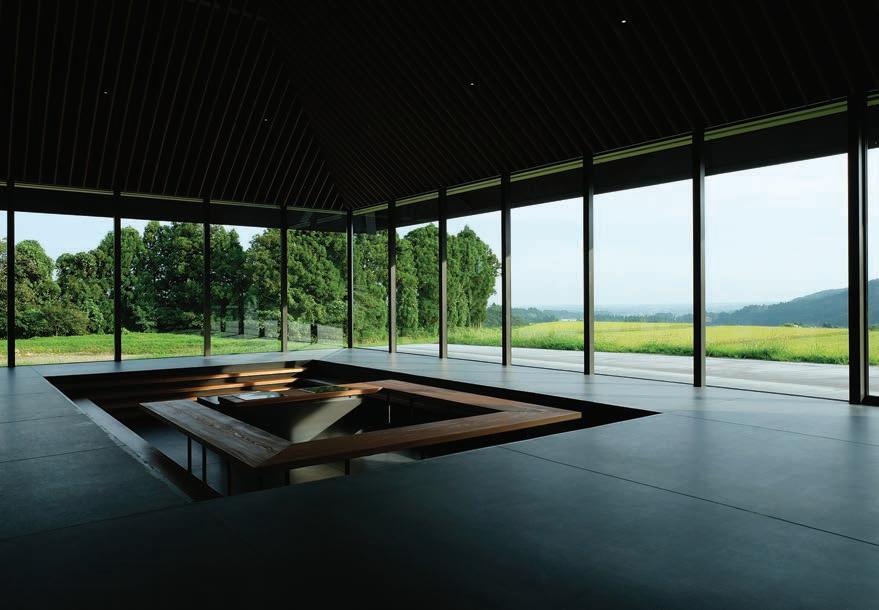
PURPOSE
Will you highlight your career as a leader in the wine and spirits industry and what has made the industry so special for you?
Richard Geoffroy
An Interview with Richard Geoffroy, Founder – Maker, IWA Sake of Japan
POSTED WITH PERMISSION. COPYRIGHT © 2022 LEADERS MAGAZINE, LLC LEADERS 120 VOLUME 45, NUMBER 4
Kura (brewery) in Shiraiwa, Japan designed by renowed Japanese architect, Kengo Kuma (above and right)
Will you discuss what consumers can expect from IWA Sake and how the brand will be positioned in the market?
IWA Sake is very singular in delivering superlative balance and complexity, two unique attributes that can only come from Assemblage – the art form of blending. We are the pioneers of Assemblage in a 1,200-year-old industry. Balance is what makes IWA relevant to various moments of consumption and to a wide range of cuisines. Beyond the home place of Japan, the personal follow-up from the greatest chefs is without precedent.

IWA Sake is definitely high-end, not to say ultra-premium. It is more “new craft” than luxury. It is about perpetual experimentation, innovation, radicality, and playfulness. This is where its premium lies.
How did you settle on the location for the home of the brand, and will you provide an overview of the property?
We chose the site of Shiraiwa for the pristine quality of its water, the beauty of its landscape, and its name – in no particular order. Designed by renowned Japanese architect Kengo Kuma, our Kura (brewery) was built in the middle of a 10 hectare piece of rice fields. We wanted a state-of-the-art Kura that is contemporary: located in open nature, in harmony with the landscape, and sheltering both production and reception under one single roof – with the same standards to the guests and to the workers. We have been inspired by the local traditional farmhouses, elaborating on their strong philosophy of community.
Do you feel that sake is well-understood around the world and what can be done to build a stronger awareness for the category?


To be honest, awareness of sake around the world is limited. I believe this actually represents a great opportunity – an opportunity to reset and make sake perceived less esoteric and more approachable by a larger audience. IWA will contribute to the cause of sake as relevant and reaching out to the large community of wine drinkers. Wine drinkers will make the success of sake.
How important is the focus on sustainability as part of IWA’s values?
Sustainability is at the very heart of IWA’s values, alongside inclusivity, horizontality, and community, far from clichés and green washing. It is going to be a long journey, and our sensible and coherent plans will be communicated in early 2023.
Did you always know you had an entrepreneurial spirit and desire to build your own brand?
I always had an entrepreneurial spirit; actually, empowerment and independence in the creative at LVMH were great. I enjoyed a unique opening to the world which eventually allowed me to mastermind IWA. I am grateful for that. Yet, at a time when I could have just retired and eased out, I had the irrepressible urge to do something completely personal and to overcome the challenge of starting my own business from scratch at the age of 68.
What are your priorities for IWA as you look to the future?
We are still in the early stage of IWA. At the moment, our priority is to keep rolling out, building the brand and expanding to new markets. We are so excited to be launching IWA Assemblage 3 in the USA this October. It is very clear to us that the extent of IWA’s overall success will depend on its success in the U.S.
In the long-term, IWA’s ambition is to make sake deservedly perceived on a par with wine, at the highest of anything, universally.•
Stainless steel brewing vats
Part of the brewery processs at Kura
POSTED WITH PERMISSION. COPYRIGHT © 2022 LEADERS MAGAZINE, LLC LEADERS121 VOLUME 45, NUMBER 4
Springtime in Shiraiwa
AN EXCLUSIVE OASIS IN THE CITY OF ANGELS
Escape to one of 18 luxurious villas ranging from a studio to a three-bedroom, nestled in our private gardens.

9882 South Santa Monica Boulevard, Beverly Hills, CA 90212 +1 310 551 2888 peninsula.com/beverly-hills
Research, Care, and Education
EDITORS’ NOTE John Lehr leads the Parkinson’s Foundation as President and Chief Executive Officer. He has nearly three decades of nonprofit fundraising and management experience, with a strong focus in the voluntary healthcare and medical research sectors. Lehr played a key role in merging two legacy Parkinson’s organizations into the Parkinson’s Foundation in 2017. Since joining the Foundation, fundraising revenue has grown each year by double digits, allowing the Foundation to greatly expand its mission programs. Lehr led the efforts to open 17 regional chapters to better serve local Parkinson’s communities. These developments and other initiatives have allowed the Foundation to earn a 4-star rating from Charity Navigator, a Platinum Seal of Transparency from GuideStar, and to be named to the 2020 list of Best Places to Work by The NonProfit Times . Lehr earned his BA and MA in history from Villanova University. From 1990-1991, he served as a Peace Corps volunteer in Sri Lanka.
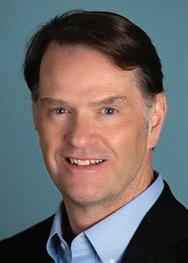
FOUNDATION BRIEF The Parkinson’s Foundation (parkinson.org) makes life better for people with Parkinson’s disease by improving care and advancing research toward a cure. In everything it does, the Foundation builds on the energy, experience, and passion of its global Parkinson’s community. Since 1957, the Parkinson’s Foundation has invested more than $400 million in Parkinson’s research and clinical care.
Will you highlight the history of the Parkinson’s Foundation and how the Foundation has evolved?

The Parkinson’s Foundation is the result of a 2016 merger of two national Parkinson’s organizations – Parkinson’s Disease Foundation based in New York and National Parkinson Foundation based in Miami. The goals of the merger were to create one larger national organization that builds on the best mission programs of each legacy organization; that achieves greater efficiencies; and that dramatically increases revenue for investment in existing and new programs benefitting people living with and affected by Parkinson’s disease (PD).
The Parkinson’s Foundation is focused on three mission pillars: research, care, and education. Six years into the merger, the Foundation has committed nearly $170 million to mission programs, achieved a mission ratio in the mid- to upper-80s range annually, and attained the highest ratings by independent nonprofit rating agencies. The Foundation has extended its reach considerably through the expansion of our research initiatives, both basic and clinical; the expansion of our Global Care Network, which today includes 51 Centers of Excellence, six Comprehensive Care Centers, and one Network of Excellence in Italy; the expansion of our online educational and resource offerings; the launching and expansion of our genetics initiative, PD GENEration: Mapping the Future of Parkinson’s Disease, which has registered more than 5,000 participants in its clinical trial; and the expansion of our Community Grants Program, which is now providing $2 million of annual funding to local organizations in nearly 40 U.S. states.
What do you feel are the most important things for people to know about Parkinson’s disease?
Parkinson’s disease is a degenerative neurological disorder that affects one million people in the U.S. and 10 million individuals worldwide. For most people, the diagnosis of PD occurs later in life, although about 5 percent of people with Parkinson’s are diagnosed with Young Onset Parkinson’s disease (YOPD) before the age of 50. No two people with PD have the same course of disease. Some may have mild motor symptoms and no cognitive deficits. Others may have rapid onset of motor and/or cognitive
symptoms, including loss of executive function or dementia. For most people, the cause of PD is unknown, but likely includes a combination of genetic, environmental, and natural aging factors. Between 10 percent and 15 percent of people with PD have a direct genetic form of the disease confirmed through genetic testing. In PD, alpha synuclein, a protein that occurs throughout the body but is concentrated in the substantia nigra of the brain, destroys dopamine neurons, leading to an array of motor, cognitive, emotional, and sensory issues. The most obvious are motor symptoms, including resting tremor, unstable gait, rigidity, and slowness of movement. Dopamine replacement therapy is the main treatment for PD, although it provides only temporary relief and must be taken continuously. It also has challenging side effects like dyskinesia, or involuntary movements. In addition to dopamine replacement therapy, exercise is one of the most effective ways of mitigating the symptoms of PD. With a combination of good medical care and exercise, people with PD can live for many years with a high quality of life.
Will you discuss how the Parkinson’s Foundation works and provide an overview of its initiatives?
The Parkinson’s Foundation is a national organization with 17 chapters across five regions. As mentioned earlier, it has three areas of focus or mission pillars: research, care, and education (for patients/carte partners and professionals). The Foundation’s vision is a world without PD. As such, it is committed to finding a cure for PD. It is also committed to ensuring that people living with the disease have access to high-quality healthcare and to information and resources they need to make the best care decisions. The Foundation raises funds through
PURPOSE
John L. Lehr
An Interview with John L. Lehr, President and Chief Executive Officer, Parkinson’s Foundation
POSTED WITH PERMISSION. COPYRIGHT © 2022 LEADERS MAGAZINE, LLC LEADERS123 VOLUME 45, NUMBER 4
“While there is no cure on the horizon today, there are many researchers working to find breakthroughs that will prevent or halt the progression of PD, while we search for the ultimate solution – a cure.”
charitable donations from individuals, foundations, and corporations and uses those funds to support its three mission programs and operations.
In research, we fund investigator- and center-led basic research looking into the underlying causes and basic biology of PD. We fund research on patient outcomes to see which interventions are having the greatest impact. We operate one of the world’s largest genetic testing studies to identify those with genetic mutations so they can participate in upcoming clinical trials.
In care, we fund a Global Care Network of Centers of Excellence and Comprehensive Care Centers that are providing care to hundreds of thousands of individuals with PD. Many of these Centers also serve as collaborators on research studies focusing on various issues such as hospitalization with PD and palliative care delivery.
In education, we have a vast array of print and digital materials that cover topics of primary concern to people living with and affected by PD, such as mobility, mood disorders, and mindfulness. Our main portal for these materials is our newly refreshed website, Parkinson.org, which received more than seven million visits last year, a new record. We also have the tollfree Parkinson’s Foundation Helpline at 1-800-4PD-INFO (1-800-473-4636), which is staffed by Helpline specialists during business hours in the U.S. and serves to answer questions in English or Spanish and make referrals.
How did the Parkinson’s Foundation adapt the way it works to address the challenges caused by the pandemic?
When the pandemic struck in early 2020, it was just before our Spring Moving Day walk season. Moving Day is our signature special event for the Foundation, hosted in nearly 50 communities across the country. It serves both as a fundraising and educational opportunity, where tens of thousands of individuals participate annually. In Spring 2020, we moved to an all-virtual event which proved to be successful given the circumstances. This gave us confidence to host more virtual events, so we also launched PD Health @ Home to provide online programming five days a week to our community. We featured mindfulness, wellness, and fitness programming. This has proved to be so successful, with hundreds of thousands participating, that we continue it to this day. Like so many other nonprofit organizations, we thought
our fundraising revenue would be adversely affected by the pandemic and economic downturn, but as it turns out, our donors remained committed and we had record-breaking fundraising years in 2020, 2021, and 2022. This has allowed us to maintain our great staff and to initiate new programs that benefit people living with PD.
How critical are metrics to measure the impact of the Foundation’s work?
Metrics are critical to everything we do at the Foundation. We have a dashboard that we update quarterly on programmatic, fundraising, operational, and financial objectives. Our most important metric is our mission ratio, which demonstrates that we are deploying funds for our mission and are providing meaningful programs to people living with PD. All our mission programs have primary and secondary goals, whether it is participant enrollment in a clinical trial or achievement of a research aim. Of course, fundraising drives our mission, so we are aggressive in goal setting. We are continually seeking to raise more revenue to invest in programs that advance our mission. Staff retention is another key metric. We believe strongly that staff continuity is critical to delivering mission, and work to ensure that our staff know they are appreciated for their contributions. In sum, we are pleased that staff retention is well-above normative ranges for the nonprofit sector.
Do you feel that there has been effective progress made in the treatment of Parkinson’s disease and what are the treatment options?
Parkinson’s disease is a very complex neurological disorder, not fully understood by the medical and scientific community. That said, there has been enormous progress made in understanding the basic biology, circuity, and symptoms of the disease over the years. People diagnosed with PD in 2022 are likely to have better health and quality of life than those diagnosed a decade ago. Today, there are more tools to treat PD than before, including better dopamine replacement therapy; surgical procedures like deep brain stimulation, which helps restore motor function; and a far better understanding of the role that diet and exercise play in maintaining health and wellness. There are also many avenues of potential discovery, including drugs targeted at specific genetic mutations. That explains in part the Foundation’s focus on
genetic testing and counseling. While there is no cure on the horizon today, there are many researchers working to find breakthroughs that will prevent or halt the progression of PD, while we search for the ultimate solution – a cure.
Did you always know you had a passion for nonprofit work and what makes the work so special for you?
I have worked nearly my entire career in the nonprofit sector, first in academic medicine (University of Pennsylvania and Children’s Hospital of Philadelphia) and then primarily in disease-specific, voluntary health (Cystic Fibrosis Foundation, CureSearch for Children’s Cancer, Parkinson’s Foundation). I have had the great fortune of working with some of the best minds in medicine and science and have seen firsthand what can be accomplished when you bring great people together from many sectors and focus on a common goal. My nearly six years at the Cystic Fibrosis Foundation (CFF) taught me that the seemingly impossible can become reality when you have a great and dedicated team, maintain focus, invest wisely, and persevere in the face of adversity. The story of CFF is well known and is still remarkable because the Foundation transformed an ultimately fatal pediatric disease into a disease where people can expect to live through adulthood. CFF’s approach was first to understand the disease as best as possible and then to invest in promising therapies that either controlled the symptoms or addressed the underlying defect. I believe a similar approach is possible in PD, and that we can transform PD from a debilitating, life-shortening disease to one that can be prevented or medically managed without symptoms. Throughout my career I have seen over and over how innovation can come from the nonprofit world. The mission motive is just as strong as the profit motive and can drive innovation forward.
What are your priorities for the Parkinson’s Foundation as you look to the future?
The priorities of the Parkinson’s Foundation over the next few years are focused on our three mission pillars. In research, we are looking for discoveries that prevent, control, and ultimately cure the disease. In care, we want to ensure that all people with Parkinson’s disease have access to equitable and quality care. In education, we want to ensure that all people affected by Parkinson’s have the information and resources they need to make the best decisions and have the best health and highest quality of life possible. We will accomplish those priorities by staying focused on people living with this disease and their needs; by collaborating with other organizations and stakeholders in academia, government, industry, and philanthropy to leverage resources for the greater good; by focusing on evidence-based and evidence-generating initiatives; and by ensuring that all our activities have maximum impact and reach. All of this will take greater awareness and resources, so we will continue to expand our messaging and fundraising
efforts to meet our goals.•
POSTED WITH PERMISSION. COPYRIGHT © 2022 LEADERS MAGAZINE, LLC LEADERS 124 VOLUME 45, NUMBER 4
“Throughout my career I have seen over and over how innovation can come from the nonprofit world. The mission motive is just as strong as the profit motive and can drive innovation forward.”
That’s 81% too many. Join us, Autism Speaks, Best Buddies and Special Olympics in creating the workforce of the future at deliveringjobs.org.
*Adults (18+) with developmental differences. Sources: World Health Organization and National Core Indicators





the 6.5M+ people with autism, intellectual or developmental differences.
81% OF US* DO NOT HAVE A PAID JOB.
Delivering Jobs is a program of Autism Speaks, Best Buddies, Special Olympics and the Entertainment Industry Foundation, each a 501(c)(3) charitabl organization.
Japanese Honor and American Innovation
EDITORS’ NOTE Debbie Freer is an Executive Officer and the Chief Operating Officer for SMBC Group in the Americas. Freer joined the company in April 2019 as Chief Strategy Officer and General Manager of the Strategy and Transformation Department. She serves as an executive sponsor for the firm’s Women’s Inclusion Network, an employee-led resource group that promotes and champions the growth, development, and success of women across the organization. She has also completed SMBC’s Global Leadership Program with The Wharton School. Prior to joining SMBC, Freer was with JPMorgan Chase as Global Head of Custody and Fund Services Product Development and Transformation. Her career includes senior leadership roles across the financial services industry. At RBC Capital Markets, she served as the Chief Operating Officer for the U.S. Investment Bank and CEO for U.S. Broker Dealers. Freer spent 22 years at Merrill Lynch, where she held various positions in operations, technology, product development, client services and trading. Other notable positions she has held include leading global client onboarding at Citigroup and serving as Global Chief Transformation Officer at UBS where she had strategic leadership responsibility for transformation programs to generate business value and support the corporation’s growth agenda. Freer serves on the Board of Directors of the Ronald McDonald House New York, an organization serving children with cancer, and acts as a senior advisor to OUT Leadership, transforming organizations on equality and social purpose. She has a BS degree in international business management from Caldwell University in New Jersey and attended Harvard Business School for additional executive education.

COMPANY BRIEF Headquartered in Tokyo and with a 400-year history, SMBC Group offers a diverse range of financial services, including banking, leasing, securities, credit cards, and consumer finance. The Group has more than 140 offices and 86,000 employees worldwide in nearly 40 countries. Sumitomo Mitsui Financial Group, Inc. (SMFG) is the holding company of SMBC Group, which is one of the three largest banking groups in Japan. In the Americas, SMBC Group (smbcgroup.com) has a presence in the U.S., Canada, Mexico, Brazil, Chile, Colombia, and Peru. The Group offers a range of
commercial and investment banking services to its corporate, institutional, and municipal clients. The Group’s operating companies in the Americas include Sumitomo Mitsui Banking Corp. (SMBC), SMBC Nikko Securities America, Inc., SMBC Nikko Securities Canada, Ltd., SMBC Capital Markets, Inc., SMBC Rail Services LLC, Manufacturers Bank, JRI America, Inc., SMBC Leasing and Finance, Inc., Banco Sumitomo Mitsui Brasileiro S.A., and Sumitomo Mitsui Finance and Leasing Co., Ltd.

Will you highlight the history of SMBC Group in the Americas?
SMBC Group globally is more than 400 years old. We began operating in the Americas in San Francisco in 1916 and then in New York in 1918. Throughout the past 100 plus years, we grew steadily, adding locations and businesses throughout the United States, Canada, and Latin America. Our solutions span corporate, institutional, and municipal clients’ needs across commercial and investment banking. We are now adding a fully digital consumer bank with fully human customer service. Even in times of economic downturn, SMBC has stood strong with its clients and continued to grow. That resilience is pretty impressive.
What have been the keys to SMBC’s strength in the Americas and how do you define the SMBC difference?
There are several strengths to our business in the Americas, all contributing to the reasons
I find this work so exciting every day. First, it’s the people. People always make the difference. The dedication to our clients and being a part of growing this business in the Americas is evident throughout our front, middle, and back-office teams. Developing deep and long-lasting relationships with our clients and across our workforce is built into our corporate DNA. This is not a company that relies on off-the-shelf solutions. Our clients are real people with businesses that serve a wide swath of industries and societal needs. We learn about each of them, know their industry and their strategy, understand their motivation and end goals, and we find unique ways to meet their unique needs.
There’s a reason we’re the global leader in project finance and have won several awards in the Americas. We are a combination of Japanese honor and American innovation. Our company is committed to what our founders expounded: no matter how difficult, always do the right thing by society and business success will come. This has carried over to today and is evident in our leadership toward a better and more sustainable world. We help our clients build sustainable businesses with smart solutions, insightful advice, and unmatched service.
Will you describe your role and areas of focus?
As the Chief Operating Officer at SMBC, I deal with all operations, people management, and governance for the region. I have the ultimate responsibility to ensure that our infrastructure, staffing, and processes are sufficient to carry out the organization’s strategy. My team
PURPOSE
Debbie Freer
An Interview with Debbie Freer, Chief Operating Officer, SMBC Group in the Americas
POSTED WITH PERMISSION. COPYRIGHT © 2022 LEADERS MAGAZINE, LLC LEADERS 126 VOLUME 45, NUMBER 4
“We are a combination of Japanese honor and American innovation. Our company is committed to what our founders expounded: no matter how difficult, always do the right thing by society and business success will come.”
and I also ensure we manage our daily activities in a safe and sound manner. This includes our people, technology, cybersecurity, business controls, and corporate services. In addition, I monitor the execution of key projects that align to SMBC Group’s mid-term plan and strategy – including the implementation of Target Operating Models that support our combined U.S. Operations governance model. Key components of this include our operational resilience and third-party management programs that ensure the resilience of our U.S. Operations from disruptions in the market or other external events.
Where do you see the greatest opportunities for growth for SMBC Group in the Americas?
The interesting thing is that the more creative we get and the more diverse we become, the more opportunities become apparent. Our people make the horizon limitless. SMBC has a diverse set of businesses in the Americas, and we’re fortunate to see opportunities across our portfolio. Our business is particularly focused on the integration of our Corporate and Investment Bank structure, the growth of our sponsors and financial institutions businesses, the integration of our cash and derivatives sales and trading business, the adoption of new strategic partnerships (as with Jefferies and Marathon Capital), and the launch of our digital banking business. Our ESG and Sustainable Finance efforts also present attractive growth areas aligned with the company’s values. All business groups within the Americas are stepping up and contributing. We have an advantage of being able to operate in the local and regional markets while connecting those markets to our broader global network, and vice versa. It’s really a symbiotic relationship that works well for clients and for us. I expect to continue to see high growth delivered by the Americas, regardless of the global economy.
How critical is it to build a diverse and inclusive workforce?
Very critical. Any firm that wants to be a long-term player in a global playing field must keep up with the times and recognize the tremendous value a diverse workforce brings, not only to expand markets and client base,
but also to bring different types of experiences, cultures, and thinking to the table with a voice that leads to breakthrough thinking, creative solutions, and new businesses. In my experience, the most successful teams draw on diversity of thought and background. Personally, I’ve been a champion of our gender diversity and LGBTQ+ employee networks, am a strong proponent of our disability and mental health education network, and have hired numerous veterans throughout the years. The people make it real, viable, and contribute to the next generation. We are steeped in tradition, but no company lasts more than 400 years globally – more than 100 years in the Americas – without recognizing the changing marketplace and the changing faces of clients and talent. So, diversity is a key goal for SMBC and our Diversity and Inclusion team is a critical component of our HR function. Taking it to the next level is creating an inclusive environment, where all have a voice, all are respected, all feel valued, and all are able to contribute with their strengths. We foster an inclusive environment. It’s part of our culture and engrained in our colleagues throughout the Americas.
Do you feel that there are strong opportunities for women to grow and lead in the industry?
Absolutely – not only in the industry broadly but, specifically, at SMBC. Women make up more than 50 percent of the population, but do not hold nearly the same percentages in leadership positions in this or most other industries – yet. The last few years have shined a spotlight on women’s roles in business and this is accelerating the rate of change and numbers of women in leadership positions, though still not nearly enough. But we will get there. The number of women in our senior leadership ranks is strong and growing. I strongly believe that women need to help women and be mentors to those coming up. Ultimately, we all need to take responsibility for our own careers and success, but make sure you network, do your job completely and fully, and if you need help, ask for it. When given the opportunity, women do very well in business, both in front office and support functions. I’m
proud that SMBC is dedicated to a longstanding global initiative to hire and promote more women throughout the company. This year was the first year for a global event – all geographies, all offices – for International Women’s Day to both celebrate and promote greater understanding. So yes, there are strong opportunities, but like everything in life, it’s what we make of them and how we support one another throughout the journey.
What do you see as your company’s responsibility to the communities it serves and to be a force for good in society?
SMBC’s founders were clear in their principle to always do the right thing by society, understanding that business success will follow in the long-term. We follow that same principle today. Differentiation comes through the people who work for us and the deep, long-lasting relationships we build with our clients and our employees. Creating and supporting sustainable business practices for ourselves and our clients is a large part of our business. We fund sustainability initiatives for clients and have strategists who can help them form their sustainability strategy and projects. Doing what’s right by society and the environment, ensuring sustainability for future generations, falls into that “right thing to do” category. We also encourage philanthropy that impacts our communities. For instance, I serve on the Board for the Ronald McDonald House New York, an organization serving children with cancer, and I am also a senior advisor to OUT Leadership, transforming organizations on equality and social purpose. I think it’s important that our business, our charitable giving, and our time make a positive difference.
What are your priorities for SMBC Group in the Americas?
As we move forward together in the Americas, my vision for the firm is one of a strong, dynamic global financial institution, differentiated by our people, the culture we continue to live and enhance, and the solid relationships we form and nurture with our clients. This means employing seamless unity and sticking closely to our values which include client focus. At the same time, as COO, I know we have to remain vigilant about our expenses and are constantly looking for opportunities to innovate and leverage new technologies and automation where it makes sense. Protecting and enhancing our reputation and our brand are also on the agenda. I am passionate about our transformation initiative to grow our businesses in line with our stated risk appetite. I employ a proven five-pillar transformation model, supported by robust governance and centralized management information dashboards, that I continue to leverage to evaluate our people, process, and technology. The key to success rests not only in strong management buy-in and ongoing governance, but also in being open and communicating frequently with all employees. People are what make a transformation successful, and I am so proud of what we’ve accomplished to date and look forward to the rest of the journey.•
POSTED WITH PERMISSION. COPYRIGHT © 2022 LEADERS MAGAZINE, LLC LEADERS127 VOLUME 45, NUMBER 4
“Our people make the horizon limitless. SMBC has a diverse set of businesses in the Americas, and we’re fortunate to see opportunities across our portfolio.”
Bringing People Freedom
An Interview with Troy Pospisil, Founder and Chief Executive Officer, Ontra
EDITORS’ NOTE Troy Pospisil is the Founder and CEO of Ontra. Prior to Ontra, he worked in private equity investing at H.I.G. Capital. Earlier, he worked in management consulting at Monitor Deloitte. Pospisil holds a BA from New York University.

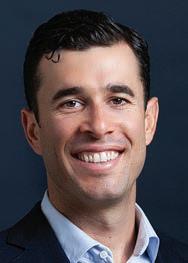
COMPANY BRIEF Ontra (ontra.ai) is the global leader in contract automation and intelligence for private asset management firms. The Ontra platform combines AI-enabled software with a worldwide network of highly trained lawyers to modernize recurring legal workflows. Ontra’s solutions improve all aspects of the contract lifecycle – from negotiating and processing routine contracts to tracking obligations in complex agreements. Ultimately, Ontra reduces the time, expense, and risk associated with contract management, freeing its customers to focus on other strategic priorities. Ontra is headquartered in San Francisco, with global operations across North America, Europe, and Asia.
What was your vision for founding Ontra and how do you define the company’s purpose?
Our founding vision was to build novel solutions to the most painful problems in contracting using cutting-edge technology and innovative labor models and then to use those ingredients to build one of the legal industry’s largest, most-respected companies.
As for our purpose, we are on a mission to bring people freedom. We’re working hard
Pospisil
to free our customers and legal partners from routine, but complex work. By blending artificial intelligence and a global network of talented lawyers, Ontra reduces the time, expense, and risk associated with contract management, freeing our customers to focus on other strategic priorities.
Will you provide an overview of Ontra’s services and solutions?
Ontra is the global leader in contract automation and intelligence. The Ontra platform combines AI-enabled software with a global network of highly skilled lawyers to offer a comprehensive and scalable solution for recurring legal workflows, such as negotiating routine contracts and tracking obligations in complex agreements.
Ontra delivers purpose-built contract workflow and data management tools to easily manage contractual obligations, rapidly identify key provisions, and analyze trends and benchmarks. By streamlining legal processes and transforming contracts into structured data, Ontra lowers costs, improves quality, increases efficiency, and provides actionable insights, ultimately freeing our customer’s legal department to focus on more impactful and engaging work.
Where do you see the greatest opportunities for growth for Ontra’s business?
I see a significant opportunity in automating high-volume, routine contracts for global businesses. Over the past eight years, we’ve built the best solution, hands down, for automating highvolume, routine contracts for businesses. We deliver a comprehensive solution that covers contract markup, negotiation, and obligation tracking.
We’ve also built a global offering, with operations in North America, South America, Europe, Asia, and Australia — allowing us to process contracts in over 10 languages and deliver world-class turnaround times across time zones. Our customers include some of the largest, most sophisticated companies in the world, including BlackRock, Hilton, and Macquarie. However, there is a long list of companies we don’t work with yet that would derive a massive amount of value from our contract automation solution.
Another opportunity is in contract obligation management. We recently launched Insight, the first purpose-built SaaS solution for managing obligations in complex contracts. We launched the product with a focus on fund documents for private fund asset managers that need to comply with the thousands of obligations and restrictions agreed to in their Limited Partnership Agreements and Side Letters.
We’re about to launch a horizontal solution that will allow our customers to easily track, manage, and analyze terms in any complex agreement. We’re excited about deploying Insight for the next few document types, including credit agreements, purchase and sale agreements, and operating agreements. We’ll partner with our customers to identify the many ways Insight can help track and manage obligations across a broad universe of important contracts.
How critical is it for Ontra to build a diverse and inclusive workforce?
Building a diverse and inclusive workforce is priority one, two, and three for our recruiting team. Any company that wants to solve complex
PURPOSE
Troy
POSTED WITH PERMISSION. COPYRIGHT © 2022 LEADERS MAGAZINE, LLC LEADERS 128 VOLUME 45, NUMBER 4
“Ontra is the global leader in contract automation and intelligence. The Ontra platform combines AI-enabled software with a global network of highly skilled lawyers to offer a comprehensive and scalable solution for recurring legal workflows, such as negotiating routine contracts and tracking obligations in complex agreements.”
problems in creative ways will only do that effectively with a diverse workforce. Differing backgrounds and experiences lead to more creative thinking and solutions. Ultimately, a diverse workforce creates a competitive advantage.
Establishing a diverse team early also creates a positive feedback loop for company culture and performance. Working with people from diverse backgrounds who think differently, challenge each other, and help each other grow is more fun and creates a culture of learning and creativity. That fun and creative culture then allows us to do a better job of retaining and attracting talent.
As every leadership team knows, there’s a war for talent. Anything leaders can do to make a company a more rewarding place to work and positively impact retention and recruiting is incredibly valuable.
What do you see as Ontra’s responsibility to the communities it serves?
Everyone who works at Ontra is incredibly lucky to be in the position they’re in. We have good salaries and benefits, work with a great team, and get to solve interesting problems. We also participate in a thriving corporate legal ecosystem that has allowed us to build a successful business. We don’t take that for granted, which is why we try to use our fortunate position to bring awareness to those who don’t derive the same benefits from the legal system due to lack of access and inequality. We do this through our Dollar a Document program and by using our platform to educate the corporate legal community about the access to justice issue and why it’s so important to all of us.
Separately, we take the stability and sustainability of our business incredibly seriously. We have employees whose families rely on Ontra for their income, customers who have trusted us to implement solutions for mission-critical business processes, and vendors that we’ve made commitments to. Maintaining sustainable economics and a healthy balance sheet has always been very important to us, so we can be confident we’ll be here for many decades. That’s why we’ve taken a somewhat unconventional path to fundraising for a high-growth technology company. We were bootstrapped for five years and have only brought in investment partners philosophically aligned with our commitment to building a great company over the long term.
Will you discuss Ontra’s commitment to justice equity and elaborate on its Dollar a Document program?
At Ontra, we recognize that our justice system systematically disadvantages many underprivileged Americans. Many people encounter significant and life-altering legal issues every year without the benefit of a skilled lawyer, and we feel everyone can participate in helping to right this wrong. That’s why Ontra launched our Dollar a Document program on July 1, 2021.
We designed the program to support many of the 132 vetted nonprofit legal aid organizations under the Legal Services Corporation (LSC). These organizations work with underserved communities in areas like domestic violence, employment discrimination, opioid addiction, veterans’ justice, and disaster recovery.
We’ve donated over $80,000 to 54 organizations under the LSC umbrella based on documents processed between July 1 and December 31, 2021. We are thrilled to watch our business grow, which enables us to donate more in the years to come.
Did you always know that you had an entrepreneurial spirit and desire to build your own company?
I was always very entrepreneurial and started a number of small businesses in high school and college, one of which I sold. After college at NYU, I worked in management consulting at Deloitte and then in private equity investing at H.I.G. Capital. I decided to leave a job I liked to build Ontra for two primary reasons: First, I wanted the opportunity to be creative in my professional life – to have the freedom to come up with new ways of approaching problems and to build and scale solutions that have a positive impact on customers. Second, I wanted the opportunity to build a team and a culture that aligned with my values. There is nothing more important to me than our company values and making sure everything we do as a company aligns with them.
Do you take moments to reflect and appreciate what you have built or are you always looking at what is next?
I’m a “what’s next?” person. Even after eight years, it still feels like day one here at Ontra. We have so many ideas, so many opportunities, and such an incredible team. I’m proud of what we’ve built, but I’m so much more excited for what we’re going to build in the decades to come.•
“As for our purpose, we are on a mission to bring people freedom. We’re working hard to free our customers and legal partners from routine, but complex work.”
POSTED WITH PERMISSION. COPYRIGHT © 2022 LEADERS MAGAZINE, LLC LEADERS129 VOLUME 45, NUMBER 4
“At Ontra, we recognize that our justice system systematically disadvantages many underprivileged Americans. Many people encounter significant and life-altering legal issues every year without the benefit of a skilled lawyer, and we feel everyone can participate in helping to right this wrong.”
Inclusive Hiring
An Interview with Brandon Ammons, Program Manager, Delivering Jobs
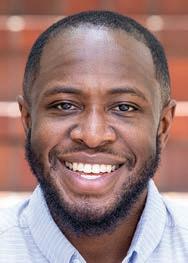
EDITORS’ NOTE Brandon Ammons serves as the Program Manager for Delivering Jobs, a campaign of the Entertainment Industry Foundation. Delivering Jobs is an unprecedented collaboration between Autism Speaks, Best Buddies, and Special Olympics that builds pathways for employment for neurodiverse people across the country. In his role as Program Manager, Ammons provides resources to job seekers, employers, caregivers, and communities and amplifies stories and lived experiences that are changing the narrative around hiring inclusively. In 2017, Ammons joined the Entertainment Industry Foundation, where he worked closely with a colleague with Down syndrome. The experience inspired him to deepen his commitment to supporting people with neurodifferences and led to his promotion to Program Manager for Delivering Jobs. Ammons graduated from Morgan State University before relocating to Los Angeles, where he received his master’s degree in Communication Management at the University of Southern California.
CAMPAIGN BRIEF Delivering Jobs is an inclusion campaign designed to create pathways to one million employment and leadership opportunities for people with intellectual and/or developmental differences by 2025. The campaign aims to build inclusive workplaces through consumer awareness, community activation, skills development, job preparedness and workforce readiness. Neurodiversity is increasingly a key demographic for inclusion in the workforce, and the website deliveringjobs.org provides resources for employees and employers, including toolkits, an accessibility checklist, case studies, and more. Formed by a coalition of nonprofits and the Entertainment Industry Foundation, Delivering Jobs aims to change the narrative on inclusive hiring.
What was the vision for creating Delivering Jobs and how do you define its mission?
Autism Speaks, Best Buddies, and Special Olympics – three powerhouse organizations that have advocated for and advanced the
mission of inclusion for people with intellectual and/or developmental differences – joined together with the Entertainment Industry Foundation to form a groundbreaking collaboration to create opportunities for employment for the neurodiverse community. More than 80 percent of people with developmental differences do not have a paying job. Though the spotlight on diversity and inclusion in the workforce is brighter than ever, 6.5 million capable candidates are without work.
The goal of Delivering Jobs is to motivate employers to hire this qualified labor force, engage the public to cultivate communities supportive of inclusion, and ultimately create pathways to one million employment and leadership opportunities for people with autism, intellectual and/or developmental differences by 2025.
Will you discuss how Delivering Jobs works and provide an overview of its initiatives?
Delivering Jobs’ approach to increasing employment opportunities involves neurodiverse people, employers and their HR professionals, and the public all working together toward resolution. Delivering Jobs equips people with autism, intellectual and/or developmental differences with the resources they need to strengthen leadership skills and prepare for jobs and leadership positions. Simultaneously, we motivate employers to hire this qualified labor force by offering workplace development resources and highlighting their progress. Additionally, we engage the public to increase awareness about the low rate of employment for people with intellectual and/or developmental differences and challenge them to advocate for inclusion and equality.
Storytelling is a critical element of our work and garners a tremendous response from its reach. The PSAs created by EIF have received more than two billion media impressions and have earned a Telly Award and two Anthem Awards. Most importantly, 90 percent of the cast and crew of those awardwinning PSAs were neurodiverse, highlighting a determined, productive, and stellar workforce and underscoring the mission of Delivering Jobs.
How did the partnership between Autism Speaks, Best Buddies, and Special Olympics come together with the Entertainment Industry Foundation to develop this campaign?
These four organizations working individually have successfully impacted millions of people with their efforts toward inclusion. Autism Speaks is dedicated to promoting solutions, across the spectrum and throughout the life span, for the needs of individuals with autism and their families through advocacy and support, increasing understanding and acceptance of people with autism, and advancing research into causes and better interventions for autism spectrum disorder and related conditions. Best Buddies is dedicated to establishing a global volunteer movement that creates opportunities for friendships, integrated employment, leadership development, and inclusive living for people with intellectual and/or developmental disabilities. Special Olympics transforms lives through the power of sports, helping people with intellectual and/or developmental differences discover new strengths and abilities, skills and success, and ultimately delivering joy, confidence, and fulfillment on the playing field and in life. These three organizations each spotlight employment in their efforts toward inclusion, but their collective strength and reach toward a single message amplifies awareness and creates a cohesive movement to change the narrative around inclusive hiring.

EIF occupies a unique place in the world of philanthropy. By mobilizing and leveraging the powerful voice and creative talents of the entertainment industry, EIF helps to amplify the message of Delivering Jobs across media platforms to reach people across the country and around the world.
How critical are metrics to measure the impact of Delivering Jobs’ work?
Measuring the impact of our work is vital to the campaign’s success. Data and metrics allow us to determine how much, and how quickly, the tide is changing towards inclusive hiring of the neurodiverse community.
How valuable has it been to build a network of ambassadors for the work of Delivering Jobs?
The passion, commitment, leadership, and positivity that our ambassadors bring to the
PURPOSE
Brandon Ammons
POSTED WITH PERMISSION. COPYRIGHT © 2022 LEADERS MAGAZINE, LLC LEADERS 130 VOLUME 45, NUMBER 4
work of Delivering Jobs brings us ever closer to our goal. Holly Robinson Peete has been a crusader for people with autism for decades and offered her talent to the campaign by starring in our award-winning PSA. Joey Travolta, who founded Inclusion Films to train neurodiverse people for employment in entertainment, secured our cast and crew for both of our PSAs. From Paralympian swimmer McKenzie Coan and NBA player Ricky Rubio to actress (and EIF employee) Caley Versfelt to Robert Varnedoe, CEO of Lee Container, who is driving change in the manufacturing sector, each of our ambassadors is instrumental in sharing the powerful success stories of hiring inclusively.
Do you feel that there has been effective progress made in the effort to create employment and leadership opportunities for people with autism, intellectual and/or developmental differences, and what more can be done to drive sustainable change in this cause?
We are making substantive progress. Launching an employment initiative in January 2020 as a global pandemic unfurled proved challenging, but it allowed us to share the message of Delivering Jobs during a time when companies were reevaluating their workforce and organizational plans for the future.
Companies are responding to the message of inclusive hiring. Human Resource professionals
are striving to improve hiring practices by tailoring the interview process to allow neurodiverse candidates to best demonstrate their qualifications. Companies are more diligent in educating employees to facilitate a positive and empathetic work environment which is essential to success. More job training programs are being created for people with neurodifferences to prepare them for the workforce, and society is embracing the idea of inclusion like never before.
The Harvard Business Review reported that companies that employ people with intellectual differences see positive business impacts, such as improved morale, enhanced products and services, and increased bottom lines. Delivering Jobs aims to capture those individual stories and amplify them. When companies see the effects of inclusive hiring, it inspires them to create change within their own organizations.
What excited you about the opportunity to lead Delivering Jobs and how do you focus your efforts as program manager?
Prior to leading this campaign, I was fortunate to have the opportunity to manage a young woman who has Down syndrome. It was my first managerial experience, and honestly, I was nervous. I didn’t feel qualified to manage a person with neurodifferences, but the experience of working with Caley changed my life. She is our front desk administrator, and she’s exceptional in her role. She brings warmth and joy to our visitors and colleagues, and we’re lucky to have her on our team. Caley is qualified, loyal, reliable, and an asset to the company. The experience of working with someone who is neurodiverse revealed to me how significantly someone who thinks differently can impact and improve a company and its culture.

As program manager of Delivering Jobs, I work closely with Autism Speaks, Best Buddies, and Special Olympics to compile the entirety of their resources for employment that we share with job seekers, employers, caregivers and communities, primarily through our website at deliveringjobs.org. We have developed toolkits and provided a comprehensive database of information dedicated specifically to the employment of neurodiverse people. In addition, I seek out new ways to share stories that effect change. Delivering Jobs has benefited tremendously from our PSAs across radio and television.
What are your priorities for Delivering Jobs as you look to the future?
In the past two years, we’ve seen a sea change in hiring practices. Perhaps for the first time, companies and individuals truly understand the importance and the benefits of hiring inclusively, but to be truly inclusive, they must consider and prioritize neurodiverse talent. Delivering Jobs will continue to center and amplify the stories of people with intellectual and/or developmental differences who are seeking the economic opportunities available to other American citizens. •
POSTED WITH PERMISSION. COPYRIGHT © 2022 LEADERS MAGAZINE, LLC LEADERS131 VOLUME 45, NUMBER 4
John Tucker and Caley Versfelt on the set of the award-winning Delivering Jobs PSA
Delivering Memorable Experiences
An Interview with Brett
EDITORS’ NOTE Brett Reizen co-founded EBG in 2001 and led its transition from a small tech start-up to one of the largest, privately held e-commerce companies specializing in travel and entertainment in the United States. Prior to co-founding EBG, Reizen was the Senior Business Development Manager for EnSpot.com, an Internet marketing company that managed online promotional campaigns for movie studios, national concert tours, Broadway shows, and large entertainment venues. Reizen received a bachelor’s degree in business administration from the University of Miami.
D. Reizen
COMPANY BRIEF EBG (ebgsolutions.com) is an e-commerce solutions provider specializing in travel and entertainment, and also offers retail products and services, voluntary benefits and insurance. EBG powers a robust portfolio of technology solutions and operates a network of employer and membership-based platforms reaching a captive audience, providing leading brands with incremental distribution opportunities. EBG’s expanded network reaches over 100 million users from participating companies and closed loop affinity and membership groups. EBG owns and operates one of the largest and most comprehensive employee savings programs in the country – serving over 40,000 corporate clients through its proprietary platforms TicketsatWork, Plum Benefits,
and Chief Executive Officer,

Working Advantage, and Beneplace. EBG is a b2b2c company headquartered in Miami (Aventura), with offices in New York, Orlando, Austin, and Las Vegas.

What was your vision for founding EBG and how has the company evolved over the past 20 years?
The concept for the business came at a time when travel was reeling from the events of September 11, 2001. My vision was to bring fun and happiness back to the workplace by offering entertaining experiences for people to enjoy, while also fueling growth for the travel and entertainment industry. The goal was to create an innovative way to connect the world’s greatest travel and entertainment brands to businesses and their employees with unique and special offers – always at an affordable price. This was an untapped market and ripe with opportunity.
We are a very different company than we were 20 years ago and I’m proud of that evolution. We have strategically acquired or merged with prominent organizations that have contributed to our growth. We have further fueled our growth through strong investments from Creative Artists Agency (CAA) and the Shubert Organization, and their support and guidance have helped EBG grow tremendously. Also, we have been diligent in building a team of experienced and dedicated employees who believe in innovation and hard work.
How do you define EBG’s mission and purpose?
It is crucial for us to consistently deliver memorable experiences for our customers, as well as exceed the expectations of our clients and partners. EBG’s success has been fueled by strong relationships with industry leading suppliers, innovating our technology to deliver solutions for clients and partners across our network of platforms, by increasing sales volume and keeping our customers excited and satisfied. None of this can be done without an incredible team of people to execute on the mission and bring fun, optimism, and innovation to work each and every day.
How important has it been for EBG to maintain its culture as the company has grown in size and scale?
We launched EBG out of a garage in Fort Lauderdale in 2001. We had to be tenacious and innovative to survive and grow, but we were also having a lot of fun. Twenty years later, we’re still enjoying the ride, but we’re no longer in a garage. In fact, we have expanded our team to more than 250 team members in five offices; however, as the team has grown, we’ve maintained our ability to be agile, move swiftly and continue to have a growth mindset that there is always more we can do.
Will you provide an overview of EBG’s solutions and where you see the greatest opportunities for growth?
We are unique in that our technology powers solutions for employers – HR/Benefits providers who want to offer a discount platform
PURPOSE
D. Reizen, President
EBG
Brett
POSTED WITH PERMISSION. COPYRIGHT © 2022 LEADERS MAGAZINE, LLC LEADERS 132 VOLUME 45, NUMBER 4
“We have strategically acquired or merged with prominent organizations that have contributed to our growth. We have further fueled our growth through strong investments from Creative Artists Agency (CAA) and the Shubert Organization, and their support and guidance have helped EBG grow tremendously.”
for their employees. We power solutions for membership groups – we white label our technology for organizations to enhance their member benefits with travel and entertainment offers we source through supplier partners. And, lastly, we help brands in travel, entertainment, and retail distribute their products and services through our network of closed loop employer and membership-based platforms.
For the next three to five years, our expanding list of offerings is showing great growth potential, including flights, vacation rentals, cruises, and additional hotel inventory and functionality. We’ll also continue to expand our marketplace of products and services, including voluntary benefits and insurance.
How did EBG adapt the way it works to address the challenges caused by the pandemic?
Since 2010, EBG has successfully enjoyed revenue growth of at least 20 percent every single year (until the pandemic hit in 2020). When the pandemic shut down travel and entertainment, our core business stopped overnight. We quickly switched gears to focus on and expand the available products and services that people desperately needed at the time. This included laptops and other “work from home” items, grocery delivery, the Calm app, Sam’s Club membership, and more. Our ability to be strong and nimble kept us going. During this time, we invested in expanding the travel platform and have since launched new verticals, including discounted flights, vacation rentals, specially priced vacation packages and thousands of more hotels.
The travel and entertainment sector continues to improve, and we are helping people fulfill the strong desire for travel, vacations, fun, and family. Helping our customers enjoy life again is a great feeling.
How proud are you to see the strength and resilience of your team during this challenging and uncertain time?
I am truly grateful and inspired by our employees’ ability to pivot, duck, and swoop to keep EBG moving forward during the pandemic. With so much uncertainty, I think our collective focus helped to keep all of our chaotic lives grounded. I’m humbled by the team’s dedication to stay positive and open-minded and I’m so proud of what we accomplished together.
Why did EBG choose to refresh the brand?
We felt the brand refresh was a timely way to showcase EBG’s tremendous growth and celebrate 20 years in business. We want to communicate our position as a solutions provider for employers, membership groups and retail brands through a bold and fresh visual identity that embodies our vibrancy and strength.
How critical is it for EBG to build a diverse and inclusive workforce to bring diverse perspectives and experiences to the table when making business decisions?
We have observed that when employees are included in organizational discourse and treated equitably, they are more productive and stay with the company longer. More than that, EBG seeks to provide solutions to organizations across the country that employ diverse
workforces. We want to communicate to those organizations that we value diverse perspectives, and we can accomplish that by demonstrating our commitment to diversity, equity and inclusion both internally and externally. We want our partners to see us as an organization that recognizes how a representational workforce can enhance our awareness of the needs of our valued clients and partners.
What do you see as EBG’s responsibility to the communities it serves and to being a force for good in society?
We know that we are fortunate to be in an industry we love, doing work that is fun and rewarding, so whenever we find opportunities to give back in the communities we work in, and to help causes in need, we find ways to give back. We also look internally and encourage our employees to give back through a day of giving so they can also support causes or activities that are important to them.
What do you feel are the keys to effective leadership and how do you describe your management style?
We need to be able to prioritize the business and opportunities that allow us to scale and grow. This requires a management style in which we can make decisions quickly and evaluate opportunities collaboratively, while balancing our needs for growth, a strong culture, and satisfied, strong and dedicated team members. I have always believed that leadership requires a positive attitude, adaptability and resilience, which has helped our organization flourish over the last 20 years.•
“My vision was to bring fun and happiness back to the workplace by offering entertaining experiences for people to enjoy, while also fueling growth for the travel and entertainment industry.”
POSTED WITH PERMISSION. COPYRIGHT © 2022 LEADERS MAGAZINE, LLC LEADERS133 VOLUME 45, NUMBER 4
“For the next three to five years, our expanding list of offerings is showing great growth potential, including flights, vacation rentals, cruises, and additional hotel inventory and functionality. We’ll also continue to expand our marketplace of products and services, including voluntary benefits and insurance.”
Changing the World Through Wine
Co-Founder and Chief Impact Officer, ONEHOPE


EDITORS’ NOTE Kristen Shroyer is the Co-Founder and Chief Impact Officer at ONEHOPE (onehopewine.com). Through in-home and virtual wine tasting experiences, ONEHOPE empowers its customers to share wine and give hope to the people and causes that matter most to them. To date, ONEHOPE has donated over $8.5 million to 35,000+ local nonprofits. Recently, ONEHOPE opened its flagship state-of-the-art winery in Rutherford, the heart of Napa Valley. Since launching ONEHOPE in 2007, Shroyer has helped grow the brand from zero to 1.5 million bottles a year – making it one of the top 250 wineries by volume in the United States. ONEHOPE has received recognition in Inc. Magazine as one of the fastest-growing private companies nationwide thanks to their innovative DTC model powered by 10,000+ independent consultants. The company is on track to soon become the largest DTC winery in the U.S.
How do you define ONEHOPE’s mission and purpose?
Our mission at ONEHOPE is to share wine and give hope, which fulfills our purpose to nourish the future. We believe that wine is a powerful product that brings people together. We proudly donate 10 percent of every purchase to a cause personally selected by our customers. To date, ONEHOPE has donated over $8.5 million supporting 35,000+ nonprofits.
Will you discuss ONEHOPE’s impact and its efforts to empower Cause Entrepreneurs?
Through our Cause Entrepreneur platform, anyone can join our efforts to change the world through wine. Additionally, our Cause Entrepreneurs earn an income, receive training and wine education, and network with likeminded individuals. In addition to the impact we make, ONEHOPE is incredibly proud to have brought 10,000+ women into the wine industry.
How critical has ONEHOPE’s winery been in helping to fulfill the vision for the brand?
Our winery is truly the home of our brand and a physical manifestation of our vision. Just as our Cause Entrepreneurs bring people together in their local communities, our winery and tasting room is no different. At our 2019 Harvest Party, in one single night we raised enough money to fund two schools in the developing world.
We invite guests to apply to become 20/20 Collective Visionaries. Visionaries are granted exclusive access and use of the winery and tasting room, invites to one-of-a-kind events, memorable food and wine experiences, small-lot wine allocations, and savings on our most soughtafter wines. Every visionary helps us change the lives of an entire community by funding water projects with charity: water.
Having our own working winery also allows Mari Wells Coyle, our head
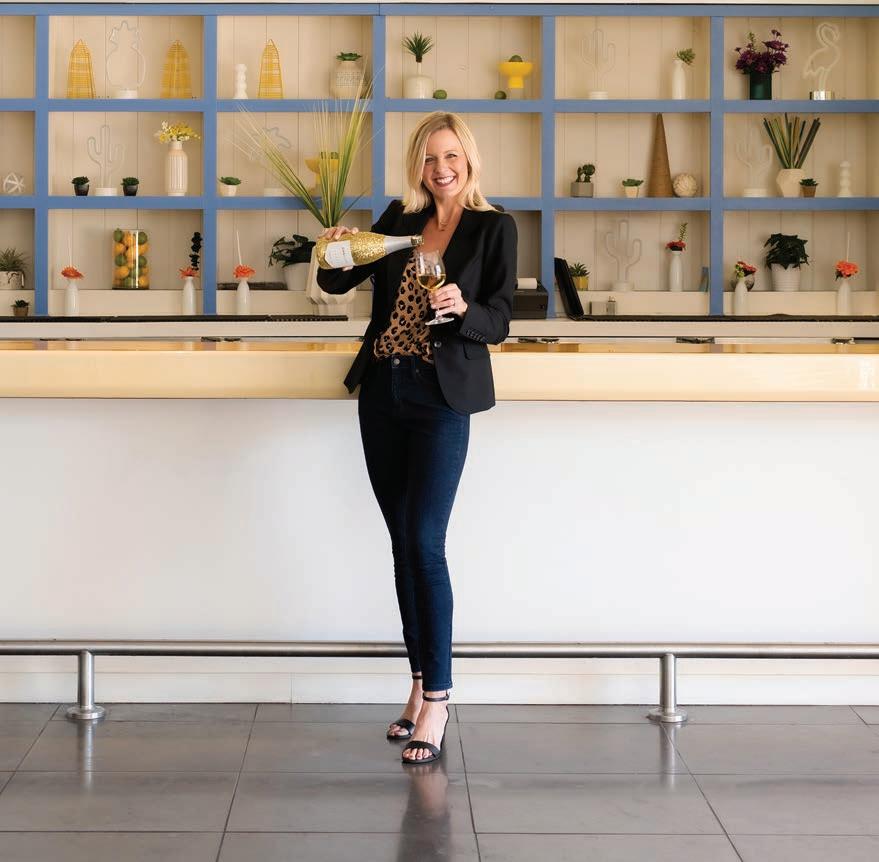
winemaker, to truly catch lightning in a bottle, and harvest at the perfect time.
What
are your priorities for ONEHOPE as you look to the future?
We look forward to growing our impact in local communities through our Cause Entrepreneur platform. With 10 percent of every bottle directly benefitting a unique nonprofit chosen by the customer, we aspire to reach more giving milestones in the near future. ONEHOPE is excited to continue to grow its portfolio by introducing new brands and varietals each year. In 2022 alone, we’ve launched 25+ new products, all of which make a tangible difference in the world.•
PURPOSE
Kristen Shroyer
An Interview with Kristen Shroyer,
POSTED WITH PERMISSION. COPYRIGHT © 2022 LEADERS MAGAZINE, LLC LEADERS 134 VOLUME 45, NUMBER 4
Kristen Shroyer pouring wine at The Saguaro Hotel in Scottsdale, Arizona
Corporate Gifting









onehopewine.com/corporate POSTED WITH PERMISSION. COPYRIGHT © 2022 LEADERS MAGAZINE, LLC LEADERS135 VOLUME 45, NUMBER 4
Accelerating Progress Globally
Douglas L. Peterson, President and Chief Executive Officer, S&P Global 138
A Shared Purpose
Carmine Di Sibio, Global Chairman and Chief Executive Officer, EY 140
Dream Big - Raise Health
Michael Dowling, President and Chief Executive Officer, Northwell Health 144
Talent and Capabilities
Richard Edelman, President and Chief Executive Officer, Edelman 148 Redefining the Legal Landscape Richard A. Rosenbaum, Executive Chairman, Greenberg Traurig 152
A Strong and Engaged Business Community


Kathryn S. Wylde, President and Chief Executive Officer, Partnership for New York City 154
Teamwork and Collaboration
A. Eugene Kohn, Chairman, Kohn Pedersen Fox Associates 156
A Powerhouse in Sports Representation
Michael “Vino” Levine and Howard Nuchow, Co-Heads, CAA Sports 160
A High-Trust Workplace
Edward V. Piccinich, Chief Operating Officer, SL Green Realty Corp. 166
The Promise of Technology and Human Ingenuity Laura Peterson, Senior Managing Director and Office Managing Director - New York, Accenture 170
A Relationship Business James W. Crystal, Vice Chairman, Alliant Insurance Services 172 The Local Expert Frank Pusinelli, Senior Executive Vice President and Chief Operating Officer – Operating Assets, RXR 176
Creativity and Adaptability
Brad S. Karp, Chairman, Paul, Weiss, Rifkind, Wharton & Garrison 162
A Holistic Approach
Margaret Pastuszko, President and Chief Operating Officer, Mount Sinai Health System 164
NEW YORK NEW YORK
POSTED WITH PERMISSION. COPYRIGHT © 2022 LEADERS MAGAZINE, LLC LEADERS 136 VOLUME 45, NUMBER 4
Contents 166 176
Building a More Inclusive Economy
Yael Taqqu, Senior Partner and New York Office Managing Partner, McKinsey & Company 180
Leadership by All Louis A. Shapiro, President and Chief Executive Officer, HSS 182
The People Business
Michael A. Rodriguez, Chief Executive Officer and President, Alliance Building Services 192 Patient Care
Steven J. Corwin, MD, President and Chief Executive Officer, NewYork-Presbyterian 196
The Power of the Platform Stephen B. Siegel, Chairman, Global Brokerage, CBRE 198
Communities of Opportunity
Jonathan F.P. Rose, President, Jonathan Rose Companies 216
Safety, Security, and Flawless Execution James Chitty, Chief Executive Officer, Talon Air 218
Defining Entrepreneurship Michael Loeb, President and Chief Executive Officer, Loeb.nyc 222
One Team James E. Linsley, President, GID Development Group 184
Skadden’s Strengths
Karen M. Lent, Partner, New York, Antitrust/ Competition; Sports; Complex Litigation and Trials, and Paola Lozano, Partner, New York, Mergers and Acquisitions, Skadden, Arps, Slate, Meagher & Flom LLP 200
For Entrepreneurs, By Entrepreneurs Kyle Wool, President, Revere Securities LLC 203
Trust and Communication
George Pyne, Chief Executive Officer, Bruin Capital 186
People and Ethics David Amsterdam, President – U.S. Capital Markets and Northeast Region, Colliers 224
Connecting the Physical and Digital Worlds Chai Outmezguine, Co-Founder, Chief Executive Officer and Chairman, Scanbuy 227
Investing in Ideas That Will Change the World
Steven Fisher, Founder and Chairman, Fisher Capital Investments and Partner, Fisher Brothers; and Kyle Fisher, Partner, Fisher Capital Investments 188
The Business of Baseball Jean Afterman, Senior Vice President and Assistant General Manager, New York Yankees 206
A Trusted Advisor Robert L. Dilenschneider, Founder and Principal, The Dilenschneider Group, Inc. 208
A Flight to Quality Michael Shvo, Founder and Chief Executive Officer, SHVO 230
A Collaborative Spirit
Mariya Rosberg, Partner, Head of Americas Corporate and Institutional Banking, Oliver Wyman 190
Thinking Beyond Peter Riguardi, Chairman and President, New York Tri-state Region, JLL 211


184 230
Caring for the Community Susan Fox, President and Chief Executive Officer, White Plains Hospital 214
The Caviar Experience Chef Edgar Panchernikov, Caviar Russe 232 POSTED WITH PERMISSION. COPYRIGHT © 2022 LEADERS MAGAZINE, LLC LEADERS137 VOLUME 45, NUMBER 4
Accelerating Progress Globally
An Interview with Douglas L. Peterson, President and Chief Executive Officer, S&P Global

EDITORS’ NOTE Doug Peterson has served as President, Chief Executive Officer, and a member of the Board of Directors of S&P Global since 2013. He joined the company in 2011 as President of its credit ratings business. Peterson is a leading voice on ESG issues. He chairs the Bipartisan Policy Center’s ESG Taskforce, and in 2021 he led a workstream of the G7’s Impact Taskforce focused on mobilizing private capital for public good by advocating for globally consistent standards to measure, value and account for sustainability. At S&P Global, he created a new organization within the company, Sustainable1, to be a single source of intelligence for customers navigating the transition to a low carbon, sustainable, and equitable future. Before joining S&P Global, Peterson was the Chief Operating Officer of Citibank, N.A., Citigroup’s principal banking entity. Over his 26 years at Citigroup, he served as Chief Auditor, CEO of Citigroup Japan, and in leadership roles in Latin America. Peterson chairs the U.S.-Japan Business Council and is a member of the Boards of Directors of the Japan Society and the National Bureau of Economic Research. He also is a member of the Council on Foreign Relations and the New York Stock Exchange Board Advisory Council. In addition, he serves on the Advisory Board of the Federal Deposit Insurance Corporation’s Systemic Resolution Advisory Committee and as a Trustee of Claremont McKenna College and the Paul Taylor Dance Company. Peterson received an undergraduate degree from Claremont McKenna College and an MBA from the Wharton School at the University of Pennsylvania.
L. Peterson
Will you provide an overview of S&P Global’s history and how the company has evolved?
It’s been a privilege to lead a company with such a deep history of innovation spanning more than 160 years. From our early beginnings, the founders of our businesses knew the value that transparency brings to markets and companies. In the 19th century, they sought to create more clarity for investors in the emerging railroads industry and demonstrate investment potential in the stock market and better project market trends. In the early 20th century, our commodities businesses helped to bring unprecedented transparency to that opaque industry.
In 2016, we rebranded as S&P Global to mark our renewed focus on becoming the leading information services company. This year, we completed our merger with IHS Markit and emerged with a unique portfolio of highly complementary data and analytics businesses. Our combined company now offers our global
customer base a wide range of insights across data, analytics, ratings, benchmarks, indices, commodities, transportation, and engineering, and we can offer a broader and deeper portfolio of unique solutions and increased scale.
How do you define S&P Global’s purpose and values?
Purpose is one of our key drivers as a company. At the highest level, we are driven by a desire to accelerate progress globally. That means we push past expected observations and seek out new levels of understanding in a complex world so that we can help companies, governments and individuals make an impact. Our values are integrity, discovery, and partnership. We start with a foundation of integrity in all we do, bring a spirit of discovery to our work, and collaborate in close partnership with each other and our customers to achieve shared goals.
Will you discuss S&P Global’s capabilities and solutions?
Following our merger with IHS Markit, our business divisions span Commodity Insights, Indices, Engineering Solutions, Market
COMPANY BRIEF S&P Global (spglobal.com) provides essential intelligence. It enables governments, businesses and individuals with the right data, expertise, and connected technology so that they can make decisions with conviction. From helping customers assess new investments to guiding them through ESG and energy transition across supply chains, S&P Global unlocks new opportunities, solves challenges, and accelerates progress for the world. The company is widely sought after by many of the world’s leading organizations to provide credit ratings, benchmarks, analytics, and workflow solutions in the global capital, commodity, and automotive markets. With every one of S&P Global’s offerings, it helps the world’s leading organizations plan for tomorrow, today.
NEW YORK NEW YORK
Douglas
POSTED WITH PERMISSION. COPYRIGHT © 2022 LEADERS MAGAZINE, LLC LEADERS 138 VOLUME 45, NUMBER 4
“At the highest level, we are driven by a desire to accelerate progress globally. That means we push past expected observations and seek out new levels of understanding in a complex world so that we can help companies, governments and individuals make an impact. Our values are integrity, discovery, and partnership.”
Intelligence, Mobility, and Ratings. Data and analytics are at the heart of all the products and services we offer, but we also provide the means to deliver them to the markets. We offer powerful software, advanced tools, and the ability to harness insights within a highly efficient workflow. It isn’t just about getting the right data – it’s about all the ways we empower action through that data. As we continue to integrate our offerings, we are going to focus on holistic solutions that streamline what’s most important to our customers.
S&P Global has expanded internationally under your leadership. Will you highlight S&P Global’s global footprint?
Our global footprint has grown because of organic investments and the merger. We’re now a team of over 35,000 people across 41 countries worldwide – so we’re able to understand local and regional nuances while also having a global perspective to serve customers in more than 150 countries. We believe that innovation thrives, and our company operates successfully when our people embody and reflect those ideals. We have a global customer base, and it is important for us to engage with our customers wherever they are.
What are your views on the future of work?
The future of work is inevitably going to be different to how it looked before the COVID-19 pandemic. We’ve become adept at taking advantage of technology to work productively outside of traditional offices, but there are still huge benefits to be found by being physically present in the same location for training, collaboration, and to get to know each other better.
There’s also another aspect to it, and that’s making sure that we don’t lose our commitment to seeing our customers and our colleagues
around the world. I think about social contacts, mentorship, sponsorship, apprenticeship – the intangibles that are valuable for us to maintain. So, the future of work will be hybrid – a combination of being at the office, maintaining social and professional interaction, and people working from home or remotely when it’s most efficient to do so. We’ll be able to strike a nice balance.
How critical is it for S&P Global to build a diverse and inclusive workforce to bring diverse perspectives and experiences to the table when making business decisions?
I want to reflect on my earlier comment about purpose. We believe strongly in having a people-first culture, and inclusion is critical to our business success and our understanding of the world around us. Our People Resource Groups are a key avenue to foster connectivity and community and help us to create opportunities for substantive interaction, both with and between our colleagues from diverse backgrounds.
Being people-first also means we support our people inside and outside the workplace, and across all life stages. Our core values emphasize caring for our people, investing in diversity, equity and inclusion, promoting career mobility, and building future leaders.
What do you see as S&P Global’s responsibility to be a good corporate citizen and to be a force for good in society?
Every year, we publish a comprehensive impact report that details the many ways in which we fulfill our responsibilities as corporate citizens. We disclose our responsible business practices, our sustainability performance as an enterprise, and our efforts to contribute and create value for the societies in which we live and work.
Our main philanthropic arm is the S&P Global Foundation, and it focuses on making a difference by engaging our colleagues and positively impacting the communities in which we operate. The Foundation has three focus areas: bridging the global skills gap, creating an inclusive economy, and promoting a sustainable environment. Additionally, the Foundation’s grantmaking supports disaster relief efforts with an emphasis on resiliency. The majority of grants target underrepresented and underserved communities. Last year, we broadened grantmaking in pandemic relief, racial justice, and climate change.
What do you feel are the keys to effective leadership and how do you describe your management style?
One of the most important aspects of effective leadership, in my view, is staying informed. I truly value visiting our offices across the globe and spending an extra day meeting colleagues across the organization. Building these relationships on a personal level means I have a network of knowledge and expertise across the firm, and by maintaining an open dialogue it helps keep me plugged in with developments large and small.
Maintaining a focus on strategy and direction is another key pillar of my approach to leadership. This is especially important during times of transformational change, when it can be easy to focus on the endless list of things that need to get done at the expense of the broader vision that is driving the change in the first place.
S&P Global has achieved strong growth and success under your leadership. Are you able to enjoy the process and take moments to celebrate the wins?
Thank you for calling out the success of the company. Our people are the driving force behind that success, and the hard work they do every day forms the core of how we deliver for our customers. We have built a strong culture of recognition across the company, which means we share and celebrate our wins as much as we can. We have a formal process to recognize different teams every quarter for their accomplishments. One of the things I love about leading is learning about the fantastic work of so many teams each quarter. I enjoy the process and I’m energized by learning about the innovation, transformation, and collaboration across all facets of our business.
What advice do you offer to young people beginning their careers during this unprecedented time?
One piece of advice I would offer to young people beginning their careers today is to pinpoint the activities that you enjoy and find fulfilling within your working day. Whether it’s working with people, or focusing on the technical aspects of the job, prioritizing the things you enjoy day-to-day will help
find a natural career path more successfully than chasing a specific job title, and it simplifies long-term decision-making and offers far more scope for happiness.•
you
POSTED WITH PERMISSION. COPYRIGHT © 2022 LEADERS MAGAZINE, LLC LEADERS139 VOLUME 45, NUMBER 4
“We offer powerful software, advanced tools, and the ability to harness insights within a highly efficient workflow. It isn’t just about getting the right data –it’s about all the ways we empower action through that data. As we continue to integrate our offerings, we are going to focus on holistic solutions that streamline what’s most important to our customers.”
A Shared Purpose
EDITORS’ NOTE Prior to being elected to his current post, Carmine Di Sibio served as EY Global Managing Partner – Client Service, leading the execution of the organization’s global strategy and its four geographical areas and four service lines. He spearheaded EY’s innovation efforts, including leading a $1 billion investment in new technology solutions over a two-year timeframe announced in August 2018. He helped to create the Global Innovation team to redefine how EY uses technology to both transform existing services and create new solutions. As a leader of the organization’s acquisitions and alliances strategy, he has helped expand EY offerings in a wide range of new and emerging fields. Di Sibio co-chairs the EY Global Diversity and Inclusiveness Steering Committee, which works to maximize the power of different opinions, perspectives, and cultural references within the organization. Since joining EY in 1985, he has served as an Advisory and Assurance partner for many of EY’s largest financial services accounts. He previously served as Chair of the Global Financial Services Markets Executive and Regional Managing Partner for the Americas Financial Services Organization (FSO), where he started EY Risk Management and Regulatory Services. He has a foundation in audit and is a practicing Certified Public Accountant. Di Sibio is a member of the board of Focusing Capital on the Long Term (FCLT) to encourage

a long-term focus in business which can drive inclusive growth. He plays an active role in the World Economic Forum (WEF), serving as a member of its International Business Council. Di Sibio is a member of the International Business Leaders Advisory Council (IBLAC) to the Mayor of Shanghai, and is a member of the Washington, D.C.based Business Roundtable. He also serves on the boards of the Foundation for Empowering Citizens with Autism and Family Promise and is a member of the Board of Trustees of Colgate University. Di Sibio is originally from Italy and emigrated with his family to the United States when he was three years old. He was the first in his family to graduate from college, earning a BA in chemistry from Colgate University and an MBA from New York University’s Stern School of Business.
FIRM BRIEF The global EY organization (ey.com) is one of the largest professional services organizations in the world. EY’s global member firms employ 365,000 people across 150 countries and generate $40 billion in revenues.
How do you define EY’s purpose and how is purpose engrained in EY’s culture?
Our purpose is “Building a better working world,” and it reflects our “why.” It is why we do the work we do. It is why we are committed
to investing in EY people, working with clients to address key challenges, and contributing to the communities we operate in. Our purpose reflects our mission to make every audit, tax return, consulting opportunity, question asked, and project delivered a chance to make the working world better than it was before.
Defining our purpose was never just about putting nice words on our website. It was about giving us a solid foundation to guide our organization’s strategic vision, and we’ve seen that this has grounded us and helped us to stay the course through the uncertainties of the global pandemic, economic volatility, and geopolitical challenges.
How does EY’s workforce at all levels live its purpose?
Our organization is vast. We have over 365,000 employees, working across geographies and service lines. Having a shared purpose unifies our culture and helps people connect their day-to-day work to something bigger than themselves. But we also get specific. Purpose is where we start, but we activate it through our strategy – to create long-term value for our clients, people, and society. We believe that focusing on stakeholders in this way leads to sustained financial returns – and it has. We’ve had our strongest growth in decades. We are now a $45 billion company, growing at an impressive rate, and attribute that to our stakeholder-focused strategy, as well as the ability of EY people to adapt, innovate and deliver value in new and different ways.
NEW YORK NEW YORK
Carmine Di Sibio
An Interview with Carmine Di Sibio, Global Chairman and Chief Executive Officer, EY
POSTED WITH PERMISSION. COPYRIGHT © 2022 LEADERS MAGAZINE, LLC LEADERS 140 VOLUME 45, NUMBER 4
“Defining our purpose was never just about putting nice words on our website. It was about giving us a solid foundation to guide our organization’s strategic vision, and we’ve seen that this has grounded us and helped us to stay the course through the uncertainties of the global pandemic, economic volatility, and geopolitical challenges.”
Will you discuss EY’s commitment and leadership in supporting entrepreneurs and entrepreneurship, including the power of its EOY program?
Entrepreneurs are integral to economic vitality. That’s always been the case, but it’s even more true today, as pressing societal issues and geopolitical challenges touch every business. We are committed to supporting their optimism, critical problemsolving skills, and innovative thinking. We do this through EY Ripples, our corporate responsibility program, where we pair EY people with impact entrepreneurs to share expertise, insights, and time. During FY22 we worked with over 14,000 impact entrepreneurs in pursuit of achieving the United Nations Sustainable Development Goals.
Of course, the Entrepreneur Of The Year® program is our most recognized program to support entrepreneurs. The competition operates in 60 different countries, honoring those who are building game-changing and sustainable businesses. Winners gain access to EY alumni, resources, and a platform to grow their business and inspire the next group of upcoming entrepreneurs. We see entrepreneurs as the spark for creating exponential change – from small communities to large companies – and I am continuously wowed by their commitment, ingenuity, and integrity.
What have been the keys to EY’s ability to build long-lasting client relationships and client loyalty?
Today’s businesses operate in a complex, dynamic landscape defined by accelerated
technological, economic, and geopolitical change. Our ability to serve our clients depends on our ability to move as fast as this environment. We are consistently trying to stay one step ahead and to be seen as a partner invested in our clients’ success.
We are a client-centric business, and committed to bringing the right global expertise, technology, and resources to every engagement we have. Our clients know we are focused on innovative solutions, transformative support, and collaborative teamwork. They see EY’s commitment to investing in the latest technologies, supporting our workforce, and contributing to the communities we operate in. It’s a relationship built on more than selling and providing services. Our goal, at the heart of our strategy, is to deliver value to our clients so that they can find success whether it is next quarter, next year, or five years from now. We want clients to know that we have their long-term, sustainable success as our primary interest, and that creates trust and loyalty.
How critical is it for EY to build a diverse and inclusive workforce to bring diverse perspectives and experiences to the table when addressing client needs?
We are committed to building a workplace where all people are valued, respected, and heard – because it’s the right thing to do, and it’s the right thing for our organization. We deliver better service when we draw on people from
diverse backgrounds, ethnicities, and experiences. We’ve done research on this, and diverse teams deliver higher-quality results. Our clients come to us with complex challenges, and to bring the best we have to them, we need EY people who feel they can bring their full selves to work.
That’s why I am the Co-chair of the Global Diversity, Equity and Inclusiveness (DE&I) Committee, and DE&I is part of our broader strategy. We monitor our progress through our Global DE&I Tracker, which measures our performance on engagement, mobility, and inclusion. We’re committed to getting better and holding ourselves accountable.
What do you see as EY’s responsibility to the communities it serves and to being a force for good in society?
We realize that our significant size, talent, and resources put us in the position of being able to make a positive impact on a global scale – and we know we have a responsibility to do just that. Our corporate responsibility program, EY Ripples, expanded this year to include over 2,600 new projects and initiatives with over 91,000 EY people participating. Our goal is to positively impact one billion lives by 2030 – and we’re well on our way. We are also doing a lot of this work with clients through collaborative initiatives to upskill the workforce, create a low-carbon future, and address social and economic inequality.
“Today’s businesses operate in a complex, dynamic landscape defined by accelerated technological, economic, and geopolitical change. Our ability to serve our clients depends on our ability to move as fast as this environment.”
POSTED WITH PERMISSION. COPYRIGHT © 2022 LEADERS MAGAZINE, LLC LEADERS141 VOLUME 45, NUMBER 4
“We realize that our significant size, talent, and resources put us in the position of being able to make a positive impact on a global scale – and we know we have a responsibility to do just that.”
But creating long-term value for society is core to our strategy; it’s not just about corporate responsibility. We are committed to be a force for good in all that we do. This gets back to our purpose. Through audit, we are committed to creating confidence and transparency in the capital markets. Through consulting, we are committed to helping our clients transform – often in ways that positively impacts society. We want the imperative to be a “force for good” to run through the fabric of our organization. I don’t think you can be successful any other way in the world we live in today.
EY places a major emphasis on ESG. How critical is it for ESG to be built into a company’s corporate strategy to be effective?
ESG is confronting a lot of push back right now, and I understand some of the frustration with the many demands on companies and competing interests, but corporate CEOs know that to be successful, you have to align your goals with the goals of society. ESG needs refinement, but it is here to stay for good reasons. According to our 2022 EY CEO Survey, 82 percent of chief executives “see ESG as a value driver to their business.” Companies want to show the impact that their operations are having broadly – the prosperity they create, the investment in their people, their commitment to diversity, and their efforts to be good stewards of the planet. They don’t see ESG as just a way to manage risk. We’ve also seen that organizations, including EY, are committing to increased ESG disclosure – not just because they are focused on compliance, but because they know ESG issues are core to strategy, and as such, need to be measured.
EY is headquartered in New York. What are the keys to New York’s economic recovery and rebuilding from the pandemic and how critical is a strong public/ private partnership to New York’s future success?

I’m deeply invested in the city’s recovery –both as the EY CEO and a proud native of the New York metropolitan area. To help our region thrive, we need to address one of the biggest issues holding us back: Too many New Yorkers are working in low-wage jobs, even though they have college degrees – and
far too many come from communities of color and other underrepresented backgrounds. There is a gap between the talents they have and the opportunities they are offered.
That’s why I’m a proud member of the New York Jobs CEO Council and the Future of Workers Task Force. As part of these initiatives, we’re equipping workers with the right skills and helping them get good jobs that turn into long-term careers. Our goal is to hire 100,000 New Yorkers from low-income backgrounds by 2030, and we’re working with Mayor Eric Adams and other government officials to get this done.
What are your views on the future of work and the role of the office of the future?
It’s clear that workplace flexibility is here to stay; new research has found that employees value it as much as a 10 percent pay raise. At the same time, 60 percent of workers who have switched to doing their jobs remotely feel less connected to their co-workers. On the surface, it can seem like flexibility and collaboration are at odds with one another – but the opposite is true. An effective strategy should strike the right balance between the two, and that’s what we’re striving to do. As leaders build the office of the future, they will need to preserve the best of both worlds.
Do you feel that the industry has done an effective job of telling its story to attract the next generation of leaders to the profession?
In my opinion, there’s never been a more exciting time to be in this profession. Technology is fundamentally changing the way we do business, and the opportunities to be on the leading edge of transformational change are growing, whether that is in accounting, consulting, or tax. We are telling this story, and we have a lot of demand for jobs at EY. Last year alone we had over three million people apply to EY globally.
For accounting in particular, the profession is well placed to help mature approaches to sustainability and ESG – areas so many new employees are interested in. Our work on reporting and assurance can help instill confidence in ESG disclosures and carbon accounting. Sustainability is also increasingly integrated into each of our service offerings,
including exciting opportunities in sustainability strategy setting, system implementations to track carbon emissions, calculating the economic value of social impact programs, among many others.
I am not worried about drawing the next generation of leaders to the profession –these are exciting, yet challenging, times and we have a lot to contribute.
What has made the profession so exciting and special for you?
I never planned to become an accountant. In college I studied chemistry, not business. Yet when I came to EY, I found opportunities to learn and take on new challenges. Some 37 years later, I’m proud that’s still the case. There is no typical employee or typical experience, and that diversity is core to our strength. We are lucky to touch every aspect of a business – across all sectors –and that creates tremendous potential for a vibrant career full of teaming, learning, and contributing. And that’s what I have been able to have, thanks to EY and the profession. I have also appreciated that we are not afraid to change and adapt and are always looking for the next opportunity. I find that kind of dynamism exciting, and EY has never failed to deliver on that front.
It sounds as though there may be real changes to EY around the corner. What are they and why now?
As has been covered in the media, we are considering evolving into two distinct multidisciplinary organizations – an assurance organization and a consulting organization. While it is really exciting to see the exceptional growth EY has achieved so far, we think there is more we can do, as two organizations, to better serve our stakeholders –and to create an even better working world.
The world is changing very fast, and so too are the expectations of our stakeholders. We’ve decided to propose this now because we think this evolution can bring about increased investment in the future, more opportunities and mobility for EY people, and enhanced services for our clients. What won’t change is the focus on purpose-led growth, diversity and inclusion, and teaming – whether we are one organization or two. There are a lot of discussions to be had, but I am optimistic, and excited, about this bold new vision for the future.
•
POSTED WITH PERMISSION. COPYRIGHT © 2022 LEADERS MAGAZINE, LLC LEADERS 142 VOLUME 45, NUMBER 4
“Technology is fundamentally changing the way we do business, and the opportunities to be on the leading edge of transformational change are growing, whether that is in accounting, consulting, or tax.”






NEW Ascending to new heights with New York’s most transformative buildings COMMERCIAL | RESIDENTIAL | RETAIL | FINANCE slgreen.com SUMMITS
Dream Big - Raise Health
EDITORS’ NOTE Michael Dowling is one of healthcare’s most influential voices, taking a stand on societal issues such as gun violence and immigration that many health system CEOs shy away from. His leadership has been invaluable to Northwell’s consistent expansion and prominence. In March 2020, he successfully navigated the health system through the first COVID-19 epicenter in the U.S., detailing Northwell’s experiences in a book entitled, Leading Through a Pandemic: The Inside Story of Humanity, Innovation, and Lessons Learned During the COVID-19 Crisis. Overall, Northwell has treated over 300,000 COVID patients – more than any other U.S. health system.

Prior to becoming CEO in 2002 and joining Northwell in 1995, Dowling served in New York State government for 12 years, including seven years as State Director of Health, Education, and Human Services and Deputy Secretary to the Governor. He was also Commissioner of the State Department of Social Services. Earlier, he was a Professor of Social Policy and Assistant Dean at the Fordham University Graduate School of Social Services and Director of the Fordham campus in Westchester County. Dowling has been honored with many awards and recognitions over the years, including the Ellis Island Medal of Honor, the Presidential Distinguished Service Award for the Irish Abroad, the Alfred E. Smith Award from the American Society for Public Administration, the National Human Relations Award from the American Jewish Committee, and the Foreign Policy Association Medal award. In 2017, he was selected to serve

as the Grand Marshal of New York’s St. Patrick’s Day Parade. For 15 years, Modern Healthcare has ranked Dowling on its annual list of the “100 Most Powerful People in Healthcare.”
Dowling is past Chair of the Healthcare Institute and the current Chair of the Institute for Healthcare Improvement (IHI). He is a member of the Institute of Medicine of the National Academies of Sciences and the North American Board of the Smurfit School of Business at University College, Dublin, Ireland. He also serves as a board member of the Long Island Association.
He is past chair and a current board member of the National Center for Healthcare Leadership (NCHL), the Greater New York Hospital Association, the Healthcare Association of New York State, and the League of Voluntary Hospitals of New York. Dowling was an instructor at the Center for Continuing Professional Education at the Harvard School of Public Health. He earned his undergraduate degree from University College Cork (UCC), Ireland, and his master’s degree from Fordham University. He also has honorary doctorates from the prestigious Queen’s University Belfast, University College Dublin, Hofstra University, Dowling College, and Fordham University.
INSTITUTION BRIEF Northwell Health (northwell.edu) is a clinical, academic and research enterprise with a workforce of more than 80,000 and annual revenue of $15 billion. Northwell is the largest healthcare provider and private employer in New York State, caring for more than two million people annually through a vast network of more than 850 outpatient
facilities, including 220 primary care practices, 52 urgent care centers, home care, rehabilitation, and end-of-life programs, and 21 hospitals. Northwell also pursues pioneering research at the Feinstein Institutes for Medical Research and a visionary approach to medical education highlighted by the Zucker School of Medicine, the Hofstra Northwell School of Nursing and Physician Assistant Studies, and one of the nation’s largest medical residency and fellowship programs.
NEW YORK NEW YORK
Michael Dowling
An Interview with Michael Dowling, President and Chief Executive Officer, Northwell Health
POSTED WITH PERMISSION. COPYRIGHT © 2022 LEADERS MAGAZINE, LLC LEADERS 144 VOLUME 45, NUMBER 4
“I regularly walk the floors of our facilities to directly connect with those on the front lines. Staff, when asked about an issue, invariably respond optimistically and will say we are ‘Made For This.’”
What does the phrase “Made for this” mean at Northwell Health?

It means that we have the ability and willingness to take care of every opportunity and circumstance that arises. We are optimistic and future oriented. When an issue or so-called problem occurs, the answer is always positive –that we look forward to resolving it. We always see problems as opportunities for creativity and innovation. I regularly walk the floors of our facilities to directly connect with those on the front lines. Staff, when asked about an issue, invariably respond optimistically and will say we are “Made For This.” This was extremely evident during COVID. Our culture is built on the belief that we can handle any situation and will win when we collectively decide to do so. Its teamwork.
on operational issues. It must be positive and inspirational. It’s about appealing to people’s heads and people’s hearts. Use technology but don’t’ overuse it. In-person meetings – like town hall meetings, where staff can directly interact, are crucial. We hold such meetings on a regular basis – and I attend. Everything is local and all must feel connected, especially in a large organization.
How do you balance having One Northwell with the need to have a local feel at each of the hospital locations?
Each entity – especially hospitals – has a particular uniqueness based on history, origin and location. It is important to preserve the positives of that uniqueness or culture while at the same time building a systemwide culture and identity so that, in our case, they all know they are part of Northwell. I often refer to us as a mosaic – a collection of individual pieces – each with its own beauty but when put together, the whole is more beautiful. Northwell is such a mosaic.
Is brand awareness important for Northwell or is it about awareness for the individual hospital brands?
Brand awareness is very important especially when you are in a competitive market like we are. Also because we are young as an organization – relative to our competition. The Northwell brand is now well known – our leadership during COVID has helped. We have to continue to enhance it and build awareness but at the same time build the recognition of some of our component entities – such as Lenox Hill Hospital, North Shore Hospital, Cohen’s Children’s Hospital and Feinstein, our renowned research entity. As we do so, we will make sure that the public knows they are all part of Northwell. It’s a complicated process but doable.
Is it challenging to differentiate a health system in the industry?
It is complicated and made more difficult by the plethora of all the ranking lists that are constantly published (a new industry). Some are legitimate and use solid metrics and some are not. We are, however, fortunate to be in New York where we have many great facilities providing great care and engaged in top-flight research and education. I am proud to say that Northwell is among them.
How has Northwell Health been able to maintain its culture as it has grown in size and scale?
This is multi-faceted but it starts with the strong belief that culture is what determines long-term success – or failure. Our culture –collaborative and team oriented, is our winning formula. We focus on making sure that we recruit well. We have an elaborate on-boarding process including my presentation to all new hires each Monday morning. At present, we are recruiting about 350 each week. We are also very careful and deliberate about who we put in leadership positions – at every level of the organization, especially first-time supervisors and middle managers. Constant communication is imperative – on vision, on strategy and

“I often refer to us as a mosaic – a collection of individual pieces – each with its own beauty but when put together, the whole is more beautiful. Northwell is such a mosaic.”
POSTED WITH PERMISSION. COPYRIGHT © 2022 LEADERS MAGAZINE, LLC LEADERS145 VOLUME 45, NUMBER 4
Michael Dowling speaking at the 2019 Northwell Health annual meeting
Looking forward, I believe the key differentiators will be a combination of clinical quality (not process but outcomes), research (new discoveries), education (preparing the workforce of the future), service (building consumer loyalty), and the promotion of prevention and wellness (going upstream).
Its also important, I believe, for healthcare organizations and their leadership to be advocate voices on key issues important to the community overall – such as sustainability and climate change and gun violence prevention and safety. They are all health related.
You mentioned gun violence prevention, which is an issue that Northwell Health has taken a leadership role in addressing. What are your views on the impact of the efforts to drive change in this regard?

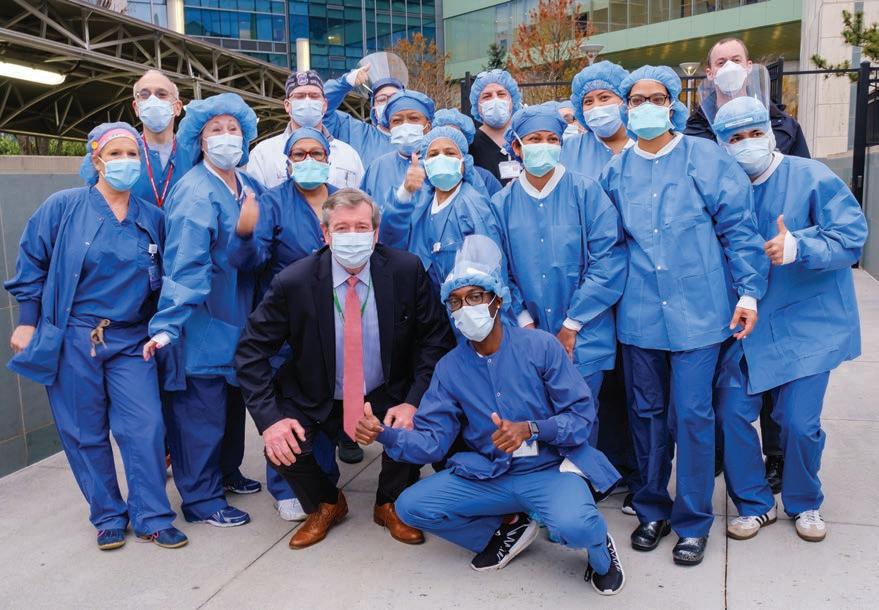
This is a major public health issue. There are many statistics that prove this point but one stands out – gun violence is now – in the U.S. – the leading cause of death for children and adolescents. Cancer is third. We must intensify our efforts to change this and healthcare CEOs must be in the forefront. But, while being impatient, we must take the long view –be persistent and resilient. We live in a society that is addicted to instant gratification, looking to get results very quickly, but normally that’s not how it works. We also, unfortunately, now live in a toxic political world where the art of compromise has for the most part disappeared. This impedes any quick resolution of the gun violence issue despite the recent federal legislation that passed. But I like to remind people that decades ago when Ralph Nader talked about the need to put airbags and seat belts in cars, he was regarded as crazy. Today, however, you cannot buy a car without airbags and seat belts. This shows the importance of resilience and persistence.
We need to stay optimistic about the potential for real action on gun violence prevention. Things do change over time and the more it is recognized as a public health issue, the more traction it will get.
There are many issues that have a health impact. How do you decide where Northwell focuses its efforts?
Everything has a health impact which is why it is so complex, so you have to make
“We need to stay optimistic about the potential for real action on gun violence prevention. Things do change over time and the more it is recognized as a public health issue, the more traction it will get.”
Michael Dowling speaking at an event
POSTED WITH PERMISSION. COPYRIGHT © 2022 LEADERS MAGAZINE, LLC LEADERS 146 VOLUME 45, NUMBER 4
Michael Dowling with the staff of Long Island Jewish Hospital
choices – which ones do I take a lead on and which ones can I influence – to be a catalyst. We picked gun violence because of its direct impact on all of us, but especially children – and we directly see the impact in our emergency rooms, operating rooms, mental health facilities, etc. We should be ashamed to have the worst gun violence statistics in the civilized world. We, as a country, are better than this.
Another one we focus on is education –providing opportunity to children, especially those in underserved communities – to experience and see what’s possible. We work closely with dozens of schools and we recently launched a program to provide college scholarships to kids from poor families where no one before has gone to college. When a kid from those families goes to college, it changes the entire family – it changes perspective. It improves health.
Will you discuss Northwell’s commitment to building a diverse and inclusive workforce?
We have a growing diverse workforce and I observe it every Monday when I present to new recruits – as I mentioned earlier about 350 each week – employees from every ethnicity, religion, culture and geography. During these meetings, I speak directly to its importance and relevance and urge each to learn more about the person who is and will be sitting and working next to them. The more you know and understand, the more inclusive and more informed you will be. We have multiple programs throughout Northwell to promote and celebrate diversity. It’s an ongoing and necessary part of our mission and operations.
We have also dramatically improved the diversity in our leadership ranks and will continue to do so.
Has the medical school at Northwell developed the way you had expected and how valuable has it been to the health system?

It has been a phenomenal success. We took some risks when we launched the school, but if you don’t take risks, you are not moving forward. It is even worse to be afraid to take risks. I was always concerned about the idea that people in medical school would only learn by sitting in the classroom, listening to lectures and reading books, and would then go into the hospital to get experience about care delivery. The problem is that hospitals are not the place where the bulk of care is delivered anymore, so while you need to have the inpatient experience, you need to have experience outside of the hospital as well. We have our students ride on the ambulances and go to people’s homes, and this allows them to understand the social determinants of health. If you go into the home of a person who is having a problem and you realize that there is no food in the refrigerator, it changes your concept of health.
The medical school is now 12 years old and we are reviewing the curriculum and looking at what the next iteration is and how we continue to change to stay ahead. This is the benefit of starting a medical school from scratch since we did not have to knock down old bureaucracies and ways of thinking. We were able to create a new culture and a new thought process.
What are the characteristics that you look for when hiring talent?
First, I look for attitude – a positive, can-do, upbeat attitude. It is about someone
who does not balk at challenges, but sees opportunities. Second, I look for curiosity – a person who is constantly committed to education. What you learned yesterday is outdated tomorrow. Third, I look for people who have a tolerance for discomfort, because bad things are going to happen, even in great places. It is easy to be upbeat when things are good. The real test is how you handle things when times are bad. COVID was a clear example. I tell people all the time that if you have not had a bad day, there is no way to appreciate a good day. Fourth, I look for people that want to be part of a team. It is not about you – it is about us. Lastly, you want people that are not risk adverse. You need to make mistakes to move forward.
Where did you develop your management style?
I have been away from home and on my own since I was 16 years old. This makes you learn how to deal with other people, and teaches you the importance of relationships, communication, resilience and persistence. I played sports and you can’t win a team sport without being part of the team. I have had the benefit of working in academia and in government which has been very helpful in opening me up to new experiences and different environments. I have also had the benefit of learning from all those I have worked with.
You often talk about the importance of resilience. Where did you build your resilience?
This may sound strange, but I think that poverty can be a wonderful educator and motivator. I grew up poor and it made me learn about life much quicker because I had to adapt and deal with difficult circumstances. You learn how not to quit.•
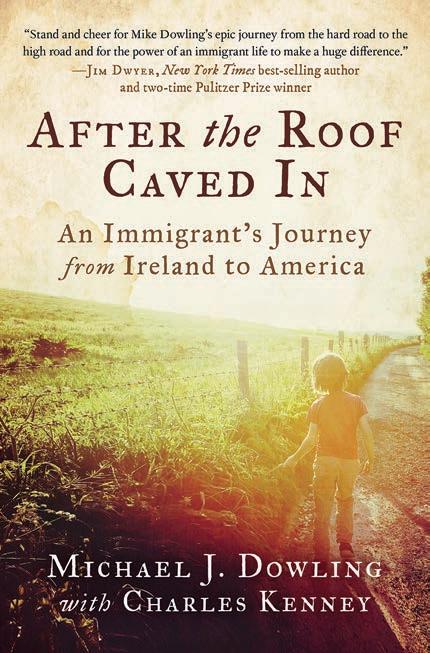
POSTED WITH PERMISSION. COPYRIGHT © 2022 LEADERS MAGAZINE, LLC LEADERS147 VOLUME 45, NUMBER 4
Michael Dowling with a model of his childhood home
Talent and Capabilities
An Interview with Richard Edelman, President and Chief Executive Officer, Edelman

EDITORS’ NOTE Richard Edelman is the CEO of Edelman, a global communications firm, and Chairman of Daniel J. Edelman Holdings, the firm’s holding company. He was named CEO in 1996, taking over for his father who remained Chairman until he passed away in 2013. Now in his 26th year as CEO, Edelman is one of the longest tenured agency leaders in the marketing services industry. During that time, he has guided the firm’s entry into digital, creative, performance marketing and advisory. He also serves as Chair of Edelman’s sister agency, Zeno, which was named large agency of the year in 2021 and 2022 by PRWeek. Zeno employs 730+ people across 18 offices. As the creator of the annual Edelman Trust Barometer, he has become one of the foremost authorities on trust in business, government, media and NGOs. In 2022, Edelman was inducted into the American Advertising Hall of Fame, the first PR executive to ever earn this honor. In 2019, he was named the PR Agency Professional of the Past 20 Years by PRWeek and was inducted into the publication’s Hall of Fame; in 2014, he was inducted into the Arthur W. Page Society’s Hall of Fame; Advertising Age named him Agency Executive of the Year in 2008. Edelman serves on the Board of Directors of the Ad Council, the Chief Executives for Corporate Purpose (CECP), the Atlantic Council, Project HOOD, P33, the Gettysburg Foundation, the 9/11 Museum, and the National Committee on U.S. China Relations. He is a member of the Civic Committee of the Commercial Club of Chicago, World Economic Forum, and PR Seminar. Edelman earned his MBA from Harvard Business School in 1978 and a BA degree from Harvard College in 1976.
FIRM BRIEF Edelman (edelman.com) is a global communications firm that partners with businesses and organizations to evolve, promote and protect their brands and reputations. Its 6,000 people in more than 60 offices deliver communications strategies that give its clients the confidence to lead and act with certainty, earning the trust of their stakeholders. Edelman’s honors include two Cannes Lions Grand Prix awards (PR in 2016 and Entertainment Lions for Sport in 2021); a Gold Lion in Sustainable Development Goals (2022); Cannes Lions Independent Agency
of the Year for the Entertainment Track (2021); Cannes Lions Co-Independent Agency of the Year for the Good Track (2022); Advertising Age’s 2019 A-List; the Holmes Report’s 2018 Global Digital Agency of the Year; and, five times, Glassdoor’s Best Places to Work. Since its founding in 1952, Edelman has remained an independent, family-run business. Edelman owns specialty companies Edelman Global Advisory (public affairs), Edelman Smithfield (financial), Edelman Data x Intelligence (research, data), and United Entertainment Group (entertainment, sports, lifestyle).
How do you define Edelman’s purpose and mission?
Our purpose and mission as a firm is to provide strategic communications counseling and programming to clients that will allow them to take action to improve society and build trusted relationships across stakeholders. We help companies define and evolve their role in society by uncovering their Purpose, creating a roadmap for action and inspiring others to join them.
What have been the keys to Edelman’s industry leadership and ability to build long-standing client relationships?
Making sure that we always put the clients and the work first. Our independence has allowed us to do that. It has enabled us to not
only see around the corner for what is coming next, but most importantly it has allowed us to make the necessary investments in talent and capabilities.
We have also put trust at the center of everything we do. We believe that action earns trust, and we are not afraid to take chances and push clients to do work that makes a difference and sparks movements.
What was the vision for creating the Edelman Trust Barometer and how has it evolved?
We started the Edelman Trust Barometer after the 1999 protests of the World Trade Organization’s conference in Seattle, which became known as the “Battle in Seattle.” There was a surge in activism around the world forcing government and business to examine the social and environmental challenges our world faces and the role they needed to play in addressing them. The purpose of the Trust Barometer is to measure trust in society’s institutions, its leaders and communications platforms, and examine how they can work together and lead society in addressing the challenges of our time.
Will you highlight the results of the 2022 Edelman Trust Barometer and the key takeaways from this year’s results?
Government and media are fueling a cycle of distrust threatening social stability, making distrust the default emotion for society; 59 percent say they tend to distrust until seeing evidence that something is trustworthy.
NEW YORK NEW YORK
Richard Edelman
POSTED WITH PERMISSION. COPYRIGHT © 2022 LEADERS MAGAZINE, LLC LEADERS 148 VOLUME 45, NUMBER 4
“Our purpose and mission as a firm is to provide strategic communications counseling and programming to clients that will allow them to take action to improve society and build trusted relationships across stakeholders.”
Government and media are seen as divisive forces in society; Nearly one out of every two respondents view government (48 percent) and media (46 percent) as divisive, and twothirds of people believe they are intentionally being lied to by journalists (67 percent) and government leaders (66 percent).
Business (61 percent) remains the most trusted institution with even greater expectations due to government’s failure to lead during the pandemic. By five-to-one, respondents want business to play a larger role on climate change, economic inequality, workforce reskilling, and addressing racial injustice.
There is a collapse of trust in developed democracies; Not one, aside from India, reached a score of 60 on this year’s Trust Index, including Australia (53), France (50), Germany (46), UK (44) and U.S. (43), which has dropped 10 points since 2017. This is driven by a majority of respondents in every democracy believing they will be worse off financially in five years and 85 percent fearing they will lose their jobs to forces including automation.
There have been three key trends driving corporate responsibility:
1. CEOs of companies like Starbucks, Unilever and PepsiCo who initiated ideas and programs that focused largely on purpose and sustainability.
2. The perception of government as incompetent, which is driving the expectation of business to step in and fill the void.
3. Trust is local and therefore employees and consumers are holding business to account on a daily basis. They expect action on the issues facing society – climate change, racial injustice, job security, LGBTQ+ rights, geopolitics, gun violence, reproductive rights and more. All of this is now falling to companies in our new reality of Society in Business, where employees and consumers see that their companies and brands have the power to make change.
Will you discuss Edelman’s long and deep commitment to New York?
New York became our co-headquarters when I became CEO in 1996. It is now the largest office in our network. We moved to Lower Manhattan 13 years ago because we
thought it was important to help bring business and people back downtown after 9/11. We worked with the city on the Lower Manhattan Development Corporation and the rebuilding of downtown and we worked pro bono with the 9/11 Museum & Memorial. I also sit on the board of the museum. New York is as much a part of this agency’s history as Chicago, where my father founded the agency in 1952.
How critical is it for Edelman to build a diverse and inclusive workforce to mirror the diversity of its clients and the communities it serves?
It is essential. We have a fundamental responsibility to advance diversity, equity and inclusion inside and outside of our firm. In September 2021, we reached our goal of achieving a 30 percent racially/ethnically diverse workforce in the U.S. (ahead of our 2022 goal). As of September 2021, 53 percent of our global leadership were women, and 57 percent of our U.S. leadership were women.
Internally, to build a more open and transparent environment, we’ve focused on advancing, evolving, and transforming DEI at the firm. We have accelerated efforts in diverse hiring and retention, diversifying our board,
assessing equity measures, partnering with diverse NGOs and nonprofits, and encouraging our clients to be more directly involved in action and change.
We have more to do, and this will remain a priority for the firm.
What do you see as Edelman’s responsibility to be a good corporate citizen and to be a force for good in society?
Edelman’s commitment to global citizenship and giving back to the community has been embedded in our culture since Dan Edelman opened the firm in 1952, and we are proud to continue that tradition today. Edelman’s fourth core value, The Commitment to Positively Impact Society, encompasses our approach to citizenship. To us, “citizenship” describes the larger responsibility our firm has to society. It is about performing our work with an environmental conscience and a sense of tolerance, fairness, and equality. In FY22, Edelman employees contributed over 21,000 hours to community engagement. Today, our program includes greenhouse gas emissions tracking and reporting, community investment grant distribution, pro bono programs, volunteerism initiatives, responsible procurement, and more.
What do you feel are the keys to effective leadership and how do you describe your management style?
To lead from the front, to lead by example and to be transparent and communicate often with your employees and stakeholders. I wake up every day and try to do just that; work on clients, take part in pitches, meet with journalists, mentor other executives, and live the motto my father tried to instill in everyone who worked here: everyone is an account executive.
What advice do you offer to young people interested in building a career in communications?
Be sure to work for a company that shares your values and principles. Make sure it takes seriously the importance of being a good corporate citizen and making a positive impact on society.
•
“We have also put trust at the center of everything we do. We believe that action earns trust, and we are not afraid to take chances and push clients to do work that makes a difference and sparks movements.”
POSTED WITH PERMISSION. COPYRIGHT © 2022 LEADERS MAGAZINE, LLC LEADERS149 VOLUME 45, NUMBER 4
“Government and media are fueling a cycle of distrust threatening social stability, making distrust the default emotion for society; 59 percent say they tend to distrust until seeing evidence that something is trustworthy.”











NYSE: VNO VNO.COM VORNADOREALTYTRUST
Redefining the Legal Landscape
An Interview with Richard A. Rosenbaum, Executive Chairman, Greenberg Traurig
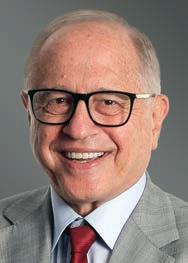
EDITORS’ NOTE Richard Rosenbaum is the Executive Chairman of Greenberg Traurig, a unified international law firm of more than 2,500 attorneys spanning 43 offices around the globe, and has long been considered a thought and change leader in the broader legal profession. He joined the firm in 1985 as its 90th lawyer and has since been integrally involved in forming and intensely executing the strategies which have led to the firm’s growth and unique culture across the Americas, Asia, Europe, and the Middle East. He closely guards the firm’s long-term core values while still aggressively navigating ever-changing times. Rosenbaum has always put the firm’s clients and people first, understanding that a law firm leader works for them, first and foremost. He is proud of his work in founding the firm’s renowned and wideranging “ commitment to excellence” program, which ensures that all of these values remain core to the firm’s daily practice and global brand for many years to come.
FIRM BRIEF Greenberg Traurig, LLP (gtlaw.com) has more than 2500 attorneys in 43 locations in the United States, Europe, Latin America, Asia, and the Middle East. The firm reported gross revenue of over $2 billion for FY 2021 and is consistently among the top firms on the Am Law 100, Am Law Global 100, and NLJ 250. On the debut 2022 Law360 Pulse Leaderboard, it is a top 15 firm. Greenberg Traurig is Mansfield Rule 4.0 certified plus by the Diversity Lab and the Center for Resource Solutions Green-e® Energy program certifies that the firm’s U.S. offices are 100 powered by renewable energy. The firm is often recognized for its focus on philanthropic giving, innovation, diversity, and pro bono.
You played a lot of schoolyard basketball while growing up in New York City. What instincts did you develop that have translated into helping to build a top tier Big Law firm?
I grew up in Queens and spent countless hours in the schoolyard playing basketball – day and night. New York City schoolyard basketball is legendary; intense and competitive. There were no referees, and I was not the biggest guy on the court. Talent was
important, but there was a lot of talent on those streets - you needed more. You needed that hunger to improve and achieve and to also focus on team success vs. personal statistics: those were some key difference-makers. I learned that winning required hard work, repetition, and toughness. You also needed to be nimble; to anticipate where the ball was going, know when and to whom to pass the ball, and know when to take your own shot. I became resilient; I learned to give and receive hard fouls and come back fighting harder. Knowing how to succeed, but also how to accept the occasional loss, living by the rules, and respecting all involved are important life values. Ultimately, I learned to identify and utilize strengths and skill sets – my own and our teammates – that helped us work seamlessly together for our collective success. I have kept these lessons with me throughout my 37 years at Greenberg Traurig.
Greenberg Traurig has built a strong brand over the years around being always innovative, ever nimble, and finding opportunities in change. Will you elaborate on your new branding, “GT: BigLaw Redefined”?
We truly believe we are a better version of Big Law. From three lawyers in Miami in 1967, Greenberg Traurig has grown into a global powerhouse of more than 2500 attorneys in 43 locations in the United States, Europe, Latin America, Asia, and the Middle East. We are the only Florida firm to reach that level of success and we are still number one in the state. In New York, our presence has expanded from a few lawyers and one location in 1991 to more than 300 lawyers in multiple offices, centered on a state-of-the-art office in Manhattan. No one in Big Law understands and covers the New York metropolitan area more comprehensively, from deals to litigation to government representation to technology and beyond.
At this point in our 55-year history, we have reached a critical size and geographical footprint which allows us to help find a better way forward for Big Law. Always redefining ourselves, we are now boldly redefining the legal landscape. “GT: BigLaw Redefined,” our new branding, reflects who we are today and where we are going. Greenberg Traurig has a uniquely business-minded culture and global platform where attorneys can grow and scale their practice, while providing the highest quality
of service and value to their clients and feeling free to compete on the ground. Our attorneys and staff also embrace a desire and responsibility to create a more just world though our unwavering commitment to diversity, equity, and inclusion (DE&I), as well as through our prolific philanthropic and pro bono work.
With the world changing faster than at any other time in history, along with our firm’s meteoric growth, our new branding reflects our emphasis on creating an unmatched environment for our clients, lawyers, staff, firm, and the world.
Will you discuss Greenberg Traurig’s values and how you define the Greenberg Traurig difference?
The world is increasingly interconnected. Whether our clients have one location or an international presence, their businesses can be dramatically affected by global events, from micro- and macro-economic volatility to health crises to political upheaval. Our unique model, offering global reach with an empowered local team and personal touch, best serves this evolving dynamic. And trust is at the heart of our system: by embracing trust, we create value for our lawyers and clients alike.
Our distinguished attorneys have deep local roots, community connections, and worldwide resources. They also have the business acumen with genuine client and industry knowledge that allows them to provide practical legal advice, not just legal theory. Therefore, we know business, and can offer extensive depth and breadth of global resources across industries, practice areas and geographic locations, as well as subjectmatter experts to better serve clients locally and globally. This is part of our full-service, relationship-oriented approach. Our lawyers collaborate by giving clients more comprehensive, responsive service and advice informed by multiple perspectives to increase value.
Greenberg Traurig’s culture was built on a solid foundation with core values of excellence, integrity, trust, respect, diversity, equity, inclusion, and collaboration. We are immensely proud of the firm’s renowned “Commitment to Excellence” program, which ensures that these values remain central to the firm’s daily practice and global brand for many years to come.
What were the keys to Greenberg Traurig’s ability to reach record revenue in 2021?
There is no one answer. Being fighters, embracing discipline, putting people first,
NEW YORK NEW YORK
Richard A. Rosenbaum
POSTED WITH PERMISSION. COPYRIGHT © 2022 LEADERS MAGAZINE, LLC LEADERS 152 VOLUME 45, NUMBER 4
remaining calm in a storm, being independent thinkers always ready for the next change, are all well-known attributes of our firm. Greenberg Traurig reported more than $2 billion in revenue for FY 2021, for the first time in our history, and the first half of 2022 was our best ever. We have gone beyond simply weathering adversity and used the opportunity to reaffirm our values, become broader, deeper, and stronger in our practices and locations, while achieving our eighth consecutive year of record revenue.
Working together as one global family, one world-class platform everywhere, formed without mergers or vereins, has enabled us to provide our clients with the best possible value in a meritocratic system. The result: we minimize bureaucracy and internal politics and maximize consistency of quality and values. We are also nimble and able to move on a dime, just like I remember doing as a kid on the basketball court. Additionally, we have the diversity in practices, locations and people that allows us to understand and respond to clients’ changing legal needs in real time. This formula has led to continuous record-setting performance.
We remain committed to fiscal responsibility by intentionally instituting operational efficiencies. We are investing in business processes and technologies that support knowledge management, client relationship management, legal project management, matter budgeting, and innovative digital communications, in addition to creating economies of scale to ultimately benefit our clients and our firm.
With the current war for talent in Big Law, how are you able to continuously recruit and retain top-tier professionals?
We are proud of our ability to attract toptier professionals in the most in-demand practices and in the most important legal markets in the world. One key differentiator is our unique “freedom within a framework” philosophy. Talented attorneys come here because at Greenberg Traurig, entrepreneurship, meritocracy, and drive are rewarded. Our attorneys are thought leaders and empowered, bootson-the-ground decision-makers – rooted in our core values and culture. We believe in growing together.
We can mobilize teams and resources to make quick decisions based on what clients need. Business development budgets aren’t rigidly predetermined; attorneys can make a
case for what they need. We also offer sophisticated finance professionals and tools to help with case and practice management, budgeting, and alternative fee arrangements – all quickly delivered in ways not possible at firms governed by committee or otherwise driven by internal politics.
We want everyone to reach their highest potential so they can grow within our firm. We provide ongoing substantive programs for professional skills development in addition to mentoring by leadership and senior attorneys. We have the resources and tools to help attorneys evolve and grow their practices. In addition, we care for the well-being, health, and safety of our attorneys and staff, promoting and providing multiple wellness options and resources.
We are decentralized, do not have a headquarters, and do not make decisions by committee, allowing us to act quickly and aggressively. Our closed compensation system deemphasizes competition and provides a platform for collaboration. Our low shareholder attrition rate attests to this.
How are you continuing Greenberg Traurig’s longstanding commitment to diversity, equity, and inclusion and to giving back and why are these so important to the firm and the firm’s success?
The research is clear that companies that prioritize diversity, equity, and inclusion as a critical asset, outperform. At Greenberg Traurig, we know the value of having as many diverse perspectives as possible at the table to best address our clients’ challenges. Our leadership is and always has been diverse – nationally and internationally – with more than 45 percent of the firm’s Executive Committee comprising diverse leaders, including women, ethnic minorities, and LGBTQ+ individuals. It’s not just about having one minority or female partner, so you can check the box. We are continuously broadening and fostering a diverse talent pipeline in our recruiting programs which start at the community level and continue through to education and ultimately to internships, clerkships, and employment. Greenberg Traurig’s track record of putting diversity into action led us to achieve Mansfield Rule 4.0 Certification Plus from The Diversity Lab.
Giving back through pro bono and philanthropic work is a core responsibility. As lawyers, we have a social and moral responsibility to
ensure that everyone has equal access to justice. We support our attorneys and staff who provide pro bono legal services to many civic and charitable organizations as well as to individuals in need around the world. As an example, the firm has a strong partnership with the New York Legal Assistance Group and its Ukrainian Immigrant Assistance Project, including a legal clinic hosted by the New York City Mayor’s Office of Immigrant Affairs and staffed with Greenberg Traurig attorneys and summer associates. In addition to providing pro bono legal services, the firm is donating up to $2 million to bolster humanitarian aid for displaced refugees. Our employees are also personally donating.
Our Greenberg Traurig Equal Justice Works Fellows help tackle racial, economic, and social justice issues. We have also committed $5 million over five years to support programs to combat systemic racism and to provide impoverished communities and individuals with economic and social rights.
How is Greenberg Traurig’s early implementation of a hybrid work model working?
We stay connected through transparent and constant communication and collaboration – whether formal meetings or informal check-ins – online and in-person. We leverage technology and our collegial culture to work as one winning, united firm and global family to provide seamless, high-quality service and value to clients.
Given the importance of in-person interaction, camaraderie, mentoring, and firm culture, we are currently encouraging return to the office – ever mindful of the well-being and comfort of our employees.
When needed, we were able to go to a hybrid model early on because we have always been able to adapt quickly to challenges and were technologically ready. Even before the pandemic, we opened offices around the New York metropolitan area in Westchester and New Jersey to allow employees a better life-work balance and to better serve clients. When the pandemic hit, we accelerated this trend-setting program of creating offices closer to where employees and clients live with the opening of new locations on Long Island and expanding existing offices. We now cover the metropolitan area like no other global, Big Law firm and do so as one unified and empowering organization.
•
POSTED WITH PERMISSION. COPYRIGHT © 2022 LEADERS MAGAZINE, LLC LEADERS153 VOLUME 45, NUMBER 4
“Greenberg Traurig’s culture was built on a solid foundation with core values of excellence, integrity, trust, respect, diversity, equity, inclusion, and collaboration.”
A Strong and Engaged Business Community
Interview with Kathryn S. Wylde, President and Chief Executive Officer, Partnership for New York City
EDITORS’ NOTE Prior to assuming her current post in 2000, Kathryn Wylde served as the founding President and Chief Executive Officer of two Partnership affiliates, the Housing Partnership and the Partnership Fund for New York City. She is a board member of the New York City Economic Development Corporation, the Manhattan Institute, NYC & Company, the Governor’s NYC Regional Economic Development Council, and the Fund for Public Education.

ORGANIZATION BRIEF Focused on advancing the city’s standing as a global center of economic opportunity, upward mobility, and innovation, the Partnership for New York City (pfnyc.org) is comprised of top CEOs from the city’s corporate, investment and entrepreneurial sectors. It works in partnership with government to advance the interests of the city. The organization’s priorities include maintaining the city’s competitive position in the attraction and growth of its business sector and talent pool, improving public education, and fostering public/private partnerships to address the challenges facing the city. The Partnership Fund is its investment arm that contributes to strategic industry growth, support for distressed communities, and job creation.
Will you discuss the role of the Partnership for New York City in building partnerships between business and government to strengthen New York City?
When it comes to public-private joint initiatives, the Partnership for New York City serves as an honest broker between the business community and public agencies. We represent over 300 global companies that can offer a wide range of expertise and resources to help address challenges facing the city. For example, throughout the COVID-19 pandemic, the Partnership played a critical role in keeping clear lines of communication between local, state, and federal officials, and the private sector as policies on public health regulations, reopening strategies, and the deployment of vaccines were rapidly evolving. The Partnership continues to be a primary resource for building strategic initiatives to support New York City’s recovery policies and programs.
Will you provide an overview of the Partnership for New York City’s four focus areas?
The Partnership’s areas of focus include corporate social and civic responsibility; improving regional infrastructure, especially the transportation network; strengthening the education system to prepare New Yorkers for economic opportunity and advancement; and building innovation clusters to support new industries and a more diverse job market.
The Partnership organizes collective action among our member companies to have a significant impact on problems that government cannot solve alone. A recent example was the launch of a Homeless Assistance Fund alongside
the City of New York, with over 60 Partnership member companies contributing over $8 million to expand services and mental health resources for New Yorkers who are unsheltered and living on the streets. The Partnership is contracting with the nonprofit, Breaking Ground, to deploy outreach teams in areas of midtown, downtown, and Brooklyn where there are concentrations of homeless individuals in need of help.
The Partnership is also focused on helping to ensure that the city has a world-class public transit network. In 2018, the Partnership and the Metropolitan Transportation Authority (MTA) created the Transit Innovation Partnership to identify opportunities to deploy technology and private sector tools to improve the operations of subways, buses, and commuter rail. Tech companies are now working with the MTA and other regional transportation agencies to improve the subway signaling system, design a more efficient bus network, and improve public safety through new digital tools and software.
On education, the Partnership is focused on building a local pipeline for the city’s record high number of job postings, aimed at reducing an unemployment rate that is nearly twice the national average. To close the skills gaps, the Partnership links city educators with its membership to bridge curricula and the demands of the modern workplace. In 2020, the Partnership and the NYC Department of Education launched Career Discovery Week where nearly 200 of the city’s major employers invited thousands of public high school students to learn about future job opportunities.
NEW YORK NEW YORK
Kathryn S. Wylde
An
POSTED WITH PERMISSION. COPYRIGHT © 2022 LEADERS MAGAZINE, LLC LEADERS 154 VOLUME 45, NUMBER 4
“The Partnership organizes collective action among our member companies to have a significant impact on problems that government cannot solve alone.”
To ensure New York retains its competitive edge, the Partnership invests in emerging industry sectors through its investment arm, the Partnership Fund, and in coordination with the city and state’s economic development agencies. The Partnership has led efforts with the city and state to create a vibrant commercial life sciences cluster in the city whose output tripled during the pandemic. The Fund also partnered with Accenture to establish and manage a Fintech Innovation Lab that has become a global model.
Where do you see New York City’s economic recovery coming out of the pandemic?
The economy of the city remained relatively stable during most of the pandemic, thanks to the ability of key industries – financial and professional services, technology, and media – to operate remotely. The return of international tourism is important to a full revival of the retail, entertainment, and hospitality sectors. At the moment, the biggest threat to full recovery is the perception that public safety has deteriorated – something New Yorkers took for granted for more than a generation. A recent survey of city office workers found over 80 percent believe safety conditions in the city have deteriorated over the past two years, particularly in the public transit system. Publicprivate initiatives like the Transit Innovation Partnership and the Homeless Assistance Fund are helping government accelerate progress to reverse this sentiment.
Economic viability in the long term will require New York to have a competitive and accessible job market. The pandemic accelerated the shift from a service economy to a digital
economy; many of the 185,000 private sector jobs lost in New York City, primarily in the brick-and-mortar economy, will never return. Putting those New Yorkers back to work will require creating a robust and integrated talent development, job match, and hiring system. The Partnership is working with the city and state to establish new links between employers, workforce development organizations, and education institutions to prepare New Yorkers for jobs in the post-pandemic economy.
The Partnership for New York City surveyed more than 160 major employers in April 2022 and May 2022 to gauge the status of return to office among Manhattan’s one million office workers. Will you discuss the survey results and the implications for the future of the Manhattan central business districts?
Over the past two years, return to office policies have been in flux due to four successive waves of COVID-19 variants. Our May 2022 results showed that 38 percent of Manhattan office workers were in the workplace on an average weekday, but only 8 percent were in five days a week. Nearly 80 percent of employers indicate that some form of hybrid remote work model will be their post-pandemic policy.
Office attendance is expected to tick up to 50 percent on the average weekday this fall, which will help increase transit ridership and patronage of Manhattan stores and restaurants. Employers have upgraded office amenities and are offering more purposeful business and social events to encourage presence in the office. Office-goers must also feel their commute
is safe and reliable, which is beyond the control of employers.
How critical is a strong public/private partnership for New York City’s future success and do you feel that this partnership is working effectively today?
New York City’s status as a thriving global center of commerce and innovation depends on a strong and engaged business community. The Adams administration has embraced crosssector collaboration and is building new publicprivate initiatives. In the latest city budget, the mayor announced the extension of one of the Partnership’s initiatives developed during the pandemic, the Small Business Resource Network, which has provided over 10,000 small business owners with digital tools and resources to help them grow. The mayor continues to invite business leaders to the decision-making table on a whole host of policies.
You have led the Partnership for New York City for over twenty years. What has made the experience so special for you?
The Partnership offers the opportunity to work closely with some of the greatest corporate leaders and entrepreneurs in the world. These are highly successful business people with a broad civic agenda. Most share a commitment to using their power and influence to expand opportunities for all New Yorkers and build an even greater city. It has been an equal privilege to work with talented leaders and staff in state and local government who have sacrificed financial gain for a life of public service. The combination is the best of humanity and results in getting a lot of important things done.•
“Economic viability in the long term will require New York to have a competitive and accessible job market. The pandemic accelerated the shift from a service economy to a digital economy; many of the 185,000 private sector jobs lost in New York City, primarily in the brick-and-mortar economy, will never return.”
POSTED WITH PERMISSION. COPYRIGHT © 2022 LEADERS MAGAZINE, LLC LEADERS155 VOLUME 45, NUMBER 4
“The Partnership is working with the city and state to establish new links between employers, workforce development organizations, and education institutions to prepare New Yorkers for jobs in the post-pandemic economy.”
Teamwork and Collaboration
An Interview with A. Eugene Kohn, Chairman, Kohn Pedersen Fox Associates
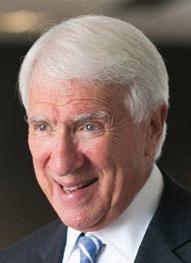
EDITORS’ NOTE On July 4, 1976, A. Eugene Kohn founded Kohn Pedersen Fox Associates (KPF) in New York City, alongside William Pedersen and Sheldon Fox, with a commitment to outstanding design, quality of execution, and exceptional client service. The Founding Partners wanted to create a firm that would succeed well past their own tenures. With this in mind, they sought talented people who could be as good, and ideally better, than themselves. These employees, mentored by the founders, would be the next leaders at KPF – and hold the responsibility of doing the same for following generations. Today, Kohn serves as Chairman and Founder of Kohn Pedersen Fox. Holding bachelor of architecture and master of architecture degrees from the University of Pennsylvania, he served in the U.S. Navy on active duty between his academic degrees and, after graduation, remained in the Reserve for another five years, retiring as a Lieutenant Commander. Kohn is an Executive Fellow of the Graduate School of Design at Harvard University. He has taught at Harvard Business School for more than ten years and at the Harvard Graduate School of Design for four years. He helped establish the Harvard Real Estate Center Academic Initiative, is a founding member of the Wharton School Real Estate Center Advisory Board, and has served for over 30 years on the Board of Overseers at PennDesign. Kohn was a trustee for the University of Pennsylvania and was honored with the 2010 Alumni Award of Merit by the university, the highest award presented to alumni. Kohn has also been recognized with the Wharton Real Estate Center’s Lifetime Achievement Award, the University of Pennsylvania – PennDesign Dean’s Medal of Achievement, the highest honor awarded by the institution, and the Ellis Island Medal of Honor.
FIRM BRIEF Kohn Pedersen Fox Associates (KPF) is one of the world’s preeminent architecture firms, providing architecture, interior, programming and master planning services for clients that include some of the most forward-thinking developers, corporations, entrepreneurs, and institutions in the United States and around the world. The firm’s extensive portfolio spans more than 40 countries and includes a wide range of projects from office

and residential buildings to civic and cultural spaces to educational facilities. Driven by individual design solutions, rather than a predetermined style, KPF’s (kpf.com) mission is to create buildings and places of the utmost quality and contextual sensitivity, providing a valuable impact on the cities they inhabit.

What have been the keys to KPF’s industry leadership and how do you define the KPF difference?
When Bill Pedersen, Shelley Fox, and I founded the firm, we set three things as goals: One, to create a great firm. Two, to do outstanding architecture of all types, but primarily commercial, which we felt would enhance and contribute to our city life and the quality of architecture. Three, create a firm that offers strong opportunities for young architects to eventually become principals and leaders of
the firm. And that has happened, as today we have 33 principals led by our President, James von Klemperer, who has been with the firm for almost 40 years. A key to this success is teamwork. We always think in terms of “we” and not “I,” when it comes to our projects, highlighting the contributions of the group over the individual. This philosophy brings out the best in people and boosts team morale.
Will you discuss KPF’s global footprint and capabilities?
KPF has a vast global presence, with nine international offices and projects complete or underway around the world. That sustained success can be attributed to firm and project leadership. Coordination among our firm’s leaders is critical, and the group meets regularly in virtual and in-person settings to discuss project pursuits, firm operations, and overall strategy. Project leaders and their teams are also in constant contact, through regularly scheduled meetings and impromptu conversations. This
NEW YORK NEW YORK
A. Eugene Kohn
POSTED WITH PERMISSION. COPYRIGHT © 2022 LEADERS MAGAZINE, LLC LEADERS 156 VOLUME 45, NUMBER 4
Hudson Commons in New York City (before - inset, and after)
continuous sharing of ideas and process is what allows us to create the best possible results for our clients, and create a strong workplace for our staff.
What has made KPF so strong at building longstanding client relationships and client loyalty?
First and foremost, it is the quality of our work - the buildings and designs we deliver - that maintains our loyal client base. Beyond that, it is the way we work with our clients, engaging them in the process and making them feel heard and understood, that also brings them back to us. We call our process the “comparative method,” where we look at a series of different possibilities, not with the intention of introducing a long menu and asking the client which one do you want, but with the idea to be able to compare one design against the other so that one can logically explain why one design seems to work for a particular client. And when our clients have issues or problems, we find a way of solving them. This is the DNA of the firm. We find that allowing the client to participate in the process makes them really a part of it and excited by it.

Will you highlight some of KPF’s recent projects?
In New York City, One Vanderbilt, our new transit-connected office tower next to Grand Central for SL Green, continues to be recognized for excellence. This month, the project will be honored as the Regional Plan Association’s “Project of the Year” at their Centennial Gala. The RPA commends the tower’s presence on the Manhattan skyline, and its impact as signaling “the beginning of the recovery of New York City from the COVID pandemic” upon its opening in the Fall of 2020. The organization noted

that, “Occupying an iconic location next door to Grand Central Terminal, planners and architects created new public spaces on Vanderbilt Avenue and designed a building that respects and enhances the historic terminal, truly enriching the public realm. One Vanderbilt is more than a once-in-a-generation transformation of Midtown Manhattan, but also the herald of what is to come.”
Hudson Commons, another New York City project, is a finalist in the Urban Land Institute of New York’s Award for Excellence in Development in the Office Development category. Hudson Commons was built in 1962 originally to function as a warehouse. KPF’s recent transformation of the building includes the renovation of the existing eight-story building and the addition of a 17-story glass-and-steel overbuild. Last year, Hudson Commons sold for over $1 billion, more than tripling the price of the building before its renovation four years prior.
And across the country, our work continues. In Philadelphia, we just completed a major new residential tower on the Avenue of the Arts. The building is prominent on the skyline, marking the district from afar, and contributes to the street level with a generous urban base. It is located across from the Kimmel Center, and offers spectacular views of the city. In Tampa, our project Heron, another residential building, has been incredibly successful. It is nearly fully leased and asking some of the highest rents in the neighborhood.
KPF has placed a major focus on sustainability. What has made this so important for the firm and will you provide an overview of KPF’s sustainability initiatives?
Climate change is the single biggest issue we are facing as a global society, so, as a global practice, we consider it our duty to design lasting architectural solutions that mitigate their lifecycle impact on environmental resources and that protect and enhance the well-being of the communities they serve. We believe it is imperative to design and advocate for resilient architectural solutions that minimize both operational and embodied GHG emissions, and
Heron in Tampa, Florida
POSTED WITH PERMISSION. COPYRIGHT © 2022 LEADERS MAGAZINE, LLC LEADERS157 VOLUME 45, NUMBER 4
Arthaus in Philadelphia
which push the boundaries of their cultural, economic, and political context. For that reason, we have joined AIA, RIBA, and many of our peers in a joint effort to develop the capabilities to design and deliver carbon neutral buildings by 2030, which can embody the goals we need to achieve as a society.

This mission extends beyond our project work to our own campus and community as we endeavor to achieve operational carbon neutrality by minimizing our energy, water, and waste impact and investing in the World Wildlife Fund’s Climate Crowd and Alliances for Climate Action programs. KPF is the first architecture firm in the U.S. to have an office WELL Health-Safety certified. This institutional effort is paired with developing the environmental expertise of our staff through education, knowledge exchange, and awareness programs. Our objective is to serve, through both design and practice, as responsible stewards of our planet.
How is technology impacting the way KPF operates?
Technology is an integral part of the firm’s day-to-day operations and allows us to function efficiently as a global practice. It also enhances the work itself and advances our goals for a project.
KPF’s commitment to climate action drives in-house innovation, through both project application and increasing design workflow efficiency. In the context of global warming and extreme weather as well as the COVID-19 pandemic, KPF’s work crafting resilient and comfortable urban spaces that limit their environmental impact is more relevant than ever. Our designers rely on KPF’s modeling and analysis capabilities to understand the effects of air movement, temperature, and humidity on the microclimate around their projects.
How important is it for KPF to build a diverse and inclusive workforce to bring diverse perspectives and experiences to the table when addressing client needs?
Our workforce is extremely diverse, with many people from numerous countries across Europe, Asia, South America and the Middle East. We understand that in order to provide the best architectural solutions, our designers must be reflective of the populations they serve, and so we recruit and retain staff to that effect. Our firm is also fairly balanced between the number of men and women, but we know we still have work to do to ensure more women leaders represent KPF at the senior levels. Though men have traditionally dominated this profession, we are seeing a broader shift toward balance in architectural education as well. When I was a student, there were two women in my five-year class at University of Pennsylvania. Today, over half the program is made up of women. So, while the workforce in the profession today reflects the demographics in education many years ago, the future is currently reflected in today’s student body. I think this will continue so that in the future women will dominate the profession, and our firm continues to strive to enhance its diversity.
What do you see as KPF’s responsibility to the communities it serves?
Buildings – both new and renovated – have a lasting impact on their communities, often standing for many decades. So, the design itself must work not only for the intended purpose of the current user, but must also contribute to the surrounding context. KPF is committed to creating places loved by users and neighbors alike. We take that responsibility seriously, engaging local community members from the earliest stages of the design process, sharing our ideas and spending time to build trust and to better understand their needs. At NYCHA Red
Hook Houses in Brooklyn, for example, we held numerous workshops with residents, elected leaders, parents, and even children, in order to craft a design for the public spaces that was both resilient and usable. Our plan improves building entries and site lighting, creates pedestrian spaces, courtyards, and playgrounds, and aids in wayfinding across this large expanse of repetitive, circa 1930s structures.
KPF is headquartered in New York. What do you see as New York’s advantages in attracting talent and growing a business?

New York is KPF’s home. We’ve always had our headquarters here, and have done significant, city-shaping projects in New York. The city will always be attractive to talented, driven people –whether just starting out in their careers, or moving from elsewhere to pursue a new opportunity. And for those just beginning their career pursuits, there are great universities here, with excellent architecture programs that produce highly capable designers. There is an endless amount of culture one can experience in New York to feed one’s interests within and outside of the field. Recruiting and retaining the best talent is the most important part of growing a successful business, and New York remains highly attractive.
What do you feel are the keys to building a career as an architect?
Foundational to a successful career is a good education, so I recommend going to the best possible architecture school to learn about the practice and profession. From there, a young architect should seek out a position at a strong firm, small or large, to learn about the different phases of work – designing, creating working drawings, and all of the aspects of a professional practice. Working at a firm can give one a different kind of education in terms of process, so I recommend getting as involved as possible in all types of projects and learning what it means to work on a team in a professional setting.•
POSTED WITH PERMISSION. COPYRIGHT © 2022 LEADERS MAGAZINE, LLC LEADERS 158 VOLUME 45, NUMBER 4
The entrance to One Vanderbilt in New York City (above) and the building’s profile (below)
INVESTOR. DEVELOPER. PLACEMAKER.























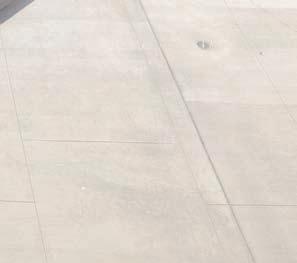























RXR.COM
Featured: Pier 57 Public Rooftop Park
A Powerhouse in Sports Representation
An Interview with Michael “Vino” Levine and Howard Nuchow, Co-Heads, CAA Sports
EDITORS’ NOTE In 2006, 2007 and 2008, Michael Levine was recognized by Street & Smith’s The Sports Business Journal as one of the Top 40 Sports Executives Nationwide Under the Age of 40. He was inducted into its Hall of Fame in 2008 and has since made 13 appearances on the publication’s list of the Top 50 Most Influential Executives in the Sports Business. In 2013, Levine earned the Honoree of the Year Award from the UJA-Federation of New York’s Sports for Youth. He graduated from Cornell University with a BA in history.


Howard Nuchow has been featured consistently among the Top 50 Most Influential Executives in the Sports Business by Street & Smith’s The Sports Business Journal since 2008, and was one of its Top 40 Sports Executives Under the Age of 40 in 2003 and 2007 before entering its Hall of Fame in 2008. Prior to joining CAA in 2007, he was the first employee of Mandalay Sports Entertainment (MSE), one of the premier sports companies in the U.S., which owns and manages professional sports franchises throughout the country.
Nuchow and Levine are on the board of CAA Eleven, a company they helped form in 2012, which manages the broadcasting, sponsorship, and licensing rights of the UEFA EURO™, UEFA European Qualifiers™, and UEFA Nations League™ on behalf of UEFA.
COMPANY BRIEF The five-time recipient of the award for “Best in Talent Representation and Management,” presented by The Sports Business Journal , CAA Sports (caa.com) represents more than 3,000 of the world’s best athletes in such sports as baseball, football, hockey, basketball, and soccer, in addition to coaches, on-air broadcasters, and sports personalities. Beyond traditional athlete representation, CAA Sports provides unique opportunities for clients off the field in areas including entertainment, licensing, endorsements, speaking, philanthropy, publishing, and video games. CAA Sports also works in the areas of media rights, property sales and sponsorships, brand consulting, venue development and strategic advisory, and executive search, and received the award for “Best in Corporate Consulting” at the 2018 Sports Business Awards, and “Best in Property Consulting, Sales, and Client Service” in 2014, 2016, 2019, and 2022.
What was your vision for creating CAA Sports 16 years ago and what did you see as the opportunity for the business?
Nuchow : It became very clear early on in our conversations with Creative Artists Agency (CAA) that building a sports division within the world’s best talent agency would enable us to create unprecedented opportunities for clients across all areas of the
global sports industry. We learned that CAA was built on a culture of collaboration – this idea that agents work in teams, pulling from the individual expertise and strengths of its members – to provide best-in-class service to clients.
We initially set our sights on building the best sports talent representation practice, and once established, we would move into other areas of the sports business.
Levine: Our plan was to assemble a team of world-class agents who were entrepreneurial, service-oriented, and could thrive in a collaborative environment. Throughout our careers, we have both witnessed different roll-up attempts in the sports industry, and from that we knew that it was not just about gathering superstar agents, but very specifically identifying agents who would be a good cultural fit. Then, if we arm them with CAA’s global expertise and resources in entertainment and culture, CAA Sports would be an absolute powerhouse in the talent representation space.
NEW YORK NEW YORK
Michael Levine
Howard Nuchow
“Throughout our careers, we have both witnessed different roll-up attempts in the sports industry, and from that we knew that it was not just about gathering superstar agents, but very specifically identifying agents who would be a good cultural fit. Then, if we arm them with CAA’s global expertise and resources in entertainment and culture, CAA Sports would be an absolute powerhouse in the talent representation space.”
POSTED WITH PERMISSION. COPYRIGHT © 2022 LEADERS MAGAZINE, LLC LEADERS 160 VOLUME 45, NUMBER 4
Michael Levine
We saw this philosophy quickly come to life in those early years, and our impact was immediate. Shortly thereafter, our success was acknowledged publicly. We won Best in Talent Representation at the Sports Business Awards in 2009, 2010, and 2011, and for eight consecutive years we topped Forbes’ Most Valuable Sports Agencies list beginning in 2013.
How has CAA Sports evolved over the years?
Nuchow: We are the world’s largest sports representation agency. Our clients include many of the most accomplished athletes in football, basketball, baseball, hockey, and soccer, in addition to broadcasters, coaches, and sports personalities. We handle all aspects of their business – both on and off the field – and are in awe of what these clients have achieved throughout their careers.
Levine: We have also solidified our leadership position in the corporate representation side of the sports business. Today, we work on behalf of brands, leagues, teams, governing bodies, college conferences, and owners on their most important revenue streams like sponsorship, media rights, and facility development; we provide executive placement services; and so much more.
Within the past decade, we have replicated all of the domestic success we have seen in these areas overseas, and are incredibly proud of the impact the agency and our clients are having on the international sports marketplace.
How do you define CAA Sports’ mission and purpose?
Nuchow : At CAA, we strive to be the best company in the world and the most
powerful resource for our clients. We are advocates. We mentor one another, and aim to be leaders internally and externally. We are committed to making our company reflective of the world we live and work in every day.
CAA Sports is now 750 employees strong, spanning five continents. Our leadership team is second to none, beginning with Paul Danforth, President of CAA Sports. Paul has been with the agency almost as long as we have, and we consider him our third partner. There is nobody as accomplished or as highly regarded as Paul in our business.
Levine: We have the most impressive female executives working at the highest levels of leadership in our organization: Jordan Harnsberger is our Chief of Staff, and Lisa Joseph-Metelus serves on the Agency Board; Aubree Curtis and Liz Gray co-lead CAA Brand Consulting; Jennifer Duberstein is our General Counsel, and Beth McClinton leads our communications strategy globally; Marissa Dishaw and Jen Kardosh oversee Marketing and Client Servicing in Baseball and Hockey, respectively, and Jessica Holtz just became the first female NBA Agent ever to broker a super-max contract and she did two in one day.
The future is bright for the next generation of leaders at CAA Sports. Alexa Cook in our Property Sales division joined the agency as an assistant in 2010, and last year she brokered more than $1 billion in sponsorship transactions on behalf of such clients as the Los Angeles Clippers, Formula One, and Riot Games.
What differentiates CAA Sports from other agencies in the industry?
Levine : The agency’s culture is by far our biggest differentiator. It’s something we collectively work hard to nurture every day. The idea is simple: when we take care of each other, good things happen. We encourage everyone to live by these words. We are accountable to each other. We share knowledge and experience. We work in teams. We are advocates for our clients. I don’t know of any other agency that operates this way. It’s one of the most rewarding aspects of the job.
What do you see as the core strength of the CAA Sports team?
Nuchow: Our people are our strength. We have the great fortune of working with the most ambitious, driven, and innovative agents and executives. Our colleagues work at the highest levels of the industries in which we operate, making anyone, anywhere just one phone call away at any time. Our leaders are exceptional mentors, investing their time in training the next generation of superstars. Our bench is deep and impressive, and continues to grow every day.
What has made the relationship between the two of you work so well?
Levine: We are friends first and foremost. Howie and I have grown up in this business together. Our families are close. We vacation together. We love each other; we fight all the time; and are equally committed to making decisions that benefit everyone.
Nuchow : The foundation of our relationship is built entirely on trust. We share the same goals for each other, the company, our clients, and all of our employees – and those are success and happiness. The relationship is actually pretty easy, and is just as good today as it was 16 years ago when we started CAA Sports, and 30 years ago when we first met.
How do each of you focus your efforts and describe your management styles?
Levine : We definitely have a yin-yang approach to management, but we share the same philosophy in that any decisions we make have to be for the greater good of CAA.
Nuchow: Vino is infectious – you just want to be around him and his positive energy. He is the biggest advocate for everyone’s success. My strength is seeing around the corners. I look for things that might impact our business and success.
Levine: The combination of our skill sets enables us both to bring the best versions of ourselves to work every day, while knowing the other person is watching out for them every step of the way. Howie is constantly looking out for me and I couldn’t possibly do this job as comfortably or capably without him constantly covering my back.
What is next for CAA Sports?
Levine : We are 19 business areas strong, with plans to keep growing. We are experiencing tremendous success both domestically and internationally. We have just opened a new office in Singapore, and have plans to expand into even more markets worldwide.
Nuchow : We are so proud of the many women and men in leadership who are guiding this company to new and exciting opportunities. It’s a really transformative time for us.•
“We are the world’s largest sports representation agency. Our clients include many of the most accomplished athletes in football, basketball, baseball, hockey, and soccer, in addition to broadcasters, coaches, and sports personalities. We handle all aspects of their business – both on and off the field – and are in awe of what these clients have achieved throughout their careers.”
POSTED WITH PERMISSION. COPYRIGHT © 2022 LEADERS MAGAZINE, LLC LEADERS161 VOLUME 45, NUMBER 4
Howard Nuchow
Creativity and Adaptability
with
S. Karp, Chairman, Paul, Weiss, Rifkind, Wharton & Garrison
EDITORS’ NOTE Chairman of the firm since 2008, Brad Karp is one of the country’s leading lawyers and corporate advisers. He has extensive experience successfully defending financial institutions and other companies in “bet-the-company” litigations and regulatory matters.
FIRM BRIEF Paul, Weiss, Rifkind, Wharton & Garrison LLP (paulweiss.com) is a firm of about 1,000 lawyers with diverse backgrounds, personalities, ideas and interests who provide innovative and effective solutions to their clients’ most complex legal and business challenges. The firm represents many of the world’s largest and most important public and private corporations, asset managers and financial institutions, and clients in need of pro bono assistance.
How do you define the Paul, Weiss difference, and what sets the firm apart in the industry?
A hallmark of Paul, Weiss is that we go above and beyond for our clients. We strive to solve their most complex problems, deliver exceptional results, and exceed their expectations, each and every day. We value an entrepreneurial mindset, enabling us to be nimble and to thrive in challenging situations.
We also have a distinctive professional culture; we value professional excellence, collaboration and mutual respect, and we share a dedication to diversity, equity and inclusion and pro bono work. As a partnership, we are remarkably cohesive, facilitated by the fact that most of us are located in our New York office.
What are the keys to Paul, Weiss’ resilience as a law firm?
We are strategically focused and disciplined in what we do; we don’t try to do everything for our clients. Instead, we have thoughtfully invested in five core practices where we lead the market: private equity, public company M&A, litigation, white collar and regulatory defense, and restructuring. Because our practices are balanced, we are resilient as economic and legal market conditions change.
Second, we focus intensively on our talent. We recruit the best lawyers and provide them with the best professional environment in which to flourish. The most talented, entrepreneurial lawyers want to be here because they know
we offer the platform they need to rise to the very top of their fields and do important work on the most important matters for the most important clients in the world. Our younger lawyers know they will get to work directly with our partners, hone their skills, nurture their client relationships, and build their practices.
How do you describe Paul, Weiss’ culture, and what have been the keys to maintaining culture as the firm has grown?
In a word, professionalism. We are deeply passionate about our work, we set incredibly high standards in all that we do, and we truly enjoy working with each other. We value collaboration and, while we thrive on the fast-paced nature of our work, we also strive to maintain a collegial atmosphere permeated with mutual respect.
Our partnership continues slow, steady growth each year, but as we grow, we strive to do so in ways that are consistent with these fundamental values.
What has made Paul, Weiss so successful at building long-standing client relationships and client loyalty?

It comes down to results. We produce unmatched results for our clients. Clients know that they can trust us with their most threatening, challenging matters, including highstakes enforcement actions, trials, and appeals. They know that they can trust our deal lawyers to execute their largest and most important
business transactions. Our lawyers are among the most experienced and effective in the world.
Second, we treat our clients’ problems as if they are our own. This sets the tone for our client relationships, which are built for the long term and grounded in trust, unwavering support, and impeccable service. We take time to understand our clients’ priorities, businesses, and internal cultures so that we can deliver solutions aligned with their business goals and risk tolerance.
Finally, clients like to work with us. They appreciate our professional culture and that we enjoy working together. Many share our dedication to diversity, equity and inclusion and pro bono; in fact, we frequently collaborate with our clients on DEI and pro bono initiatives.
What is Paul, Weiss doing to meet the changing needs of clients in today’s highly competitive legal market?
Creativity and adaptability are essential. We are continually thinking ahead and looking for ways to leverage our core strengths to develop innovative cross-disciplinary solutions. For example, many companies face increasing shareholder scrutiny regarding their diversity, equity and inclusion commitments. We recently launched a Civil Rights and Racial Equity Audit Group – one of the first in the nation – to help companies ensure that they are meeting these commitments, while reducing legal, reputational, and business risk. The team, led by former U.S. Attorney General Loretta Lynch and other senior partners, conducts bespoke investigations that help clients understand any
NEW YORK NEW YORK
Brad S. Karp
An Interview
Brad
POSTED WITH PERMISSION. COPYRIGHT © 2022 LEADERS MAGAZINE, LLC LEADERS 162 VOLUME 45, NUMBER 4
“In early 2020, after fielding many calls by clients seeking our guidance in the ESG area, we launched the law firm industry’s first dedicated Sustainability & ESG Advisory practice. Today, our work in this area is comprehensive, ranging from M&A due diligence to enterprise ESG assessments to racial equity audits, and more.”
gaps between specific DEI commitments and the reality experienced by diverse stakeholders. Our goal is to provide practical recommendations and guidance.
Our clients, which include some of the world’s most sophisticated alternative asset management firms and leading public companies, are also facing unprecedented market volatility and economic dislocation, which poses both challenges and opportunities. We recently brought together our most experienced finance and restructuring lawyers to create a Hybrid Capital & Special Situations practice that we believe is unique in the market. Our team has unmatched ability to structure, negotiate and implement innovative, complex capital solutions, whether we are helping our clients weather financial challenges or capture fastmoving opportunities.
A few years ago, Paul, Weiss created the first dedicated Environmental, Social & Governance advisory practice at a law firm. Will you discuss your ESG practice?
This is another example of how we have proactively evolved to meet our clients’ emerging needs. In early 2020, after fielding many calls by clients seeking our guidance in the ESG area, we launched the law firm industry’s first dedicated Sustainability & ESG Advisory practice. Today, our work in this area is comprehensive, ranging from M&A due diligence to enterprise ESG assessments to racial equity audits, and more. We help clients respond to ever-increasing stakeholder pressure to address ESG concerns and new
regulations around ESG disclosures, establish ESG initiatives aligned with their business priorities, construct internal systems to track and report on progress and, increasingly, identify and take advantage of business opportunities through harnessing ESG.
You mentioned Paul, Weiss’ commitment to diversity, equity and inclusion. Why is this area so important to the firm?
Paul, Weiss has been committed to diversity, equity and inclusion since our firm’s founding. We have long recognized that it’s not just the right thing to do, but that we are better advisors when we bring a diversity of perspectives to each matter. Today, many clients are demanding diversity in and transparency around staffing. They want to see diverse lawyers leading matters and client relationships. We have designed systems allowing our clients and our partners to track the diversity of their matter teams in real time. We recently received Mansfield Rule Certification, which certifies that we have affirmatively considered at least 30 percent women lawyers, lawyers from underrepresented racial/ ethnic groups, LGBTQ+ lawyers, and lawyers with disabilities for leadership roles, partner promotions, client pitch opportunities, and senior lateral positions.
But we recognize that we need to do better. In recent years, we have rolled out many initiatives to support diverse lawyers in their career development. We continue to examine our internal structures and look for ways to be more accountable and more transparent on these issues.
Pro bono has long been part of the fabric of Paul, Weiss. Will you share some of the firm’s recent pro bono efforts, including in New York City?
Paul, Weiss has led high-impact pro bono cases for decades, from partnering with Thurgood Marshall and the NAACP in Brown v. Board of Education to abolish segregation in public schools, to persuading the Supreme Court to establish a constitutional right to samesex marriage in the Windsor case, to establishing the principle of one person, one vote in Gray v. Sanders
Today, to name just a few efforts, we are coordinating law firm coalitions to address the ongoing epidemic of gun violence; challenging state voter disenfranchisement challenges; spearheading civil damages lawsuits against extremist hate groups; and providing pro bono legal services to BIPOC-owned businesses.
In New York, we are co-chairing the NY Attorney General’s Abortion Access Task Force, and as part of that, we are representing several major healthcare providers and abortion access funds and staffing a legal hotline. We are representing families of victims of antiAsian violence and providing transactional legal assistance to some of New York City’s most influential nonprofits focused on poverty alleviation, among other matters. And we were a founding member of the Homeless Assistance Fund, a new public-private partnership between New York City and New York-based businesses, which is intended to tackle the homelessness crisis.
What makes the legal profession and the practice of law so special for you?
As the head of one of the world’s leading law firms, I feel incredibly fortunate to be in a position to leverage our firm to contribute to positive change at a time when we are facing urgent threats to our rights and most cherished democratic institutions.
As a lawyer with a busy practice, I never tire of the intellectual challenge of solving my clients’ most difficult problems and the satisfaction that comes from helping them through their most serious business and legal challenges. Over the past three-plus decades, I have had the opportunity to continuously learn about new industries and to deepen my relationships with my clients, many of whom have become close friends. I can’t imagine a more fulfilling career.•
“We are deeply passionate about our work, we set incredibly high standards in all that we do, and we truly enjoy working with each other. We value collaboration and, while we thrive on the fast-paced nature of our work, we also strive to maintain a collegial atmosphere permeated with mutual respect.”
POSTED WITH PERMISSION. COPYRIGHT © 2022 LEADERS MAGAZINE, LLC LEADERS163 VOLUME 45, NUMBER 4
“Today, to name just a few efforts, we are coordinating law firm coalitions to address the ongoing epidemic of gun violence; challenging state voter disenfranchisement challenges; spearheading civil damages lawsuits against extremist hate groups; and providing pro bono legal services to BIPOC-owned businesses.”
A Holistic Approach
An Interview with Margaret Pastuszko, President and Chief Operating Officer, Mount Sinai Health System
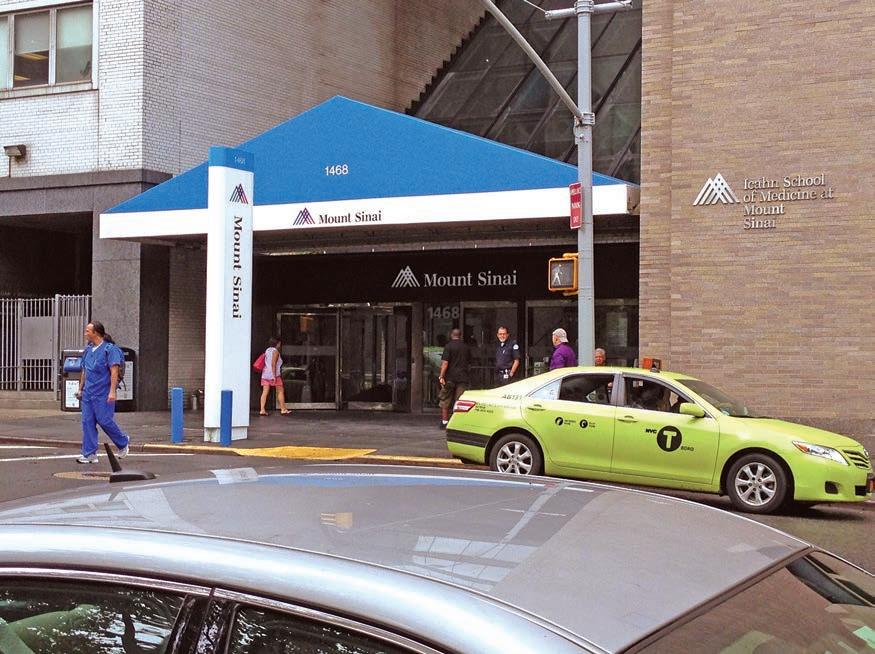
EDITORS’ NOTE Prior to her current role, Margaret Pastuszko served as Executive Vice President, Chief Operating Officer, and Chief Strategy Officer where she led Mount Sinai’s commitment to performance and process improvement and the identification of opportunities for investment and resource optimization. She began her career at Mount Sinai in 2001 as Associate Dean of Operations for the Mount Sinai School of Medicine and then transitioned to the role of Vice President for Business Planning at The Mount Sinai Medical Center. Before joining Mount Sinai, she served as a Divisional Administrator and Practice Manager of Internal Medicine at Temple University Hospital. She also worked as a consultant with APM Management Consultants and, later, with CSC Healthcare. Pastuszko earned a bachelor’s degree in economics with a concentration in multinational management and international finance and an MBA with a major in healthcare management and economics from The Wharton School of the University of Pennsylvania.

INSTITUTION BRIEF Mount Sinai Health System (mountsinai.org) encompasses the Icahn School of Medicine at Mount Sinai and eight hospitals, as well as a large and expanding ambulatory care network. The eight hospitals –Mount Sinai Beth Israel, Mount Sinai Brooklyn, The Mount Sinai Hospital, Mount Sinai Queens, Mount Sinai St. Luke’s, Mount Sinai South Nassau, Mount Sinai West, and New York Eye and Ear Infirmary of Mount Sinai – have a vast geographic footprint throughout the New York metropolitan region. The Mount Sinai Hospital is ranked number 14 in the nation by U.S. News & World Report and ranked in the top 20 nationally in eight medical specialties in the 2019-20 “Best Hospitals” guidebook. The New York Eye and Ear Infirmary of Mount Sinai is also ranked nationally in ophthalmology.
Mount Sinai Health System is a purposedriven organization with a long history of supporting its employees, patients, and communities. How do you define Mount Sinai Health System’s purpose and how is purpose at the foundation of Mount Sinai Health System’s culture?
Mount Sinai’s purpose is to advance and innovate care for all of the communities that we serve, to teach the next generation of physicians and caregivers, and to bring to market new discoveries. We created an internal motto which states; we welcome and care for our patients and each other every step of the way. I believe that is at the core of our culture. It’s almost too simple, but brilliant in its simplicity. We want to bring the best we can forward for our patients and each other, and we are relentless in this pursuit.
What do you see as the biggest challenges facing leading health systems and hospitals as you look to the future?
The healthcare industry is at a fundamental crossroads that can create opportunities but also tremendous challenges. Patient care is currently fragmented across multiple sectors including physician practices owned by insurance
providers, by venture capital, and by world conglomerates who view entering healthcare as a lucrative opportunity. If not managed appropriately, this can create a misalignment where the patient will not be the core focus. All physicians who enter this industry uphold the oath to their patients, and all of us who work in the healthcare industry must be focused on aligning the business interests with optimal patient care and outcomes. That is a huge responsibility for the leaders of both the new entrants to the industry as well as those of us who have been doing it for decades.
What is your vision for the evolving role of the hospital as health systems grow their ambulatory care and outpatient facilities?
We are foremost a health system focused on a holistic approach to patient care and wellbeing. The boundaries between the hospital, an ambulatory facility, and telehealth are becoming more fluid. We are expected to provide the best access and care to our patients regardless of the
NEW YORK NEW YORK
Margaret Pastuszko
POSTED WITH PERMISSION. COPYRIGHT © 2022 LEADERS MAGAZINE, LLC LEADERS 164 VOLUME 45, NUMBER 4
Entrance to the Icahn School of Medicine at Mount Sinai
physical or virtual setting in which it takes place. We exist on a journey with our patients, and they will require different services at different times in that journey. We will always be there to provide those services and support to them - we always find a way.
With the short-term and pressing challenges facing healthcare providers today, how critical is it to still focus on and make the long-term investments needed for the future?
We must invest in the future. That is our responsibility. Innovation requires investment and people taking risk to create better treatments, cure diseases, and find new and better ways to service the industry. The provider sector of the healthcare industry is unfortunately under tremendous financial pressure, so investments have to be made wisely and with a great deal of thought for short-, medium-, and long-term returns.
Will you discuss Mount Sinai Health System’s focus on building a diverse and inclusive workforce to mirror the diversity of the patients and communities it serves?
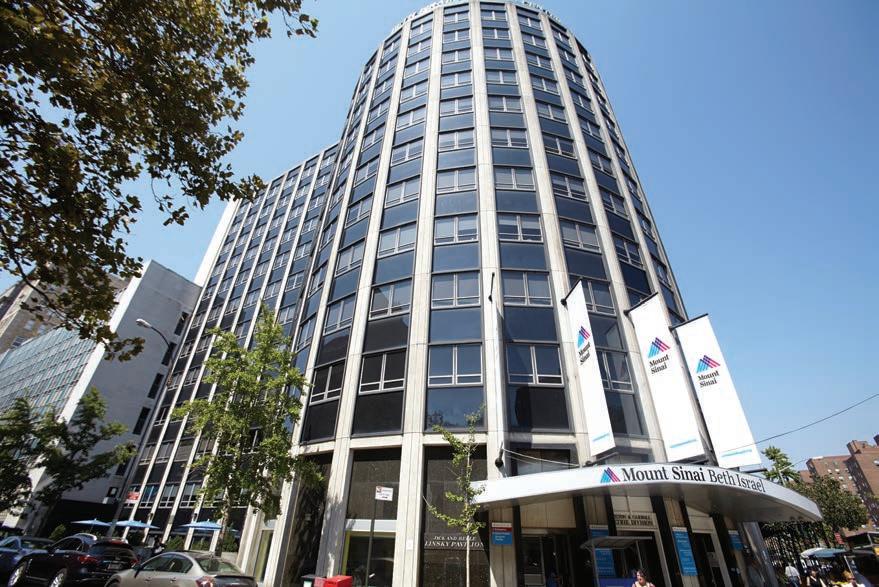

Mount Sinai focuses on diversity with purposefulness. Creating a diverse culture is imbedded in everything we do. We continue to evolve and get better at it. I truly believe that the best means to deliver compassionate care is to have a workforce that reflects and represents those who we serve. A great deal of our employees come directly from our primary service areas. They are both our employees and our patients. It makes Mount Sinai relatable and compassionate.
How critical is it for medical schools to transform their curriculum to best prepare the future leaders in medicine?
Evolution in physician training is critical. Future training of our physicians must combine the basic clinical knowledge while incorporating
a focus on transformational advancements and discoveries. The fundamentals of compassion, empathy, and equity will always be weaved into the curriculum. I do expect that the curriculum for our new generations of physicians will need to integrate novel ways of communicating and interacting with our patients.
Are there strong opportunities for women to grow and lead in the industry?
There are huge opportunities for women to take leadership positions in the healthcare industry, as there are in all industries. In particular, as the healthcare industry has evolved
and will continue to drastically change in the future, it will require an acute business acumen to navigate the challenges, but will necessitate diversity to succeed. Measures of success in the future will not be defined by the past. The ability of women to represent and lead diverse workforces, to bring creativity and collaboration, and to advance new business concepts and structures is a winning strategy for the industry.
What advice do you offer young people interested in building a career in medicine?
The only advice that I can offer is to bring passion and dedication with you. Medicine is not well represented in the movies or in television. This is a tough business that can take a great toll on people’s emotions and lives. It’s a unique combination of the highest humanitarian work blended with one of the toughest business models. A career in medicine can be the most rewarding and the best experience of your life, but the personal commitment to patients and career are unparalleled.
What has made working in healthcare so special for you and what do you enjoy most about the industry?
What makes it special is the people that I work with. I am surrounded by people who have the same passion and commitment to our patients that I have. This makes it possible to go through all the tough times, because we are in this together. We have the most amazing team that I could ever imagine. It may sound cliché, but what I enjoy the most is making a difference. What other industry can claim to have such a profound impact on someone’s life? What other industry is alongside patients and families during the happiest and the most difficult moments in their lives? I am proud to say that the work we do - to heal and care for patients and families in their health journey - is remarkable and rewarding.•
The Mount Sinai Health System campus in Manhattan’s Upper West Side
POSTED WITH PERMISSION. COPYRIGHT © 2022 LEADERS MAGAZINE, LLC LEADERS165 VOLUME 45, NUMBER 4
Entrance to the Mount Sinai Beth Israel teaching hospital
A High-Trust Workplace
EDITORS’ NOTE Edward Piccinich has spent 20 years committed to driving asset value enhancement across the SL Green portfolio through the implementation of market-leading operational programs and supported by a formidable team structure. Since joining SL Green in 2002, he has been responsible for overseeing several business lines, including Operations, Development and Construction, Security and Life Safety, Underwriting, Hospitality, Sustainability and ESG, Technology, People Experience (HR), Office Administration, and management of SL Green’s portfolio of Manhattan properties, comprised of commercial office, retail, residential, and mixed-use assets. Piccinich also manages SL Green’s robust $4 billion+ development pipeline, namely the reimagination of One Madison Avenue and a boutique luxury condo project at 760 Madison Avenue in the Upper East Side district. He was also responsible for the successful completion of One Vanderbilt, a 1.7-millionsquare-foot, state-of-the-art office tower in Midtown. Other significant projects include SL Green’s first
ground-up residential development and first new project built under the 421-a Affordable Housing New York Program at 7 Dey Street in Lower Manhattan, as well as a partnership with Pace University to expand its downtown presence at 15 Beekman Street. Prior to joining SL Green, Piccinich worked at the Port Authority of New York & New Jersey, overseeing the World Trade Center complex, and at JP Morgan Chase as Vice President. He is a principal member of the Building Owners and Managers Association (BOMA), and a board member of the Real Estate Board of New York (REBNY) Management Division, the New York Building Congress (NYBC), the Realty Advisory Board (RAB), and the Hackensack Meridian Health Hospital System. Additionally, Piccinich serves on the Board of Directors for several of New York City’s Business Improvement Districts (BIDs) and other organizations, including the Flatiron 23rd Street Partnership, the Alliance for Downtown New York, the 34th Street Partnership, and the Madison Square Park Conservancy. He is an avid supporter of St. Francis Food Pantries and
Shelters and the Muscular Dystrophy Association and was recently honored by Lincoln Center’s Real Estate and Construction Council. Piccinich holds a BS degree in mechanical engineering from Manhattan College.

COMPANY BRIEF SL Green Realty Corp. (slgreen.com), Manhattan’s largest office landlord, is a fully integrated real estate investment trust, or REIT, that is focused primarily on acquiring, managing and maximizing value of Manhattan commercial properties. As of June 30, 2022, SL Green held interests in 64 buildings totaling 34.4 million square feet. This included ownership interests in 26.3 million square feet of Manhattan buildings and 7.2 million square feet securing debt and preferred equity investments.
How do you describe SL Green’s culture and how critical is culture to the success of the company?
At SL Green, we are deeply committed to cultivating a healthy workplace culture, and we are proud to have been certified as a “Great Place to Work” in March 2022. Through this amazing milestone, SL Green joins a handful of companies recognized as an “employer-of-choice” based entirely on what employees report about their workplace experience – specifically, how consistently they experience a high-trust workplace. We champion the growth of our people to their highest potential by offering a wide array of opportunities for education, training, and volunteerism, while cultivating a diverse culture of inclusion. Our people are our greatest asset, and we invest time, attention, and resources into creating a culture that values our employees.
Will you provide an overview of SL Green’s most recent development, One Vanderbilt, and how this building has impacted the landscape of New York City?
One Vanderbilt is located strategically in the East Midtown neighborhood of Manhattan next to Grand Central. It was constructed in partnership with Hines and the National Pension Service of Korea, and boldly redefines the New York City skyline. Standing at a staggering 1,401 feet tall, One Vanderbilt is the tallest office tower in Midtown Manhattan and the second tallest office tower in the city. The building is home to the SL Green headquarters, in addition to serving as a headquarters for some of the top finance, banking, law, and real estate firms in the world. The crucial public/ private partnerships that were formed during the

NEW YORK NEW YORK
Edward V. Piccinich
POSTED WITH PERMISSION. COPYRIGHT © 2022 LEADERS MAGAZINE, LLC LEADERS 166 VOLUME 45, NUMBER 4
An Interview with Edward V. Piccinich, Chief Operating Officer, SL Green Realty Corp.
One Vanderbilt
development of One Vanderbilt demonstrate how both sectors collaborated to deliver improved public spaces and transportation for New Yorkers.
SL Green worked with the City of New York and the Metropolitan Transportation Authority to enhance the district’s public infrastructure, developing $220 million worth of improvements including a new 4,000-square-foot public transit
hall inside One Vanderbilt, a 14,000-square-foot pedestrian plaza, and enhanced accessibility to Metro-North Railroad, subways, shuttle to Times Square, and future connection to the LIRR East Side Access. These open space and transit infrastructure improvements have since helped to ease congestion and overcrowding on subway platforms, improve circulation in and around the
terminal, and create new, direct pathways to the regional railroads.
One Vanderbilt has created an energized environment by allowing our tenants, visitors, and the public to enjoy an open-air pedestrian plaza that is appreciated by many.
What sets One Vanderbilt apart and makes the building so special?
One Vanderbilt exemplifies resiliency and ingenuity. Opening during the pandemic and constructed with a post-pandemic world in mind, the building incorporates advanced technologies to enhance safety, cleanliness, and wellness among tenants. State-of-the-art technologies include a seamless, touch-free experience upon entering the building, engineering enhancements such as MERV-16 filtration, and increased outdoor air and thermal imaging that reads 100 people per minute to prevent long queues. The building also has a 30,000-square-foot amenity floor, auditorium, boardroom, cafe, and outdoor terrace. SL Green kept sustainability top of mind with a $17-million investment in features to ensure the building has one of the lowest carbon footprints across similarly scaled buildings in New York City – receiving both LEED and WELL Platinum certifications. Additionally, One Vanderbilt offers a cultural experience at the city’s second-tallest observation deck, SUMMIT One Vanderbilt, and worldclass dining with renowned Chef Daniel Boulud’s restaurant, Le Pavillon.
Will you elaborate on SUMMIT One Vanderbilt and what guests can expect from this experience?

Located in the crown of One Vanderbilt, SUMMIT One Vanderbilt is a story-driven, innovative destination that combines unparalleled vistas, curated multi-sensory experiences, and cutting-edge technology. New York’s newest and most transformational destination, SUMMIT has drawn sellout crowds day and night. When it opened in October 2021, this was a major milestone for New York, signaling to global tourists that the city is open for business, further underlining that people from around the country and world want to be back in New York City. In July, SUMMIT welcomed its one-millionth guest, and has generated visitors from 57 countries around the globe. Since opening, SUMMIT has quickly become one of the most photographed locations in all of New York, and the hottest spot to propose marriage as well.
SUMMIT One Vanderbilt is produced by SL Green with the immersive art experience designed by Kenzo Digital and interior design by Snøhetta, purpose built to create a one-of-a-kind observatory experience across three levels totalling 65,000 square feet. Visitors can expect to enjoy unique thrill experiences, worldclass food and beverage, and an outdoor terrace with the highest urban alpine meadow in the Western hemisphere.
How critical is it for SL Green to build a diverse and inclusive workforce to mirror the diversity of its tenants and the communities it serves?
SL Green is focused on fostering a healthy work culture through talent attraction, professional development, and diversity and inclusion practices. Our success
POSTED WITH PERMISSION. COPYRIGHT © 2022 LEADERS MAGAZINE, LLC LEADERS167 VOLUME 45, NUMBER 4
SUMMIT One Vanderbilt
is a direct result of our best-in-class team and its dedication to excellence. SL Green is committed to workplace diversity in all its forms, with an employee population that reflects a microcosm of New York City itself. Our workforce represents this diversity across race, gender, and thought.
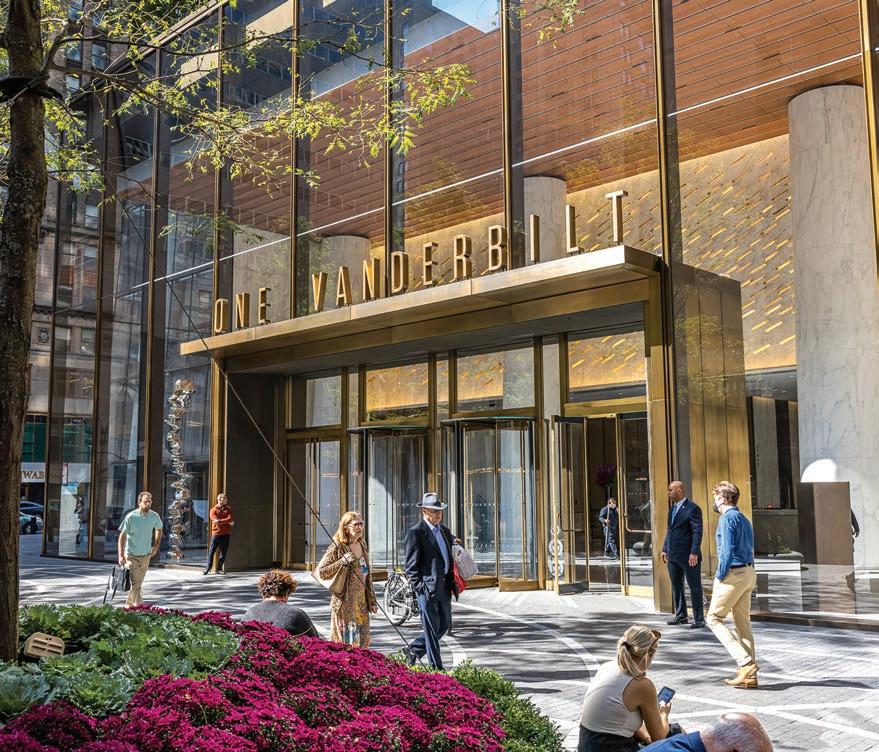
What do you see as SL Green’s responsibility to corporate citizenship and to being a force for good in society?
We are only as strong as the communities in which we operate and take immense pride in advancing our city. Our employees, assets, and business deliver the best results when they are integrated into the community and contribute positively to a greater societal purpose. We empower our employees to volunteer their time and to support philanthropic organizations. Last year, SL Green contributed over $6 million across 70 organizations to reach the most in need. Driven from the top, corporate responsibility is executed across all business lines internally and extends to our partners, tenants, and suppliers. What’s good for New York City is good for SL Green and vice versa. Furthermore, we have continued our campaign to address food insecurity in our local community by providing meals to New Yorkers in need and frontline workers through our Food 1st Foundation. Since the start of our program in April 2020, we have delivered over 750,000 meals and have helped to reopen dozens of restaurants throughout the city.
What has made sustainability such a focus for SL Green and will you highlight the company’s sustainability initiatives?
As a global leader in environmental, social, and governance initiatives (ESG), at SL Green we see sustainability as a social obligation, rather than a trend. The core principles of ESG have always been integral to SL Green’s business model. Our award-winning sustainability initiatives help minimize environmental impact, increase resiliency, provide opportunities to engage with the local community, and create longterm value across our industry-leading portfolio.
We’ve recently partnered with IBM, our new anchor tenant at One Madison, to leverage their innovative Envizi technology platform which will help us advance our environmental, social and governance (ESG) strategy, enhance our data collection to better identify efficiency opportunities, and further drive sustainability across our real estate operations.
Another priority for our ESG team is addressing carbon neutrality. After exceeding our existing portfolio-wide target of 30 percent emissions reduction by 2025, we are adopting more stringent voluntary targets. SL Green aligned with the Urban Land Institute (ULI) Net Zero by 2050 goal of carbon neutral building operations and has committed to setting a Science-Based Target for greenhouse gas emissions reduction. This
decarbonization commitment highlights our proactive approach to mitigating transition risks.
SL Green is headquartered in New York. What are the keys to New York’s recovery and rebuilding coming out of the pandemic?
New York City is and will always be a destination where people want to live, work and play, as demonstrated by the latest census results. The positive momentum we’ve been seeing throughout New York’s recovery has been supported and is driven by a new set of elected officials in the City and State. Throughout the pandemic, Governor Kathy Hochul and Mayor Eric Adams have been relentless advocates for New York, encouraging tourism, and working together to urge New Yorkers back to the office. We have also seen encouraging signs with commercial leasing velocity and property acquisitions in the city.
As always, we at SL Green are doing our part in supporting and accelerating New York’s comeback. We believe leading by example is key. Our team has been 100 percent in the office, Monday through Friday, since June 2020, which has been critical to our success and the milestones we have achieved. We strongly believe the key to New York’s recovery is its resilience. This year more than ever we’re ready to look forward, to move beyond the challenges of the pandemic and to embrace the exciting new expectations that tenants and their employees now have about the future of work.
What has made the industry so special and exciting for you?
I have worked in the industry for over 30 years, and no two days are ever the same. Better yet, I’ve worked in the city all my life, and the deep connection between real estate and our community is what energizes me. I also love that real estate is tangible and timeless. I am proud to be a part of groundbreaking projects like One Vanderbilt and One Madison, but beyond the big developments, I can point to 50+ different buildings across the city and share personal anecdotes. The industry plays such a vital role in the health of New York City, and as a company we take pride in helping to advance our city, redefine its skyline, ensure the safety of our tenants, and provide office space for millions of New Yorkers.
What advice do you offer young people interested in a career in real estate?
I encourage our new hires to be inquisitive, always take a lot of notes, and be a credit maker, not a credit taker. In my experience those that truly thrive are the ones who put their nose to the grindstone and never give up. In addition, I greatly enjoy mentoring our next generation. Mentorship is a cornerstone for professional development and connection. I advocate for individuals to surround themselves with caring and thoughtful mentors who understand the importance of teaching best practices and inspiring one to perform their best day in and day out.•
POSTED WITH PERMISSION. COPYRIGHT © 2022 LEADERS MAGAZINE, LLC LEADERS 168 VOLUME 45, NUMBER 4
One Vanderbilt lobby entrance and plaza
Realize Anything

What good is line of sight if you have no insight?
Insight incites change and change at the right time is foresight. We’re experts in that – experts in seeing what’s coming in commercial real estate and o ering data and insights for the path ahead. That’s why more New York occupiers, landlords and investors rely on CBRE for their real estate needs. Examine everything, so you can realize anything.
cbre.com
The Promise of Technology and Human Ingenuity
An Interview with Laura Peterson, Senior Managing Director and Office Managing Director - New York, Accenture

EDITORS’ NOTE Laura Peterson is a senior managing director at Accenture and the office managing director for New York Metro. In this role, she is responsible for Accenture’s 7,000+ people aligned to the region, clients and local business strategy, and community-related efforts. Furthermore, Peterson leads the Communications, Media and Technology (CMT) business in the Northeast market unit. She is accountable for Accenture’s strategy, talent development, growth, and delivery for the firm’s CMT clients in the region. She oversees a team of 3,000+ practitioners, including client account leaders and directors responsible for connecting Accenture’s solutions with clients’ business priorities. In addition, she helps C-suite executives solve for the challenges facing their companies through both operating model and digital transformation, shared services solutions and driving excellence in customer experience. Peterson earned a BS in business administration, economics and international business at the University of Colorado Boulder.
COMPANY BRIEF Accenture (accenture.com) is a global professional services company with leading capabilities in digital, cloud, and security. Combining unmatched experience and specialized skills across more than 40 industries, the company offers Strategy and Consulting, Technology, and Operations services and Accenture Song – all powered by the world’s largest network of Advanced Technology and Intelligent Operations centers. The company’s 710,000 people deliver on the promise of technology and human ingenuity every day, serving clients in more than 120 countries. Accenture embraces the power of change to create value and shared success for its clients, people, shareholders, partners, and communities.
Will you discuss your new role as New York office lead and how you will focus your efforts in the role?
As the office managing director, I have the privilege of leading our New York Metro-based Accenture people, clients, and communityrelated efforts. The New York Metro office is one of the biggest in North America – with more than 7,000 people – and I am responsible
for growing our footprint with a focus on innovation and driving impact for our clients. It’s such an honor to be a part of defining Accenture’s future in this incredible city and region we get to call home at a pivotal time when New York City is driving towards economic recovery.
Accenture’s new flagship North America innovation hub at One Manhattan West is another source of pride and a labor of love as I was fortunate enough to lead the design and buildout for the space. It’s so exciting as we work to establish the location as the destination where our people, clients, partners, and community come to grow, collaborate, celebrate, and innovate, and most importantly, belong.
Will you highlight Accenture’s long and deep commitment to New York?
Accenture has an established commitment to creating a workforce that represents the communities where we work and live, including New York, where some of the best and brightest
minds in the world reside. Like the rest of those who consider New York home, the Accenture team is very passionate about where we live. Our commitment to New York shows up in a number of ways. We collaborate closely with business, education, and community leaders through the New York Jobs CEO Council and OneTen to prepare New Yorkers in diverse, low-income communities for the future of work and to help meet employer needs. Through these initiatives, Accenture is a part of collective efforts to hire 100,000 New Yorkers over the next decade, with a focus on low-income people and those from Black, Latinx, and Asian communities.
We also are committed to New York through our Accenture Apprenticeship Program, which is a learn-and-earn model with benefits that provides a pathway to a full-time role with Accenture after a typically 12-month-long apprenticeship. We also support the EverUp Micro-Credential Program, which are free, 100-hour online intensive courses that certify City University of New York (CUNY) students in associate and bachelor’s degree programs in
NEW YORK NEW YORK
Laura Peterson
POSTED WITH PERMISSION. COPYRIGHT © 2022 LEADERS MAGAZINE, LLC LEADERS 170 VOLUME 45, NUMBER 4
“Accenture’s new flagship North America innovation hub at One Manhattan West is another source of pride and a labor of love as I was fortunate enough to lead the design and buildout for the space. It’s so exciting as we work to establish the location as the destination where our people, clients, partners, and community come to grow, collaborate, celebrate, and innovate, and most importantly, belong.”
skills and competencies. CUNY students who complete the micro-credential program are then eligible to apply for an eight-week paid internship through the EverUp Summer Internship Program. These are programs that we are both proud of and I believe can make a difference.
Finally, our people are incredibly active across the New York Metro community both through our formal corporate citizenship programs and organically with volunteering. I see this every day as I talk to our people who are passionate about so many topics that mirror Accenture’s priorities: sustainability and climate, driving equality, improving education, addressing homelessness and mental wellness, and generally improving the lives of New Yorkers, especially youth.
How do you describe Accenture’s culture and purpose?
At Accenture, we truly believe our people make this place what it is. Our purpose, our shared success, it’s all up to us. That’s why one of our core values, which is central to how we work every day, is respect for the individual – the core belief that each one of us has the power to make a positive impact in every single interaction. When we are compassionate, support each other and are committed to each other’s success, both professionally and personally, our actions create the ideal environment for us to carry out our purpose – to deliver on the promise of technology and human ingenuity.
What have been the keys to Accenture’s industry leadership and how do you define the Accenture advantage?
First, our people are our greatest asset – and pivotal to our advantage. We are always thinking about how our people can succeed personally and professionally. We support our people with care and provide opportunities to learn. We
invest nearly $1 billion each year to help our people develop skills that help them stay relevant and advance meaningful careers. Second, the relationships we have with our clients, longterm, grounded in trust and shared success, allow us to drive transformation together in meaningful and impactful ways. Third, the breadth of what we can offer in terms of capacity is key. When I work with a client, I’m able to work with them from strategy, through implementation and to run, addressing not just the operating model, process, core technology, and people, but the AI, data, insights, physical and digital devices, and experiences required to really change their business and drive the compressed transformation needed in today’s world.
How critical is it for Accenture to build a diverse and inclusive workforce to bring diverse perspectives and experiences to the table when addressing client needs?
Accenture puts inclusion and diversity at the heart of the way we work. Similar to New York, our people come from diverse cultures and backgrounds, and we embrace that at the core of who we are. Those perspectives and the richness of thought are key to driving the creativity and innovative thinking we need to drive outcomes for our clients part of that is driving inclusive growth in the workforce. We focus on creating opportunities for employment and advancement for our people from underrepresented communities through mentoring programs, leadership conferences, and development programs, as well as gender-based learning and development opportunities.
Do you feel that there are strong opportunities for women to grow and lead in the industry?
Absolutely – and at Accenture, we consider a culture of equality critical to success. A culture
of equality is not only the right thing to do, but a business imperative. If people feel a sense of belonging and are valued by their teams for their unique contributions, perspectives, and circumstances, they will feel empowered to innovate more, and everyone will rise.
Gender-balanced leadership teams are also a key part of driving culture. In fact, our own Accenture research, “The Hidden Value of Culture Makers,” shows that gender diversity is critical to building an inclusive culture where everyone thrives. It even shapes the way people view their organizations.
What do you see as the responsibility that leading companies have to be engaged in the communities they serve and to be a force for good in society?
Accenture’s position as a partner to many of the world’s leading businesses, organizations and governments affords us both an extraordinary opportunity and a tremendous responsibility to make a difference. Stewardship is an Accenture core value and something our people are passionate about. I, along with many of the local leaders I talk with daily, feel a personal responsibility to engage in this space and feel fortunate to be in the position to do so. We measure our impact in part by the benefit we bring our people, partners and communities, so we are always looking at how we can harness the power of Accenture to make positive change.
What do you feel are the keys to effective leadership and how do you describe your management style?
Accenture’s Truly Human approach –caring deeply for ourselves and each other and fostering an environment to help each other achieve our aspirations and become the best version of ourselves professionally and personally – serves as a north star when it comes to my management style. I firmly believe in leading with empathy and maintaining that sense of curiosity that comes with a continuous learning mindset.
In practice, this means ensuring our New York Metro people feel supported to do their best wherever they are – regardless of their location – and making sure that our flagship innovation hub at One Manhattan West offers a warm, supportive, people-centric user experience our people can count on to help them stay connected beyond “spaces and places.”
What advice do you offer young people beginning their careers during this unprecedented time?
I’d encourage everyone to build a support system – their tribe. The friends, mentors, and colleagues you build over time are key on so many levels and often become “family.” They can become your biggest cheerleaders and advocates – but also the ones who will mention your name in a room full of opportunities.
Don’t be afraid to fail. Take risks. Some of the best stories come from those risks and failures and what you learn from them. Believe and know that you’ll get back up.
Finally, it’s a marathon – pace yourself. Prioritize your family, friends, and your mental and physical wellness. Take your vacation.•
POSTED WITH PERMISSION. COPYRIGHT © 2022 LEADERS MAGAZINE, LLC LEADERS171 VOLUME 45, NUMBER 4
“Accenture’s position as a partner to many of the world’s leading businesses, organizations and governments affords us both an extraordinary opportunity and a tremendous responsibility to make a difference. Stewardship is an Accenture core value and something our people are passionate about.”
A Relationship Business
An Interview with
EDITORS’ NOTE After joining his father, Frank Crystal, at Crystal & Company in 1961, James Crystal was named President in 1963. Crystal serves as Vice Chairman and Member of the Board of Alliant Insurance Services. He is also Vice Chairman, Trustee, and Member of the Executive and Finance Committees and Co-Chairman of the Audit Committee of Mount Sinai Medical Center, along with serving on the board of Congregation Emanuel.
COMPANY BRIEF Alliant Insurance Services (alliant.com) is one of the nation’s leading distributors of diversified insurance products and services. Operating through a national network of offices, Alliant offers a comprehensive portfolio of services to clients.
How do you define the Alliant difference and what have been the keys to the strength and industry leadership of Alliant Insurance Services?
The difference and strength of Alliant is due to having groups of producers, as well as underwriting and servicing groups, paired in most cases by industry. This gives our clients a total package of sales underwriting service that understands their business and does not deal in generalities. This has been particularly true of the construction industry, for which we are a U.S. leader.
How do you focus your efforts as Vice Chairman of Alliant Insurance Services?

In addition to maintaining my own personal sales function in the company, my
Insurance Services
focus as Vice Chairman of Alliant is primarily within a Board member role, along with a sales function whereby I help other people who would like my assistance. I sincerely believe that without being involved in all these various processes, it would be impossible for me to give a full package of service to Alliant’s clients and my fellow employees and Board members. It is very important for me in my capacity as Vice Chairman to look at the entire picture and not just one function.
You have said that insurance is a relationship business. Do you worry that technology is going to take away from the personal side and human touch with clients?
I do not believe that technology is going to take away from the personal side and human touch of what I feel is a relationship between the client and Alliant. Headed by the client’s personal contact, we are able to maintain a close-fitting rapport, and while technology does provide Alliant with more facts and data, it also allows us to pursue the personal side of the relationship while obtaining the best service and premium results.
You have spent your career in the insurance industry. What has made the industry so special for you?
Over the years, the insurance industry has become special to me, not only due to my involvement acting as a client representative in various facets with numerous companies, but also due to serving on the Boards of several insurance companies, Alliant included.
In addition, learning about one’s clients and their differences that define them make for an interesting and challenging endeavor.
You commit your time and resources to philanthropic work. What has made philanthropy so important to you and how do you decide where to focus your efforts?
When you are as fortunate as I have been to have enjoyed a career, both intellectually and financially, that exceeded your expectations, it is critical that you give back to the community to help others achieve their best results. With the assistance of philanthropists, it is possible for others to accomplish much from both a business and education point of view, no matter what their station in life. This ultimately becomes critical as well for our country.
Do you feel that the insurance industry has been effective at telling its story about the type of careers it offers to the next generation?
I feel that the industry has become much more effective than it was when I first started disseminating information; such as what it achieves and what the future holds for careers. Today, with the aid and positive exposure of the Internet and other forms of advertising, along with experiencing the personal involvement of various individuals who are considering a career in the industry, I feel there is now a better awareness which is why many are choosing this path. When I started in this business it was always looked upon as a “secondclass citizen” with many other professions that were preferred. Today I think we are equal to any other profession and ahead of many.•
NEW YORK NEW YORK
James W. Crystal
James W. Crystal, Vice Chairman, Alliant
POSTED WITH PERMISSION. COPYRIGHT © 2022 LEADERS MAGAZINE, LLC LEADERS 172 VOLUME 45, NUMBER 4
“Headed by the client’s personal contact, we are able to maintain a close-fitting rapport, and while technology does provide Alliant with more facts and data, it also allows us to pursue the personal side of the relationship while obtaining the best service and premium results.”
A Proud New Yorker






Paul, Weiss has been a law firm leader in New York City since its inception nearly 150 years ago. Today, we honor that legacy by helping the city’s iconic companies and financial institutions navigate their most significant legal and business challenges, supporting the city’s civic and cultural life, and providing pro bono legal services to New Yorkers in need.
 Paul, Weiss, Ri�ind, Wharton & Garrison LLP paulweiss.com
Paul, Weiss, Ri�ind, Wharton & Garrison LLP paulweiss.com

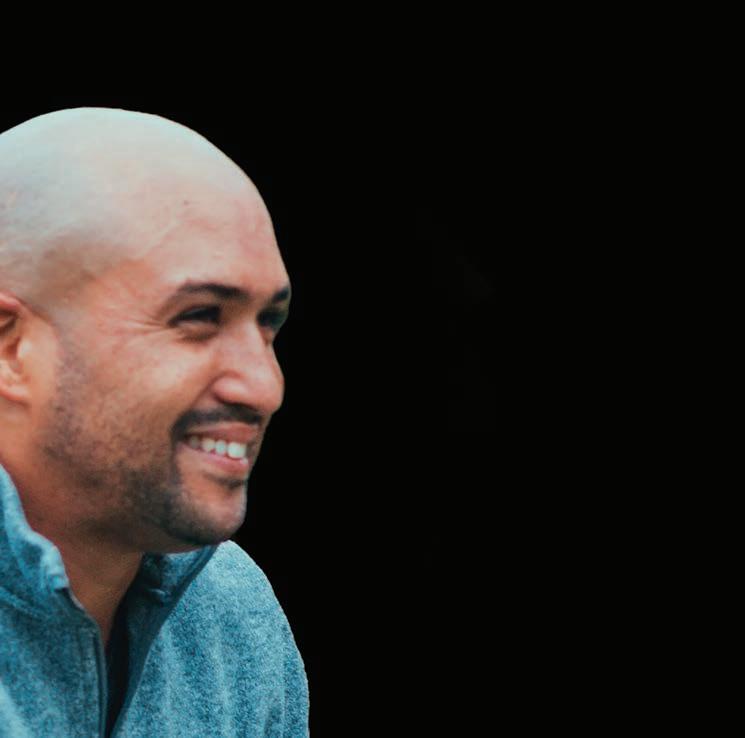




A new heart was Joseph’s winning save.

Thanks to Monte ore Einstein, he’s victorious. Joseph didn’t just need a new heart right away, he needed a hospital that could perform a bloodless transplant. He was referred to Monte ore Einstein, the only hospital within 800 miles that could save his life.
See Joseph’s story at: montefiore.org/joseph
The Local Expert
EDITORS’ NOTE Frank Pusinelli serves as Chief Operating Officer for the Operating Assets business segment at RXR where he oversees marketing, leasing, and property management. He joined RXR in 1999 and during his tenure at RXR, he has partic ipated in the acquisition of tens of millions of square feet and overseen the execution of well over $2 billion in construction projects, ranging from ground-up development and value creation to customized tenant interiors.” Previously, he worked as a project manager and estimator in the construction sector as well as in the architectural and engineering field specializing in municipal architecture and environmental engineering. Pusinelli holds a BS degree in architectural technology from the New York Institute of Technology and an MBA in finance from Fordham University. He is a licensed architect in the State of New York and a member of the American Institute of Architects.

COMPANY BRIEF RXR (rxr.com) is an innovative investor, developer and place-maker committed to applying a customer and community-centered approach to building properties, services, and products that create enduring value for all stakeholders. Headquartered in New York with a national platform strategy, RXR is a 500+ person, vertically integrated operating and development company with expertise in a wide array of value creation activities, including ground up real estate, infrastructure and industrial development, uncovering value in underperforming properties, repurposing well-located iconic properties, incorporating cutting-edge technologies, and valueadded lending. The RXR platform manages 88 commercial real estate properties and investments with an aggregate gross asset value of approximately $22.6 billion, comprising approximately 30.4 million square feet of commercial properties, a multi-family residential portfolio of approximately 7,600 units under operation or development, and control of development rights for an additional approximately 3,800 multi-family and for sale units as of March 2022.
RXR has a clearly defined set of values. Will you highlight these values and how engrained they are in RXR’s culture?
For many years, RXR has been guided by the five E’s: Entrepreneurial, Edge, Execution,
Energy, and Ethics. Our values have since coalesced around six key concepts:
• Doing the right thing, which means we are value driven and seek to do the right thing every day.
• Leading with bold ideas, which manifests itself by being innovative.
• Striving for excellence, which means we go above and beyond whenever we do anything.
• Staying humble and staying hungry, which means that we are ambitious, but not arrogant.
• Cultivating relationships, which yields enduring partnerships.
• Acting like an owner, which means we are entrepreneurial and we are all accountable.
These values permeate the company, and our people live them every day.
What have been the keys to RXR’s industry leadership and how do you define the RXR difference?
RXR is an investor, an owner, an operator –we do it all. We have a full-service team that does leasing, asset management, construction, architectural design, and development. The fact that we do all this in-house makes RXR the local expert – RXR is a proven operator with a strong reputation who can do it all. We are entirely focused on making sure that we are elevating the experience for all stakeholders in every market

NEW YORK NEW YORK
Frank Pusinelli
An Interview with Frank Pusinelli, Senior Executive Vice President and Chief Operating Officer – Operating Assets, RXR
POSTED WITH PERMISSION. COPYRIGHT © 2022 LEADERS MAGAZINE, LLC LEADERS 176 VOLUME 45, NUMBER 4
The Starrett-Lehigh Building located at 601 West 26th Street in Manhattan
we are in. We earn our credibility by our actions, and it is critical for any business to build credibility with its investors, partners, and lenders, especially for a privately-owned firm like RXR.
The fact that we are vertically integrated is a major factor in our success. As we expand nationally and work with joint venture partners who have a presence in new markets, the fact that RXR has the capabilities to do it all, and that we are doing
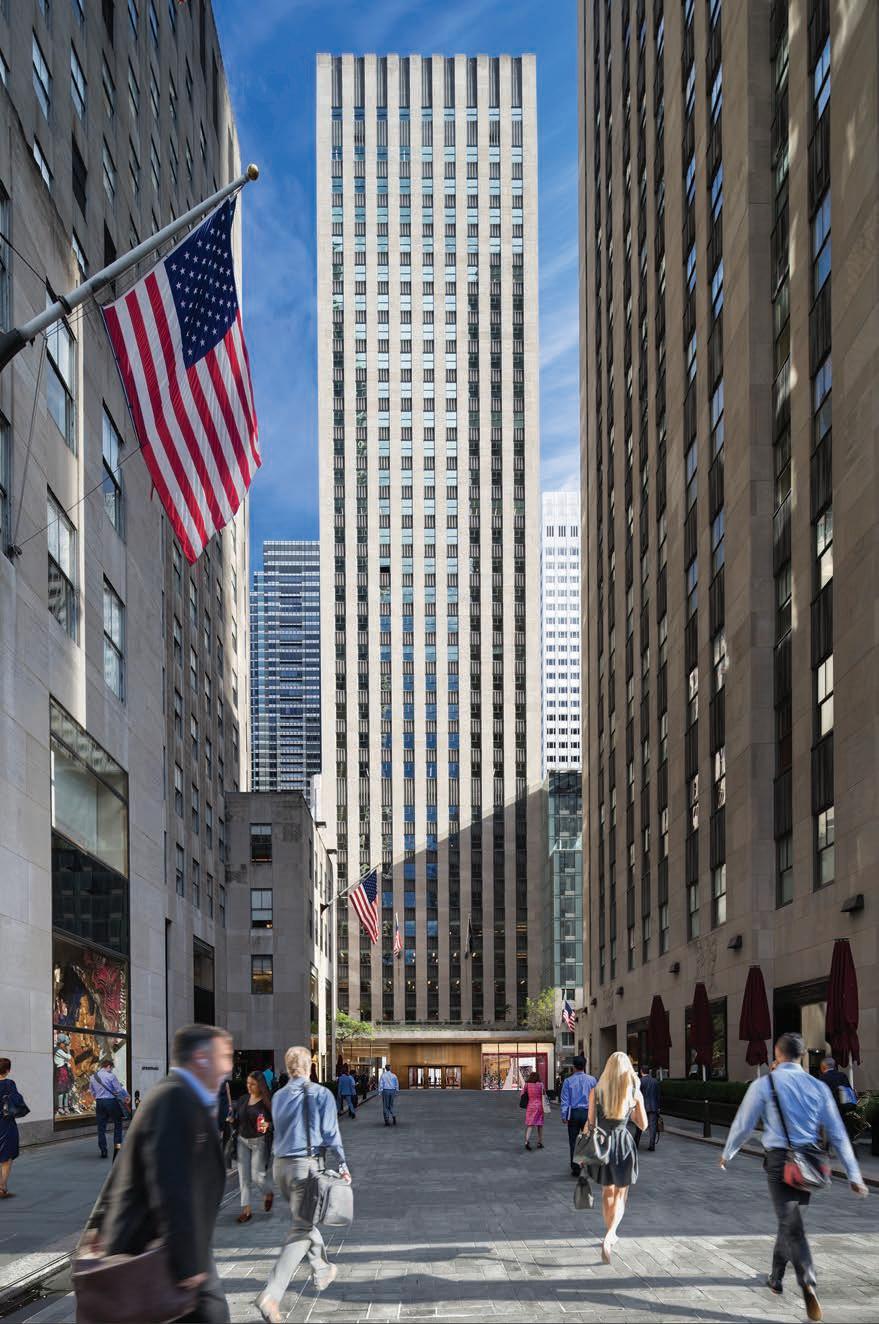
it in New York which is one of the most complex markets to operate, translates well. I often tell our team that what we do here in our own backyard of New York is critical to our expansion because not only can we identify like-minded partners to work with, but we also make more informed decisions about where to invest and how we underwrite those investments because of the depth and breadth of our experience.
Will you provide an overview of your role and areas of focus?
As the chief operating officer of Operating Assets, whether it is commercial, residential, retail, storage, etc., if there is an occupant or a tenant, it is my focus. I spend a portion of my time on measuring results and deciding if and how to pivot, a portion of my time on major projects and initiatives to make sure we stay on track, and a portion of my time on people and process. My focus on people and process is very important since as my sphere of responsibility grows, it allows me to mentor and guide, consistent with our goals and values.
The more my responsibilities have increased, whether by expanding into different asset classes or just by how we scale, the more I recognize that I can’t be everywhere and touch everything. I do not believe in being a micromanager. I believe in hiring bright and energetic people and then getting out of their way. I am here to help remove obstacles and to lend advice based on my prior experience, but my focus is to allow our people to execute.
When it comes to performance, the real estate business affords clarity because every asset undergoes a robust annual business plan process where we identify the key performance indicators that will define success for the coming year. We ask questions such as how much space will we lease, what will our occupancy be, and where do we see expenses?
As the year progresses, we measure how we are doing against the plan and evaluate what is happening in the market. This helps us know if we need to adjust the plan. RXR has an entrepreneurial spirit and is nimble which allows us to pivot quickly when necessary.
How critical is it for RXR to build a diverse and inclusive workforce to mirror the diversity of its tenants and the communities it serves?
This is a critical component of our mission. We have a DEI committee with representation from across the company which meets regularly to discuss and advance initiatives that will result in greater opportunity and diversity across the organization. It is important to track statistics and measure results to know where you started and to get a sense of how quickly you are moving in the direction you want to go.
Whitney Arcaro, our EVP of Marketing and Retail Leasing, is leading a Women’s Initiative at RXR which will include men from the company. I am so excited to be a part of the work of this group since the only way to understand and appreciate how we are doing in this area as a company is to listen and learn through the lens of groups that have historically been marginalized in business and society.
To effectively embrace DEI, it is necessary to immerse it in every aspect of what you are doing. It starts with the hiring process, continues through onboarding, and persists in day-to-day management of the organization. RXR is committed to removing bias in the hiring process. We recently held a one-hour awareness session in support of National Disability Awareness Day. The Americans
POSTED WITH PERMISSION. COPYRIGHT © 2022 LEADERS MAGAZINE, LLC LEADERS177 VOLUME 45, NUMBER 4
75 Rockefeller Plaza situated in the heart of Rockefeller Center
with Disabilities Act (ADA) was signed into law on July 26, 1990, and we did a webinar around the 32nd anniversary of the ADA to bring attention to what the ADA is and why it is so important given that one in four Americans live with a disability.
RXR has a new Chief People Officer, Charlie Harary, who is a long-time RXR colleague. In conjunction with our senior leaders and the entire human resources team, Charlie is setting up a robust program around DEI which has the unwavering support of our partners.
What has made sustainability such a focus for RXR and will you highlight the company’s sustainability initiatives?

We want to be carbon neutral by 2035 and net zero by 2050. We are pursuing full electrification at our assets to help us reach this goal. We are investigating cooling optimization, thermal recapturing techniques, and using data to find other areas of improvement. We continue to increase our Energy Star scores throughout our portfolio, and we are undertaking an initiative to achieve LEED and WELL certifications at all our assets. Measurement is key and we are using digital tools, like the WorxWell product we developed, to aggregate energy data, and our annual ESG reporting is robust. We report into GRESB which is a great way to measure our results against our peers and also to highlight where we can continue to improve year over year across all ESG metrics.
We believe sustainable investment is the future. Whether it is investors, partners, or lenders, a company’s ability to draw talent and establish partnerships will be tied to its ESG performance. At RXR, we believe that a company’s willingness to tie its ESG performance to its cost of capital will be a big factor in identifying winners versus losers in the future.
What are your views on the return of tenants to the office and the future of work?
New York is the greatest city in the world, and it is a place where people want to live. When you look at the record rent growth in the residential market, particularly in Manhattan, talent is still here and is continuing to come here. Proactive landlords are building new product and renovating existing stock to make sure that employers can provide their teams with access to amenities, clean air, natural light, great food offerings, etc., so as they make their return to office plans a reality, they can partner with their landlords to make that experience first class.

I do not think there should be a debate about the viability of the office. It is highly
relevant to building and sustaining the culture of a business. The office environment is critical to mentoring and to providing access to advancement for people just getting started in their professional careers. While there will be some industries that are able to make hybrid models work, this is a limited universe and I believe that over time they will find that it erodes both value and culture.
You joined RXR in 1999. What has made the experience so special for you?
When I mentioned earlier that we “Act Like an Owner,” I meant it, and I mean it directly for me. Over the past 23 years, I have succeeded at RXR by saying at every opportunity, “I will do that” or “I can take that on.” The partners have had the confidence to provide those opportunities to me and to let me execute, even if at times it meant failing. If you never fail, you are not doing anything. Thankfully, our wins have been numerous, but when we fail, we learn from the experience.
There have been markers over my 23 years with RXR where one pauses and asks if they should go out on their own or try something new, but each of those moments has led me to the truth that I am able to do exactly that right here since RXR allows me to feel like this is my own.
RXR is a family. This was a family organization when it started, and we have never lost that family feel which starts at the top with Scott (Rechler, RXR Chairman and CEO). I have seen how we support each other when someone is down. I have seen how we elevate someone when they strive for excellence. There are many companies that say that they are a family, but will the CEO of the company give you a quick hug in the hallway if you are having a tough day? Will your colleagues really feel like your second family? If you have that, hold on to it. If you are in management, cultivate it. This is what makes a company special.•
View from the rooftop pool of the Magnolia Club at the Magnolia DUMBO
POSTED WITH PERMISSION. COPYRIGHT © 2022 LEADERS MAGAZINE, LLC LEADERS 178 VOLUME 45, NUMBER 4
RXR is undertaking the redevelopment of the historic Pier 57 in Hudson River Park on the West Side of Manhattan
We’re shaping the future of real estate for a better world.

As a business, we strive to help our clients achieve their hearts desires in real estate.
As a culture, we are committed to making a difference for our communities—every day.
jll.com/newyork
Building a More Inclusive Economy
An Interview with Yael Taqqu, Senior Partner and New York Office Managing Partner, McKinsey & Company
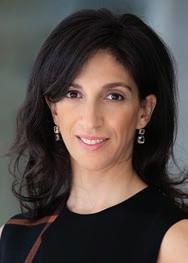
EDITORS’ NOTE As Managing Partner of the New York office, Yael Taqqu unites practices, functions, and pathways in the firm’s largest and most diverse location. Taqqu is a senior partner in McKinsey’s Technology, Media & Telecommunications (TMT) Practice, where she advises leadership on commercial growth through sales and marketing, digital transformation and strategy. She also spearheads McKinsey’s global network of Experience Studios, a series of innovation spaces for clients to participate in experiential workshops, capability-building programs, and interact with the local tech and start-up communities. In addition to her work with McKinsey, Taqqu serves on the board of the Juilliard School and formerly on the Film at Lincoln Center board. She received a BA from Yale University and an MBA from Harvard Business School.
Yael Taqqu
However, New Yorkers are well known for their resilience and ability to thrive in challenging circumstances. Despite the pandemic, the city appears to be bouncing back, compared to some other U.S. cities. According to McKinsey’s American Opportunity Survey, New Yorkers continue to be optimistic about the economy, ranking the third-most optimistic about economic opportunity after Washington, DC and Atlanta, compared to fifth in 2021, and eight points higher than the national average. I believe that this confidence is warranted. Unemployment has fallen nearly every month across the state with significant gains in the city. Economic activity is picking up: tax receipts in April were $17.8 billion, double that of the same time last year.
How is McKinsey supporting the development of a more inclusive economy in New York?
As New York continues to recover, we set out to understand which barriers to economic inclusion have been created or exacerbated by the pandemic. McKinsey recently published the report, “Twelve insights for an inclusive economic recovery in New York City,” sharing insights directly from New Yorkers about their economic standing, and how the pandemic has affected their financial and material well-being.
FIRM BRIEF McKinsey (mckinsey.com) is a global management consulting firm committed to helping organizations accelerate sustainable and inclusive growth. It works with clients across the private, public, and social sectors to solve complex problems and create positive change for all its stakeholders. The firm combines bold strategies and transformative technologies to help organizations innovate more sustain ably, achieve lasting gains in performance, and build workforces that will thrive for this generation and the next.
New York’s economy has experienced a hard road to recovery following the pandemic. How optimistic are you about the resilience of the U.S.’ largest city?
New York was the epicenter of the U.S. COVID-19 pandemic – the city experienced more than 2.7 million confirmed infections and over 41,000 deaths to date. The economic impact was also unprecedented, and disproportionately affected vulnerable minority and immigrant populations. Two years later, these still remain challenging times – there are concerns over public safety and unemployment is 6.2 percent. Furthermore, access to healthcare is another barrier of opportunity.
Being flexible, ambitious, and adaptable are not foreign concepts to New Yorkers – 52 percent of residents across all racial, income, and educational groups say they are actively pursuing further education or training, 11 points more than the national average. More than half are willing to switch industries or occupations, and 55 percent said they are looking for a new job.
Over the past four centuries, the city has had dozens of ups and downs, and has always come back stronger. By helping to narrow today’s opportunity gaps, business can help to ensure it does so again.
Our report found that fault lines exist within the city’s recovery which exacerbate inequities and barriers to economic inclusion. More people are struggling to get food, healthcare, transportation, internet access, and jobs in the nation’s biggest metropolis. Racial and ethnic minorities, immigrants, low-income residents, women with childcare responsibilities, and young people are especially vulnerable. Within these groups, lowincome immigrants and Black and Hispanic/ Latino caregivers are at higher risk. They also represent a substantive part of New York City’s population, accounting for more than 2.4 million. And more than a million New Yorkers who live below the poverty line are part of racial or ethnic minority populations. These residents, and the neighborhoods where they live, are most at risk of being left behind in the recovery.
NEW YORK NEW YORK
POSTED WITH PERMISSION. COPYRIGHT © 2022 LEADERS MAGAZINE, LLC LEADERS 180 VOLUME 45, NUMBER 4
“At McKinsey, we recognize that an inclusive recovery means expanding the workforce and helping immigrants, women, communities of color, and those with a disability access a growing economy.”
At McKinsey, we recognize that an inclusive recovery means expanding the workforce and helping immigrants, women, communities of color, and those with a disability access a growing economy. Failing to include all communities in the recovery will hamper growth across every sector of the economy, from tech and healthcare to professional services. This is one of the areas we are supporting in New York, especially the blue-ribbon panel appointed by the Governor and Mayor to develop strategies to build New York’s inclusive economic recovery for its central business districts.
Our New York colleagues are also pioneering a new accelerator program, InNYC, to support underrepresented local founders and leaders of incredible startups by providing dedicated firm resources to help them unlock sustainable and inclusive growth. This is an important time in our city when leaning forward and making a difference will matter.
Given the current trend to change jobs in the current economy, how is McKinsey counseling your clients to tackle the attrition?
We believe the Great Attrition may have evolved into the Great Renegotiation with workers switching jobs and industries, moving from traditional to nontraditional roles, retiring early, or starting their own businesses. As competition for talent remains fierce, we are seeing companies finding it harder to attract and retain talent.
For many workers, the barriers to switching employers have dropped dramatically. In the United States alone, there were 11.3 million open jobs at the end of May 2022 – up from 9.3 million in April 2021. Even as employers scramble to fill these positions, the voluntary quit rate is 25 percent higher than pre-pandemic levels. At the current and projected pace of hiring, quitting, and job creation, openings likely won’t return to normal levels for some time.
This is a fundamental mismatch between companies’ demand for talent and the number
of workers willing to supply it. Employers continue to rely on traditional levers to attract and retain people, including compensation, titles, and advancement opportunities. Those factors are important; however, the pandemic has led more people to re-evaluate what they want from a job – and from their life – which is creating a large pool of active and potential workers who are shunning a traditional path.
To address this attrition, companies can take four actions. First, they can sharpen their traditional employee value proposition, which can involve focusing on title, career paths, compensation, benefits, having a good boss, and the overall prestige of the company. Second, they can build their nontraditional value proposition, which revolves around flexibility, mental- and behavioral-health benefits, a strong company culture, and different forms of career progression. Third, companies can broaden their talent-sourcing approach, especially since the non-traditionalists are not actively looking but would come back for the right offer. Finally, organizations can make jobs “sticky” by investing in more meaning, more belonging, and stronger team and other relational ties.
What advice are you offering clients and industry leaders as we look at a likely economic downturn?
It is worth pointing out that while there is some economic uncertainty right now, it is unclear what the future holds. Is this the end of a boom, the beginning of a bust, or something different? In our latest survey of business executives, more than half believed a recession is coming soon, but nearly half of them thought it could be avoided.
Where they can all agree is that something is coming – we just don’t know what it is. Whether this moment leads to a turnaround or to a continuation of recent inflationary trends, it is a time when companies can make the kind of pivot that strengthens their growth trajectory for the next several years.
McKinsey’s research also shows that the best CEOs do things differently. One essential distinction: they focus on beating the odds by making bold moves early, not waiting for trouble to arrive. We are seeing leading companies building resilience now, with intense financial planning followed by decisive plans of action. They are on track to weather the storm and to deliver sustainable, inclusive growth in the years to come.
How do you define the McKinsey difference and what sets the firm apart in the industry?
Our people and our culture differentiate us. McKinsey is motived by our purpose to create positive, enduring change in the world. We are guided by a strong set of values including a deep commitment to diversity, and to making positive social impact through our work.
What I appreciate the most about our culture is that everyone at the firm can be entrepreneurial. We ask all our colleagues to think of new ways to solve business problems for our projects, teams, and clients. And the best part is that you get to work on whatever practice or function it is you want to pursue. Another aspect that sets us apart is that we believe that all colleagues have an obligation to dissent. No matter your tenure, we believe that input and perspective from the entire team is valued. This team perspective leads to collaboration and our ability to not maintain a status quo.
Personally, I have a creative background and I wasn’t sure that I would fit in when I started, but I quickly discovered that McKinsey is made up of a diverse range of colleagues from all walks of life, skill sets, and backgrounds. My colleagues include medical doctors, designers, engineers, coders, data scientists, business managers, former public servants, entrepreneurs, and researchers. Collectively we tackle all kinds of challenges for our clients, and we’re doing it with teams of amazing people all over the world.
What do you see as the key characteristics that make for a successful management consultant at McKinsey?
We recruit for potential, not pedigree. We are looking for distinctive talent everywhere. We prioritize who these candidates are and not where they are coming from. Whether they’re an experienced professional, a recent graduate, or both, working at McKinsey could be a challenging and rewarding next step in their career.
We have always been known for hiring exceptional problem-solvers. We do this in service of driving change for our clients, but we also look for humble leaders, curious intellects, self-aware and thoughtful people, who are resilient and share our values. We are charged with helping make institutions stronger, more resilient, and ensuring they can make more of a meaningful impact.
But above all, we look for people who bring their whole selves to work and who thrive on energy from their colleagues and clients doing the same. It’s a hugely exciting time to join our industry and I believe it’s one of the very best professional development environments you’ll find, no matter what your career ambitions.•
POSTED WITH PERMISSION. COPYRIGHT © 2022 LEADERS MAGAZINE, LLC LEADERS181 VOLUME 45, NUMBER 4
“Our people and our culture differentiate us. McKinsey is motived by our purpose to create positive, enduring change in the world. We are guided by a strong set of values including a deep commitment to diversity, and to making positive social impact through our work.”
Leadership by All
An Interview with Louis A. Shapiro, President and Chief Executive Officer, HSS
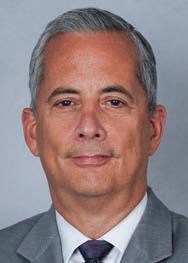
EDITORS’ NOTE Lou Shapiro assumed his current position in October 2006. Previously, he served as Executive Vice President and Chief Operating Officer of Geisinger Health System’s Clinical Enterprise. He began his career at Allegheny General Hospital in Pittsburgh and then joined McKinsey & Company as a leader within their healthcare practice. Shapiro is a fellow of the American College of Healthcare Executives, former Chair of the Greater New York Hospital Association Board of Governors (2014-2015), and serves on multiple nonprofit boards.
INSTITUTION BRIEF HSS (hss.edu) is the world’s leading academic medical center focused on musculoskeletal health. At its core is Hospital for Special Surgery, nationally ranked number one in orthopedics (for the 13th consecutive year) and number three in rheumatology by U.S. News & World Report (2022-2023), and named a leader in pediatric orthopedics by U.S. News & World Report “Best Children’s Hospitals” (2022-2023). HSS has a main campus in New York City and a growing network of related facilities. In addition to patient care, HSS leads the field in research, innovation, and education. Through HSS Global Ventures and the HSS Education Institute, the institution is collaborating with medical centers and other organizations to advance the quality and value of musculoskeletal care and to make world-class HSS care more widely accessible nationally and internationally. HSS is the official hospital for a number of professional sports organizations and teams including the New York Giants, New York Mets, New York Knicks, Brooklyn Nets, UFC, US Rowing, US Biathlon, US Lacrosse, and USA Basketball. HSS is one of only three hospitals in the United States designated as a Medical Center of Excellence by FIFA.
How do you define HSS’ purpose and mission?
Our purpose is the cornerstone of HSS and the reason why we exist – to help people get back to what they need and love to do better than any other place in the world.
With respect to patient care, our mission is singularly focused on delivering the highest quality
care, improving mobility, and enhancing quality of life for all. To do this, we must also be at the forefront of research, innovation, and education – enabling the most talented people to achieve an outsized collective impact on individuals, communities, businesses, and societies. After nearly 160 years, HSS has become the world’s largest academic medical center specializing in musculoskeletal health, but we are only beginning to fulfill our purpose. The need and opportunity for impact has never been greater.
What have been the keys to the strength and leadership of HSS in the industry?
As an organization, we at HSS operate under the philosophy of “Leadership By All,” where everyone is a leader regardless of their individual role. This philosophy is what allows us to provide the very best care to patients every single day. It’s one of the reasons we as an organization have been ranked the top hospital in the nation for orthopedics for 13 consecutive years by U.S. News and World Report and the world #1 according to Newsweek

What will be the impact of the expansion of the HSS campus with its new 12-story tower and what can HSS patients expect from this new tower?
To continue to meet the growing demand for our unmatched care, HSS is investing in new facilities and enhancement to our Upper East Side campus, as well as in beautifying the neighborhood. At the heart of this plan is the construction of the Anna-Maria and Stephen Kellen Tower. Rising 12 stories over the FDR Drive, this new 94,000-square-foot clinical building will adjoin our current main hospital facility. The tower is made possible due to the generous support of our Board and donor community, including our lead donor, the Anna-Maria and Stephen Kellen Foundation.
The HSS Kellen Tower will expand care for joint replacement and spine conditions with three private inpatient floors, physician offices and exam rooms, and on-site imaging to support our high-quality musculoskeletal care. The added capacity created by these new inpatient units and renovation of recovery floors in the main hospital will allow HSS to
NEW YORK NEW YORK
Louis A. Shapiro
main
Side POSTED WITH PERMISSION. COPYRIGHT © 2022 LEADERS MAGAZINE, LLC LEADERS 182 VOLUME 45, NUMBER 4
HSS
campus on Manhattan’s East
convert from 30 to 70 percent private patient rooms across the main campus, an institutional priority underscored by the pandemic and necessary to optimize the healing environment for our patients.
Will you highlight HSS’ investment and commitment to research and the work of the HSS Research Institute?
Since its founding more than 150 years ago, HSS has been a leader in research aimed at improving the lives of patients suffering from debilitating orthopedic and rheumatic conditions such as arthritis, bone and soft tissue injuries, autoimmune diseases, and musculoskeletal pain and deformities. Today, the HSS
Research Institute has garnered more than $60 million in our federal grant portfolio, $35 million in industry funding, and has published more than 1,300 articles in 2021 alone, with over 300 dedicated personnel identifying mechanisms underlying these conditions, and developing effective approaches for prevention, diagnosis, and treatment. With a focus on tissue repair, improving surgical outcomes, autoimmunity and inflammation, genomics, new treatments, and precision medicine, the impact of our discoveries – many of which are only happening at HSS – determine future directions of musculoskeletal research to best improve clinical outcomes.
How critical is it for HSS to build a diverse and inclusive workforce to mirror the diversity of the patients and communities it serves?
Inclusive diversity is a key success factor in almost any organization, and it requires deliberate commitment and action. The benefits go well beyond mirroring the patients and communities we serve; diverse experiences and perspectives unlock new ideas and enlighten conventional thinking. We are making progress, but still have much to do. Diversity has been enshrined as a core value of HSS, and we have evolved our structure and added expertise to support this. We don’t see it as a separate priority, but rather as central to fulfilling our purpose.
Will you discuss HSS’ commitment to advancing global health and the delivery of humanitarian services?
HSS is dedicated to helping those around us, both in our own community and across the world. We do this through our patient care, education, innovation, as well as humanitarian work. One example is the HSS Global Health initiative, which supports the delivery of care for vulnerable populations through volunteer work. Over the years, our reach has included providing orthopedic care in West Africa, training anesthesia providers in India, and bringing medical care to Haiti. In the United States, we provide care and support in many ways beyond our focus on musculoskeletal health. Most recently, we looked disaster in the face with the arrival of the COVID-19 pandemic which caused us to change in previously unimaginable ways and become a strategic part of New York City’s community response.
HSS is headquartered in New York City. What do you see as the advantages that New York provides from a talent and recruitment standpoint?

At HSS, we are constantly adapting to a changing landscape as needs and priorities shift. If you do everything exactly how you were doing it in years past, you will not succeed. New York has a tremendous opportunity to continue to grow and evolve as a city. Cultivating a diverse community at HSS is, and always has been, a critical ingredient in our culture and New York City provides an extraordinarily diverse population of talent.
As we all know, building a diverse and inclusive workforce requires an ongoing commitment. While HSS continues to progress in recruiting diverse talent throughout our organization, there is still a lot of work to be done. The challenges we face are not unique to our industry, but we are committed to continuing to meet our goals.
What advice do you offer young people interested in building a career in medicine?
Stay true to your values and principles, especially during difficult times, and never settle for the status quo. There’s always room for improvement. A commitment to continuous improvement on the part of everyone at HSS is what has made us the world-class organization we are today.•
POSTED WITH PERMISSION. COPYRIGHT © 2022 LEADERS MAGAZINE, LLC LEADERS183 VOLUME 45, NUMBER 4
Rendering of the new Anna-Maria and Stephen Kellen Tower
One Team
EDITORS’ NOTE With 30 years of real estate experience, James Linsley also serves on the Executive Committee and the Investment Committee of GID. Prior to GID, he worked with several of the nation’s most high-profile real estate organizations. He was previously a Senior Vice President with Related for 10 years. Earlier, he worked for Trump/New World Project Management (The Trump Organization and New World Development). He has been a member of the International Council of Shopping Centers, the Urban Land Institute, the Urban Development Mixed-Use Council of the Urban Land Institute, and the Congress for New Urbanism. Linsley holds a BA in architecture and a BS in civil engineering from Lehigh University as well as an MS in Real Estate Development and an MS in Urban Planning from Columbia University.
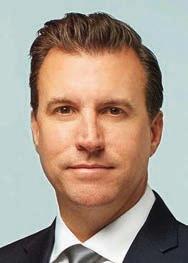
COMPANY BRIEF GID Development Group (gid.com) creates luxury residential developments and iconic mixed-use projects throughout the United States. It is involved in the development of approximately $7 billion of projects in various stages of planning, design, construction, completion, and lease-up. GID is a privately held and fully integrated real estate company that develops, owns, and operates a premier portfolio of properties. During its 60-year history, GID has acquired or developed over 86,000 residential units and 32 million square feet of commercial space in 24 states. The firm has multiple areas of in-house expertise including development, acquisitions, property management, portfolio management, asset management, research and strategy, finance and treasury. GID has offices in New York, Boston, Atlanta, Dallas, and San Francisco, employs over 1,000 real estate professionals, and currently controls a $28-billion portfolio consisting of over 48,000 multifamily units and 23 million square feet of commercial space.
Will you provide an overview of GID Development’s values and culture?
We have a concept at GID we call One Team that signifies our commitment to work together in a culture of accountability, inclusivity, energy, and courage. Our GID teammates share a commitment to the company and each other characterized by hard work, respect, and a passion for what we do. We have a relentless focus where no detail is too small and “good enough” is never good enough. These values have specific meanings for us and have enabled us to achieve some extraordinary things and create visionary, best-in-class developments for our residents and investment partners.
What have been the keys to GID Development’s strength and leadership in the industry?
GID’s commitment to the multifamily sector spans six decades and the company has the resources to sustain strong, stable growth for decades more. Since our formation in 1960, our various businesses have stood on the same, simple principles of quality, service, and integrity. I think we’re recognized as industry leaders due to the success of our track record and ability to develop some of the best multifamily and mixed-use assets in the country. Ultimately, people are the root of GID’s success, enabling the firm to deliver quality results to our investment partners.
Will you highlight GID Development’s portfolio and current development projects?

GID Development Group is engaged in approximately $7 billion of projects in various stages of the development process, comprised of more than 8,000 multifamily units and two million square feet of commercial space. Projects are located throughout the United States and range from luxury high-rise multifamily towers to largescale, multi-phase, master planned mixed-use projects consisting of residential, retail, restaurant, entertainment, office, hotel, cultural, and public realm uses. We have numerous projects in various stages of the development process throughout the country, including major multifamily and

NEW YORK NEW YORK
James E. Linsley
An Interview with James E. Linsley, President, GID Development Group
2.6 acre park at
POSTED WITH PERMISSION. COPYRIGHT © 2022 LEADERS MAGAZINE, LLC LEADERS 184 VOLUME 45, NUMBER 4
Waterline Square
The
Waterline Square
mixed-use projects in New York, Atlanta, Austin, Denver, and Houston.
Will you discuss GID Development’s presence and investment in the New York market?
We have a significant presence in New York City and GID has a regional office in Manhattan. Our portfolio includes a number of assets in New York, including one of the highest profile multifamily and mixed-use properties in Manhattan, our $2.5billion Waterline Square development. The 1,132unit development has been incredibly successful and well-received in the real estate market, setting record condominium prices in the neighborhood, and achieving some of the highest multifamily rents in New York. Waterline Square’s 2.6-acre park, which features fountains, gardens, restaurants, and numerous performances and events, has become the centerpiece for this Upper West Side community. Our restaurants have become destinations, including Empellon, and Cipriani’s first combined
food hall, market, restaurant and bar with Harry’s Table and Bellini, which just opened this summer. Lastly, our 100,000-square-foot one-of-a-kind amenity facility, the Waterline Club, is widely regarded as New York’s top amenity offering.

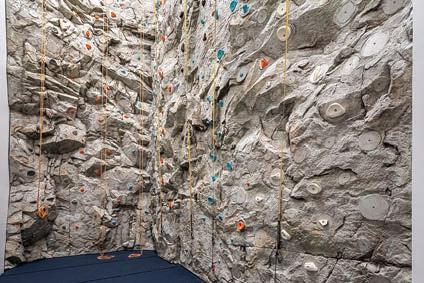



Where do you see the greatest opportunities for growth for GID Development?
Our developments continue to reinforce our belief that pushing the boundaries of what can be expected in an urban living experience can create one-of-a-kind projects that stand out in the market and create outsized long-term value. As a best-in-breed developer, operator, and owner
with a long-term view, GID can control that experience across the entire development spectrum – from developing market leading apartments and amenities to delivering our award-winning services. Because we can deliver this same power across all the market types we build – from luxury high-rises in gateway cities to the town center style developments we build in growing markets –this power produces incredible growth opportunities for GID Development and our investment partners.

How is GID Development integrating Environmental, Social and Governance (ESG) principles into its business?
We have a vision for superior real estate that creates economic value and advances sustainable communities, and our mission is to leverage our investment, development, and management experience to enhance the communities we create and operate. ESG principles are an important factor for GID and our investors, and through our projects we communicate how much we value these standards. We manage our properties with a commitment to natural resource preservation and environmental protection, and we approach governance with a foundation of transparent and ethical business practices. We strongly value the well-being of our employees, residents, and communities, and this is reflected through our comprehensive safety and well-being programs. We value and respect diversity within our company and within our communities, promoting inclusiveness and equality.
What has made the real estate industry so special for you?
When crafting the built environment, developers have a deep responsibility that goes beyond bricks, mortar, and economics. We are not just constructing square footage and building space, but are creating a sense of place and fostering the creation of communities. While economics and the physical architecture of our projects will always be important pillars of our developments, ultimately our vision is about people and how they interact with the dynamic live, work, and play environments we build. It’s incredibly rewarding to develop visionary places that provide inspiration, motivation, and hope to the daily lives of those who engage with the places we’ve created.•
A condominum unit overlooking the Hudson River at Waterline Square
POSTED WITH PERMISSION. COPYRIGHT © 2022 LEADERS MAGAZINE, LLC LEADERS185 VOLUME 45, NUMBER 4
A few of the amenities at the 100,000-square-foot Waterline Club
Trust and Communication
EDITORS’ NOTE George Pyne founded Bruin Sports Capital (now Bruin Capital) in 2015 after 25 years transforming businesses in sports, entertainment, media, commercial real estate, and academia. This included taking IMG from a talent representation firm to a global sports and entertainment conglomerate that ultimately sold at record returns. He orchestrated NASCAR’s meteoric rise from a regional niche into a multibillion-dollar sports league. He also organized one of the world’s largest debt restructurings at the time for Portman Companies across its 19 lines of businesses. Earlier, his comprehensive analysis of Atlanta’s Education System led to sweeping reforms of the city’s school board. He is a board member of the National Football Foundation and the National Catholic Charities for the Archdiocese of New York. Pyne was Captain, All-Ivy League, and All-New England honoree as an offensive lineman at Brown University.
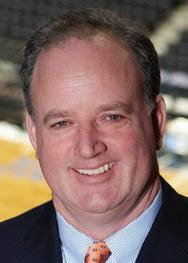
FIRM BRIEF Bruin Capital (bruincptl.com) is an international investment and operating company specializing in all aspects of the media ecosystem with a concentration in sports, entertainment, technology, marketing, advertising, live events, licensing, and brand strategy. Today, Bruin companies operate out of 50 offices across five continents with 2,100 employees. Bruin investors include The Jordan Company, CVC Capital Partners, Rock Ventures, NNS, and a prestigious family investment fund group.
What was your vision for creating Bruin Capital and how do you define its purpose?
Having led global sports companies for nearly three decades, we saw the oncoming transformation of media and consumer interests as an opportunity to launch Bruin as a vehicle for investors and entrepreneurs to capitalize on the changing dynamics. We felt our unique value proposition of capital and capability would be difference-making resources in the quest to create value and build great companies. We are very proud of how that has played out.
How critical is it for Bruin Capital to have an entrepreneurial spirit and culture of innovation?
It’s vital. Ideas are what drive companies forward. I’ve learned that great ideas can come
from everywhere, and you need an environment that allows those ideas to be communicated and flourish. We place a premium on independent thinking and encourage it across all our companies.
How has Bruin Capital evolved since its founding in 2015?
Bruin is much more established now based on the performance of our companies and investments. We’re seeing even more inbound opportunities across our desks. Operationally, we move faster. Our network is bigger and can truly accelerate any platform we get behind.
establish the trust and communication that cuts through the noise and leads to the best, most effective decisions possible.
Will you highlight Bruin Capital’s portfolio companies, and what are the key characteristics Bruin looks for when evaluating an investment opportunity?
The common thread in our companies is that they elevate the sports experience for fans. A few examples from our portfolio are: Two Circles, an award-winning, data-driven, strategic marketing company that helps leagues elevate everything about the fan experience. Full Swing is a state-of-the-art sports simulation company that allows you to play, train and compete in your favorite sports at your convenience. Oddschecker is like an Expedia for bettors who want real-time odds comparison and data. Engine Shop produces hundreds of sports and entertainment “experiences” worldwide.
Do you worry that the economy and higher costs will have an impact on sports when it comes to consumption from consumers?
Throughout history, sports have always been an escape from challenging times, including the ebbs and flows of the economy. There may be some headwinds – how much is anyone’s guess – but I don’t see any long-term decaying of the industry. The fundamentals are incredibly strong. We’ve just been through unprecedented challenges due to COVID and came back even stronger – because fans missed the distraction and entertainment games provide. I’m not concerned.
What has made the sports industry so special for you and a place where you have wanted to spend your career?
Will you discuss Bruin Capital’s capabilities and differentiation?
In Bruin’s first two funds, we have the backing of The Jordan Company, CVC Capital Partners, plus leading family investment funds, ensuring that no idea or opportunity is off the table for us. We also have a global team and advisors who have run extremely high-performing sports, entertainment, media, and technology companies with massive networks available to our partners. And what distinguishes us from others is our culture. We work very hard to
It’s my heritage. My father and grandfather played professional football. I played football for Brown. My father-in-law is a Hall of Fame golfer. Both my sons are football players. The eldest played at Brown, and my youngest is now at Notre Dame. There’s nothing like bringing a team together in competition. It’s like running a business in so many ways.
Bruin Capital has achieved strong growth and success since its founding. Do you enjoy the process and take moments to reflect on what you have accomplished?
I try to enjoy the process more now than when I was younger. I’m proud of what we’ve accomplished, but there’s more ahead for us which keeps my focus.•
NEW YORK NEW YORK
George Pyne
An Interview with George Pyne,
Chief
Executive
Officer, Bruin Capital
POSTED WITH PERMISSION. COPYRIGHT © 2022 LEADERS MAGAZINE, LLC LEADERS 186 VOLUME 45, NUMBER 4
“The common thread in our companies is that they elevate the sports experience for fans.”









































O N E C O M P N ONECOMPANY.. O N E I S I O N ONEVISION.. O R L D O F AWORLDOF B U I L D I N G S E R I C E S BUILDINGSERVICES CEO&President WWW.ALLIANCE.US MICHAELRODRIGUEZ ••
Investing in Ideas That Will Change the World
EDITORS’ NOTE As a fourth-generation member of the Fisher family – one of New York’s legendary owner/builders – Steven Fisher has devoted his more than 40 years as a partner at Fisher Brothers to construction and development. He served as Chairman and CEO of Fisher Brothers subsidiary Plaza Construction Corporation until its April 2014 sale. Under his decades-long leadership, Fisher transformed Plaza Construction into one of the city’s, and South Florida’s, largest and most respected construction firms, growing it from an in-house division with revenues of $40 million to a company with annual revenues of approximately $1.5 billion. Among his other pursuits, he is a Trustee of the Intrepid Museum Foundation, a Trustee member of the New York State Trooper Foundation, a Board Member of the Police Athletic League, a member of the Founder’s Circle of the New York City Police Museum, and a member of the Board of Managers for UrbanAmerica’s Urban II partnership with Fisher Brothers.

FIRM BRIEFS Fisher Capital Investments (fisher capitalinvestments.com) is a private investment firm based in New York City and founded in 2014 by Steven and Kyle Fisher. FCI invests in and advises companies across a range of industry sectors with a focus on high-growth companies. Sectors in which the firm has invested and has expertise include media and entertainment, food and beverage, health and wellness, and technology. Investments are typically made in early stage and mid-market companies that can demonstrate the potential to deliver superior returns to shareholders. Since its recent inception, FCI has invested in, strategically repositioned, and provided operational support to a number of companies and brands that are now well-placed to become industry leaders.
Fisher Brothers (fisherbrothers.com) was founded in 1915 by Martin Fisher, who was joined by brothers Larry and Zachary Fisher. Over the next several decades, Fisher Brothers built residential properties in Brooklyn, Queens, Long Island, Riverdale, Mount Vernon, and then in Manhattan. Fisher Brothers began putting up commercial buildings in the mid-’50s, and has built and owned hotels in Miami. Since then, Fisher Brothers has emerged as a highly diversified financial investment force. Assets currently under management exceed $6 billion, with a substantial portion strategically invested in a broad spectrum of financial markets and ventures, including opportunistic overnight investments in treasuries and repos, as well as building refinancing and construction loans.
What have been the keys to Fisher Brothers’ strength and leadership for over 100 years?
Steve : Fisher Brothers is a firm that is able to adapt and evolve with the constantly changing world. We have a family culture and since 1915, Fisher Brothers has embraced the core values of conservative entrepreneurship, long-term vision, integrity, and philanthropy to advance the firm’s enduring achievements. When I started at Fisher Brothers in 1979, there were seven partners. Today, led by my brother Kenny, my cousin Winston, and myself, we are proud to be carrying on a family business that
has enjoyed nearly a century of uninterrupted growth. As the Fishers who came before us, each successive generation is committed to passing on a legacy even more promising than the one that was placed in our trust. Now we are on the fifth generation of Fishers, including my daughter, Jamie Rose Fisher, who is actively involved in day-to-day operations at Fisher Brothers, and my son Kyle Fisher, who is actively involved in day-to-day operations at Fisher Capital Investments.
You mentioned Fisher Brothers’ family culture. What has made the family dynamic work so well?
Steve : As a family, we’ve been able to complement each other well throughout each generation. Each partner focuses on their individual strength to support the collective. In this current generation, my passion is building, whether that relates to building actual buildings with our real estate business at Fisher Brothers or investing in entrepreneurs through Fisher Capital Investments to help build the next generation of leading companies. Kenny is in charge of Fisher Brothers portfolio and has a passion for philanthropy. He leads the family’s charitable efforts which are well known for being military-centric, and we also have a long history of supporting the police, firemen and all first responders. Winston’s passion is creating, and it has been amazing to watch how his vison for AREA15, an experiential retail and entertainment complex in Las Vegas, has become a reality and the impact that AREA15 has made since its
NEW YORK NEW YORK
Steven Fisher (left) and Kyle Fisher
An Interview with Steven Fisher, Founder and Chairman, Fisher Capital Investments and Partner, Fisher Brothers, and Kyle Fisher, Partner, Fisher Capital Investments
“FCI is focused on investing in founders who have a vision of disrupting and changing the world for the better.”
POSTED WITH PERMISSION. COPYRIGHT © 2022 LEADERS MAGAZINE, LLC LEADERS 188 VOLUME 45, NUMBER 4
Steven Fisher
opening in 2020. We put each of our passions together to build and create for the next generation, while giving back to the communities that have supported us along the way.
You built a leading construction company, Plaza Construction, and eventually sold the company. What was the key to Plaza’s success?
Steve: I gave my clients full disclosure and was always transparent. A client could come in and look at my books at any time. Plaza’s difference was that integrity factor and building the understanding that I wasn’t a competitor to a client; they owned the property and needed somebody to build it and I was the right person to do it. I have probably built 40 or 50 highrises, and over 250 million square feet. When I reflect on my time at Plaza, one award that I am most proud of receiving was the 2009 Builder of the Year. There are so many great contractors and this recognition showed that a builder for your own account can become a contractor without “playing the game.”
Plaza Construction was also deeply committed to the community and devoted to supporting important causes, including our pro bono work with Cassidy’s Place, Jamie Rose House, Rosie O’Donnell’s For All Kids Foundation, and many other pro bono projects.
What was your vision for creating Fisher Capital Investments?
Steve : After I sold Plaza, I didn’t know what I was going to do next. My son, Kyle, and I created Fisher Capital Investments with the intention to complement the family business by investing in uncorrelated assets. We wanted to continue the proud legacy of the Fisher family of giving back – but this time through entrepreneurs and founders that are changing the world with their ideas. FCI is focused on investing in founders who have a vision of disrupting and changing the world for the better. We like the idea of “giving back” through our investments to stay true to the Fisher family value of philanthropy. We invest in everything from consumer/retail, clean energy, technology, you name it. We also like to find opportunities where we can strategically utilize the family’s real estate portfolio to enhance the investments.
How special is it to be able to work with your son, Kyle, at FCI and how proud are you to see his growth and development in the business?
Steve: It is special to have the opportunity to work with Kyle and to see how he has grown and taken an even greater leadership role at FCI. He is very talented and creative, and I am excited to see what is ahead for him. FCI, like Fisher Brothers, has a family culture and Kyle is carrying on the family legacy. We have assembled a strong team at FCI and are actively looking at investment opportunities and ways to grow the business.
Will you elaborate on FCI’s focus and mission?
Kyle : We’re very opportunistic and we look at investing in areas where we feel we can alter the outcome through our relationships. It starts with a good idea, but then we look at our network and focus on how we can leverage our experience and relationships to add value. We are focused on supporting entrepreneurs and companies that are innovative and disrupting industries, while also making a difference in society. A few examples of FCI’s portfolio are: Ilia Beauty, a clean cosmetic company that gives back 1 percent of their best-selling product’s sales to environmental causes, starting with reforestation. They’ve started an initiative to plant 1 million trees by the end of 2023; Energy Vault, a clean energy company focused on solving one of the largest global problems facing the planet today – how to store renewable energy in both an economical and sustainable way to end the world’s reliance on fossil fuels; Uncle Nearest, a whiskey brand honoring the legacy of the formerly enslaved man, Nearest Green, who taught Jack Daniel how to make whiskey that has now launched the “Nearest & Jack Advancement Initiative” to increase diversity in the American whiskey industry; Naadam Cashmere, a sustainable cashmere company committed to transparency, ethical practices, cultural preservation, and environmental sustainability. They set up a nonprofit to give back to the herders’ community where they source their materials and protect the planet through anti-desertification
programs, local nonprofit work, and supplier partnerships committed to ethical and environmental standards.
What are your priorities for FCI as you look to the future?
Kyle: We will continue to focus on investing in entrepreneurs and ideas that will change the world. We are also looking at the opportunity of launching a traditional fund in the near future to provide an opportunity for others to participate in our growth and become more active in the investments we make. It is exciting to be able to build FCI alongside my father and to work with our talented team to support the next generation of leading companies.
You mentioned earlier the Fisher family’s commitment to philanthropic work. What has made philanthropy so important to the family?
Steve: Philanthropy has always been and will always be a large part of the Fisher family. We support the military and veterans through Fisher House Foundation, which builds comfort homes where military and veteran families can stay free of charge while a loved one is in the hospital. Beyond that we have the Intrepid Fallen Heroes Fund which has provided close to $75 million in support for the families of military personnel lost in service to our nation, and for severely wounded military personnel and veterans. These efforts are funded entirely with donations from the public, and hundreds of thousands of individuals have contributed, with 100 percent of the contributions raised going towards these programs while all administrative expenses are underwritten by us. We’ve also recently launched a new project to assist wounded warriors who suffer from traumatic brain injury, which was spearheaded by my late father, Arnold. This fund constructed the National Intrepid Center of Excellence to support research, diagnosis, and treatment of TBI and CTE. Another effort that is near and dear to my heart on behalf of my son is the Michael Tyler Fisher Center of Education – this is a state-of-the-art 18,000-square-foot facility serving students, teachers, and administrators. The Center provides a resource for after-school leadership programs, educational tours, and enrichment programs, and features “Pathways to Success: The Power of One,” an inspiring speakers program directed at high school students who may be struggling with difficult life choices. On top of that, as you may know, I’ve long been a supporter of the NYPAL and New York State Police Association.
Do you take moments to reflect and appreciate what you have accomplished?
Steve: I know that I am very fortunate and have been able to get involved in amazing real estate projects, create a leading construction company, and now build FCI by investing in dynamic entrepreneurs and the next generation of leading companies. It is even more special being able to do it with my family and to carry on the legacy that those before us built. While it is important to reflect and to take moments to celebrate the wins, there is so much more to do, and I am focused on the future.•
“We’re very opportunistic and we look at investing in areas where we feel we can alter the outcome through our relationships.”
POSTED WITH PERMISSION. COPYRIGHT © 2022 LEADERS MAGAZINE, LLC LEADERS189 VOLUME 45, NUMBER 4
Kyle Fisher
A Collaborative Spirit
EDITORS’ NOTE Mariya Rosberg has over 25 years of experience serving leading investment and universal banks, as a consultant with Oliver Wyman and as an internal strategist. Her work is focused on wholesale banking strategy and transformation, and financial services regulation. Rosberg also serves as Chair of the firm’s Global Leadership Team (GLT) Council. The GLT Council is a diverse group of non-Partner colleagues who work alongside the firm’s Global Leadership Team to provide input and offer perspectives on the firm’s vision, strategy, and operations. Rosberg holds a master’s degree in law and diplomacy from the Fletcher School at Tufts University and a bachelor’s degree in history from Dartmouth College. She was named Working Mother of the Year in 2018.

FIRM BRIEF Oliver Wyman (oliverwyman.com) is a global leader in management consulting. With offices in 70 cities across 30 countries, Oliver Wyman combines deep industry knowledge with specialized expertise in strategy, operations, risk management, and organization transformation. The firm has more than 5,700 professionals around the world who work with clients to optimize their business, improve their operations and risk profile, and accelerate their organizational performance to seize the most attractive opportunities. Oliver Wyman is a business of Marsh McLennan.
Will you provide an overview of your role and areas of focus?
I wear many hats at Oliver Wyman. First and foremost, I’m a consulting partner focused on delivering impact for my wholesale banking clients. I’ve worked in banking for 25+ years, both as a consultant at Oliver Wyman (twice now), and in industry for Merrill Lynch, Bank of America, and Deutsche Bank. Over this time, I’ve focused primarily on strategy, regulatory remediation, and large-scale transformation programs. For the past three-plus years, I’ve had the great privilege of leading our Americas Corporate and Institutional Banking (CIB) practice. This team of more than 60 partners, consultants, and specialists is part of our integrated global CIB team. Our team serves globally systemically important banks (GSIBs), regional banks, financial infrastructure and technology providers, and private capital investors in the wholesale banking ecosystem. Last but certainly not least, I am honored to be serving as the first chair of our Global Leadership Team Council – Oliver Wyman’s own “shadow board.”
Will you elaborate on the role and impact of shadow boards?
A shadow board is a representative group of non-executives from across an organization who work directly with the leadership team to steer firm strategy and direction. We’ve found that this concept can turbocharge an organization’s approach to worker retention and engagement: Shadow boards help management understand worker needs and wants in a much more meaningful way, and build more authentic employer-worker connections.
At Oliver Wyman, we launched our shadow board two years ago as a way to expose our leadership team to new voices and perspectives from across the firm. We wanted to be able to surface blind spots and identify creative solutions to our own workforce challenges. The impact of our shadow board has exceeded all of our expectations.
The impact of our shadow board has exceeded all of our expectations. The group reviews and challenges nearly everything our leadership team sees. By participating directly in the leadership process, our team has shaped management actions to strengthen our talent value proposition, expand our recruiting net, and protect and enhance our amazing Oliver Wyman culture, among other initiatives.
The opportunity to take part in a shadow board is also a great draw for exceptional people. In our case, nearly 10 percent of eligible members of the firm have applied for a role on one of our annual teams. It’s inspiring for both recent graduates and long-term colleagues to have an opportunity to be “in the room where it happens.”
What have been the keys to the strength and leadership of the Americas Corporate and Institutional Banking practice?
At the heart of our global CIB practice is the deep expertise of our team across all aspects of the wholesale banking business. Many of our team members have been industry practitioners, and all of us have spent the bulk of our consulting careers specializing in this area. We bring Oliver Wyman’s hunger for deeper understanding to our work across capital markets, transaction banking, and market infrastructure. We work seemlessly across regions, and closely with our colleagues who specialize in finance, risk, digital transformations, and organizational effectiveness – bringing a crossdisciplinary mindset to CIB challenges.
NEW YORK NEW YORK
Mariya Rosberg
An Interview with Mariya Rosberg, Partner, Head of Americas Corporate and Institutional Banking, Oliver Wyman
POSTED WITH PERMISSION. COPYRIGHT © 2022 LEADERS MAGAZINE, LLC LEADERS 190 VOLUME 45, NUMBER 4
“This team of more than 60 partners, consultants, and specialists is part of our global CIB industry group, serving global systemically important banks (GSIBs), regional banks, financial infrastructure and technology providers, and private capital investors in the wholesale banking ecosystem.”
Beyond deep expertise, what differentiates our CIB business is our collaborative spirit. We are used to solving highly complex problems in intense team environments, and to working across all sorts of organizational boundaries. Oliver Wyman is a learning culture, and we are humble in that pursuit. Above all, we love our work and have fun together. CIB teams tend to become deeply embedded with our clients over many years; their success is our success. That deep commitment is what really sets us apart, and what people notice most when they work with CIB.
How important is it for Oliver Wyman to build a diverse and inclusive workforce to bring varied perspectives and experiences to the table when addressing client needs?
Having a diverse and inclusive workforce is of paramount importance for Oliver Wyman, both for our own internal employee experience and our ability to serve our clients well. I’ve learned first-hand over my career that the value of diverse teams cannot be overstated. Teams that bring together a diversity of life experience, identity, and perspective just do a better job of thinking outside the box – and that’s critical when addressing complex challenges. Our clients expect us to bring diverse perspectives to bear, and we have greater impact on their organizations when we do just that.
One of the most rewarding things I’ve been able to do at Oliver Wyman is contribute to our periodic “Women in Financial Services” reports. In our most recent report, we wrote about the importance of taking a panoramic view of gender diversity across all of an organization’s stakeholders: employees, clients, stakeholders, and society. We
estimated a revenue opportunity of more than $700 billion for the financial services industry from better serving women as customers. This underscored for me the importance of diversity across all parts of the professional services ecosystem.
What do you see as Oliver Wyman’s responsibility to the communities it serves?
We are privileged to work in so many vibrant, amazing cities around the world, and to serve public and private organizations across these geographies. I view it as a key part of our responsibility to play a positive role in these communities.
Happily, Oliver Wyman is chock full of people who are passionate about investing in our communities and our societies, and it’s a great joy to see how this commitment plays out in the range of social impact we have as a firm. Our work in this space tackles climate change, social justice and equity, and the arts –and takes the form of pro bono consulting, volunteer activity, charitable giving, and direct participation in key organizations.
Do you feel that there are strong opportunities for women to grow and lead in the industry?
Of course, I do. The change I’ve observed in financial services and in consulting over my roughly 25 years in the field has been astonishing. When I first joined the workforce, there were women in senior positions – but only a handful, and there wasn’t the sense of allyship that there is today. It still takes a huge amount of grit and conviction to succeed as a woman in a maledominated field, but my sense is that today there is genuine commitment from most in the industry to increase diversity and inclusion. That’s really different from how things felt 25 years ago.
The pandemic was an interesting moment for women in the workforce. While it was incredibly disheartening to see so many women leave the workforce, the changes in the way we work can also be quite positive for women in leadership roles. I’m hopeful that we can maintain some of the flexibility in working styles we’ve all experienced over the last few years, and the benefits this has had in increasing diversity in the leadership ranks.
But we still have a long way to go. At the moment in financial services, we have roughly 20 percent representation of women on executive committees and just slightly higher than that on boards. We all have our work cut out for us.
What advice do you offer to young people beginning their careers during this challenging and unprecedented time?
First, stay curious and focused on learning. The most successful people I’ve met over the years share an authentic intellectual curiosity. Being open and able to learn new skills and content helps keep you engaged, engaging, and humble. What’s more, it’s really important to be able to pivot quickly in this rapidly changing world. If you’re just starting your career, chances are that you are in a learning mindset and drinking from the firehose; the trick is to sustain that curiosity and love of learning over the long haul.
Second, be open to the unexpected. I find that many young people beginning their careers now are very focused on mapping out future steps, and following a plan. While there is real value to this, there is also value to allowing for a bit of serendipity – and going with the flow sometimes. Some of the best career experiences I’ve had have evolved from unexpected connections and conversations.•
“We are used to solving highly complex problems in intense team environments, and to working across all sorts of organizational boundaries.
Oliver Wyman is a learning culture, and we are humble in that pursuit.”
POSTED WITH PERMISSION. COPYRIGHT © 2022 LEADERS MAGAZINE, LLC LEADERS191 VOLUME 45, NUMBER 4
“We are privileged to work in so many vibrant, amazing cities around the world, and to serve public and private organizations across these geographies. I view it as a key part of our responsibility to play a positive role in these communities.”
The People Business
An Interview with Michael A. Rodriguez, Chief Executive Officer and President, Alliance Building Services
EDITORS’ NOTE Michael Rodriguez began his career as a porter at the World Trade Center in 1988. Following the 1993 bombing of the World Trade Center, he left janitorial services and began a supervisory role at a prominent security company.
Rodriguez then returned to his roots at the World Trade Center as a janitorial supervisor before joining First Quality Maintenance in 1995. In 2000, he was appointed President of Alliance Building Services and assumed the additional role of CEO in 2020. In 2009, Rodriguez was chosen as one of Crain’s 40 most dynamic businesspeople under age 40 in New York City. In 2010, he received the Los Niños Image Award for Business from the Committee for Hispanic Children and Families, Inc., and in 2014, he was honored at the National Jewish Health’s AIR Society The Sky’s The Limit Benefit. Under the Alliance banner, he has sponsored several community events, including “Swing for a Cure” Golf Classic to benefit The Herophilos Fund for Pancreatic Cancer Research at Columbia University Medical Center for the last ten years.

Rodriguez also advocates for the betterment of the Latino community by serving on the Board of the Committee for Hispanic Children and Families, Inc. and the Diabetes Research Institute. He contributes substantially to several organizations including Nontraditional Employment for Women (NEW), Big Brother Big Sisters of New York City, St. Francis Food Pantries and Shelters, Nassau Suffolk Services for Autism (NSSA), and enCourage Kids Foundation.
COMPANY BRIEF Founded in 1992, Alliance Building Services (alliance.us) provides comprehensive facilityrelated services for approximately 75 million square feet of space in the New York Tri-State area. Alliance offers facility maintenance and janitorial services, security officers and security technology systems, and restoration services through its brands – Alliance Maintenance, Alliance Security, and Alliance Restoration. Alliance has become an industry leader in building maintenance and security services by taking the time to understand its client’s needs and creating partnerships for mutual success. Alliance’s unified management team, seamless communication, use of the latest industry technologies, and cost-effective procedures create the most dynamic solutions for its clients’ facilities.
Alliance Building Services is celebrating its 30th anniversary. What have been the keys to Alliance’s strength and leadership in the industry?
It is hard to believe that it has been 30 years. Alliance has gone from being a thought in 1992 of creating a company that would clean a handful of buildings on its own, to today where we have approximately 3,000 employees cleaning nearly 75 million square feet. That has happened with organic growth by building relationships and building the business through word of mouth and referrals. It is really exciting and we are blessed to be in this position.
Will you provide an overview of Alliance’s business today?
The maintenance business – cleaning and engineering services – has been the behemoth of the business. The physical security offering is a perfect spin-off since we can provide highend labor that can deliver maintenance programs and high-end labor that can deliver security programs. There is a strong synergy between these two service offerings. The restoration offering has progressed well, and this is more of a specialty service that builds off of our other solutions. We focus on growth in all our service offerings and see great opportunities ahead. We are building programs that are cutting edge, not only when it comes to security, but also in regard to technology so that our clients know that they are getting state-of-the-art service.
Alliance is a leader in the New York market. Will this remain the primary focus for the company?
We love the New York market and are committed to continuing to invest and grow in New York. We recently took on a new client in South Florida that we are very excited about, and we see opportunities to expand in that market as we look to the future. Our focus is on having enough volume to provide the proper service, so if we can find the right volume, we are open to expanding into new markets, most of which will be the markets that our clients are expanding into as we grow with them.
You have said that Alliance is not a service provider, but rather a partner to your clients. Will you elaborate on the client relationship?
We are firm believers that once we understand our client’s vision for the property,
NEW YORK NEW YORK
Michael A. Rodriguez
POSTED WITH PERMISSION. COPYRIGHT © 2022 LEADERS MAGAZINE, LLC LEADERS 192 VOLUME 45, NUMBER 4
“We are building programs that are cutting edge, not only when it comes to security, but also in regard to technology so our clients know that they are getting state-of-the-art service.”
it is our job to execute based on that vision. We are committed to exceeding the client’s expectations and being partners to our clients in achieving their goals. We see ourselves as partners and focus on building relationships since this is a people business. When a client knows that their service provider is going out of their way to execute their vision, and is transparent and open about what is happening in their building and what needs to be done, it builds unbreakable relationships. That is a partnership and that is what Alliance is all about.
What are your views on the future of work?
It is clear that hybrid working continues to be a part of how companies work, but we see that clients want their employees back in the office since it is critical to building culture and collaboration. Clients are also more focused on specialty cleaning and hygiene in the buildings, with significant focus on providing their employees with the safest and cleanest environment. As more people return to the office, especially young people who want to be in the office to learn and grow in their roles, Alliance is creating some amazing cleaning programs that will enhance the work environment.
What was the vision for Alliance moving toward an employee-owned company structure?
I have been very fortunate to have an amazing partner for over 25 years, someone who gave me an opportunity that became a lifechanger for me, and the time had come for my partner to want to take his equity and move into other businesses. As we were evaluating the best way forward, there was undoubtedly private equity
money interested in the business. Still, I wanted to maintain control of the company because we have 30 to 40 key managers that have been with us and have helped grow the business for more than ten years, and this was about what was best for them as well. We looked at the future with a priority on what was best for our people since it would pay off in the long run if you supported and invested in your talent. We were able to find a way to satisfy my partner’s interests in a very fair deal for him, while also providing a structure for me to stay with Alliance which was my priority as we continue to grow the business for the future, and our employees can now be owners as we move forward with an ESOP structure.
In addition, because of the makeup of our company, we believe that in the near future we will receive minority status which will provide even more opportunities to expand the business and grow with other industries and leading corporations.
How critical has it been to invest in education and training programs for Alliance’s employees as the company has grown in size and scale?
When you are in the labor business, you are nothing without your labor. I can sell, entertain, and build relationships with real estate owners, but if our team does not deliver, we will not grow the business. We invest a tremendous amount in our people at all levels of the business, from our supervisors and managers to our new hires. We provide education and training programs that are not just focused on how to do the job better, which is a priority, but also show our people that we care about them and want them to succeed. We want our team to know that they are an integral part of
what we are building, and we will take the time to provide them with the tools they need to grow and fulfill their potential. It is so fulfilling to see a person progress in the company and take on more responsibility since we are committed to providing opportunities for our employees to have rewarding careers.
How has your role evolved as Alliance has grown over the past 30 years?
I have had to evolve as a leader since it does get harder to manage my time with the growth of the business, but it will always be a priority for me to be with our team and to spend time with our employees. The success of Alliance comes down to the talent and people at the company. When you are in the people business, you need to put your people first, which will lead to great client service and lasting client relationships.
When you look back at the impact and success of Alliance over the past 30 years, do you take moments to reflect and appreciate what has been accomplished?
There is no question that when you are constantly looking at trying to grow and where the opportunities are for the future, it is hard to take moments to look back and reflect on what has been accomplished. I can do this a little bit more today because of the strong talent of our managers and supervisors doing such a great job. I want to take the time to tell our people about the history of Alliance over these past 30 years and to tell the stories about how we built the company and created long-lasting client relationships, since this helps build on our history and tradition as we look to the future.•
“Alliance has gone from being a thought in 1992 of creating a company that would clean a handful of buildings on its own, to today where we have approximately 3,000 employees cleaning nearly 75 million square feet.”
POSTED WITH PERMISSION. COPYRIGHT © 2022 LEADERS MAGAZINE, LLC LEADERS193 VOLUME 45, NUMBER 4
“We are committed to exceeding the client’s expectations and being partners to our clients in achieving their goals. We see ourselves as partners and focus on building relationships since this is a people business.”
© 2021 Corcoran Group LLC. All rights reserved. Corcoran® and the Corcoran Logo are registered service marks owned by Corcoran Group LLC. Corcoran Group LLC fully supports the principles of the Fair Housing Act and the Equal Opportunity Act. Each franchise is independently owned and operated.
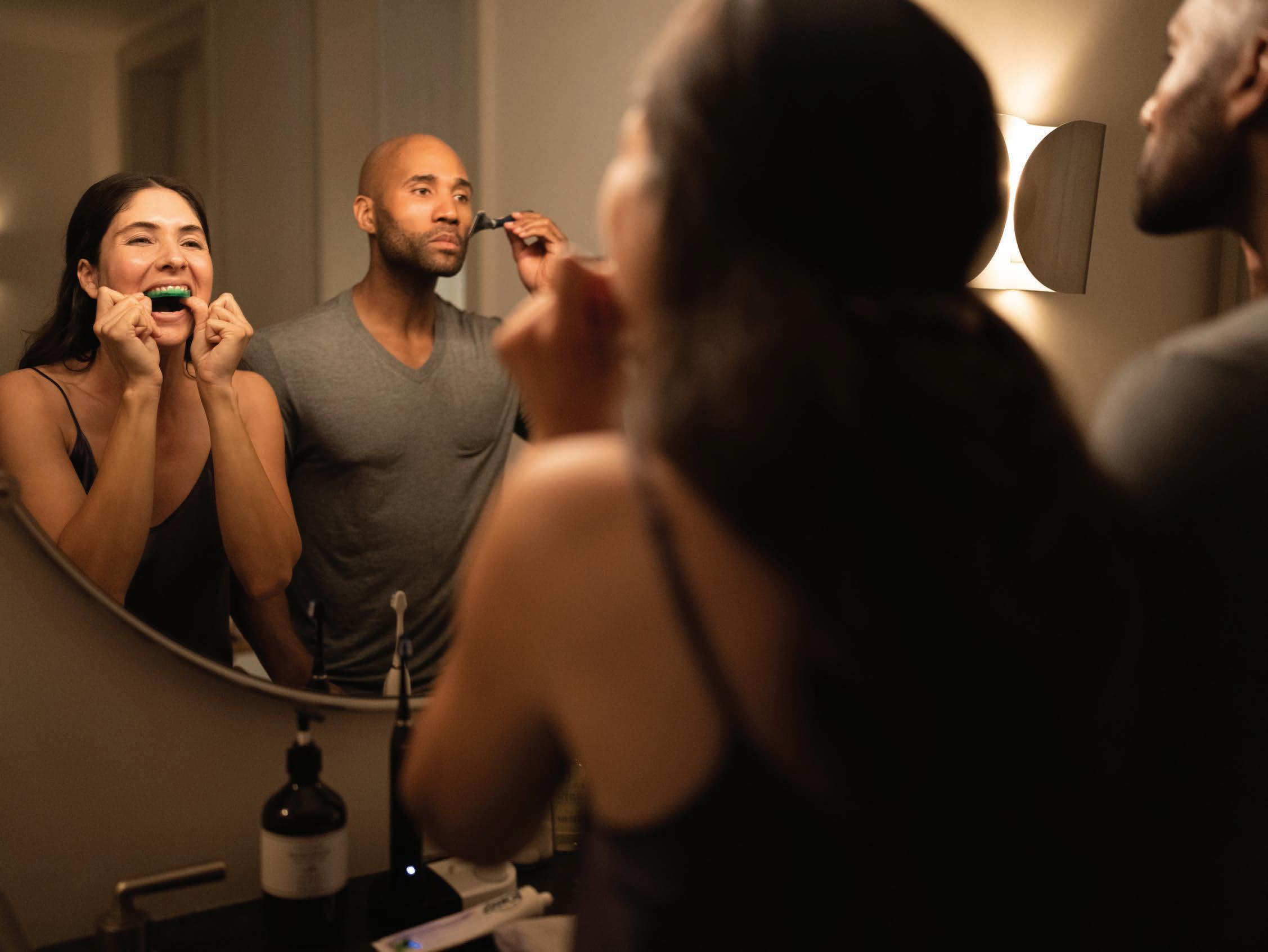

FIND YOUR HOME AT CORCORAN.COM
be elegant be refined be glam be home.
EDITORS’ NOTE Dr. Steven Corwin has served as CEO since 2011 and President & CEO since 2015. Dr. Corwin joined the management team of NewYork-Presbyterian/Columbia University Irving Medical Center in 1986 and served in various management capacities. From 2005 to 2011, he was Executive Vice President and Chief Operating Officer. A cardiologist and internist, he received his undergraduate and medical degrees from Northwestern University, graduating summa cum laude and with Alpha Omega Alpha honors. He completed training in internal medicine and cardiology at what is now NewYork-Presbyterian/Columbia University Irving Medical Center and in 1986 was named to the faculty at what is now Columbia University Vagelos College of Physicians and Surgeons.
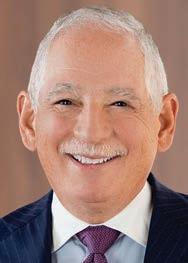
INSTITUTION BRIEF Located in New York City, NewYork-Presbyterian (NYP.org) is affiliated with two of the nation’s leading medical colleges, Weill Cornell Medicine and Columbia University Vagelos College of Physicians and Surgeons. NewYork-Presbyterian provides state-of-the-art inpatient, ambulatory, and preventive care in all areas of medicine, and is committed to excellence in patient care, education, research, and community service at ten hospital campuses: NewYorkPresbyterian/Weill Cornell Medical Center, NewYork-Presbyterian/Columbia University Irving Medical Center, NewYork-Presbyterian Morgan Stanley Children’s Hospital, NewYork-Presbyterian Allen Hospital, NewYork-Presbyterian Westchester Behavioral Health Center, NewYork-Presbyterian Lower Manhattan Hospital, NewYork-Presbyterian Westchester in Bronxville, NewYork-Presbyterian Brooklyn Methodist Hospital, NewYork-Presbyterian Hudson Valley Hospital, and NewYork-Presbyterian Queens.
NewYork-Presbyterian is a purpose-driven organization with a long history of supporting its employees, patients, and communities. How do you define NewYork-Presbyterian’s purpose and how is purpose at the foundation of NewYork-Presbyterian’s culture?
NewYork-Presbyterian is one of the nation’s most comprehensive, integrated academic healthcare delivery systems. We are dedicated to providing the highest quality, most compassionate care and service to patients in the New

Patient Care
York metropolitan area, nationally, and throughout the globe. We are committed to caring for every single patient who walks through our doors. Everyone needs healthcare and the lights of our hospitals are always on. We are deeply connected to local communities and have a long-standing commitment to understanding and serving their needs from the everyday to the extraordinary.
Our purpose is engrained in nurturing and growing our workforce to be the home of world-class medical experts, investing in vital research and cutting-edge clinical innovation, and prioritizing heath justice for all.
What do you see as the biggest challenges facing leading health systems and hospitals as you look to the future?
Looking to the future, I see four challenges – the first is meeting patients where they are to provide high-quality care. There will always be a need for in-person hospital visits, and nothing can replace a high-touch, human experience, but we must be able to meet our patients in their communities and in their homes.
Next is recruiting and retaining talent which is vital to maintaining operations. Pre-pandemic, the healthcare industry was impacted by staffing shortages, and we are still seeing waves of change due to burnout. We must take care of our staff and keep a strong pipeline of new talent.
Making concerted efforts towards prioritizing health equity is also an imperative. Black people in the United States had a death rate from COVID-19 that was double that of the white population, which is alarming. Underserved communities need more and better access to care.
Finally, digital transformation is an imperative to advancing medicine today. Whether it’s telemedicine, artificial intelligence, or better use of big data and insights to improve prevention and delivery of care, the future is digital in order to be able to enhance the patient and physician experience.
What is your vision for the evolving role of the hospital as health systems grow their ambulatory care and outpatient facilities?
How and where we deliver care to our patients to make sure we can meet them where they live and work – no matter what they need –has been an important priority for our health system, long before the pandemic. And the role
NEW YORK NEW YORK
Steven J. Corwin
An Interview with Steven J. Corwin, MD, President and Chief Executive Officer, NewYork-Presbyterian
POSTED WITH PERMISSION. COPYRIGHT © 2022 LEADERS MAGAZINE, LLC LEADERS 196 VOLUME 45, NUMBER 4
NewYork-Presbyterian/Weill Cornell Medical Center
of the hospital has never been more important as it drives a system of care that continues to evolve with many options.
The pandemic, however, brought a surge in telehealth use and a drop in emergency room visits which has accelerated the need to expand our ambulatory practice reach and outpatient services overall. Today, NewYork-Presbyterian’s ambulatory practice footprint consists of over 190 primary and specialty care sites across the five boroughs, Westchester, and the Hudson Valley including seven school-based health centers.

Regardless of this shift, the hospital and inpatient services will maintain a central role in the health system. Hospitals such as academic medical centers, like ours, that have a strong focus on highly complex cases that require greater levels of specialty care, will continue to sustain a demand for inpatient services.
There is a great deal of discussion about New York’s future. In leading an institution like NewYork-Presbyterian with such a long and storied history in New York, are you optimistic that New York will recover and rebuild to remain a leading global city?
I have no doubt that New York will remain a leading global city and do what it takes to maintain that recognition. This isn’t the first time that New York City has proved its resilience in the face of disaster. As a city, we will never forget the impact of 9/11, but the city built back stronger than ever, and we will again.
What do you see as the keys to New York City’s recovery and how critical is it for there to be a strong public/private partnership working together to secure New York’s future?
In New York City specifically, we have a long history of public/private partnerships that leverage the power and reach of government with private funding that can be made available
more rapidly in times of crisis. As we address the aftermath of this global pandemic, public/private partnerships will be even more essential as our city, and country, strive to recover. Public resources alone won’t be enough, and these partnerships will be needed to cover gaps, support innovation, test new ideas, and implement important programs.
As a country, we also need to ensure that there are enough resources to rebuild and modernize our public health infrastructure so that we can keep ourselves and our communities safe and prepared for any future events of this magnitude.
NewYork-Presbyterian is deeply engaged in the communities it serves. Will you discuss NewYork-Presbyterian’s commitment to community and population health?
Quality of patient care is central to every decision we make. Not only do patients expect personalized care, but they also expect care that is convenient and easily accessible. We are making care more accessible through a hybrid of in-person and virtual healthcare solutions, digital clinician communication tools, patient education, and community outreach. We are also increasing access to services like remote patient monitoring as part of our continued efforts to improve patient outcomes, lower hospitalizations, and reduce patient expenses. With 10 campuses across New York City’s five boroughs, Westchester, and the Hudson Valley, combined with a telehealth program that was implemented long before COVID-19 impacted the state, we’ve made a conscious and concerted effort to make sure people know they have plenty of options to access care when, where, and how they need it through a seamless system that prioritizes patients first. We are also acutely aware that virtual solutions may not be equally accessible to all our patients and are continually working to ensure equitable access to care for all.
NewYork-Presbyterian partners with community-based hospital and academic organizations to impact the health and well-being of children, adolescents, and adults through innovative population health initiatives, care provider training experiences, scholarships, and research. These initiatives are collaboratively developed, implemented, evaluated, and sustained. It is only by combining the skills and resources of NewYork-Presbyterian with the energy, immense talents, and resources of our community partners that these goals can be achieved. Our partnerships with community-based organizations and health and human services agencies support initiatives that empower individuals and families to promote health and wellness, better navigate local systems of care and local resources, improve school readiness and academic achievement, and ultimately improve quality of life.
The unifying theme of NewYork-Presbyterian’s community and population health initiatives is that we are focused on an evidence-based approach to overcome disparities over the life span. Together with like-minded communitybased organizations, we are striving to improve the overall health of the communities we serve, and together we are making a positive difference.
How critical is it for medical schools to transform their curriculum to best prepare the future leaders in medicine?
The science and technology of medicine is constantly evolving, which means that what we’re teaching to our medical students and residents must also follow suit. In my opinion, one of the most important aspects of the curriculum that must continue to transform is the emphasis on health equity and health disparities. We need to educate on the impact of social and structural determinants of health, the challenges that our patients face because of their race, ethnicity, and location, and what solutions exist, or are needed, to achieve better access to high-quality care and outcomes. By equipping our medical students with more training about the unique health needs of underserved populations and areas, these future physicians will be better able to address them.
What advice do you offer young people interested in building a career in medicine?
As we continue to get used to a “new normal” two years into the global pandemic, I could not be more proud of every one of my employees who has made the decision to work for a healthcare institution. Each and every one of them, no matter the role, has an impact on the difference we make in our patients’ lives.
Specific to a career in medicine, regardless of the incredibly difficult challenges that come our way, it is a career that is extremely rewarding and humbling. Medical professionals are constantly curious, committed to their craft, and always looking for novel solutions to reducing morbidity and mortality rates, and improving the patient experience. At NewYorkPresbyterian, we’re fortunate to have some of the brightest minds in our field building their careers with us and I look forward to seeing how they contribute to the evolution of medicine into the 21st century.•
POSTED WITH PERMISSION. COPYRIGHT © 2022 LEADERS MAGAZINE, LLC LEADERS197 VOLUME 45, NUMBER 4
NewYork-Presbyterian/Columbia University Irving Medical Center
The Power of the Platform
EDITORS’ NOTE Prior to the merger with CBRE, Stephen Siegel was Chairman and CEO of Insignia/ ESG. He initially rose to prominence in the industry at Cushman & Wakefield, where he became President and CEO at age 37. Renowned in the industry not only for the number of deals he has closed, but for his philanthropic activity, Siegel at one point in his career sat on more than 16 nonprofit boards. In 2015, he was celebrated, along with fellow honorees Queen Latifah and Danny Meyer, for his contributions to the Young Women’s Leadership Network’s College Bound Initiative, a program that creates opportunities for low-income students to attend college and serves nearly 13,000 students each academic year. He is regularly among the Commercial Observer’s Power 100, a yearly ranking of the most powerful people in New York commercial real estate, and has been named by Crain’s as one of the 100 Most Influential Business Leaders in New York City. In 2005, Siegel was featured in the Urban Land Institute’s book, Leadership Legacies: Lessons Learned from Ten Real Estate Legends and, in 2011, he was featured in the
best-selling Commercial Real Estate Brokers Who Dominate: Eight Traits of Top Producers. Siegel has also been honored with Commercial Property News’ Lifetime Achievement Award.

COMPANY BRIEF CBRE Group, Inc. (cbre.com) is the world’s largest commercial real estate services and investment firm with 2020 revenues of $23.8 billion and more than 100,000 employees (excluding affiliate offices). CBRE has been included on the Fortune 500 since 2008, ranking number 122 in 2021. It has been voted the industry’s top brand by the Lipsey Company for 20 consecutive years and has been named one of Fortune’s “Most Admired Companies” for ten years in a row. CBRE offers a range of integrated services including facilities, transaction and project management; property management; investment management; appraisal and valuation; property leasing; strategic consulting; property sales; mortgage services; and development services.
What have been the keys to CBRE’s strength and leadership in the industry?
The differentiation is the platform. One of the reasons we sold Insignia/ESG to CBRE was
differentiation is the platform. One of the reasons we sold Insignia/ESG to CBRE was that at the time of the sale my then partner was not willing to fund growth to make us a truly full-service international company. We needed to fit with another company to put the puzzle pieces together, and those puzzle pieces created the platform that made it possible for the brokers and the company to perform better.”
that at the time of the sale my then partner was not willing to fund growth to make us a truly full-service international company. We needed to fit with another company to put the puzzle pieces together, and those puzzle pieces created the platform that made it possible for the brokers and the company to perform better. The level of reach and support, in conjunction with the different service lines that we developed, sets us apart. I can call anywhere in the world and we have coverage which is an extremely valuable offering and capability for our clients.
Another differentiator is that we have a consulting business that is integrated into the company seamlessly. CBRE is a complimentary firm with the best assets working together to serve our clients.
You have been involved in many mergers throughout your career. What are the keys to making a merger work successfully?
Whenever our predecessor company, Insignia/ESG, pursued a merger, we prioritized the people and would meet with what we called the “best athletes” to make sure they knew we wanted them to stay and that they would have opportunities to grow in their careers. This is the same thing we did when we joined CBRE. I went with Brett White, the CEO of CBRE at the time, and visited with each person that we felt was a “best athlete” and explained to them our vision, where the company was going, and how they fit into the company’s future. We retained almost all the key people around the world and this was critical to our success.
I believe that for a merger to work, you need to do due diligence on the people in the company. You need to spend time with the people to get a feeling as to whether a person is the right fit and will be successful in the new company. There is clearly the need to make sure the numbers work and that the merger makes sense from a financial standpoint, but for it to work over time there needs to be a priority on people and talent.
What are your views on the future of work and are you concerned about the move to hybrid working and remote work?
I have been back in the office every day since March 2021, and I am a strong believer that what you can do in the office is impossible to do at home. You need to be in the office for collaboration, sharing of ideas,
NEW YORK NEW YORK
Stephen B. Siegel
An Interview with Stephen B. Siegel, Chairman, Global Brokerage, CBRE
POSTED WITH PERMISSION. COPYRIGHT © 2022 LEADERS MAGAZINE, LLC LEADERS 198 VOLUME 45, NUMBER 4
“The
social relationships and so on. I am concerned about the future since every time I see some momentum about coming back into the office, you hear about a company that changes their position and allows their people to work remote. I just do not see how in a service business people can stay home – you need to look into the client’s eyes and read the client’s body language.
I am also concerned about the impact of not having employees in the office since there is a vibrancy for cities that occurs when people are in the office and this perpetuates everything in the surrounding area. There are so many small businesses and vendors that rely on the employees that come to work each day and this is gone.
Leases are still being signed, although many companies are taking less space than they initially planned to when they started looking to move. One law firm recently took 40 percent less space than they had originally planned when they started looking, and this trend is just beginning.
I am not opposed to people working a certain number of days in the office each week or working in the office alternate weeks, but I am a full proponent of people being in the office to collaborate, socialize, and maintain culture.
What are the traits you look for when hiring talent that make you feel a person will be successful in the business?
For me, most of it is instinctive. I am looking for a certain energy level, a professional appearance and being dressed appropriately, a passion for the business, and a desire to learn. This is a wonderful business that offers many opportunities, but to be successful a person needs to have that fire in the belly which is something you can get a feel for during an interview.
Where did your interest in philanthropy develop and how do you decide where to focus your philanthropic efforts?
When I was a kid, my father was a union painter, and my mother was a school crossing guard. I would come home for lunch when I was in middle school and there would be four kids sitting at my kitchen table eating lunch. That was the result of my mother inviting them to come to our house for a meal. My father would work as many jobs as needed to provide for our family, and even after painting day and night all week, he would go to the home of a person in need and paint for free.
My mother had a philosophy that if you had two dollars, you gave one of them to a person in need. I was raised with simple ethics and my father always told me that you had three responsibilities to your family: to provide a roof over their head, food on their table, and clothes on their back. No matter how many jobs you
had to work to make this happen, you did it. He would add a fourth responsibility which was to give back.
As time went on, I was approached by different charities and invited to accept awards or recognition as part of a dinner or gala to raise money, and I have done this over the years when I felt a connection and passion for the charity. I became involved in an organization called College Bound and remember when I was honored at one of the dinners, I was matched with a young person from the inner city to interact with and get to know. The young man I met, who was 17 years old at the time, interned at CBRE twice and received a full scholarship to attend Lafayette College. He then interned at another company that I have a relationship with and, today, he works with CBRE full-time in our construction department. His family is from Ghana, and he is the first person in the family to attend college. He is a fantastic young man and the gratification that I get from seeing him grow and thrive gives me so much pleasure.
I am also involved with Gift of Life which is an organization that is very personal to me since it ultimately helped with the transplant that was given to my wife which saved her life. I currently serve as chairman of Gift of Life and am so amazed and proud to be a part of this organization which gives people battling blood cancer a second chance at life.
When you look back at all the deals you have been involved in throughout your business career, did you enjoy the process and take moments to celebrate the wins?
I enjoyed every minute of the deals I was involved in during my career. I may have had a long-range plan, but each deal and acquisition were important on its own since that is how you build a lasting and meaningful career. I love this business and have such a
passion for the work. •
“The level of reach and support, in conjunction with the different service lines that we developed, sets us apart. I can call anywhere in the world and we have coverage which is an extremely valuable offering and capability for our clients.”
POSTED WITH PERMISSION. COPYRIGHT © 2022 LEADERS MAGAZINE, LLC LEADERS199 VOLUME 45, NUMBER 4
“I am concerned about the future since every time I see some momentum about coming back into the office, you hear about a company that changes their position and allows their people to work remote. I just do not see how in a service business people can stay home – you need to look into the client’s eyes and read the client’s body language.”
Skadden’s Strengths
EDITORS’ NOTE Karen Lent is head of the Antitrust/ Competition Group in Skadden’s New York office, representing a wide variety of clients in antitrust, sports and other complex litigation matters at both the trial and appellate court levels. She also provides general antitrust counseling. Lent was named to Global Competition Review’s 2021 Women in Antitrust list, in addition to being named a Sports and Entertainment Trailblazer by The National Law Journal in 2019 and one of Crain’s 2019 Notable Women in the Business of Sports. She has been repeatedly selected for inclusion in Chambers USA: America’s Leading Lawyers for Business and named a Star in Benchmark Litigation, in addition to being recognized as a 2019 Sports MVP by Law360 and named to W@Competition’s 2019 40 in their 40s list of notable women competition professionals. Additionally, she has been named as a SportsBusiness Journal Power Player in sports law and by the same publication to their Forty Under Forty list, as well as recognized in Lawdragon 500 Leading Lawyers in America and The Best Lawyers in America. Lent authors a monthly column on antitrust matters for the New York Law Journal. She has extensive experience counseling professional sports leagues and teams on a variety of antitrust and sports law matters, including the NBA, NFL, MLS, NHL, and NCAA. Lent actively works on pro bono matters, and received the Legal Aid Society Pro Bono Publico Award in 2009 and 2011 for her successful representation of a disabled senior citizen whose landlord illegally overcharged her monthly rent for several years. She serves as Associate Director of Fordham Competition Law Institute. Lent earned a BS degree in chemical engineering from Johns Hopkins University, a JD cum laude from Fordham University School of Law where she served as the Notes and Articles Editor of the Fordham Law Review and earned membership in the Order of the Coif.

Paola Lozano is co-chair of Skadden’s Latin America Group and heads the firm’s Spanish language corporate practice. She also has served as a member of the firm’s Policy Committee. As a New Yorkbased M&A partner, she represents a variety of clients in mergers, acquisitions, dispositions, private equity, and other corporate matters. Lozano is a member of the Cyrus R. Vance Center for International Justice and Fundación Barra Mexicana’s joint committee, established to develop strategies to address threats to the rule of law in Mexico and the U.S. Prior to joining Skadden, she practiced law in Colombia with one of Colombia’s top law firms. Lozano has been recognized as a 2019 Latin Lawyer International Lawyer of the Year; in Lawdragon 500 Leading Lawyers in
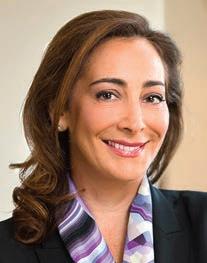
America, 2014-2022; one of only three women named a Leading Individual for M&A in Latin America by The Legal 500, 2021; in Chambers Global: The World’s Leading Lawyers for Business 2012-2022 (Latin America-wide Corporate/M&A, Finance and Capital Markets categories); in Chambers USA: America’s Leading Lawyers for Business 2011-2018 (Latin American Investment category), as “one of the best Latin America lawyers in the market today” who “commands in negotiations, understands clients’ needs;” and in Chambers Latin America 2021-2022 (one of only three attorneys in Band 1: Latin America-wide Corporate/M&A), also ranked in 2012-2020. Lozano earned a JD and a master’s degree in international commercial law from the Universidad de los Andes, Bogota, Colombia, as well as an LL.M. degree in banking and corporate finance from the Fordham University School of Law.
FIRM BRIEF Founded in 1948, Skadden, Arps, Slate, Meagher & Flom LLP and affiliates (skadden. com) is one of the world’s most highly respected law firms. Skadden has 21 offices, approximately 1,700 attorneys and more than 50 distinct areas of practice. The firm’s clients include more than 50 percent of Fortune 250 corporations, as well as financial and governmental entities, startup companies and nonprofits.
Will you discuss your roles and areas of practice?
Lent : My practice primarily focuses on antitrust litigation, investigations, and counseling. I also co-head Skadden’s sports practice. A few months after I started here as a first-year associate in 2001, the National Basketball Association’s chief legal officer joined the firm as a partner. The NBA then retained him to work on some cases, including one related to the new women’s league, the WNBA, and he needed to staff up. Someone told him, “Karen played basketball in college” – we made the Sweet 16 in my senior year at Johns Hopkins. That’s how my involvement in sports law started. When people say, “Oh, you’re a sports lawyer,” I tell them I’m an antitrust lawyer and I have sports clients. Sports leagues are very sophisticated and want legal advisers with specific, high-level experience.
NEW YORK NEW YORK
Karen M. Lent
An Interview with Karen M. Lent, Partner, New York, Antitrust/Competition; Sports; Complex Litigation and Trials, and Paola Lozano, Partner, New York, Mergers and Acquisitions, Skadden, Arps, Slate, Meagher & Flom LLP
Paola Lozano
“Similarly, what distinguishes our antitrust team is our comprehensive reach and experience. We can handle any antitrust problem anywhere in the world. In addition to my work on complex litigation matters, we have partners advising on merger clearances, criminal cases, and cartel investigations.”
POSTED WITH PERMISSION. COPYRIGHT © 2022 LEADERS MAGAZINE, LLC LEADERS 200 VOLUME 45, NUMBER 4
Karen Lent
Lozano: I’m an M&A partner based in New York, and I head Skadden’s Spanish-language corporate practice and co-chair our Latin America Group. I lead complex cross-border M&A transactions, representing clients globally, and I supervise the dedicated LatAm corporate group that handles all sorts of corporate matters, including corporate finance, capital markets, project finance, energy, banking, and reorganizations. My role requires a lot of travel across the region. Depending on levels of activity, preCOVID, I spent a couple of weeks every quarter in Mexico, Colombia, Chile, Peru, Argentina, or Brazil.
What distinguishes the firm’s Latin America, Antitrust/Competition and Sports Law Groups from those at other firms?
Lozano : Other firms working in Latin America tend to have generalists – people who spend time in the region or speak the language and will take on any legal matter that comes up. We train our team members to be specialists – as we do for all attorneys throughout the firm. For example, our dedicated LatAm M&A team is trained in the same way as our U.S. M&A team, and it is separate from our LatAm banking and capital markets teams. That allows for more intense and thorough training, and results in deeper understanding and value-add for specific transactions. We also have a large number of dual-licensed lawyers who practiced law at top firms in Latin America before pursuing their careers at Skadden. Not only do we understand the law, but we also know the culture, the people, and the background.
Lent : Similarly, what distinguishes our antitrust team is our comprehensive reach and experience. We can handle any antitrust problem anywhere in the world. In addition to my work on complex litigation matters, we have partners advising on merger clearances, criminal cases, and cartel investigations. We do all of that in the Americas, Europe,
Asia – anywhere a major competition authority might get involved. And the same is true from a sports perspective. It’s not just antitrust and league governance, which are the matters I typically work on. We also have intellectual property experience, a big issue for leagues, and, obviously, a first-class M&A group that handles all sorts of complex transactions for sports leagues around the world. How would you describe your respective management styles and how does being a woman impact your perspective on effective leadership?
Lozano : I believe in being very close to my team. I actively participate in all matters I lead and stay informed of all matters within the group. I try to make sure I understand what team members are going through, how their schedules look, what concerns them. I have been described as “hands-on,” but I find that it enables us to work together most effectively. I also have a sense of when a team member is having a hard time, or if there’s a particular type of transaction that excites them – or doesn’t. This helps me maximize the quality of our efforts, as well as everyone’s enjoyment of their work. I’m not sure if this style relates to gender –perhaps women are used to being more empathetic and thinking about the multiplicity of issues, challenges and demands we all have to master to succeed long-term in Big Law.
Lent : Playing basketball, my aim was to lead by example, and that remains my approach. I like to set a tone that we want to be the best. I don’t have an authoritarian leadership style – it’s more like, I’m in there with you and, in partnership, we are going to excel. We’re inclusive and ambitious. We want to be an industry leader. For us as women, we need to dispel any initial impressions or stereotypes of who we might be when we are in a room full of men.
Lozano : Yes. I also show my team that I’m not asking them to do anything I’m not doing myself.
Lent : Exactly! How has the profession changed for women attorneys since your early days as an associate?
Lozano : When I started practicing law in the early 1990s, people didn’t talk about women and diversity and inclusion the way we do now. It was a given that I would frequently walk into a room and be the only woman. There are still very few women attorneys working at a senior level on Latin American transactions. I never wanted to be the “only” or “best” woman, I just wanted to be the best lawyer. The experience for women is improving, but there still is a long way to go. It’s no coincidence that I’ve built my career at a law firm that recognizes that diversity and inclusion – an emphasis on merit – is essential for success.
Lent : I’ve also seen a change in our clients. In recent years, in-house counsel have become more diverse, which leads to the expectation of a more diverse outside counsel team. While women law partners may still be the only women in the boardroom, on day-to-day calls with clients, we interact with a much more diverse group of people. There are fewer preconceived notions about what you should look like. We’re just part of the team, and that’s a huge step in the right direction. Paola and I are partners now, but this shift is especially helpful for associates, giving them a chance to see there’s a path in front of them.
What advice do you give to young attorneys on your team?
Lent : I frequently suggest to young lawyers, as well as remind myself, to try to view things over the long run. You may be in a tough spot at a given time, but when you broaden your outlook – consider what the last year looked like, not just the last day or month – you’ll get a better perspective and won’t make a bad decision based on a rough moment. This applies to women, in particular. As Paola said earlier, balancing the many challenges and demands of our roles can feel stressful at times, but our jobs often offer a good deal of flexibility as well.
Lozano : Yes. I think a lot about that word you used, Karen – flexibility. I tell the associates I work with that they need to stay flexible. There’s no longer a one-size-fits-all approach to careers. When I first started in law, people would say, “This is the path. If you do Y, you will get to Z.” But that is not the case anymore. I was raised and educated in Colombia, and I began my legal career there, so my path was very unusual. The only way I know to avoid burning out is to stay flexible. Don’t be too wedded to strict views of what you’re supposed to do. Work with really smart people on projects you feel passionate about. Make it a point to seek what you enjoy most.
•
“Other firms working in Latin America tend to have generalists – people who spend time in the region or speak the language and will take on any legal matter that comes up. We train our team members to be specialists – as we do for all attorneys throughout the firm.”
POSTED WITH PERMISSION. COPYRIGHT © 2022 LEADERS MAGAZINE, LLC LEADERS201 VOLUME 45, NUMBER 4
Paola Lozano
BETTER BEGINS WITH THE BEST.
CHOOSE BETTER. MOVE BETTER.
As the #1 in Orthopedics in the U.S. and worldwide, we are here to provide you with the best musculoskeletal care, whether you’re always on the go or just getting back into action.
Most major insurance plans accepted.
Learn more at HSS.edu
For Entrepreneurs, By Entrepreneurs
An Interview Kyle Wool, President, Revere Securities LLC
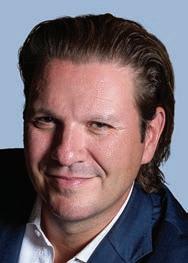
EDITORS’ NOTE Kyle Wool serves as President of Revere Securities, where he oversees Securities and Private Wealth Management which provides integrated strategies designed to help build, manage, and preserve wealth for wealthy families, endowments and foundations. Previously, he was an Executive Director at Morgan Stanley and the head of The Wool Group. Prior to Morgan Stanley, Wool was a Managing Director at Oppenheimer and Co. Inc., and from 2010 to 2013 was based in Hong Kong where he served as a Managing Director of the Professional Investors Group for Oppenheimer Asia Ltd. Wool has been a featured speaker on Executive Services and Wealth Management at the China Entrepreneurs CEO & CFO Forum. He has also been a featured speaker on U.S. Markets and Foreign Direct Investments at the Fujairah U.A.E. International Business Forum. He is active in various philanthropic endeavors both domestically and abroad. He currently serves as a board member of LifeLine NY and the CIRSD (Center for International Relations and Sustainable Development) as well as the Lang Lang International Music Foundation. In 2019, Wool was honored by Crown Princess Katherine with the LifeLine Humanitarian Award.
FIRM BRIEF Revere Securities LLC (reveresecurities.com) is a global broker-dealer firm providing strategic and financial support to institutional investors, hedge funds and individual investors. The firm’s professionals are involved in all components of the sales and trading process and include extensive compliance and operational personnel. In addition, Revere Securities provides differentiated corporate access, helping institutional clients gain access to management as a component of their investment process. The firm has industry focused sales specialists who possess “buy-side” experience and provide a sound, alternate perspective to the investment process.
Will you provide an overview of Revere Securities’ business and how you define the Revere Securities difference?
Revere Securities is a full-service FINRA and SEC licensed global broker-dealer with more than $1B in assets under management
(AUM) across an extensive liquid portfolio, alternative assets, private equity, 15 proprietary SPVs and our own ETF. At the forefront of financial technology, Revere provides the most up-to-date information to our clients as they look to stay current and drive toward their goals.
Headquartered in New York City, Revere has more than 75 professionals in five offices located in New York City; Boca Raton, Florida; West Palm Beach, Florida; Boston, Massachusetts; and Middletown, Ohio. Revere’s domestic and global clients include high-net-worth individuals, family offices and fund managers.
Our firm is a modern-day broker-dealer with a niche in the U.S. emerging growth sector and is, as we often like to say, “FEBE,” For Entrepreneurs, By Entrepreneurs. Many of our clients acquired wealth through entrepreneurial endeavors, and we advise them through the entirety of their personal and companies’ full life cycle, from start-up phase to IPO to post-IPO.
It is with this same entrepreneurial spirit that we create solutions that today’s entrepreneurs and business owners seek to help achieve their lifetime goals. Our approach to wealth management extends far beyond managing an investment portfolio. We are about wealth management as well as wealth creation and, in this, we seek to
provide our clients with opportunities in both the public and private marketplaces that they might not receive anywhere else.
We develop a holistic, comprehensive understanding of who our clients are so we can work with them to determine the optimal investment strategies to help them reach their long-term goals. Revere is committed to building a relationship of trust in which we can work closely with clients to help them define their objectives, explore alternatives, and choose the financial and investment strategies that are most appropriate for them.
Will you highlight Revere Securities’ service offerings and where you see the greatest opportunities for growth for the business?
As a full-service global broker-dealer, Revere provides our clients with strategically balanced portfolios of traditional stocks and bonds and tactically positioned portfolios incorporating Private Equity (PE), 15 Proprietary Special Purpose Vehicles (SPV’s) and the Revere managed and operated Exchange Traded Fund (ETF). Launched last year, our ETF is 11-sector weighted and exemplifies our forward-thinking and creative ideology. It captures the sectors we believe will be the outperformers over the next 6 to 12 months and is adjusted in response to market forces. Ringing the bell at the NYSE last August to celebrate our active ETF was a highlight for all of us at Revere.
NEW YORK NEW YORK
Kyle Wool
POSTED WITH PERMISSION. COPYRIGHT © 2022 LEADERS MAGAZINE, LLC LEADERS203 VOLUME 45, NUMBER 4
“Our firm is a modern-day broker-dealer with a niche in the U.S. emerging growth sector and is, as we often like to say, “FEBE,” For Entrepreneurs, By Entrepreneurs. Many of our clients acquired wealth through entrepreneurial endeavors, and we advise them through the entirety of their personal and companies’ full life cycle, from start-up phase to IPO to post-IPO.”
As we look at our opportunities for growth, we prioritize the client experience and utilize the most elite fintech providers. Our industryleading data aggregation and reporting capabilities enable us to work with our clients to manage wealth holistically to build long-lasting, trusted relationships. Through the use of technology, we are positioned to best take advantage of market conditions and provide our clients with the most up-to-the-minute information they need to mitigate risk and ultimately pursue their goals.
With these capabilities, we aggregate all financial accounts to provide a consolidated view of portfolios, no matter the type of asset class, currency, or entity. Our technology means we can instantly analyze and visualize portfolio data, including liquid and illiquid client portfolios, to quickly create fully customized reports tailored to each of our client’s needs.
You assumed the role of president of Revere Securities in April 2022. What are your priorities in the role and how are you focusing your efforts?
A major priority for me is elevating our position as a firm of entrepreneurs for entrepreneurs while promoting our culture of partnership. By employing innovative, concierge solutions and strategies, I believe we are at the forefront of financial services because we are putting our clients and their interests first. At Revere, I also work to instill a value of partnership into all that we do. I want everyone to feel like they are an integral part of what sets us apart: providing distinguished, innovative services for our clients.
In my role as President, I also consider myself Chief Culture Ambassador. By bringing like-minded industry talent and experts together at Revere, my vision is to reinvent the best of Wall Street from the late ’70s and ’80s when firms were LLPs, comradery was paramount, and client experience was the focus and goal. In doing this, I work every day to lead by example,
never asking of others something that I would not do myself. I seek to serve as a friend and mentor as well as a partner and aspire to foster our firm’s sense of entrepreneurism and partnership that I envision is at the core of what we do.
You also lead Revere’s Private Wealth Management initiatives. Will you discuss this offering and your outlook for Revere’s Private Wealth Management business?
Private Wealth is changing so rapidly, and the cookie-cutter approach of the big banks predicates a certain risk allocation and diversification. But does this fit the next generation investor? The next generation, for example, is buying cryptocurrency and investing in preIPOs. I do think everyone has their own individual circumstances and risk tolerance and there is always an important place for traditional wealth management, but I also feel there is a place for certain individuals to take a portion of their investments, on a risk adjusted basis, and give them the same access to say, a SpaceX or Instacart, which is currently in the pre-IPO stage. At a major bank, this may only be accessible for the ultra-high-net-worth investor, but we see a different future.
Forefront at our client relationships is the ability to customize solutions that are right for our clients, their families, and their businesses. In doing so, we pride ourselves in providing offerings that are most likely not accessible at the large financial institutions. We work with premier partners to deliver an optimized experience while focusing on flexibility and our ability to deliver the best experience to our clients.
How important is it to continue to build the Revere Securities team and will you highlight the talent and expertise at the firm?
For us, talent is key and a major priority of Revere. By next year, estimates suggest there will be more assets under management at RIAs
than the traditional wirehouses. This means that we focus on attracting the kind of talent that wants to be a part of the culture of entrepreneurism and partnership that I so strongly believe in and promote. With multi-generational and multi-national talent, many of us at Revere bring hundreds of decades of experience from the wirehouses and diverse specialties and areas of expertise. In bringing together our unique brand of top talent, we benefit our clients and promote our culture of partnership.
We are especially proud at Revere that many of our top talent are veterans who served our country in the branches of the U.S. military. Supporting veterans’ causes also is a philanthropic priority. For me, I have been a long-standing supporter of nonprofit organizations, especially those focused on children and veterans. At Revere, we infuse this strong commitment to philanthropy in our approach to doing business. Giving back is a core value for us, whether it be through supporting causes or helping our clients realize their personal philanthropic goals and aspirations.
Do you feel that there is effective brand awareness for Revere Securities and is it a focus to build greater brand recognition for Revere?
Relationships are at the center of what we do, and our brand’s foundation is steeped in a commitment to deliver the best offerings for our clients. In nurturing and growing these relationships, I believe our most important asset is our talent. Every day, we as a firm come together, prioritizing talent and development to endeavor to continue to deliver the most optimal solutions for our clients.
Since the 1980s, Revere has been well known on Wall Street. What is especially exciting right now for us is that, in the last 18 months, we have grown leaps and bounds. We have brought in top talent partners, we have embarked on initiatives such as bringing together Capital Markets and IPOs, we have had more than 50 tombstone transactions, and we launched our own ETF. In this effort, we have remained ahead on the digital front, making sure we access data and reporting while promoting our brand through marketing. These efforts elevate the Revere brand of entrepreneurship, partnership, and client-focus.
Did you always know that you were interested in a career in finance and what has made the industry so special for you?
Growing up in Upstate New York by the Finger Lakes, and in college in the late ’90s, I just caught the bug. I started in the industry at the peak of the Nasdaq and have seen the waves of the financial services industry since then. I have always stuck with it, and I like the opportunities and the challenges. But, most of all, especially in my role today, I like the chance to work with clients and our talent at Revere, strategizing and finding today’s optimal solutions. What is most special? I have always wanted to do what I have the opportunity to do today: manage wealth and find unique ways to create it alongside the top talent in the business for valued clients that deserve only the best.•
POSTED WITH PERMISSION. COPYRIGHT © 2022 LEADERS MAGAZINE, LLC LEADERS 204 VOLUME 45, NUMBER 4
“A major priority for me is elevating our position as a firm of entrepreneurs for entrepreneurs while promoting our culture of partnership. By employing innovative, concierge solutions and strategies, I believe we are at the forefront of financial services because we are putting our clients and their interests first.”
Architecture by Richard Meier, Kohn Pedersen Fox, and Rafael Viñoly.



On a new, 2.6-acre park in a dynamic waterfront setting, Waterline Square offers over 100,000 square feet of amenities and includes tennis and squash courts, a soccer pitch, basketball court, a 25m pool, furnished sundecks with outdoor kitchens, creative studios, a skate park, and parking garage. Onsite dining and retail options include Harry’s Table by Cipriani, Empellón Taqueria, and Somm Cellars Wine and Spirits.

Where Midtown Meets the Upper West Side.
One to Four Bedroom Luxury Rental Residences Available Two to Five Bedroom Condominium Residences Available 20-year 421A Tax Abatement Contact us to experience Waterline Square 646 585 0144 | WATERLINESQUARE.COM 30 Riverside BLVD. New York, NY 10069
The Business of Baseball
EDITORS’ NOTE Jean Afterman is in her 21st season as the Yankees’ Assistant General Manager and 11th as Senior Vice President. At the time of her appointment, she became only the third female to hold the position of Assistant General Manager in Major League Baseball history. Afterman has been an integral part of the Yankees’ efforts and operations in Asia. In her first year with the Yankees, she was instrumental in developing the club’s relationship with the Yomiuri Giants of the Japan Central League and signing three-time MVP Hideki Matsui. In 2007, she joined team President Randy Levine and General Manager Brian Cashman on a week-long trip to Asia that concluded with a working agreement with the Chinese Baseball Association. She once again joined Levine and Cashman in 2010, when the Yankees brought the 2009 World Series trophy to Tokyo, Beijing, and Hong Kong. While in Hong Kong, Afterman was given the honor of throwing out one of the ceremonial first pitches at the 2010 Phoenix Cup, an annual international women’s baseball tournament. Her contributions and leadership have been repeatedly recognized throughout her baseball career. She was selected as one of the “50 Most Powerful Women in New York” by the New York Post in 2003 and 2007, and was named one of the 2004 “Power 100” by Sporting News. In 2007, she was profiled as one of Crain’s New York Business’ “100 Most Influential Women in New York Business,” and in 2008, she was noted by Forbes as one of the top female executives in baseball. In 2010, Afterman

was named by WISE (Women in Sports and Events) as one of the “Women of the Year,” and was tabbed by New York Moves magazine as a “Power Woman.”
In 2013, she was again profiled on the front page of her hometown newspaper, the San Francisco Chronicle . In more recent years, Afterman was named one of Street & Smith’s Sports Business Journal’s 2017 “Game Changers,” and her story was featured on the YES Network and ESPN.com. She was named one of Crain’s New York Business’ “2019 Most Notable Women in the Business of Sports,” and was awarded Baseball America’s “2019 Trailblazer of the Year Award,” becoming the inaugural winner of the honor. In 2021, she was again honored when she was recognized by the Sports Business Journal as one of its class of 2021 members of “The Champions: Pioneers and Innovators in Sports Business.” Afterman is a frequent guest speaker on the topics of women in sports and the business of baseball, having participated in events sponsored by Major League Baseball, Columbia Business School, New York University, SABR, Beyond Sport, the Sports Lawyers Association, and WISE, among others. In 2018 and 2019, she was a member of the Steering Committee for the Integrity and Impact Award presented at the BT Sport Industry Awards in London. Afterman joined the Yankees with a diverse business and legal background, focusing on international sports and licensing with an emphasis on U.S.Japan matters. Earlier in her career, she managed her own practice, providing athletic representation and management with a specialization in
arbitration proceedings. From 1994-99, Afterman was General Counsel at KDN Sports, Inc., and handled business and legal affairs for international baseball clients, including Hideo Nomo, Hideki Irabu, Masato Yoshii, Alfonso Soriano, and more than 30 Major and Minor League players. Afterman has maintained an active role in the Bronx community, working closely with P.S. 35, an elementary school within walking distance from Yankee Stadium. For more than a decade, she organized Yankees-sponsored Read-A-Thons and directed a mentoring program which matches Yankees employees with fourth and fifth grade students. Additionally, she worked with high school-aged students through New York City’s Explorers program, which engages young people through career-orientation programs. She received the 2009 “Exploring Leadership Award” for her work with the group. In 2012 and 2013, she served on the Board of Trustees of the Women’s Sports Foundation, and in 2015, she was appointed to serve on the advisory committee that oversees the Commissioner’s Front Office and Field Staff Diversity Pipeline Program. In 2018 and 2019, she served on the Board of Directors of DREAM (formerly Harlem RBI) and in 2020, she joined the Board of the Major League Baseball Players Alumni Association. In 2021, Afterman joined the Board of Beyond Sport. A graduate of the University of California at Berkeley, Afterman was the recipient of the Rosalynn Schneider Eisner Prize and the Mark Goodson Scholarship Grant. She received her JD from the University of San Francisco School of Law. In 2009, she was named “Alumni of the Year” by the Katherine Delmar Burke School in San Francisco.
NEW YORK NEW YORK
Jean Afterman
An Interview with Jean Afterman, Senior Vice President and Assistant General Manager, New York Yankees
POSTED WITH PERMISSION. COPYRIGHT © 2022 LEADERS MAGAZINE, LLC LEADERS 206 VOLUME 45, NUMBER 4
“Leadership, by definition, has to mean that you are either leading people to something, or leading them away from something, so you have to be very clear about what the goal and vision is, and consistent with that as well; hopefully, inspire people to follow you in those goals and that vision.”
Did you always know that you had a passion for the game of baseball and what has made the sport so special for you?
I was always a baseball fan – I spent a lot of time in the bleachers at Candlestick Park in San Francisco as a child. But candidly, no, I did not have a passion for the game of baseball. Growing up, I had a passion for history, for theater, for music and poetry, for acting, for a lot of other non-baseball things, and I still do. When I started working in baseball in 1994 as a player-agent, I developed a passion for the business and the legal aspects of the game of baseball. Don’t get me wrong, I love watching the game of baseball and I am still a fan of the game – I think it is the best sport in the world. One of the things that I love most about our game is that it is a social event; it is a game that you go to with family or friends and you actually connect with people around you. It is a game of strategy, on the field and in the front office, much like chess – if I move my Rook, am I exposing my Bishop? The stratagem involved in keeping and maintaining an effective roster, while also developing young players for the future, requires a lot of thought and preparation – a lot of Rooks and Bishops get moved around.
Will you provide an overview of your role and areas of focus?
I have a dual role as business and legal affairs for Baseball Operations. I am the General Counsel for Baseball Ops, as Brian (Cashman, New York Yankees General Manager) refers to me, and so I cover rules, regulations and compliance for the Major Leagues, Minor Leagues, Player Development, Pro/Amateur/ International Scouting, Contracts (player, employee, vendor), Grievances, Arbitrations, etc. – any legal, quasi-legal, rules or compliance issue that arises out of or affects any part of the baseball side of our organization passes my desk. I am also involved in trade discussions, acquisitions, etc., but not as a talent evaluator. I had been a player-agent and when Brian first hired me in 2001, he told me that he didn’t need or want another scout or talent evaluator – lucky for me, because I am neither – as he already had plenty of those. He wanted me to essentially do the same thing for the Yankees as I had done for my players. I am fortunate to work with an amazing and talented group of people, all passionate about baseball and all passionate about the New York Yankees.
What has made the relationship between you and Brian work so well?
Ah, now that one is hard to define! Mutual respect, honesty, a mutual sense of humor, length of our relationship – we have certainly had tremendous Yankee highs and tremendous Yankee lows – and survived them all. Brian is the best General Manager in sports, one of the most collaborative, and one of the smartest men I know. He has my respect and my loyalty, and frankly, it’s just very intellectually and professionally satisfying to be his Assistant GM – and at this point, after 20+ years, I hope he would say the same about me.
What do you feel are the keys to effective leadership and how do you describe your management style?
Leadership, by definition, has to mean that you are either leading people to something, or leading them away from something, so you have to be very clear about what the goal and vision is, and consistent with that as well; hopefully, inspire people to follow you in those goals and that vision. You have to be consistent in your leadership and management, and you have to be fair and be able to understand the other side, even if you don’t agree with it. My view is that there is no problem that cannot be solved, that words matter. You can also lead by example of course – actions do sometimes speak louder than words. Respect matters, both the giving of it and the earning of it. I think that theme should run through leadership – that respect is something that must be earned, and sustained. I hope that my management style reflects that. When I left Paramount Pictures to go to law school, my boss, Dick Stenta, who was an amazing producer and line producer, told me, “I am going to give you the secret to success: return your phone calls and pay your people.”
I have tried to follow that advice.
Are there strong opportunities for women to grow and lead in professional sports?
Working in professional sports is a matter of brain power, and brain power is gender-blind. It depends on how one defines the word “opportunity.” Can a woman do every job in professional sports? The answer is a resounding YES. But at the moment, no, I don’t think that a woman is presented with or permitted the same opportunities in professional sports as a man. And some professional sports have an appalling record when it comes to its treatment of women once they join the ranks. In recent years, I think that MLB
has done a great job in providing women and diverse candidates with the opportunities that had been denied them in the past. But it’s 2022, and women are still fighting the same – or in some cases, worse – battles for equality in this country and around the world.
You have achieved much success in your professional career. Do you enjoy the process and take moments to appreciate what you have accomplished?
Thank you for the kind words, but I don’t know that I ever thought, or think, of it in those terms. I view it as just do the job and the rest follows. I grew up in a household where boys and girls were treated equally, and my parents instilled in all of us that we had the ability to do anything, so long as we used our minds. Louis Pasteur said that “chance favors the prepared mind” and I have tried to live by this. I have been given amazing opportunities in my career and fortunate to have had people, such as Don Nomura and Brian Cashman, who recognized something in me and believed in me and gave me the chance. It was an honor to represent the players I represented, working with Don. And working for the New York Yankees has been a singular honor and a privilege that I don’t take lightly. I recognize that fortune smiled on me in all of this, and I was prepared.
What advice do you offer to young people interested in building a career in professional sports?
First, remember that chance really does favor the prepared mind, and if you are given your shot, make sure you are ready to take it and excel. Second, education means everything. Many times, women still have to be bigger, better, smarter, and faster than a man to get the same job. Going to law school changed the entire course of my life – it may not be for everyone, but for me, it was a game-changer. And I have said before, and I will say again: the business of sports is not for the faint of heart. It is rough-and-tumble, competitive, and swallows your life. So, you have to understand that going in, and be willing to commit to this life, 365/24/7. During my first spring training with the Yankees, something arose that I was not happy about, and I called my parents, spewing and sputtering. My dad said to me, “Well, this is what happens when you serve Rome – the question is, do you want to serve Rome?” – my father, a classicist, meant ancient Rome. I made the decision that I wanted to serve “Rome,” and
made all the difference for me.•
that has
POSTED WITH PERMISSION. COPYRIGHT © 2022 LEADERS MAGAZINE, LLC LEADERS207 VOLUME 45, NUMBER 4
“Respect matters, both the giving of it and the earning of it. I think that theme should run through leadership – that respect is something that must be earned, and sustained.”
A Trusted Advisor
EDITORS’ NOTE Robert Dilenschneider formed The Dilenschneider Group in 1991. Prior to founding his own firm, he served as President and Chief Executive Officer of Hill and Knowlton from 1986 to 1991, tripling that firm’s revenues to nearly $200 million and delivering more than $30 million in profit. He was with that organization for nearly 25 years after starting his career in public relations in 1967 in New York. Dilenschneider serves as a Trustee of the Institute of International Education, and is a member of the North American Advisory Board of The Michael Smurfit School of University College Dublin. He serves as a judge for The Olin Award, a program of the Olin School of Business at Washington University in St. Louis. He is a member of the Council on Foreign Relations and the Economic Clubs of New York and Chicago and has also served on numerous corporate boards. A former member of the Board of Governors of the American Red Cross, Dilenschneider has served on the advisory board of the Center for Strategic and International Studies, the Board of Governors of the New York Chapter of the National Academy of Television Arts and Sciences, and The Bretton Woods Committee. He is a former member of the U.S.-Japan Business Council and the Florida Council of 100 and is a Knight of Malta. Dilenschneider has authored 16 books including his two latest, Nailing It, which was released in December 2021, and The Public Relations Handbook , which was released in February 2022. He received an MA in journalism from The Ohio State University and a BA from the University of Notre Dame. In 2001, he received an honorary Doctorate of Public Service from Muskingum College, and in 2012 he received an honorary Doctorate of Humane Letters from the University of New Haven.

FIRM BRIEF Headquartered in New York and Chicago, with offices in Miami, The Dilenschneider Group (dilenschneider.com) provides a limited and select few access to the finest communications professionals in the world, with experience in fields ranging from mergers and acquisitions and crisis communications to marketing, government affairs and international media.
Will you highlight the history of The Dilenschneider Group and how the firm has evolved?
We formed The Dilenschneider Group more than 31 years ago because it was clear that the U.S. and the world were taking a different shape. A new way of doing business had to be established. Those driving business, society and politics would have to communicate on a much different and higher plane to be successful. We focused on developing a team of seasoned professionals with at least 20 years of experience who looked ahead and developed different strategies for mergers and acquisitions, marketing, government affairs, and global communications. Our goal was and is to provide a level of counsel, creativity, and exposure to contacts, networks and relationships that can be found nowhere else.
In short, things were changing so much and so fast that we discarded the past and launched into a new era that we revisit every day.
as they can reach. We work with several top executives to reach one or two people to get a result.
Will you provide an overview of The Dilenschneider Group’s capabilities and services?
Our goal is to offer advice and service in the most cost-effective manner possible as we are unburdened by a heavy cost structure and a large staff. We have special offerings for CEOs, CFOs, and top management generally. We know what moves internal staff, how to reach those decision-makers who are important – generally, not many – outside a company, how to understand and penetrate Washington and state capitols. This will be very important following the midterm elections and the run up to the 2024 Presidential race.
How has the role of a communications firm changed and what do you see as the keys to being effective in the industry today?
Communications is now an integral part of top management. It must be embraced, so communicators need to know the company and their client from A to Z, understand the external factors and pressures that are important, and set specific goals that relate to the bottom line.
What advice do you offer to young people interested in a career in communications?
Understand what is happening in the world, constantly read what other more seasoned experts say, know the culture of your organization, and build and feed your own network.
You have spent your career in the communications industry. What has made the work so special for you?
I have been able to participate in the events that have shaped life and society. Additionally, I have been able to meet and work with some of the smartest people out there – and we are just getting started.
What do you see as the keys to effective leadership and how do you describe your management style?
What have been the keys to The Dilenschneider Group’s strength and industry leadership?
One of our hallmarks is the ability to look around corners and see what is coming – not just look at what happened and prepare for it, but to lead it. We use contacts around the world at the highest levels of business, the economy and in politics. Most people still go for as much attention
Let people do what they do best; do not ask them to do what they cannot do – those are keys. My approach is to let people do all they can, and assist if needed.
Did you always know that you had the entrepreneurial spirit and desire to build your own company?
In the beginning, I was terrified, but I soon learned that I could bring a quality of advice and help that people needed and wanted.•
NEW YORK NEW YORK
Robert L. Dilenschneider
An Interview with Robert L. Dilenschneider, Founder and Principal, The Dilenschneider Group, Inc.
POSTED WITH PERMISSION. COPYRIGHT © 2022 LEADERS MAGAZINE, LLC LEADERS 208 VOLUME 45, NUMBER 4
“Our goal was and is to provide a level of counsel, creativity, and exposure to contacts, networks and relationships that can be found nowhere else.”
They said it couldn’t be done. We
We’ve done hard things before, we do them all the time.
For most cancer patients, the usual options are surgery, chemotherapy, or radiation. So we’re working on ways to get the immune system to deploy billions of cancer-killing cells and help more patients survive.
When some people experienced mysterious COVID symptoms and had nowhere to go, our team created the first Center for Post-COVID Care.

It wasn’t that long ago we had to open up your whole chest for heart surgery. Now we’re pioneering a bypass that goes through a few tiny incisions. With this surgery, we can get you back on your feet in weeks instead of months.
So if anyone ever tells you there’s no other way—don’t listen.
didn’t listen.

505 Park Avenue at 59th Street, New York, NY 10022 • 212-838-7500 www.Sherry-Lehmann.com
Thinking Beyond
Interview with Peter Riguardi, Chairman and President, New York Tri-state Region, JLL

EDITORS’ NOTE As Chairman and President of JLL’s New York Tri-state Region, Peter Riguardi leads all operations for the firm in the New York, New Jersey, and Connecticut area. He oversees a team of more than 2,300 professionals in seven offices throughout the Tri-state region. Prior to joining JLL in September 2002, Riguardi was Vice Chairman and Principal of Colliers ABR Inc., a company that he helped form in 1994. He started his real estate career at GVA Williams, where he was the youngest Senior Vice President in the firm’s history. During his extensive career in commercial real estate, he has been actively involved in several of the largest and most noteworthy transactions in the New York Metropolitan area. Riguardi is consistently ranked by the New York Observer as one of New York’s most influential real estate executives.
Peter Riguardi
What have been the keys to JLL’s strength and leadership, and how do you describe the JLL difference?
JLL’s strength lies in its focused goal of Thinking Beyond, a company-wide framework endorsed by our Board of Directors to drive long-term sustainable and profitable global growth, incorporating transformational enhancements to our digital and data capabilities. Our Beyond strategic vision sets ambitious goals for continued enhancements to our comprehensive service offering, attracting new talents and skills to our business, marshalling the best new technology and data analytics, and focusing our teams on truly understanding each client’s broader strategic needs.
values and to our commitments to a sustainable future and building a better tomorrow. This has earned us repeated recognition from organizations such as the Ethisphere Institute, which in February 2018 named JLL as one of the World’s Most Ethical Companies for the 11th consecutive year.
We continue to strengthen and grow awareness of our brand beyond the traditional real estate sector, with a focused goal in our Beyond vision to reach more CEOs and other senior decision-makers.
Our Beyond priorities for clients, people, values, digital, and brand combine to provide an integrated strategic vision and platform for growth.
Will you highlight JLL’s footprint in the Northeast region?
FIRM BRIEF JLL (jll.com) is a leading professional services firm that specializes in real estate and investment management. JLL shapes the future of real estate for a better world by using the most advanced technology to create rewarding opportunities, amazing spaces and sustainable real estate solutions for our clients, our people and our communities. JLL is a Fortune 500 company with annual revenue of $19.4 billion, operations in over 80 countries and a global workforce of more than 102,000 as of June 30, 2022. JLL is the brand name, and a registered trademark, of Jones Lang LaSalle Incorporated.
Directly supporting our goals to constantly enhance our client services, we continually invest in new talent and capabilities, innovation, training, and development. Our people, their skills and aspirations, and their commitment to a consistently high-performance culture and JLL’s core values are central to our ongoing success and sustained growth.
We continue our investment in leadingedge technology and data capabilities. These include specialist technology company acquisitions such as Corrigo, major in-house data-led innovations such as our RED platform, and JLL Spark, a new business focused on creating new property technology products, related strategic investments, and incubating technology startups.
All of our people are committed to the same core values of teamwork, ethics, and excellence. These values are the foundation of our organization. Clients, employees, business partners, and potential recruits are strongly attracted to these
JLL has six corporate offices in the Northeast region, employing over 4,300 people working in brokerage, management, capital markets, debt and equity, industrial, project development, and support services. Focused primarily in New York, New Jersey, and Connecticut, the platform last year completed 49.4 million square feet in leasing transactions and $40 billion in capital markets deals. The company manages 204.1 million square feet of property and serves a leasing agency for 127 million square feet of office and retail space across the region. Our facilities management portfolio encompasses 234.4 million square feet of specialist space.
JLL has established itself as the dominant player in the Northeast industrial market, encompassing 1.8 billion square feet of space in New Jersey, New York, Pennsylvania, Southern Connecticut, and Delaware. Collectively, the 106-person JLL Northeast Industrial team has been involved in some of the nation’s most significant transactions and completed a record-shattering 918 transactions totaling 127 million square feet from 2020 through 2021. The team has grown
NEW YORK NEW YORK
An
POSTED WITH PERMISSION. COPYRIGHT © 2022 LEADERS MAGAZINE, LLC LEADERS211 VOLUME 45, NUMBER 4
“Our Beyond strategic vision sets ambitious goals for continued enhancements to our comprehensive service offering, attracting new talents and skills to our business, marshalling the best new technology and data analytics, and focusing our teams on truly understanding each client’s broader strategic needs.”
this JLL business line to the largest industrial region in the country driving $15.8 billion in real estate transaction volume over the last two years.
What do you see as the state of New York City’s commercial real estate market?
Economic pressures amid high inflation and rising interest rates, coupled with the experimentation of hybrid work, is causing a wave of uncertainty surrounding long-term space requirements. This will drive the need for greater flexibility in lease structures to ease occupiers’ concerns of committing to either a shortage or surplus of office space. Select high-growth companies that rapidly expanded throughout the pandemic will likely scale back on growth plans in the latter half of the year as they brace for potential headwinds. The flightto-quality, mainly within a five-minute walking distance to major transit hubs, will continue to be a key driver of demand.
What are your views on the future of work and the role of the office of the future?
The office remains the center of the work ecosystem to reinforce culture, drive collaboration and innovation, enable professional growth and bring the best brand experience to clients and employees. Workplace models need to transform to accommodate hybrid work because flexibility is not a passing phase. Organizations must prioritize access to high-quality spaces that are attractive to current and future talent and brand differentiating. Organizations must also increase investment in ESG (environmental, social and governance) solutions as environmental and social aspirations are now mainstream.
Sustained investment in smart technologies and data analytics is necessary to propel operational performance and resilience. Decision-makers
must remain open to outsourcing specialist skills and expertise to achieve their strategic objectives, specifically around employee experience, the environment, and technology.
JLL is a leader in market research. Will you discuss the focus and investment that JLL makes in research?
Globally, JLL has more than 450 professionals who analyze commercial real estate at both macro and micro levels. Last year, JLL appointed Ben Breslau to the newly established role of Chief Research Officer tasked with continuing to provide exceptional intelligence and insights on the factors that shape the future of real estate globally. Ben oversees delivery of the firm’s leading research publications and thought leadership to clients and JLL’s experts and has elevated the firm’s industry-leading research capabilities with a focus on advanced analytics, insightful interpretation, and strategic application. Ben leads JLL’s partnership with the MIT Center for Real Estate and the firm’s work with the MIT Real Estate Innovation Lab, which created the MIT Tech Tracker, a web tool to gather, track, define and connect technologies that impact the built environment.
In recent years, JLL has also launched a technology research practice and multiple national research programs and initiatives.
Will you highlight JLL’s commitment to building a diverse and inclusive workforce?
Diversity, Equity and Inclusion (DEI) have always been important to our people, clients, partners and communities. At JLL, we see DEI as a strategic imperative for the way we do business. We’re committed to DEI in every step of our business cycle, from recruiting and onboarding, to proactively identifying and preparing a diverse pipeline of future leaders.
JLL’s U.S. workforce is about 30 percent ethnically diverse, and over 20 percent of the U.S. Management & Leadership Team is ethnically diverse. JLL remains focused on hiring more diverse entry and mid-level talent. JLL’s 2022 U.S. intern class was 40 percent ethnically diverse.
What do you see as the keys to effective leadership and how do you describe your management style?
The key to good leadership is balance, specifically striking the right balance between the company’s focus between long-term strategic choices and short-term marketplace dynamics and then translating that into realistic business strategies. A good leader uses data from diverse sources to solve complex problems and challenges the status quo by thinking “outside the box.” They propose ideas and concepts which advance the organization and fosters an environment where diverse and inclusive thinking is embraced.
I would say I have a decisive management style and push myself and those around me to accomplish objectives and exceed expectations. I believe it is also important to rebound quickly from setbacks and adversity when facing difficult situations.
What advice do you offer to young people hoping to build a sustainable career in the real estate industry?
Firstly, you must have a passion for real estate, but also be able to take ownership and overcome obstacles. Listen to the experts around you, accept their feedback, and adjust your behavior. You never stop learning in real estate and if you want a sustainable career, it’s important to always grab opportunities to increase your knowledge and skills.•
“JLL’s strength lies in its focused goal of Thinking Beyond, a companywide framework endorsed by our Board of Directors to drive longterm sustainable and profitable global growth, incorporating transformational enhancements to our digital and data capabilities.”
POSTED WITH PERMISSION. COPYRIGHT © 2022 LEADERS MAGAZINE, LLC LEADERS 212 VOLUME 45, NUMBER 4
“The office remains the center of the work ecosystem to reinforce culture, drive collaboration and innovation, enable professional growth and bring the best brand experience to clients and employees. Workplace models need to transform to accommodate hybrid work because flexibility is not a passing phase.”

WORLDWIDE LOCATIONS United States, Europe, Middle East, Asia, Latin America The hiring of a lawyer is an important decision and should not be based solely upon advertisements. Before you decide, ask us to send you free written information about our qualifications and our experience. Prior results do not guarantee a similar outcome. Greenberg Traurig is a service mark and trade name of Greenberg Traurig, LLP and Greenberg Traurig, P.A. ©2022 Greenberg Traurig, LLP. Attorneys at Law. All rights reserved. Attorney Advertising. Contact: Richard A. Rosenbaum in New York at 212.801.9200. °These numbers are subject to fluctuation. Images in this advertisement do not depict Greenberg Traurig attorneys, clients, sta or facilities. 37095 GREENBERG TRAURIG, LLP | ATTORNEYS AT LAW | 2500 ATTORNEYS | 43 LOCATIONS WORLDWID E ° GT_Law Greenberg Traurig, LLP GT_Law GreenbergTraurigLLP ONE VANDERBILT AVENUE | NEW YORK, NY 10017 | 212.801.9200 GTLAW.COM BIGLAW REDEFINED:
YOU WIN! IN NEW YORK AND AROUND THE WORLD GUIDING YOUR BUSINESS AT THE SPEED OF CHANGE GT: REDEFINING THE SPEED, BREADTH, AND VALUE OF BIGLAW
Greenberg Traurig is THE go-to firm for today’s go-to markets and industries, your trusted legal advisor for businesses experiencing a world of uncertainties. For over 55 years GT has grown from 3 to almost 3000 attorneys, but one thing remains the same: GT means excellence, unity, diversity, extraordinary value, empowered individuals, rapid and rock solid judgment, and pragmatic strategies with the goal to HELP
Caring for the Community
An Interview with Susan Fox, President and Chief Executive Officer, White Plains Hospital
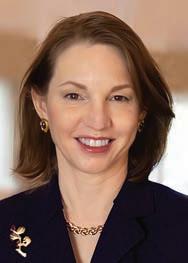
EDITORS’ NOTE Susan Fox has been at the forefront of the healthcare industry transformation regionally over the last decade. Fox first joined the White Plains Hospital team in 2010 as Senior Vice President of Administration, bringing with her more than 25 years of experience in health management administration. In 2011, she was named Executive Vice President, and then President in January 2013. She assumed the position of CEO of the Hospital in May 2015. Fox serves as the Chairperson of the Westchester County Association, serves on the Columbia University School of Nursing Board of Visitors, and the Board of the Healthcare Association of New York State (HANYS). She is a former Chair of the American Hospital Association (AHA) – Regional Policy Board 2 and AHA Board of Trustees member. Fox earned a BSN, Nursing from Columbia University, and an MBA from Baruch College – Mount Sinai School of Medicine.
HOSPITAL BRIEF White Plains Hospital (wphospital.org) is a member of the Montefiore Health System (montefiore.org), serving as its tertiary hub of advanced care in the Hudson Valley. The Hospital is a 292-bed not-for-profit healthcare organization with the primary mission of providing exceptional acute and preventive medical care to all people who live in, work in, or visit Westchester County, New York and its surrounding areas. Centers of Excellence include the Center for Cancer Care and The William & Sylvia Silberstein Neonatal & Maternity Center. The Hospital’s Flanzer Emergency Department is the busiest in Westchester County. White Plains Hospital performs lifesaving emergency and elective angioplasty in its Joan and Alan Herfort, MD, Cardiac Catheterization Laboratory and Marie Promuto Cardiac Catheterization Laboratory and in 2021, the Hospital formally launched its cardiac surgery program with its firstever open-heart surgery in partnership with world-class cardiac surgeons from Montefiore Einstein. White Plains Hospital has outpatient medical facilities across Westchester, including multispecialty practices in Armonk, New Rochelle, Somers and Yorktown Heights; and Scarsdale Medical Group locations in Harrison and Scarsdale.
Will you discuss the history and heritage of White Plains Hospital and how the hospital has evolved?
White Plains Hospital has an incredibly rich history of caring for our community. What began as a fourroom house in 1893 has now grown into one of the most advanced medical centers in New York’s Hudson Valley, with more than 866,000 visits each year to our Hospital and outpatient practices. Over the last decade, we have doubled the number of people seeking care at our Hospital. Our mission has always been to meet the healthcare needs of our community and over the years we have continued to evolve the complexity of our programs and services to meet the needs of patients. In 2011, we established a multispecialty physician network which has grown to more than 320 providers and 43 practices across Westchester County. Today, we are proud to provide our patients with access to the most advanced care, performed by world-class physicians, in the most state-of-the-art medical facilities available. We have become a destination for comprehensive cardiac care in the Hudson Valley – with two cardiac catheterization labs, an outstanding electrophysiology program and a recently launched cardiac surgery program, one of only two in Westchester County. Soon, we will be performing thrombectomies – the most advanced stroke treatment currently
available – in our new hybrid OR, featuring the latest biplane angiography technology. The transformation of our Hospital in terms of both its programs and facilities has been astounding, especially over the past decade. In 2021, the Hospital opened a new nine-story, 252,000 square foot outpatient facility with six operating rooms, multiple procedure suites, advanced imaging, including the only PET/MRI outside of New York City, hyperbaric chambers for wound care, and specialty physician offices.
How do you define White Plains Hospital’s culture and values?
I believe we have a very special culture at White Plains Hospital. It is a culture of excellence that is centered around teamwork and collaboration with the patient at the center of all we do. As an organization we are laser-focused on quality and patient experience, we track metrics to monitor our goals and relentlessly communicate to ensure staff at every level of the organization understand the role they play in helping us achieve our goals. Everything we do is guided by our commitment to delivering the highest quality care to our patients. This summer we received a 5-Star designation for quality from the Centers for Medicare and Medicaid Services (CMS), one of only 8 hospitals in New York State to receive that rating, and were the only hospital in Westchester County to be awarded the highest safety grade of “A” from the Leapfrog Group for seven consecutive periods. The dedication, care, and compassion
NEW YORK NEW YORK
Susan Fox
POSTED WITH PERMISSION. COPYRIGHT © 2022 LEADERS MAGAZINE, LLC LEADERS 214 VOLUME 45, NUMBER 4
“Our mission has always been to meet the healthcare needs of our community and over the years we have continued to evolve the complexity of our programs and services to meet the needs of patients.”
that our staff bring to work each day is a point of pride for me and the entire leadership team. Our leaders throughout the organization naturally seek the highest goals to ensure our patients will always get the highest quality care.
Will you highlight the relationship between White Plains Hospital and Montefiore and what has made this relationship so effective?
We were fortunate to partner with the Montefiore Health System in 2015. We share a unique vision to bring advanced care to local communities and since then we have successfully partnered to bring an array of complex programs and procedures to the world-class facilities at White Plains Hospital. As an example, when we launched our cardiac surgery program it was in conjunction with the distinguished surgeons from Montefiore and later this year we will once again be partnering with Montefiore physicians and surgeons to begin performing complex neurointerventional procedures at our Hospital. We also work very closely together on a variety of other programs to ensure our patients have the access to the tremendous resources and treatments that a health system has to offer close to home. If a patient does need a higher level of care, we ensure care is coordinated with the clinical team at Montefiore Medical Center to make the process seamless for patients.
How critical is it for White Plains Hospital to build a diverse and inclusive workforce to mirror the diversity of its patients and communities?

We take pride in the diversity of our workforce. Our employees represent a varied collection of talent, backgrounds, and life experiences. We realize that each employee’s unique experiences, perspectives, and viewpoints add value to our ability to create an exceptional culture and ultimately deliver the best care to our patients. We have strong Diversity, Equity and Inclusion initiatives and this year earned a “Top Performer” rating in the Human Rights Campaign Foundation’s 2022 LGBTQ+ Healthcare Equality Index. We live and work in a diverse community and it is essential that we do everything we can to understand the
specific needs of our neighbors and always deliver high-quality, compassionate care.
Our employees represent the various communities we serve. In fact, more than 60 percent of our employees live in Westchester County, which is a large part of the area we serve. To have neighbors taking care of neighbors is very powerful.
Do you feel that there are strong opportunities for women to grow and lead in the industry?
We need to advocate for more female leaders in healthcare. Our Hospital was started by 22 women and 3 men more than 125 years
ago. Women have always played an important role in advancing healthcare across the globe, yet only 15 percent of healthcare CEOs are women according to a recent JAMA study. At White Plains Hospital, 74 percent of our 4,000 employees are women and 70 percent of positions at the management level and higher are also filled by women.
What advice do you offer to young people interested in a career in healthcare?
I recently gave a commencement address to Mercy College School of Health and Natural Science graduates with a theme of “healthcare needs you.” The shortage of qualified and trained healthcare professionals in New York and across the nation is an ongoing problem that has been exacerbated by the COVID-19 pandemic. By 2030, it is predicted that there will be a shortage of more than 39,000 registered nurses in New York and the State is estimated to fall short of 500,000 total healthcare workers as early as 2026.
In addition to the practical assurance that there will always be jobs for qualified individuals, I cannot think of a more gratifying career than working in healthcare. Day in and day out you are making a difference in someone’s life. Whether you choose to work in the clinical areas or administration, there are many opportunities to try new things and advance one’s career. Those of us who are veterans in this industry know how important it is to cultivate the next generation of leaders who will continue to innovate new approaches to patient care and break new ground in medicine, science, education, and public health.•
White Plains Hospital
POSTED WITH PERMISSION. COPYRIGHT © 2022 LEADERS MAGAZINE, LLC LEADERS215 VOLUME 45, NUMBER 4
“We were fortunate to partner with the Montefiore Health System in 2015. We share a unique vision to bring advanced care to local communities and since then we have successfully partnered to bring an array of complex programs and procedures to the world-class facilities at White Plains Hospital.”
Communities of Opportunity
EDITORS’ NOTE Jonathan Rose’s business, public policy, teaching, research, writing, and not-forprofit work focuses on creating more environmentally, socially, and economically resilient cities. In 1989, Rose founded Jonathan Rose Companies, a multi-disciplinary real estate development and investment firm, to address the challenges of declining ecologies and the poor distribution of opportunity through the development of green affordable and mixed-income housing. The firm’s innovative work has won awards from a wide range of notable organizations including the Urban Land Institute, the National Trust for Historic Preservation, the Natural Resources Defense Council, the American Planning Association, and the American Institute of Architects. Rose was selected as the winner of the 2021 ULI Prize for Visionaries in Urban Development. He also advises global cities on planning, affordable housing, environmental, and social issues. He chairs the Bhutan Urban and Regional Planning Global Advisory Committee. Rose’s book on how to create resilient cities, The Well-Tempered City: What Modern Science, Ancient Civilizations and Human Nature Teach Us About the Future of Urban Life, was published by Harper Wave in 2016, and won the 2017 PROSE Award for Outstanding Scholarly Work by a Trade Publisher. Rose has been the subject of three Harvard Business School cases. He frequently lectures at graduate schools of business, environment, and architecture on the future of cities, affordable housing community development, the environment, and regenerative business. In 2015, he held the Yale School of Architecture’s Edward P. Bass Distinguished Visiting Architectural Fellowship. Rose was appointed an Executive in Residence at the Saïd Business School 2021-2022, focusing on his work on regenerative business and regenerative economies. He has testified before U.S. Senate and House Committees on housing, infrastructure, and environmental issues, and served as an Advisor to the White House Office of Urban Affairs. He serves on the Second District Advisory Council of the Federal Reserve Bank of New York. He is a Trustee of Enterprise Community Partners and The Capital Institute. He and his wife, Diana Calthorpe Rose, are the co-founders of the Garrison Institute and he serves as Chair on
its Board. The Institute connects inner transformation with outer solutions to relieve suffering in the fields of trauma, education, and the environment. He is an Honorary Member of the American Institute of Architects and Honorary Trustee of the American Museum of Natural History, Jazz at Lincoln Center, and Brooklyn Academy of Music. He is also a member of the Council on Foreign Relations. Rose chaired the Metropolitan Transit Authority’s Blue Ribbon Sustainability Commission which developed the nation’s first green transit plan, and was a commissioner on the NYS 2100 Commission tasked with identifying strategies for the long-term resilience of New York State’s infrastructure post-Hurricane Sandy. Rose graduated from Yale University in 1974 with a BA in psychology and philosophy, received a master’s degree in regional planning from the University of Pennsylvania in 1980, and has an Honorary Doctorate from the New School.

COMPANY BRIEF Jonathan Rose Companies LLC (rosecompanies.com) is one of the country’s leading developers and investors in sustainable, affordable, and mixed-income multifamily real estate, with more than 18,000 units owned or managed. Founded in 1989, Jonathan Rose Companies is a mission-driven company focused on enhancing the health and wellness of its residents with green, energy efficient property improvements and through its Communities of Opportunities programming. With offices in New York, Connecticut, Colorado, Ohio and California, Jonathan Rose Companies has developed or acquired more than $3.4 billion of real estate.
What was your vision for creating Jonathan Rose Companies and how has the company evolved?
Jonathan Rose Companies was founded in 1989 as a mission focused for profit. At the time, I was a member of the Social Venture Network, inspired by amazing founders such as Ben Cohen and Jerry Greenfield of Ben and Jerry’s, Anita and Gordon Roderick of the Body Shop, John Macke of Whole Foods, Gary Hirshberg of Stonyfield Yogurt, and others. I felt if they could reimagine food and beauty companies, I should be able to reimagine what a real estate company could be. During this time, development in the U.S. was rapidly suburbanizing, and its cities were struggling. The company was launched to focus on urban regeneration, to develop affordable and mixed income housing, to advance green building, and to help grow the cultural life of cities. We were one of the very first real estate companies committed to making this work environmentally responsible.
We now have three main areas of activity –we develop new affordable and mixed income communities; we buy and preserve existing affordable housing; and we do deep renovations of affordable housing in need of rehabilitation. We are a national firm, working in 14 states. All of our work is quite green, and we bring social, health, and educational opportunities to our residents.
How do you define Jonathan Rose Companies’ purpose and mission?
The United States was long considered the land of opportunity – and yet that opportunity is not well distributed. Millions of low-income families across the country live in communities that are disconnected from quality schools and jobs, healthcare, and healthy food, and are underserved due to their financial status and ZIP Code. Research
NEW YORK NEW YORK
Jonathan F.P. Rose
An Interview with Jonathan
F.P. Rose, President, Jonathan Rose Companies
POSTED WITH PERMISSION. COPYRIGHT © 2022 LEADERS MAGAZINE, LLC LEADERS 216 VOLUME 45, NUMBER 4
“Our goal is to enhance connections between people, creating pathways to opportunity and improving the health of our residents.”
shows the detrimental and long-term effects that poor housing and neighborhood conditions can have on an individual’s health, education, and employment.
Our mission is to address the problem of inequality by creating Communities of Opportunity. Every investment we make creates, deepens, or extends housing affordability for the long-term to serve low-income and working-class households in markets most vulnerable to rising rents. We strive to connect low-income communities with fundamental necessities, such as healthy-living, food security, safety, transportation, and arts and culture, so that they can become empowered partners in the transformation of their own neighborhoods.
Exacerbating the already fragile conditions within these communities are the effects of climate change. We meet this challenge by reducing the climate impact of our portfolio while creating resilient, future-proof properties.
Our investment strategy recognizes that the least carbon-intensive solution to the affordable housing crisis in the United States is to preserve the existing affordable housing stock. Renovating existing buildings avoids the bulk of the embodied carbon associated with new construction while we transform the properties to reduce operational carbon emissions, conserve water, improve occupant health, and myriad green improvements. And we are prioritizing human health through our Communities of Opportunity program.
What have been the keys to Jonathan Rose Companies’ growth and strength in the industry?
First, we are very good at what we do, completing projects on time and on budget. All of our projects are partnerships – we partner with city, state, and federal agencies to get this work done, as well as investors and other for-profit firms. We are very good partners. We have been very innovative in approaching complex problems, we are
committed to design excellence, and our mission is at the very core of our corporate DNA. And we are authentic – for example, we were authentically and visibly committed to green building long before the rest of the industry. These qualities provided the foundation of our reputation for excellence with mission. Everything grew from that.
How critical is it for Jonathan Rose Companies to build a diverse and inclusive workforce?
We are committed to growing a diverse, equitable workforce at many levels. We have formed an antiracism task group and are moving ambitiously to increase the diversity of our workforce at all levels. This work includes very direct goals and keeping ourselves accountable. For example, we commit to making sure that every hiring slate is diverse, and we track our outcomes. We also work to make sure our partners share our commitment to DEI, and ask our suppliers about their diversity work.
In addition to this, we believe that our “product” – affordable and mixed income housing –helps advance equity and diversity in the communities in which we work. The lack of affordable housing has become a key factor limiting the economic growth and quality of life in cities around the country. Our work, and the work of other firms like ours, is essential if we want all families to thrive.
What do you see as Jonathan Rose Companies’ responsibility to the communities it serves?
We have advanced a holistic approach to affordable housing called Communities of Opportunity. Each community we own, whether we build or buy it, includes interventions and amenities that set residents on the path to wellbeing, such as health exam rooms, fitness centers, community gardens, facilities, computer labs, communal kitchens, libraries, and on-site resident
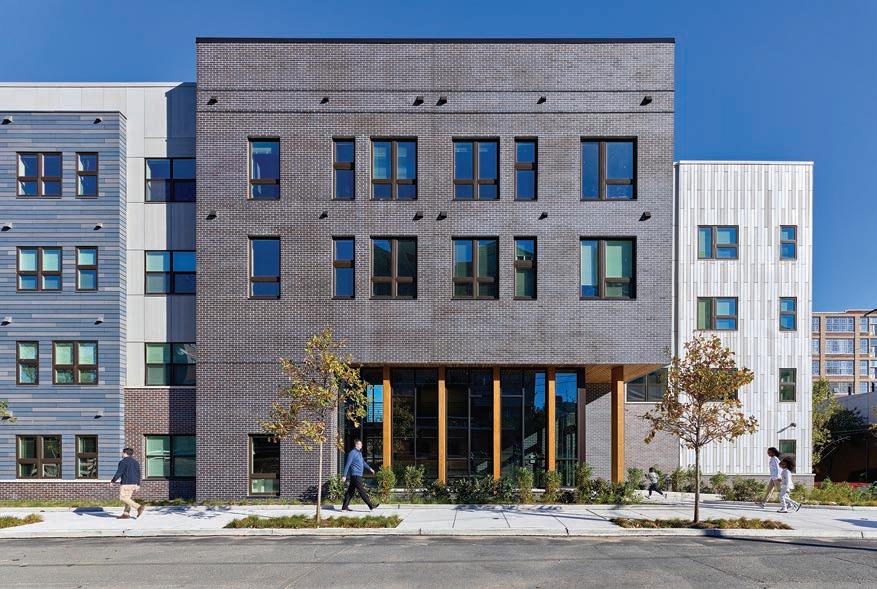
services coordinators who connect residents to programs and services that meet needs and enable access to opportunity.
Our goal is to enhance connections between people, creating pathways to opportunity and improving the health of our residents. At the same time, we have a broader responsibility to the community of life on earth to reduce our energy use and climate impacts, and also our use of water and toxic materials.
What do you feel are the keys to effective leadership and how do you describe your management style?
Effective leadership requires vision and being effective at translating vision into action. I have also learned that it requires understanding organizations and their behaviors. To achieve that, I have had to learn a lot about humans and their behaviors.
My management goal is “Excellence with Kindness.” Some consider compassion to be the antithesis of rigor – my goal is to bring rigor and compassion together.
Did you always know that you had an entrepreneurial spirit and desire to build your own business?
I grew up in a wonderful family that was very entrepreneurial and very philanthropic. My father and uncles have made significant contributions to New York City through their vision, generosity, and capabilities. They felt that their work should be honorable, but that their impact would be through their not-for-profit life.
I started my career in my family’s New York City multifamily real estate firm and volunteered as a board member of The Educational Alliance, a Lower East Side-based not-for-profit, helping them build housing for homeless seniors, drug treatment centers, day care, early childhood education centers, and more. As my career progressed, I wanted to bring the for-profit and not-for-profit streams of my life together.
1989 was a time of economic recession. Financing was scarce and real estate values were dropping. It was a good time to enter the market because there was little competition, and many other developers were struggling with too much debt and too few lenders. But in the quietude of the markets, it was also a time of rebirth.
I founded the company as a mission-focused, for-profit real estate company. Our aim was, and remains, to create model projects with environmental and social responsibility at their core, working in transit accessible locations, planning and developing affordable and mixed income housing, accompanied by a mix of uses that enhance the fabric of its communities. We set out to build, buy and renovate projects with substantial components of affordable and mixed income housing. We would be national in scope, and model what today we call impact investing.
What advice do you offer young people interested in building a career in real estate?
Start working for firms that are committed to excellence, and build your skills. At the same time, volunteer for a not-for-profit. It’s a great way to grow leadership skills. And these days, at some point, getting a master’s degree in real estate is very valuable.•
POSTED WITH PERMISSION. COPYRIGHT © 2022 LEADERS MAGAZINE, LLC LEADERS217 VOLUME 45, NUMBER 4
NC Five in North Philadelphia
Safety, Security, and Flawless Execution
EDITORS’ NOTE James Chitty has been in the field of aviation for over a decade. Chitty recognized the need for a new approach to private jet charter and founded PlaneClear, a private aviation charter company, in 2008. He had designed a program that offered access to what was traditionally kept under wraps by other charter companies: pilot hours, aircraft age, maintenance schedules, and third-party auditor ratings. In October 2016, PlaneClear merged with Apollo Jets, a partnership that bonded the two forward-thinking companies looking to stay ahead of the curve. As one company, they are committed to delivering innovation to their clients and simplifying their travel. In July 2018, Apollo Jets acquired Talon Air LLC, a Farmingdale NY (FRG) based fullservice management company and repair station. Chitty immediately assumed the role of CEO and continues to run the day-to-day business. Since the acquisition, the fleet has grown to 40+ aircraft ranging from the Hawker 800XP up to the Gulfstream 550. Chitty has also served as Vice President and Chief Operating Officer of Liberty Equities of America and led retail sales for many years in the finance industry. He completed his studies at the State University of New York College at Cortland.
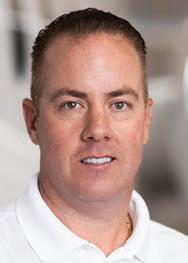
Talon Air was founded in 1999 by an aircraft owner and charter client seeking an alternative to cookie-cutter aircraft charter options. Talon’s founder, an airplane owner himself, recognized the need for a true “customer service first” approach. At the time, the industry was run by aviation professionals who lacked the forward-looking perspective of the airplane owners and charter clients they service. Talon started as a regional player based in Long Island at Republic Airport in Farmingdale, New York. We specialized in servicing the affluent clientele of the Gold Coast. Over time, Talon’s footprint grew with remote locations at additional airports across the country, including places such as South Florida; Vail, Colorado; and Scottsdale, Arizona.
In March 2017, one of the largest charter brokers in the country, Apollo Jets, recognized the need to further enhance their clients’
experience by controlling a fleet. Talon had grown substantially since 1999 and had added a full-service FAA approved Part 145 Repair Station with robust capabilities. Its headquarters in FRG had grown to two large hangars with ample office space to serve as its dispatch and 24/7 operations center. In addition, they had a young fleet made up mostly of mid- and supermid-size jets. This was the pedigree Apollo Jets was looking for.
In July 2018, Apollo closed its transaction and continued to expand the business. Although Apollo and Talon operate as separate businesses, they are sister companies with Talon serving as the wholesale arm and Apollo as the retail arm. I am proud to say that when we arrived, Talon Air had less than 40 full-time pilots; today’s figure hovers around 125. The fleet we acquired consisted of 17 airplanes. Today, even with
the pandemic, our fleet has grown to 44 managed aircraft including 18 heavy jets (several Gulfstreams, Globals, and Falcons). We are consistently top 15 annually in hours flown. We are projecting to add 10-13 aircraft to our managed fleet by 2023.

The secret to our success is our continued boutique approach to customer service. Our airplane owners have direct access to our leadership team. Our current customers are our biggest referral source for not only charter clients, but also managed aircraft.
In April 2021, we were acquired by the largest on demand provider in the world, Vista Global Holding. Although Talon will continue to operate independently, we leverage the buying power of our group of companies –VistaJet and XO – and Vista’s operating partners – XOJET Aviation, GMJ Air Shuttle, Red Wing Aviation, Western Air Charter, JetSelect, and, of course, Talon Air – to provide significant cost savings to our clients with items
NEW YORK NEW YORK
Will you provide an overview of Talon Air and what have been the keys to the strength of the company?
James Chitty
An Interview with James Chitty, Chief Executive Officer, Talon Air
POSTED WITH PERMISSION. COPYRIGHT © 2022 LEADERS MAGAZINE, LLC LEADERS 218 VOLUME 45, NUMBER 4
Gulfstream IV-SP
such as fuel costs, insurance, training, labor rates, etc. Perhaps even more important than the savings are preferred training slots, the group buying power for parts, negotiated maintenance slots, and preferred terms with all the large vendors.
Talon is well-positioned to continue our strategic growth while retaining its commitment and partnership with our airplane owners.
How do you describe the Talon Air experience?
The Talon Air experience focuses on safety, security, and flawless execution. Whether you are a charter customer and have meetings in three cities on the same day or you want to surprise your family with a last-minute vacation, Talon Air will deliver an unmatched private jet charter experience. If you are an airplane owner looking for management and maintenance services, you will always have direct access to our leadership team and actual decision-makers, not to a customer service desk. We anticipate our clients’ needs and pay careful attention to every detail of their flight. Our mission is to provide the safest, most thoughtful, and professional private jet charter service available.
Talon Air offers jet aircraft management services for both Part 135 and Part 91 aircraft. Our aviation professionals handle all your flight planning, scheduling, and trip details. We provide full accounting, maintenance, operations, and human resources support for each owner to ensure that you maximize the value of your investment and your time. Our goal is to structure a private jet management program to safeguard you and your asset while enhancing the benefits of aircraft ownership.
Will you discuss the Talon Air fleet offerings?
Talon Air currently manages 44 aircraft and experienced over 100 percent fleet growth from 2017 to 2022. Our managed fleet ranges
from turbo-prop King Air 200 all the way up to the ultra-long-range Gulfstream 550 and Global 6000 aircraft. In 2020, our team launched a sales and acquisition department that truly allows us to grow with our clients, from charter customers to full airplane owners. We believe this approach truly aligns our interest and creates a partnership between the airplane owner and the management company.

How did Talon Air adapt the way it works to address the challenges caused by the global pandemic?
The pandemic brought a whole new segment of flyers into our space. We have
always been a customer service first business, but now there is a whole new health and safety aspect to our business that has taken precedence. Talon has and always will follow the guidance of the Centers for Disease Control and Prevention (CDC), U.S. Department of State, and the World Health Organization (WHO). Our team also closely monitors any travel restrictions. Our client assurance team reviews domestic and international travel mandates on a daily basis to ensure compliance with evolving requirements.
Talon Air places a priority on safety. Will you highlight Talon Air’s commitment to safety, and do you feel that this is a differentiator for the company?
Many preach a safety-first approach, but we believe that to have a true safety culture you must invest in your team. We continue to enhance the processes in place to report, track and mitigate prospective challenges. Talon Air is proud to claim the highest independent, industryrecognized safety ratings of ARG/US Platinum, Wyvern Wingman, and IS-BAO III Certification. Talon has also passed rigorous EASA audit standards and is authorized to conduct operations throughout Europe. Additionally, Talon Air’s Safety Management System (SMS) has been accepted into the FAA’s SMS Voluntary Program since 2017 (one of the first in the country). The program is documented in the SMS Manual and uses ARGUS/PRISM for its Safety Database, Risk Management, Safety, Injury/Workman’s Comp and Hazard reporting.

Is it important for Talon Air to provide travel-related services to its clients when on the ground?
Absolutely. We understand that time is precious, and we aim to provide elevated service by coordinating all aspects of a client’s travel before, during and after their flight. Most companies in our space will set up ground
Interior of a Gulfstream V
POSTED WITH PERMISSION. COPYRIGHT © 2022 LEADERS MAGAZINE, LLC LEADERS219 VOLUME 45, NUMBER 4
Interior of a Gulfstream IV
transportation, luxury car rentals, catering, and lodging. To us, that’s a given. Our true value is getting ahead of potential issues. We routinely work with our handling teams to acquire landing permits in challenging locations and set up departure and arrival slots. This is where the experience of a truly global operator shows, having the reach and leverage to ask the right questions to the right partners to ensure a seamless trip. Our team handles all of the client’s trip logistics, from start to finish.
What do you see as the keys to effective leadership and how do you describe your management style?
It seems like transparency is a very popular word as of late, but it’s something I believe in and has been a focal point of my management style for many years. Even in a leadership role, it’s okay to not always have all the answers. Our team and people respect the person who has to dig a little deeper and circle back, as long as you are upfront and transparent. This has never been more evident than in the past few years when we all were navigating and experiencing unprecedented situations. It’s important for any leader to be clear and direct, even if that means not having an immediate solution.
What are your priorities for Talon Air as you look to the future?
We want to continue the fleet growth trajectory we have had since 2017, but more importantly we want to enhance the
airplane owner experience from their first interaction with Talon Air. Whether you’re a client looking into buying a plane for the first time or an experienced airplane owner looking for professional management, we want Talon to always provide the most value to the entire process.

The only way to do this is to continue to invest in our team. We continue to work to retain and, when necessary, recruit and train the smartest aviation professionals in the world. This will sound cliché, but with airplane management it truly “takes a village.” Our priority is to continue growing our village to the best in the world.•
 Hawker 4000
Hawker 4000
POSTED WITH PERMISSION. COPYRIGHT © 2022 LEADERS MAGAZINE, LLC LEADERS 220 VOLUME 45, NUMBER 4
Interior of a Hawker 4000

Defining Entrepreneurship
An Interview with Michael Loeb, President and Chief Executive Officer, Loeb.nyc
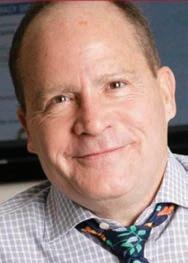
EDITORS’ NOTE After starting his career at Time Inc., Michael Loeb co-founded the Synapse Group with then partner, Jay Walker. Under Loeb’s direction, Synapse grew to become the largest seller and servicer of consumer magazine subscriptions worldwide, with its revolutionary and patented Continuous Service Model. Loeb and Walker went on to form and incubate Priceline.com at Synapse, leveraging a shared team of operators and capital. When Synapse Group was sold to Time Warner in 2006, Loeb formed Loeb Enterprises with partner, Rich Vogel, to ideate and develop new business concepts. Today, Loeb.nyc is building and managing a portfolio of over 20 curated companies, some of which are domiciled at Loeb headquarters in Manhattan and half of which are executions of Loeb concepts. Under Loeb’s leadership, Loeb.nyc has established a new model for startups, and by pairing exceptional strategic and executional talent in a “shared services” model with passionate founders, plus capital, they meaningfully improve success rates.
COMPANY BRIEF Loeb.nyc (loeb.nyc) is a unique “ideas-to-execution-to-exits model” that is self-funded with self-generating ideas for start-ups. It lays claim to five unicorns thus far and has a portfolio of over 20 companies in its venture collective.
Will you discuss your entrepreneurial journey?
It started when I got fired. I followed my father into Time Inc. – my dad was a renowned journalist – and I joined on the business side. After I left, I started a company that I had been trying to start inside of Time Inc. – “Synapse.”
It became a platform for all magazines to replace paper renewals and bills with credit card payments. At our peak, we were servicing 70 million subscriptions, about one sixth of the then installed base. Nine years after our founding, we decided to bring the company public. That year was 2000 – an interesting time for an IPO.
Synapse had two advantages: We were making money and with “continuous service” we could accurately forecast future sales. As we were fueling the jets for the roadshow, my former employer, Time Inc., made me an offer
I couldn’t refuse, which is why my wife labelled me the most expensive rehire in business history; hyperbole to be sure. The deal included a multi-year earnout which brings us to 2006.
How did you decide after Synapse what you wanted to do next?
I did have a decision to make and felt that I had more in the tank. One of the most gratifying things for me is mentoring young people who work at our company and at the helm of some of our startups. It is spectacular to be able to coach and to develop ideas. I have the privilege to work with people half my age who are twice as smart. I learn something new every day.
The inspiration for Loeb.nyc stemmed from Synapse, where we concurrently incubated Priceline, an inspiration of my co-founder, Jay Walker. It was an experiment that worked: a single layer of overhead supporting multiple companies. That is what we have at Loeb.nyc today.
I compare Loeb.nyc to a tootsie pop. The chocolate center are the over 20 companies that we are building. Half of these are internally generated and half are outside inspirations. The tootsie pop’s hard candy shell is our shared services which is a Swiss Army knife of all the shovel-ready know-how that all new companies need to scale. This includes a full spectrum of services – back-office accounting, research, recruiting, strategy, tech, marketing – moreover, everything a start-up needs. We don’t get involved in any company unless we feel we will be the difference maker.
When you look at entrepreneurship, do you feel that this is a skill that can be taught or is it something a person is born with?
I always ask an “entrepreneur” to tell me about their lemonade stand when they were a kid. If they say that they never had a lemonade stand, I ask them to tell me about their newspaper route. Then I ask them what they did do to make money, and if the answer is “nothing,” I’m not talking to an entrepreneur. Moreover, entrepreneurs are born. An entrepreneur doesn’t believe in the rules; they believe that all the other people following the rules create a road less travelled, and that road spells opportunity.
Do you feel that entrepreneurs can also be good operators or are these different skill sets?
The individual who wants to be an entrepreneur but didn’t have a lemonade stand is your operator, and they are crucial to the success of the business. At Loeb.nyc, I am blessed to be working with Rich Vogel for the last 30+ years. Rich is an operator’s operator. As we learned from the film Cool Hand Luke, “a man’s got to know his limitations.” Entrepreneurs who know how to operate at a high level are rare. They should stick to their inspired thoughts.
As an entrepreneur, are you able to enjoy the process and celebrate the wins or are you always focused on what is next?
I wish I was better at being in the moment. The victories are savored in a flash, but interestingly it is not about the check that comes in. It is the satisfaction of knowing that you built something no one else thought of, something important that is going to improve lives. The enjoyment for me is having conversations with other entrepreneurs and it is not only talking about our successes, but also about our failures which are really just lessons and learning experiences. Thomas Edison said, “I have not failed. I’ve simply found 10,000 ways how not to make a lightbulb.” Learning what doesn’t work is collateral to the entrepreneurial process; mourning the dead is not.
You devote your time and resources to philanthropy. Do you see this as a responsibility and will you highlight this effort?
I think of myself as inexplicably lucky. To not pay it back would be an affront to the entrepreneurial Gods. One example is the LockStep fund – my only fund – that I co-sponsored with Bonin Bough. In the wake of the killing of George Floyd, seeing my country being torn apart, I called my friend, Bonin, who is a man of color, and asked him what we can do to make a difference. We decided to create Lockstep which is a venture fund with a mission to empower systemic change by helping Black entrepreneurs. There were two statistics that were our wake up calls. First was the delta between White and Black families with respect to net worth which is a 10:1 ratio. The other is the anemic percentage of funding that goes to Black founders from venture capitalists. We decided to launch a fund that only invested in Black-founded businesses. We are finding companies that are extraordinarily mature and have encountered some great opportunities – so a case of doing well by doing good.•
NEW YORK NEW YORK
POSTED WITH PERMISSION. COPYRIGHT © 2022 LEADERS MAGAZINE, LLC LEADERS 222 VOLUME 45, NUMBER 4
Michael Loeb

People and Ethics
Interview with David Amsterdam, President – U.S. Capital Markets and Northeast Region, Colliers

EDITORS’ NOTE David Amsterdam is President – U.S. Capital Markets and Northeast Region, and is responsible for managing and executing investment sales, debt and equity, and structured finance transactions across the U.S. and in critical global markets. In addition, he leads the firm across all service lines in top-tier cities, including New York, Boston and Washington, DC. Prior to joining Colliers, Amsterdam served as Partner of Perave Capital, a fully integrated real estate investment and advisory firm. He has previously held leadership positions at some of the most notable real estate firms in the world, including Cushman & Wakefield and SL Green Realty Corp. Amsterdam was named to Crain’s New York Business 40 Under 40, an annual honor reserved for the most influential New York professionals, and in 2018, 2019, 2020 and 2021 he was named to the Commercial Observer Power 100 list. In 2019, he was named a national “Influencer in Real Estate Finance” and selected as a “Best Boss in the Business” by Real Estate Forum which also named him to its “50 Under 40” list in 2018. Amsterdam has also been named a “Rising Star” by Real Estate Weekly and was a Real Estate Board of New York nominee for “Most Promising Commercial Salesperson.” He is a member of the Board of Directors of Friends of Hudson River Park and The First Tee. He is a member of the Real Estate Advisory Board of Syracuse University and has been active in numerous charitable organizations. Amsterdam holds a BA from Syracuse University.
COMPANY BRIEF Colliers (colliers.com) is a leading diversified professional services and investment management company. With operations in 63 countries, its more than 17,000 enterprising professionals work collaboratively to provide expert real estate and investment advice to its clients. For more than 27 years, its experienced leadership with significant insider ownership has delivered compound annual investment returns of 20 percent for shareholders. With annualized revenues of $4.5 billion and $81 billion of assets under management, the company maximizes the potential of property and real assts to accelerate the success of its clients, investors, and people.
What have been the keys to Colliers’ strength and leadership, and how do you describe the Colliers difference?
Colliers’ enterprising culture has always set us apart. Our decentralized leadership style gives us a competitive advantage and empowers our professionals by prioritizing people and ethics first. While other firms operate in siloed environments, our team works closely with colleagues across industries and geographies, relying on the expertise of our analytics, research, and workplace strategy teams to accelerate success for our clients.
In addition, we embrace change and pivot to a new approach when necessary to achieve optimal results. We encourage our professionals to think differently, be entrepreneurial, and develop and collaborate on innovative ideas that always put our clients at the forefront.
and ownership structures for public, private, domestic, and foreign capital.
I lead our Capital Markets platform in the U.S., which includes our investment sales, debt and equity, and structured finance teams. Our elite team of seasoned real estate investment professionals stretches across more than 100 markets nationwide and works together to exceed expectations on every assignment. As a result, our market share has doubled since 2018, and our combined investment sales and debt and equity volume in 2021 was a record $51.4 billion.
Will you highlight Colliers’ footprint in the Northeast region?
I oversee nine offices along the Northeast corridor, leading our service lines in some of America’s greatest cities, including New York, Boston, Washington, DC, and the broader metropolitan and suburban areas surrounding them. Composed of more than 550 talented professionals, the Colliers teams in this region represent world-class tenants helping organizations find new spaces for their workforces, assist landlords looking to fill the buildings they manage or own, offer a full range of capital markets services to owners/investors, and provide access to additional Colliers real estate specializations such as property management, project management, valuation, and more.
What do you see as the state of New York City’s commercial real estate market?
Our outlook is optimistic based on several trends we have identified in our substantial market research capability. While it remains challenging to predict precisely when Manhattan will rebound to its pre-pandemic levels of activity and growth, at the end of the day, I would never bet against New York City. Sidewalks and park benches are crowded with locals and tourists alike, restaurants are bouncing back, and commuter hubs like Grand Central and Penn Station are teeming with travelers.
Will you provide an overview of Colliers’ U.S. Capital Markets business?
Our U.S. Capital Markets business provides industry-leading, fully integrated investment and financing services. We are committed to seeing our clients succeed and have more than 600 capital markets professionals nationwide providing local, regional, national, and global support. Our experience spans all asset types
Manhattan leasing activity is stabilizing in some corridors. On the demand side, office leasing during the first half of 2022 totaled nearly 15 million square feet, a 64 percent increase compared to the same period last year. With back-to-office plans in full swing, tenant demand is also surging, especially for upgraded or newer office inventory constructed of glass and steel. Over the last several months, we have seen major lease commitments from tenants such as HSBC, Clifford Chance, and IBM, along with the expansion of companies like Facebook,
NEW YORK NEW YORK
David Amsterdam
An
POSTED WITH PERMISSION. COPYRIGHT © 2022 LEADERS MAGAZINE, LLC LEADERS 224 VOLUME 45, NUMBER 4
“We pride ourselves on attracting, developing, and retaining the top talent from different backgrounds and cultures worldwide.”
Google, and Apple. In addition to being the global financial capital, New York is increasingly becoming a hub for tech talent.
Manhattan’s available office space has increased 72 percent since March 2020, but supply is starting to plateau, posing a barrier to true recovery. In the second quarter of 2022, more office space was leased than put on the market, a trend we have been tracking over the past 12 months. It is also important to note that the stabilization of space depends on demand continuing to soar while the number of tenants subletting slows down.
Investors have a wide range of options for upside across assets, submarkets, and industries. New York City has a long history of resilience and recovery, so it’s only a matter of time before we see it return to its pre-pandemic position of strength.
What are your views on the future of work and the role of the office of the future?
A degree of flexibility and hybrid work will undoubtedly be part of the equation for many firms moving forward. Still, the office remains a critical place for collaboration and employee socialization. Both employers and employees have recognized that it is much more challenging to immerse yourself in a company’s culture if you are not physically present. For younger and new employees, a physical location is vital for training purposes, understanding how an organization operates, and building long-term relationships. We also know that most recent college graduates want to be in the office, so if your company is trying to attract the next generation, you need to show up in person.
New York City has always been a magnet for the top, most competitive talent in nearly every industry. When virtual employees see colleagues in the office getting noticed by senior executives, they recognize that proximity to leadership is critical to getting ahead. For some companies, attracting best-in-class talent means leasing space in buildings that are new, provide a host of amenities, or are in neighborhoods that offer a 24/7 live/work/ play environment.
Colliers is a leader in market research. Will you discuss the focus and investment that Colliers makes in research?
We are incredibly proud of our talented research team which produces in-depth market data that spans every major property type and market. At Colliers, we understand the importance of cutting-edge research, viewing it as
essential to informing our brokers and clients about the state of the ever-changing market. We partner with leading third-party data providers to produce actionable insights and tailored analyses for our clients. We also have a dedicated Capital Markets research team that creates forward-looking thought leadership content, including white papers, market reports, and articles on the latest trends.
Our research teams collaborate with brokers on upcoming pitches and are often client-facing. They are directly engaged in the market, speak with landlords and brokers daily, and can explain complex data with a narrative that tenants and landlords appreciate and value. We have won many highly sought-after assignments based on the strength of our research which landlords, tenants, and the press view as among the most comprehensive and highest quality in the industry.
Will you highlight Colliers’ commitment to building a diverse and inclusive workforce?
Diversity, equity, and inclusion (DE&I) are among our top priorities. Focusing on these initiatives is not only the right thing to do, but also ensures that a diverse set of perspectives is brought to the table, enriching our culture and the counsel we can offer clients. We pride ourselves on attracting, developing, and retaining the top talent from different backgrounds and cultures worldwide. As part of these efforts, we have been working hard to foster an environment where everyone feels respected and comfortable bringing their authentic selves to do their best work every day.
Our commitment is evident in our willingness to bring increased focus and accountability to our DE&I initiatives. For example, we made a diversity pledge to the CREW Network, the premier business networking organization dedicated to advancing women in commercial real estate. In addition, Colliers is committed to having women represent 40 percent of our workforce and 40 percent at the manager and above level by 2025 – we are already making great strides. By the end of 2021, women represented nearly 39 percent of all Colliers’ professionals and 34 percent of managers.
I am also a proud member of our first-ever Executive Diversity Council. This group brings together our CEOs and the executives representing each of our six Employee Resource Groups (ERGs) to monitor, on an ongoing basis, the current state of our representation and ensure we are making progress toward achieving our goals.
What are the keys to building a sustainable career in the real estate industry?
New entrants to the commercial real estate industry should prioritize finding a mentor. Working closely with someone willing to give you advice, listen to your problems, and help you build your career is invaluable. Similarly, I would encourage young brokers to continue building their networks. While technology is advancing our industry quickly, this is still a traditional industry at its core. Picking up the phone or meeting your contacts in person is the best way to generate leads and get ahead. There is also tremendous value in actively joining industry associations, such as CREFC, NMHC, ULI, NAIOP, ICSC, CoreNet, CREW, SIOR, etc. at both a local and national level, and attending their networking events.
At Colliers, we have strong onboarding and educational training programs available to all professionals. Colliers University is a unique benefit offered to our employees and designed to accelerate a professional’s success by elevating their knowledge, skills, and capabilities. We have also extensively invested in platform technologies to help our professionals best serve their clients and leverage training programs such as “Technology at Work” to showcase on-the-job applications for these technologies.
What are your priorities for Colliers’ U.S. Capital Markets business as you look to the future?
Our main priority is continuing to grow the business at a highly competitive pace. We are recruiting best-in-class talent that fits within our enterprising culture and has the creativity and resiliency necessary to fuel growth for our clients. We have made numerous strategic hires, appointed accomplished individuals to leadership and product specialization roles, and continue integrating new acquisitions into our business.
Another primary focus is increasing our market share of institutional and portfolio transactions. Since 2018, the Capital Markets platform has seen a 3X increase in the volume of deals over $100 million. In addition, we have been expanding the depth and breadth of our coverage to ensure connectivity locally and globally. This allows us to partner even more clients with the right knowledge experts for best-in-class investment advice. Finally, we are devoting resources to marketing and proprietary data collection to continue improving ways for brokers to assist
clients looking to invest in property.•
POSTED WITH PERMISSION. COPYRIGHT © 2022 LEADERS MAGAZINE, LLC LEADERS225 VOLUME 45, NUMBER 4
“A degree of flexibility and hybrid work will undoubtedly be part of the equation for many firms moving forward. Still, the office remains a critical place for collaboration and employee socialization.”
NYCxDESIGN is a non-profit organization committed to supporting, empowering and growing New York City’s design community and standing as a leading global design capital. Our year-round program creates more diversity, equitable opportunity and inclusion within the city’s design industries and inspires a diverse next generation to be the city’s designers of tomorrow.
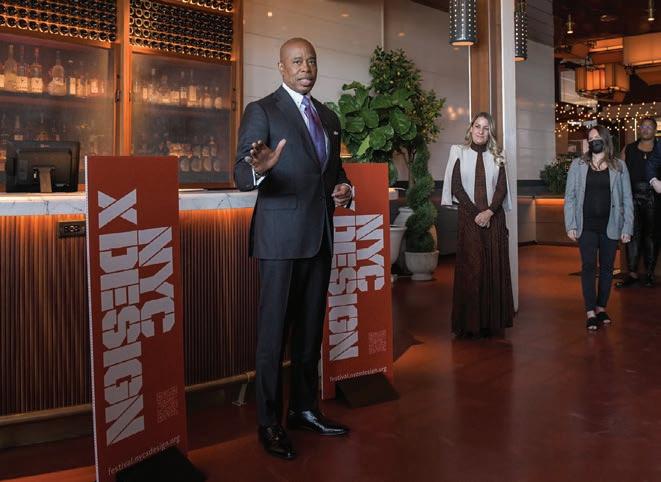
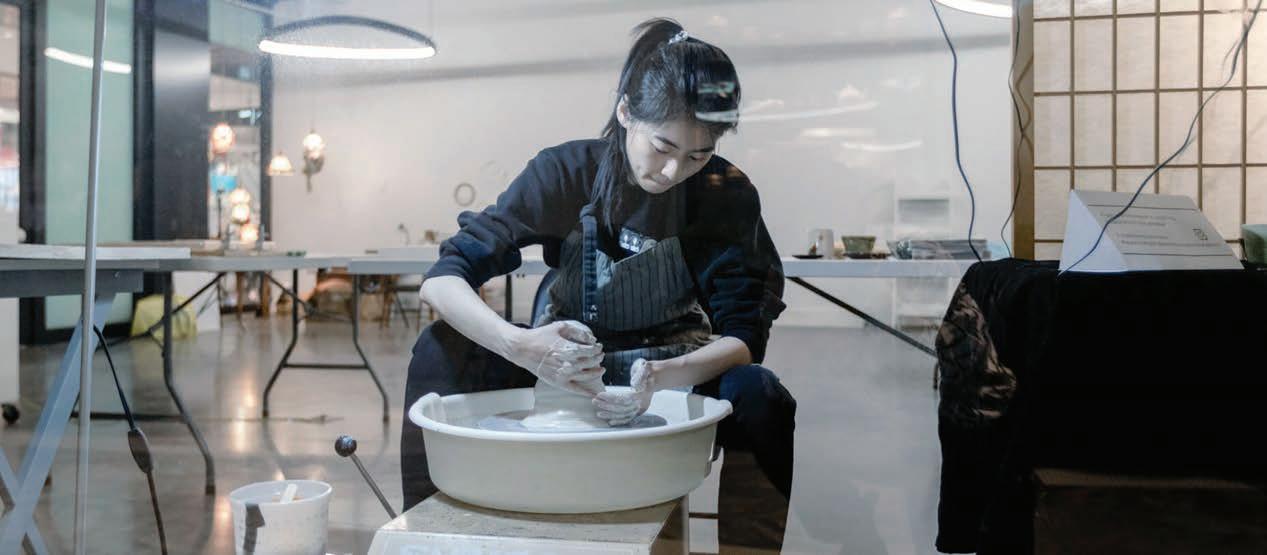
Annually each May, NYCxDESIGN organizes New York City’s official design week, now in its eleventh year. Diverse and designer-led, the NYCxDESIGN Festival attracts 300,000+ national and international visitors, showcasing the immense talent and breadth of the city’s designers, makers, and manufacturers, alongside cutting-edge design businesses and districts, and world-class cultural and academic design institutions.
In the coming months, NYCxDESIGN will be expanding its work and impact towards a more just and thriving design ecosystem for all of New York City. We’ve recently taken a non-profit form, and now seek trustee Board members, sponsors and advisors to join us in this essential enterprise. Please contact Executive Director, Elissa Black, with your interest: eblack@nycxdesign.com

Learn
at nycxdesign.org
more
Top: Xin Min during the NYCxDESIGN and ARTS THREAD Emerging Designer Residency at Hudson Yards
Bottom Left: Tiffany Gomez of Gomez Design Studio Photography by: Jenna Bascom
Bottom Right: NYC Mayor Eric Adams at the 2022 NYCxDESIGN Festival press opening.
Photography by Matthew Carasella
Connecting the Physical and Digital Worlds
An Interview with Chai Outmezguine, Co-Founder, Chief Executive Officer and Chairman, Scanbuy
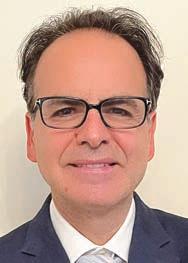
EDITORS’ NOTE Chai Outmezguine has led Scanbuy from innovation to implementation for over two decades. His roles have included acting as General Counsel and leading global business development, and he remains active in creating strategic business partnerships and forming groundbreaking international commercial alliances. He holds several patents related to the decoding and use of linear and two-dimensional barcodes. Outmezguine earned a bachelor’s degree in finance from the Business School of IEA Paris in France and graduated from Georgetown University Law Center and the Law School of Essex University in England.
Chai Outmezguine
Scanbuy’s founding idea in 2000 was to create a bridge between the physical and the digital worlds. Consumers like to touch and feel products before buying them, enjoy the social experience of shopping and, alternatively, value the convenience and information available on the Internet. The central question we faced at that time was what mechanism should we use to make a connection between the digital and physical worlds. The logical candidate was the barcode found on all products in commerce that could be used to access the Internet.
shopping, and product discovery, and that power intelligent connections between the physical and digital world. More specifically, we operate the most advanced and complete enterprise level QR management platform in the market. The platform, built around a series of very sophisticated APIs, provides scale, intelligence, and analytics, all protected by the largest and oldest mobile scanning related IP portfolio in the industry. With our best-in-class Smartlabel platform, we deliver the level of product information and transparency that consumers expect today and into the future.
COMPANY BRIEF Scanbuy (scanbuy.com) is an industry leader in providing technology solutions and services that empower companies to promote mobile marketing, advertising, shopping, product discovery, loyalty, and power intelligent connections between the physical and digital world. The Scanbuy suite of products consists of cloud-based platforms for engagement, product packaging, marketing, couponing, advertising, and much more. Its platforms are used by a wide variety of industries including retail, CPG, electronics, and QSR to create, manage and power consumer engagements, SmartLabel transparency, manufacturing, supply chain, and business processes.
At first the reader was a dedicated scanner, then a PDA, if anyone remembers those, and ultimately the camera-phones as they were introduced to the market in the 2002-2003 time frame. Remember, the iPhone was only commercialized in 2007. The barcode eventually was replaced by the QR code as a more flexible medium to connect.
What was true in 2000 is self-evident today. The desire and need to connect the physical and digital worlds only grew and expanded. Shopping, and any experience really, is increasingly digital, even though we will always live in the physical world that has its needs, possibilities, and constraints. In the world we live in, experiences are omnichannel, therefore, the bridging between the physical and digital worlds is crucial.
Will you highlight Scanbuy’s solutions and service offerings?
We provide technology solutions and services that promote mobile marketing, advertising,
In the past couple of years, Scanbuy has emerged as a leader in CPG shopping data. We provide to the Adtech industry privacy first data used by thousands of brands and agencies. Through machine learning, we provide the first auditable and editable extended audience capabilities.
Finally, Scanbuy deploys digital marketing and data solutions in digital and physical shopping journeys through our digital coupon platform which provides coupons that can be redeemed at physical stores, enabling brands and stores to attract and retain customers with innovative promotions.
How challenging is to differentiate in the industry and how do you describe the Scanbuy advantage?
We are active in an ecosystem that is booming and transforming when it comes to QR, digital advertising or retail media. As a result, new players mushroom and established incumbents defend their turf the best they can. Scanbuy is using the same recipe that has led to our success for many years. To differentiate, we use two strategies that are part of Scanbuy’s
NEW YORK NEW YORK
What was the vision for creating Scanbuy and how do you define its purpose?
POSTED WITH PERMISSION. COPYRIGHT © 2022 LEADERS MAGAZINE, LLC LEADERS227 VOLUME 45, NUMBER 4
“Shopping, and any experience really, is increasingly digital, even though we will always live in the physical world that has its needs, possibilities, and constraints. In the world we live in, experiences are omnichannel, therefore, the bridging between the physical and digital worlds is crucial.”
DNA since its inception, namely, innovation and customer-centricity. We have promoted a culture of innovation that is built into the company’s DNA. We started using QR codes almost 20 years ago. Today, we are launching the next generation QR codes that provide multiple applications and experiences with one code. Our Adtech division is using cutting edge ML and AI to provide privacy-first extended audiences that are auditable and editable. Finally, our Retail Media service is the most advanced in the market.
As we focus on innovation, we remain, first and foremost, customer-centric. We innovate if we believe that our clients will ultimately benefit from those innovations. Most importantly, we make sure we are providing the best customer service possible, and we are proud to say that more than 90 percent of our clients are sticking with us year after year.
Where do you see the greatest opportunities for growth for Scanbuy?
With COVID, the use of QR codes exploded exponentially. After years of bad mouthing QR codes, everyone is now using them to engage clients, and consumers know what to do when they see QR codes. We see a huge opportunity in providing enterprise grade QR services that provide intelligence, scale, and reliability. You see more and more strategy-driven use of QR codes, and Scanbuy is best placed to deliver the services that large groups expect. Our privacy-first extended audience will disrupt the multi-billiondollar Adtech industry. Finally, Scanbuy stepped in the very lucrative FinTech industry using QR codes for payments, which is projected to be a several trillion-dollar market by 2025.
Who is the Scanbuy customer and how broad is Scanbuy’s target market?
Scanbuy customers are large brands, mainly CPG, but also agencies and retailers. A source of pride for Scanbuy is that we service the largest and most prestigious brands globally. It takes hard work to gain their trust, and we work as hard as we can every day to retain their confidence. The markets we are active in are billion-dollar markets in which we compete with large companies by using our strengths – utmost expertise, disruptive innovation, and highest service quality.
How critical is it for Scanbuy to build a diverse and inclusive workforce?
Scanbuy is headquartered in New York, but due to remote working, we have people working from all over the U.S. We are part of a diverse ecosystem, and we live in a diverse global neighborhood. So, needless to say, we believe in diversity and the entire Scanbuy fabric is diverse. As an immigrant who came to this country pursuing and embracing the American ideals of liberty and equality, diversity is a guiding light for Scanbuy. Diversity is key to our way of life, and we would not have it any other way.
What do you see as Scanbuy’s responsibility to the communities it serves?
We believe in the simple motto that “technology is a force for good.” This represents the simple idea that technological innovations are here to serve the people and not the other way around. Our technology is serving the community every day. We are involved in facilitating donations and the delivery of aid through mobile food vouchers for not-for-profit organizations. We enable technologies to provide transparent
information for consumers related to what they eat and drink. Crucially, we are making sure that all our services respect consumers’ privacy and that it is thoroughly safeguarded.
What do you see as the keys to effective leadership and how do you describe your management style?
I believe that effective leadership empowers people to achieve their full potential. Therefore, as an organization, we need to embrace the possibility of failure as a way to get better. We are pushing the envelope and are asking the team to dare to fail so we make sure that we are seizing the opportunities as we see them. To make it work, you need to provide your people with the freedom and discretion to challenge the status quo. This is key to my management style. To reach those objectives, you need to create a team spirit, under which we fall and rise together as a group of strong individualities. There is a delicate balance and a constant struggle of give and take to become stronger as a company and to make sure that team members grow as individuals.
What are your priorities for Scanbuy as you look to the future?
As we look to the future, we continue focusing our attention on improving the relationships and interactions between consumers, retailers, and brands for the benefit of them all. We make sure that innovation and customer service continue to be in our DNA and are strengthened. We allow our team to grow and prosper individually and collectively and as those goals are achieved, we will continue to create shareholder value through growth and profitability.•
“We provide technology solutions and services that promote mobile marketing, advertising, shopping, and product discovery, and that power intelligent connections between the physical and digital world. More specifically, we operate the most advanced and complete enterprise level QR management platform in the market.”
POSTED WITH PERMISSION. COPYRIGHT © 2022 LEADERS MAGAZINE, LLC LEADERS 228 VOLUME 45, NUMBER 4
“We are part of a diverse ecosystem, and we live in a diverse global neighborhood. So, needless to say, we believe in diversity and the entire Scanbuy fabric is diverse. As an immigrant who came to this country pursuing and embracing the American ideals of liberty and equality, diversity is a guiding light for Scanbuy. Diversity is key to our way of life, and we would not have it any other way.”

700 FIFTH AVENUE AT 55TH STREET, NEW YORK, NY 10019, USA | PENINSULA.COM/NEWYORK HONG KONG • SHANGHAI • BEIJING • TOKYO • NEW YORK • CHICAGO • BEVERLY HILLS • PARIS • BANGKOK • MANILA Under Development LONDON • ISTANBUL 700 FIFTH AVENUE AT 55TH STREET, NEW YORK, NY 10019, USA | PENINSULA.COM/NEWYORK HONG KONG • SHANGHAI • BEIJING • TOKYO • NEW YORK • CHICAGO • BEVERLY HILLS • PARIS • BANGKOK • MANILA Under Development LONDON • ISTANBUL Experience five-star luxury and exceptional, personalized service in the heart of midtown Manhattan.
A Flight to Quality
EDITORS’ NOTE Michael Shvo is the founder, Chairman, and CEO of SHVO, a leading real estate owner, investor, and developer of unique and innovative luxury and landmark properties. SHVO currently oversees a portfolio of more than $8 billion, including residential, hospitality, and commercial space. Shvo draws from his diverse background in real estate –from brokerage to marketing and sales to development – to guide his firm in creating and reimagining one-ofa-kind properties at some of the most important and sought-after locations in the world. In the world of luxury real estate, Shvo represents a rare combination of business acumen and aesthetic sensibility. He leads the firm’s investment and transaction strategy, capital markets, site selection, design and conceptualization. He anchors a team of some of the world’s most respected investors including pension funds, insurance companies, financial institutions, and other leading institutional investors, who share SHVO’s vision of creating extreme value by elevating how people live and work. Shvo founded the company in 2004 and built a reputation for groundbreaking residential lifestyle concepts inspired by, and frequently in partnership with, some of the world’s leading luxury brands. That included collaborations with worldrenowned architects, designers, and fashion brands, including Lord Norman Foster, Peter Marino, Renzo Piano, Herzog & de Meuron, Rafael Vinoly, JeanMichel Gathy and Philippe Starck. Shvo pioneered the marriage of fashion and real estate with Armani Casa at 20 Pine Street, a concept that continues to be emulated throughout the world. He also has great passion for art and is known for creatively marrying the art and real estate worlds. In 2013, SHVO created the renowned public art installation “Sheep Station” in Manhattan, which transformed an empty former gas station in Chelsea into a whimsical scene of grassy hills and epoxy stone and bronze sheep sculptures by François-Xavier Lalanne. In late 2019, SHVO opened Les Lalanne at The Raleigh Hotel Gardens in Miami Beach.
FIRM BRIEF SHVO (shvo.com) is a real estate development and investment firm built on the vision of Chairman and CEO Michael Shvo to create culture-defining experiences in iconic properties. Headquartered in New York City with offices in Miami, San Francisco, Los Angeles, and Chicago, SHVO owns and operates
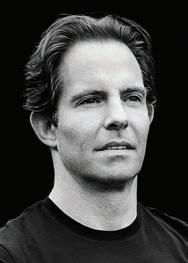


a national portfolio valued at more than $8 billion and 4.5 million square feet across commercial office and retail space, hospitality, and luxury residential assets. The firm’s selective portfolio of architecturally significant properties, from innovative ground up new developments to revitalized landmarks that define skylines in the world’s leading cities, includes the Transamerica Pyramid in San Francisco, The Raleigh Hotel in Miami Beach, 333 South Wabash Avenue (“The Big Red”) in Chicago, Mandarin Oriental Residences at 9200 Wilshire Boulevard in Beverly Hills, Mandarin Oriental Residences Fifth Avenue in New York City, and the AMAN New York Hotel and Residences at the Crown building. Renowned for its expertise, SHVO is fully integrated with highly diversified industry experience in every aspect of acquisitions, finance, development, design, sales, leasing, property management, hospitality, and sustainability.
Will you provide an overview of SHVO’s values and culture?
Our core values are as follows:
Caring: We are relentlessly customerfocused to the point where nothing matters more than our customers’ satisfaction.
Quality: We are in the business of providing our customers with an uncompromising experience across every touchpoint that exists nowhere else in our category.
Culture: We respect the diversity and desires of our people, as well as the physical
and spiritual components of our properties. Their stewardship is our greatest responsibility.
What have been the keys to SHVO’s strength and leadership in the industry?
We exist to elevate super-prime real estate. We create unrivalled value by being different. We do this by focusing exclusively on unique properties and creating unprecedented desire, whether that is on the commercial side, such as Transamerica Pyramid Center in San Francisco where we are collaborating with Norman Foster on a major redevelopment, or on the residential side, such as the development of our Mandarin Oriental Residences Fifth Avenue and Beverly Hills.
Ultimately, we build the right thing at the right place at the right time for the right customer – and we never rest until an emotional response is achieved.
NEW YORK NEW YORK
Michael Shvo
The
An Interview with Michael Shvo, Founder and Chief Executive Officer, SHVO
lobby of 711 Fifth Avenue
POSTED WITH PERMISSION. COPYRIGHT © 2022 LEADERS MAGAZINE, LLC LEADERS 230 VOLUME 45, NUMBER 4
The lobby of 530 Broadway
711 Fifth Avenue
Will you highlight SHVO’s portfolio and current development projects?
We own and operate a national portfolio across the U.S. with more than $8 billion in assets under management comprising more than 4.5 million square feet across commercial, residential, and hospitality assets.
On the commercial side, this includes 711 Fifth Avenue and 530 Broadway In New York; 333 South Wabash, the Big Red, in Chicago; Transamerica Pyramid Center in San Francisco; and The Alton, a project we just announced in Miami where we are collaborating with Norman Foster and the team at Foster + Partners, marking their first office building in Miami Beach.
On the residential side, we have partnered with Mandarin Oriental to develop the Mandarin Oriental Residences Fifth Avenue and Beverly Hills, and with Rosewood Hotel Group on the
revival and restoration of The Raleigh, the iconic Miami Beach property.
The tie that binds each of these properties together is the fact that they are or, in the cases of new developments, will be distinct and iconic in their own right.
Will you discuss SHVO’s presence and investment in the New York market?
New York is the epicenter of the world’s real estate industry, and we are continuously investing in and looking for new opportunities to invest in the market. Our portfolio in the city includes commercial properties such as 711 Fifth Avenue, the old Coca-Cola headquarters, where we will be welcoming the exclusive members club, Core Club, as one of our tenants – and 530 Broadway, on the nexus of Broadway and Spring Street, one of the most creative corners in the world. We are also developing a luxury residential project, the
Mandarin Oriental Residences Fifth Avenue, at 685 Fifth Avenue which previously served as Gucci headquarters in New York.

We are seeing strong demand across all of these properties, whether its companies looking for office space or individuals and families looking for residences.
Where do you see the greatest opportunities for growth for SHVO?
We are witnessing a flight to quality across the real estate sector. People and companies are looking for incentives to return to the office. In this environment, the level of design and service being offered at office buildings matters more than ever – and buildings that offer beautiful design, and a hospitality-like service, are seeing greater demand than ever. For instance, in the San Francisco commercial market, the top 20 net effective rents have increased by 15 percent since their peak in Q4 2019 versus the overall market which has dropped by approximately 26 percent since that time.
As a firm that focuses exclusively on luxury properties, we are perfectly positioned to cater to this demand, and this has been borne out at the Transamerica Pyramid Center where we have secured record rents in recent months.
How valuable have partnerships and collaborations been to SHVO’s business?
Since our earliest days, we have entered groundbreaking partnerships and collaborations with the world’s best-known architects, designers, hotel brands, chefs, and artists. We pioneered the union of fashion and real estate with Armani Casa at 20 Pine Street, a concept that has subsequently been emulated worldwide. In 2013, we created the public art installation “Sheep Station” in Manhattan, which transformed a former gas station lot in Chelsea into a whimsical scene of sculptures by François-Xavier Lalanne, and in late 2019, we opened the Les Lalanne sculpture garden at The Raleigh Hotel Gardens in Miami Beach.
We are currently working with or have previously worked with the likes of architects such as Lord Norman Foster, Peter Marino, Renzo Piano, Rafael Vinoly; hospitality groups such as Mandarin Oriental, Rosewood Hotel Group, Aman Resorts; as well as incredible chefs such as Daniel Boulud.
These partnerships and collaborations allow us to create and offer truly unique and transformational experiences for our guests and customers which is what we strive for every day.
How critical is it for SHVO to build a diverse and inclusive workforce?
We are very proud of the diverse nature of our workforce. Our people come from a range of backgrounds, in every sense of the word, and each brings something unique and distinct to the company.
What has made the real estate industry so special for you?
The joy I get from seeing people that have truly enjoyed their experience at a SHVO property is hard to beat.• POSTED WITH PERMISSION. COPYRIGHT © 2022 LEADERS MAGAZINE, LLC LEADERS231 VOLUME 45, NUMBER 4
The Caviar Experience
EDITORS’ NOTE Chef Edgar Panchernikov graduated from the French Culinary Institute in 2010. Following graduation, he worked at GILT at the Palace Hotel and Rucola in Brooklyn. Following his years working in the kitchen, he sought to transition to a front of the house role at his family’s restaurant, Caviar Russe. However, in 2016, seeking to present the best possible experience for his clientele, he jumped back into the kitchen and assumed the role of Executive Chef of Caviar Russe.

Will you highlight the history of Caviar Russe?
Caviar Russe was founded 25 years ago with the flagship restaurant, located in Midtown Manhattan, opening in 1997. To date, we are the only Michelin Star caviar house, holding that honor since 2014. Originally the company was in the wholesale business selling to the trade, but the idea of the restaurant came about as a place where we could showcase and celebrate our caviar directly to the consumer. Over the years, our focus has evolved with the goal of sharing the caviar experience with as many people as possible, whether it’s enjoying our caviar at one of our restaurants or at home.
What have been the keys to the strength of Caviar Russe and how do you describe the Caviar Russe experience?
The strength of Caviar Russe is our commitment to quality and relationships. Unlike much of the caviar market today, we do not source or use caviar farmed in China. Instead, our caviar is single sourced from our exclusive farm in Germany with whom we have worked closely with over the years to develop farmed caviar that resembles what was available in the wild, allowing us to preserve the Caspian tradition of caviar. As for relationships, whether you are a retail customer, buying in person or online, or a diner in one of our restaurants, we strive to make every experience with Caviar Russe as personable and enjoyable as possible, making it our goal to leave a lasting impression.
Will you discuss the different aspects to Caviar Russe’s business and where you see the greatest opportunities for growth?
Primarily we have two areas of our business – retail and dining. As caviar has come back into vogue the last few years, and as younger people now have aged into the times
in their lives when they want to experience and learn about the finer things in life, the potential for growth is certainly there and we are optimistic for the caviar sector to grow significantly and us with it. The only obstacle is educating the new consumer since with the large infusion of Chinese caviar into the market, it can be quite overwhelming and confusing for the first-time caviar purchaser.
Caviar Russe invested heavily in its New York location with a new bar on the first floor. Will you provide an overview of this space and what guests can expect from this new offering?

The goal of opening the new space was to offer the same luxurious Caviar Russe experience of our main dining room, but in a less formal setting. Our vision was to make a true flagship that would feel like home to our clients. The first floor – the bar and lounge – feeling like their living room, where they can come hangout casually, and then the second floor – the dining room – feeling like their formal dining room for more intimate occasions.
On both floors caviar is front and center. We offer a variety of Caviar types and grades from 25g to 500g. We love to serve caviar the
NEW YORK NEW YORK
Chef Edgar “Teddy” Panchernikov in the second floor dining room of Caviar Russe on Madison Avenue off 54th Street in Midtown Manhattan
An Interview with Chef Edgar Panchernikov, Caviar Russe
POSTED WITH PERMISSION. COPYRIGHT © 2022 LEADERS MAGAZINE, LLC LEADERS 232 VOLUME 45, NUMBER 4
The entrance to Caviar Russe
traditional way, on ice, with plenty of accompaniments, including homemade blinis, toast points and our signature latkes. Beyond caviar, the bar and lounge feature an extensive raw bar selection as well as an ever-rotating selection of “bites” that put a luxurious spin on traditional bar food, while in the main dining room we offer our chef tasting menu, either three or six courses.
While Caviar Russe is known for the strength of its caviar offering, it offers a broad menu of the highestquality food. Will you discuss the Caviar Russe food offering?
We try to present the best cuisine pairings to accompany the experience of enjoying caviar, a luxurious product that deserves an equally luxurious pairing in a luxurious setting. Our menus aim to celebrate the rich flavors of caviar with ingredients such as foie gras, bluefin tuna, uni, lobster, etc,. all playing off of the decadence of the caviar.
Caviar Russe has a workforce that has been with the restaurant for many years. How valuable has it been to have such consistency in the staff to offer consistent service to Caviar Russe’s guests?

Impeccable service and hospitality are one of the most important aspects of the Caviar Russe experience, and having a consistent group of servers and chefs throughout the years has definitely helped maintain our high standards of service. We are
also very proud of the fact that many of our customers know our staff on a firsthand basis and vice versa, something that is increasingly rare in the fine dining world.
Will you highlight Caviar Russe’s capabilities regarding corporate events and high-level private dinners?

We are extremely flexible in terms of corporate dining and aim to work with the client to deliver an unforgettable experience that isn’t easily replicated at other venues, from the cuisine to the service and care to attention. We can offer a variety of experiences, for example, our private dining room where we can sit 16 at one large table or 20 in total where diners can enjoy the tasting menu experience which will be fully customized for their event. Another highlight is the new bar and lounge, which can accommodate up to 30 in the lounge area for cocktails or upwards of 70 for a full buyout. For cocktail style events in our bar and lounge, we like to allow the guests to curate everything from the food to the music and have a fantastic evening filled with champagne, caviar, and great food.
Is Caviar Russe focused on building its corporate gifting business and what are Caviar Russe’s offerings in this area?
This is a relatively new area for us that we hope to continue to grow. Post pandemic many brands
are seeking to create experiences for their clients, whether that is at their homes or at a destination, and we hope to help with this. Caviar is such an unusual gift to give that it makes it an easy way to stand out in terms of corporate gifting. We have really worked hard to design beautiful packaging and offer flexible corporate partnership programs that are responsive to our corporate partners’ needs.
Did you always know that you wanted to be a chef and what do you enjoy most about the role?

Caviar Russe is a family business, and we didn’t have a chef in the family so it seemed like a good avenue for me to follow. However, it wasn’t just filling a void for me because I love the art of hospitality in the traditional sense. Hosting clients, seeing them happy and enjoying themselves, is one of the most enjoyable parts of my role within Caviar Russe. I get to interact daily with our customers and every time they come back, I want them saying “wow” topping their previous experience.
What has made the family dynamic work so well and do you each focus on different aspects of the business?
I think it’s all about complimenting one another and supporting each other in our main roles, and also being flexible in understanding that no one has a set position like in a corporate setting. Everyone must be able to help each other out and there are no egos as we all have the same common goals.•
Caviar Russe’s new bar and lounge A table in the main dining room
POSTED WITH PERMISSION. COPYRIGHT © 2022 LEADERS MAGAZINE, LLC LEADERS233 VOLUME 45, NUMBER 4
Chef Edgar preparing his culinary art
Celebrating 80Yearsof Philanthropy
Celebrating 80Yearsof Philanthropy
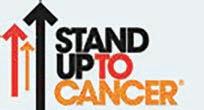


Since 1942, we’ve been the entertainment community’s trusted partner in philanthropy. Our groundbreaking programs and philanthropic partners raise awareness and funds for issues that affect millions of people around the world.

Since 1942, we’ve been the entertainment community’s trusted partner in philanthropy. Our groundbreaking programs and philanthropic partners raise awareness and funds for issues that affect millions of people around the world.
We couldn’t do it without the strength, passion, and commitment of the entertainment industry itself. Thanks to everyone who has contributed to 80 years of facilitating positive social change.
We couldn’t do it without the strength, passion, and commitment of the entertainment industry itself. Thanks to everyone who has contributed to 80 years of facilitating positive social change.

To donate visit EIFoundation.org @ EIFoundation EIF Programs
To donate visit EIFoundation.org @ EIFoundation EIF Programs
EIF Philanthropic Partners and Initiatives







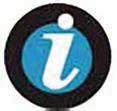























EIF is a 501(c)(3) tax-exempt organization and meets all 20 BBB Charity Standards. Copyright ©2022 Entertainment Industry Foundation. All Rights Reserved. EIN: 95-1644609
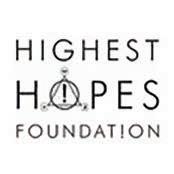
China General Chamber of Commerce - USA
Connecting People · Building Trust · Expanding Cooperation
Founded in 2005, China General Chamber of Commerce - USA (“CGCC”) has been recognized as the largest and most impactful non-profit organization representing Chinese enterprises in the U.S. With a mission to create value, generate economic growth, and enhance cooperation between the U.S. and Chinese business communities, CGCC offers a broad range of programs, services and resources to over a thousand multinational members across the U.S.
CGCC is an independent, non-partisan, non-governmental chamber of commerce since its inception. As of March 2022, CGCC’s Chinese member companies have cumulatively invested over $135 billion, employ more than 220,000 people, and indirectly support over one million jobs throughout the United States.


CGCC Foundation



Established in 2014, CGCC Foundation is a 501(c)(3) tax-exempt organization. The mission of CGCC Foundation is to deepen mutual understanding and cooperation between the United States and China through research, public charity and engagement in economic, cultural and social exchanges.

Mission Vision Values
CGCC is committed to strengthening communication and cooperation between businesses in the United States and China to achieve economic growth and positive social impact, by integrating private sector resources, working with existing U.S. organizations and other chambers of commerce.
Uniting U.S.-China business communities and advancing opportunities for our members to achieve economic growth and prosperity, and positive social impact.
Member-Centric
Respect for All
Always Evolving
www.cgccusa.org | contact@cgccusa.org | 19 E 48th Street, 3rd Floor, New York, NY 10017
Our members’
we
and
interests lie at the core of what
do
drive every decision we make.
We
embrace diversity and inclusion. We strongly believe in our duty to connect people from all walks of life and provide them with opportunities for open dialogue and cooperation.
We believe in fostering an evolving and forward-thinking culture that adapts to the needs of today’s modern world, providing industry best practices to meet complex daily challenges and create new opportunities for our members and local communities.
POSTED WITH PERMISSION. COPYRIGHT © 2022 LEADERS MAGAZINE, LLC LEADERS 236 VOLUME 45, NUMBER 4
CGCC Board of Directors

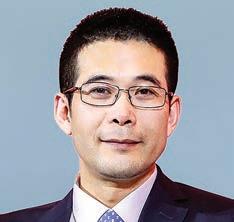



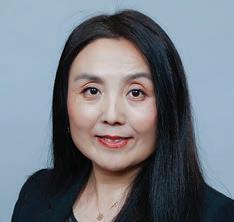
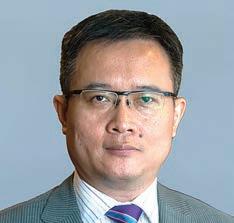




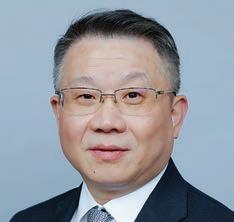
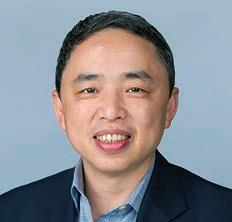


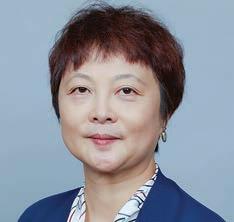 Ning YUAN Wei HU Kang PAN Chairman & President of China Construction America President & CEO of Bank of China U.S.A.
General Manager & Chief Representative of China Merchants Bank NY Branch
Zheyu CHEN Chairman of COSCO SHIPPING (North America)
Pin NI President of Wanxiang America Corporation
Jianyu ZHANG Chair of ICBC US Region Management Committee
Suosheng LI General Manager of China Construction Bank New York Branch
Jianmin ZHU CEO of SINOPEC America
Xuming ZHANG President of AVIC INTL USA.
Ping ZHANG Vice President of China Telecom (Americas)
Wei BO Chief Executive Representative of Fosun International New York Office
Mengrong CHENG Chief Representative of State Grid US Representative Office
Min FANG General Manager of Agricultural Bank of China New York Branch
Lanlan ZHANG Vice Chairman of CICC US Securities
Liang CHANG Chairman of Aland Health Holding & International Vitamin
Ning YUAN Wei HU Kang PAN Chairman & President of China Construction America President & CEO of Bank of China U.S.A.
General Manager & Chief Representative of China Merchants Bank NY Branch
Zheyu CHEN Chairman of COSCO SHIPPING (North America)
Pin NI President of Wanxiang America Corporation
Jianyu ZHANG Chair of ICBC US Region Management Committee
Suosheng LI General Manager of China Construction Bank New York Branch
Jianmin ZHU CEO of SINOPEC America
Xuming ZHANG President of AVIC INTL USA.
Ping ZHANG Vice President of China Telecom (Americas)
Wei BO Chief Executive Representative of Fosun International New York Office
Mengrong CHENG Chief Representative of State Grid US Representative Office
Min FANG General Manager of Agricultural Bank of China New York Branch
Lanlan ZHANG Vice Chairman of CICC US Securities
Liang CHANG Chairman of Aland Health Holding & International Vitamin
POSTED WITH PERMISSION. COPYRIGHT © 2022 LEADERS MAGAZINE, LLC LEADERS237 VOLUME 45, NUMBER 4
Sophia SU President of China Mobile International (USA)
CGCC Board of Directors

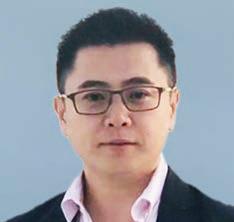








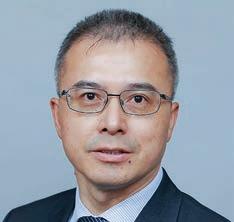
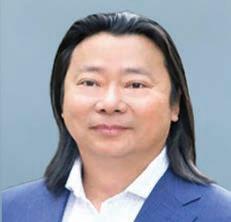
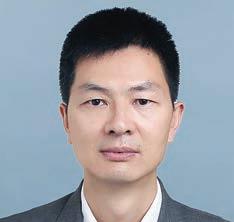
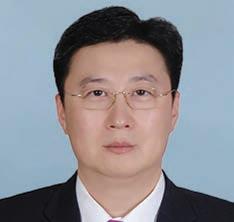
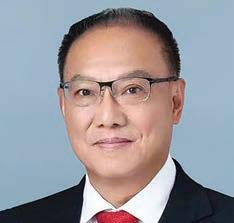
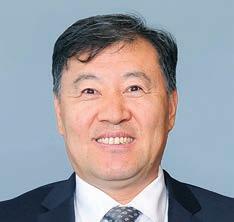 Zhaohu WANG Ming HOU President of Minmetals USA General Manager of China Southern Airlines North America
Weifeng ZHANG President of Shanghai Construction Group America
Gang HU President & CEO of Greenland USA
Mengtao XIE General Manager of SANY America
Xin HE CFO of Wanda America Group
Yi ZHU Chairman & CEO of Gemdale USA
Shaohui YANG General Manager of Bank of Communications NY Branch
Yuyong RAO Executive Director, President of Baosteel America
Jing CHEN General Manager of China Unionpay (USA)
Guotu MAO Vice President of Sinochem American Holdings
Duan WANG Assistant General Manager & Chief International Affairs Officer of HNA Trust Management
Qidi TENG
Howard LI President of PetroChina International America Chairman & CEO of Waitex Group of Companies
Tong ZHANG President of China Unicom Americas
Zhaohu WANG Ming HOU President of Minmetals USA General Manager of China Southern Airlines North America
Weifeng ZHANG President of Shanghai Construction Group America
Gang HU President & CEO of Greenland USA
Mengtao XIE General Manager of SANY America
Xin HE CFO of Wanda America Group
Yi ZHU Chairman & CEO of Gemdale USA
Shaohui YANG General Manager of Bank of Communications NY Branch
Yuyong RAO Executive Director, President of Baosteel America
Jing CHEN General Manager of China Unionpay (USA)
Guotu MAO Vice President of Sinochem American Holdings
Duan WANG Assistant General Manager & Chief International Affairs Officer of HNA Trust Management
Qidi TENG
Howard LI President of PetroChina International America Chairman & CEO of Waitex Group of Companies
Tong ZHANG President of China Unicom Americas
POSTED WITH PERMISSION. COPYRIGHT © 2022 LEADERS MAGAZINE, LLC LEADERS 238 VOLUME 45, NUMBER 4
Maxwell HUANG President of SAIC USA
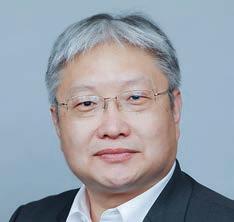
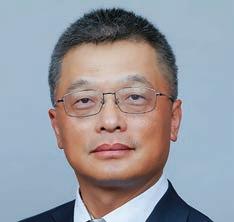
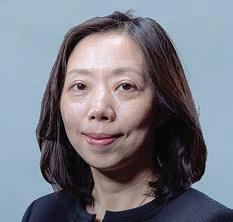

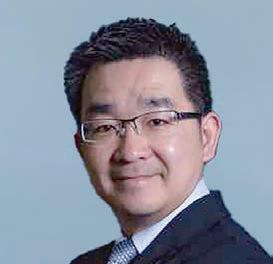
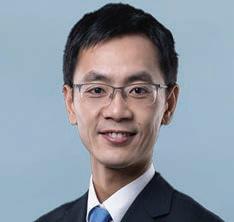





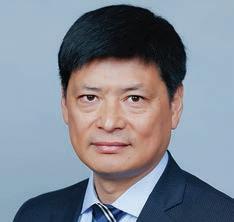

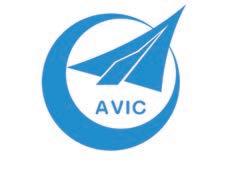
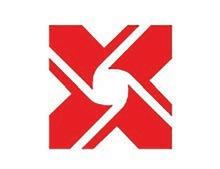
 Shuguang WANG General Manager of Broad U.S.A.
Tong HE Xuan CHENG General Manager of Eccom Network (USA) Chairman of Sansheng Investment U.S.A
Yu WANG Chief Representative of China Life U.S. Representative Office
Guoliang YU General Manager of Liepin North America
Tim DING Global Sales Director of Inspur USA
Chunyin FANG Chief Representative of China Re New York Liaison Office
Lianhong LIU President of Hongdou New York
Xiaoyuan HOU CEO of Chinatex Oriental USA
Hui DONG President & CEO of Shanghai Int’l Holding (America)
Kai-Yan LEE Managing Director of Vanke (USA) Holding
Liujun LI General Manager of China Eastern Airlines North America
Stella LI President of BYD Motors
Tao BIAN Managing Director of CAIGA US
Jian ZHANG Managing Director of XIN Development Group International
Shuguang WANG General Manager of Broad U.S.A.
Tong HE Xuan CHENG General Manager of Eccom Network (USA) Chairman of Sansheng Investment U.S.A
Yu WANG Chief Representative of China Life U.S. Representative Office
Guoliang YU General Manager of Liepin North America
Tim DING Global Sales Director of Inspur USA
Chunyin FANG Chief Representative of China Re New York Liaison Office
Lianhong LIU President of Hongdou New York
Xiaoyuan HOU CEO of Chinatex Oriental USA
Hui DONG President & CEO of Shanghai Int’l Holding (America)
Kai-Yan LEE Managing Director of Vanke (USA) Holding
Liujun LI General Manager of China Eastern Airlines North America
Stella LI President of BYD Motors
Tao BIAN Managing Director of CAIGA US
Jian ZHANG Managing Director of XIN Development Group International
POSTED WITH PERMISSION. COPYRIGHT © 2022 LEADERS MAGAZINE, LLC LEADERS239 VOLUME 45, NUMBER 4
Zhiqiang LIU Representative of Tianyuan Overseas (CNMI) Engineering
CGCC Board of Directors
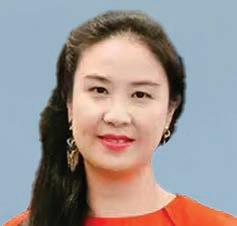












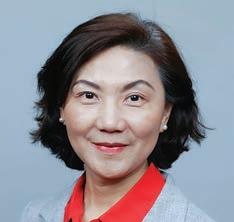
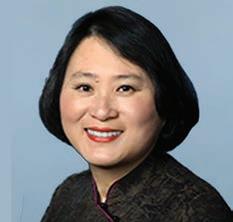
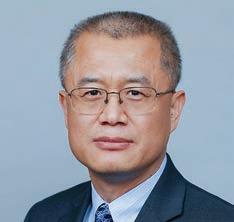 Amy LEI Vice President of Fuyao Group North America
Chris CHAN President of Greencourt Capital
Larry LI President of China Orient Advisors
Ya SUN CEO & President of JN fibers
Jack WANG Managing Partner of King & Wood Mallesons
Bing WU CEO of Synear Foods USA
Ling XIAO Partner of Zhong Lun Law Firm
Jeffery HE Vice President & Global Affairs of Hikvision USA
Doris ZHANG General Manager of Beijing Duck Restaurant
Qing HONG General Manager & Branch Manager China CITIC Bank International, NY Branch
Veronica YE CEO of Haitong Securities US
Tencent cloud North America
Arene LIU Vice President of Lao Feng Xiang Jewelry
Linhua GUAN CEO of Surge Energy
Joe YE EVP of EP Yaying Fashion Group
Amy LEI Vice President of Fuyao Group North America
Chris CHAN President of Greencourt Capital
Larry LI President of China Orient Advisors
Ya SUN CEO & President of JN fibers
Jack WANG Managing Partner of King & Wood Mallesons
Bing WU CEO of Synear Foods USA
Ling XIAO Partner of Zhong Lun Law Firm
Jeffery HE Vice President & Global Affairs of Hikvision USA
Doris ZHANG General Manager of Beijing Duck Restaurant
Qing HONG General Manager & Branch Manager China CITIC Bank International, NY Branch
Veronica YE CEO of Haitong Securities US
Tencent cloud North America
Arene LIU Vice President of Lao Feng Xiang Jewelry
Linhua GUAN CEO of Surge Energy
Joe YE EVP of EP Yaying Fashion Group
POSTED WITH PERMISSION. COPYRIGHT © 2022 LEADERS MAGAZINE, LLC LEADERS 240 VOLUME 45, NUMBER 4
Jilian YANG Deputy General Manager of CRRC North America
“Thanks to the dedication of all the board of directors, CGCC has grown significantly throughout the past years. Together with your active participation and support, we will continue to serve as a bridge for the U.S.-China business communities.”
-Wei
Chairman of China General Chamber of Commerce – USA President & CEO of Bank of China U.S.A.

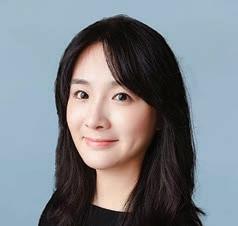

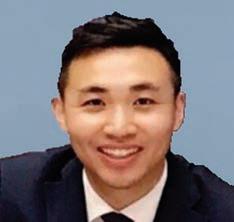

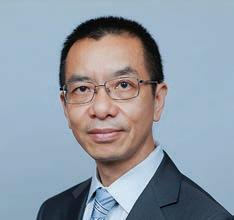
Interview Profile with Mr. Wei HU
Chairman of China General Chamber of Commerce - USA President & CEO of Bank of China U.S.A.
I’ve had the great privilege to witness the organization’s tremendous growth and to see its wonderful mission of connecting the U.S.-China business communities live at work. I decided to run for CGCC Chairman because I wanted to become more involved and to help strengthen the chamber’s impactful work of creating value, generating economic growth, and enhancing cooperation among the U.S.-China business communities. As the newest CGCC chairman, I look forward to dedicating myself to the organization’s mission, to connecting the two countries by providing further opportunities for deeper engagement, and contributing to building trust, and expanding cooperation.
James SHIH Group Vice President of SEMCORP Group
Jian KANG CEO of XCMG America
JD.com
Ryan ZOU CEO of May Bao
Christie SHU General manager of CSX
HU
You were recently appointed chairman of the China General Chamber of Commerce USA (CGCC). What interested you in taking on this leadership role at CGCC?
www.cgccusa.org POSTED WITH PERMISSION. COPYRIGHT © 2022 LEADERS MAGAZINE, LLC LEADERS241 VOLUME 45, NUMBER 4
CGCC is a bridge for the U.S.-China business communities. We are not only a platform for cooperation and engagement between the two business communities but, more importantly, we provide opportunities to engage, exchange perspectives, and cultivate mutual understand ing on a personal level. We are able to do this through our broad range of event programs, ser vices, initiatives, and resources.
Among the events we have co-hosted, we have helped define the various modules of the new normal in the areas of regulations, cross-border trade and investment, green economy, and cor porate communications. Our extensive research projects delve into specific industries for their institutional resilience and best practices in adapting to the dynamic market trends. Through diverse partnerships with government agencies and charity groups in the U.S., CGCC Founda tion is engaging tens of thousands of people to support local businesses and foster vigorous dis cussions on cultural and societal issues.
As the United States and China continue to nav igate a challenging bilateral relationship, mutu al understanding and cooperation on a personal level are key. Every program, publication, ser vice, and resource CGCC provides, little by lit tle, aims to contribute to the greater picture of a stronger, more stable relationship between the U.S. and China.


In addition to focusing on strengthening the chamber’s reach and growing the community, we will continue to focus on providing our members with the high est quality events and services. Furthermore, CGCC will aim to re-establish its relationships and strengthen collaborations with like-minded organizations.
With the shared goodwill and vision of building strong, healthy, and trustworthy U.S.-China business relations, CGCC has partnered with many organizations and institutions on a series of programs to serve the diverse needs of our commu nity. From rising tensions in U.S.-China relations to COVID-19 ramifications, to today’s global economic instability, we have worked as a community to navigate the rough and unpredictable waters for both U.S. and Chinese companies with creativity and resourcefulness. During these unprecedented times, it takes stron ger alliances and closer cooperation among our organizations to help any U.S. or Chinese business better understand, engage with, and contribute to some of the most critical issues and deal-makings. CGCC will continue to cultivate ties of friendship, create platforms for candid communication, and open windows for mutually beneficial cooperation between the U.S.-China business communities.
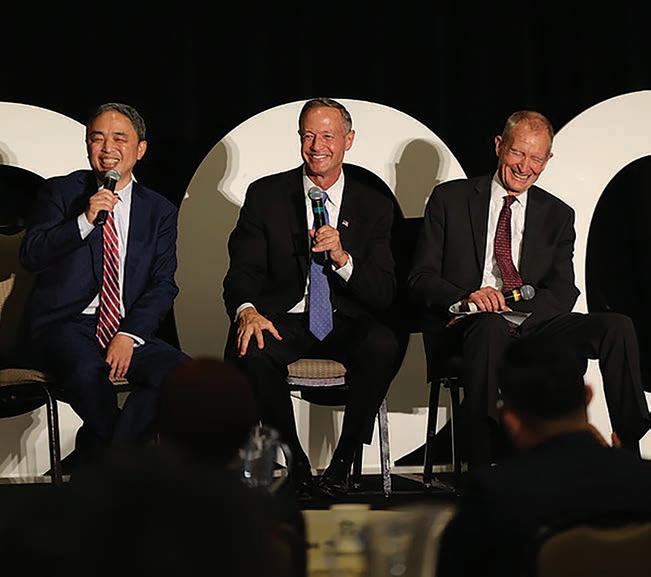
www.cgccusa.org
How will you focus your efforts as chairman and what are your priorities for CGCC’s future? How do you define CGCC’s mission and purpose?
POSTED WITH PERMISSION. COPYRIGHT © 2022 LEADERS MAGAZINE, LLC LEADERS 242 VOLUME 45, NUMBER 4
At CGCC, we are lucky to have such a dedicated and active membership base. The CGCC family is made up of hundreds of American and Chinese multinational companies, 44 of which are ranked on the 2022 Fortune Global 500. They span a variety of different industries and are located all across the United States.
As of March 2022, our Chinese member compa nies have cumulatively invested over $135 billion dollars, employing more than 220,000 people, and indirectly supporting over one million jobs throughout the United States.
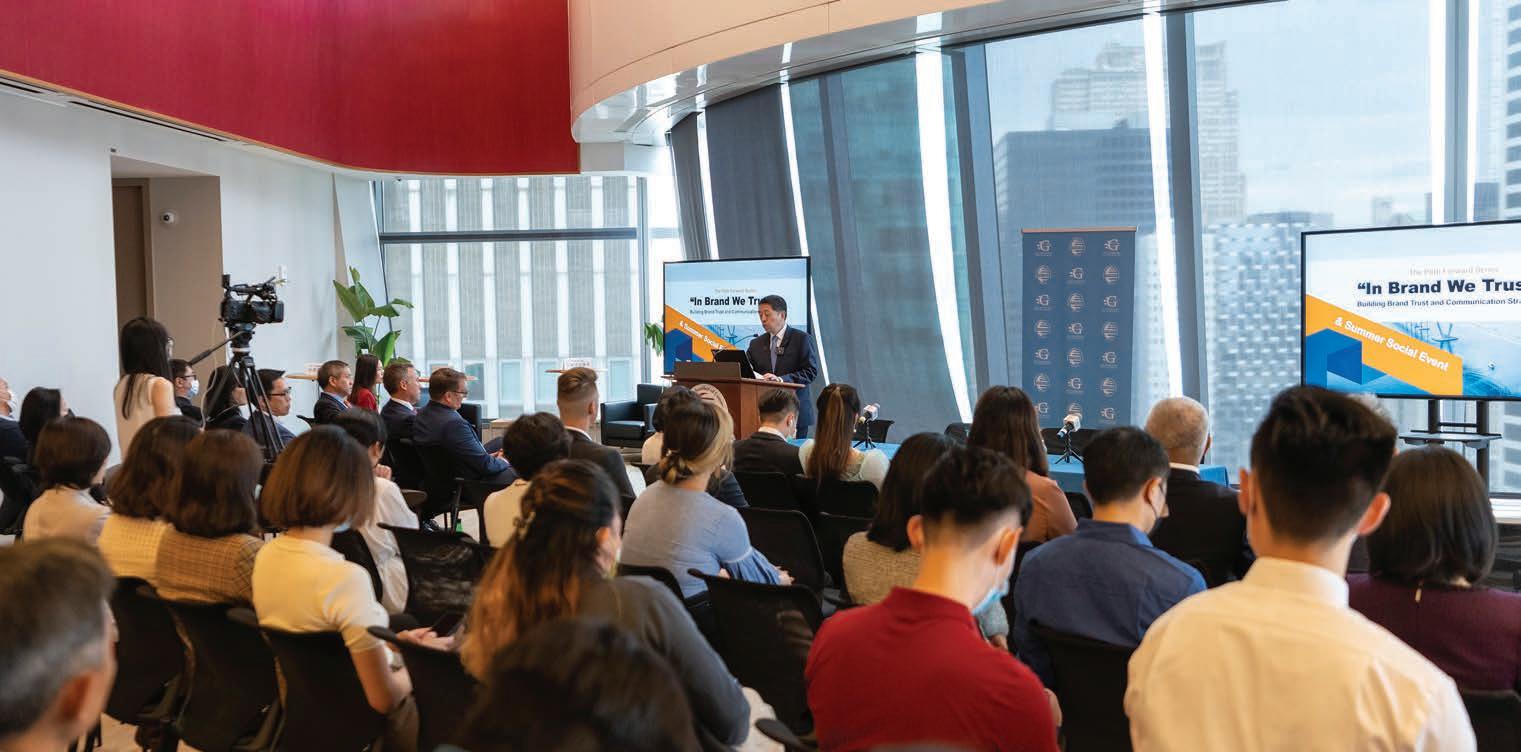
Our board is made up of top executives and lead ers at some of the largest and most influential Chi nese enterprises in the United States. We currently have a total of 69 board member companies whose industries range from financial services to materi als and real estate.
As the two largest economies in the world, the U.S. and China are inextricably linked. A mutually beneficial and strong relationship is extremely critical. As in any relationship, in order for it to be strong and rebound, both sides must find solutions that can benefit both countries.
At this moment, when our relationship is being challenged on var ious fronts, it is critical for everyone to understand the economic and strategic importance of U.S.-China relations, and how bilat eral trade represents an integral and beneficial part of the overall economic relationship. Over 40 years of cooperation has not only alleviated poverty for over 800 million Chinese people, but has brought local and worldwide consumer prices down, increased manufacturing efficiencies, developed state of the art transporta tion across land, air and sea, advanced technologies in virtually every industry, and given enormous market share to foreign com panies to sell products to an immensely growing middle class in China. While the relationship will have its challenges going for ward, and competition between our countries will continue in cer tain areas, we believe that through open dialogue and cooperation, there will be more opportunities and benefits for businesses, work ers and consumers on both sides of the Pacific.
Will you highlight CGCC’s membership and the strength of the CGCC board?
What are your views on the China/US business relationship and how critical is it for this to be a mutually beneficial and strong relationship?
www.cgccusa.org POSTED WITH PERMISSION. COPYRIGHT © 2022 LEADERS MAGAZINE, LLC LEADERS243 VOLUME 45, NUMBER 4
A Global Bank with a Local Heart


Mr. Hu Wei was appointed President and Chief Executive Officer of Bank of China Limited, United States Branches (“BOC U.S.A.”), in April 2022. As President and CEO, Mr. Hu is responsible for manag ing the Bank’s operations across its United States branches, providing strategic, financial and operational leadership for the New York, Queens, Chicago, and Los Angeles branches. From December 2018 through March 2022, Mr. Hu served as an Executive Vice President of BOC U.S.A. Prior to joining BOC U.S.A., he held several management positions within Bank of China Group, including serving as Assistant Gen eral Manager, Deputy General Manager at the Sydney Branch, and in the Executive Office of Bank of China’s head office in Beijing as the executive assistant to the then CEO and President of Bank of China Group. Mr. Hu began his banking career in 2000 as a risk management specialist in the Bank of China Head Office Risk Management Department. Mr. Hu received a PhD in Management from Central South University, majoring in Management Science and Engineering, and a Master’s in Economics from the Central University of Finance and Economics, majoring in International Finance.
With great support from the Head Office, and the dedication of our BOC U.S.A. colleagues, we have built a strong reputation for supporting China-U.S. trade and investment as well as the local economy and community. My top priority is to continue the journey in realizing the Bank’s vision and goals for its U.S. branches utilizing a sustainable, efficient and responsible approach. Allow me to briefly explain each facet of this approach.
Operating sustainably continues to be a priority for BOC U.S.A. We will continue to strengthen our risk management and operational practices, and to uphold the highest standards of compliance and ethics while maintaining exemplary regulatory ratings. We will also continue to instill client loyalty by reinforcing a client-centric approach with our tailored solutions and customized market insights.
In terms of our focus on efficiency, we will continue to explore new business opportunities and refine our approach by leveraging our global presence and collaborating with our peer branches within the Bank of China Group. We will optimize our business structure by streamlining internal processes and by strengthening teamwork within the organization. We will further advance our digital transforma tion, and continue our investments in technology, data analytics and artificial intelligence, which have already resulted in increased efficiency that provides our clients the advantages they need in today’s fast-paced and oftentimes volatile marketplace.
Additionally, we remain committed to our corporate responsibility and sustainability goals. We will enhance our contributions to local communities, partnerships with our clients and engagement with our employees. We will continue to work together to create an even more cohesive and diverse work ing environment for all of our employees. It is also our priority to stay ahead of green finance initia tives and climate-related regulations towards building a greener and more inclusive future.
You recently assumed the role of President & CEO of Bank of China USA. What are your priorities in this new role?
www.bocusa.com POSTED WITH PERMISSION. COPYRIGHT © 2022 LEADERS MAGAZINE, LLC LEADERS 244 VOLUME 45, NUMBER 4
The legacy of Bank of China in the United States spans nearly a century. Bank of China first entered the U.S. market in 1936 and reopened its New York branch in 1981. It is currently the oldest and largest Chinese bank in the United States. The four branches are located in New York, Los Angeles and Chicago, two of which provide retail services and are FDIC-insured banks (the Manhattan and Queens, NY branches). We are extremely proud that the steady development of our busi ness over four decades, even during various downturns in the market, has directly contributed to economic development and local job growth throughout the United States, while at the same time serving as a key financial channel bridging China and the United States.
BOC U.S.A. has been an active participant assisting Chinese companies with in vesting in the United States, and has thoughtfully built up our presence and repu tation in local markets throughout the country, with more than 86% of our credit portfolio extended to U.S.-based clients. Many well-known companies, such as Global Fortune 500, U.S. Fortune 1000, and renowned global investors, which play an important role in China-U.S. economic and trade relations, have estab lished good cooperative relationships with the Bank. We are honored to have supported landmark projects, such as One Vanderbilt, and key infrastructure proj ects, such as the JFK Terminal One Upgrade, and have honored our commitment to serving New York communities through other business and charitable efforts.
BOC U.S.A. focuses on corporate finance, trade finance and personal finance, and has a growing treasury and financial institutions business. Also, as the first RMB clearing bank in the United States authorized by the People’s Bank of China, China’s Central Bank, we are working with our partners to explore more opportu nities to facilitate the deepening of China-U.S. economic and trade relationships through the internationalization of the RMB.
“
Enhancing business-to-business and people-to-people engagement between our two countries, finding “win-win” solutions, has always been a bedrock of the Bank’s success in the market. BOC U.S.A.’s time-honored presence in the U.S. is a testament to the value we have created for our clients and local communities, and our commitment to building a world-class bank.
When China and the United States established diplomatic relations in 1979, the bilat eral trade volume between the two countries was only $2.45 billion USD. Today, it has grown to more than $633.5 billion USD, and two-way cumulative investment has exceeded $240 billion USD. Bilateral trade has expanded from manufacturing and ma terials processing to the world’s largest trading partnership. China’s direct investment in the United States exceeds more than $140 billion USD, directly creating more than 200,000 jobs and indirectly supporting more than 1 million jobs in the United States.
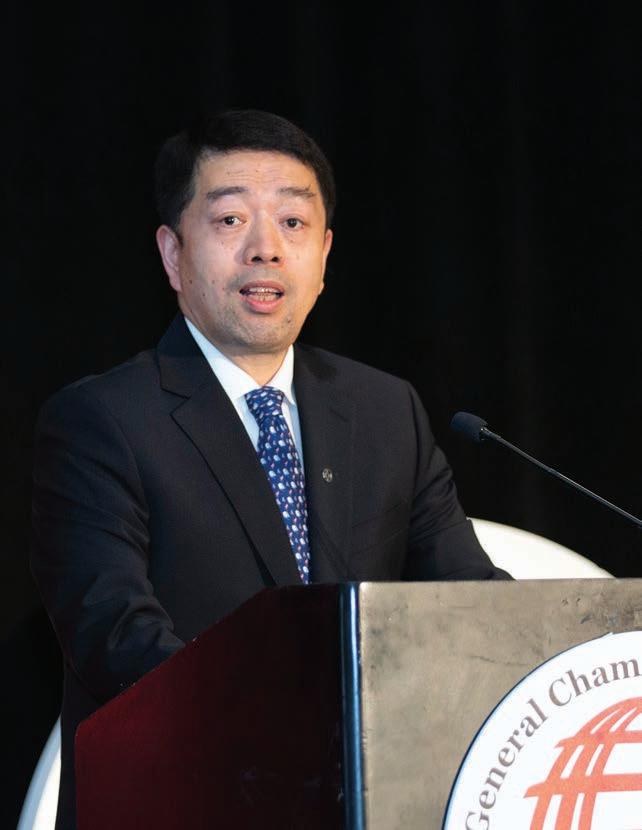
Much of our success in bridging the world’s two largest economies is in part thanks to the unique business capabilities of our bank. We have a deep understanding of the local rules, regulations and market practices, which helps us guide our Chinese clients’ in vestments in the U.S. market in a more effective way. We enjoy the advantage of having vast networks in China and bilingual and cross-time zone service capabilities, which provide our U.S. clients greater opportunities around the world. The broad spectrum of products we offer and the impactful collaboration we provide together with our ex perienced staff, have enabled us to build a strong brand and reputation as a stable and long-term partner for our clients.
While changing policies and cultural challenges can at times cloud the relationship, China’s trade with the United States has led to global business growth and massive cost savings for both businesses and consumers. Enhancing business-to-business and peo ple-to-people engagement between our two countries, finding “win-win” solutions, has always been a bedrock of the Bank’s success in the market. BOC U.S.A.’s time-honored presence in the U.S. is a testament to the value we have created for our clients and local communities, and our commitment to building a world-class bank.
”
Will you discuss Bank of China USA’s presence in the United States and its long and deep commitment to New York?
What have been the keys to the strength and growth of Bank of China USA and how do you define the Bank of China USA difference?
www.bocusa.com POSTED WITH PERMISSION. COPYRIGHT © 2022 LEADERS MAGAZINE, LLC LEADERS245 VOLUME 45, NUMBER 4
Now is a great time to discuss the future of technology. We are near a tipping point where new technologies—such as artificial intelligence, blockchain, and big data—are about to dramatically change the way we live, think and bank. At the same time, the privacy, ethics and ac countability concerns relating to data and artificial intelligence may also generate complex questions. The Bank is actively investing in our response to these opportunities and challenges.
Technology is a powerful driving force to transform the customer experience, enhance our service capabilities as well as operating effi ciency, and to assist in building our capabilities in risk management. Our bank has invested significantly in artificial intelligence technol ogies and we have achieved breakthroughs on multiple fronts. In the area of cybersecurity, we developed an in-house AI-powered system, which can automatically detect and prevent potential cybersecurity risk events. In terms of product innovation, we launched a new auto mated online lending service to small and medium-sized enterprise clients in the U.S. that offers a complete end-to-end digital experi ence. Furthermore, we have leveraged artificial intelligence and ma chine learning to build tools to prevent fraud, financial crimes, money laundering, and terrorist financing. We have also made breakthrough progress in refining our IT systems through ongoing digital transfor mation to integrate digitalization and automation into our customer service, business processing and risk management frameworks.
At BOC U.S.A., we are committed to improving our services to bet ter assist corporate customers globally, to facilitate trade and invest ments between China and the U.S., as well as to support the local economy and community. Technology is a key driver in the evolving world of financial services, and we will continue to invest consider able resources for many years to come.
Our overarching corporate responsibility goals are driven by BOC Group, and leadership is very supportive of our efforts to tailor our community engagement to the needs and nuances of our local mar kets. It is a top priority for the Bank, and our employees, to be active participants in the communities in which we operate as well as to lead the way in corporate social responsibility. We contribute funds to key organizations throughout the year and offer our employees opportuni ties to volunteer in different programs, so that our partners know that the Bank is invested in their well-being as well as the well-being of our shared communities.
Bank of China’s community engagement in the U.S. is focused on im proving the lives of citizens in our neighborhoods, building econom ic value and creating a positive impact on the environment. This is why our local community support includes volunteering for the Big Brothers Big Sisters of New York Workplace Mentoring Program, do nating to the Jump$tart Coalition, improving financial literacy among students across the U.S., and sponsoring the Juilliard School in support of their arts education programs for New York City public schools, to name a few. To help fight the COVID-19 pandemic, especially in the beginning of the outbreak amid shortages of proper protective equip ment in local hospitals and senior care facilities, as well as among the New York City Police Department, the New York City Department of Sanitation, and the U.S. Postal Service, BOC U.S.A. donated more than 130,000 pieces of personal protective equipment to assist in their efforts to combat the pandemic.
Additionally, we feel that it is important for Bank of China to use our position and heritage to help bridge the cultural gap between the U.S. and China, and continually seek out ways to support Chinese commu nities in the U.S. as well as to inform people of the numerous ways in which China and the U.S. can in fact work together to positively benefit both nations. To accomplish this, we provide support for or ganizations like the China Institute and the annual Columbia China Business Conference at Columbia Business School. We also work with the China General Chamber of Commerce U.S.A. (CGCC) Foundation to support its mission of increasing communication, understanding and cooperation between the business communities of our two nations. That partnership includes our most recent support for CGCC’s con tributions to the annual SelectUSA Investment Summit, dedicated to promoting foreign direct investment in the U.S.
In November 2021, we proudly celebrated 40 years of continued oper ations in the U.S., demonstrating our commitment to the market and its people. We are looking forward to the next 10, 20, 40, 100 plus years in giving back to our community.

How is technology impacting Bank of China USA’s business and will you highlight Bank of China USA’s investment in technology?
How important is it for Bank of China USA to be engaged in the communities it serves and to be a leader in corporate responsibility?
www.bocusa.com POSTED WITH PERMISSION. COPYRIGHT © 2022 LEADERS MAGAZINE, LLC LEADERS 246 VOLUME 45, NUMBER 4
CGCC Annual Business Survey Report on Chinese Enterprises in the U.S.

Since 2014, the Annual Business Survey on Chinese Enterprises in the U.S. has been one of the flagship projects of CGCC and CGCC Foundation. The survey aims to identify key trends and overall business sentiment of Chinese enterprises in the U.S. and provide readers with the opportunity to gain deeper insights into the development of these industries.
Each year, CGCC sends out well-designed questionnaires to hundreds of Chinese companies operating in the U.S. and receives valuable first-hand information that reflects the current U.S. business environment. The writing and publication of the report shed further light on both the impacts and contributions of Chinese enterprises to the U.S. economy and local communities and the challenges these enterprises face while operating in the U.S.

POSTED WITH PERMISSION. COPYRIGHT © 2022 LEADERS MAGAZINE, LLC LEADERS247 VOLUME 45, NUMBER 4
2022 Survey Key Findings
Estimated performance results for 2021 show that revenue, profi tability, and Earnings Before Interest and Taxes (EBIT) margins rebounded from the last two years, as Chinese companies took profitability improvement and business growth as primary objectives.
29% of respondents reported moderate or substantial improvement (6% in 2021 result). 24% of respondent companies made new investments in the U.S. in 2021. That number doubled results for 2020. Energy, materials, financials and IT companies indicated the highest level of satisfaction and expansion.




www.cgccusa.org
Company performances stabilize and slowly recover from disruptions since the pandemic.
Company satisfaction of the U.S. investment and business environment rebounded, but the results vary in sectors. POSTED WITH PERMISSION. COPYRIGHT © 2022 LEADERS MAGAZINE, LLC LEADERS 248 VOLUME 45, NUMBER 4
1. 2.
regulatory environment, difficulty attracting and retaining talent, and a strained U.S.-China relationship.




About half of the companies (49%) forecast an increase of revenue over the next two years, and 27% of respondents (12% in 2021 results) expect more business investments will be made in 2022. However, companies’ U.S. operations face mounting pressure to sustain contributions to their global revenues and support from parent companies.
As U.S.-China relations grow complicated, the general hostilities and antipathy towards China force Chinese companies to be challenged on various fronts in this stalemate. Only 10% of respondents see bilateral relations improving in the upcoming year, the lowest since 2018. 19% of respondents (39% in 2021 result) foresee that the U.S.-China economic and trade relations will moderately or substantially improve in 2022.
www.cgccusa.org
While companies continue to be optimistic about their opportunities in the U.S., that optimism is in decline due to sustained trade disruptions, an increasingly uncertain
3. 4. POSTED WITH PERMISSION. COPYRIGHT © 2022 LEADERS MAGAZINE, LLC LEADERS249 VOLUME 45, NUMBER 4
Dimmed expectations of the future U.S.-China relationship.
Featured Insights: Legal and Compliance

• About 80% of respondents have a general compliance policy, but some important, specific compliance programs are lacking at most firms. Only 52% of the companies have internal staff handling compliance matters.
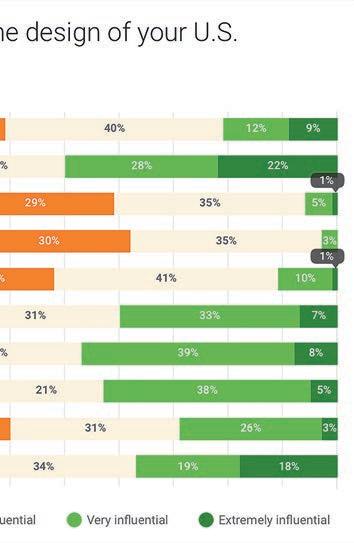
• U.S. regulators and companies’ Chinese headquarters play a crucial role in the design of the compliance programs. The role of in-house compliance directors should be elevated.


• Both the compliance staff and compliance budgets increased slightly in 2021.
• Complexity of U.S. laws and regulations and potential conflicts of rules between the U.S. and China are the top challenges for Chinese firms, reflecting the growing tensions between the two countries.

www.cgccusa.org
POSTED WITH PERMISSION. COPYRIGHT © 2022 LEADERS MAGAZINE, LLC LEADERS 250 VOLUME 45, NUMBER 4
Featured Insights: Brand and Trust


• Chinese companies in the U.S. face critical challenges in brand and trust.

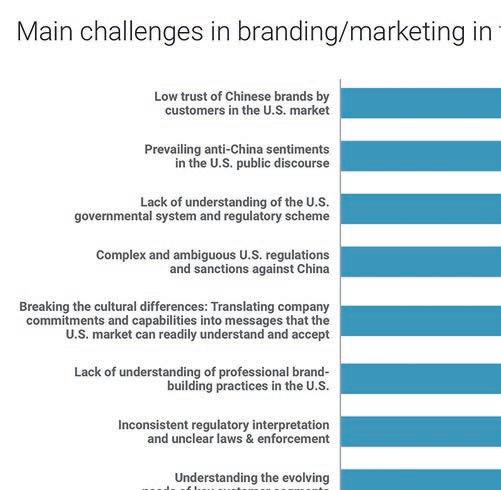
• Companies’ brand strategies are impacted by their evolving objectives, challenges, and the structures of their functional departments.

• Companies are taking actions on societal issues to raise brand awareness and earn trust in the market, but the areas of focus are not entirely aligned with topics of concern to the U.S. public discourse.
• Chinese companies are being relatively conservative in adopting brand strategies to defend their traditional comparative advantages. This stresses the need for companies to invest in building resonating brands with compelling stories and intangible assets.

www.cgccusa.org POSTED WITH PERMISSION. COPYRIGHT © 2022 LEADERS MAGAZINE, LLC LEADERS251 VOLUME 45, NUMBER 4
Believe in Travel
An Interview with Michelle Woodley, President, Preferred Hotels & Resorts

EDITORS’ NOTE As President of Preferred Hotels & Resorts, Michelle Woodley oversees multiple departments across the company including sales, marketing, IT, revenue management, and customer relations. During more than 15 years with the company, she has held various leadership positions with cross-functional responsibilities including Senior Vice President of Global Marketing Strategy, Senior Vice President of Distribution & Revenue Management, and Executive Vice President, the role she held prior to her promotion to President in January 2018. In 2018, several months after she was named President, she received recognition by Hotel Management as one of the most influential women in hospitality. Before joining Preferred Hotels & Resorts in 2002, Woodley spent five years as Vice President of Distribution for Swissôtel and Raffles Hotels & Resorts, charged with overseeing the strategic direction and operations of the company’s electronic distribution and database solutions. She held various senior positions in operations, marketing, and distribution with Swissôtel from 1990 to 1997. She has been an active board member in industry organizations throughout her career. She is currently on the Americas Board of Directors of the Hospitality Sales & Marketing Association International (HSMAI), and also serves on the Board of the HSMAI Foundation. She served two terms as president and two terms as vice president of the Hotel Electronic Distribution Network Association (HEDNA), and she was a founding member of the Open Travel Alliance (OTA) and served two terms on their board of directors as treasurer. Woodley is a graduate of the Cornell University School of Hotel Administration.
COMPANY BRIEF Preferred Hotels & Resorts (preferredhotels.com) is the world’s largest independent hotel brand, representing more than 650 distinctive hotels, resorts, residences, and unique hotel groups across 80 countries. Through its five global collections, Preferred Hotels & Resorts connects discerning travelers to a luxury hospitality experience that meets their life and style preferences for each occasion. Every property within the portfolio maintains the high-quality standards and unparalleled service levels required by the Preferred Hotels &
Resorts Integrated Quality Assurance Program. The I Prefer™ hotel rewards program, Preferred Residences™, Preferred Pride™, and Preferred Golf™ offer valuable benefits for travelers seeking a unique experience.

Will you highlight the history of Preferred Hotels & Resorts and how the business has evolved?
Preferred was founded in 1968 as a small hotel association made up of 12 North American hoteliers who provided similar guest services and quality standards and could serve as a mutual referral organization. Today, the company is owned and operated by the Ueberroth family and is the parent company for six brands: Preferred Hotels & Resorts, Beyond Green, Historic Hotels of America, Historic Hotels Worldwide, PTG Consulting, and Beyond Green Travel, representing more than 1,100 hotels, resorts, and residences across 80 countries, in addition to a global portfolio of
destinations such as Suzhou and Nanjing in China; Guadalajara, Puerto Vallarta, and Baja California in Mexico; and Honduras.
How do you define the Preferred culture?
As something we are proud of and work to enhance every day, we have created a culture that celebrates individuality and diversity across the board – from the teams at our member hotels to our global team of associates. We champion our differences and see them as a strength in our business.
We think of Preferred as a global family, and our values serve to inspire and engineer potential to co-create brighter futures for our associates and our hotel partners. This is fundamental to our brand promise and ideology, Believe in Travel, which gives direction to our culture and is something we have really leaned into over the last few years. I see our ideology demonstrated every day through our teams and their engagement, as well as touchpoints with hotel members and industry partners. We encourage everyone to explore their passions and, most importantly, to have fun.
HOSPITALITY HOSPITALITY
Michelle Woodley
POSTED WITH PERMISSION. COPYRIGHT © 2022 LEADERS MAGAZINE, LLC LEADERS 252 VOLUME 45, NUMBER 4
The Vault cocktail bar at INIALA HARBOUR HOUSE & RESIDENCES in Malta
Like most companies, we took a closer look at how to be more efficient and closely examined all our processes. We streamlined, cross-trained, and upskilled our associates so that they could continue to provide timely and effective service to our hoteliers and maintain excellent relationships with travel buyers. During the most challenging times, we worked even more closely with our member hotels and supported them by developing action plans based on their individual needs, and worked extensively with our regional leaders to conduct town halls that engaged hoteliers and supplied them with actionable information on financial loans, health and sanitation, distribution, employee wellness, and market trends. We took a similar approach with travel buyers across all segments, including group, corporate, and leisure, to ensure that we were up to date with regional travel trends to keep the Preferred family of brands top-of-mind.
Collaboration and communication were the keys to making it through the pandemic, ensuring that we actively listened to voices within our community so that we could collectively manage our way through the pandemic together. We continue to do much of this now, which is a positive to come from the pandemic.
Where do you see the greatest opportunities for growth for Preferred Hotel Group?
The most significant growth opportunities for Preferred Hotel Group are to continue to increase the footprint of our four hotel brands, namely Preferred Hotels & Resorts, Beyond Green, Historic Hotels of America, and Historic Hotels Worldwide; developing the reach and global membership of our loyalty program I Prefer Hotel Rewards; and expanding in-house capabilities for our award-winning consulting brand, PTG Consulting, which serves the tourism and hospitality industry’s most dynamic brands, destinations, and hotels.
Our largest hotel brand is Preferred Hotels & Resorts and so a lot of efforts are focused on the strategic growth and retention of the global portfolio which comprises more than 650 hotels, resorts, and residences in approximately 80 countries. Our top priority is to welcome independent hotels that share our quality standards and commitment to offering the finest independent hotel experiences. In 2021, we welcomed more than 40 new properties to the brand portfolio, and so far, in 2022, we have added another 30 new member hotels, including La Casa de La Playa in Mexico, INIALA HARBOUR HOUSE & RESIDENCES in Malta, and Virgin Hotels Dallas in Texas. In recent months, we have also helped to launch brand new hotels such as Sommerro in Oslo, Hotel Per La in California, The Fullerton Ocean Park Hotel Hong Kong, and The Wall Street Hotel in New York City. Hotel owners are turning to Preferred as they view us as less restrictive and a valuable alternative to what may typically be found with a hard brand.
Our loyalty program, I Prefer Hotel Rewards, continues to evolve globally as the largest pointsbased loyalty program for independent hotels with over 4.5 million members today. Over the last 18 months, we have rolled out program enhancements to appeal to members, including the introduction of our first ever I Prefer Gift Cards. I am excited to see the momentum behind this program as we continue to invest and expand to drive bookings to our valued hotels.
Another growth area for us is our consulting brand – PTG Consulting. This brand provides strategic solutions and services to destination and hotel clients, such as strategic planning, travel trade representation, revenue for hire, sales representation, public relations, and social media, to name just a few. We leverage our experience in the industry and our global network to drive and support their success and we continue to invest in growing this area of our business as demand for consultancy services increases.
How
is Preferred focusing on sustainability?
We launched our sustainable hotel brand, Beyond Green, in April 2021 to address the deepening importance of sustainable luxury travel. The portfolio currently consists of 26 properties with each member hotel subject to a rigorous selection process to ensure that their offering is genuinely sustainable and sets the standards for others who want to follow. Preferred Hotel Group also has its core social responsibility program, GIFTTS, which stands for Great Initiatives for Today’s and Tomorrow’s Society. The program was introduced in 2006 to platform Preferred Hotel Group’s corporate social responsibility initiatives and to support the environmental and socially beneficial work taking place globally at our member hotels.
Through the GIFTTS program, we have formed long-standing philanthropic partnerships with organizations such as Wine to Water, ECPAT, NOW, and Clean the World. We have a much stricter travel policy and offset our team’s carbon footprint for necessary air travel by making charitable donations to ClimateCare. We also provide guidance and best practices to the independently operated member hotels within the Preferred Hotels & Resorts portfolio that are seeking ways to improve their sustainability footprint.
Will you highlight your role as president of Preferred Hotels & Resorts and how you focus your efforts?
My role as president is to ensure that our company is continually connecting the dots between our commercial, back-of-house, and regional teams to ensure that everything we do provides value to our hotels and clients. I am in contact with associates across the globe as well as hoteliers and travel buyers daily and spend a lot of time listening to and synthesizing our clients’ needs with our actions.
You joined Preferred in 2002. What has made the experience so special for you over the past 20 years?
Over the past two decades we have seen great successes for the brand as it continues
to develop; it is rewarding to be a part of a company that keeps progressing. Since joining Preferred Hotel Group, I have been privileged to see Preferred Hotels & Resorts become the world’s largest independent hotel brand; the addition of Historic Hotels of America and Historic Hotels Worldwide to our family of brands; the launch of our sustainable hotel brand Beyond Green; and the development of new lines of business like PTG Consulting. From a personal perspective, no two days are the same. Each day I strive to learn something new or teach something to someone else. I love what I do and am fortunate to do it for a company and in an industry where I am passionate about the work and surrounded by talented people. I understand the responsibility I have in leading a team and do not take any of it for granted.
Do you feel that there are strong opportunities for women to grow and lead in the hotel business?
There are definitely more opportunities. When I first started my career in hospitality in the early 1990s, I was the only woman on the executive team, and I knew of just two female general managers for a portfolio of 32 hotels. Today, we are fortunate enough to effect change in our industry. Through the Preferred Hotels & Resorts brand, we are honored to work with women leaders such as Sheila Johnson, CEO of Salamander Resorts, and Sally Beck, General Manager at Royal Lancaster, London, to name a few. At Preferred Hotel Group, over 40 percent of our Executive Team are women, including the Chief Executive Officer, President, and Chief Revenue Officer.
Although we see more women taking on leadership roles in hospitality, there is still work to be done. Diversity of thought and approach is vital to a prosperous workplace. By having women and men in top management, a valuable mix of perspectives in collaboration, communication style, and change management are enabled which helps a company make well-rounded decisions. Women should look to successful people of either gender in their lives as role models to help develop their own sense of self and reach their potential.
What advice do you offer young people interested in a career in hospitality?
I have a few pieces of advice. First, you are entering the hospitality industry – which, by definition, has the mission of receiving and hosting guests. Whether you are headed down the path of operations, finance, or marketing, do not forget to always be the consummate host. Second, go into every meeting to learn something new. Even if you do not think the subject is interesting or relevant, there is always something to be learned. Next, ask questions – especially of your customers. Whenever possible, do it in person. Their insights are what will help you build your business. Finally, the hospitality business offers numerous career opportunities and is one of the most borderless industries. It is rewarding every single day –enjoy it and have fun.•
How did Preferred adapt its business to address the challenges caused by the global pandemic?
POSTED WITH PERMISSION. COPYRIGHT © 2022 LEADERS MAGAZINE, LLC LEADERS253 VOLUME 45, NUMBER 4
In the Heart of Beverly Hills
EDITORS’ NOTE Offer Nissenbaum has held his current post since December 2007. Prior to joining Peninsula, he was Regional Vice President of Operations for Omni Hotels, based in New York City, overseeing eight properties on the East Coast. He concurrently served as Omni’s corporate liaison to the Global Hotel Alliance, which includes international luxury brands Kempinski, Pan Pacific, Dusit and Leela. Nissenbaum received the coveted “Hotelier of the Year” award from Virtuoso, the prestigious global organization of luxury travel specialists.

PROPERTY BRIEF The Peninsula Beverly Hills (peninsula.com/beverlyhills) has earned the AAA Five Diamond and Forbes Five Star awards every year since 1993, one of the very few hotels in Southern California to have earned both accolades. Nestled in lush tropical gardens in the heart of Beverly Hills, the iconic luxury property features 195 elegantly-appointed
rooms, including 38 suites and 18 private villas; The Belvedere, the only AAA Five Diamond-rated restaurant in Los Angeles for 19 consecutive years; The Living Room, home to the legendary Peninsula Afternoon Tea served daily; The Roof Garden for alfresco dining; as well as The Peninsula Spa.

Will you provide an overview of The Peninsula Beverly Hills and how the property is positioned in the market?

Our location has great appeal because we are in the heart of Beverly Hills. Our guests can walk to the best shopping and dining in the area, while our property backs up to a quiet residential area. It is the perfect balance and I think that appeals to our guests. In total we have 195 guest rooms, including 38 suites and 18 private villas that provide the ultimate home away from home for our repeat guests. The Beverly Hills market is competitive as there are several luxury hotels, but we are all
very different. We also have a very loyal, local following for our spa as well as afternoon tea, restaurants, and bar.
How did The Peninsula Beverly Hills adapt the way it works to address the challenges caused by the pandemic?
As the effects of the pandemic began to unfold, one of our goals was to remain open as long as we could provide a healthy and safe environment for both our employees and guests. Initially, we were a safe haven for many guests who could not return to their homes, but as the pandemic continued, we became a sanctuary for locals to get away or celebrate. In truth, we are still adapting to continually provide incredibly personalized experiences while ensuring we maintain a safe and healthy environment.
Cleanliness has always been a top priority for us, but the pandemic brought to light a new level of hygiene that was required. Now, we have the ability of taking things that we learned and incorporating best practices indefinitely to maintain these levels.
How proud are you to see the strength and resilience displayed by The Peninsula Beverly Hills’ team during this unprecedented time?
I am so proud of the team and equally appreciative of the support of our local ownership and Peninsula. Since we were deemed an essential business, we hosted guests throughout the entire pandemic, but business levels were significantly affected by local and state restrictions. Our restaurants shifted from fully open to only outdoor dining and at one time to only to go orders.
HOSPITALITY HOSPITALITY
Offer Nissenbaum
An Interview with Offer Nissenbaum, Managing Director, The Peninsula Beverly Hills
Traditional Afternoon Tea, served in The Living Room, includes free-flowing Champagne, one-of-a-kind teas, and a tower of delectable sweet and savory delights
POSTED WITH PERMISSION. COPYRIGHT © 2022 LEADERS MAGAZINE, LLC LEADERS 254 VOLUME 45, NUMBER 4
The Peninsula Beverly Hills is the only AAA Five Diamond and Forbes Five Star-rated hotel in Southern California every year since 1993
Will you discuss The Peninsula Beverly Hills’ focus on offering personalized service and a customized guest experience?



Our priority, first and foremost, is to create memorable experiences for our guests – creating this culture on a daily basis is what makes them come back. We pay particular attention to our guest’s individual requests and focusing on these details commands an unrivaled level of personalization. This is our DNA, which is why we have over a 70 percent return rate.
Will you highlight the strength of The Peninsula Beverly Hills suite offering and do you feel this is a differentiator for the property?
We have 38 suites and 18 villas, ranging from a studio to our three-bedroom Peninsula Villa. Our villas are such a unique product because they are completely separate buildings, and each offers private entrances with a very residential feel. Any guest who rents a suite can receive complimentary use of a BMW for the
duration of their stay. We offer a fleet of cars including SUVs, sedans and convertibles, and we provide them with full fuel as well as extend complimentary parking. This is an incredible value that our guests truly appreciate.
How critical is it for The Peninsula Beverly Hills to build a diverse and inclusive workforce to mirror the diversity of the guests it serves?
We draw guests from all over the world who represent a variety of cultures, nationalities, and religions. The diversity of our employees has always been cherished and celebrated, and I feel it is critical to our success.
How do you define the role of the general manager and what are the keys to being effective in the role?
Give people the goal or task and let them run with it. Give them the freedom to execute. Encourage creativity and innovation. Ensure accolades are truly felt by the team because they deserve it. As I mentioned before, our team members are the heart and soul of the hotel, and it is through them that we achieve excellence. Create a culture that empowers everyone to speak up at any level.
You have spent your career in the hotel industry. Did you always know that you had a passion for the business and what has made the industry so special for you?
I first developed my interest in the industry from my uncle, who was a successful hotelier for over 40 years. This industry has given me a rewarding, multidimensional career to run a business, meet guests from all walks of life, and work with amazing employees.
What advice do you offer to young people interested in building a career in the hotel industry?
Patience, discipline, and hard work are the best pieces of advice I can give. Young people tend to be focused on their next promotion, but I encourage them to be a sponge and take the time to experience all aspects of the operation. Look at every position as an opportunity to gain the most experience possible, understanding that it is an investment in the future. •
The Grand Deluxe Pink Suite patio offers spectacular views of this exclusive oasis in the City of Angels
The elegant Grand Deluxe Blue Suite bedroom features Venetian accents and French doors
POSTED WITH PERMISSION. COPYRIGHT © 2022 LEADERS MAGAZINE, LLC LEADERS255 VOLUME 45, NUMBER 4
Surrounded by panoramic views of the Los Angeles skyline, the hotel’s 60-foot outdoor rooftop pool, hot tub and private cabanas offer hotel guests an idyllic spot to relax and rejuvenate
Seabourn Moments
An Interview with Josh Leibowitz, President, Seabourn
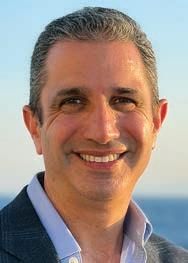
EDITORS’ NOTE An analytically driven leader with a passion for running and advising consumeroriented companies and serving on board roles, Josh Leibowitz is the President of Seabourn. He was previously the Managing Partner of McKinsey & Company’s Miami office and a leader in the firm’s work in advanced analytics and profit transformations. Leibowitz worked extensively for leading luxury travel, retail, and media companies on demand generation, customer experience, and growth strategies. His work included due diligence and deal support for private equity and investment companies. Leibowitz was previously a Managing Director at Idealab, an innovation incubator that creates and operates pioneering technology companies, where he successfully led several e-commerce startups. Prior to that, he started and operated a wholesale and retail shoe business in Los Angeles. He is a frequent blogger and speaker on the topic of being an avid vacation defender including at TEDx Coconut Grove. Leibowitz received an AB in economics from the University of Chicago, Phi Beta Kappa, and holds an MBA from Harvard Business School, with High Distinction, Baker Scholar.
COMPANY BRIEF Seabourn (seabourn.com) currently operates a fleet of six ultra-luxury modern ships with one under construction and is a proud member of the World’s Leading Cruise Lines, an exclusive alliance that includes Carnival Cruise Lines, Holland America Line, Princess Cruises, Cunard Line, Costa Cruises, AIDA, P&O Cruises UK, and P&O Cruises Australia. Seabourn is a brand of Carnival Corporation plc. The company considers that its highest responsibilities and top priorities are compliance, environmental protection, and the health, safety and well-being of its guests, team members, and the people and communities its ships visit.
Will you highlight the history of Seabourn and how you define the Seabourn difference?
Seabourn is a pioneer of small ship, ultraluxury cruising that has earned unanimous accolades from travel guidebooks, travel critics and traveler polls since its launch in 1987. Sailing on Seabourn is unlike any other form
of travel. The experience is luxurious, yet relaxed; elegant, yet casual. We take guests to the word’s best destinations including Antarctica and the Artic on our new expedition ships, and the Mediterranean, Caribbean, Alaska, Iceland, Australia, and South America on our luxury ocean ships.
We deliver transformational travel moments, meaningful connections and life-expanding experiences that move guests and help them see the world in new ways. We combine the most luxurious accommodations, highest quality dining, personalized service, intimate ships, and active lifestyle into ocean and expedition voyages that cover all seven continents and more than 400 destinations on the youngest and most beautifully designed fleet. Our intimate ships visit the most desirable destinations worldwide, sailing to the heart of landmark cities, as well as to hidden gems where larger vessels cannot follow.
Will you provide an overview of Seabourn’s fleet?
We have six beautiful ships in our fleet, with the youngest and most luxurious fleet and one of the highest space per guest ratio in the industry. Our guests want smaller and more intimate accommodations that are all suites and rival the most luxurious land-based options with more space, all-oceanfront suites, and all included in-room amenities. They want every suite to be impeccable with options to expand into the highest and most coveted upgrades.
Carrying just 458 guests each, Seabourn Odyssey , Seabourn Sojourn , and Seabourn Quest offer a wealth of onboard touches and luxuries to assure smooth sailing whatever the destination. Guests can look forward to spacious accommodations ranging in size from 295 to 1,182 square feet of indoor space. Verandas add an additional 65 to 558 square feet of outdoor living area, spacious enough for private al fresco dining. All suites on board feature a comfortable living area, walk-in closet, a fully stocked bar and refrigerator filled with seaside favorites and have expansive ocean views framed by either a picture window or the glass doors of the veranda.
Between 2016 and 2018, the line introduced two new ships – Seabourn Encore in December 2016 and Seabourn Ovation in May 2018. The
ultra-luxury vessels have been designed in partnership with design icon, Adam D. Tihany, as an evolution of its Odyssey-class fleet. The new ships offer oceanfront suites with private verandas, for just 600 guests, based on double occupancy, configured with one additional deck and an enhanced and central common living space with a reimagined Seabourn Square.
In July 2022, Seabourn launched its first new ultra-luxury purpose-built expedition ship, Seabourn Venture. The ship, designed by Tihany Design, was planned from conception for expedition travel blended with ultra-luxury and personalized service by leading travel experts and seasoned professionals with great depth of experience in expedition, hospitality, and luxury cruising. The second ship, Seabourn Pursuit, is expected for delivery in September 2023.
Will you elaborate on Seabourn’s newest ship, Seabourn Venture, and how will this ship mark Seabourn’s entrance into expedition cruising?
Expedition travel has been increasingly in demand by luxury travelers over the past several years, and we saw this firsthand when we launched our voyages to Antarctica in 2013. It was the success of those itineraries that led us to return every year since and eventually to the development of our Ventures by Seabourn programming of expedition-style shore experiences aboard Zodiacs and kayaks. This programming has since expanded to operating in global destinations such as Alaska/British Columbia, Northern Europe, and Australia/New Zealand. In addition, this laid the foundation for us to confidently order and build our two new purpose-built expedition ships – Seabourn Venture and Seabourn Pursuit – which will give our guests even more opportunities to deepen their connectivity to some of the world’s most remote destinations.
With the launch of Seabourn Venture, we’re offering a true ultra-luxury expedition product that’s unlike any others on the market. It also allows us to put a stake in the ground in a new type of expedition cruising that we’ve dubbed “active luxury.” Active luxury combines Seabourn’s renowned service and ultra-luxury amenities with an innovative, active experience that brings travelers to the far reaches of the globe that can only be accessed by ship to enjoy the same types of thrills they may have come to expect from a safari or other land-based adventures.
HOSPITALITY HOSPITALITY
Josh Leibowitz
POSTED WITH PERMISSION. COPYRIGHT © 2022 LEADERS MAGAZINE, LLC LEADERS 256 VOLUME 45, NUMBER 4
There are only 264 guests on board in 132 suites, and we have 26 expedition team members to serve those guests, nearly one for every 10 guests. These team members will not only offer their expertise and guidance about the natural world, but also offer the exemplary service for which Seabourn is renowned. There are countless amenities and innovations we are offering on board that are redefining the future of travel, not just cruise. Not only is the ship designed to go anywhere in the world, it also boasts submarines that allow guests to jump in and see life below the surface. The real measurement of luxury service is the ship’s capability to offer something for everyone. There are 24 Zodiacs on the ships so every guest can experience landings wherever we sail plus kayaks, snorkeling, and scuba gear. There are eight different dining options and state-of-the-art facilities such as the Bow Lounge, where close-up live feeds of wildlife up to four nautical miles away can be projected on the big screen for the ultimate wildlife experience.
How is Seabourn taking a lead in defining a new category of travel for guests seeking a convergence between learning, exploring and ultra-luxury pampering?
We’ve designed our new expedition ships in partnership with some of the best and brightest in the worlds of travel, expedition, fine dining, and luxury cruising who came together with the same objective: to create an environment that evokes a social and inquisitive vibe,
but follows the traditions of expedition travel. We want guests to share in these experiences of a lifetime with not only one another, but also our onboard teams.
Our intention is to also welcome travelers who may have never considered cruise travel and expose them to the quality, decadence, and convenience of a voyage with Seabourn, whether that is land-based adventurers who typically choose epic climbs, treks or adventure campaign experiences, or a younger generation of expedition-seeking travelers. We feel like our new ships blend expedition and luxury elements in a new way that will evoke a positive response from a wider range of travelers than ever before.
You assumed the role of president of Seabourn during the global pandemic in the middle of 2020. How did Seabourn adapt its business to address the challenges caused by the pandemic and how proud are you to see the resilience of the Seabourn workforce during this unprecedented time?
The past two years have been incredibly challenging to say the least. During this unprecedented time, it was important to be flexible and listen – to the experts, our team members, the science, and our guests. I am so proud to see how the entire Seabourn family came together and supported each other – both professionally and personally. We learned to adapt and worked harder than ever to prepare our ships to return to service,

and now our entire fleet is back in operations and our team is delivering special Seabourn moments to guests every day. I am proud to lead a team who overcame these extraordinary circumstances.
How is Seabourn adapting to meet the ever-evolving needs in a post-Covid world?
At Seabourn, our highest responsibility and top priorities are compliance, environmental protection and the health, safety and well-being of our guests, team members, and the people and communities our ships visit. The focus on health and safety was emphasized even more during the pandemic and even after the pandemic. Guests are seeking environments where they can feel confident, comfortable, and safe, and we strive to provide this every day. We have required vaccination, testing, and onboard medical to support guest needs. We work closely with health officials from all over the world to ensure that we are meeting and complying with health regulations and protocols.
Luxury is a word that is used often today. How do you define the meaning of a true luxury cruise experience?
True luxury cruise today is so much more than just about the amenities – of course you need to offer incredible accommodation and impeccable service, all things we excel at, but it’s also about the emotional connection that we have with our guests.
I think what sets Seabourn apart in this respect is how far we go as a brand to connect and provide those special Seabourn moments. We really want to care for, inspire and surprise those who travel with us, and I believe we do that throughout the whole journey, and through the incredible experiences we offer both on and offshore – we really aim to exceed guest expectations – that is luxury. The personal connection we can provide guests due to our generous staff ratios means that everything from a personalized kayak tour in Antarctica to al fresco dining on your private veranda is all possible. It’s all about these Seabourn moments that enable our guests to live their largest possible life.
What do you see as the keys to effective leadership and how do you describe your management style?
Every day we start with a team huddle. The agenda and format are highly focused on decision-making and aligned on the priorities that drive our business. We are all focused and aligned on three priorities: to operate safely and professionally; to deliver Seabourn moments; and to support each other in achieving our individual and professional goals.
What advice do you offer to young people interested in building a career in hospitality?
The goal of hospitality is to exceed guest expectations. Seabourn does this every day. If you are interested in hospitality, immerse yourself in the brands and destinations that have the highest guest demand. Seek a mentor in the space. Take on an internship. Have a point of view. Go for it. Come join the industry.•
POSTED WITH PERMISSION. COPYRIGHT © 2022 LEADERS MAGAZINE, LLC LEADERS257 VOLUME 45, NUMBER 4
Josh Leibowitz in front of Seabourn Venture
The Peninsula Experience
EDITORS’ NOTE With more than 20 years of experience in the hospitality industry, Rolf Buehlmann’s previous position began in January 2018 when he moved to Hong Kong to assume the position as Vice President, Rooms Operations and Quality, for The Peninsula Hotels. During the past four years, he has led the enhancement of the guest experience for Front Office, Housekeeping and Spa as well as being instrumental in the group’s innovation and technology efforts across the global rooms’ operations. Prior to his position in Hong Kong, Buehlmann was Resident Manager at The Peninsula Bangkok, a position he held for four years. His service with the company began in 2010 when he joined as the Executive Assistant Manager at the prestigious Hong Kong Club which is managed by Peninsula’s Clubs and Consultancy Division. During his time there, he drove the club’s major renovation project which included redefining its food and beverage concepts, facilities, offerings, service quality and processes. Buehlmann has always been a hotelier and prior to his career bringing him to Hong Kong, he held various posts in the Chinese mainland, the United States, and his home country of Switzerland. Buehlmann holds a BS degree in international hospitality management from the Lausanne Hospitality Management School, Switzerland.

PROPERTY BRIEF The Peninsula New York (peninsula.com/new-york) occupies an elegantly restored, 23-story, Beaux-Arts landmark building on Fifth Avenue in the heart of Manhattan’s prestigious shopping, cultural and business neighborhoods. Featuring 233 rooms and suites equipped with state-of-the-art technology, a glass-enclosed spa and health club, rooftop bar and lounge, Salon de Ning, and the popular Clement restaurant, the property is the recipient of the AAA Five Diamond and Forbes Five Star ratings. The Peninsula New York is owned and managed by The Peninsula Hotels (peninsula.com), a division of The Hongkong and Shanghai Hotels, Limited.
Will you provide an overview of The Peninsula New York and how the property is positioned in the market?
Ideally located on Fifth Avenue and 55th Street in Midtown Manhattan, The Peninsula

New York is in the heart of the city’s most prestigious shopping, entertainment, and cultural district. The hotel is within walking distance of Central Park, Rockefeller Center, Fifth Avenue shopping, excellent restaurants, historic museums, and exciting Broadway theatres. Housed in a 23-story, 1905 landmark building, the hotel carries an old-world elegance with timeless interiors. There are 233 guestrooms and suites, one restaurant and three lounges including our rooftop bar, Salon de Ning, the awardwinning Peninsula Spa, a fitness center and an indoor swimming pool.
How valuable is it to have such a strong suite product at the property?
Having a good suite product is paramount, especially in New York. Our business success is very much defined in our ability
to occupy these large suites regularly. I don’t believe we have a suite product superior to other hotels in the same segment, but what I believe sets us apart is the service and discretion that comes with staying at The Peninsula. I believe that is what people appreciate and turns them into loyal guests.
How did The Peninsula New York adapt the way it works to address the challenges caused by the pandemic?
The pandemic has affected our industry fundamentally in that we are even more focused on our approach to health and hygiene. We have put in place stringent protocols to mitigate these health risks and the team is diligently following them. I think the pandemic has taught us that working remotely is possible, and we are taking advantage of that by having some of the back-of-the-house positions contribute to the Peninsula experience from their homes. In fact, we have a few team members working remotely
HOSPITALITY HOSPITALITY
Rolf Buehlmann
POSTED WITH PERMISSION. COPYRIGHT © 2022 LEADERS MAGAZINE, LLC LEADERS 258 VOLUME 45, NUMBER 4
An Interview with Rolf Buehlmann, General Manager, The Peninsula New York The entrance to The Peninsula New York on 55th Street off Fifth
Avenue
in other parts of the U.S. that help us reach out to guests to detail their stay and anticipate their stay experience.
Will you discuss The Peninsula New York’s focus on offering personalized service and a customized guest experience?


Personalization of a guest experience has always been our focus. Especially during these post-pandemic times, we have noted that guest needs and the anticipation thereof have become even more important. From a guest standpoint, we have adopted a highly flexible approach to their needs. For example, given the unpredictable nature of the pandemic as far as travel is concerned, guests are free to cancel by 6:00 PM, 24 hours prior to arrival. To provide even more flexibility, we have introduced Peninsula Time, our flexible checkin and check-out times policy for guests who book direct. This luxury benefit allows you to arrive as early as 6:00 AM and stay as late as 10:00 PM.
How critical is it for The Peninsula New York to build a diverse and inclusive workforce to mirror the diversity of the guests it serves?
Having a diverse and inclusive workforce is an integral part of our company culture. We are proud to have a diverse team and we value each of their experiences, expertise, and unique perspectives. In addition, the main attributes in today’s workforce we are looking at fostering is their ability to connect with our guests on
an emotional level. It is the emotional bond between guests that we believe is the “secret sauce” to today’s success for any luxury hotel experience and helps us to create a positive impact on our guests. Fostering these bonds is
significantly easier if the workforce mirrors the diversity of our guests.
How do you define the role of the general manager and what are the keys to being effective in the role?
We are in a people industry, and I believe that this is where most of my time should be dedicated. I am fortunate to manage a great team that tries to go above and beyond on a daily basis, and I see my role as the person that provides the resources for them to be successful. In order to do so, I stay close to them. I walk the hotel several times per day to talk to team members to ensure they have what they need to create great experiences for our guests.
What excited you about the opportunity to lead The Peninsula New York and made you feel it was the right fit?
Actually, I never thought that I would be offered the opportunity to move to the U.S. after having spent the past 15 years in Asia. However, I was excited to be asked to lead the team in this very important market. Having spent some years early in my career in the U.S., I am delighted to be back and I am rediscovering what makes this such a great place to live and work. The ease of conducting business, the availability of virtually anything, but above all the resilience of the city and its people is unparalleled. The way that New York has come out of the pandemic was eye opening and to me, this is indicative of what makes a city great.
What advice do you offer to young people interested in building a career in the hotel industry?
Work hard, stay humble, and work in departments where you can lead people and interact with guests. It’s all about people and human interactions – most technical skills can be learned.•
The Fifth Avenue Suite living area
POSTED WITH PERMISSION. COPYRIGHT © 2022 LEADERS MAGAZINE, LLC LEADERS259 VOLUME 45, NUMBER 4
Salon de Ning West Terrace
Creating Memories
EDITORS’ NOTE Sylvia Wong serves on the Board of Directors of WTI, Inc. and works closely with the company to identify, evaluate and negotiate acquisitions and other investment and financing transactions. Prior to working with WTI, Wong was an executive at IBM Corporation for over 15 years where she held a number of senior positions. From 2012 to 2015, she was IBM’s Chief Trust and Compliance Officer, based in the company’s headquarters in Armonk, New York. In that role, she led the global ethics and compliance program for the company’s 380,000 employees and business operations in more than 175 countries. From 2009 to 2012, she served as the General Counsel of IBM’s Growth Markets Unit, a $20 billion business with operations throughout the developing markets, including Asia, Latin America, Russia, Eastern Europe, Middle East and Africa. At the start of her career, she practiced law in New York City at the law firm Paul, Weiss, Rifkind, Wharton & Garrison, where she

specialized in mergers and acquisitions, financing, joint ventures and corporate transactions. Wong received her undergraduate degree in economics from Binghamton University and her law degree from New York University School of Law.
PROPERTY BRIEF In 2020, The Roundtree, Amagansett (theroundtreehotels.com) opened its doors in the beautiful enclave of New York’s Hamptons region. With just 15-rooms, this independently owned, luxury boutique property pays homage to Amagansett’s historic farmsteading legacy dating back to the 1700s, with nature-inspired details that embody the spirit of this idyllic destination. The Roundtree, Amagansett features five cottages (one of which is over 250 years old), and a combination of 10 rooms and suites housed throughout a 100-year-old barn and the main house. All of the property’s accommodations are renovated to include thoughtful amenities and modern accents that make for a luxurious stay year-round.


What was your vision for opening The Roundtree?
I have always loved traveling and have been fortunate to have accumulated many wonderful memories from my travels. The thought of going into hospitality some day had been lingering in the back of my mind for some time, but I did not have a specific plan on the right moment to pursue that path. In 2019, I stumbled upon a historic Hamptons property for sale. It was then called Gansett Green Manor and had been family operated for years and was most recently operated by a lovely couple. I wasn’t necessarily set on The Hamptons, but the more thought I gave it, the more it made sense with my home base being in New York City. I have a vivid memory of taking the Hampton Jitney to check out the property and remember how crisp and clean the air was and how beautiful the property looked. The property’s lush lawns, surrounding farmlands, and incredible history drew me in and there was no question that this would be the place I settled on.
Though the grounds and bones were there, we had a lot of work to do in terms of modernizing the property’s interior so it had a luxurious feel and elicited feelings of home while still keeping the integrity of the existing structures. In terms of the vision for decor and design, I pulled from my own personal taste and found inspiration in my many travels over the years. The way I see it, I am inviting people into my own home and I wanted to create a place where guests felt welcome and comfortable.
We opened our doors in June 2020, just slightly behind our original schedule and in the midst of the pandemic. We had no reservations on the books at the time, but somehow we were confident that people would find us and would understand and connect with the
HOSPITALITY HOSPITALITY
Sylvia Wong
An Interview with Sylvia Wong, Proprietor, The Roundtree, Amagansett
POSTED WITH PERMISSION. COPYRIGHT © 2022 LEADERS MAGAZINE, LLC LEADERS 260 VOLUME 45, NUMBER 4
The entrance to The Roundtree, Amagansett (top) and the main house living area (above)
vision. Almost immediately, the response from guests was overwhelmingly positive. Many guests extended their stay or came back several times that summer. We had many referrals from the first guests. I still remember in our opening month, we had a family stay with us for two weeks. One night, the father invited a few friends and their kids to join him to eat at the property. Our team set up a beautiful table for them to enjoy on our lawn and I will never forget walking past him, his family and friends and seeing the smiles on everyone’s faces. To this day, moments like that mean the world to me – nothing compares to seeing people enjoy something you put so much of your heart and soul into.
Will you provide an overview of the property and how The Roundtree is positioned in the market?
The Roundtree is located on Main Street in the seaside village of Amagansett which is on the East End of Long Island. The property is a quick ten-minute walk from the beach, is steps from a collection of local boutiques and restaurants, and is an easy drive from some of the area’s best wineries and museums. The Hamptons tends to be known for glitz and glamour, but Amagansett seems to attract a more low-key crowd that is looking to enjoy the natural beauty of the destination and surrounding area. The Hamptons is also one of those destinations that, while it has its peak visitation time, is magical year-round and we’ve built our programming to mirror the change in seasons.
The Roundtree celebrates the humble farmsteading origins of the destination through five stand-alone cottages and a combination of suites set in a 100-year-old historic barn. I recently completed the renovation of The Main House, a spacious two-bedroom house on the property, and The Beach House, a


compound of two cottages just a five-minute bike ride from the property that has private access to an ocean beach. We’re so proud to be able to offer such a variety of options to our guests, whether a couple looking for a romantic getaway or a larger family visiting for an extended stay.
Will you discuss The Roundtree’s focus on offering personalized service and a customized guest experience?
One of the perks of being a more intimate property is the level of attention we can offer to each guest who stays with us. We’ve
designed our guest experience to be overtly individualized – from concierge, daily housekeeping and laundry service to the freshbaked cookies we serve each afternoon and evening s’mores around our central fire pit. During the summer, we have an electric buggy that shuttles our guests to and from the local beaches plus an Ice Cream Happy Hour that kids love. Our team can arrange a variety of off-site experiences for our guests based on what they’re wanting to do – everything from family bonfires on the beach to private experiences at neighboring wineries and art galleries. We want each guest to leave with memories to last a lifetime.
How did you approach building the team at The Roundtree and what are the key characteristics you look for when hiring talent?
Having a good team is absolutely critical. I look for people who are service-oriented and are always looking for ways to go above and beyond for our guests. To me, the individual doesn’t necessarily need to have hospitality experience so long as the person has a good attitude and is eager to learn. Fortunately, we have a great team in place and know that the property and our guests are in good hands when I’m not able to be there.
What interested you in opening a hotel and how do you focus your efforts at the property?
I had always seen property investment in luxury destinations, whether hotel or residential, as an intriguing opportunity and took the steps to turn dreams to reality when the time was right. After getting through the renovation and opening, I’ve continued to go to the property on a very regular basis and love getting closely involved. It doesn’t feel like work when I am enjoying it.•
Cottage living area
POSTED WITH PERMISSION. COPYRIGHT © 2022
MAGAZINE, LLC LEADERS261 VOLUME 45, NUMBER 4
Firepit on the manicured lawn of The Roundtree, Amagansett
LEADERS
Hard Rock Style
EDITORS’ NOTE With nearly a dozen hotel openings under her belt, Karin Kopano brings her extensive expertise and unmatched passion for new property launches to the Hard Rock Hotel New York, which opened its doors in April 2022. She most recently served as the Managing Director of The Knickerbocker Hotel, where she oversaw all aspects of the Manhattan hotel’s operations. Over the last decade, Kopano has held a host of leadership positions with noteworthy hospitality and entertainment brands including Morgans Hotel Group, Hyatt Hotels and Resorts, Gansevoort Hotels, and Proper Hotels. Her career began at The Shore Club in Miami where she practiced her craft alongside hospitality visionaries such as Ian Schrager. Kopano earned a BA degree in hospitality from Florida International University.

PROPERTY BRIEF The Hard Rock Hotel New York (hardrockhotels.com/new-york), located between the Theatre District and Radio City Music Hall, includes extraordinary entertainment venues, 446 guestrooms and suites across 36 floors, innovative dining, and RT60 rooftop bar and lounge overlooking the world’s most iconic skyline. The property offers access to the best of Midtown Manhattan with Broadway, Rockefeller Center, and Fifth Avenue shopping steps away.
Will you provide an overview of Hard Rock Hotel New York and how the property is positioned in the market?
Hard Rock Hotel New York is the newest hotel in Midtown Manhattan, located in the heart of the former “Music Row” on West 48th Street. It’s no secret that entertainment is the heartbeat of the Hard Rock Hotels brand. From the moment our doors opened in April 2022, we have been committed to delivering live music across all public spaces with a dynamic and engaging approach to entertainment programming. Our hotel is suitable for leisure and business travelers, corporate groups, and weddings.
How valuable is it to have such a strong suite product and do you see this as a differentiator for Hard Rock Hotel New York?
The competition in New York City hospitality is fierce, so it’s important to have a diverse
selection of room categories, especially in the entertainment business. A standout for us is the bi-level Rock Star Suite. Endowed with city views, contemporary artwork and bespoke memorabilia, my favorite part is the expansive 1,600 square foot terrace and free-standing red bathtub with breathtaking views of the Manhattan skyline. Perfect for guests seeking privacy or groups hosting an intimate event, the suite is so versatile and we’ve seen high demand since debuting in the spring from hosting VIPs to celebrating special moments, like our grand opening party.

How has Hard Rock Hotel New York approached its restaurant/food and beverage offerings?
Our food and beverage offerings are meant to be a focal point as much as the music and entertainment. From the stunning views at RT60 Rooftop Bar and Lounge, to an upscale bespoke culinary experience at NYY Steak and all-day farm-fresh dining at Sessions, the hope is to provide a range of dining options that suit
the afterwork crowds, theater goers en route to a Broadway show, and of course, people visiting and staying in the center of New York City. The variety of options, modern approach to dining, and cohesive design have proven successful alongside special programming and seasonal specials.

HOSPITALITY HOSPITALITY
Karin Kopano
An Interview with Karin Kopano, Managing Director, Hard Rock Hotel New York
Hard Rock Hotel New York lobby
POSTED WITH PERMISSION. COPYRIGHT © 2022 LEADERS MAGAZINE, LLC LEADERS 262 VOLUME 45, NUMBER 4
Hard Rock Hotel New York elevator lobby
Will you discuss Hard Rock Hotel New York’s focus on offering personalized service and a customized guest experience?


We always strive to offer our guests access, because that’s the key to a memorable New York City experience. In true Hard Rock style, we offer an array of signature brand experiences and amenities, but we always put a localized twist on it. For example, guests are invited to exchange the traditional city map for Soundtracks® interactive area guides which are curated by our team at Hard Rock and musical artists to showcase the best of the city. A signature for the hotel is our Sound of Your Stay® program, where guests can appreciate music as it was intended on a Crosley record player with Wax®, listen to music with Tracks® featuring curated playlists, or jam with Picks® and request a Fender guitar delivered to your room with over-ear headphones and an amplifier. We also seek out partnerships with local personalities to create moments for our guests that they can’t find elsewhere like teaming up with popular jeweler to the stars Mona Assemi on a shopping package or creating a bespoke bookable experience with the world-famous Radio City Rockettes.
How critical is it for Hard Rock Hotel New York to build a diverse and inclusive workforce to mirror the diversity of the guests it serves?
It’s essential. At Hard Rock Hotel New York, we strive to create a caring and equal environment for all. Our brand’s core mottos, “Love All-Serve All,” “Take Time To Be Kind,” “Save the Planet” and “All Is One” guide us in that mission. Since we are located in the heart of New York City, also known as America’s melting pot, our workforce encompasses a diverse group of individuals across all levels and departments.
How do you define the role of the managing director and what are the keys to being effective in the role?
In my role as Managing Director, I am continuously seeking new opportunities and avenues to stand apart and remain ahead of the curve with not only property and guest experiences, but within the development of my team. I am responsible for building and continuing to develop a dynamic team, managing sales and marketing strategies, and facilitating relationships within the community to strengthen the hotel’s philanthropic efforts and footprint in
New York City. I believe a key to being an effective manager is to be passionate about developing young talent which is why I have placed an emphasis on creating mentorship programs throughout my career in areas such as female empowerment and management training for international students.
What excited you about the opportunity to lead Hard Rock Hotel New York and made you feel it was the right fit?
I have opened nearly a dozen hotels throughout my career, and I am passionate about new property launches. Hard Rock’s core mottos, “Love All-Serve All,” “Take Time To Be Kind,” “Save the Planet” and “All Is One,” also piqued my interest in the role, as these professional brand pillars seamlessly aligned with values that I have strived to live out personally each day.
Do you feel that there are strong opportunities for women to grow and lead in the hotel business?
Yes! This is something that I am very passionate about. Throughout my career, I have placed a strong emphasis on providing opportunities to young women to grow in their careers. The hospitality industry offers a nourishing environment for women, and I personally have helped develop mentorship programs that specifically focus on female empowerment.
What advice do you offer to young people interested in building a career in the hospitality industry?
The best advice that I would give is to always say yes to opportunities. Gain experience in all levels in all departments – from front-of-house to back-of-house, management to housekeeping. The knowledge and experience that you acquire is irreplaceable and will eventually lead you to new opportunities that will further enhance your career.•
The Rock Star Suite living room
POSTED WITH PERMISSION. COPYRIGHT © 2022 LEADERS MAGAZINE, LLC LEADERS263 VOLUME 45, NUMBER 4
A booth at NYY Steak restaurant
Nestled along the Adriatic coast, Abruzzo is one of Italy’s most beautiful and fertile regions. The nutrient rich terrains of Abruzzo, surrounded by its lush green national parks, have been protected from centuries of foreign cuisine influences. In a land of culinary dominance, Abruzzo’s rustic Italian cuisine is farm-fresh and a trove for food lovers. Abruzzese cooks are known for their exceptional ability to turn fresh ingredients into expertly prepared, judiciously seasoned feasts.
Bringing Abruzzi tradition to New York
Founding chefs of Il Mulino, Fernando and Gino Masci, set out to Manhattan with the dream of creating an excellent culinary experience paired with exemplary service. The two brothers were born and raised in L’Aquila in the capital region of Abruzzo. The regional cuisine is famous for its rustic and simple blend of the freshest possible local ingredients. The accessibility of amazing produce of lamb, fi sh and cured meat all prepared and presented in a delightful way was something the two brothers hoped to bring to the United States, and that was exactly what they did.
With a passion for gastronomic tradition, the brothers opened the original Il Mulino in New York’s Greenwich Village in 1981. The quaint downtown restaurant soon became a premier destination for NYC’s tastemakers.
Combining the trifecta of truly exceptional tastes: Exquisite meat curation, a culinary splendor of the seas and sumptuous handmade pastas, Il Mulino’s Abruzzo cuisine is eclectic, drawing on pastoral, mountain, and coastal cuisine.
Il Mulino’s Abruzzo tradition
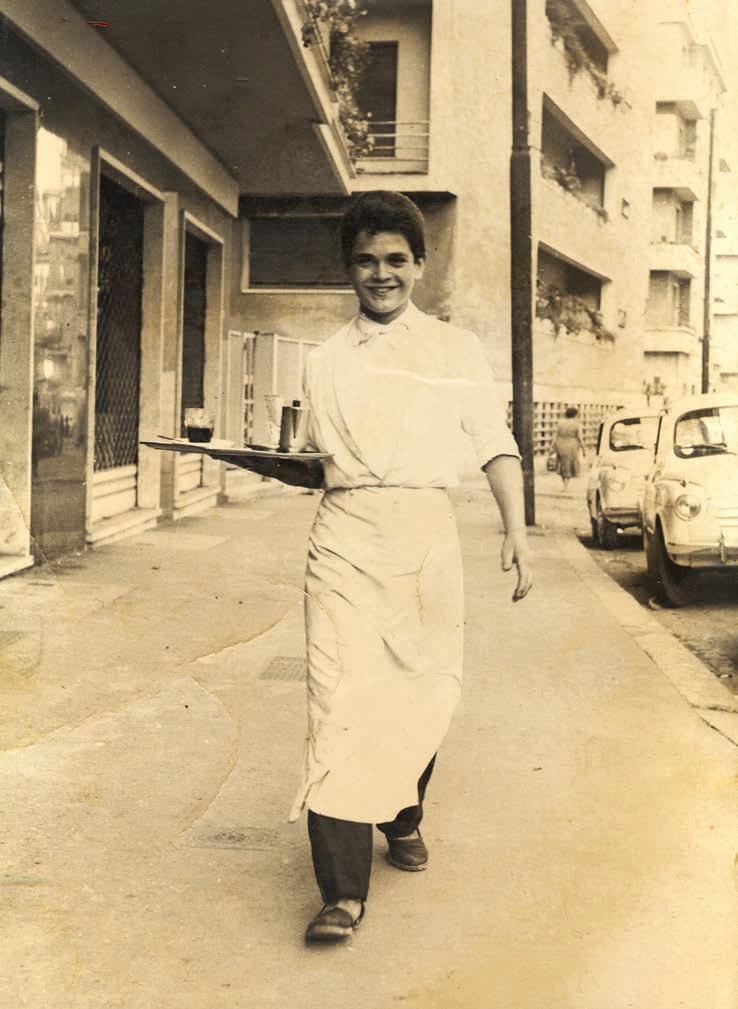
Il Mulino West 3rd Street – The Original, honored as the #1 Italian restaurant on the New York City Zagat Survey for an astonishing 20 years.

With four decades of culinary excellence, Il Mulino’s Downtown location is committed to continuing the Masci’s legacy with fresh Italian flavors and impeccable service emphasizing authentic Abruzzese preparations. Rustic, dark and cozy, the original downtown site sets a standard for Italian fine dining. Some might say the homemade focaccia and fresh seasonal specials are transcendental. First time at the restaurant? The delicious fresh Branzino and Truffle Ravioli are required for initiation.
Il Mulino Prime – The Modern Steakhouse in Gramercy
With ultra-fresh meat and seafood playing such an important role in the cuisine of Abruzzo, this modern steakhouse and Italian restaurant features inspired cuisine and choice cuts. Nestled in the heart of Gramercy-Flatiron, Il Mulino Prime embraces the signature style and unparalleled service attributed to the success of Il Mulino New York. Renowned for its bustling and energetic atmosphere, market fresh daily specials, extensive selection of fine Italian wines, and impeccably polished wait staff, Il Mulino Prime is synonymous with quintessential fine Italian dining.
Il Mulino Tribeca – A fresh take on creativity and meticulousness that continually redefines the concept of haute cuisine.
Il Mulino’s newest outpost in Tribeca feels almost faultless: a staff that knows the perfect level of attentive, but not obtrusive service, a breathtaking bar scene, and expertly crafted meals made with serious amore. A Florentine café with the contemporary cosmopolitan feel of downtown Manhattan, Il Mulino New York Tribeca off ers a new fine dining experience unlike any other. The sophisticated menu includes traditional “West 3rd Favorites” as well as various delicately prepared fi sh dishes. These fresh seaside fl avors remind one of the Mediterranean Sea.
The ultimate Fine Dining Experience
Il Mulino (ilmulino.com ) offers unparalleled Italian feasts that leave everybody at the table satisfied and feeling like family.

Abruzzo, Italy
POSTED WITH PERMISSION. COPYRIGHT © 2022 LEADERS MAGAZINE, LLC LEADERS 264 VOLUME 45, NUMBER 4
Fernando Masci walking the streets of Abruzzo, Italy
TUTANKHAMUN Fit for a King
A century after its discovery, Montegrappa celebrates one of the world’s greatest treasures. Limited edition in vermeil and solid 18K gold.

montegrappa.com AVAILABLE AT MONTEGRAPPA BOUTIQUES, ONLINE AND AUTHORISED DEALERS WORLDWIDE















 SOLOVIEV PETERSON ROSENBAUM WYLDE RODRIGUEZ
SOLOVIEV PETERSON ROSENBAUM WYLDE RODRIGUEZ












































































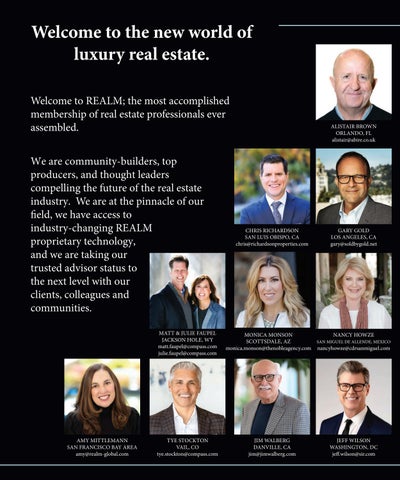





































 McDermott
President and Chief Executive Officer, ServiceNow
McDermott
President and Chief Executive Officer, ServiceNow








 All Wheels Up flights are operated by our DOT/FAA-authorized air carrier subsidiaries (Wheels Up Private Jets LLC, Alante Air Charter LLC, Gama Aviation LLC, Mountain Aviation LLC, Sterling Aviation LLC, and TWC Aviation LLC) or by an approved vendor air carrier that has undergone our safety assessment.
All Wheels Up flights are operated by our DOT/FAA-authorized air carrier subsidiaries (Wheels Up Private Jets LLC, Alante Air Charter LLC, Gama Aviation LLC, Mountain Aviation LLC, Sterling Aviation LLC, and TWC Aviation LLC) or by an approved vendor air carrier that has undergone our safety assessment.










 Miles Nadal, Ambassador Gilad Erdan, Permanent Representative of Israel to the United Nations, and Sarah Nadal
The Honorable Tony Blair, former British Prime Minister, and Miles Nadal
Miles Nadal, Ambassador Gilad Erdan, Permanent Representative of Israel to the United Nations, and Sarah Nadal
The Honorable Tony Blair, former British Prime Minister, and Miles Nadal

 Sean “Diddy” Combs, Miles Nadal, and DJ Khaled
An artist’s rendition of Miles Nadal and Michael Jordan
Sean “Diddy” Combs, Miles Nadal, and DJ Khaled
An artist’s rendition of Miles Nadal and Michael Jordan





















































 Self-esteem and trust-building activities at Camp Harbor View in Boston (above and below)
Self-esteem and trust-building activities at Camp Harbor View in Boston (above and below)




































































































 BENTLEY RESIDENCES
SUNNY ISLES BEACH FIN GRAND CAYMAN OIL NUT BAY BRITISH VIRGIN ISLANDS
SILVERSANDS GRENADA
THE RESERVE SEA ISLAND SEA ISLAND, GA
THE RESIDENCES AT MANDARIN ORIENTAL GRAND CAYMAN
VICTORY RANCH UTAH THE TOWERS OF THE WALDORF ASTORIA NEW YORK
RITZ-CARLTON PORTLAND, OR
BENTLEY RESIDENCES
SUNNY ISLES BEACH FIN GRAND CAYMAN OIL NUT BAY BRITISH VIRGIN ISLANDS
SILVERSANDS GRENADA
THE RESERVE SEA ISLAND SEA ISLAND, GA
THE RESIDENCES AT MANDARIN ORIENTAL GRAND CAYMAN
VICTORY RANCH UTAH THE TOWERS OF THE WALDORF ASTORIA NEW YORK
RITZ-CARLTON PORTLAND, OR










































 Executive Director and Head of Black Wealth
Executive Director and Head of Black Wealth

















































































































































































 Paul, Weiss, Ri�ind, Wharton & Garrison LLP paulweiss.com
Paul, Weiss, Ri�ind, Wharton & Garrison LLP paulweiss.com


















































































 Hawker 4000
Hawker 4000









































































 Ning YUAN Wei HU Kang PAN Chairman & President of China Construction America President & CEO of Bank of China U.S.A.
General Manager & Chief Representative of China Merchants Bank NY Branch
Zheyu CHEN Chairman of COSCO SHIPPING (North America)
Pin NI President of Wanxiang America Corporation
Jianyu ZHANG Chair of ICBC US Region Management Committee
Suosheng LI General Manager of China Construction Bank New York Branch
Jianmin ZHU CEO of SINOPEC America
Xuming ZHANG President of AVIC INTL USA.
Ping ZHANG Vice President of China Telecom (Americas)
Wei BO Chief Executive Representative of Fosun International New York Office
Mengrong CHENG Chief Representative of State Grid US Representative Office
Min FANG General Manager of Agricultural Bank of China New York Branch
Lanlan ZHANG Vice Chairman of CICC US Securities
Liang CHANG Chairman of Aland Health Holding & International Vitamin
Ning YUAN Wei HU Kang PAN Chairman & President of China Construction America President & CEO of Bank of China U.S.A.
General Manager & Chief Representative of China Merchants Bank NY Branch
Zheyu CHEN Chairman of COSCO SHIPPING (North America)
Pin NI President of Wanxiang America Corporation
Jianyu ZHANG Chair of ICBC US Region Management Committee
Suosheng LI General Manager of China Construction Bank New York Branch
Jianmin ZHU CEO of SINOPEC America
Xuming ZHANG President of AVIC INTL USA.
Ping ZHANG Vice President of China Telecom (Americas)
Wei BO Chief Executive Representative of Fosun International New York Office
Mengrong CHENG Chief Representative of State Grid US Representative Office
Min FANG General Manager of Agricultural Bank of China New York Branch
Lanlan ZHANG Vice Chairman of CICC US Securities
Liang CHANG Chairman of Aland Health Holding & International Vitamin















 Zhaohu WANG Ming HOU President of Minmetals USA General Manager of China Southern Airlines North America
Weifeng ZHANG President of Shanghai Construction Group America
Gang HU President & CEO of Greenland USA
Mengtao XIE General Manager of SANY America
Xin HE CFO of Wanda America Group
Yi ZHU Chairman & CEO of Gemdale USA
Shaohui YANG General Manager of Bank of Communications NY Branch
Yuyong RAO Executive Director, President of Baosteel America
Jing CHEN General Manager of China Unionpay (USA)
Guotu MAO Vice President of Sinochem American Holdings
Duan WANG Assistant General Manager & Chief International Affairs Officer of HNA Trust Management
Qidi TENG
Howard LI President of PetroChina International America Chairman & CEO of Waitex Group of Companies
Tong ZHANG President of China Unicom Americas
Zhaohu WANG Ming HOU President of Minmetals USA General Manager of China Southern Airlines North America
Weifeng ZHANG President of Shanghai Construction Group America
Gang HU President & CEO of Greenland USA
Mengtao XIE General Manager of SANY America
Xin HE CFO of Wanda America Group
Yi ZHU Chairman & CEO of Gemdale USA
Shaohui YANG General Manager of Bank of Communications NY Branch
Yuyong RAO Executive Director, President of Baosteel America
Jing CHEN General Manager of China Unionpay (USA)
Guotu MAO Vice President of Sinochem American Holdings
Duan WANG Assistant General Manager & Chief International Affairs Officer of HNA Trust Management
Qidi TENG
Howard LI President of PetroChina International America Chairman & CEO of Waitex Group of Companies
Tong ZHANG President of China Unicom Americas















 Shuguang WANG General Manager of Broad U.S.A.
Tong HE Xuan CHENG General Manager of Eccom Network (USA) Chairman of Sansheng Investment U.S.A
Yu WANG Chief Representative of China Life U.S. Representative Office
Guoliang YU General Manager of Liepin North America
Tim DING Global Sales Director of Inspur USA
Chunyin FANG Chief Representative of China Re New York Liaison Office
Lianhong LIU President of Hongdou New York
Xiaoyuan HOU CEO of Chinatex Oriental USA
Hui DONG President & CEO of Shanghai Int’l Holding (America)
Kai-Yan LEE Managing Director of Vanke (USA) Holding
Liujun LI General Manager of China Eastern Airlines North America
Stella LI President of BYD Motors
Tao BIAN Managing Director of CAIGA US
Jian ZHANG Managing Director of XIN Development Group International
Shuguang WANG General Manager of Broad U.S.A.
Tong HE Xuan CHENG General Manager of Eccom Network (USA) Chairman of Sansheng Investment U.S.A
Yu WANG Chief Representative of China Life U.S. Representative Office
Guoliang YU General Manager of Liepin North America
Tim DING Global Sales Director of Inspur USA
Chunyin FANG Chief Representative of China Re New York Liaison Office
Lianhong LIU President of Hongdou New York
Xiaoyuan HOU CEO of Chinatex Oriental USA
Hui DONG President & CEO of Shanghai Int’l Holding (America)
Kai-Yan LEE Managing Director of Vanke (USA) Holding
Liujun LI General Manager of China Eastern Airlines North America
Stella LI President of BYD Motors
Tao BIAN Managing Director of CAIGA US
Jian ZHANG Managing Director of XIN Development Group International















 Amy LEI Vice President of Fuyao Group North America
Chris CHAN President of Greencourt Capital
Larry LI President of China Orient Advisors
Ya SUN CEO & President of JN fibers
Jack WANG Managing Partner of King & Wood Mallesons
Bing WU CEO of Synear Foods USA
Ling XIAO Partner of Zhong Lun Law Firm
Jeffery HE Vice President & Global Affairs of Hikvision USA
Doris ZHANG General Manager of Beijing Duck Restaurant
Qing HONG General Manager & Branch Manager China CITIC Bank International, NY Branch
Veronica YE CEO of Haitong Securities US
Tencent cloud North America
Arene LIU Vice President of Lao Feng Xiang Jewelry
Linhua GUAN CEO of Surge Energy
Joe YE EVP of EP Yaying Fashion Group
Amy LEI Vice President of Fuyao Group North America
Chris CHAN President of Greencourt Capital
Larry LI President of China Orient Advisors
Ya SUN CEO & President of JN fibers
Jack WANG Managing Partner of King & Wood Mallesons
Bing WU CEO of Synear Foods USA
Ling XIAO Partner of Zhong Lun Law Firm
Jeffery HE Vice President & Global Affairs of Hikvision USA
Doris ZHANG General Manager of Beijing Duck Restaurant
Qing HONG General Manager & Branch Manager China CITIC Bank International, NY Branch
Veronica YE CEO of Haitong Securities US
Tencent cloud North America
Arene LIU Vice President of Lao Feng Xiang Jewelry
Linhua GUAN CEO of Surge Energy
Joe YE EVP of EP Yaying Fashion Group































































